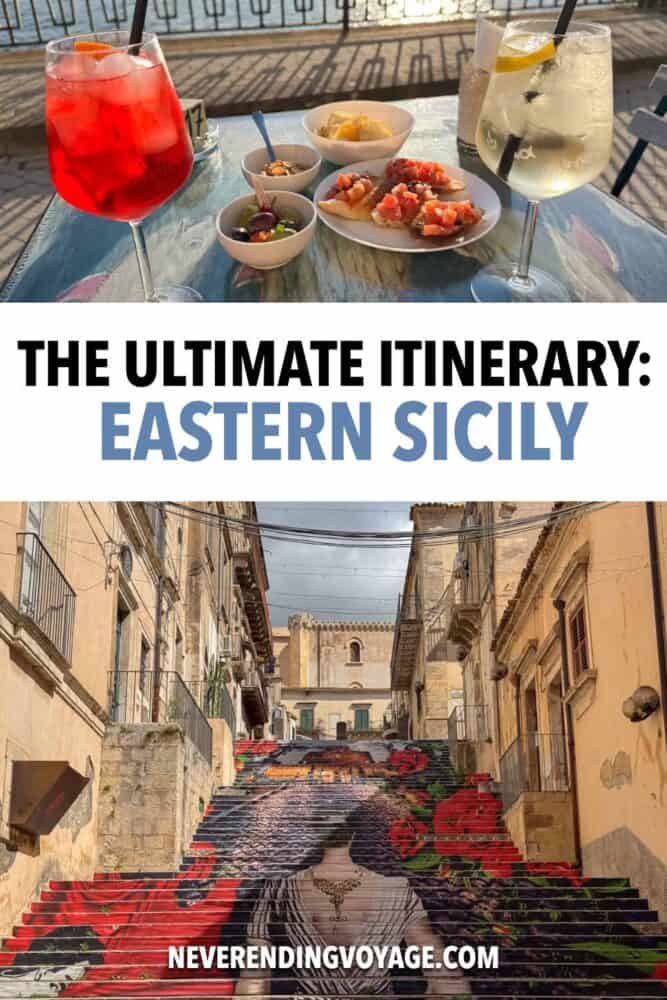Lake Molveno: Italy’s Hidden Gem in the Dolomites 1 Oct 3:12 AM (23 days ago)
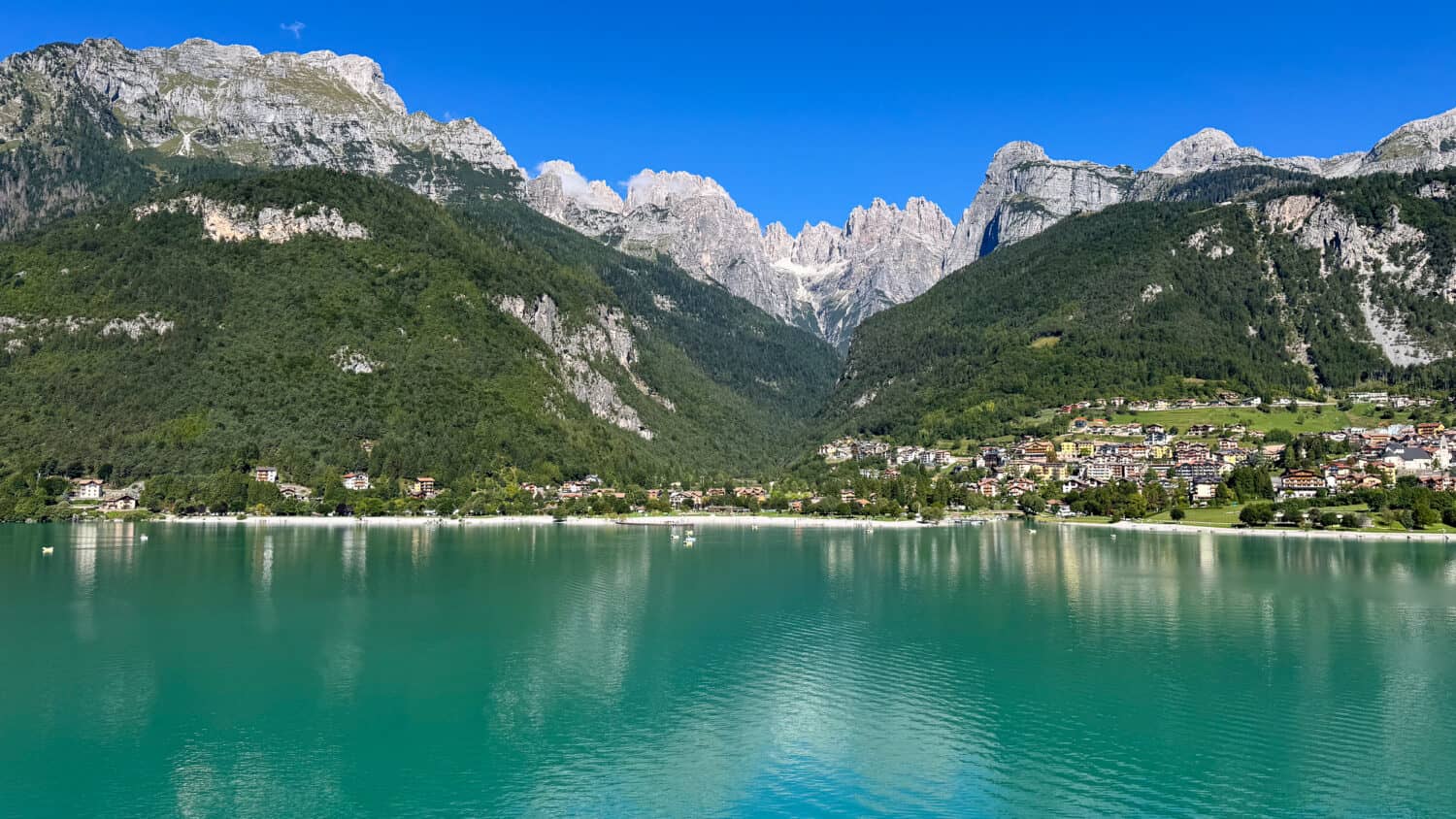
Lake Molveno has been called the most beautiful lake in Italy, and when we stepped onto our hotel balcony for the first time, we knew why.
The turquoise lake is backed by forested hills with craggy grey peaks beyond. On its shores, a village with Alpine buildings in pink and yellow is separated from the water by a long stretch of lush grass and white beach.
It felt like a screenshot come to life.
Despite its outstanding beauty, this small lake in the Brenta Dolomites isn’t well known to foreigners. We’ve been to Italy many times and only heard about it this year when searching for lakeside hotels.
Lake Molveno turned out to be perfect for what we wanted—a relaxing holiday in a scenic location with opportunities to get active in the water and surrounding mountains.
We visited for a week at the end of August and into early September. As Molveno is located at an altitude of 864 metres (2,835 feet) above sea level, it’s a pleasant retreat from the scorching summer temperatures found further south in Italy.
The weather is unpredictable in the mountains, though. We had a mix of sunny days at 21ºC (70ºF) and cloudy days with afternoon rain showers. Nights are cooler, so be sure to pack layers.
In this Lake Molveno travel guide, I share the best things to do in Molveno, a review of our lakeside hotel, food tips, and how to get there.
At the end, there is a map that includes everything mentioned.
Contents
- Where is Lake Molveno?
- Best Things to Do in Molveno
- Where We Stayed: Grand Hotel Molveno Review
- Where to Eat in Molveno
- How to Get to Lake Molveno, Italy
- Lake Molveno Map
- Is Lake Molveno Worth Visiting?
- More North Italy Posts
Where is Lake Molveno?
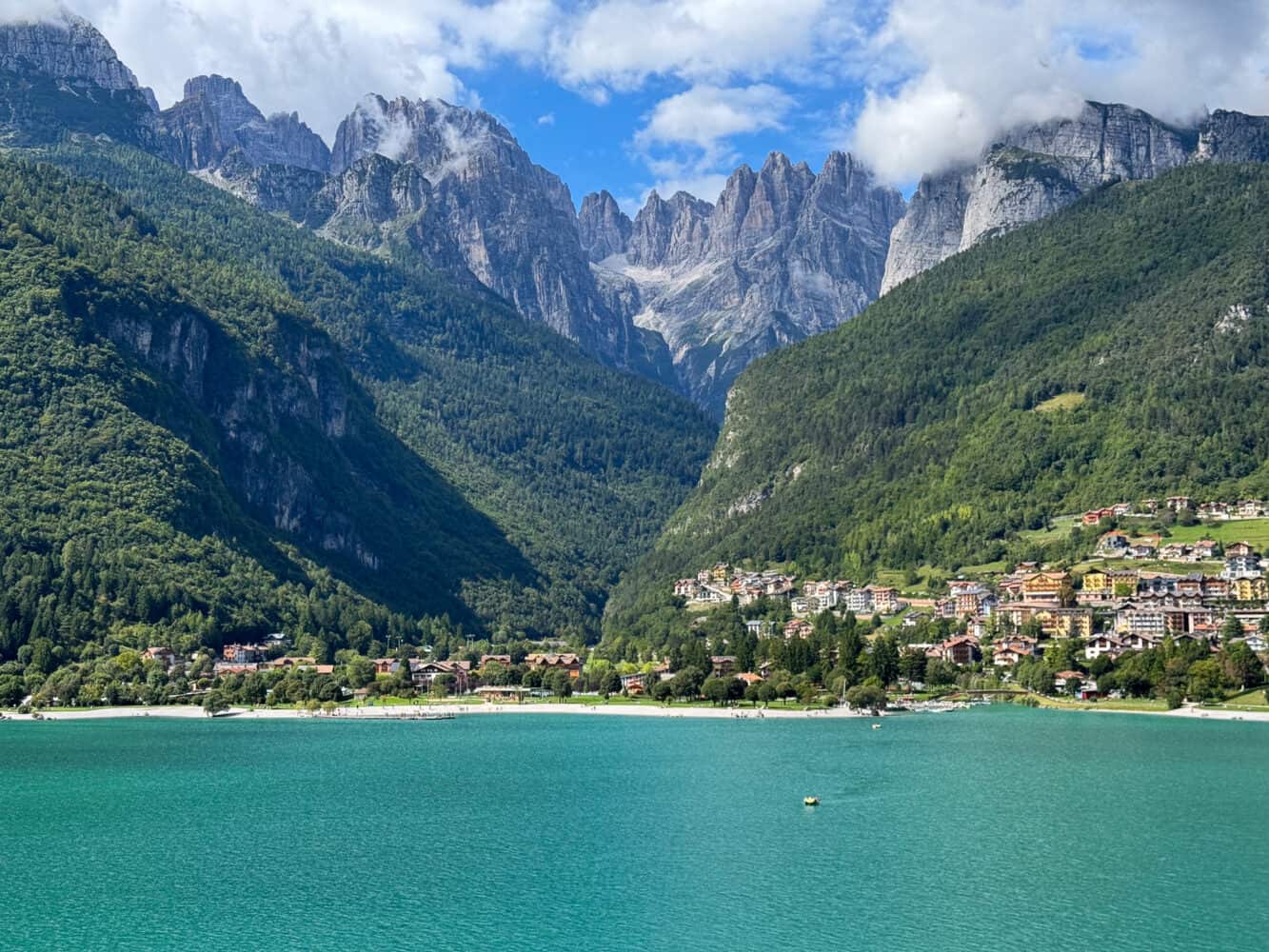
Lake Molveno is situated at the foot of the Brenta Dolomites, a part of the larger Dolomites mountain range in the Italian Alps, which is a UNESCO World Heritage Site.
It’s in the Trentino part of the Trentino-Alto Adige (Südtirol) autonomous region in northeast Italy.
The region is bordered by Switzerland and Austria and was once part of the Austro-Hungarian Empire, so it has a very different feel from the more southern areas of Italy.
You’ll see signs in both German and Italian, and the food is influenced by the Germanic heritage, with apple strudel as common as pizza.
Molveno’s nearest international airport is Verona Airport (VRN), 130km (81 miles) away.
It’s about an hour north of the much more famous Lake Garda.
See below for more on how to get to Lake Molveno.
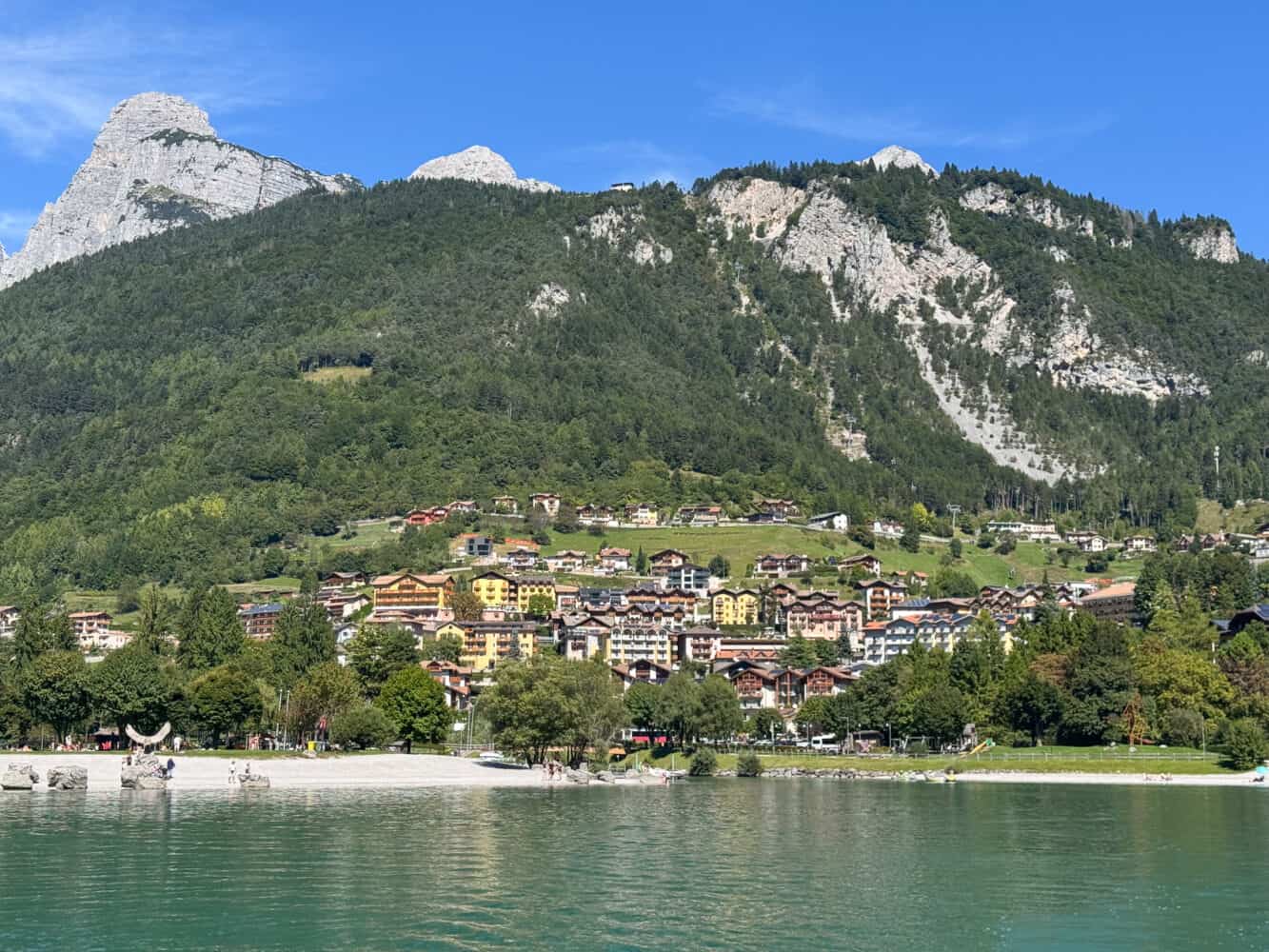
Best Things to Do in Molveno
Lake Molveno would make a great base for exploring the Brenta Dolomites area, but since we wanted a relaxing trip, we stuck to things to do in Molveno itself.
In addition to the activities that we did, Molveno is popular with mountain bikers and paragliders.
1) Walk Around Lake Molveno
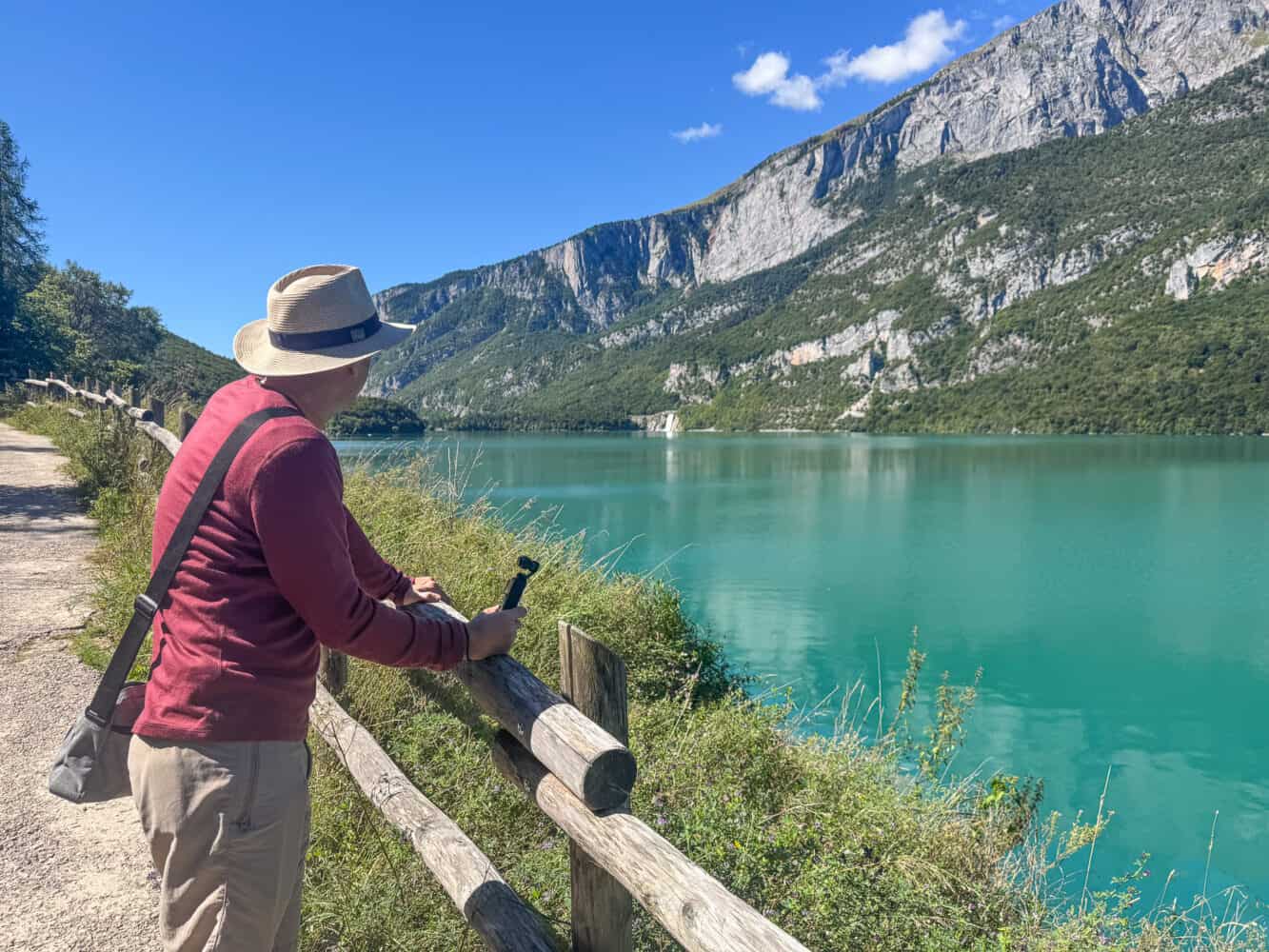
One of the best things to do in Molveno is to take a walk around the lake, which takes approximately three hours and offers fantastic views.
The 11.5km (7-mile) Lake Molveno hike is relatively easy, featuring flat sections, gentle ups and downs, and one significant hill on the western side. We had about 200 metres (656 feet) of elevation gain in total.
It’s well signposted—just follow the red and white signs marked Giro del Lago.
On a sunny Sunday afternoon in August, the trail was fairly busy with walkers, cyclists, and families, but we often had sections to ourselves.
You can start at the lido (beach) in town, but we started from our hotel, Grand Hotel Molveno, which is on the trail on the eastern side of the lake.
We started through the forest, with occasional glimpses of the lake, but it soon opens up, and the views are incredible looking back to town and the rugged mountains beyond.
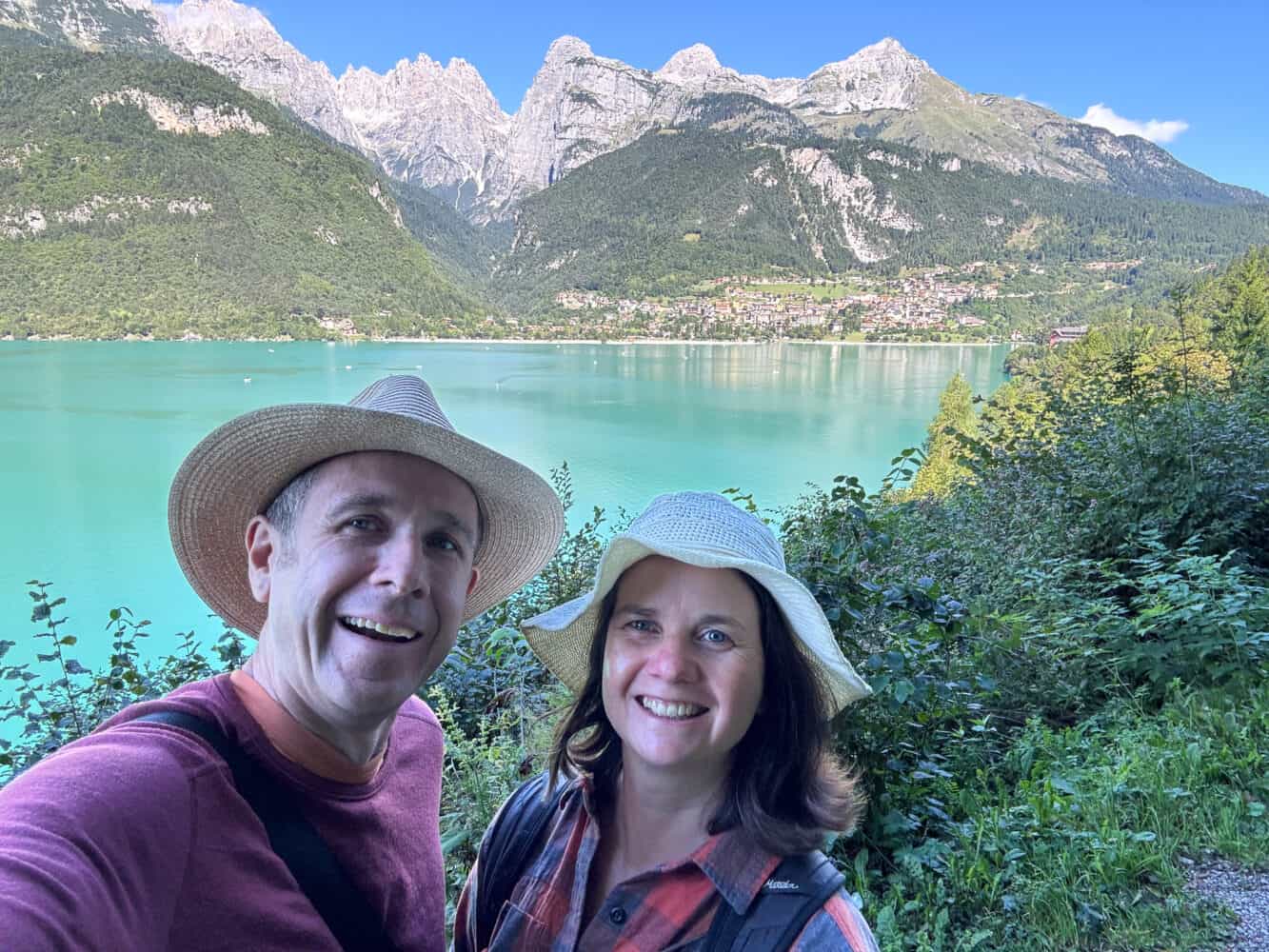
At the southern tip of the lake, a beach area accessible by road makes it a popular spot for sunbathing and swimming.
Then the trail climbs uphill for great views of the lake from above on the western side, especially by the hydropower waterfall.
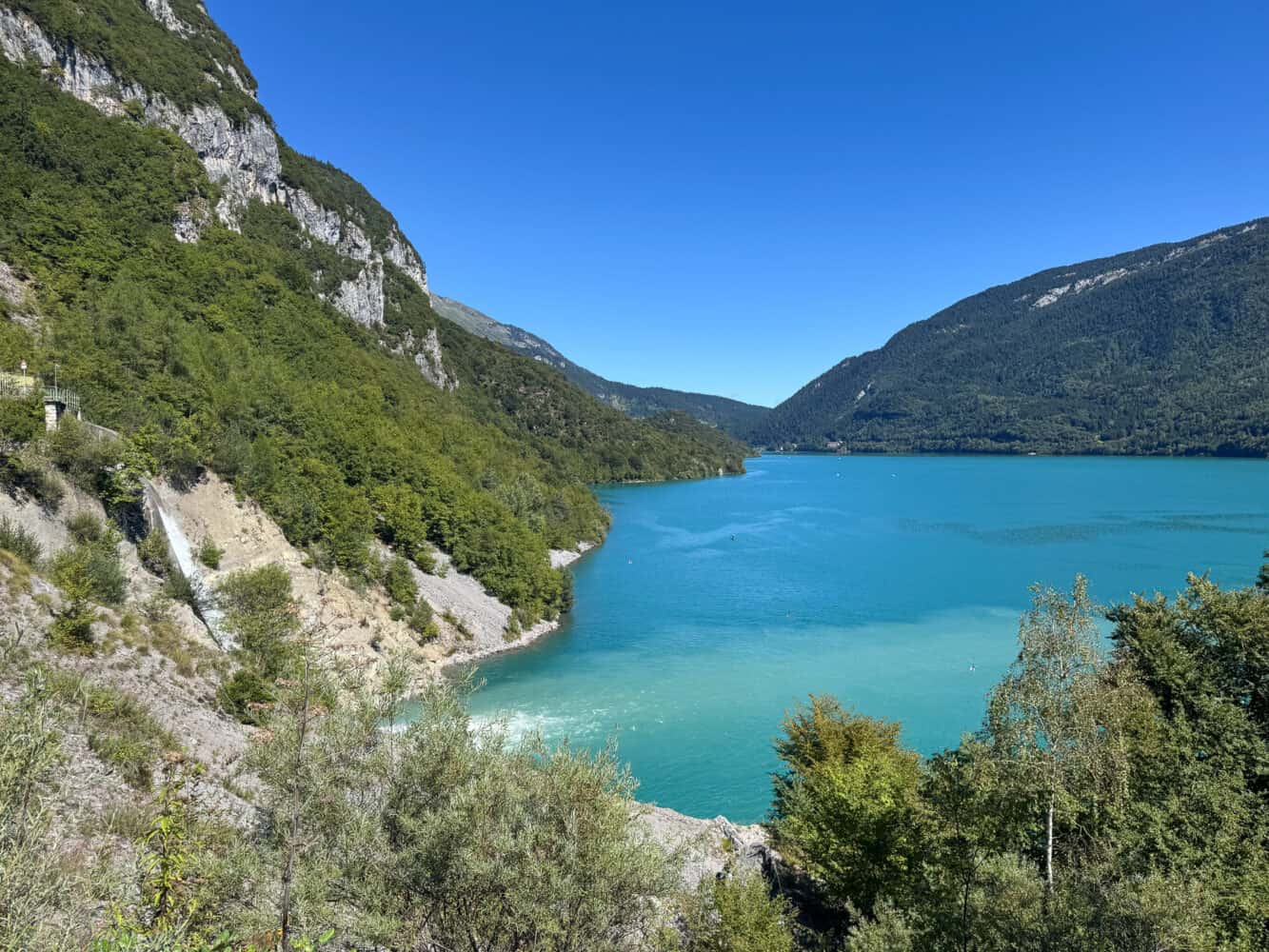
Some sections of the western side return to the forest, but there are still plenty of views to enjoy, as well as the Roman Bridge (which isn’t actually Roman).
You’ll end up back in town at the lido, Molveno’s beach area.
There are no facilities along the route, but there are many restaurants in town where you can enjoy lunch after the long walk.
This hike is the perfect introduction to Lake Molveno and an easier alternative to trails up in the mountains.
Details: See the Lake Molveno hike on AllTrails.
2) Take the Cable Car to Pradel
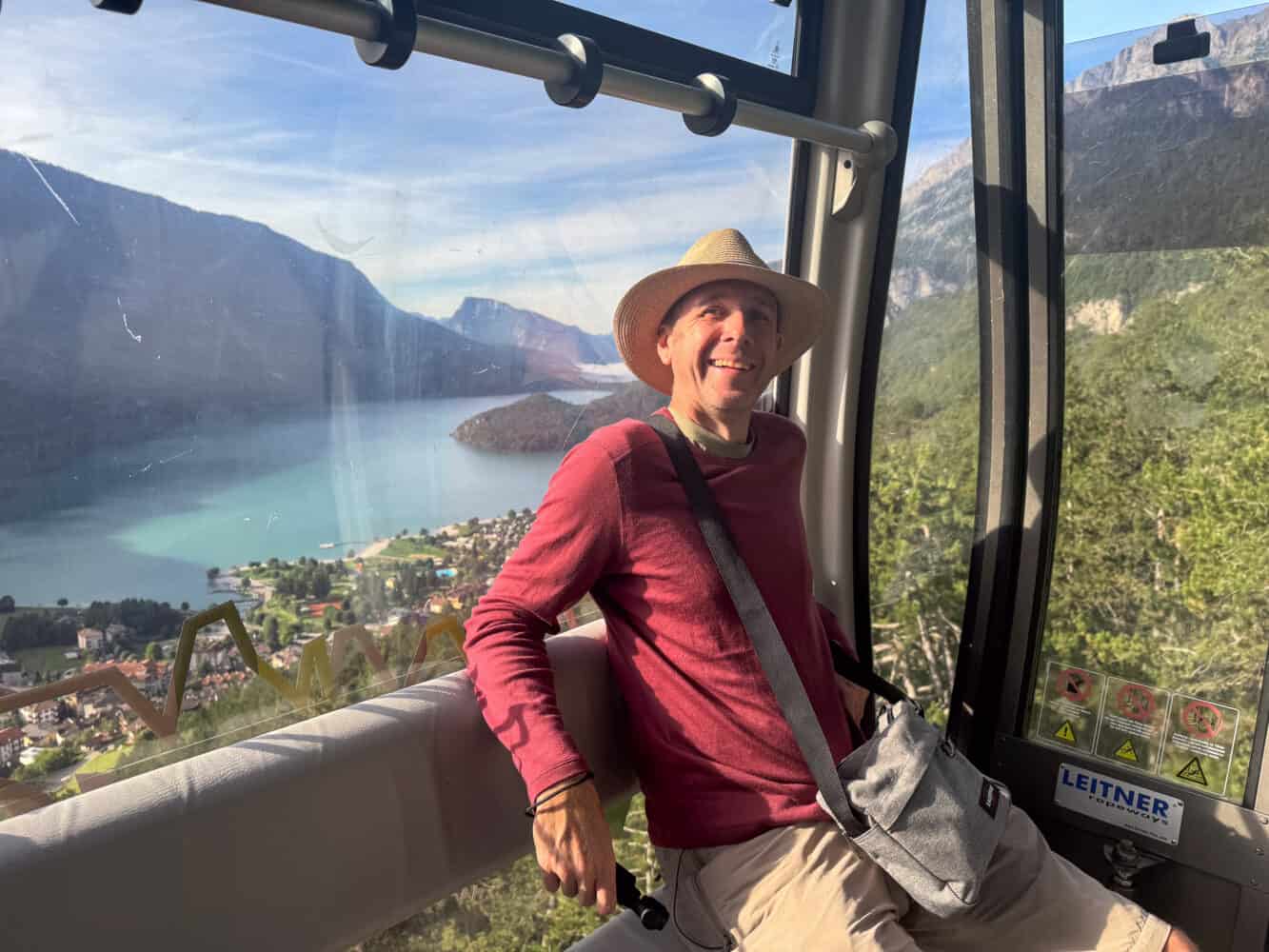
Another popular activity in Molveno is taking the cable car (funivia in Italian) up to Pradel, located at 1,367 metres (4,485 feet) above sea level.
In winter, there are a few ski slopes, and in summer, you can access many hiking and mountain bike trails.
Even if you don’t fancy a big trek, it’s worth coming up here for the stunning lake views.
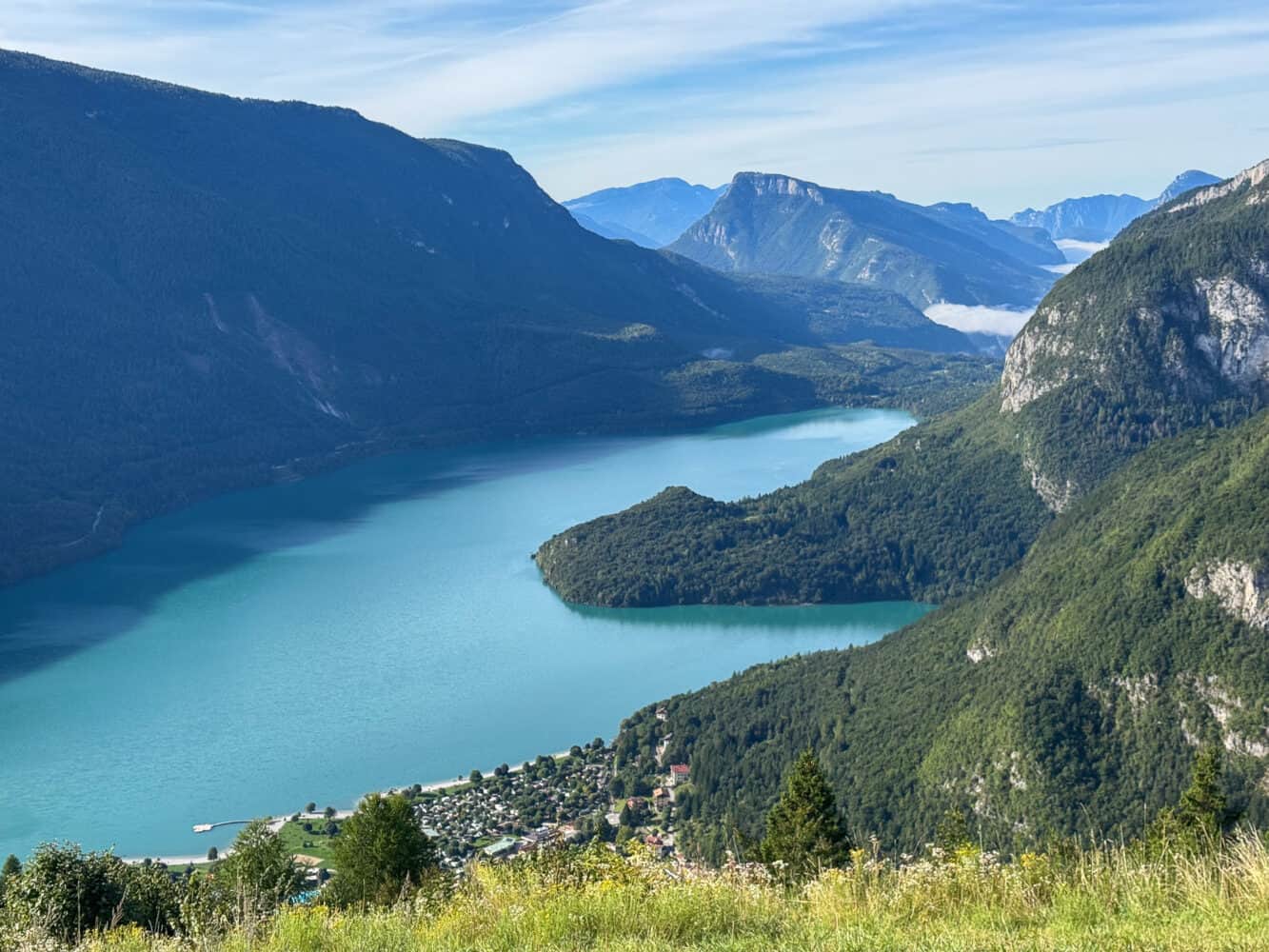
If you have kids, there’s an easy educational trail, play areas, and a farm to visit.
You can also take a two-seater chairlift even higher up to 1530 metres (5020 feet), where there are a few mountain huts for lunch.
The journey up takes just six minutes in the enclosed car. There was no queue at 9am and we had a car to ourselves.
At the top, there’s a mountain hut next to the cable car station where you can grab a coffee, snack, or meal. Note the toilets are for customers only—Simon is always happy to grab an espresso at the bar so I can use the facilities.
If you want to head further into the mountains (as we did), there’s a map of hiking trails at the top of the cable car.
Details: Visit the Funivia Molveno website for more information. For adults, the cable car costs €12 one way or €17 round trip. You save a euro with the Dolomiti Paganella guest card that many hotels provide.
3) Hike to Three Mountain Huts
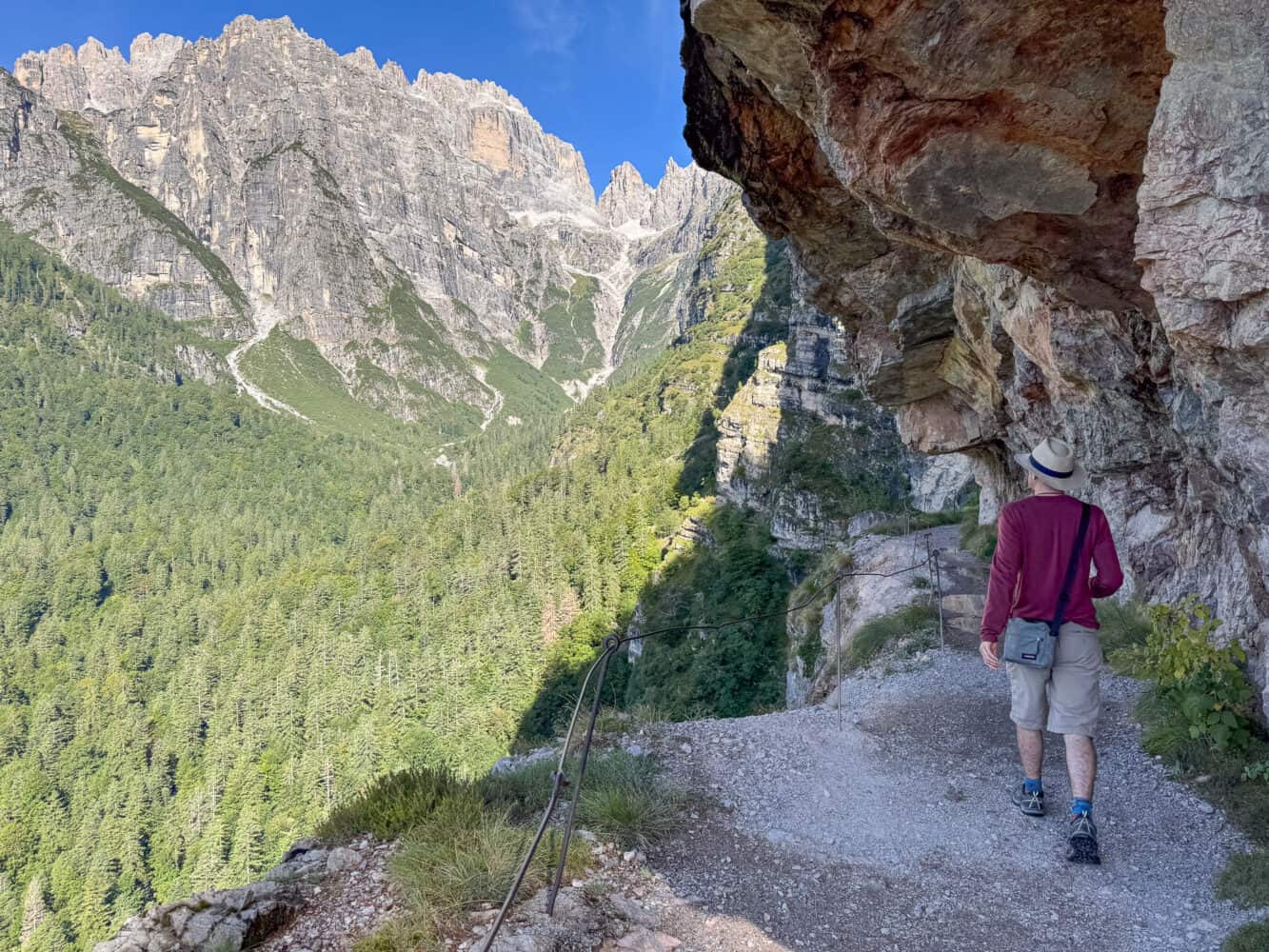
There are endless possibilities for hikes into the Brenta Dolomites above Molveno, whether you are an Alpine adventurer or casual walker.
If you start your hike from the top of the cable car in Pradel (as we did), you’ll save yourself a 1.5-hour uphill climb and have more time to get deeper into the mountains.
For hiking ideas, you can pick up the Visit Paganella Hiking and Trekking leaflet from town (our hotel gave it to us), although they are mostly shorter walks.
We wanted something a little challenging but not too extreme, and chose this hike on AllTrails to three mountain huts: Croz dell’Altissimo Refuge – Selvata Refuge – Andalo Refuge.
The hike was the highlight of our trip with jaw-dropping scenery amongst the immense Dolomite peaks.
We walked through forest, along narrow rock ledges, and across crystal-clear rivers.
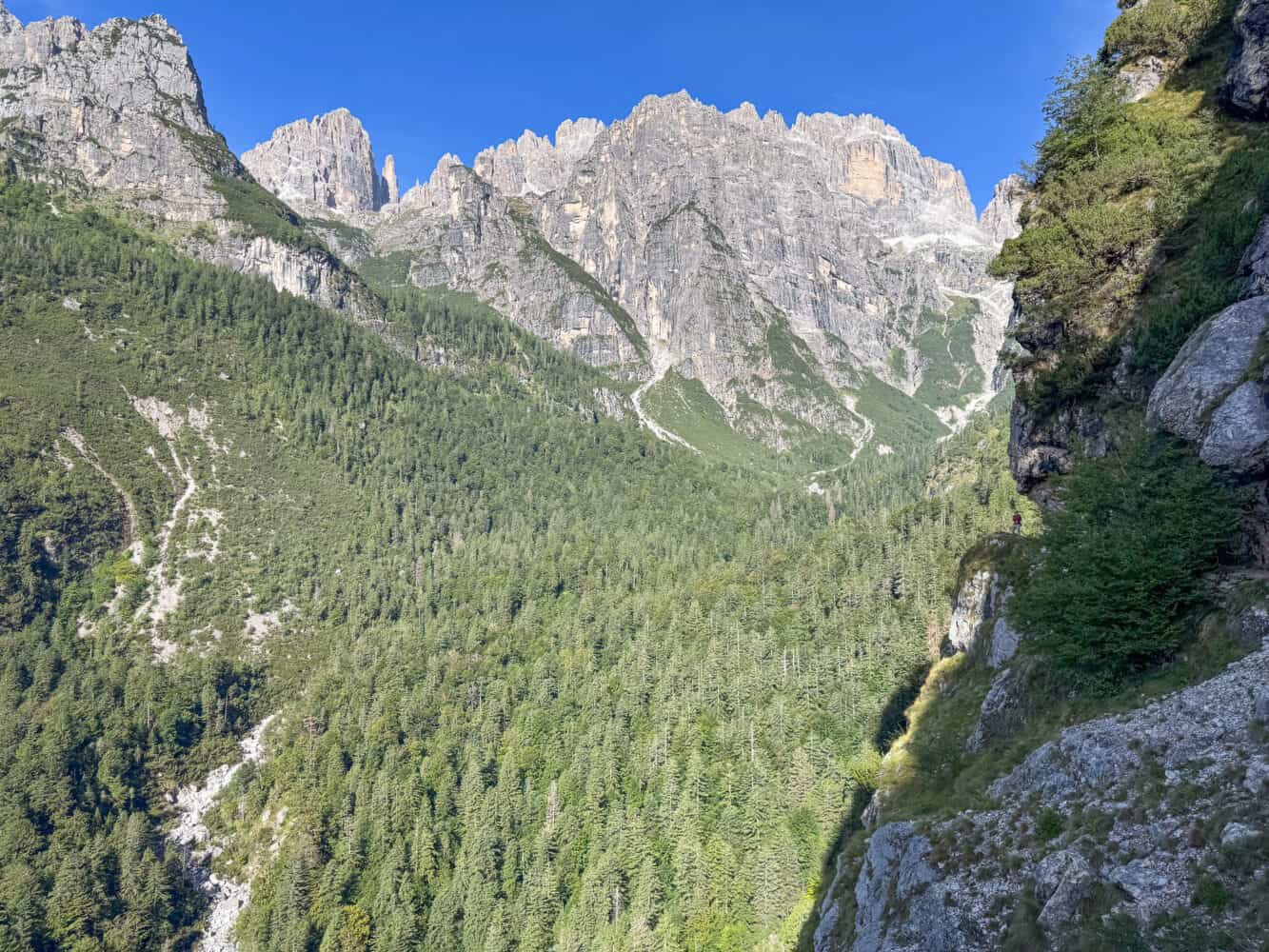
Although it was a long walk, we didn’t find it too hard because of the three breaks we had at the rifugi, mountain huts that offer basic accommodation and meals (and toilets!).
We started at the top of the cable car in Pradel and followed Trail 340 to Rifugio Croz dell’Altissimo. There are plenty of signposts, and it was easy to find our way.
If you are looking for an easier hike (3.7km/2.3 miles one way), this is a great option before returning to the cable car. We had some tasty apple strudel outside the hut with mountain views.
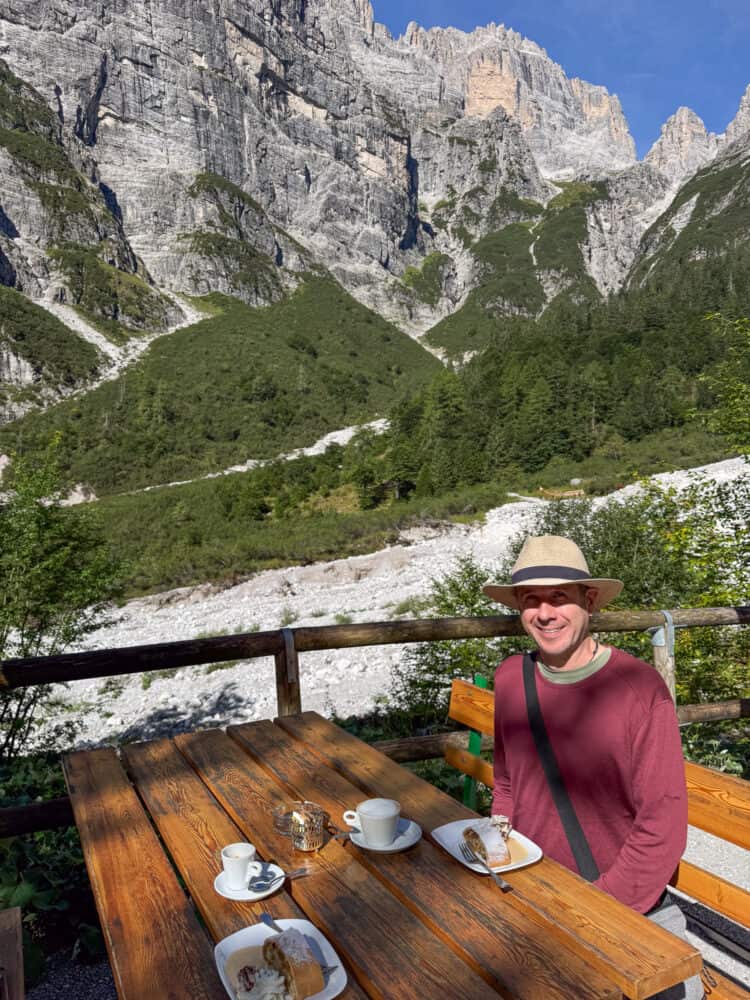
The climb up to Rifugio Selvata at 1,630 metres (5,347 feet) was more challenging, but it only took 40 minutes, with more gorgeous views on the way.
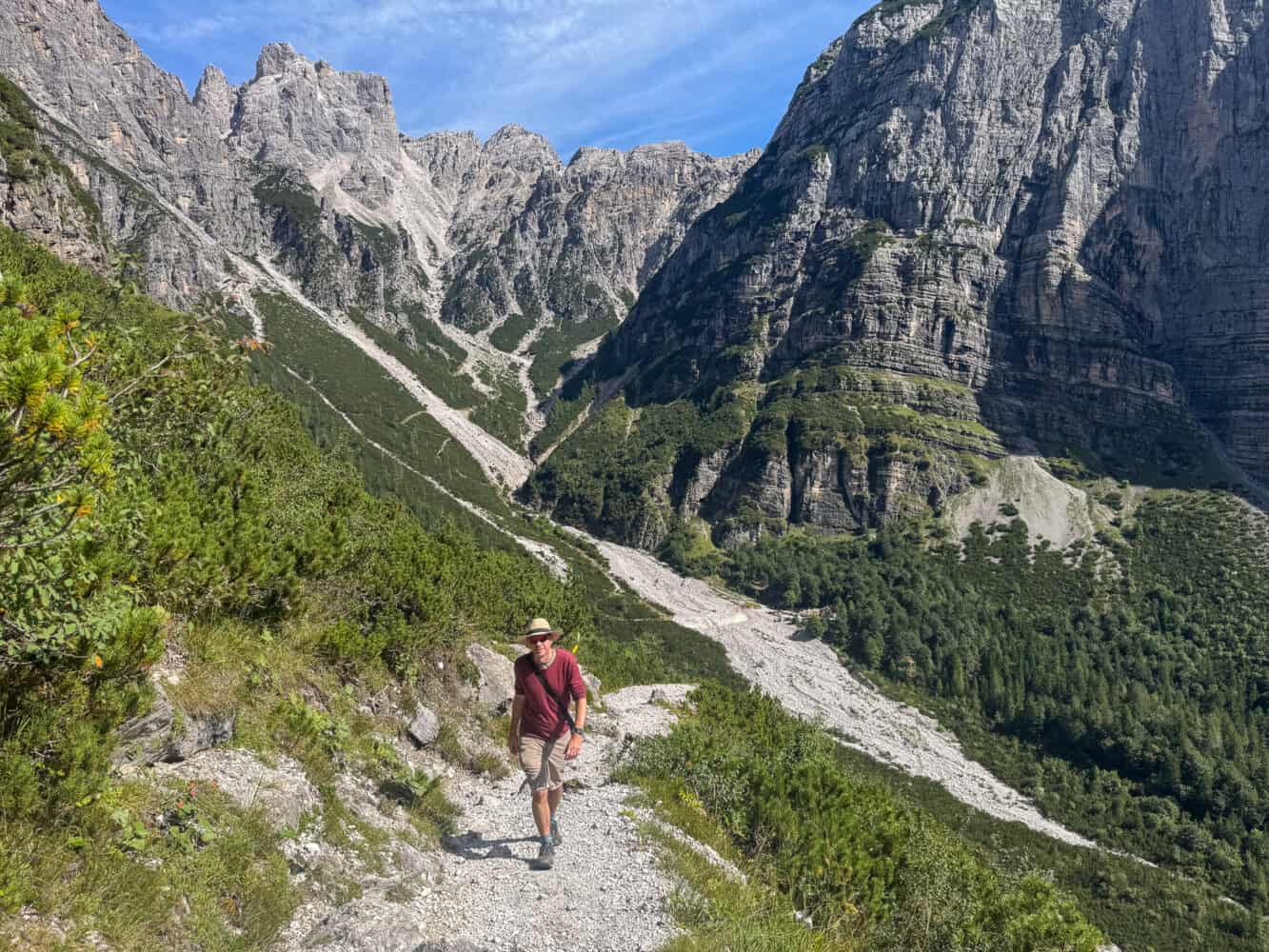
This rifugio is simpler than the others, but it still offers a small lunch menu. It was my favourite due to its peaceful location in a clearing surrounded by mountains. We loved sitting in the deck chairs in the sun with a cold drink.
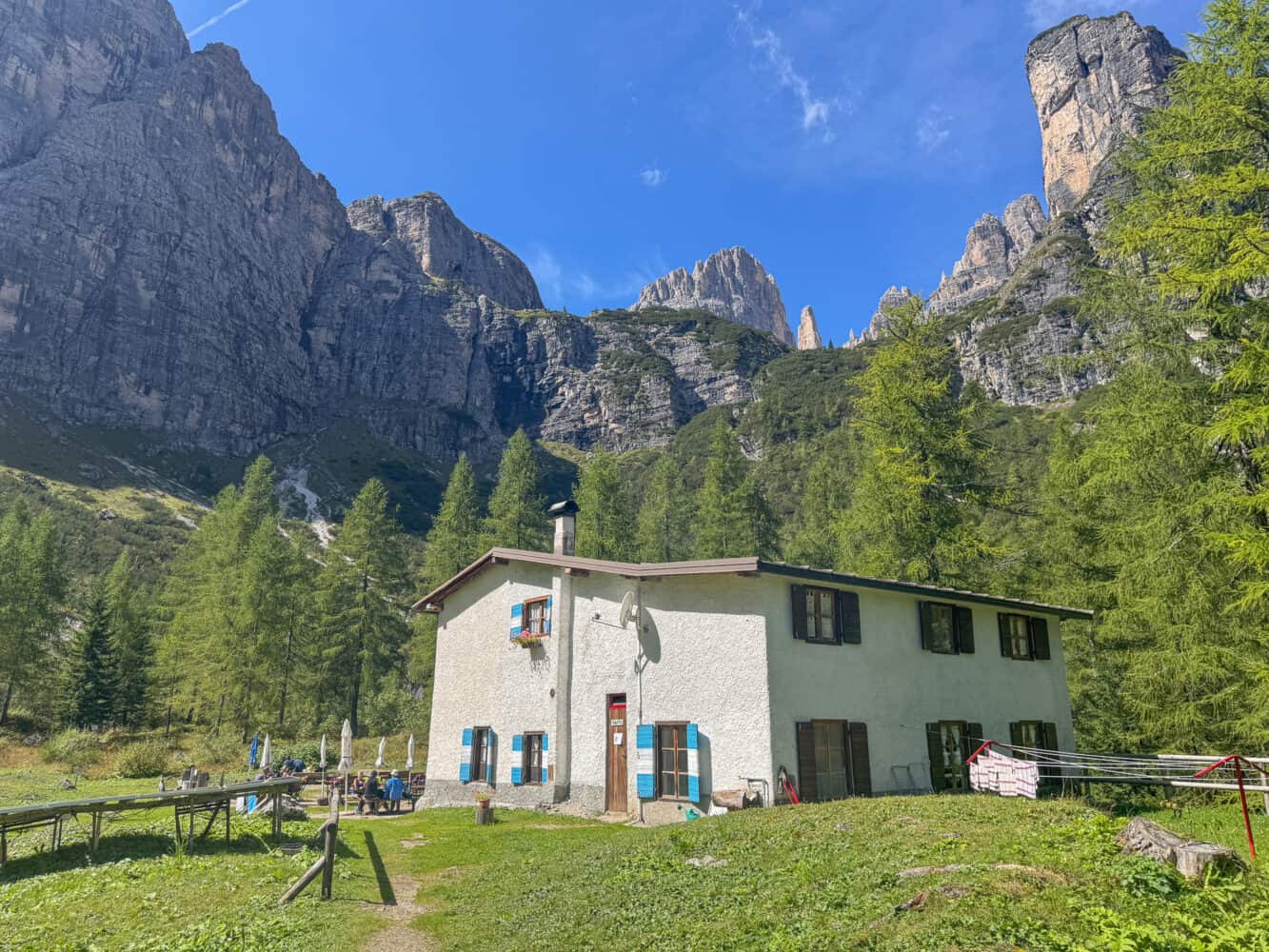
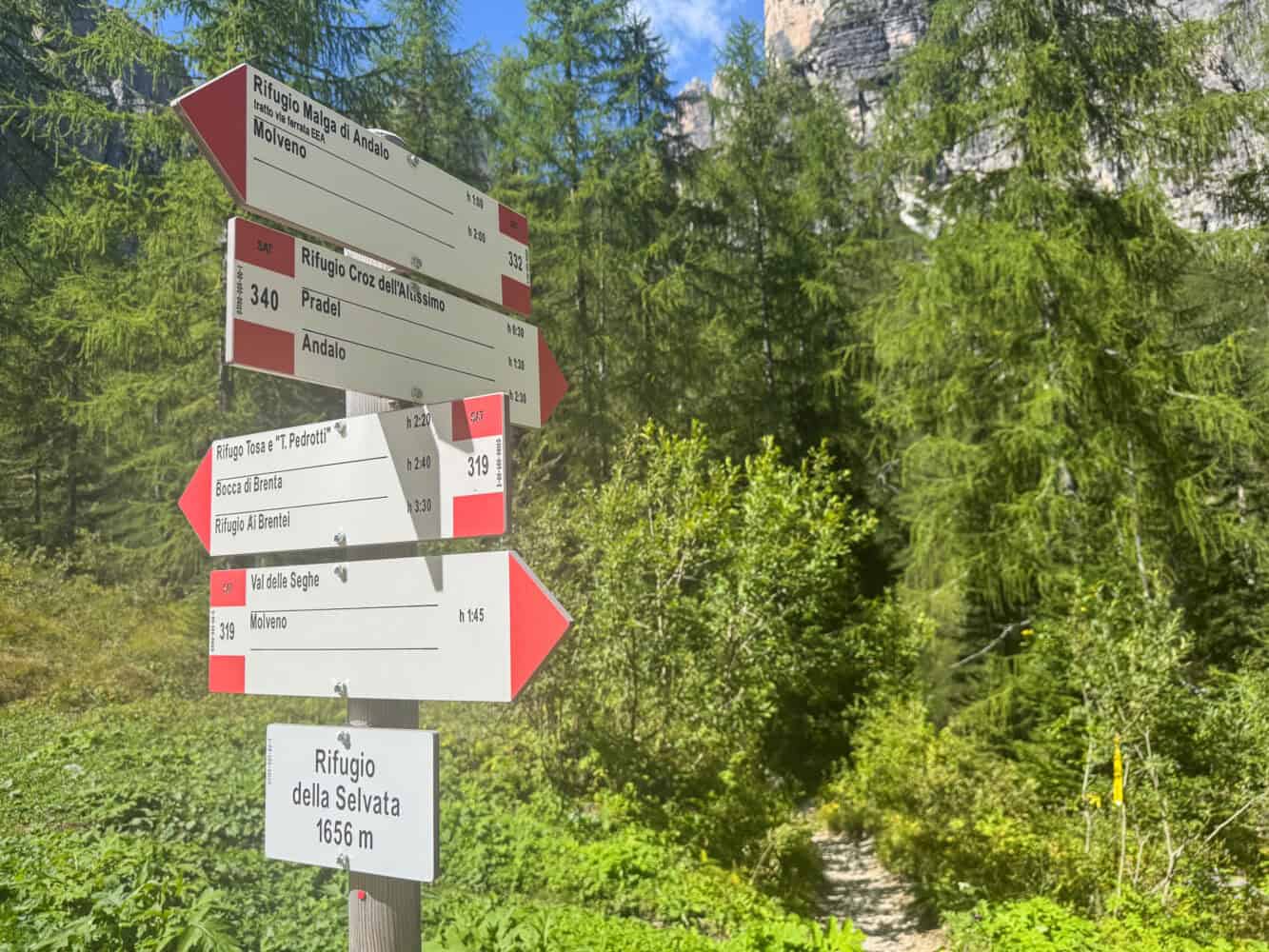
The next section was mostly downhill through forest for about an hour.
Technically, there are some via ferrata (climbing routes with fixed cables) on this section, but it’s very easy. The wires provide something to hold onto to get past some narrow, rocky sections.
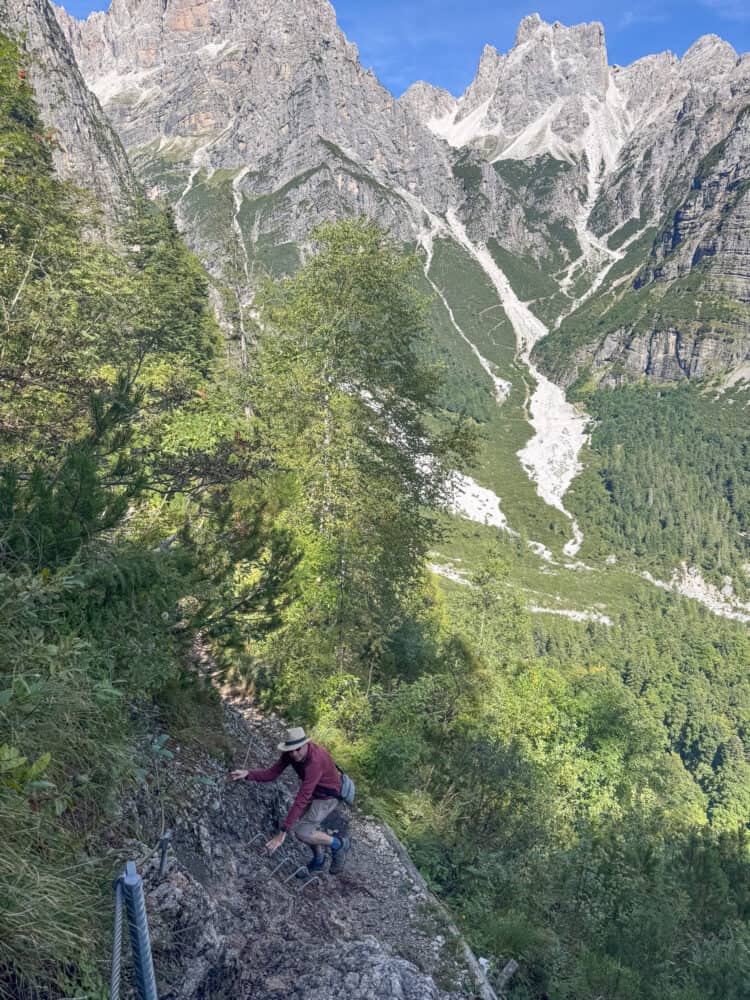
Rifugio Malga Andalo at 1350 metres (4429 feet) was our next stop. There’s a road up there, so it was a lot busier, and it felt jarring to see cars.
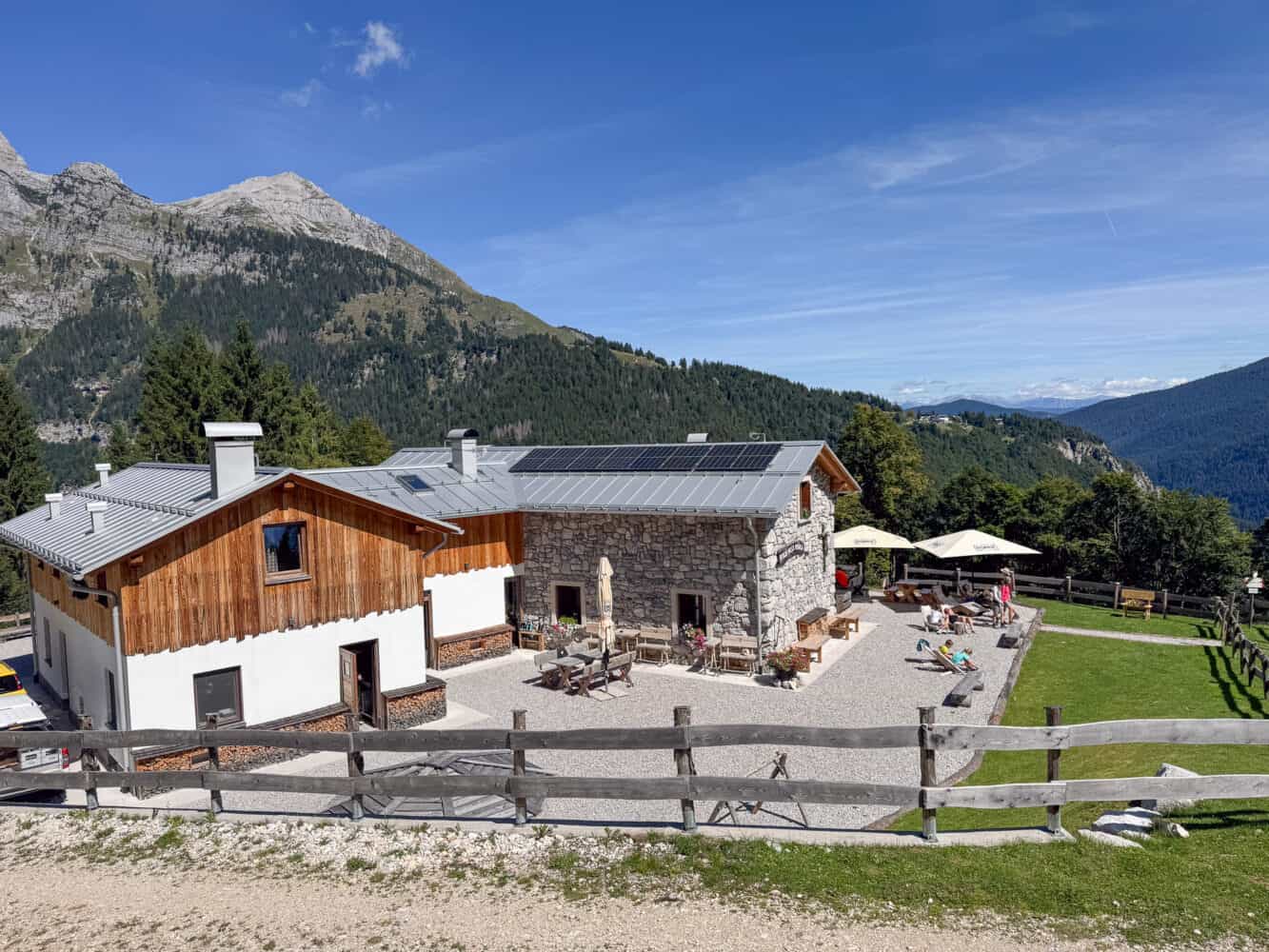
The rifugio has another beautiful setting in an Alpine meadow and a more extensive menu than the others. We enjoyed some polenta gnocchi (they made us a vegetarian version with cheese sauce) and spätzle with butter and sage.
The final hour of the hike was the steep descent to Molveno, which was the least enjoyable part as it was tough on our legs. It’s also through the forest, so there are fewer views.
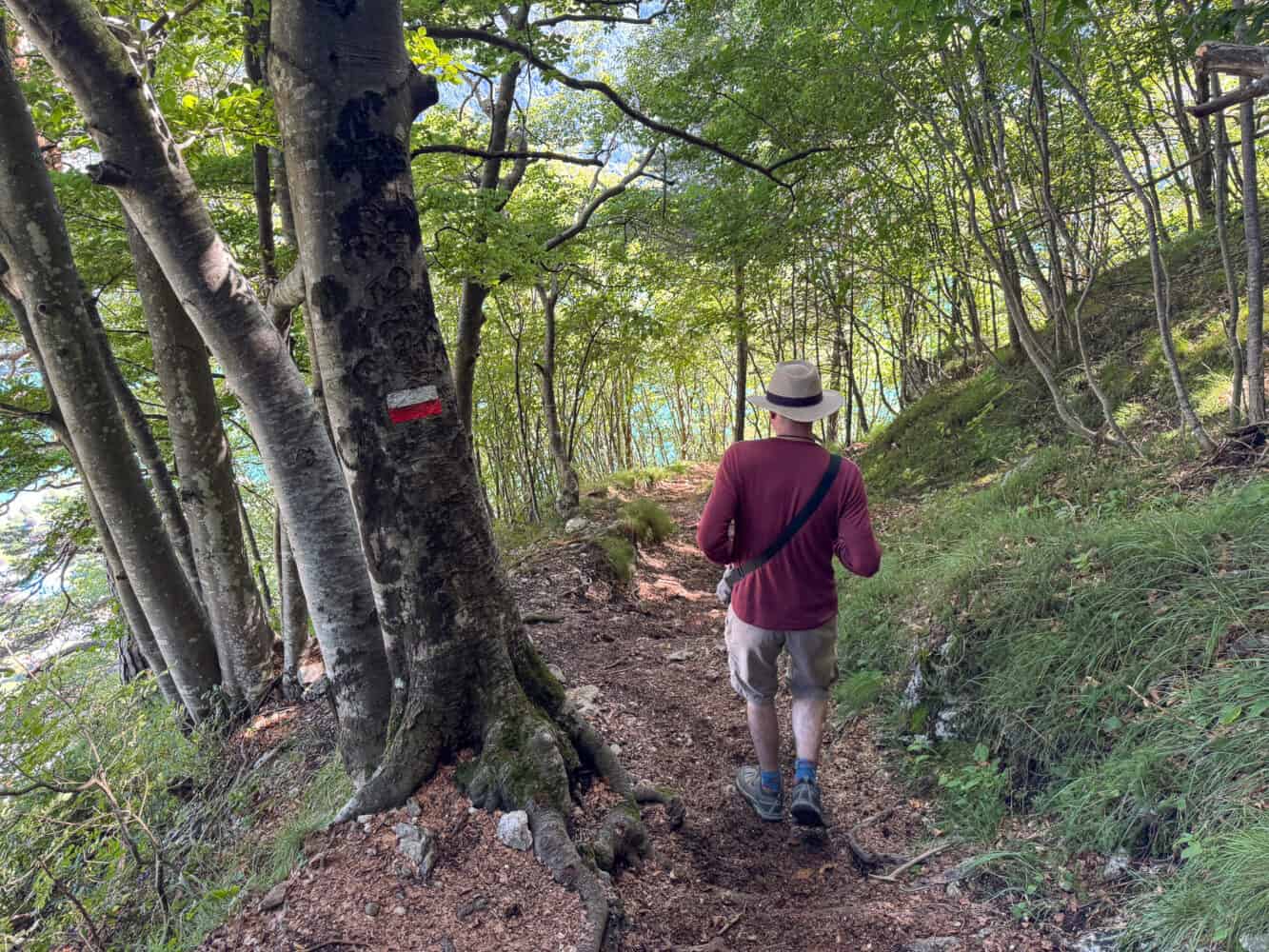
Hiking poles would have been helpful, but if you have knee issues, I would recommend avoiding this section. You could turn back at Rifugio Selvata and take the cable car down.
Or some people in the AllTrails review prefer to hike the loop in reverse, starting with the ascent and taking the cable car down. It would be a very steep climb of over two hours, though.
We still absolutely loved the hike. It was truly spectacular and not too challenging. Try to choose a clear day to make the most of the views.
Details: We walked 12km (7.5 miles) in about four hours with 386 metres (1266 feet) of elevation gain. Including three breaks, we were out for six hours (from the top of the cable car). See the AllTrails hike page for a map.
4) Swim in the Lake
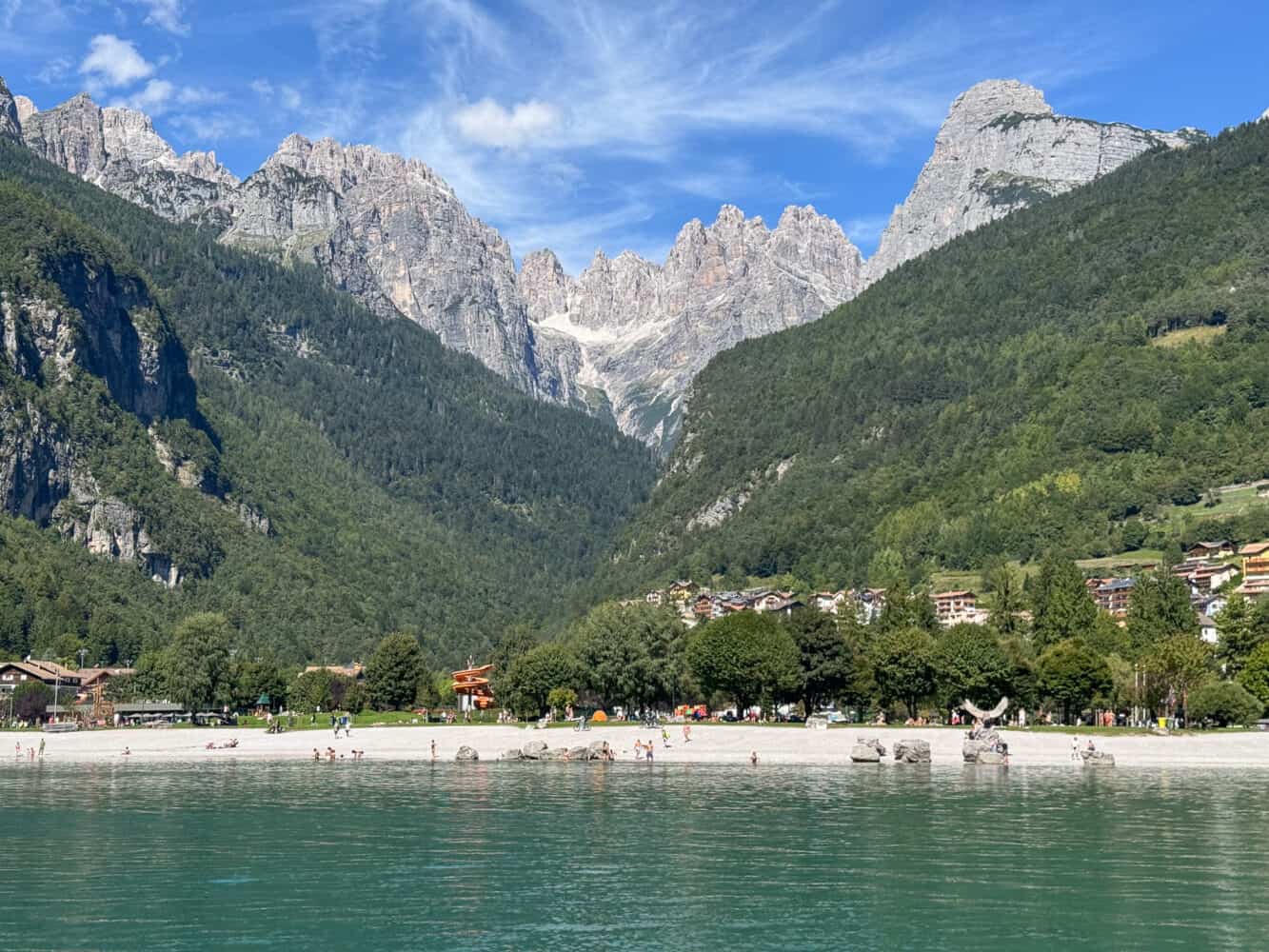
It is possible to swim in Lake Molveno, and I highly recommend it! Swimming in the clean, clear, turquoise water with the mountains soaring above was magical.
The water is pretty chilly, though. Even at the end of August, the water was 18ºC (64ºF), and it’ll be colder earlier in the summer. It was too cold for Simon, but I loved it.
I swam from the private beach at our hotel, the Grand Hotel Molveno, but Molveno village has a long white pebble beach where you can swim in the calm water. Water shoes are helpful on the pebbles, but are not essential.
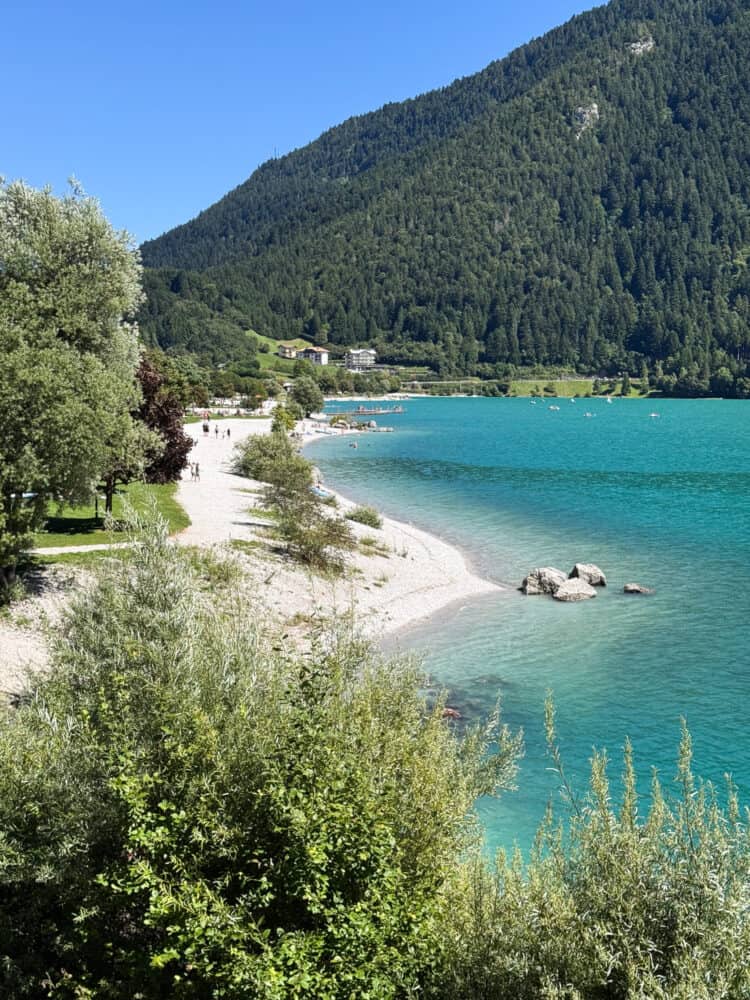
Behind the beach is a large area of lush grass that’s a lovely spot to hang out. You can rent beach chairs from the boat rental place (see below).
In the lido area, there’s also an outdoor swimming pool, a kids’ playground, mini golf, and water sports rentals.
5) Rent an Electric Boat
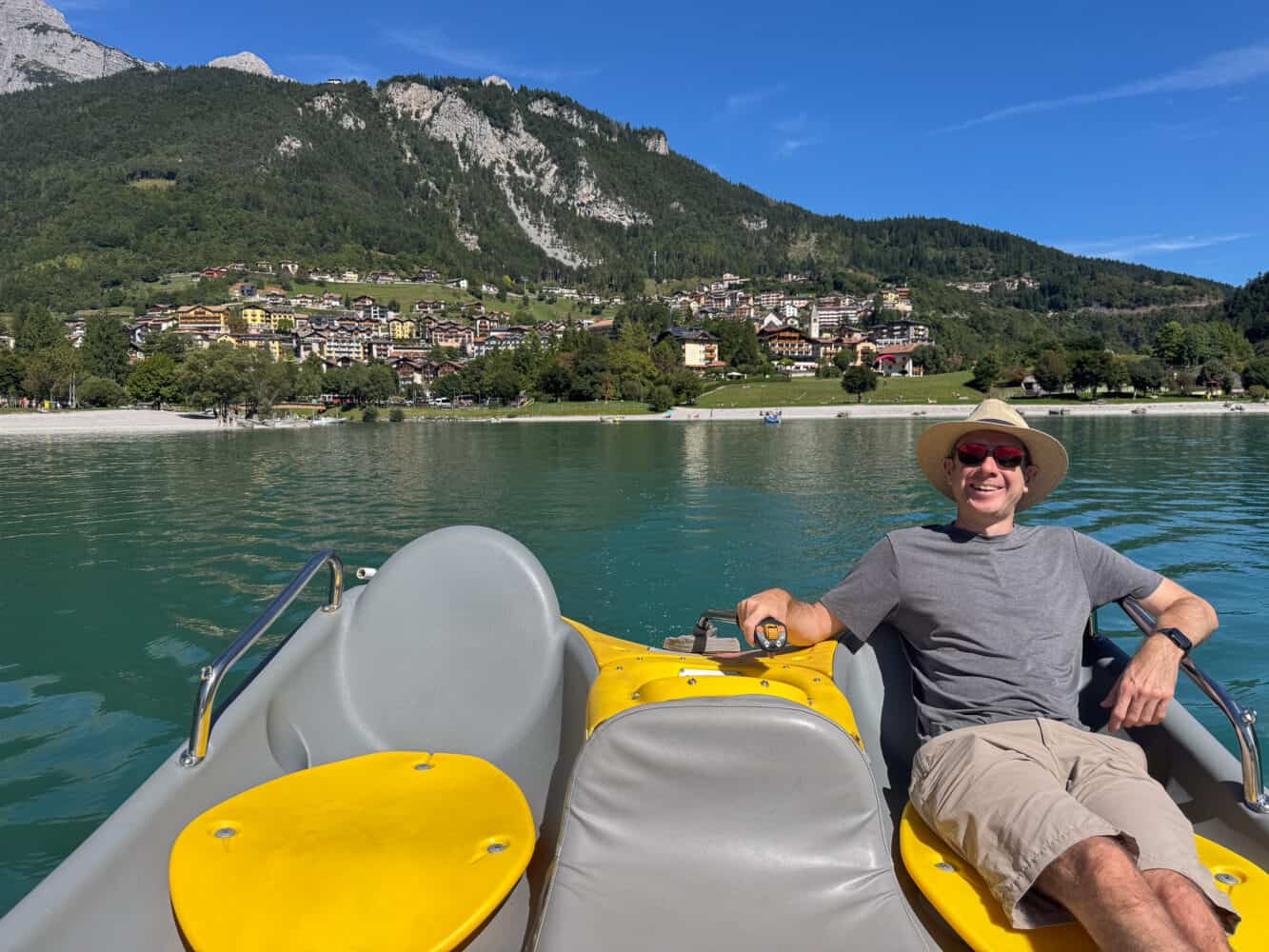
Another excellent way to enjoy the lake is to rent an electric boat (motor boats are banned).
At the lake, there’s a rental hut where you can rent boats as well as kayaks, standup paddleboards, beach chairs, and book a round of mini golf.
We rented a Gogo boat because it looked the most comfortable, with six seats in a semi-reclining position.
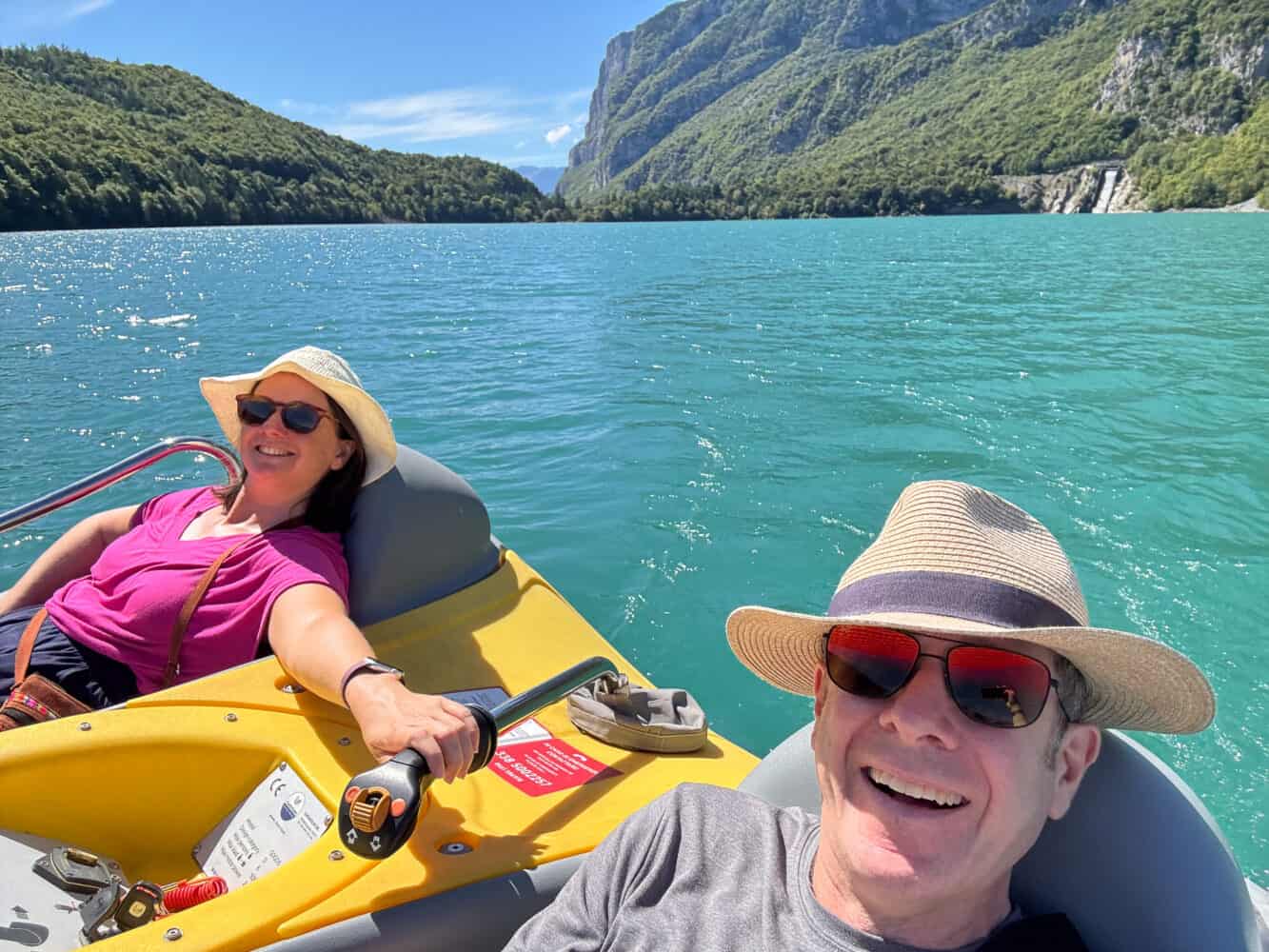
The boats are easy to operate (no experience necessary), although they aren’t the most responsive. They are slow but quiet, and we found the experience really relaxing, and the views are, of course, stunning.
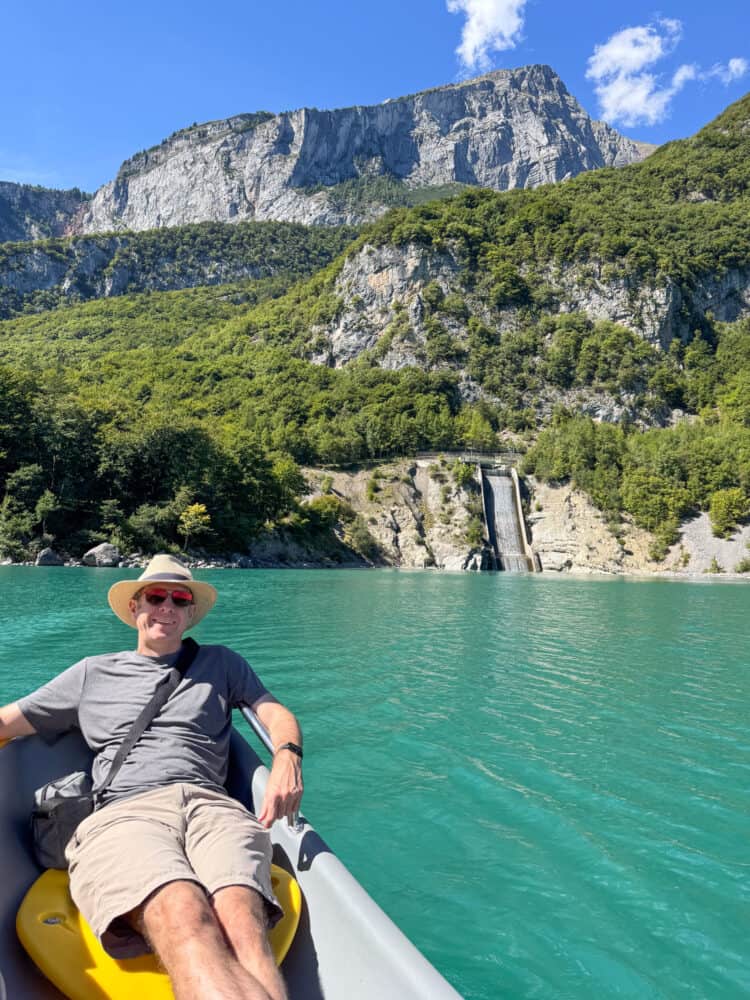
Two hours is just enough time to get to the other end of the lake and back.
Details: Find the rental hut at Noleggio Barche on Google Maps. One hour Gogo boat rental costs €36, but there’s a discount with the Paganella guest card, so we paid €56 for two hours. You also need a €10 cash deposit. In mid-morning, we had to wait 10 minutes for a boat to become available.
6) Paddleboard on the Lake
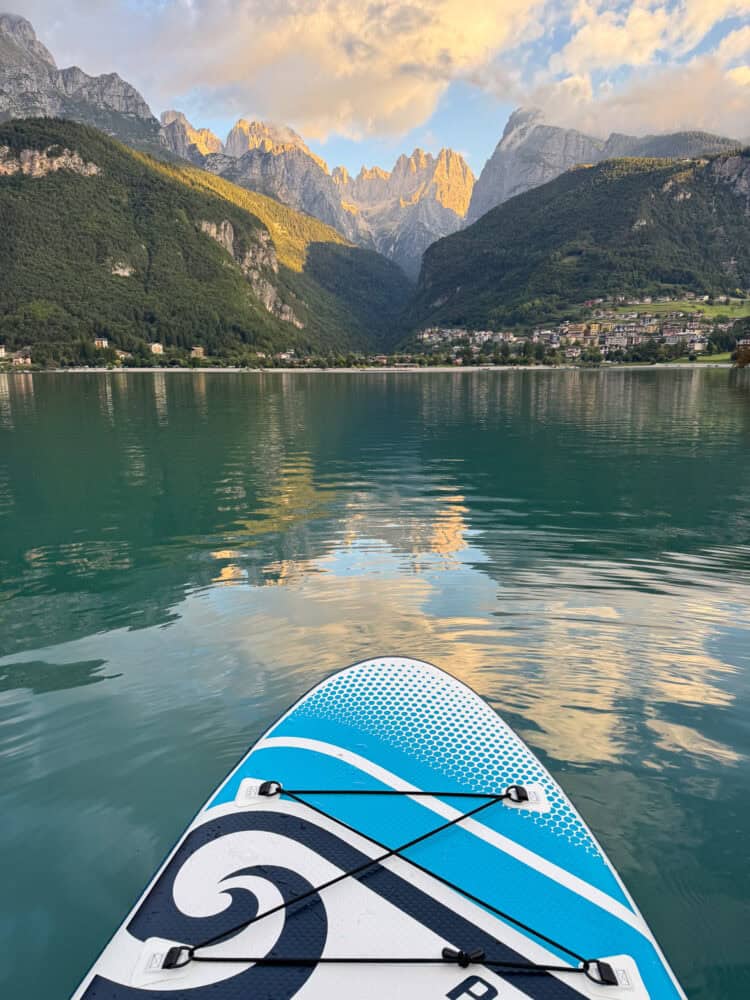
I also loved paddleboarding on the lake. I brought my own inflatable SUP and was able to leave it inflated by the lake, as our hotel has a private beach and dock.
You can also rent a paddleboard from the boat place above.
The advantage of having my own board was being able to go out early in the morning and just before sunset, when the wind was calmer and I had the entire lake to myself.
Paddling beneath the mountain peaks, glowing orange and reflected in the water, was an incredible experience.
Details: Paddleboard rentals from the rental hut in the village (Noleggio Barche) cost €13 for one hour.
7) Wander Molveno Village
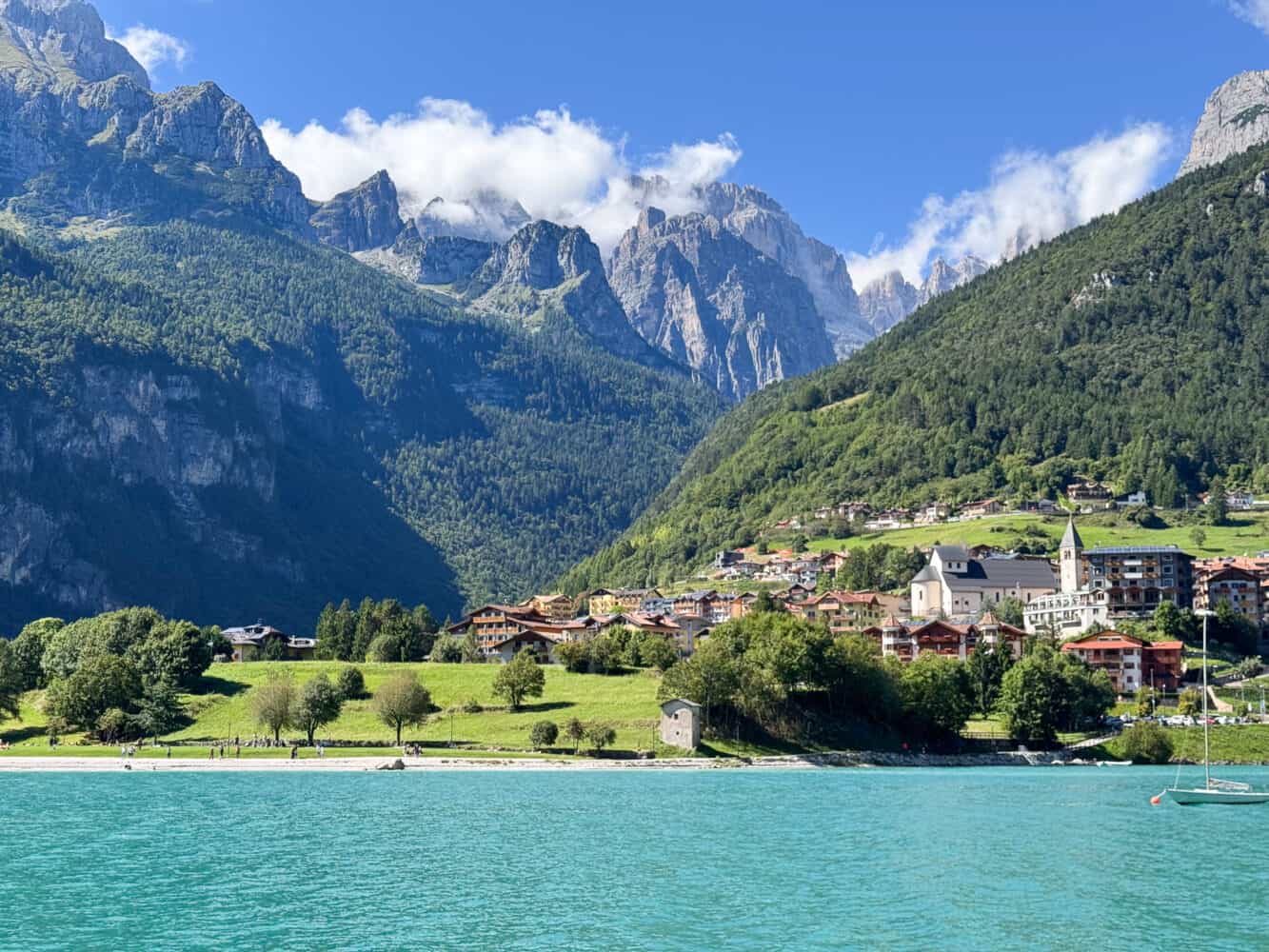
Molveno village, situated on the shores of the lake, is a picturesque place with pitched-roof Alpine buildings in pastel shades and flower boxes on its balconies.
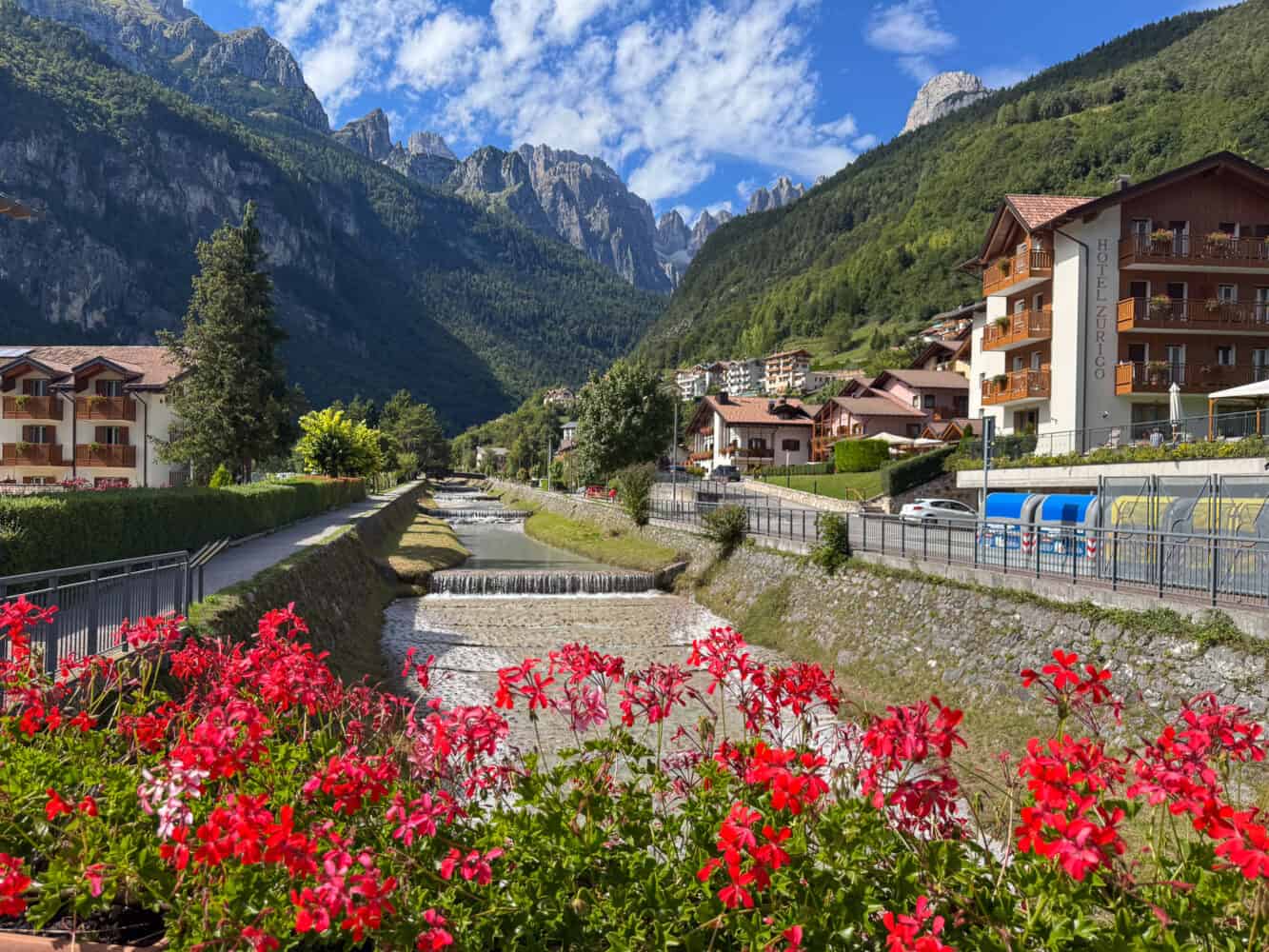
Closer to the lake are the recreational facilities, as well as restaurants and hotels located on Via Lungolago, just a short distance back from the water.
The traffic-free historic centre is up the hill with a church, plus shops and restaurants.
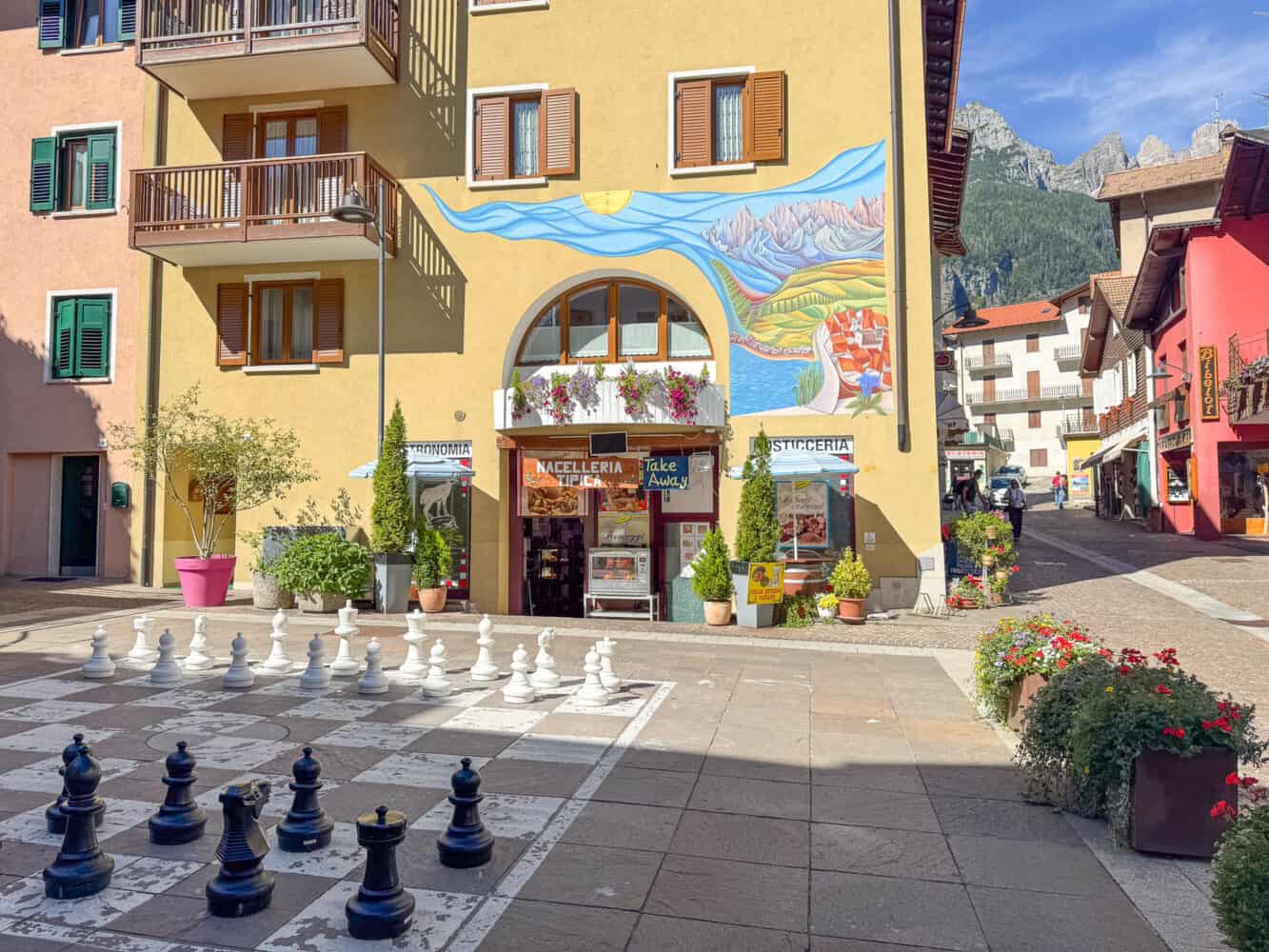
The cable car is located in the upper part of town.
For one of the best views, go to Ponte sul Rio Massò, a bridge over the river close to the boat rental. The sight of the turquoise waterfalls with the village and jagged peaks behind is postcard-perfect.
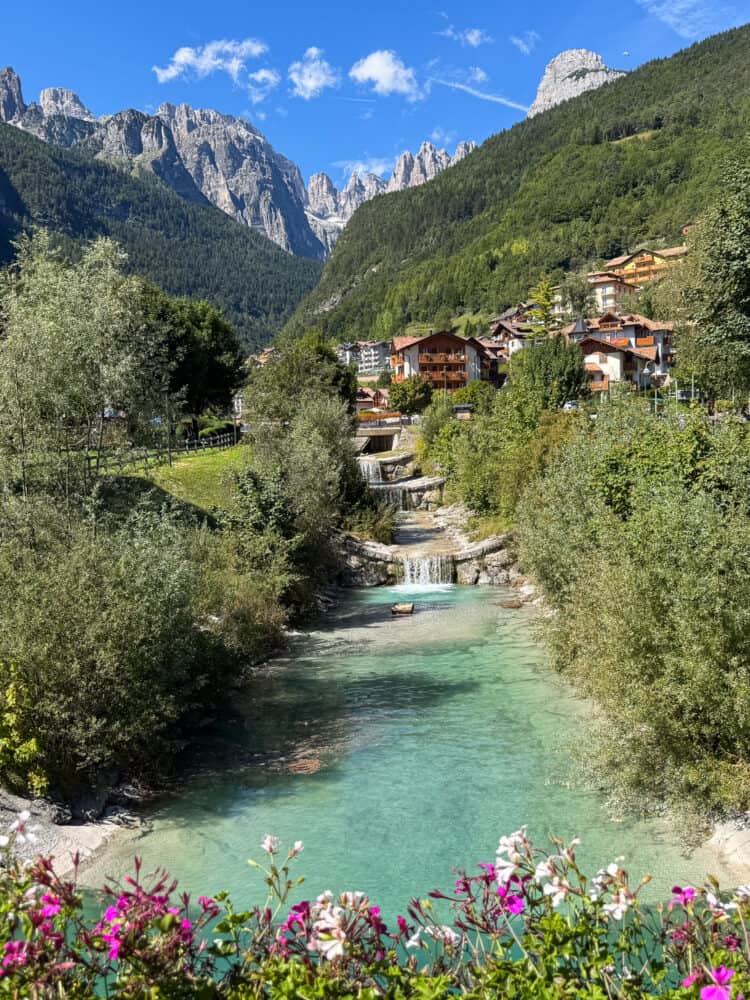
Where We Stayed: Grand Hotel Molveno Review
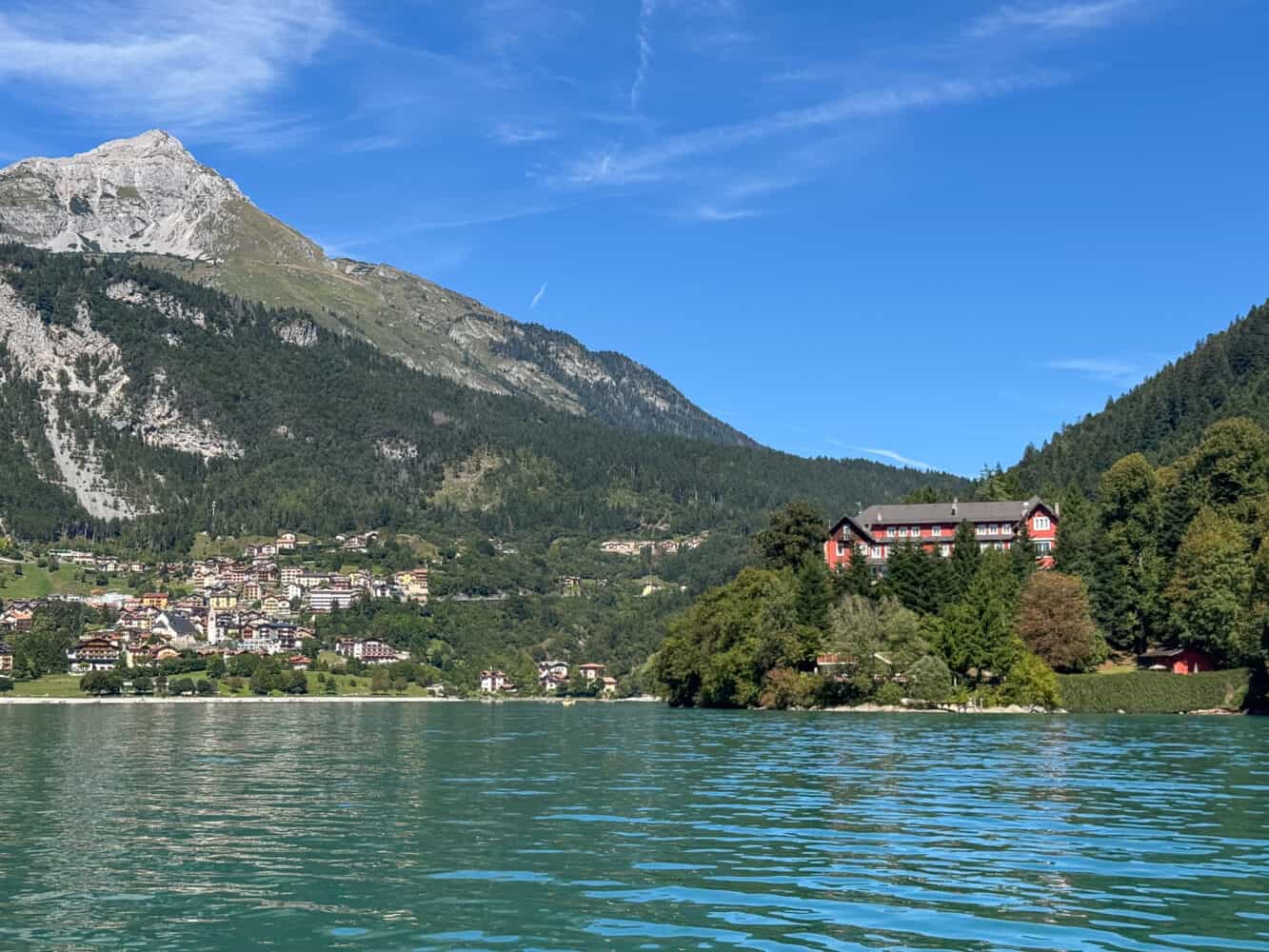
We stayed a little out of town at the Grand Hotel Molveno, which has been run by the Bettega family since 1906.
This 3-star hotel isn’t fancy, but it does have the perfect location on the banks of Lake Molveno with stunning views of the village and Brenta Dolomites.
The hotel is an easy 20-minute walk from town on the pleasant lakeside path that’s lit at night.
It felt more peaceful on this side of the lake, and the views were better than in town.
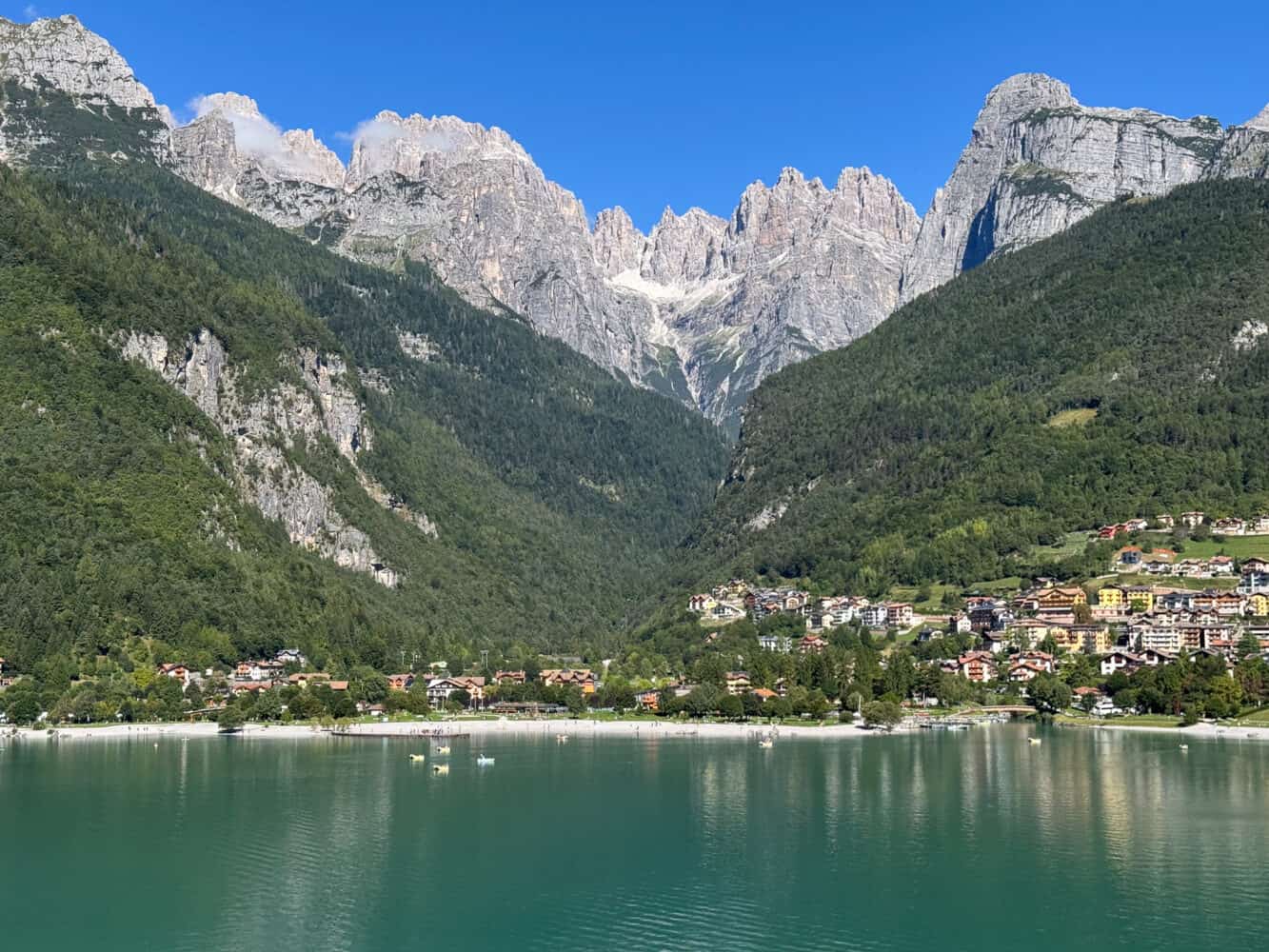
Facilities
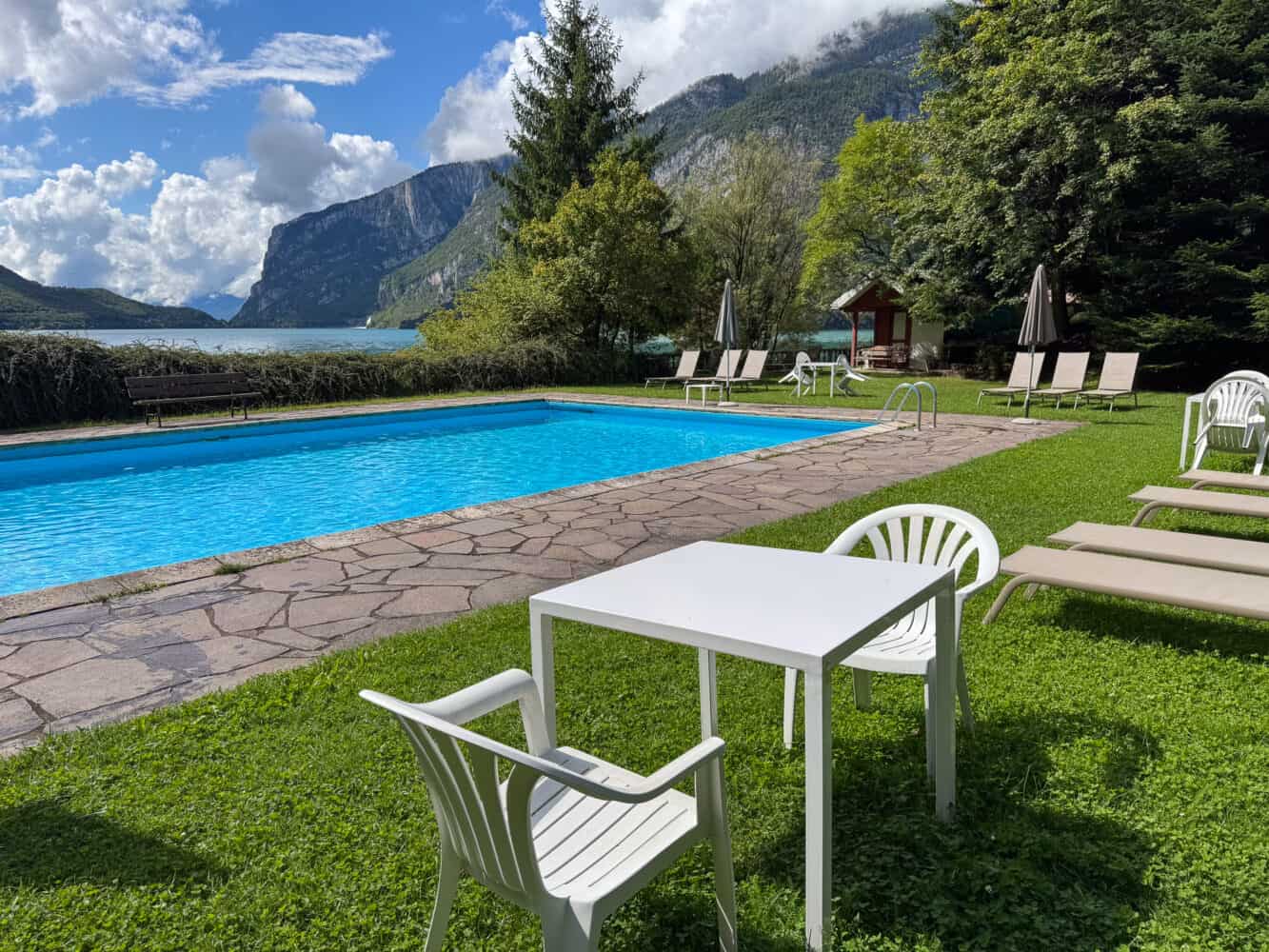
We loved the extensive grounds that led down the hill to a heated pool by the lake, complete with loungers on the grass (ask for pool towels at reception).
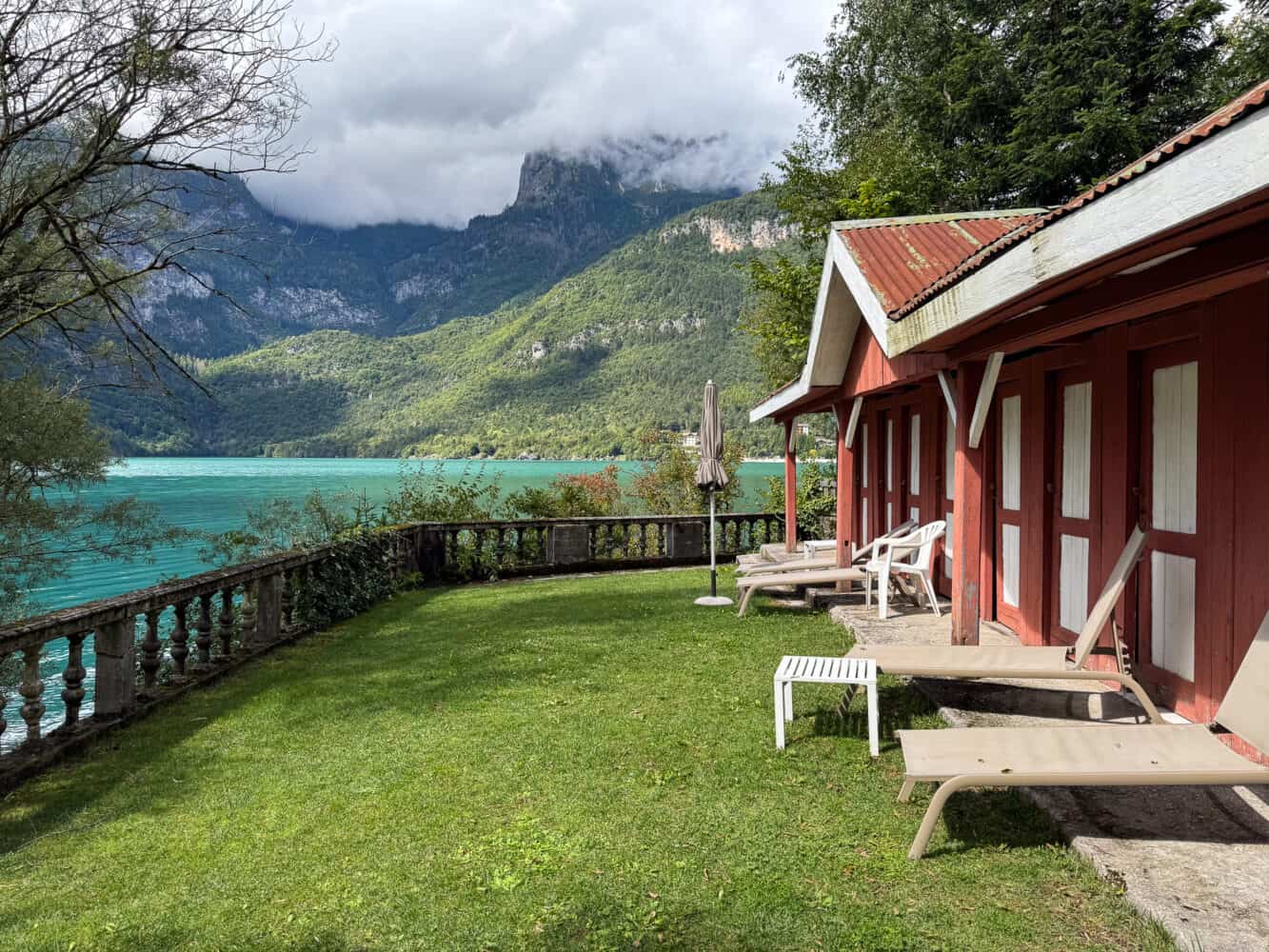
It’s a great place to relax, although I preferred to swim in the lake itself from the tiny private beach or dock.
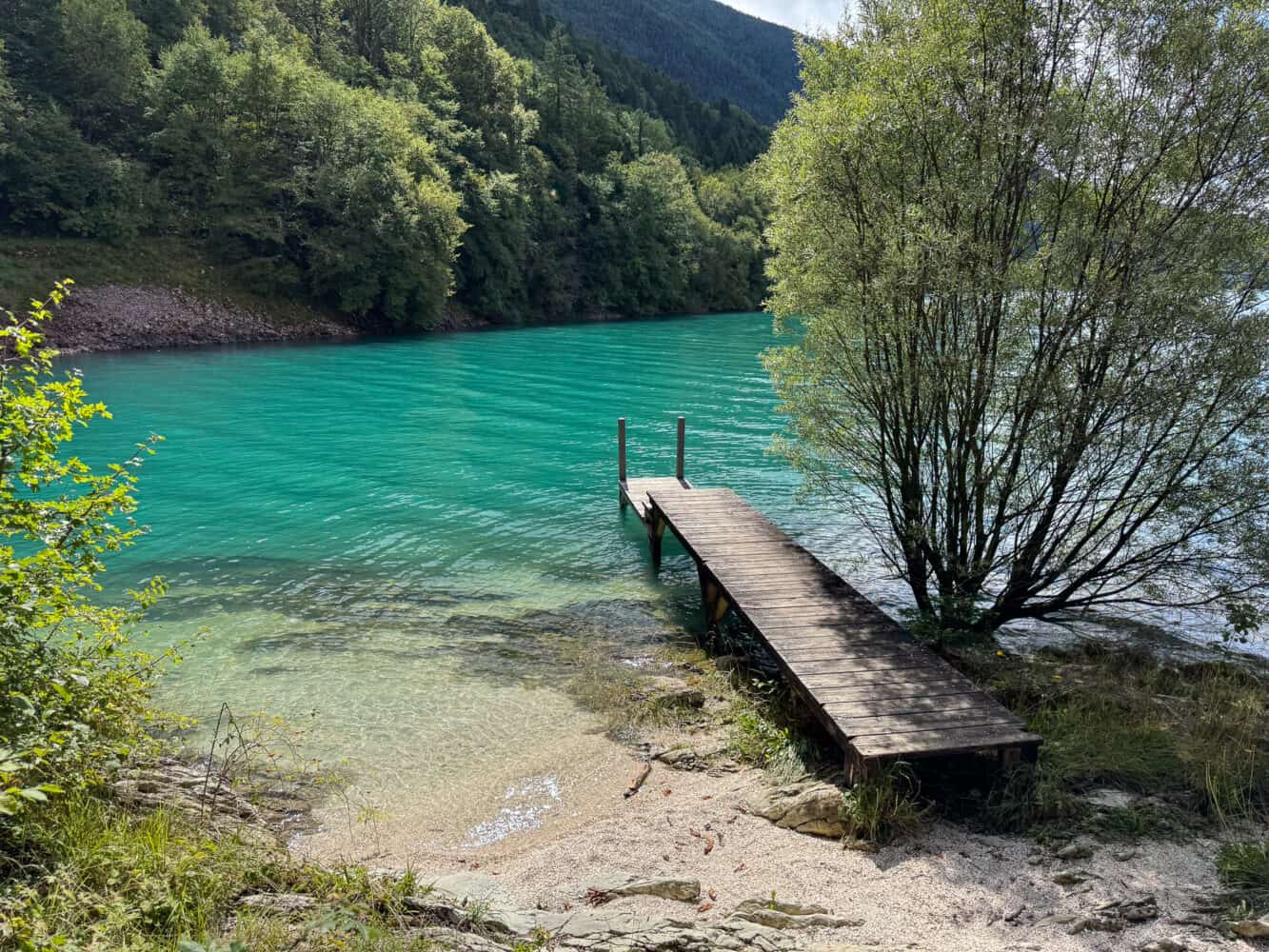
I was able to leave my paddleboard behind a shed down by the lake.
There’s also a games room with table tennis and kids play area, a bar with a wonderful terrace view, and a restaurant (more on food below).
There’s a tennis court a few minutes’ walk from the hotel in the woods, but it looked a little neglected.
Our Room
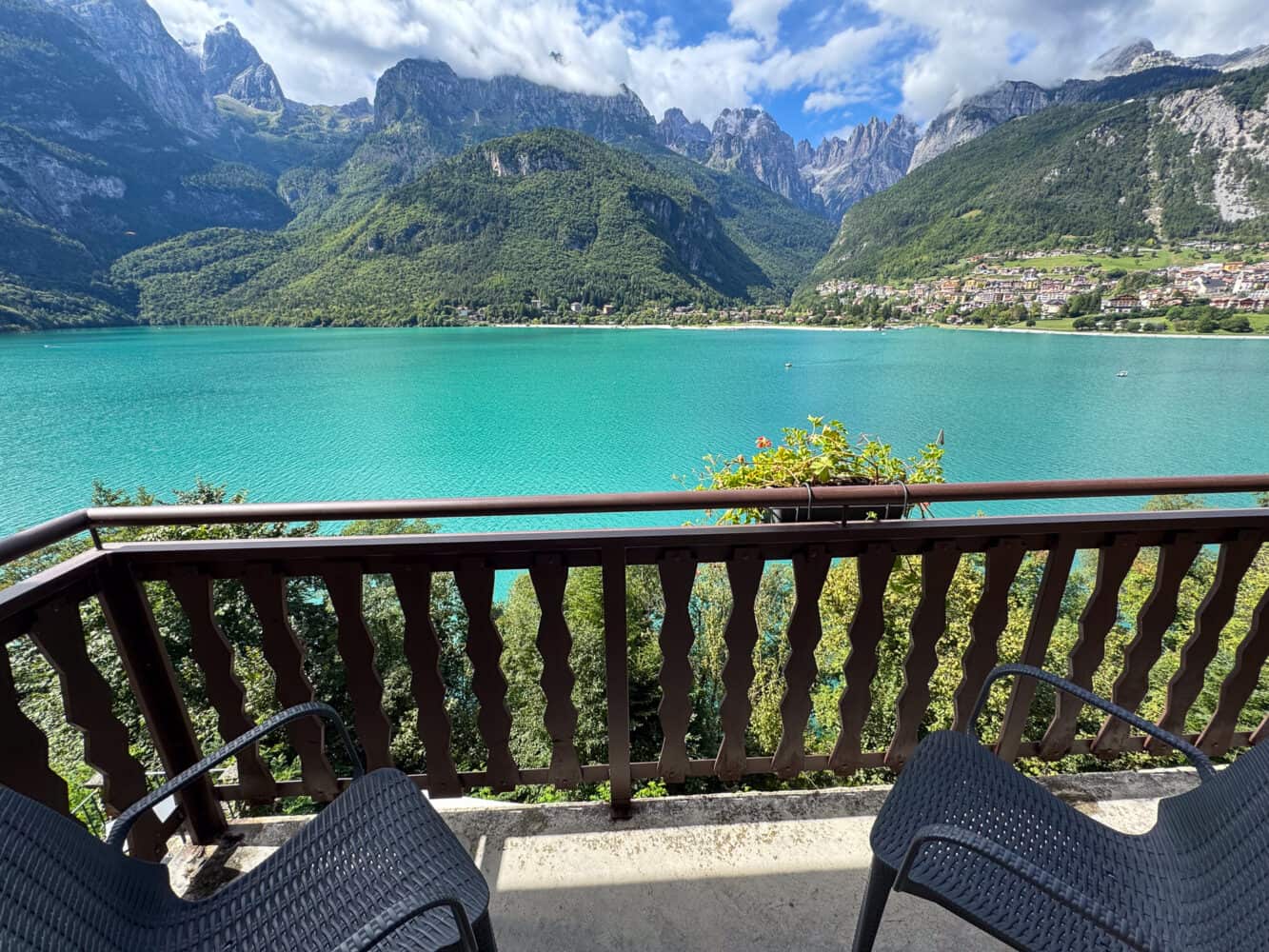
We made sure to book a lake-view room (and requested a balcony, as not all rooms have them) to take advantage of the amazing views. Sitting on our balcony was definitely a highlight.
Our room was simple, featuring two twin beds pushed together and a single pillow each (although they provided extras promptly when we requested them).
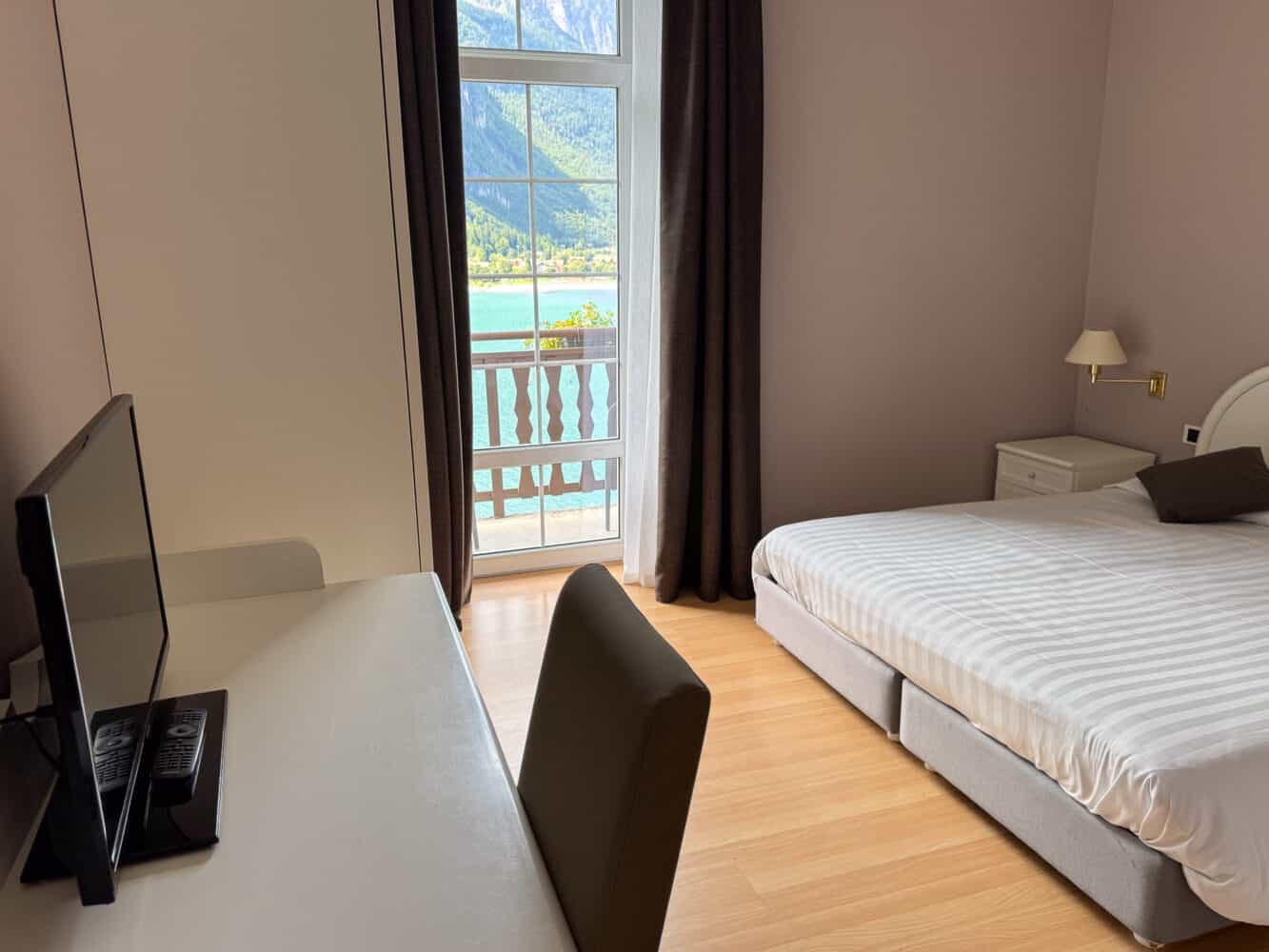
There’s an empty fridge and a basic small TV, but no kettle or glasses. There was no air conditioning, but opening the door to our balcony provided enough of a breeze (nights are cool anyway).
We had a desk and plenty of storage in the wardrobe.
The bathroom was a bit dated, with a poorly designed shower that allowed water to spill everywhere. At least it was hot and powerful.
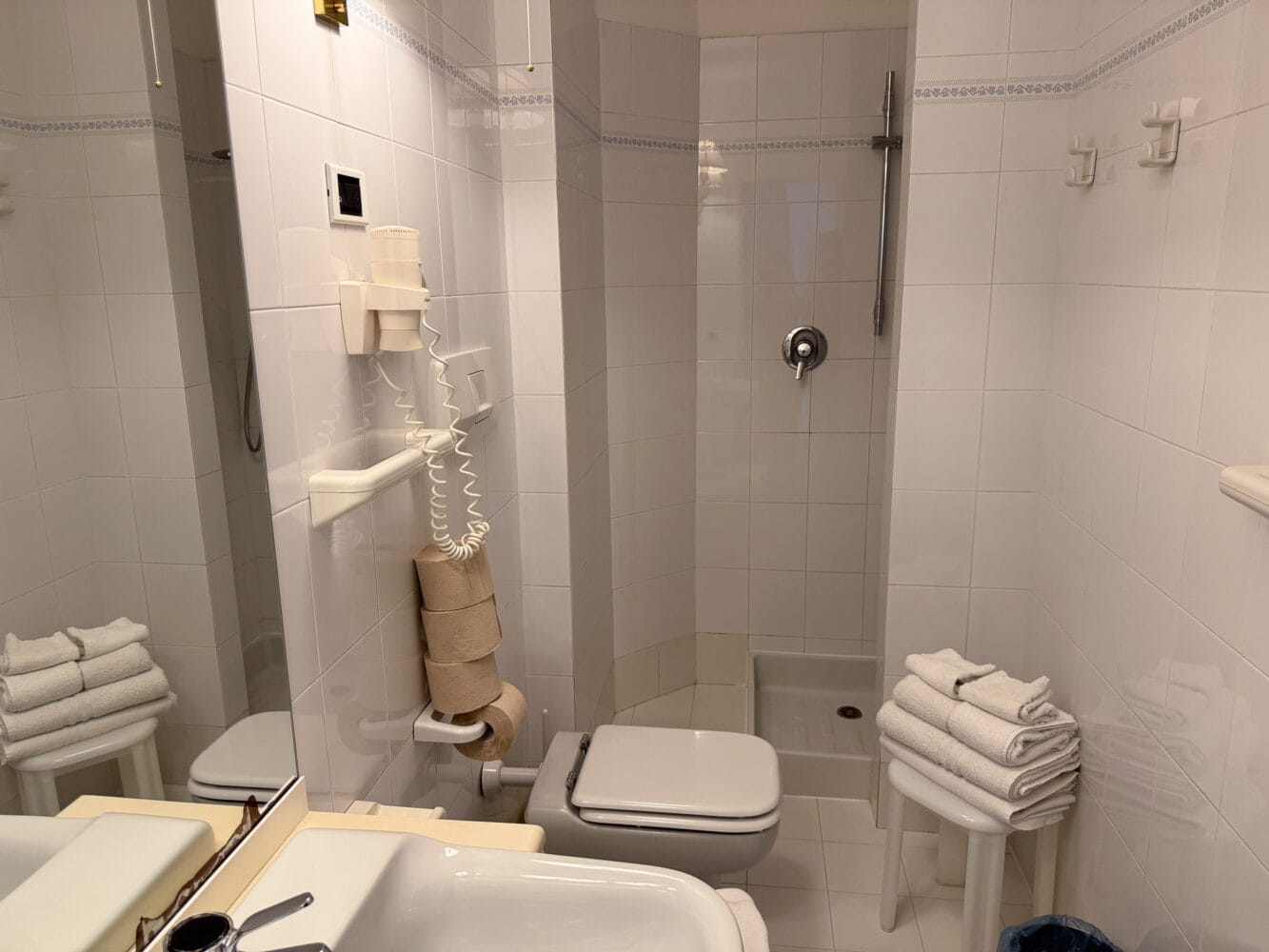
Housekeeping did a good job, but they start by 9am. Be sure to put up a ‘Do Not Disturb’ sign if you want to lie in.
The view more than made up for the minor annoyances, though.
Food
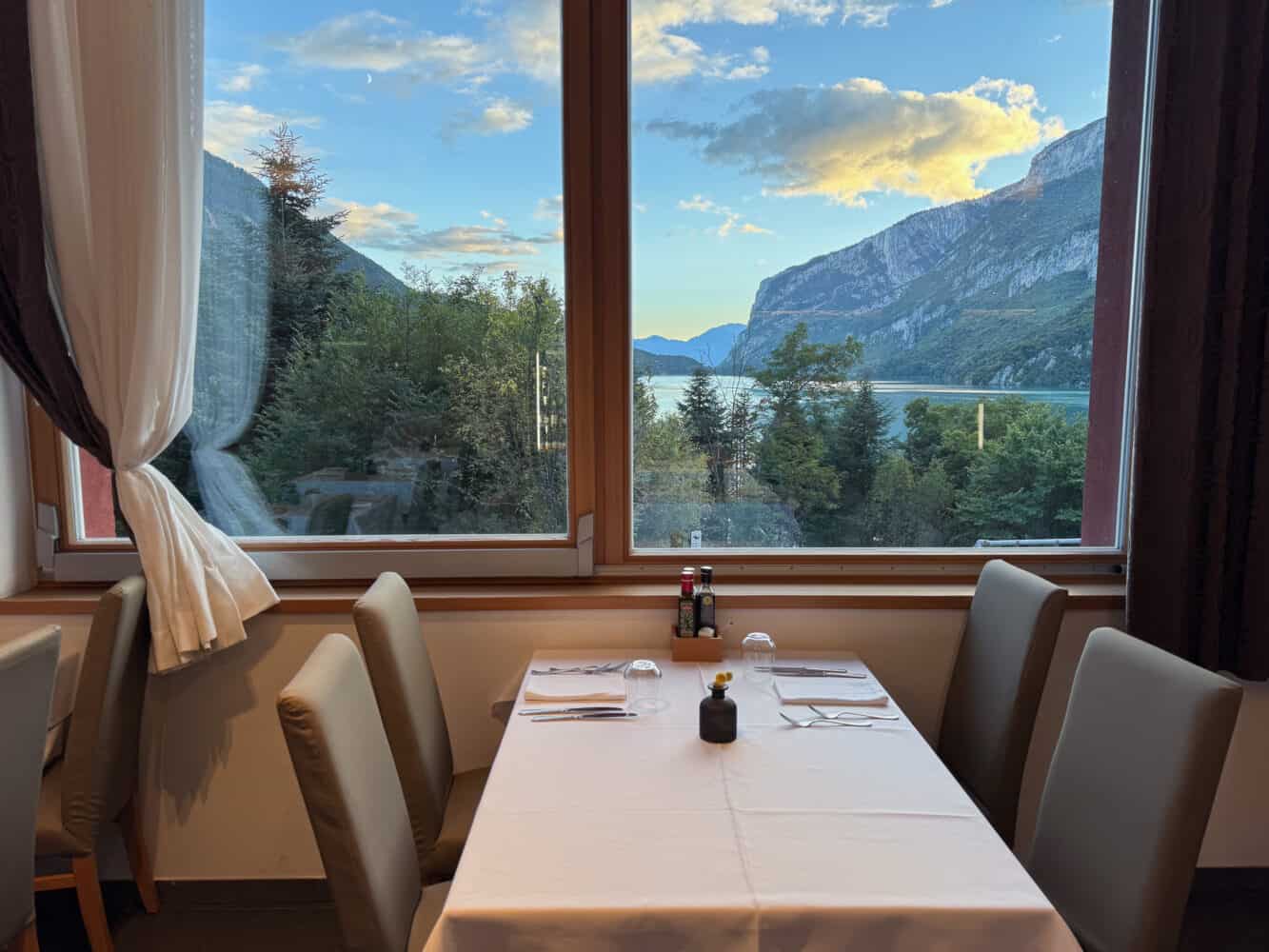
As the hotel is a bit further out and we wanted a relaxing trip where we didn’t have to think about where to eat each night, we opted for the half-board rate, which included breakfast and dinner.
We found the food to be decent, but not amazing. Partly, this is due to being a vegetarian in Trentino, which isn’t the most vegetarian-friendly region of Italy, and the Germanic influence in the food, which wasn’t always to our taste.
The night before, you choose your primo, secondo, and side (salad or vegetables) from the menu of three options (including one vegetarian choice). You choose your dessert at the end of the meal.
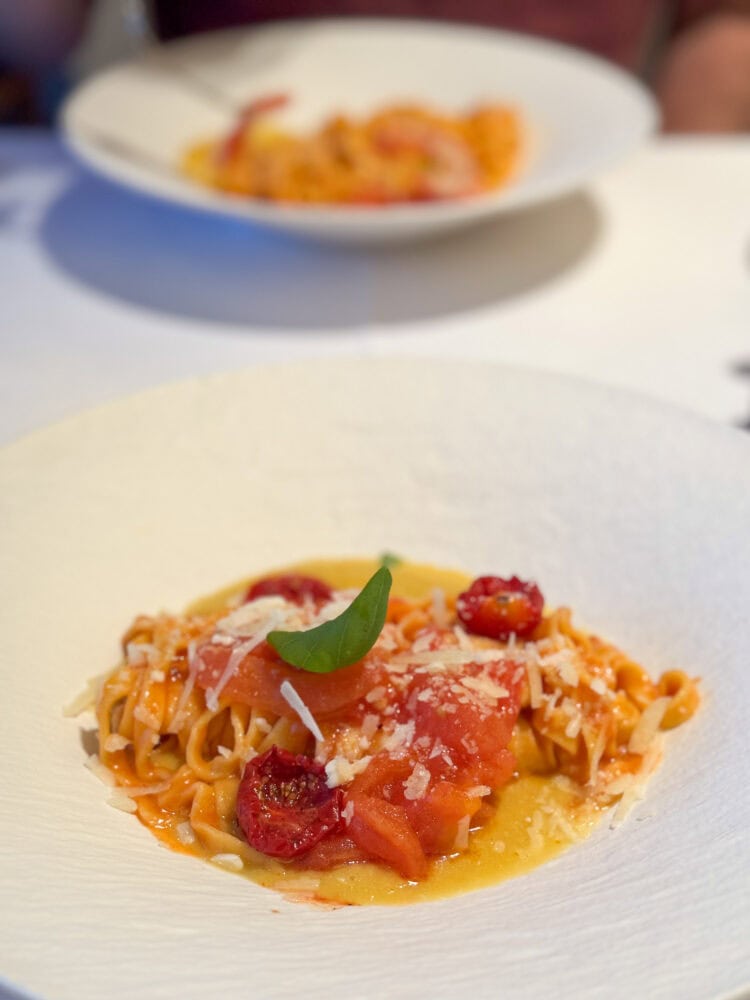
As this is a hiking destination, most people dress casually for dinner, so there’s no need to dress up.
The breakfast buffet was nothing special, but it offered a decent range, and the croissants were good. I recommend dressing warmly so you can sit outside on the terrace and enjoy the magical views.
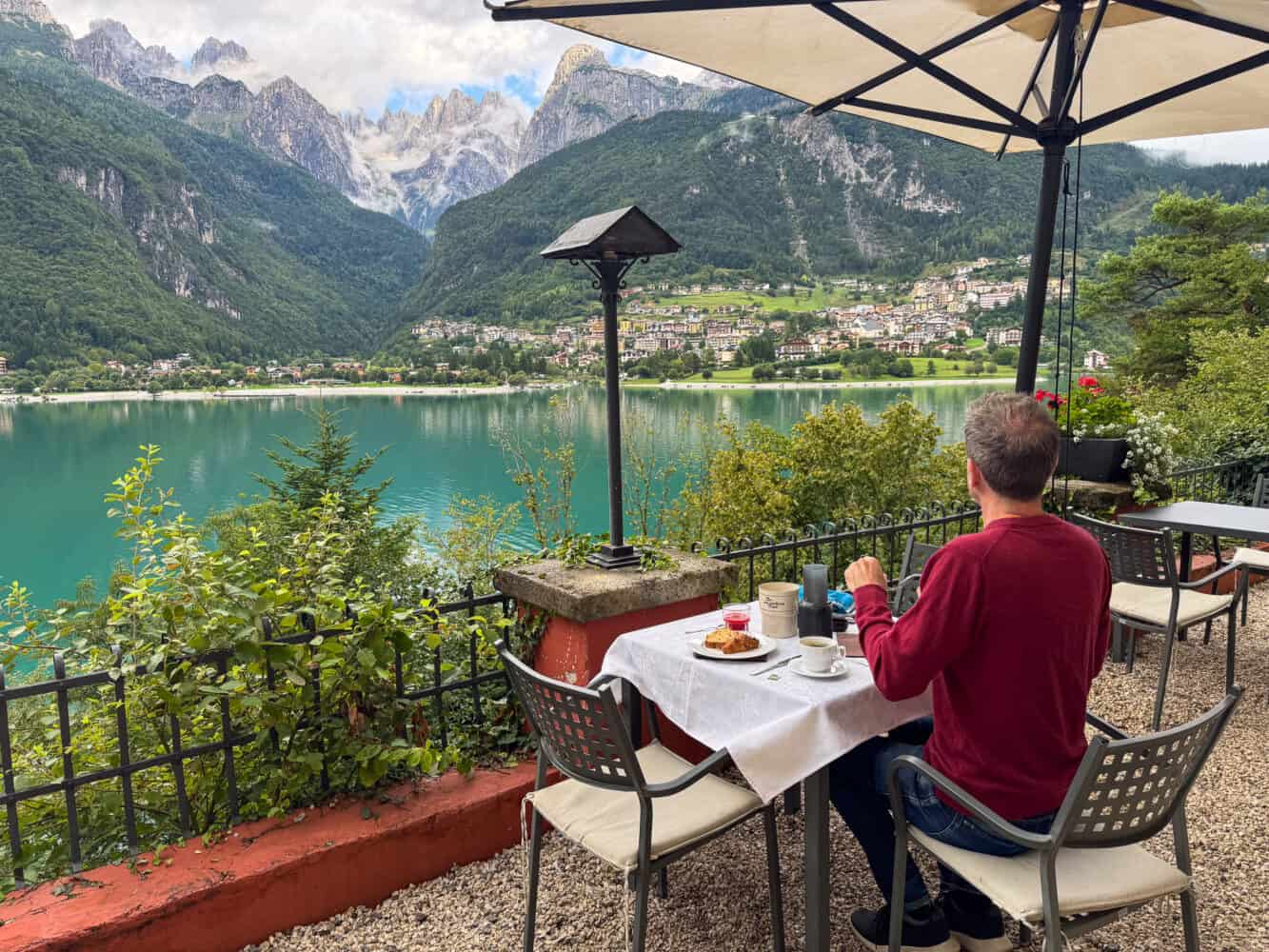
As there’s no shop or casual eatery onsite (a bar is available for drinks), I recommend stocking up on drinks and snacks to have in your room.
Cost
At around €200 per night for both of us, including breakfast and a three-course dinner, we thought the hotel was good value.
While our room was simple and the food was nothing special, the peaceful location, incredible views, and private lake access more than made up for it.
A more luxurious hotel with this setting would likely cost double the price, so I’m glad it’s affordable. We would definitely return.
Check prices and availability of Grand Hotel Molveno on Booking.
Where to Eat in Molveno
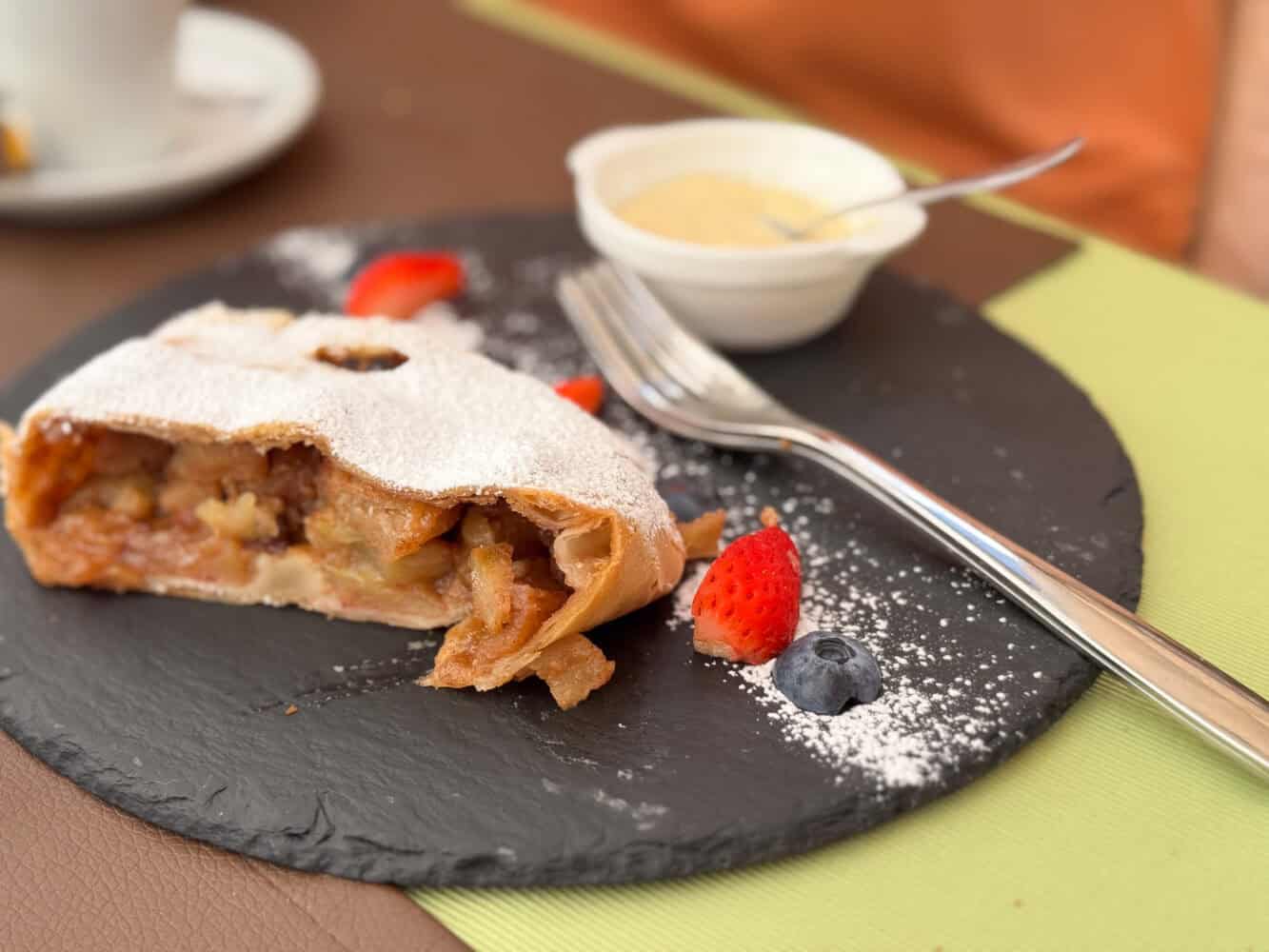
Although we had half board at our hotel, we did eat out in Molveno village for lunch.
We didn’t find the food remarkable compared to other parts of Italy, but here are a few places we enjoyed:
- Imperia – This casual bar and restaurant is ideal for lunch. There are sandwiches (including a tasty vegetarian one), pasta (the homemade tagliatelle was good), and salads. The highlight is the superb warm apple strudel—don’t miss it!
- L’Aquilone – Tasty gelato close to the lake. The cherry was especially good.
- Pizzico – A casual pizza spot opposite L’Aquilone. It felt a bit chaotic on a Sunday afternoon, but the huge pizza was just what we needed after a hike (you can also order just half).
- Taverna La Botte – Another decent pizza place that also specialises in beer.
Note that if you are looking for a supermarket, it’s best to stock up before you arrive. There are a couple of small ones in the village (including the Margherita Conad), but they close in the afternoons and on Sundays.
How to Get to Lake Molveno, Italy
By Car
The easiest way to get to Lake Molveno is by car. We rented one at Verona Airport—we used Booking.com to search for the best deal and ended up with Alamo (run by Locauto).
The drive from Verona to Molveno varies in duration. On the way there, on a Saturday afternoon, it was quicker to avoid the toll road and take the route via the top of Lake Garda.
This is a pretty slow road, and it took us 2 hours and 20 minutes. Plus, we stopped at a supermarket for snacks and drinks.
On the way back, we drove the toll road (which cost €6.80) early in the morning, and it took 1 hour and 40 minutes. It was an easier, faster drive, if not quite as scenic as the other route.
By Public Transport
From Verona (or other cities in Italy), you could take the train to Trento or Mezzocorona and then catch a bus to Molveno.
From Verona airport, this would have taken us over three hours with multiple changes.
Getting Around Molveno
We walked everywhere once we were in Molveno. If you want to explore more of the region, having a car would be useful, but there are also buses available.
Parking is limited in Molveno village and must be booked in advance on the Park Molveno website.
Our hotel had plenty of free parking and we left our car there all week.
There’s a free bus in the lake area in summer, but it’s not that frequent, so the times never worked out for us.
Lake Molveno Map
Is Lake Molveno Worth Visiting?
Lake Molveno is absolutely worth visiting! Whether you are looking for a relaxing break, hanging out by the lake, or a more active adventure, it’s a fantastic spot.
We seriously could not get over how breathtaking the views are, both from the lake and higher up in the mountains. We loved enjoying it from our balcony, too.
Although it was fairly lively at the end of August, Molveno isn’t as crowded as some of the more famous Instagram spots in the Dolomites, so it never felt too busy.
We would definitely return to Molveno and want to do more hikes in the Brenta Dolomites.
If you have any tips, leave a comment below.
More North Italy Posts
- Dos and Don’ts of Eating in Italy
- The Best Varenna Restaurants at Lake Como
- Hiking Corniglia to Manarola in Cinque Terre
- 11 Stunning Things to Do in the Italian Riviera
- Hiking Camogli to San Fruttuoso: The Perfect Day on the Italian Riviera
- 16 Unmissable Things to Do in Bologna, Italy
If you enjoyed this post, pin for later!
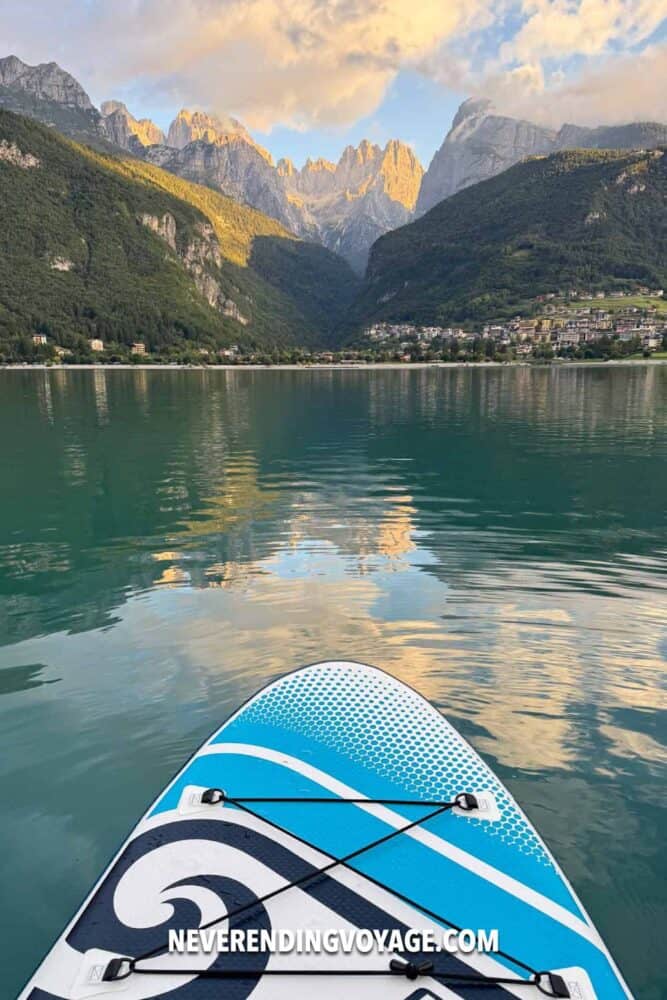
Camogli, Italy Travel Guide: Our Favourite Town on the Italian Riviera 11 Aug 3:14 AM (2 months ago)
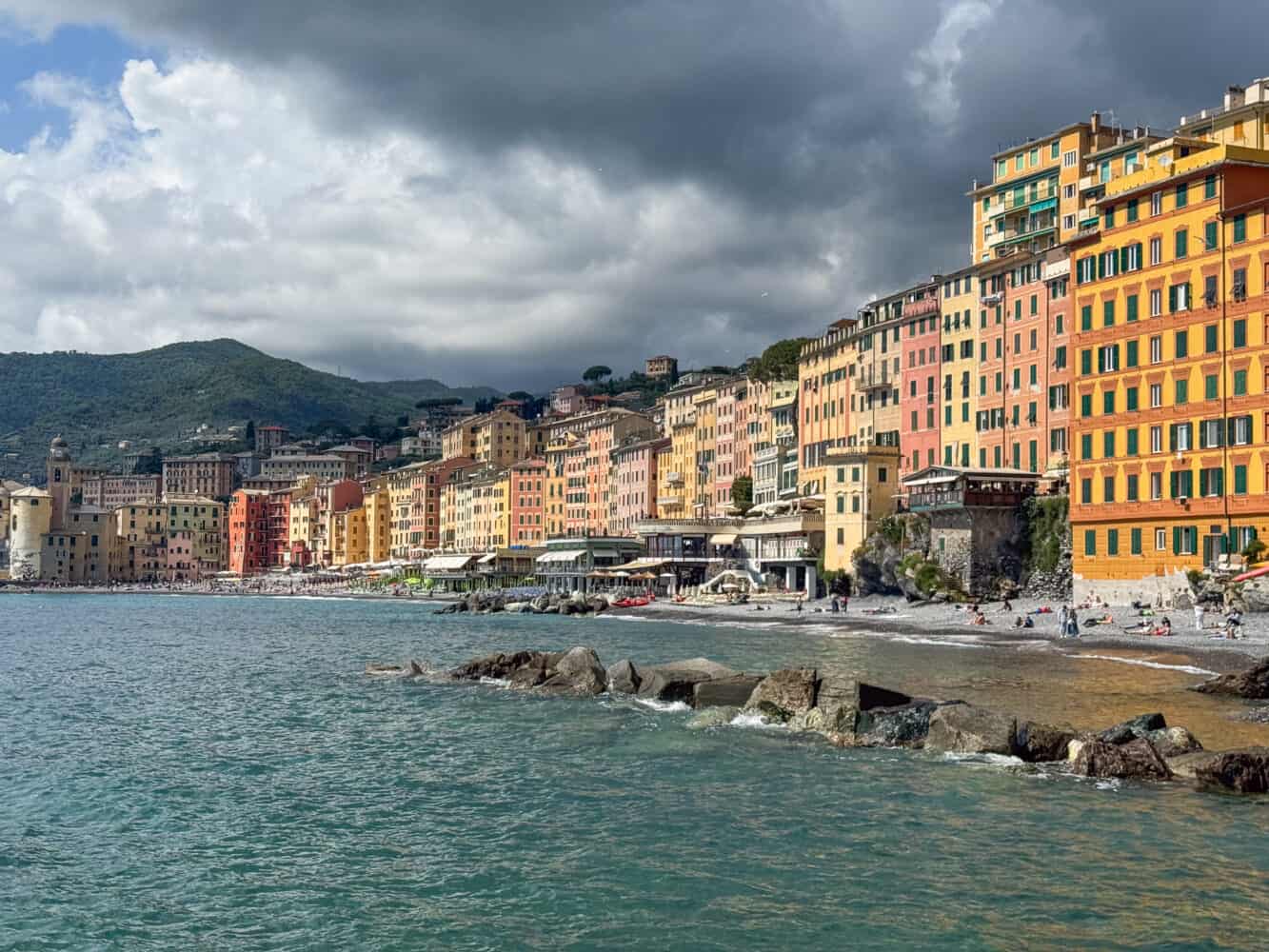
Camogli is magical. The colourful houses in this fishing village on the Italian Riviera overlook a pebble beach with a backdrop of craggy cliffs and forested mountains.
It’s so ridiculously picturesque that it doesn’t feel real—I felt like I was in a fairytale, or at the very least, on a movie set.
Even after staying 10 nights (we had to extend our stay, we loved it so much), every time I looked at the view, it made me happy.
There are other beautiful places on the Italian Riviera, such as Portofino and Cinque Terre, but those spots can be so crowded that they are hard to enjoy.
Camogli has a much more relaxed vibe. While it’s popular with Italians in the summer (July and August are busy), it’s overlooked by most foreign visitors.
In mid-May, it was quiet during the week and livelier (but never overwhelming) on weekends. And it was warm and sunny enough most days to enjoy the beach.
In this Camogli travel guide, I share our picks for the best things to do in Camogli, including hikes and day trips (it’s a great base for exploring the area), where to eat and stay, and how to get there.
At the end, you’ll find a Camogli map with all our recommendations.
Contents
- Where is Lake Molveno?
- Best Things to Do in Molveno
- Where We Stayed: Grand Hotel Molveno Review
- Where to Eat in Molveno
- How to Get to Lake Molveno, Italy
- Lake Molveno Map
- Is Lake Molveno Worth Visiting?
- More North Italy Posts
- Where is Camogli, Italy?
- Best Things To Do in Camogli Village
- Best Hikes and Day Trips from Camogli
- Our Favourite Places to Eat in Camogli
- Where to Stay in Camogli
- How to Get to Camogli
- Camogli, Italy Map
- Is Camogli Worth Visiting?
- More Italian Riviera Tips
Where is Camogli, Italy?
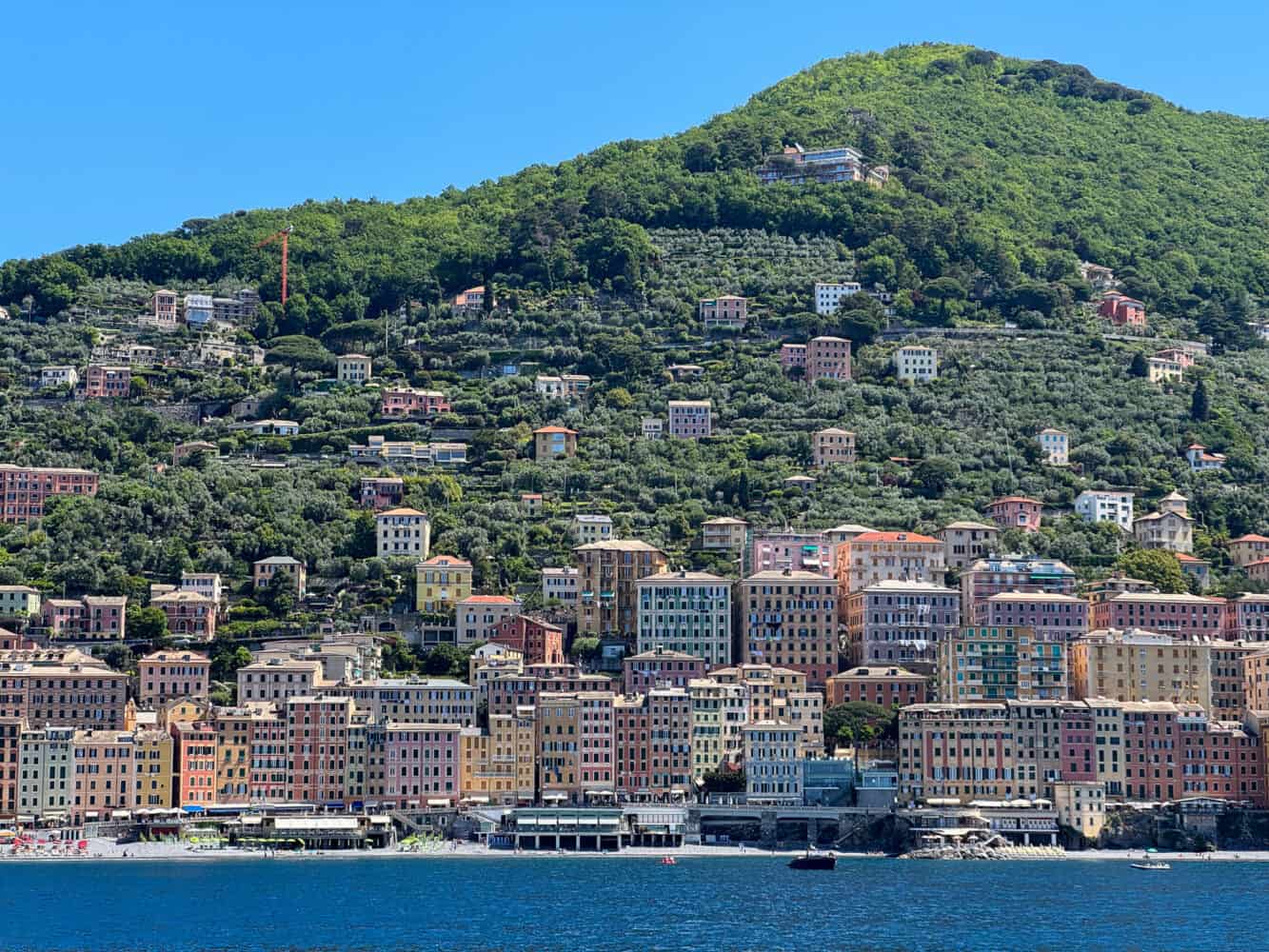
Camogli is located on the coast of Liguria, a region in northwest Italy between Tuscany and France.
The coastline is known as the Italian Riviera and includes famous towns like glitzy Portofino and the picturesque (but crowded) Cinque Terre villages.
The nearest major city (and international airport) is Genoa (Genova in Italian), which is 25 kilometres (16 miles) up the coast.
I include details on how to get to Camogli below.
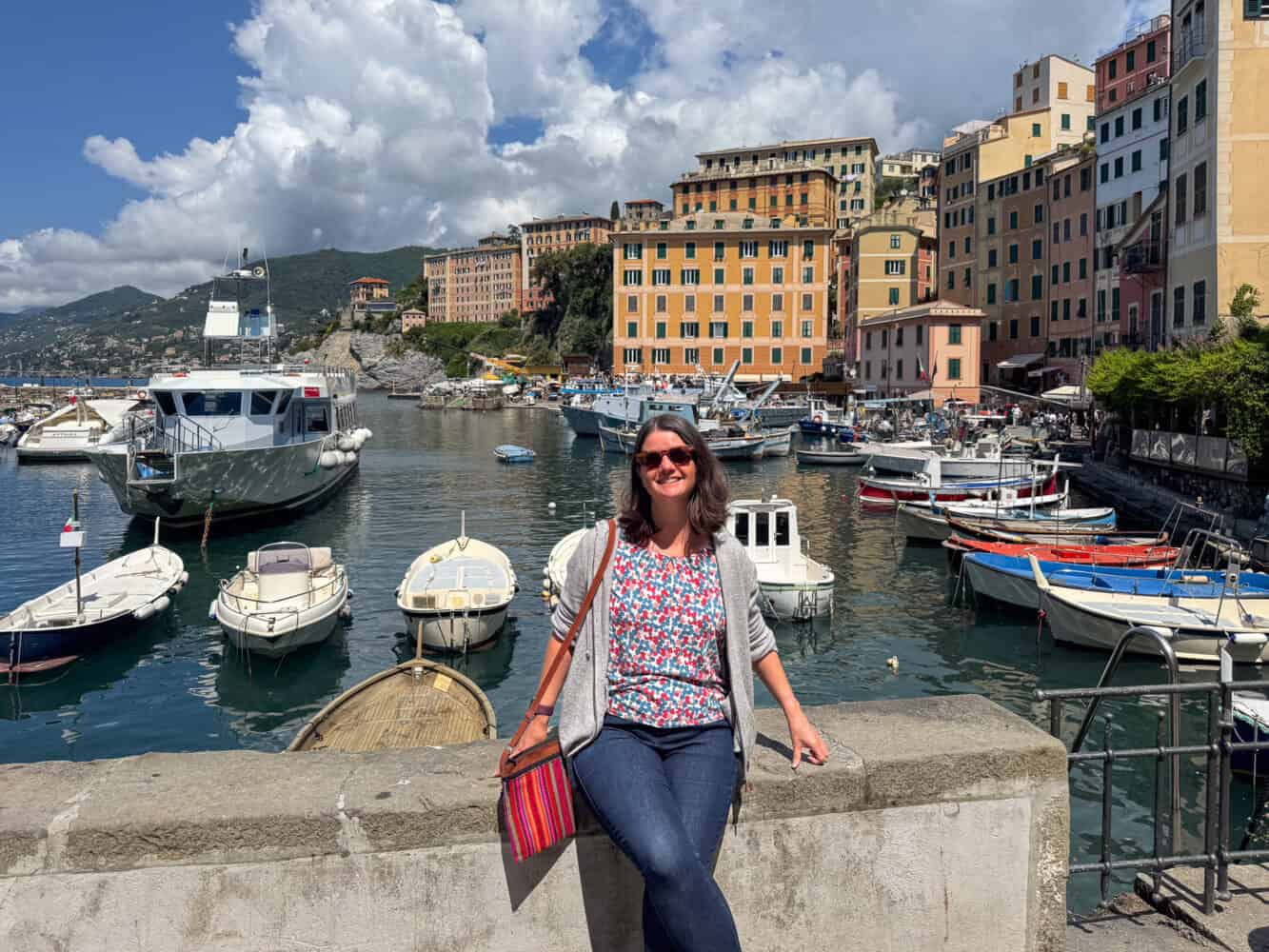
Best Things To Do in Camogli Village
Camogli is a fairly small place with a population of around 5000 people. There’s not a ton to do, but it’s a lovely place to wander, enjoy a drink or meal, and relax on the beach.
In this section, I share what to do in Camogli village—everything is in easy walking distance. Following these are my picks of the best day trips (by foot, ferry, or train) to explore further afield.
Stroll the Promenade
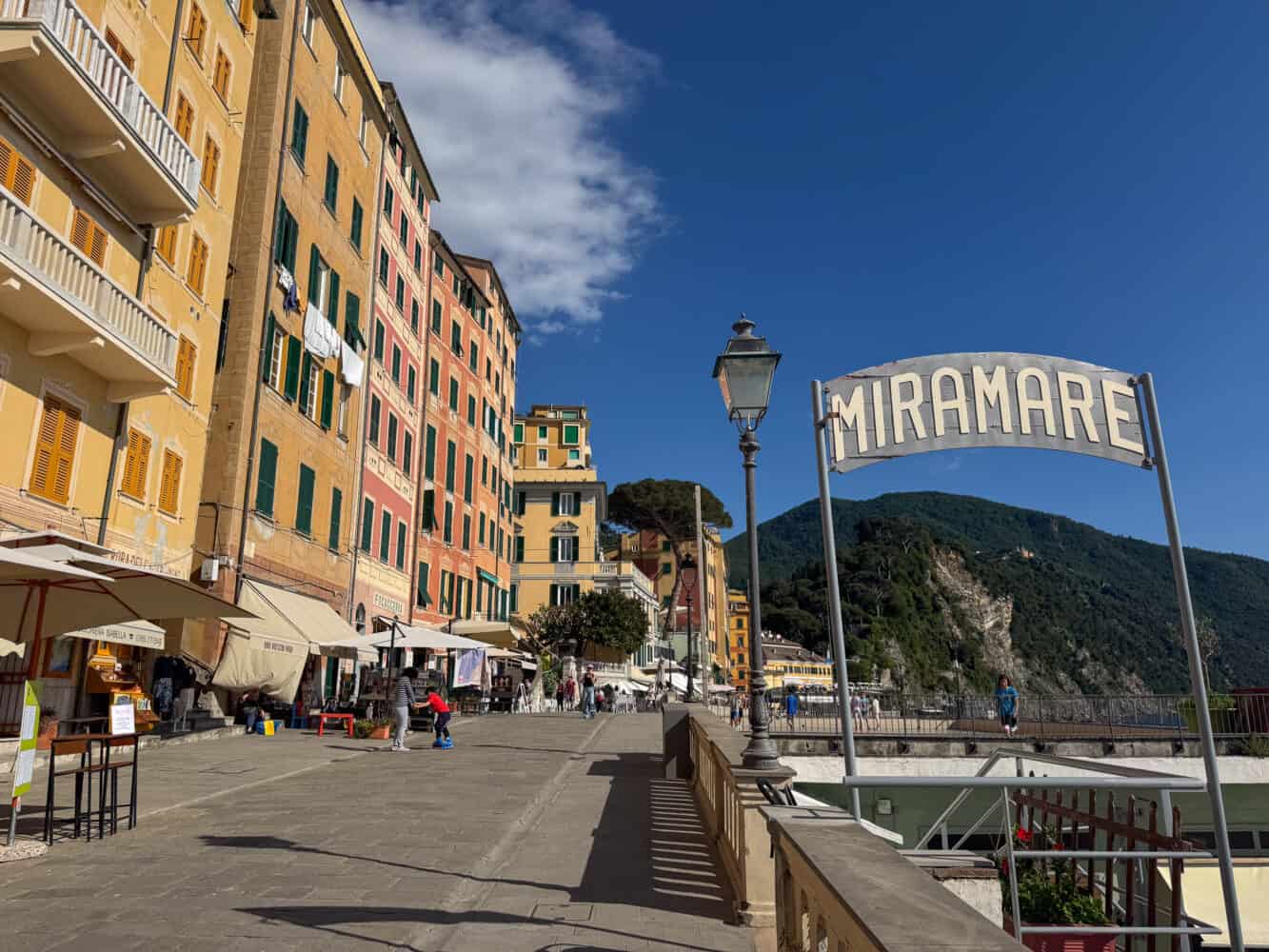
There are really only two major streets in Camogli.
The main street (Via XX Settembre turning into Via della Repubblica) is above the sea. It is where you’ll find the train station, most of the local shops (including a supermarket), and some restaurants and bars.
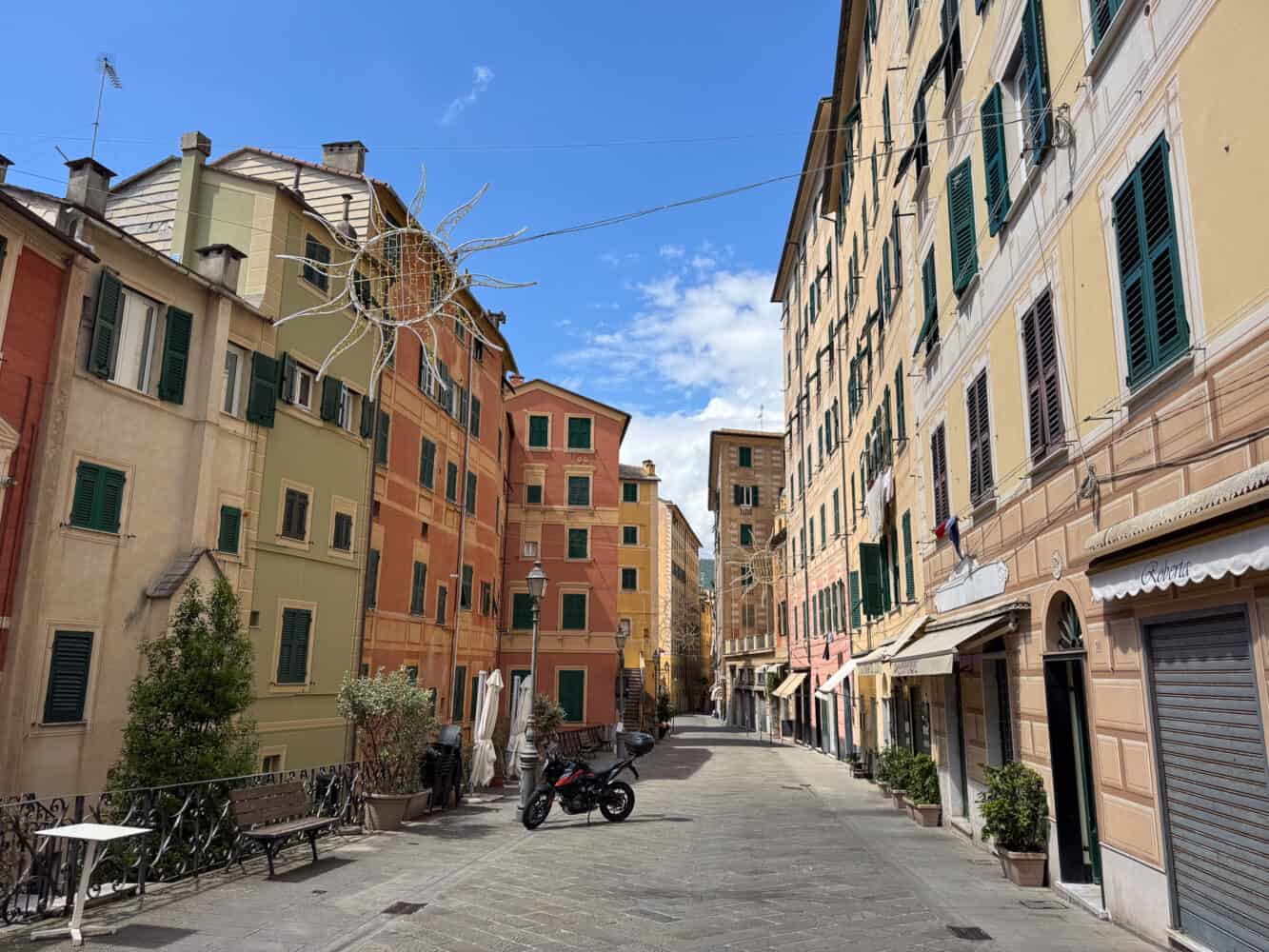
Steep staircases (or an elevator opposite the station) lead down to the seafront promenade, Via Giuseppe Garibaldi.
The promenade is slightly elevated above the pebble beach and leads to the harbour. It’s away from the road, which adds to the feeling of being far away from it all.
It’s lined with tall, narrow houses in vibrant gelato shades—lemon, strawberry, mint, peach.
The colours once helped the fishermen find their way home.
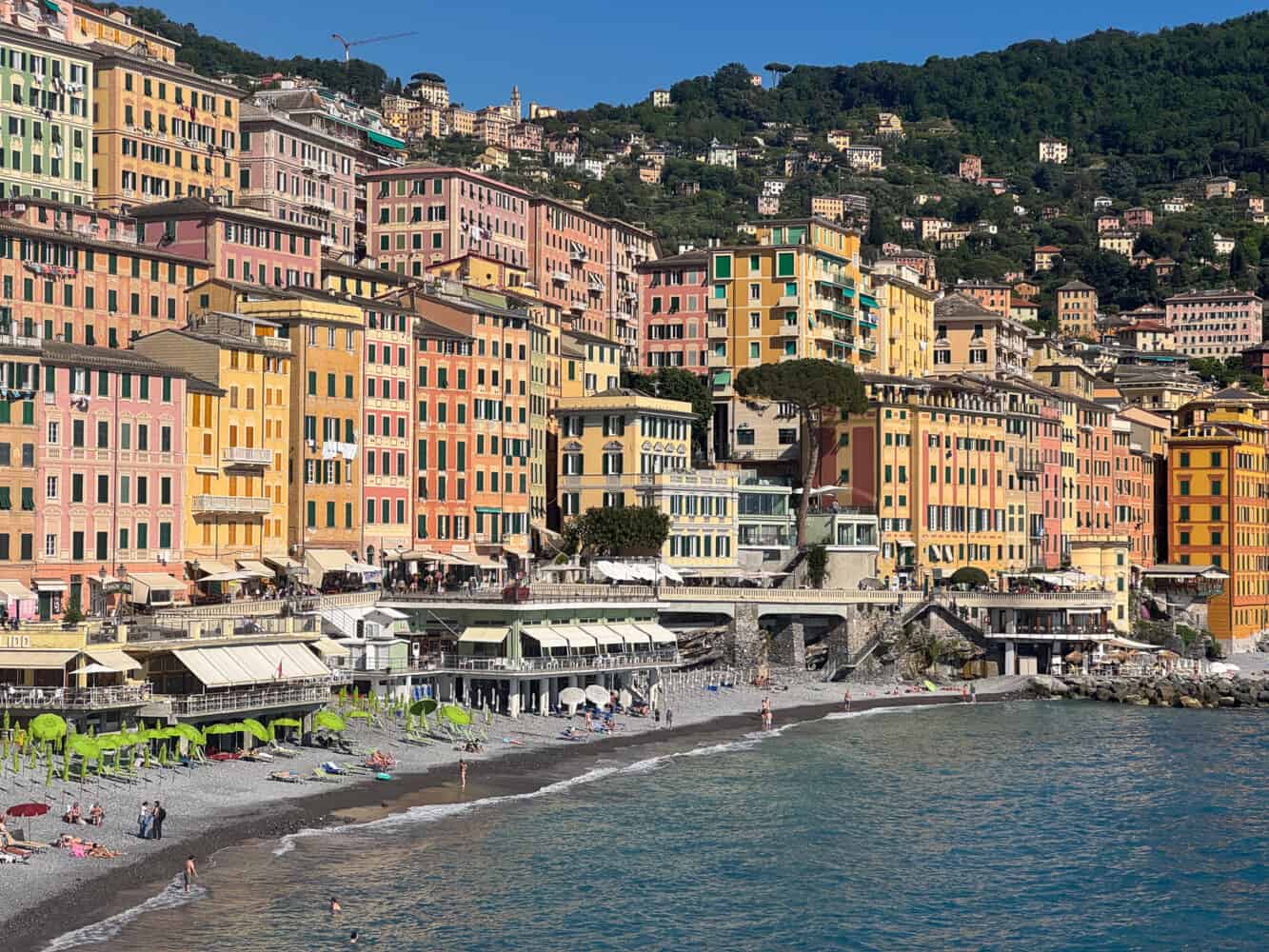
Trompe l’oeil details (found in many Ligurian towns) are painted onto the buildings—a creative solution to not being able to afford real balconies or decorative details.
The optical illusion makes Camogli feel even more like a film backdrop.
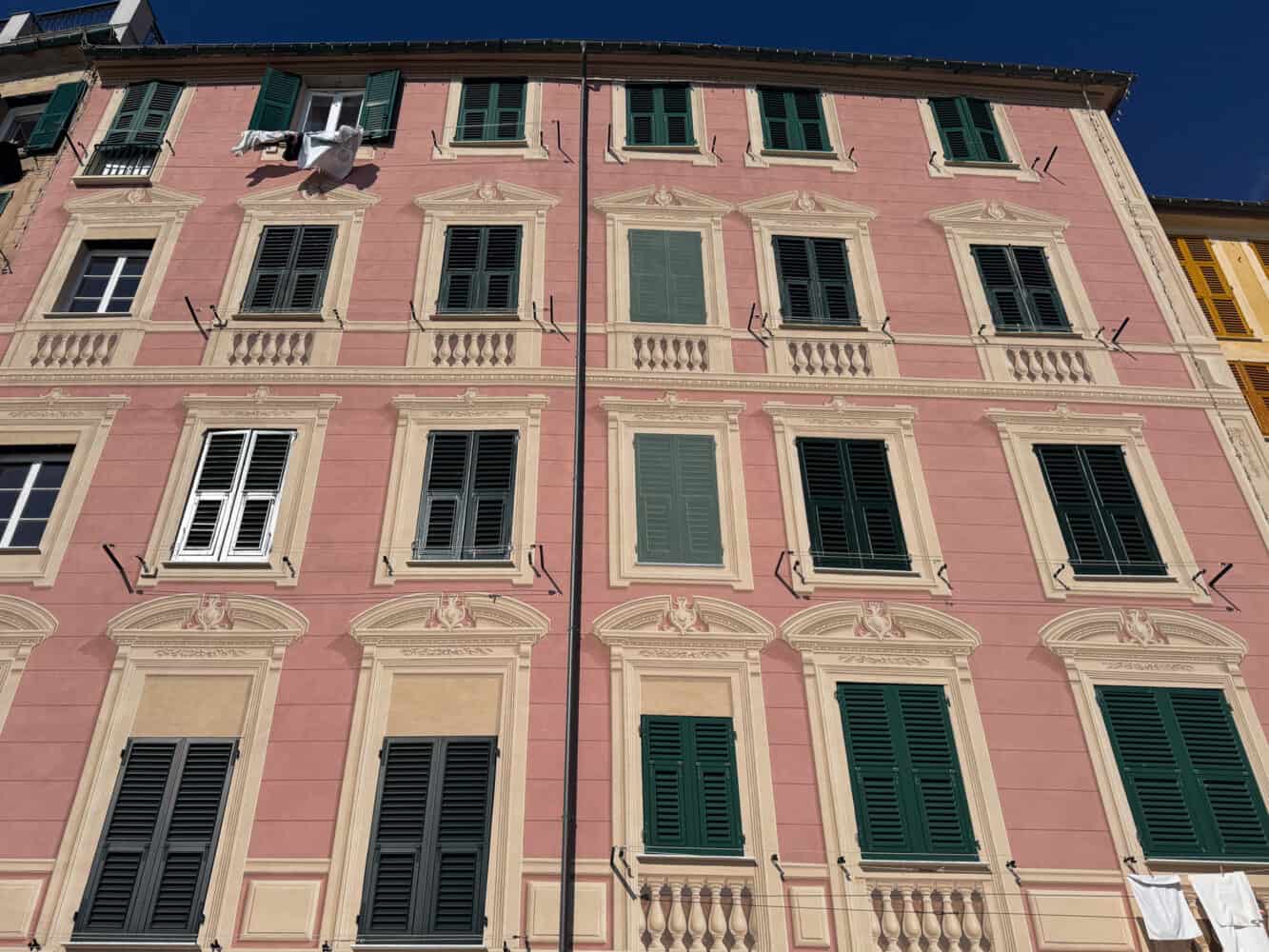
The promenade is the top spot for a stroll. You can browse the artsy shops, admire the view (Terrazza Panoramica Via Garibaldi is great for photos), or enjoy a drink or meal at one of the many bars and restaurants.
On weekends, kids play football in the tiny terraces off the promenade—flat spaces are limited in this hillside village.
Relax on Camogli Beach
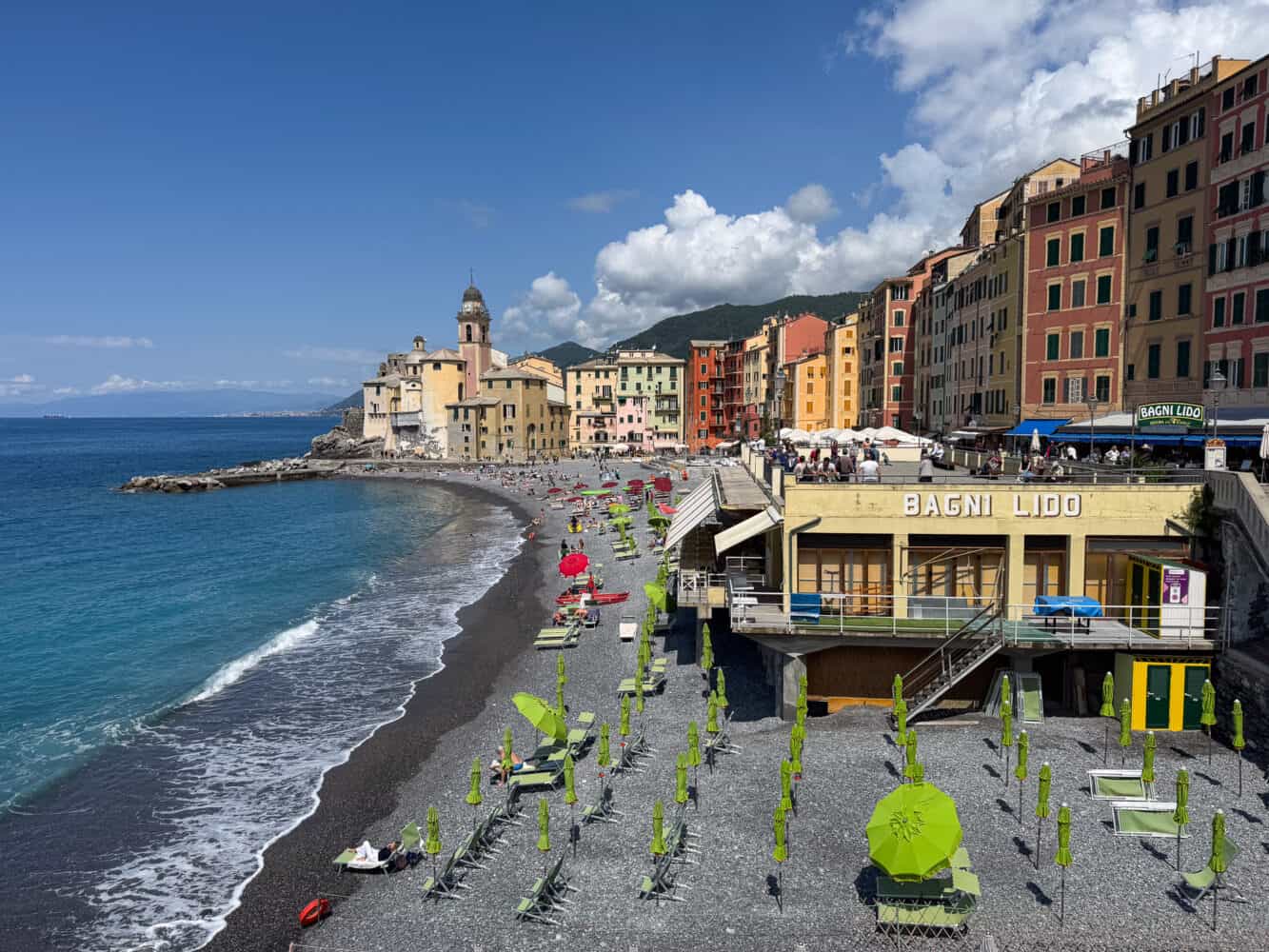
From the promenade, head down a few steps to the beach.
Camogli has one of our favourite beaches on the Italian Riviera. It’s fairly large with a mix of grey pebbles and black sand leading to clear blue sea.
The view of the colourful houses and church is what makes it so special, and the fact that there’s no traffic noise as it’s away from the road. But you’re never far from a gelato or slice of focaccia.
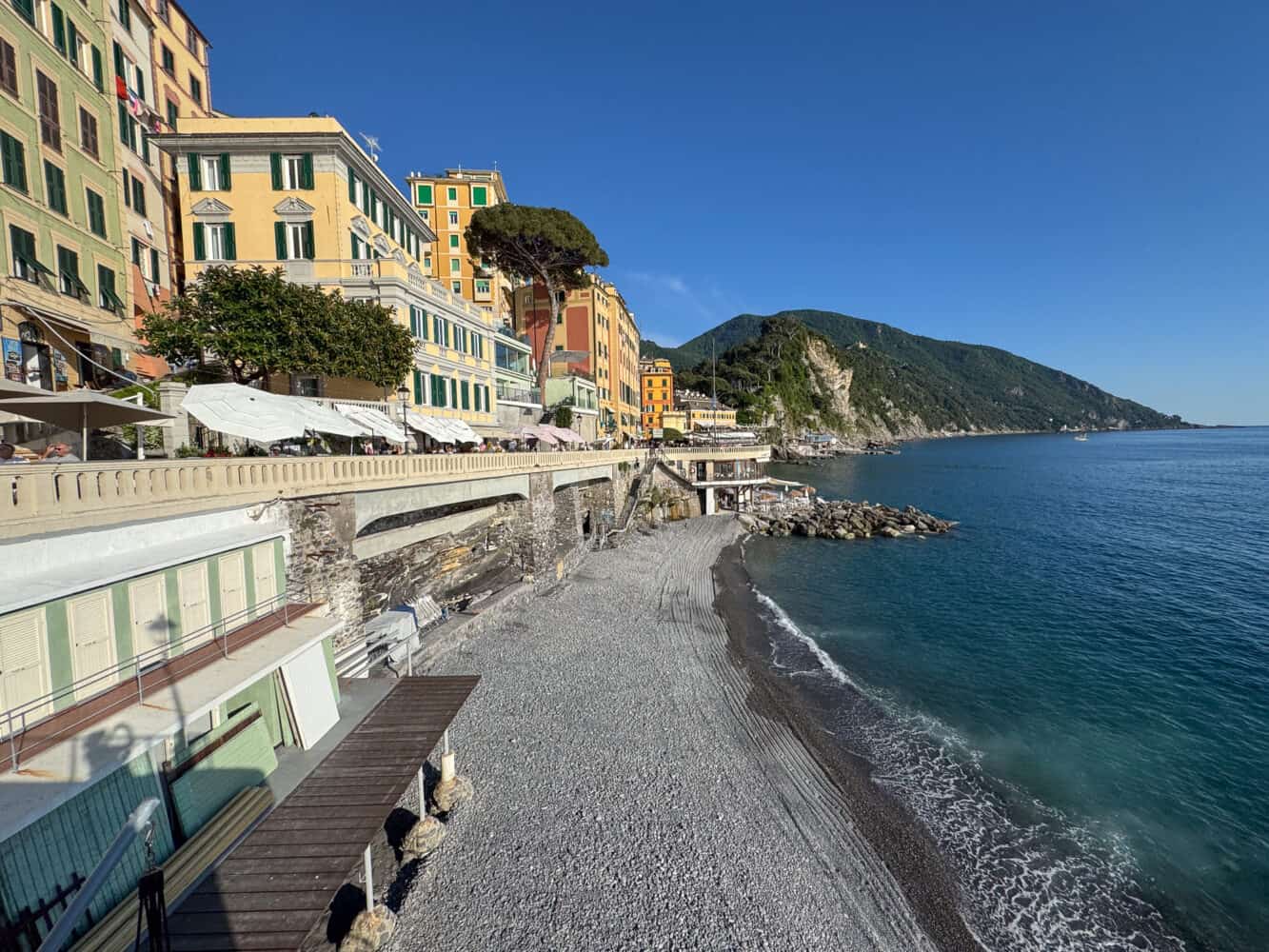
Camogli Beach is a mix of free sections and lidos (also known as bagni), which are privately managed areas offering sunbeds and umbrellas for rent. Some have water sports gear too.
In May, the lidos cost €40 per day for two sun loungers and an umbrella (this varies throughout the year). They were never very busy at this time of year.
The free sections were busier on weekend afternoons, especially the end nearest the church.
The other end of the beach has a quieter free area. Access it by the stairs near Hotel La Camogliese.
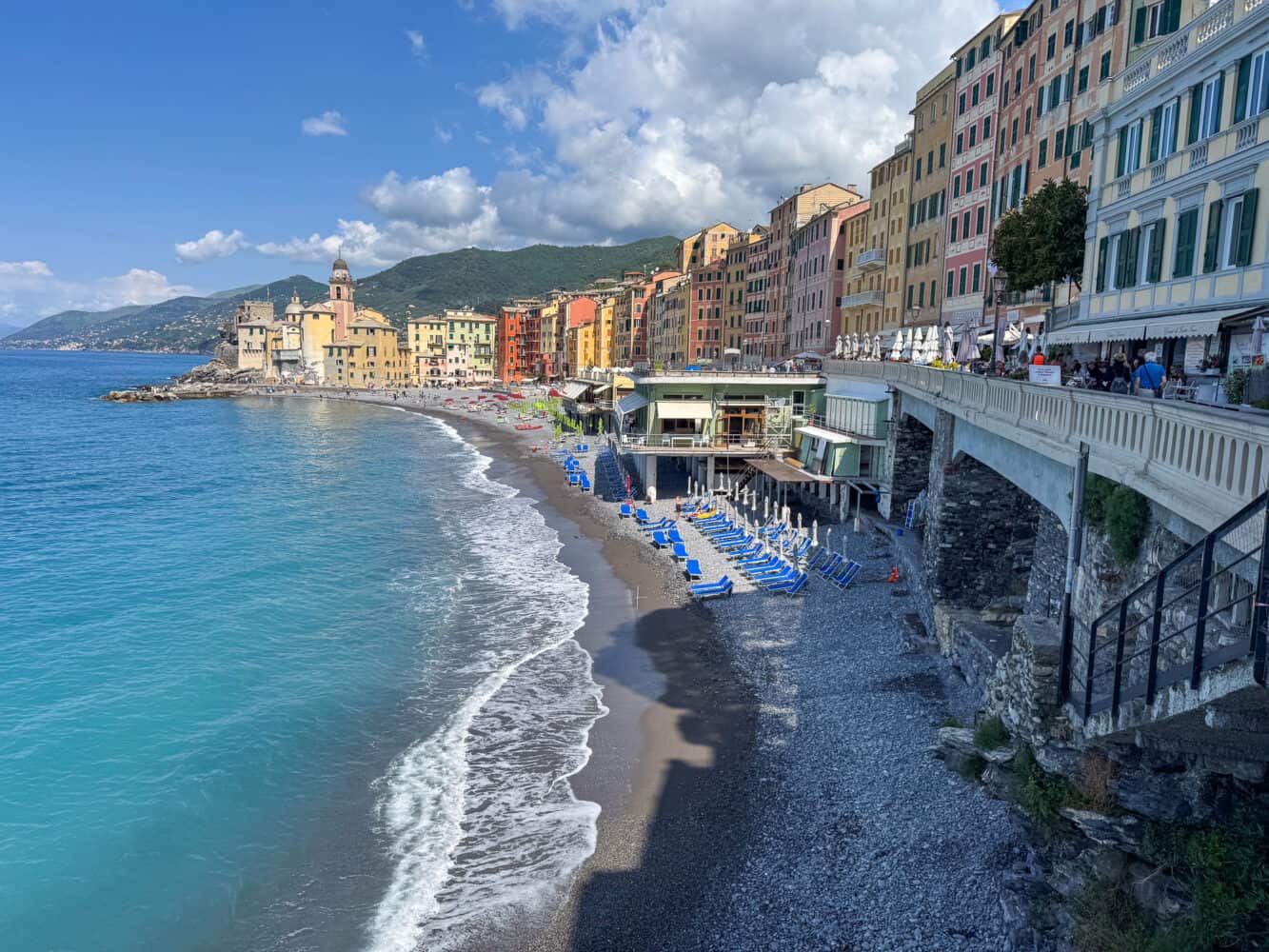
We used the free section of the beach until we moved to Hotel Cenobio dei Dogi, where we had access to their private beach. It was far quieter than the main beach on a Sunday, and we appreciated having guaranteed sun beds and umbrellas.
Visit Basilica di Santa Maria Assunta
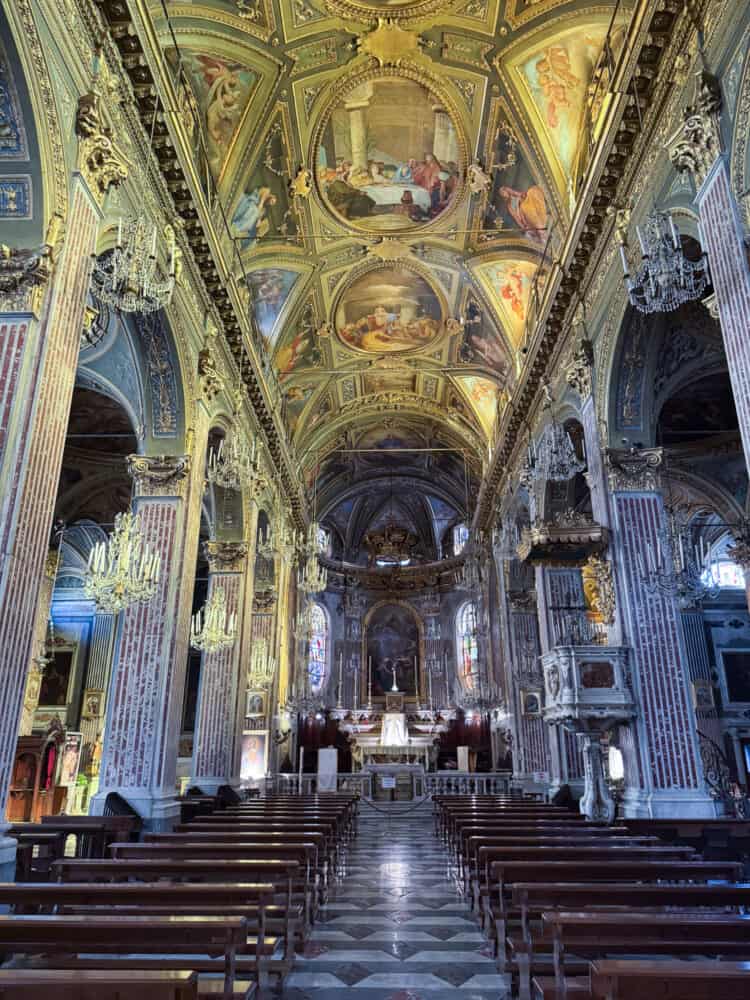
Camogli’s most prominent church is the 12th-century Basilica di Santa Maria Assunta. It has a prime spot between the beach and the harbour.
You can reach it by heading up the stairs from the harbour. The entrance side is an austere white, while the back (which you see from the beach) is yellow with a pink bell tower.
Entrance is free, and the interior is worth a look for its ornate Baroque decoration and ceiling frescoes.
The church bells ring every quarter of an hour, starting with a 7.30am wakeup call—they were the soundtrack of our stay.
There’s a lovely view of Camogli Beach from the terrace between the church and the castle next door. Head to the left behind the church.
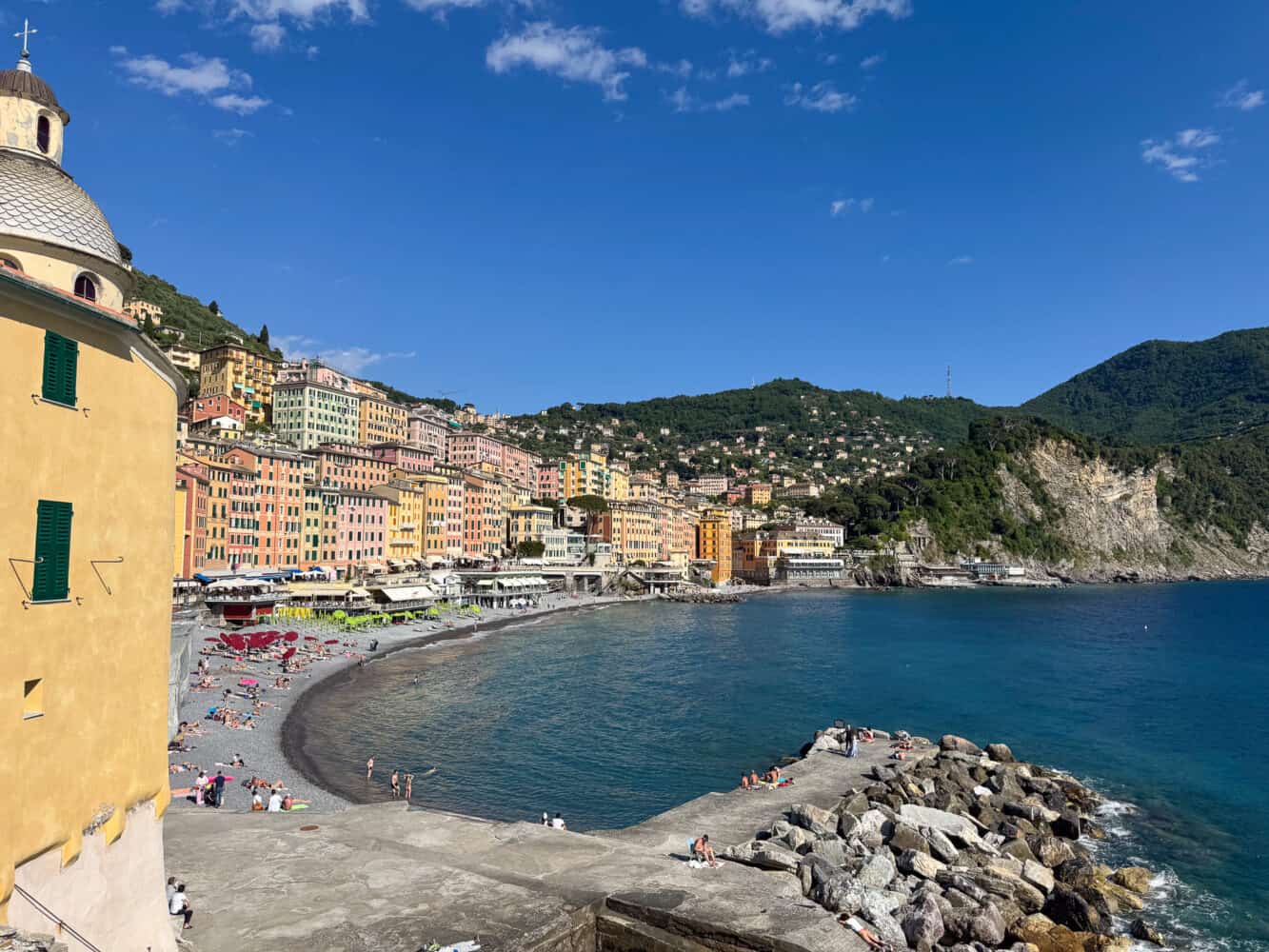
Look out for the blue and white plaque outside the church that shows “L’Isola di Camogli nel 1518” (The Island of Camogli in 1518). This part of the village was once an island.
See an Exhibition at Castle Dragone
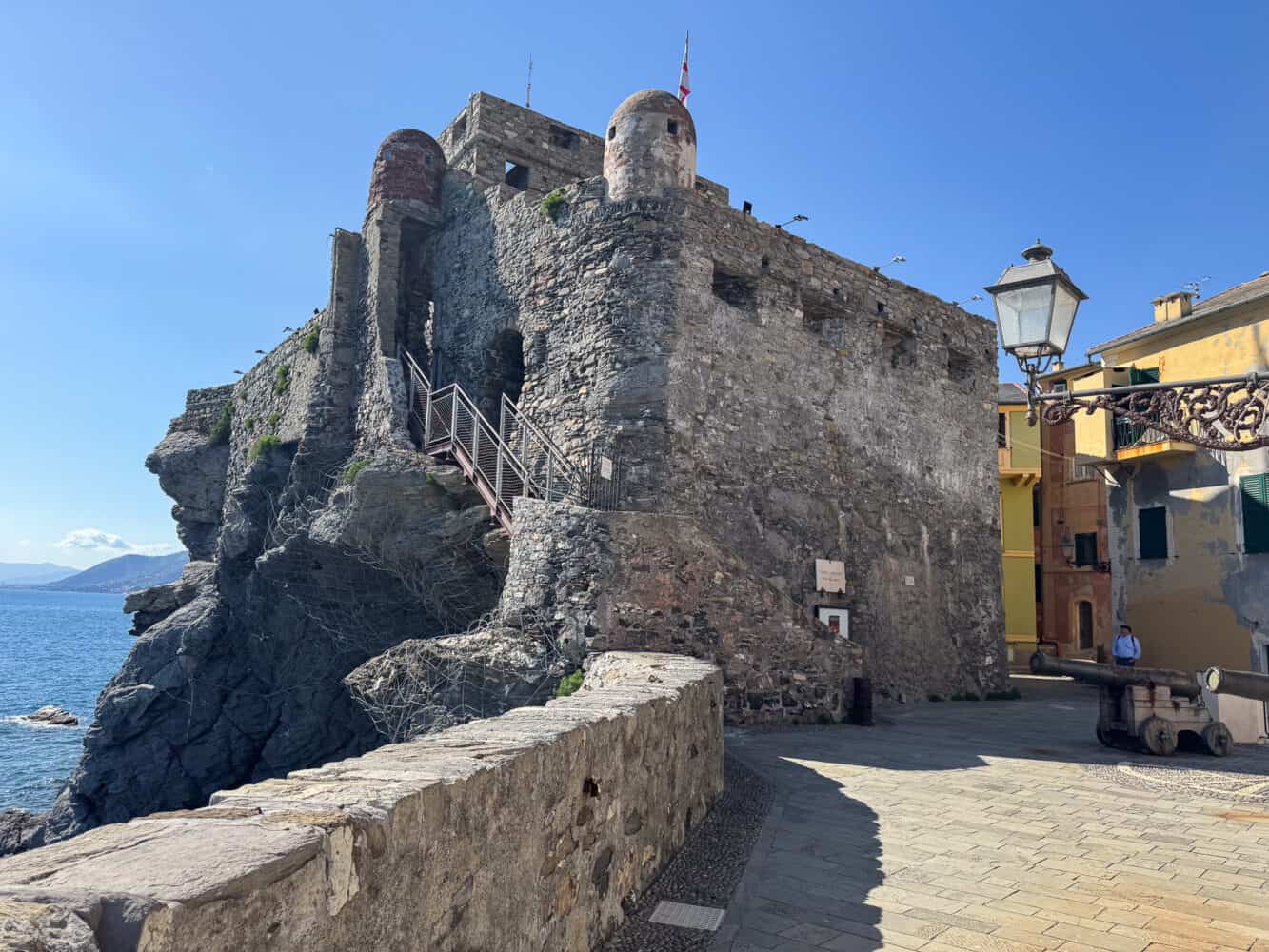
Next to Basilica di Santa Maria Assunta is a little medieval castle called Castle Dragone or Castello della Dragonara.
It was built in the 13th century as a watchtower to defend the hamlet from raids by Saracen pirates.
Outside are two 16th-century cannons.
You can’t always go inside the castle, but it’s sometimes open for exhibitions.
On our visit, it was open on weekends from April to June. In May, the free exhibition featured the falò (bonfires) built during the annual Camogli Sagra del Pesce—read my Camogli Fish Festival guide for more details.
It’s worth taking a look to see if there’s an exhibition on. There’s not much to see inside, but the terrace has good views.
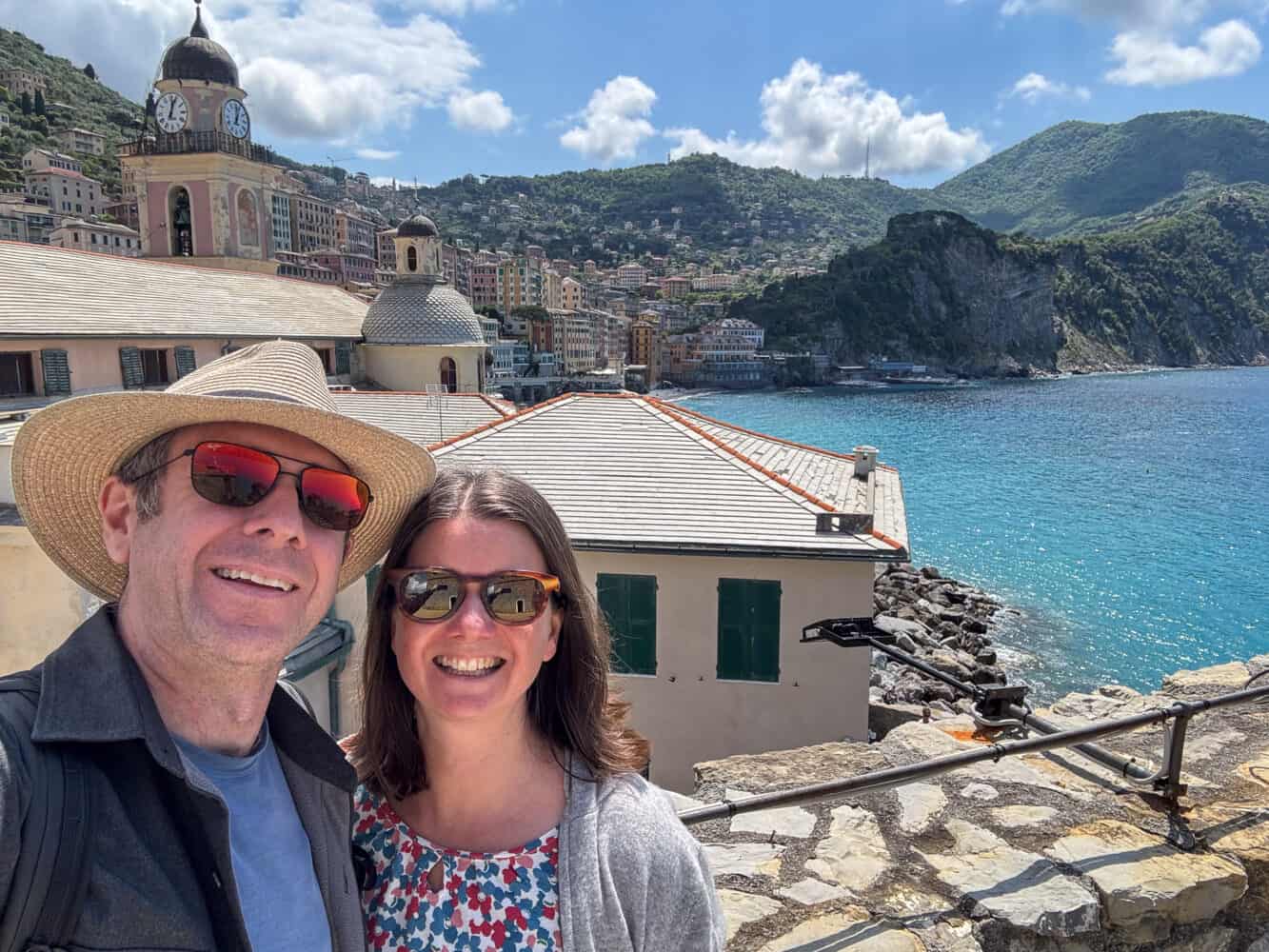
The castle doesn’t have a website, so it’s best just to go up and see if it’s open (weekends are your best bet).
Admire the Harbour
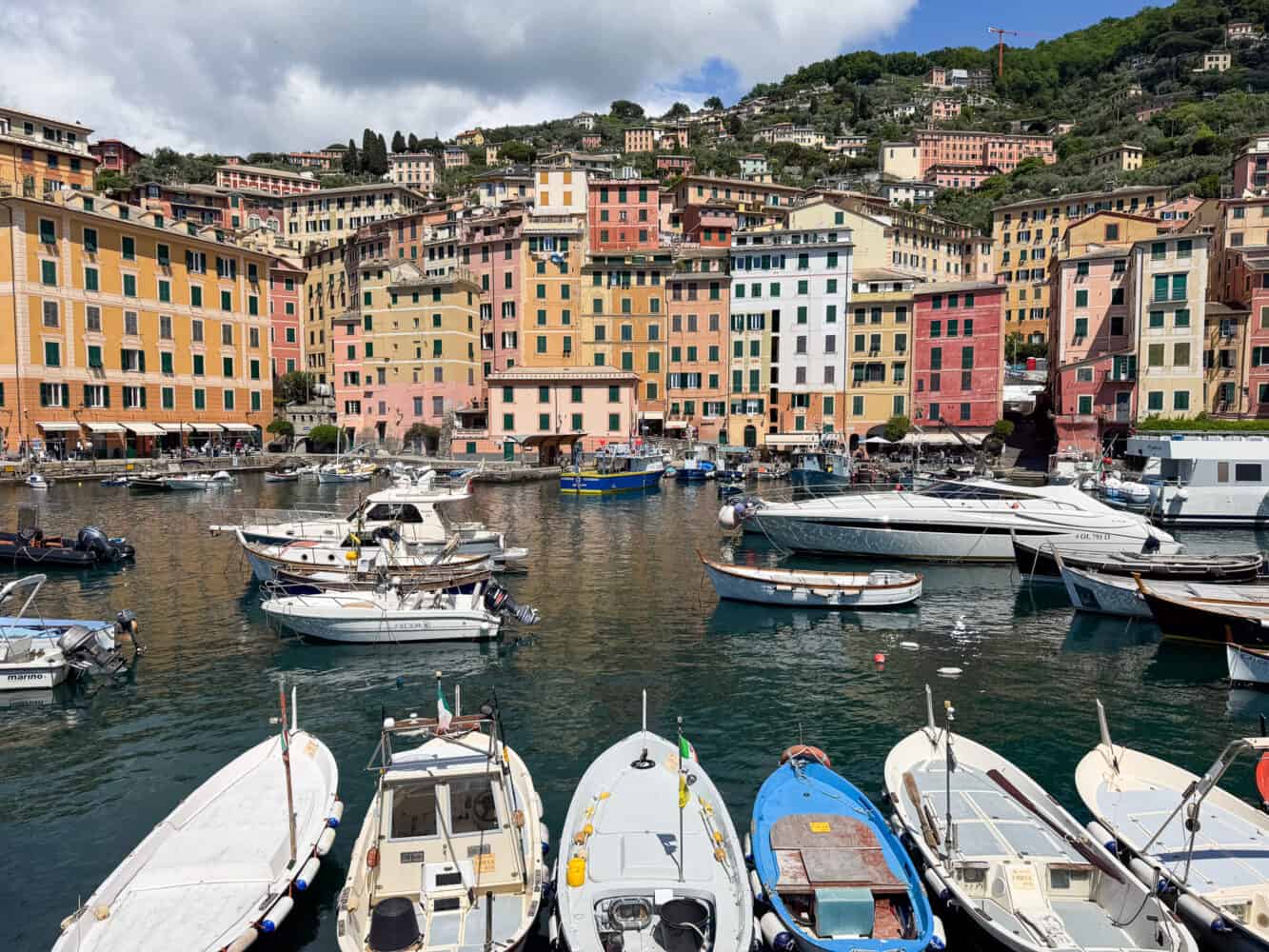
Camogli’s seafront is in two parts—the beach and the harbour.
Camogli is one of Italy’s oldest fishing ports, and fishing has been a significant part of its history.
Its name is believed to have derived from “case delle moglie” (the wives’ houses) because the men of the village spent so much time away at sea.
Camogli’s harbour shows that it’s still a fishing village at heart with colourful, wooden boats bobbing in the clear green water. It’s a stark contrast to the fancy yachts you’ll find in Portofino.
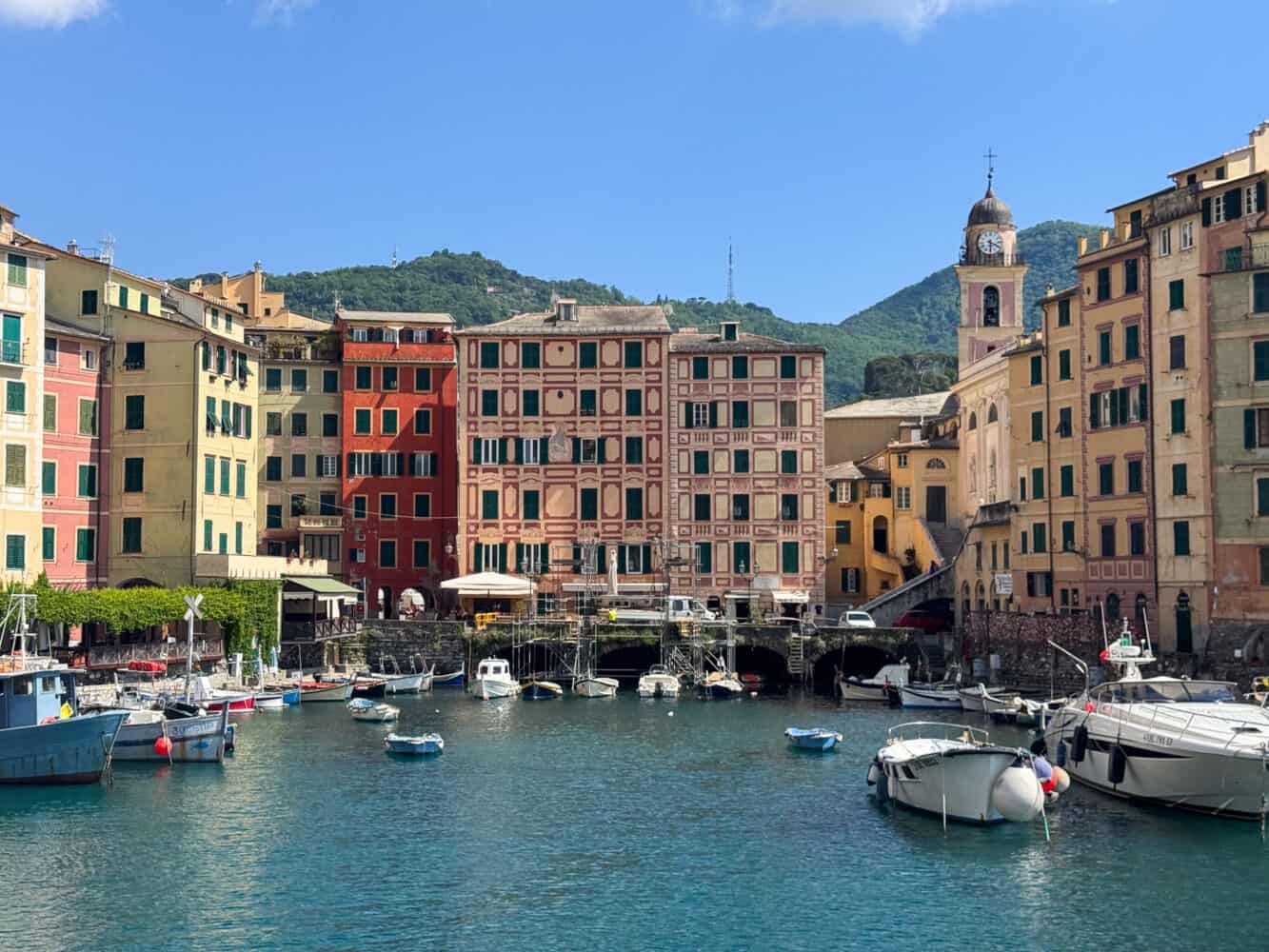
The harbour is where you can catch the ferry to San Fruttuoso. It’s also the site of the giant frying pan during the annual Sagra del Pesce.
There are a few restaurants and bars overlooking the water.
You can find a fence of fishing nets with love hearts tied to them (known as the Hearts and Knots of Love). This is part of the village’s Valentine’s Day celebration where couples declare their love on the hearts.
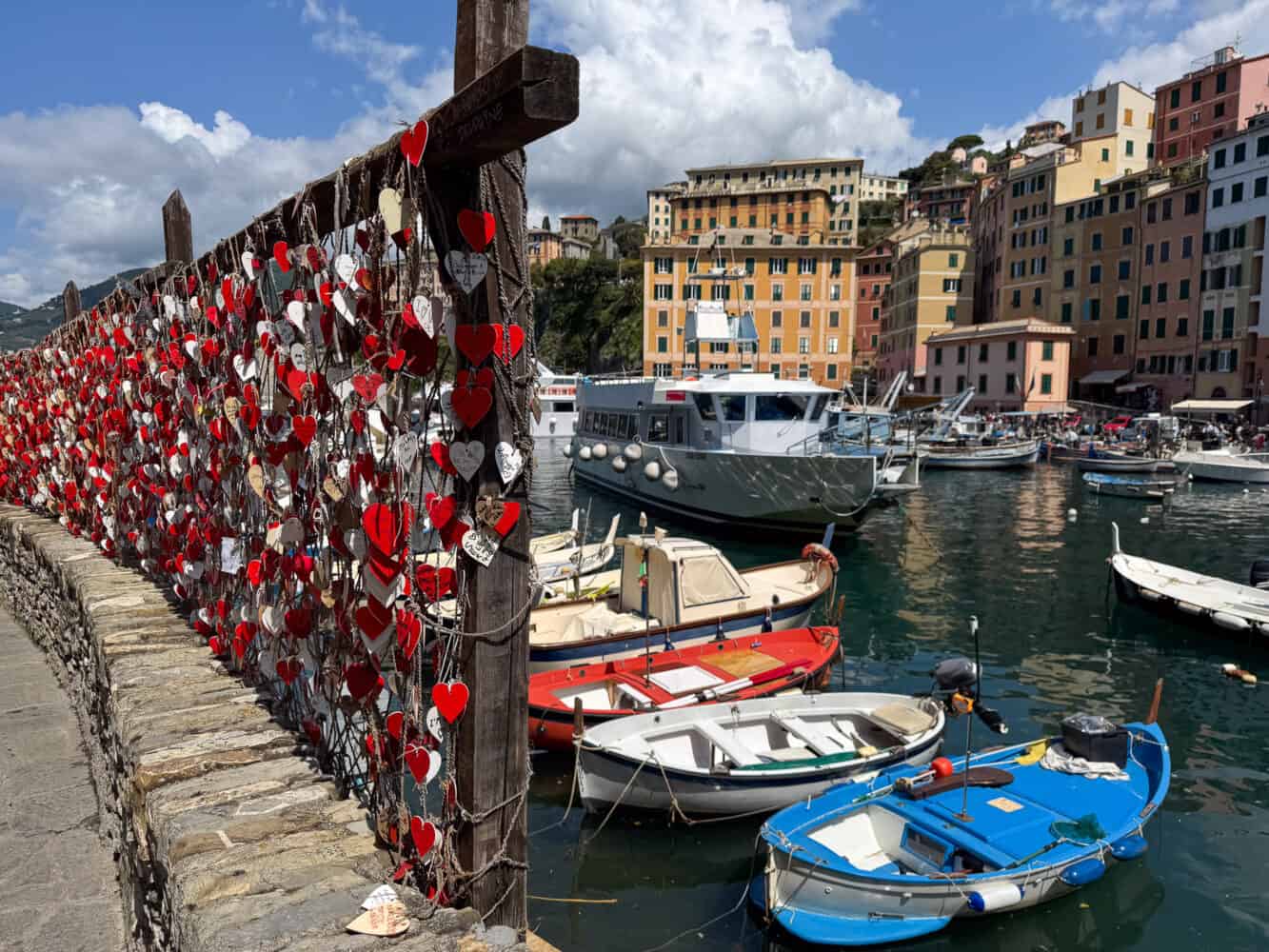
Attend the Camogli Fish Festival
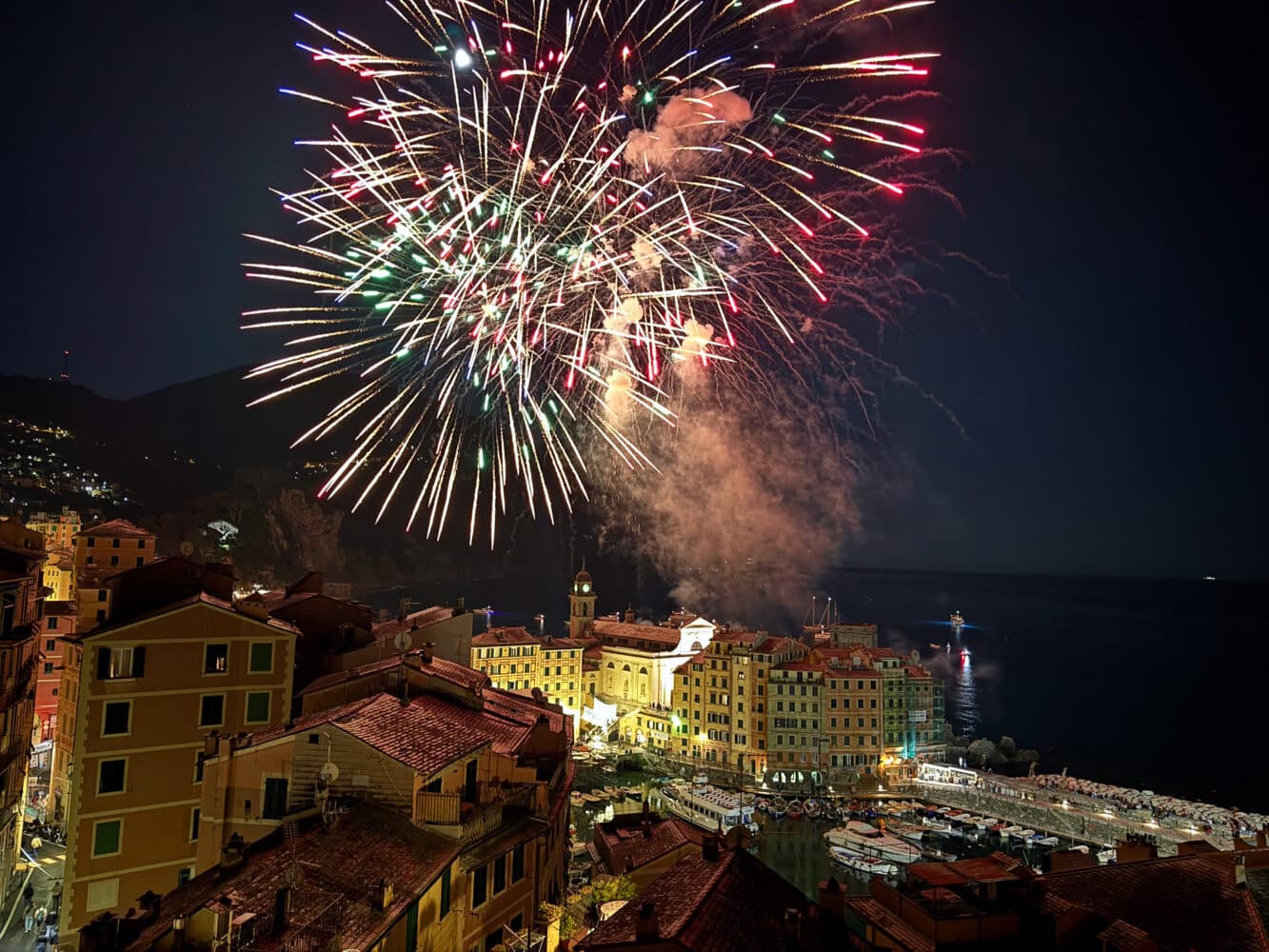
The Sagra del Pesce or Camogli Fish Festival celebrates the village’s fishing heritage every May.
It includes a feast for all with fish fried in a giant frying pan, as well as fireworks and impressive bonfires the night before.
Even though we don’t eat fish, we still enjoyed the festival. As Camogli gets very busy that weekend, we were glad we were staying all week so we could see it return to its usual tranquil self.
Read my guide to the Camogli Fish Festival for everything you need to know.
If you aren’t visiting in May, you can still see an old pan from the festival on the promenade (La Padella della Sagra del Pesce on Google Maps).
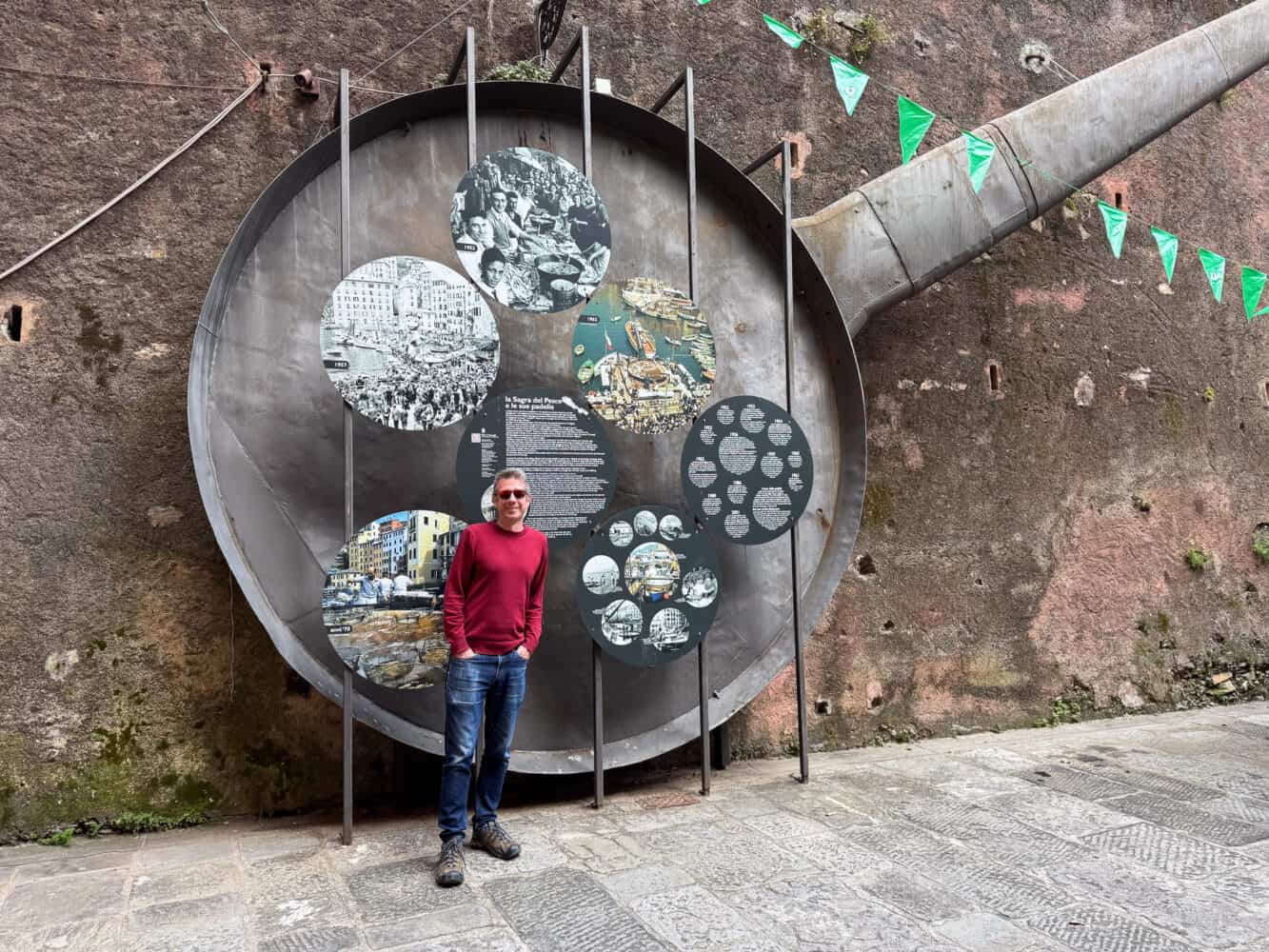
Another important festival in Camogli is Stella Maris, on the first Sunday of August, which includes a procession of decorated boats and thousands of floating candles.
Walk to the Lighthouse
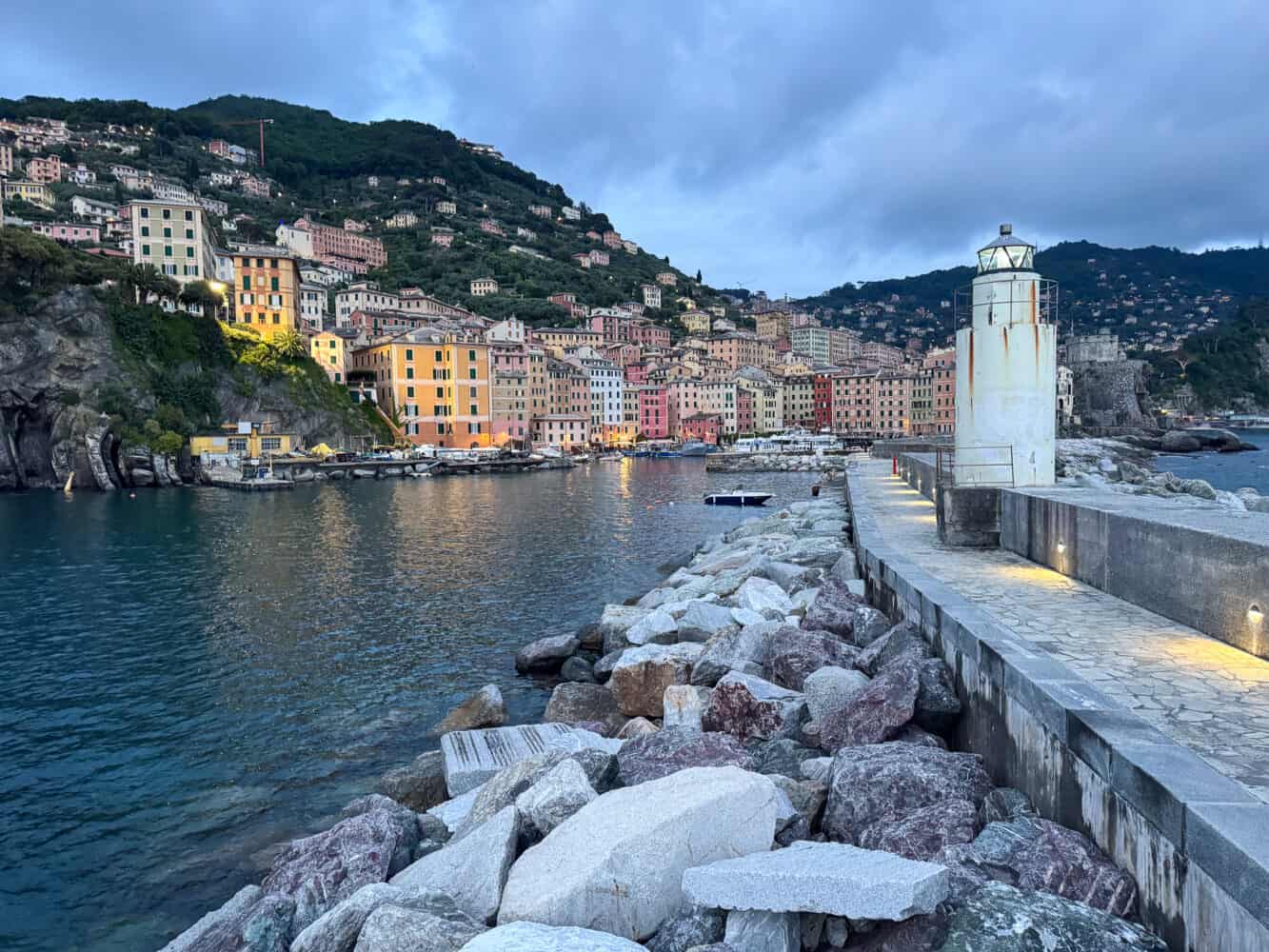
From the harbour, you can walk out on the Molo di Camogli, a stone pier that leads to the lighthouse (Faro di Camogli).
This is a lovely place for a stroll and to sit on the rocks at the end and admire the view back to the harbour. Sunset is best.
Watch the Sunset with Aperitivo
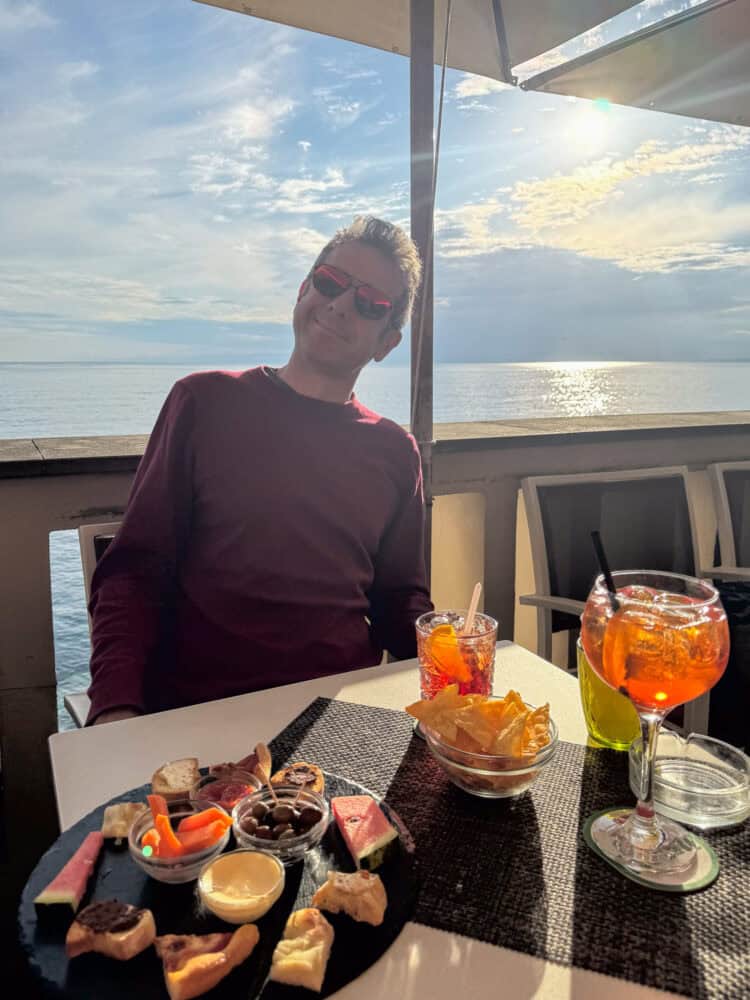
The best places to see the sunset in Camogli are from the end of the Molo or with a drink on the promenade above the beach. You can’t see the sun go down from the harbour.
There are numerous bars on the promenade to choose from, and most offer a good selection of aperitivo snacks along with your drink.
We enjoyed ours at Il Barcollo, where they made us a vegetarian platter (included with our €8 Aperol Spritz). We also ordered their delicious focaccia al formaggio to make it a full meal.
Another place we really wanted to go was Bar Dai Muagetti in San Rocco, a hamlet high above Camogli.
The sunset views are supposed to be spectacular, but we could never face the steep 30-minute climb up the stairs in the evening (we did it a few times on the hikes below). Bookings are highly recommended.
Visit the Maritime Museum
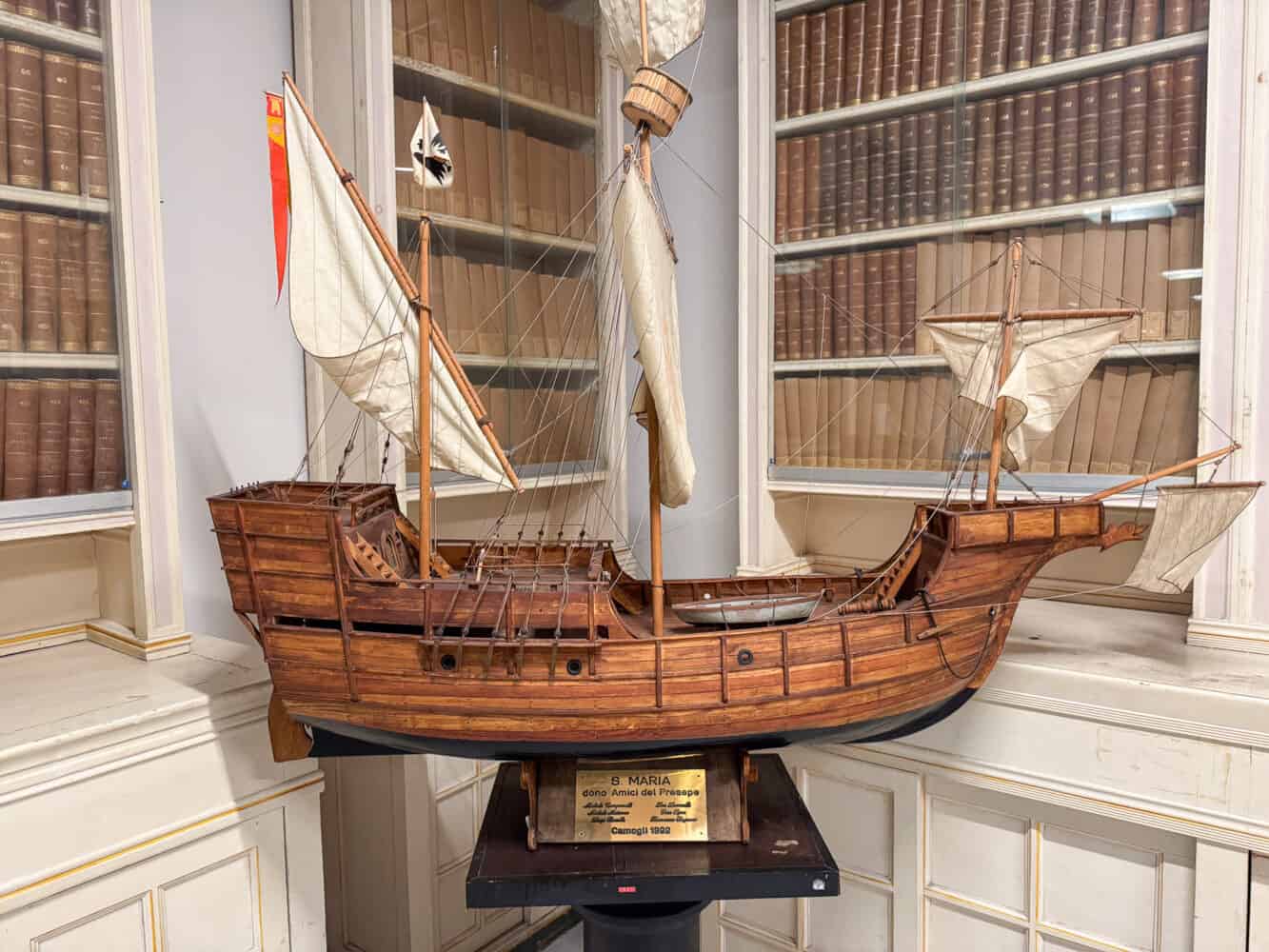
Camogli’s golden era was the mid-19th century, when it was known as the “city of a thousand white sails” due to its vast fleet of tall ships available for rent.
To learn more about Camogli’s seafaring history, visit this free museum located opposite the train station (take the elevator down).
There are numerous ship models and paintings, as well as nautical instruments, dating from Napoleon’s time to the First World War.
I found the information about the relationship between Camogli and Tristan da Cunha, a remote archipelago in the South Atlantic Ocean, especially interesting.
An Italian ship was shipwrecked on the island in 1892 with some Camogli men onboard. Two of them decided to settle there permanently, and communication between Tristan and Camogli has lasted through the years.
The Civico Museo Marinaro Gio Bono Ferrari is open Tuesday to Sunday from 9.30am – 12.30pm. It’s closed on Mondays.
Best Hikes and Day Trips from Camogli
Hike (or Ferry) to San Fruttuoso
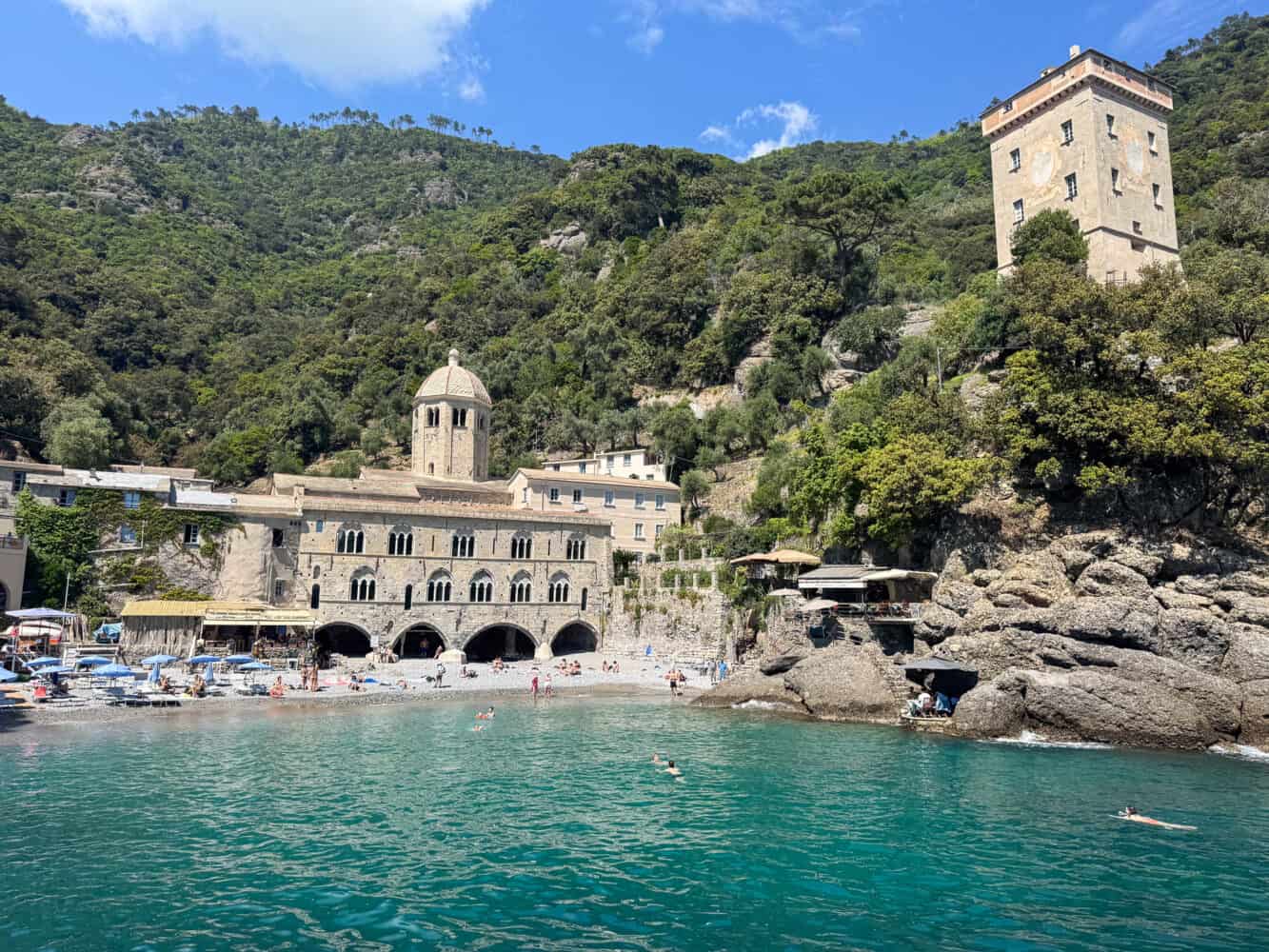
My absolute favourite thing to do in Camogli is to hike to San Fruttuoso, an ancient abbey with a beautiful little beach that can only be reached on foot or by ferry.
We like to walk up to San Rocco and through the forested Portofino Regional Park on the inland route via Portofino Vetta. The 6.6 km (4.1 miles) one-way trail takes us just over two hours from Camogli Station.
At San Fruttuoso, we enjoy a meal and swim in the gloriously clear sea before taking the ferry back to Camogli (or onwards to Portofino, Santa Margherita Ligure, and Rapallo).
Read my detailed guide to hiking from Camogli to San Fruttuoso.
Even if you don’t want to hike, I recommend taking the Golfo Paradiso ferry from Camogli harbour to San Fruttuoso, which takes 30 minutes and costs €10 one way or €16 return.
Swim at Punta Chiappa
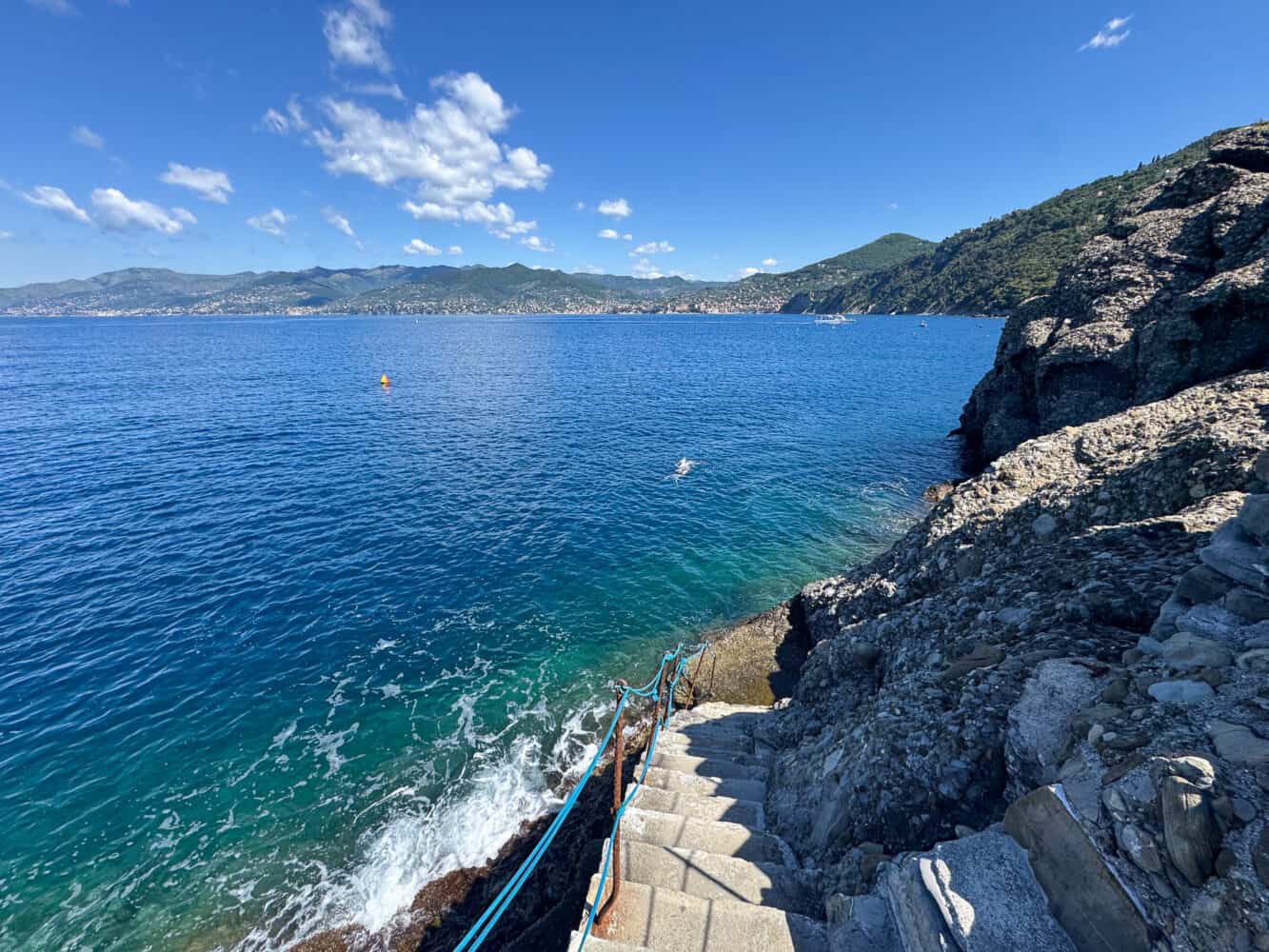
Another beautiful hike from Camogli is to Punta Chiappa, the rocky tip of the western side of the Portofino Peninsula.
As with the San Fruttuoso trail, the walk begins with a steep climb up stairs to San Rocco, but after that, it’s a shorter and easier downhill trail along the coast.
From Camogli Station to Punta Chiappa, the hike was 3.75km (2.3 miles) and took us 1 hour and 10 minutes.
It’s doable as a return hike (see Punta Chiappa via Camogli on AllTrails), but the climb will be much steeper on the way out. We took the ferry back instead (15 minutes/ €7).
Punta Chiappa is a tiny settlement with a few houses and restaurants. We also saw an Airbnb and the Stella Maris hotel—this would be an interesting place to stay if you want to get away from it all (and don’t mind minimal transport links).
We were too early for lunch, so we just had a swim off the rocks (go past the restaurants and ferry stop). The water is wonderfully clear, and you can see quite a few fish.
On a weekday in May, we had the place to ourselves, but I imagine it’s popular in the summer.
Visit Glamorous Portofino
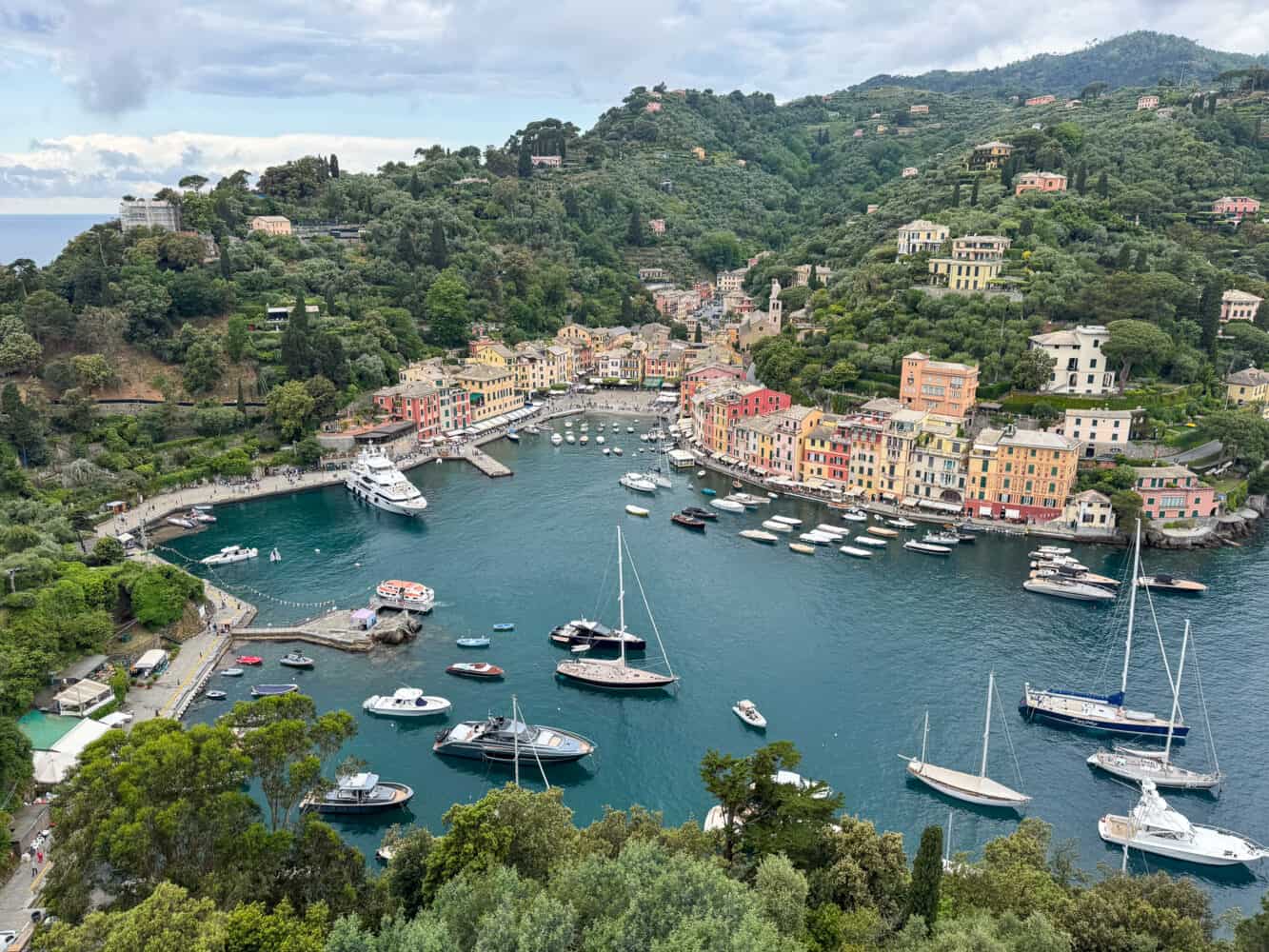
Portofino is the most famous town on the Italian Riviera and a popular destination for celebrities and super yachts.
The small harbour is utterly gorgeous, expensive, and can be very crowded (in May, it wasn’t too bad). It’s still worth visiting, though.
We love the walk up to San Giorgio Church and Castello Brown, then out to the lighthouse where there’s a bar with great views.
See my post on the best things to do on the Italian Riviera for more Portofino tips.
Camogli to Portofino
There are a few ways to get from Camogli to Portofino (which is not on the train line):
- Ferry (or hike) to San Fruttuoso, then change to another ferry to Portofino.
- Train to Santa Margherita Ligure, then take a ferry or bus (or walk) to Portofino.
- Hike from Camogli to Portofino (not via San Fruttuoso), which is 8.5km (5.3 miles) and takes about 3.5 hours.
You can, of course, take one route there and another back.
We combined our latest visit to Portofino with a morning in Rapallo. We took the train to Rapallo, explored a bit there, walked to Santa Margherita Ligure (about 40 minutes; you can also take the train), then took the bus to Portofino (we’d just missed a ferry).
To return, we took the ferry from Portofino to Santa Margherita Ligure, then the train to Camogli.
Take the Train to Italian Riviera Towns
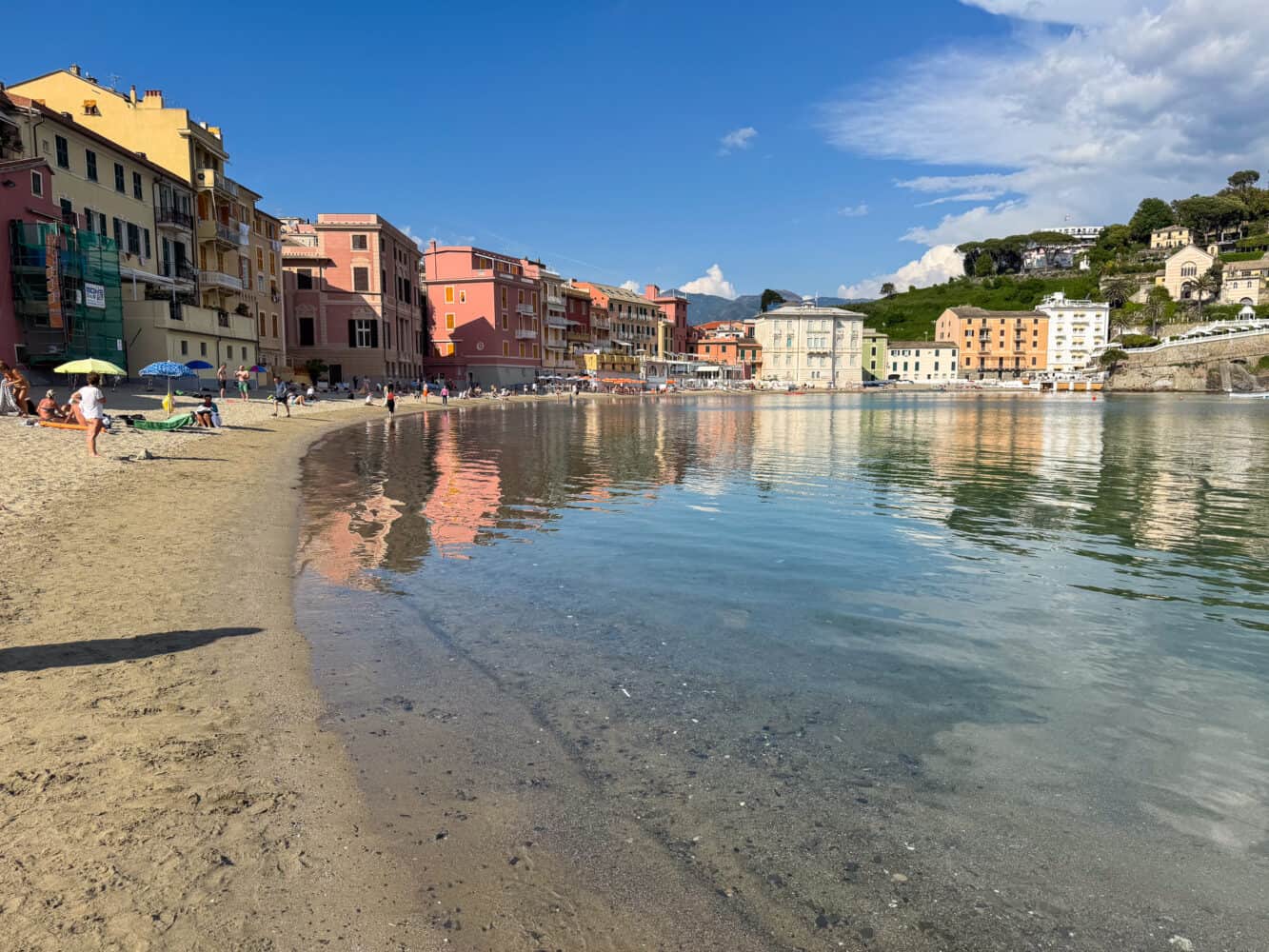
Camogli is a fantastic base for exploring the Italian Riviera by train.
Here are the towns I most recommend with the train times (on the fastest regional trains) from Camogli. There’s usually a train every 30 minutes.
See my Italian Riviera travel guide for more details about many of these places.
- Santa Margherita Ligure (5 minutes) – A chic resort town with beautiful architecture. The gateway to Portofino.
- Rapallo (10 minutes) – A bigger, less touristy town that’s worth visiting for restaurants, the promenade, and the cable car up into the mountains. See my Rapallo travel guide.
- Chiavari (20 minutes) – A hidden gem with a beautiful historic centre. Go to Luchin for lunch and get the wood-fired farinata (chickpea pancake).
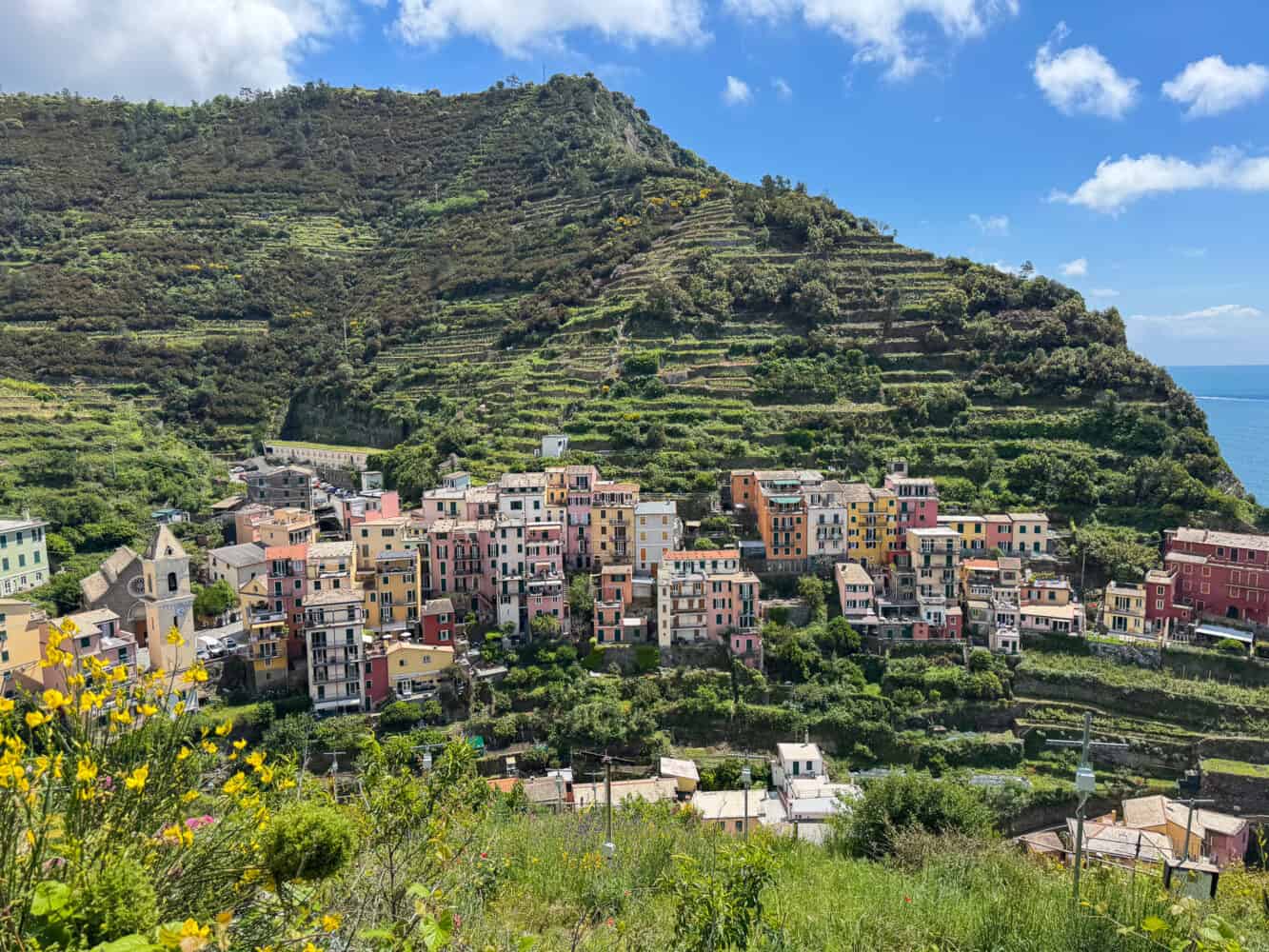
- Sestri Levante (35 minutes) – The sandy beach at Baia del Silenzio is my favourite in Liguria.
- Cinque Terre (1 hour+ with a change) – Cinque Terre is a series of five picturesque villages. It’s further than the other places, but it’s doable as a day trip. The first village is Monterosso, but it’s only five minutes on the train between the villages, so you can return from a different one. We love the Corniglia to Manarola hike.
- Genoa (46 minutes) – The towns above are east of Camogli, but Genoa is west. This underrated port city has lots to explore and affordable restaurants. A good option on a rainy day.
Our Favourite Places to Eat in Camogli
We love the food in Liguria—the pesto and focaccia are especially delicious.
Camogli is a small fishing village, so it isn’t the best for vegetarians, but we still found plenty to enjoy.
If you’re not familiar with food etiquette and customs in Italy, check out my guide to eating in Italy.
Casual Spots
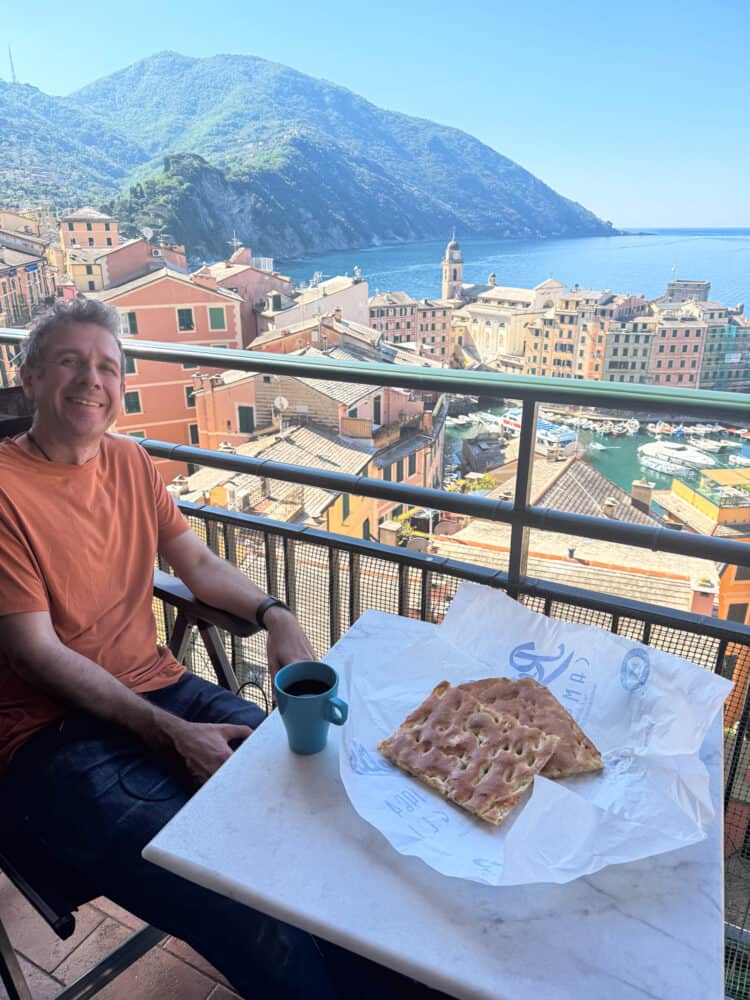
- Focacceria Revello – We tried lots of focaccia spots in Camogli, and Revello is the best. Simon loves their onion focaccia, but get whatever is straight out of the oven. It’s right next to the beach. It’s open from 8am – 7pm, so it was our go-to for breakfast or lunch.
- Pasta Fresca Fiorella – Next to Revello is this fresh pasta shop. Since we had a kitchen, we bought gnocchi or trofie pasta and fresh pesto for an easy and affordable dinner. If you don’t have a kitchen, you can also order cooked pasta and pesto (€7) from 12-2pm to take away and eat on a bench outside. They are supposed to be open from 8.30am – 7pm, but sometimes close at 5pm, so pick up your dinner early.
- Bar Barracuda – We really enjoyed the Tasche Gourmet Farcite (sandwiches) with grilled vegetables and stracciatella cheese at this seafront bar. Perfect for a light lunch. Aperitivo looks good too.
Restaurants
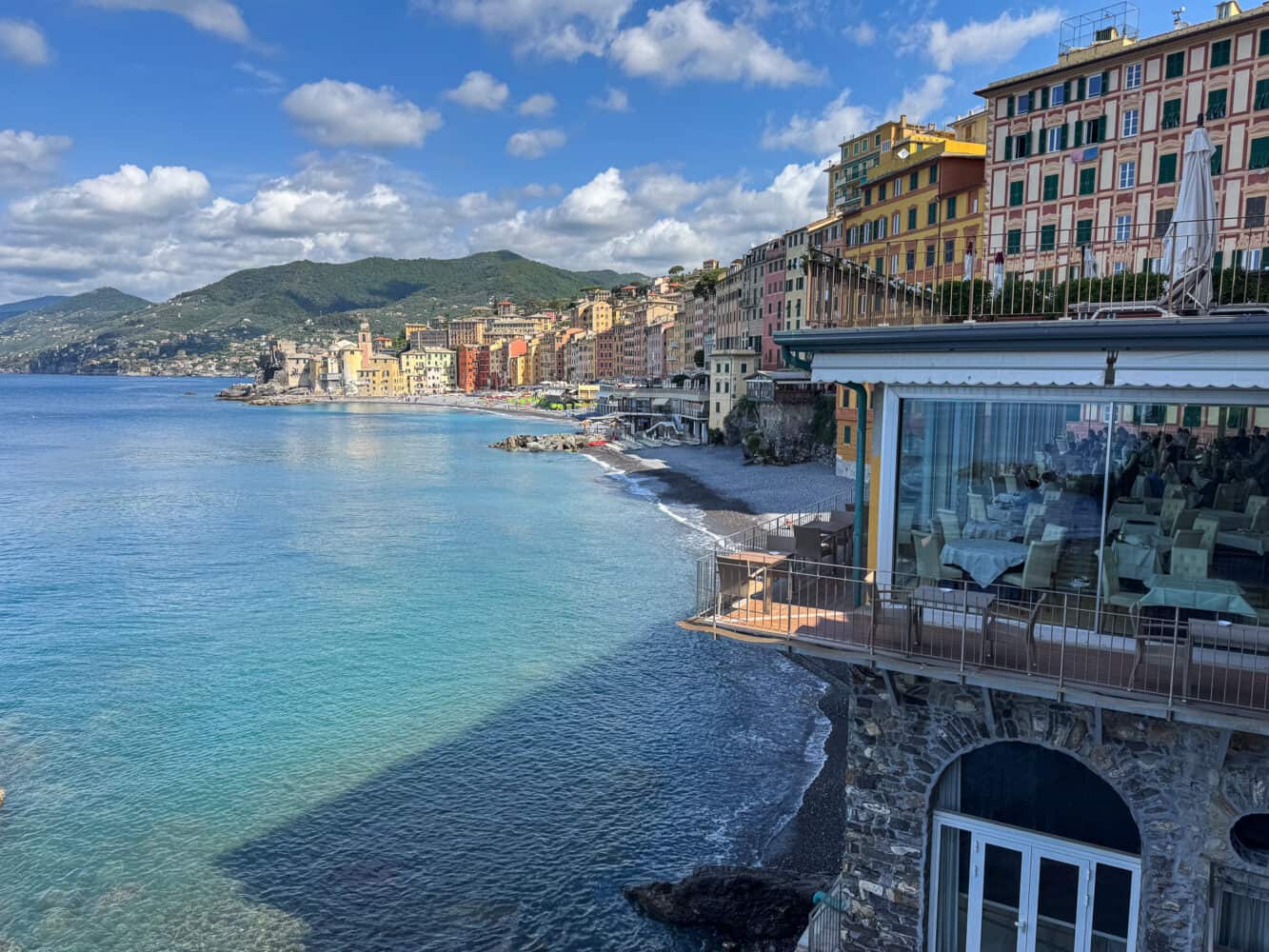
- Il Doge – This upscale restaurant in Hotel Cenobio dei Dogi is open to everyone (bookings recommended). It has incredible sea and sunset views, as well as the most vegetarian options in town. The trofie with pesto was the best I’ve had. It’s pricey but worth it.
- Civico 32 – This casual restaurant overlooks the harbour and opens at 6pm (useful for hungry foreigners). The pizza isn’t the best you’ll find in Italy, but it’s decent, as was the pasta pesto. The green salad was just a bowl of iceberg lettuce, so skip that!
- Lo Spuntino – Our meal at this seafront restaurant was nothing special, but it’s worth visiting if you need vegan or gluten-free options, as it unusually has separate menus for both.
Gelato
Here are my favourite places for gelato in Camogli (in priority order):
- Latterie 1978 – My top pick overlooks the harbour with a few seats outside.
- La Cremeria del Paradiso – Located in the arch that connects the promenade to the harbour.
- Gelato e Dintorni – A prime spot on the seafront promenade.
Restaurant in Recco
Recco is a town a few miles west of Camogli. It’s not as pretty as the other Italian Riviera towns, as it was bombed in World War Two and rebuilt with modern apartment blocks.
But it has a very local feel and is famous for its Focaccia di Recco (also known as Focaccia col Formaggio). You can find this paper-thin bread stuffed with cheese in Camogli, but we wanted to try it at its source.
So we headed to Ristorante Da O Vittorio Recco. This large restaurant has multiple rooms, each with a different atmosphere.
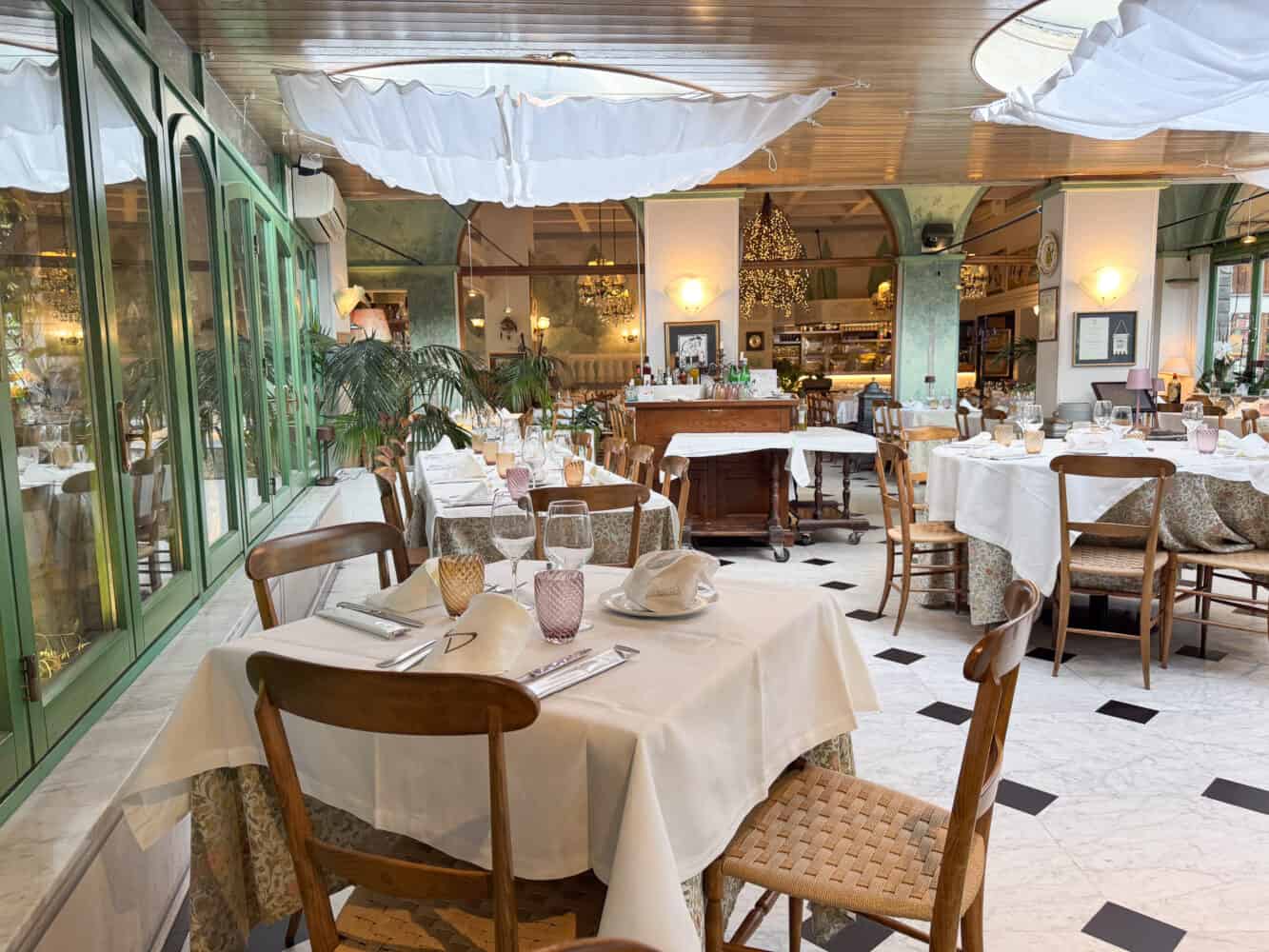
The Foccacia di Recco speciality is indeed delicious with lots of oozing cheese, but we accidentally ended up with one each, which was far too much.
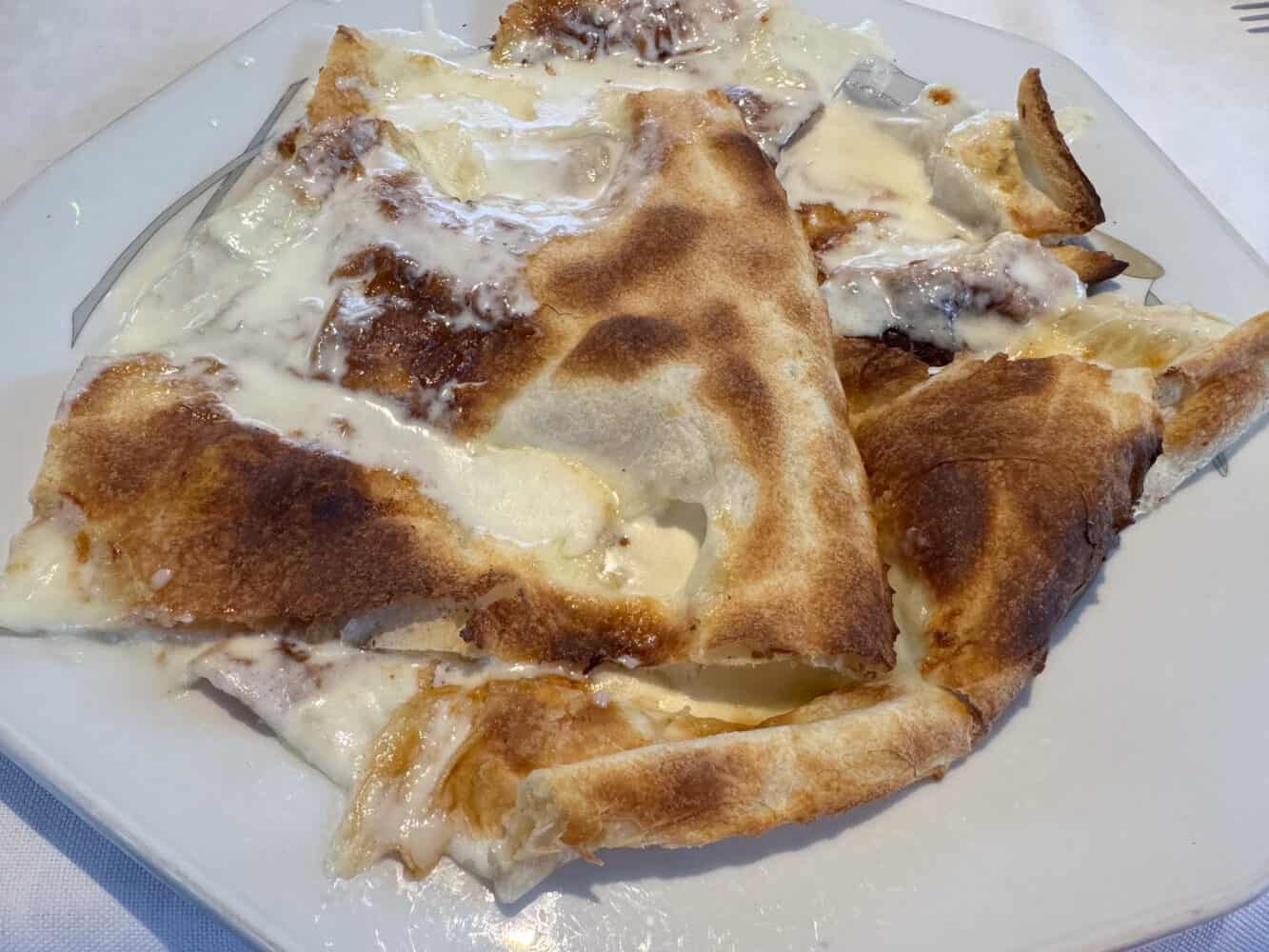
The pansoti (stuffed pasta with walnut sauce) was the best I had on this trip. Our grilled vegetables were also delicious.
It took us 30 minutes to walk to the restaurant from Camogli. The path is located next to a busy road and is not particularly pleasant (although there are nice sea views), so we took the 3-minute train ride back.
Where to Stay in Camogli
We stayed at two different places in Camogli—an affordable apartment with harbour views and a luxury hotel on the beach.
A Due Passi Apartment
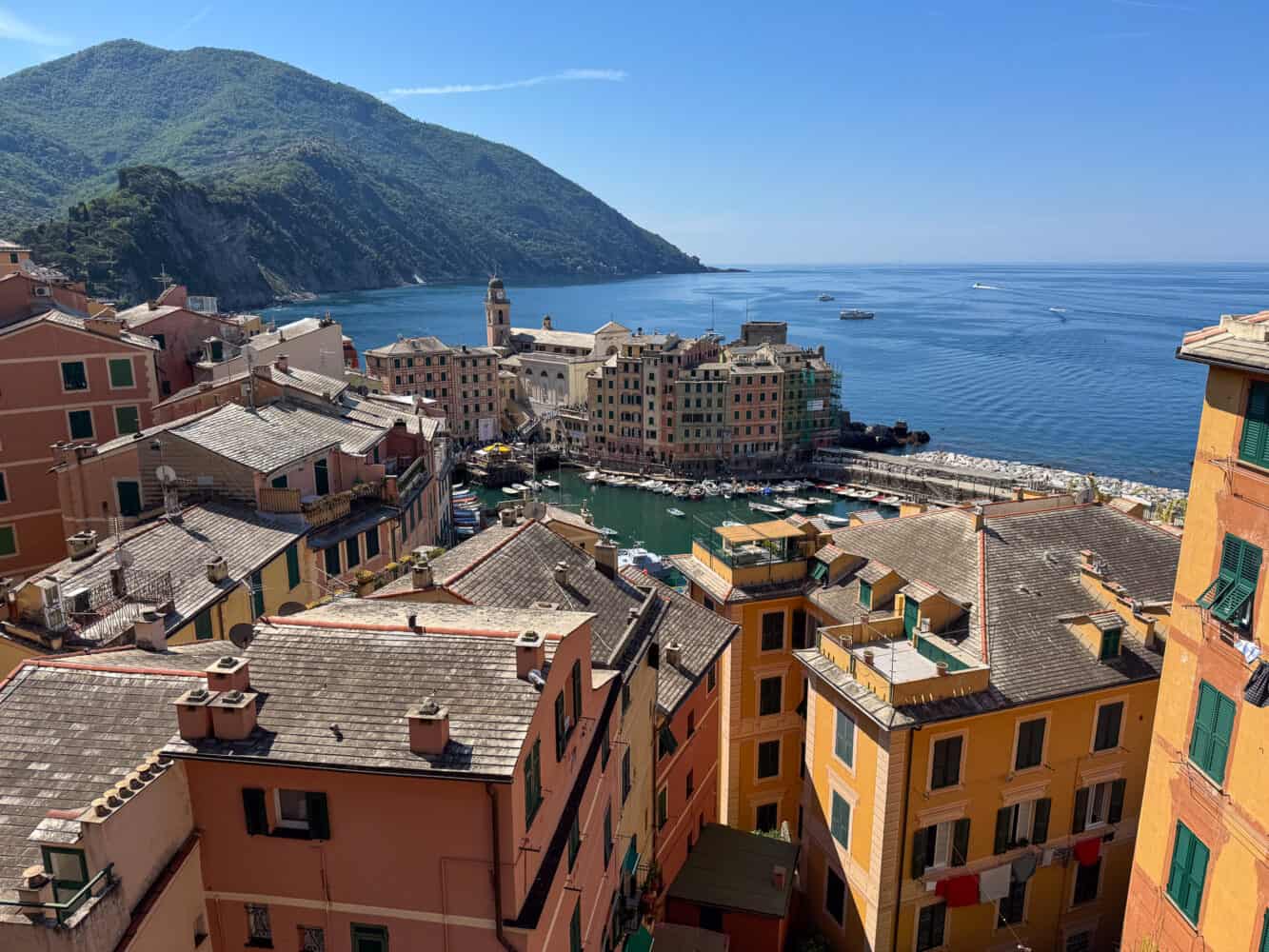
We rented a one-bedroom apartment with balcony and sea view at A Due Passi Dal Cielo e Dal Mare (which translates to A Stone’s Throw From the Sky and Sea).
Owner Lara rents out a few apartments in this building in a prime spot just a few minutes’ walk down stairs to the harbour (8 minutes from the station along the main road).
The view of the harbour and mountains beyond from the two balconies is spectacular. There’s a table and chairs, and enjoying meals and drinks out there was a highlight.
It was also the perfect spot to watch the fireworks during the Camogli Sagra del Pesce.
Our one-bedroom apartment was spacious with a living/dining room, bedroom, small kitchen, and bathroom. The washing machine was useful for our longer stay.
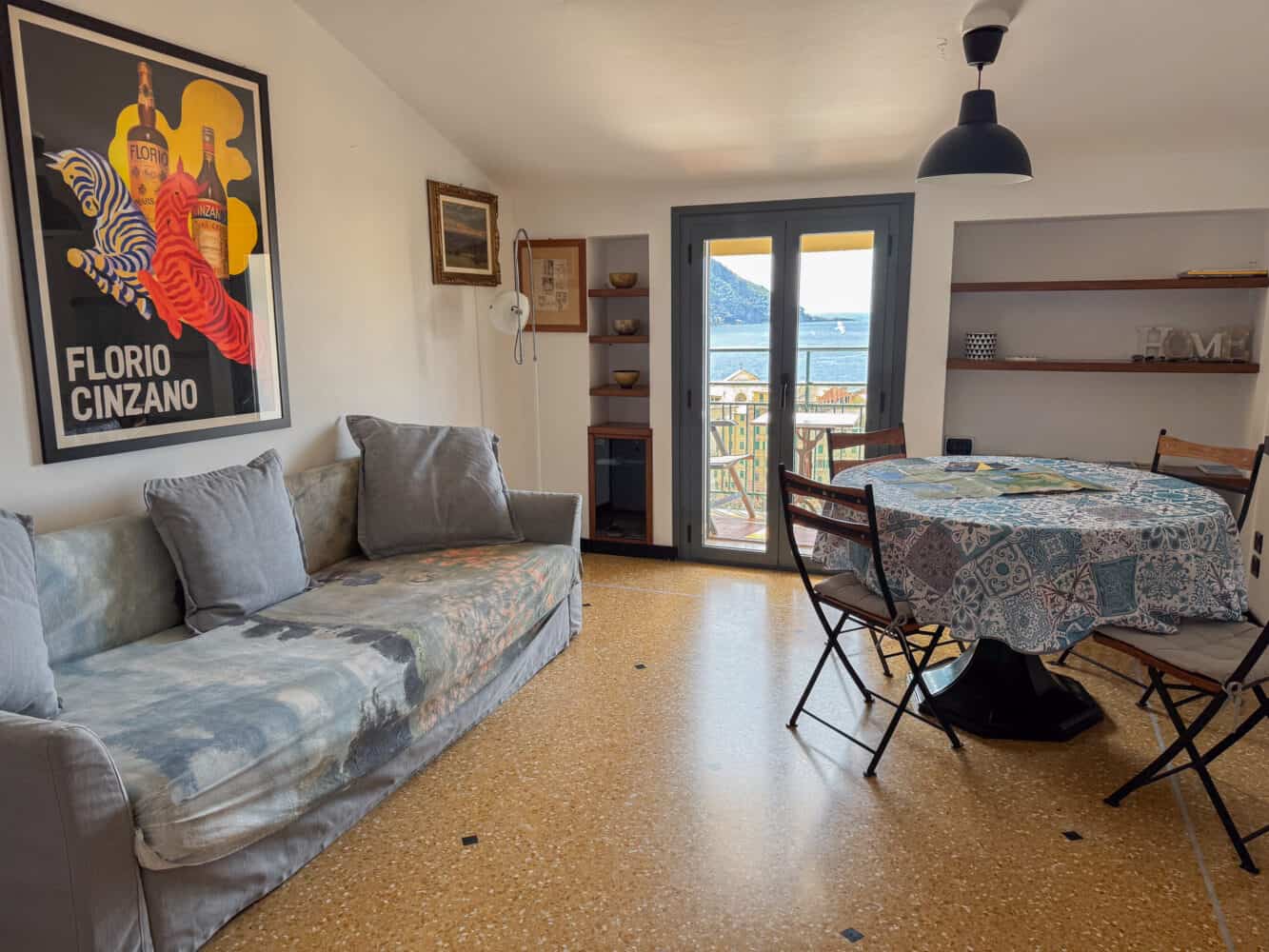
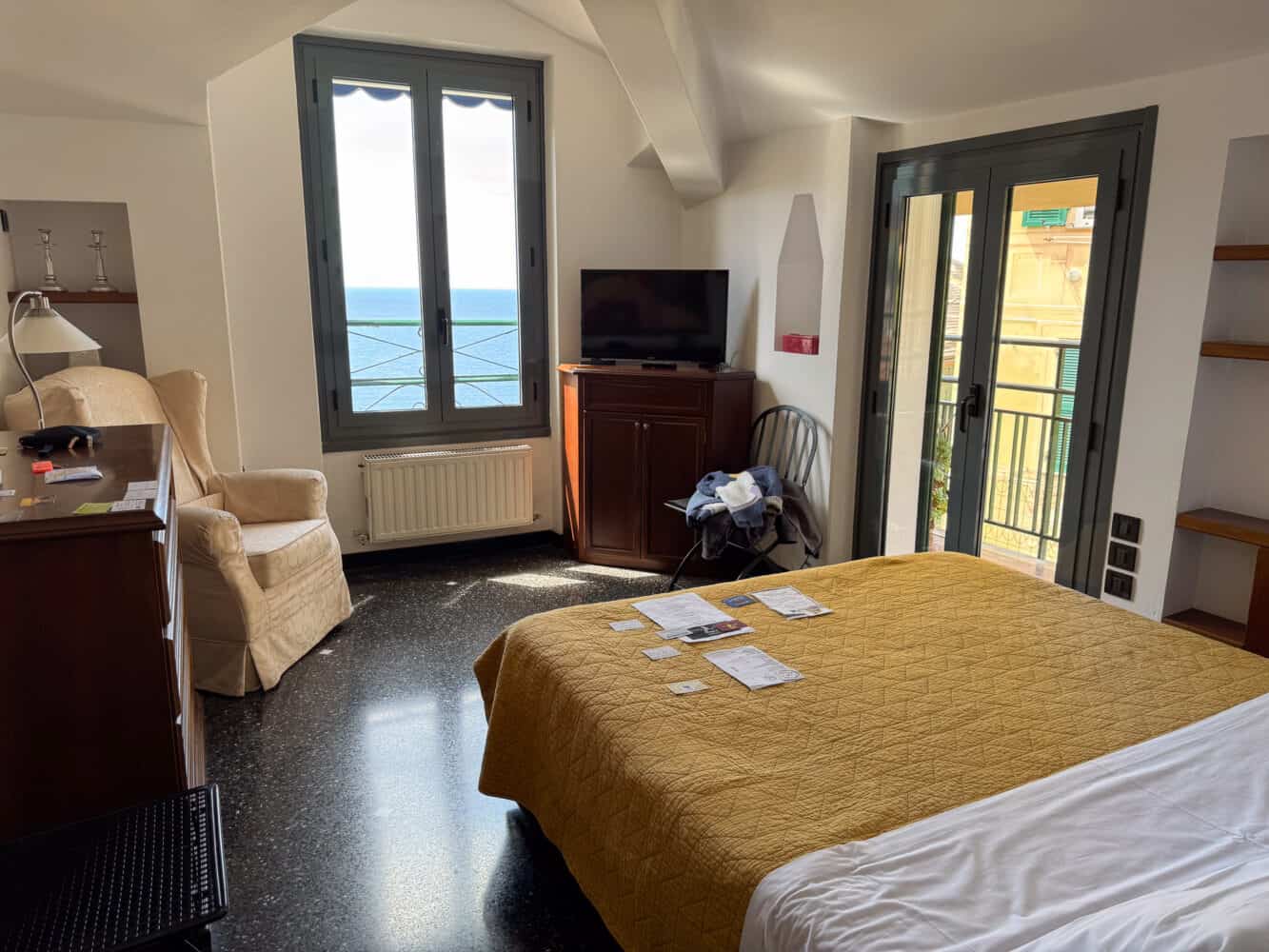
The decor is a bit dated, but overall, we loved our stay.
Lara is extremely helpful and will give you lots of advice on restaurants in the area.
She also has a two-bedroom apartment, but it’s on a lower floor, so it doesn’t have as good a view.
There is a small elevator, which was handy to reach our high floor.
Check prices and availability of A Due Passi on Booking.
Hotel Cenobio dei Dogi

Even after eight nights in our apartment, we didn’t want to leave Camogli, so we booked a cheeky last-minute stay at Hotel Cenobio dei Dogi.
This is the best hotel in town, located at one end of Camogli Beach.
Highlights are the amazing views, wonderful restaurant, private beach, and heated saltwater pool. It’s the perfect place to relax.
Our elegant room had a balcony and sea view, and we slept to the sound of waves.
We absolutely loved it and want to return for longer (it’s pricey, though). See our Hotel Cenobio dei Dogi review or check availability on Booking.
How to Get to Camogli
I highly recommend visiting Camogli by train. A car is more hassle than it’s worth on the Italian Riviera (if you want to venture inland, it can be useful).
Driving in the centre of Camogli is restricted to locals, and parking is limited and expensive (Hotel Cenobio dei Dogi, unusually, has free parking).
Getting around by train is easy. Check schedules on Trenitalia (make sure to use the Italian place name, i.e Genova, not Genoa). The local station is called Camogli – San Fruttuoso.
We used the Trenitalia app to book the regional trains we used to hop along the coast, which saved us queuing at the machines or the counter. Plus, we didn’t have to validate our tickets (you have to use machines on the platform to stamp paper tickets).
There’s no need to book regional trains in advance (just book more than five minutes before the train departs), but when travelling further afield on the faster Freccia trains, it’s cheaper to book a few months ahead.
The nearest airport to Camogli is Genova (GOA), which has international flights from across Europe. A taxi takes 45 minutes – 1 hour depending on traffic.
Or you can take the Airlink bus five minutes to Sestri Ponente Aeroporto Railway Station and then take the train to Camogli (about 1.5 hours in total). You can purchase a single ticket for the entire trip on Trenitalia.
Camogli, Italy Map
Is Camogli Worth Visiting?
Camogli is absolutely worth visiting! I cannot recommend it highly enough to anyone looking for a charming seaside town in Italy, complete with a lovely beach and nearby hiking trails.
It’s also very easy to explore the more well-known spots on the Italian Riviera by train and ferry.
Some people might prefer more choice of restaurants and shops (for that, I recommend Rapallo), but if you are looking for tranquillity, Camogli is ideal (at least outside of July and August).
We’ll definitely be back!
More Italian Riviera Tips
Read more about this beautiful part of Italy with our other posts:
Camogli
- Hiking Camogli to San Fruttuoso: The Perfect Day on the Italian Riviera
- Camogli Fish Festival (Sagra del Pesce): What to Expect
- Hotel Cenobio dei Dogi Review
Elsewhere on the Italian Riviera
- Hiking Corniglia to Manarola in Cinque Terre
- 11 Stunning Things to Do in the Italian Riviera
- Rapallo Travel Guide: The Best Italian Riviera Base
- Finale Ligure, Italy: The Quiet Side of the Italian Riviera
If you enjoyed this post, pin it!
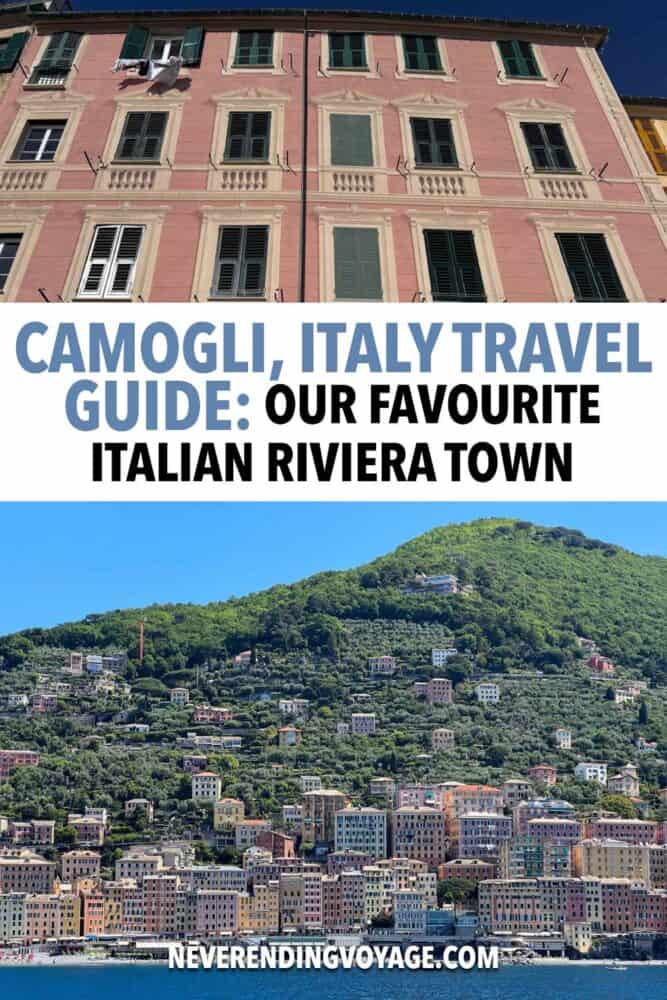
Hotel Cenobio dei Dogi Review (Camogli, Italy) 31 Jul 6:36 AM (2 months ago)
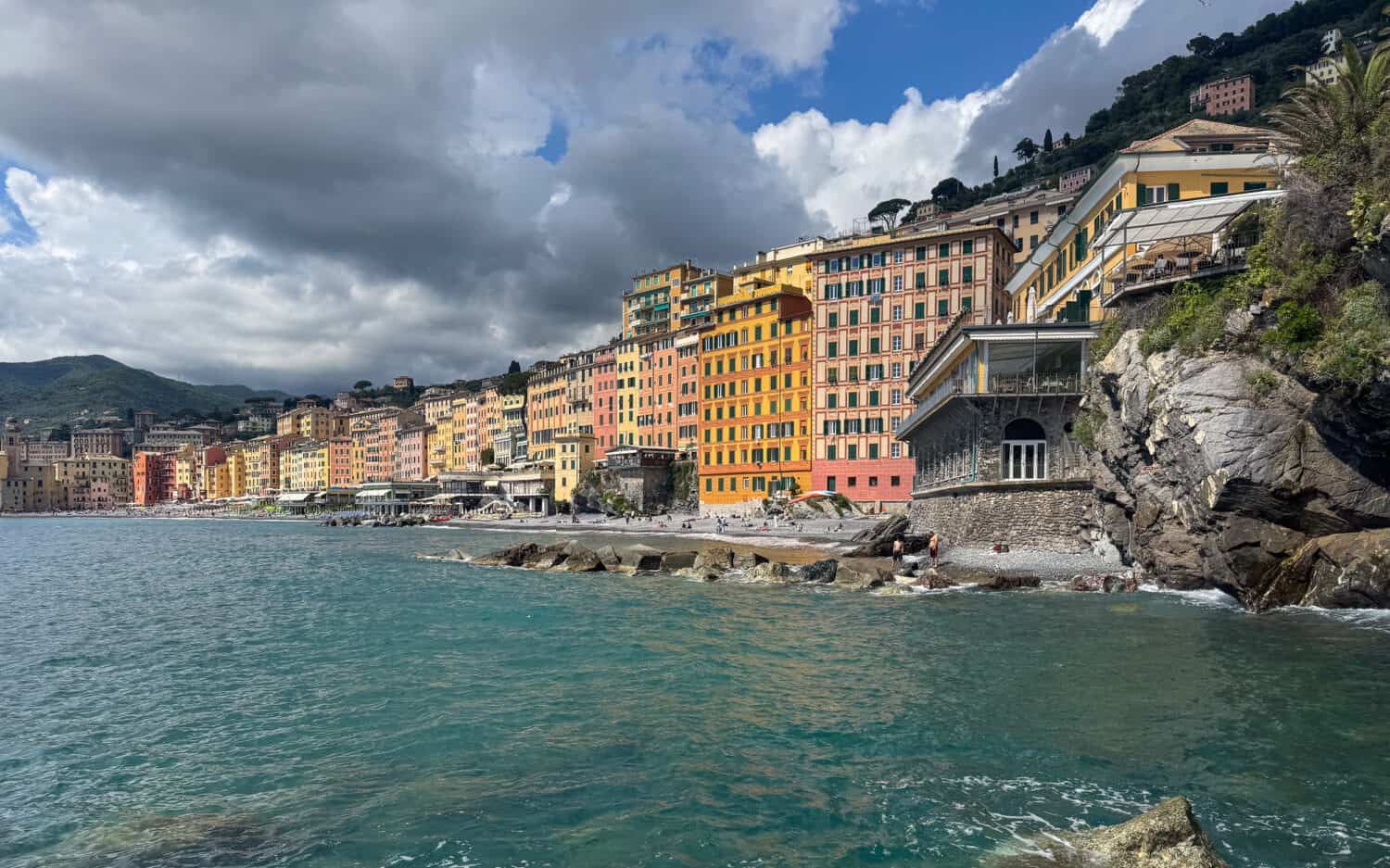
We loved the Italian Riviera town of Camogli so much that we couldn’t leave, even after a week.
So we extended our stay with a weekend at the fancy hotel perched on a cliff above the beach that we’d been eying up all week.
Hotel Cenobio dei Dogi did not disappoint. While it is expensive, it has lots of perks, including stunning views, a heated pool, and a private beach.
It’s ideal for an elegant but relaxing break, with easy access to the town and station if you want to explore.
In this Hotel Cenobio dei Dogi review, I share the pros and cons of the hotel, including our thoughts on its rooms, location, restaurants, facilities, and more.
Contents
- Where is Lake Molveno?
- Best Things to Do in Molveno
- Where We Stayed: Grand Hotel Molveno Review
- Where to Eat in Molveno
- How to Get to Lake Molveno, Italy
- Lake Molveno Map
- Is Lake Molveno Worth Visiting?
- More North Italy Posts
- Where is Camogli, Italy?
- Best Things To Do in Camogli Village
- Best Hikes and Day Trips from Camogli
- Our Favourite Places to Eat in Camogli
- Where to Stay in Camogli
- How to Get to Camogli
- Camogli, Italy Map
- Is Camogli Worth Visiting?
- More Italian Riviera Tips
- Location of Hotel Cenobio dei Dogi, Camogli
- History of the Hotel
- Our Room at Hotel Cenobio dei Dogi
- Swimming Pool
- Private Beach
- Restaurants
- Other Facilities
- Hotel Cenobio dei Dogi Pros and Cons
- Cost of Hotel Cenobio dei Dogi
- Final Thoughts
- More Italian Riviera Posts
Location of Hotel Cenobio dei Dogi, Camogli

Hotel Cenobio dei Dogi is located in the small seaside town of Camogli in Liguria, Italy.
It’s situated at one end of Camogli Beach with fantastic views of the town including the colourful seafront houses, church, castle, and mountains beyond.
Read my Camogli Italy travel guide for lots of tips.

Camogli is a wonderful base for exploring the Italian Riviera. You can easily visit San Fruttuoso, Portofino, Santa Margherita Ligure, and Rapallo by train or ferry.
There are some lovely hiking trails from town—our favourite is the Camogli to San Fruttuoso hike (then take the ferry back).
The Cinque Terre villages are about an hour away by train (usually with a change) and also have great hikes (such as from Corniglia to Manarola via the vineyards of Volastra).
Genoa is about 50 minutes by train and has the nearest airport.
It’s easy to reach Hotel Cenobio dei Dogi by train as it’s only a few minutes’ walk from the station. There’s a lift opposite Camogli Station that takes you down to sea level where the hotel is located, so you can avoid the stairs.
If you are driving, the hotel has a free car park, which is rare in Camogli.
Camogli is very small so you can walk from the hotel to all the restaurants and bars.
History of the Hotel
Hotel Cenobio dei Dogi’s history dates back to 1565 when it was a holiday villa of the powerful Dogi family that ruled large parts of Italy at the time.
In the late 18th century, it was divided into two villas and sold off separately, but in the 1920s, Emilio De Ferrari reunited both villas to transform them into a luxury hotel.
The hotel finally opened in 1956.
Our Room at Hotel Cenobio dei Dogi
Room types at Hotel Cenobio vary widely, from standard rooms without sea views to large suites with separate bedrooms.
We were happy with our Standard Double Room with Sea View and Balcony. I do recommend getting a sea view if you can.
Our room was in the main yellow villa (there’s also a pink villa next to the pool) on the third (top) floor or attic.
There’s a lift up from reception, but we found it quicker to take the stairs, especially when we wanted to use the back entrance to get to the pool quickly (rather than going through the bar).
The corridors in the building are quite dark, but it’s an old building and that no doubt helps keep it cool.
Our first impression was that the room was fine but nothing special. At 26 sqm, it wasn’t huge but was big enough for the two of us.
Decor was fairly plain with white bedding, light grey walls, and cream coloured wooden furniture. I did like the parquet floors.

The room very much grew on us, though, and we didn’t want to leave.
The highlight is the sea view. We could lie in bed with the balcony doors open and see the sea. We left them cracked open at night and found the sound of gentle waves soothing.

There was a table and chairs on the balcony, which was a lovely place to relax and has perfect sunset views.
On the attic floor, the balcony walls are high so you have to lean out to see Camogli Beach and the town, but it feels very private.

The queen-sized bed was very comfortable with super soft sheets and a couple of good pillows each (not always a given in Italy).
There was also a small table in the room with two comfortable chairs—good for working or ordering room service.

We had two wardrobes (one with shelves), a stocked mini bar (€3.50 for a small water or soft drink, €4 for a beer), a kettle with a selection of tea bags (but only Nescafe for coffee), a luggage rack, and air conditioning. A TV was mounted on the wall.
The bathroom was nice and very clean. We loved the powerful shower with rain and handheld shower heads. The Culti toiletries (in small bottles) smelled lovely. Bathrobes were provided.

My only complaint is that I would have liked some hooks on the door. The only place for towels was the towel rail at the end of the shower. It worked fine, but at the beach, you always need somewhere to hang wet gear.
In the end, we loved our room and would choose that category again as we appreciated the sea view and balcony.
There are rooms on lower floors with larger terraces, but some of them overlook the pool—convenient for swimming but much less private and further back from the sea.

Swimming Pool

The salt water pool at Hotel Cenobio dei Dogi is a lovely place to relax. It’s a decent size with lots of sun loungers around it, some with views of Camogli Beach.
In May, we never had a problem finding a place to sit, but in July and August that might be different (you can pay to reserve a spot).

The pool is heated to 28ºC from October to May, which Simon appreciated as the sea was 18-20ºC in May and a little cold for him (perfect for me, though).
The pool hours are limited. In the summer, it’s open from 9am-6pm, and in winter from 10am-5pm.
It’s a shame not being able to have an early morning swim, but I went down to the beach instead and swam across the bay, which was nicer anyway.
Private Beach

The private beach is my favourite aspect of Hotel Cenobio dei Dogi. It’s a tranquil place to relax and swim.
From the pool, take the stairs down to find it. You’ll pass changing rooms, toilets, and a restaurant on the way.
The pebble beach is quite large with lots of sun loungers and umbrellas spread over two sections. It’s totally separate from Camogli’s public beach, although just around the corner.
If you sit on the far right you’ll have a beautiful Camogli view.

It was never busy on a May weekend (much quieter than the pool). While it will be busier in summer, I think sunbeds on the beach are guaranteed for each room—a useful perk in high season.
There are QR codes at the loungers to order drinks, but they weren’t working on our visit. Someone did come by once to ask if we needed anything.
There’s also a beach kiosk for snacks that’s open in the summer months.
Restaurants
There are four restaurants at the hotel, but most of them only open in the summer.
Il Doge Restaurant
Il Doge is the main restaurant and is open year-round. It has a prime location with big windows overlooking the sea and Camogli.
Breakfast

The breakfast buffet was included in our room rate and was served in Il Doge from 7am to 10.30am. You can also order breakfast to your room for an extra charge of €12 per person.
We really enjoyed the buffet. There’s an incredible range of cakes and pastries (I counted at least 20) plus various focaccia (this Ligurian speciality is a must), fruit, cheese, cold meats, and cereal. There was even a vegan croissant.

As usual in Italy, hot food is limited, but they did have bacon, scrambled eggs, and boiled eggs.
Dinner
We loved dinner at Il Doge so much that we ate there twice (despite the fairly high cost).
You definitely want to make a reservation and request a window table. Try to time it just before sunset, but bring sunglasses! The sunset view is one of the best in Camogli.
Il Doge has a much larger choice for vegetarians than other restaurants in the area.
We ate a lot of pesto in Liguria, and the trofie pesto at Il Doge was the best we had—I had to order it again on the second night. The gnocchi with butter and sage was also excellent.

For a main course, we ordered grilled vegetables and potato mousse to share and they were the creamiest mashed potatoes we’ve ever had!
Terrazza Bar

The hotel’s Terrazza bar is located near the pool. It was open for lunch in May.
There are some sofas and tables inside, but the highlight is the tables on the terrace with wonderful views. This is a great aperitivo spot.
Unfortunately, the lunch menu was more formal than we wanted, so we didn’t eat there.
We really wanted something casual to eat by the pool, so we had to go into town to get some focaccia. Everything is close by, but it would have been nice to stay in the hotel’s bubble and not leave the pool for a snack.
My Camogli guide has nearby food suggestions (including the all important gelato).

La Playa Beach Restaurant
The beach restaurant looked like it had great sea views, but it’s only open June to September (lunch and dinner).
Il Chiosco on the Beach
The casual beach kiosk is supposed to be open from May to October in the afternoon and early evening, but it didn’t seem to be open in May.
It has a small menu of sandwiches, salads, fries, and ice cream.
Other Facilities
The hotel doesn’t have a huge amount of facilities (there’s no gym) or organised activities, but you can always ask the staff to arrange activities in the area.
It’s also easy to explore independently.
There is a small beauty centre where you can arrange massages and treatments. A 60-minute massage costs €90, and a manicure is €25.
The free parking is a big perk in Camogli.
There are lots of meeting and event rooms, and there were a couple of weddings and gatherings during our stay.
Note that you have to download the official app to have access to all the hotel information including restaurant menus.
The hotel are happy to store your luggage if you arrive before the 2pm check-in time. We were able to head to the pool, and then they texted us when our room was ready and took our luggage up.
Check out is at 12pm, which is fairly generous for Italy.

Hotel Cenobio dei Dogi Pros and Cons
Pros
- Elegant, comfortable rooms.
- Sea views and balconies in some rooms.
- Beautiful views of Camogli.
- Private beach with sun loungers and umbrellas.
- Salt water pool (heated in the cooler months).
- Excellent onsite restaurant with stunning views.
- Great breakfast buffet (if you have a sweet tooth).
- Friendly staff.
- Easy access to Camogli Train Station and everywhere in town.
- Free onsite parking.
Cons
- It’s pricey.
- No casual place for lunch outside of summer.
- Limited pool hours (no early morning or late night swims).
- No gym (not that we wanted one!).
Cost of Hotel Cenobio dei Dogi
Hotel Cenobio is one of the more expensive hotels in Camogli (but still cheaper than nearby Portofino).
On a weekend in mid-May, our standard double room with sea view and balcony cost €428 a night including breakfast. Weekdays are usually cheaper.
August is the most expensive month (our room would be €650).
You can get some great deals in winter, but I recommend the shoulder months (April/May or September/October) for better weather.
It’s a popular hotel, so be sure to book far in advance for the summer, or if you want a particular room.
Check prices and availability of Hotel Cenobio dei Dogi on Booking.com.
Or direct on the Hotel Cenobio dei Dogi website.
Final Thoughts
We absolutely loved Hotel Cenobio dei Dogi and would love to return for a longer stay.
The location and views are exceptional, our room was very comfortable, and the food was delicious.
It’s perfect for a relaxing trip where you can combine time at the pool or private beach with exploring the beautiful hikes and other towns of the Italian Riviera.
More Italian Riviera Posts
Read more about this beautiful part of Italy with our other posts:
Camogli
- Camogli, Italy Travel Guide: Our Favourite Town on the Italian Riviera
- Hiking Camogli to San Fruttuoso: The Perfect Day on the Italian Riviera
- Camogli Fish Festival (Sagra del Pesce): What to Expect
Elsewhere on the Italian Riviera
- Hiking Corniglia to Manarola in Cinque Terre
- 11 Stunning Things to Do in the Italian Riviera
- Rapallo Travel Guide: The Best Italian Riviera Base
- Finale Ligure, Italy: The Quiet Side of the Italian Riviera
If you enjoyed this post, pin it!

Camogli Fish Festival (Sagra del Pesce): What to Expect 18 Jul 5:15 AM (3 months ago)
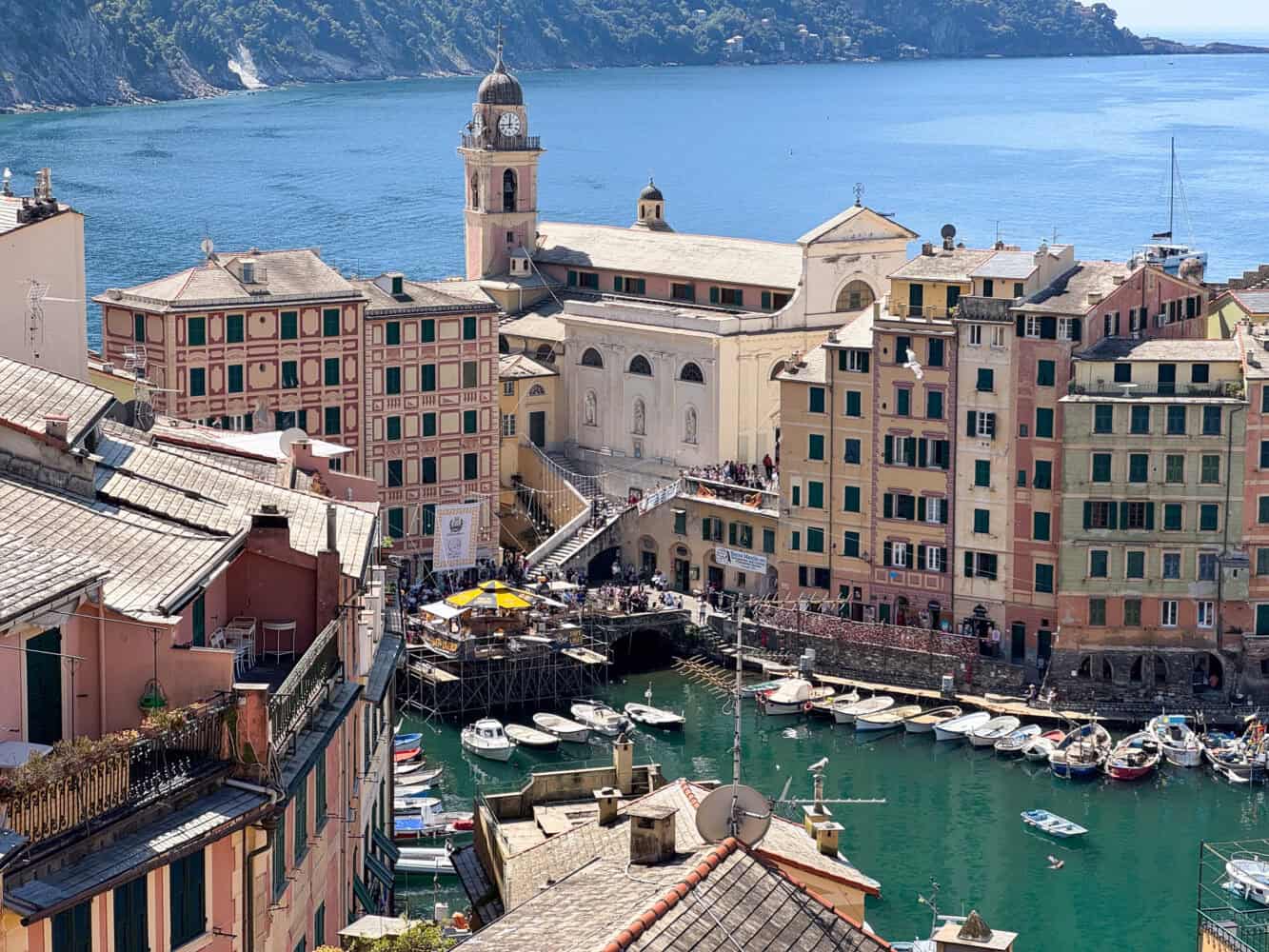
The Camogli Fish Festival, or Sagra del Pesce Camogli, is a major annual event held in May in Camogli, a fishing village in the Italian region of Liguria.
It’s also known as the Festa di San Fortunato, as it honours this patron saint of fishermen and celebrates Camogli’s centuries of fishing tradition. The festival dates back to 1952.
The main attraction is a fish fry where a giant frying pan is used to cook up a feast and serve fried fish for free to the thousands who attend.
As vegetarians, we didn’t plan to be in Camogli for the festival; it just coincided with our week in the village. Luckily for us, there is plenty of interest beyond the fish including huge bonfires and fireworks.
Camogli comes alive during the festival, which has its pros and cons. The town is very busy, especially on Saturday night, so we were glad we had an apartment with a kitchen so we didn’t have to worry about restaurant reservations (you’ll need one!).
There’s not much information about the Camogli Fish Festival in English, so here’s everything we learnt.
Contents
- Where is Lake Molveno?
- Best Things to Do in Molveno
- Where We Stayed: Grand Hotel Molveno Review
- Where to Eat in Molveno
- How to Get to Lake Molveno, Italy
- Lake Molveno Map
- Is Lake Molveno Worth Visiting?
- More North Italy Posts
- Where is Camogli, Italy?
- Best Things To Do in Camogli Village
- Best Hikes and Day Trips from Camogli
- Our Favourite Places to Eat in Camogli
- Where to Stay in Camogli
- How to Get to Camogli
- Camogli, Italy Map
- Is Camogli Worth Visiting?
- More Italian Riviera Tips
- Location of Hotel Cenobio dei Dogi, Camogli
- History of the Hotel
- Our Room at Hotel Cenobio dei Dogi
- Swimming Pool
- Private Beach
- Restaurants
- Other Facilities
- Hotel Cenobio dei Dogi Pros and Cons
- Cost of Hotel Cenobio dei Dogi
- Final Thoughts
- More Italian Riviera Posts
- Getting to Camogli
- When is the Camogli Fish Festival?
- Sagra del Pesce Camogli Schedule
- Friday Night: The Festival Begins
- Saturday: Bonfires and Fireworks
- Sunday Fish Fry
- Is the Camogli Fish Festival Worth Visiting?
- More Liguria Posts
Getting to Camogli
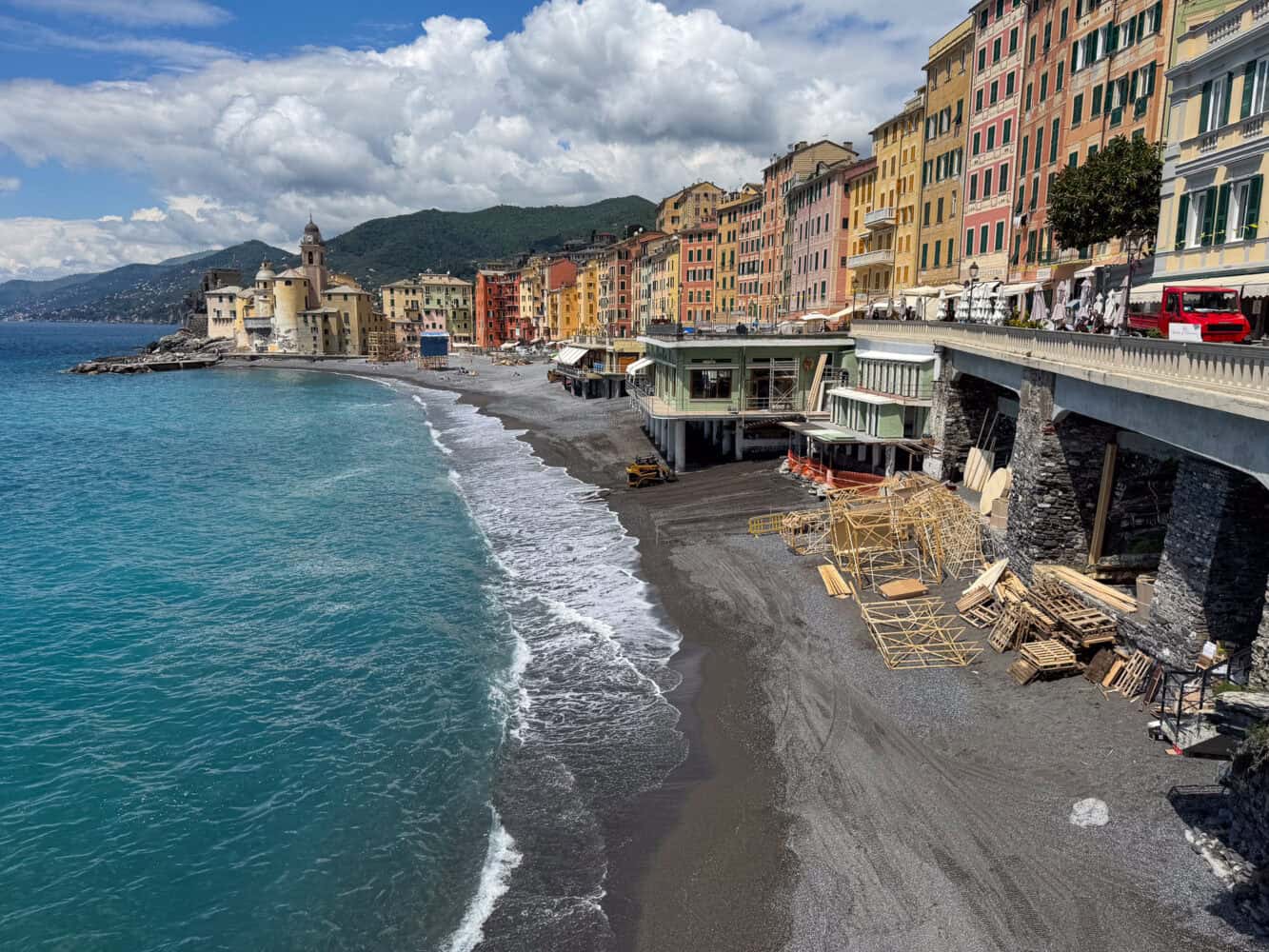
Camogli is located in the region of Liguria in northwest Italy. The area is also known as the Italian Riviera, with glamorous Portofino on the other side of the peninsula from more laid-back Camogli.
The easiest way to reach Camogli is by train (check times at TrenItalia). Trains take around 45 minutes from Genova (which has the nearest airport).
Other places with easy access by train to Camogli are Santa Margherita Ligure, Rapallo, and Sestri Levante. The Cinque Terre villages are about an hour away and usually require a change.
You can also reach Camogli by ferry from Genoa and Recco (and Portofino with a change at San Fruttuoso), with additional services offered during the festival. Check the Golfo Paradiso website for the timetable.
I don’t recommend driving to Camogli during the festival as parking is very limited.
Everywhere is easily walkable in compact Camogli, although there are stairs to get between the main street (and station) and the harbour/beach.
Read my guide to the best things to do in Camogli for more tips on the town.
When is the Camogli Fish Festival?
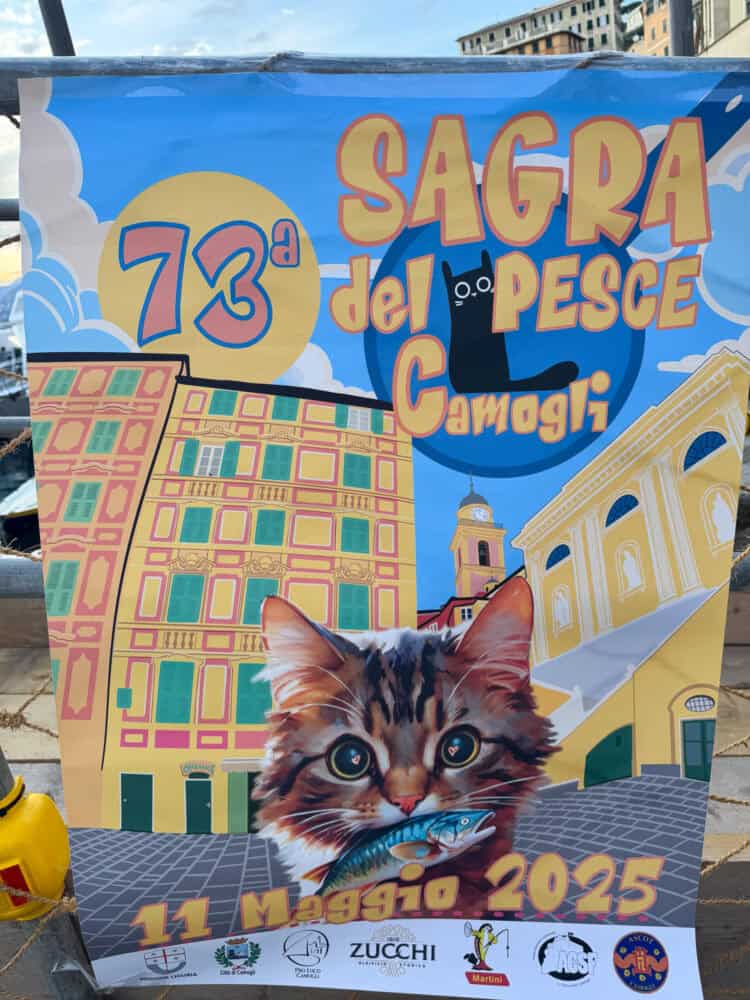
The Sagra del Pesce Camogli (Camogli Fish Festival) takes place on the second weekend in May every year. The fish fry takes place on the Sunday.
In 2026, it is scheduled to take place from Friday, 8 May to Sunday, 10 May.
Sagra del Pesce Camogli Schedule
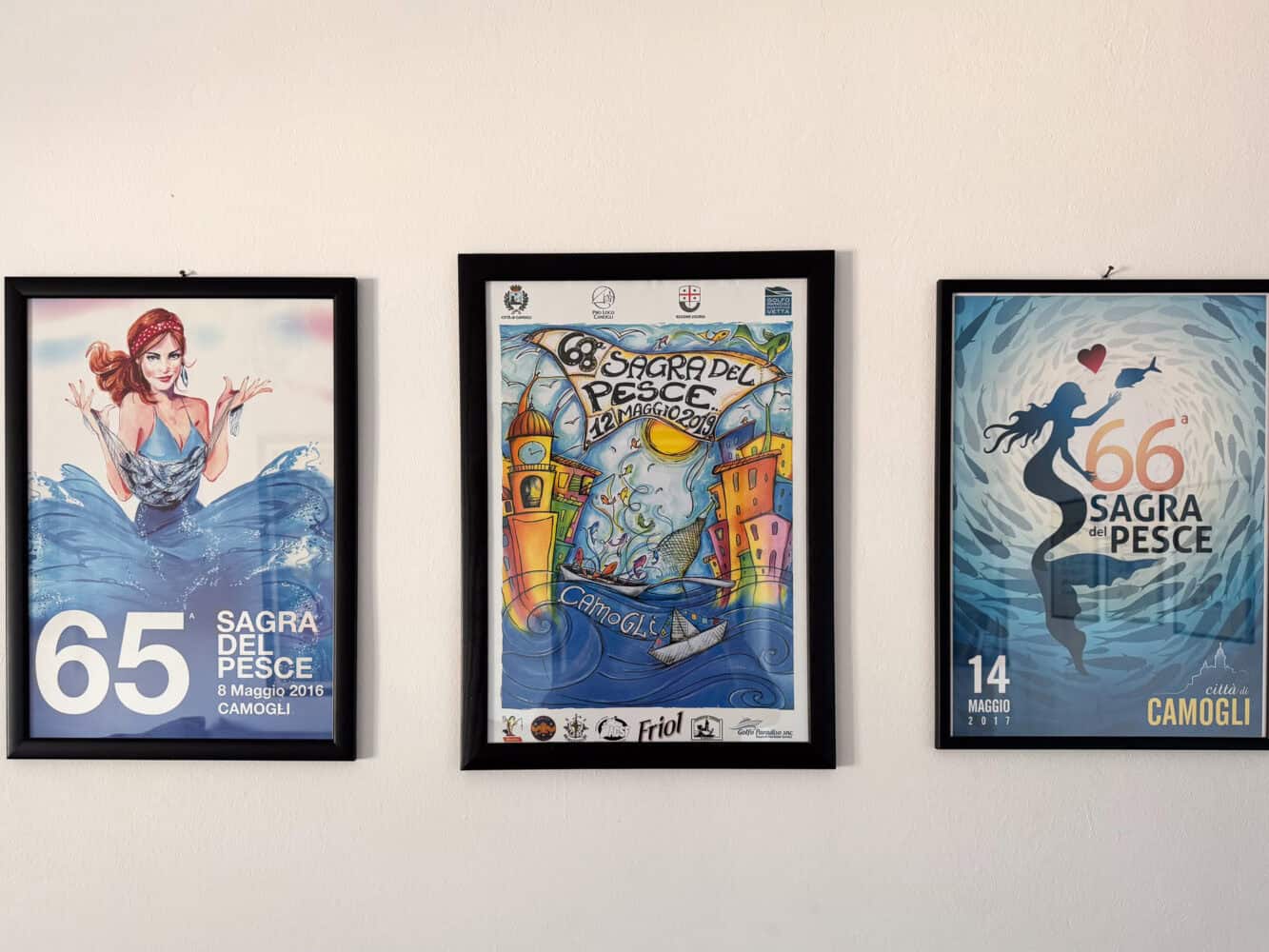
This was the Camogli Fish Festival schedule in 2025, but it is similar each year. Timings are approximate for the main events.
The best way to find the schedule is to check the Pro Loco Camogli Facebook page closer to the event.
Friday
- 7.30pm – Food stall with local specialities in Largo Ida Battistone.
- 8.30pm – Live music on the seafront.
- 10pm – Flag raising ceremony on the seafront.
Saturday
- 12.30pm and from 7.30pm – Food stall with local specialities in Largo Ida Battistone.
- 2pm – Midnight – Market on Via della Repubblica.
- 8.30pm – Religious procession.
- 11.15pm – Fireworks on the beach.
- 11.30pm – Lighting of the bonfires on the beach.
Sunday
- 9.45am – Blessing of the frying pan and fish.
- 10am until late afternoon – Fish fry in Piazza Colombo.
- 12pm and from 7.30pm – Food stall with local specialities in Largo Ida Battistone.
- 2pm – 8pm – Market on Via della Repubblica.
Friday Night: The Festival Begins
We arrived in Camogli on Friday afternoon. If you have limited time, Friday isn’t an essential part of the festival. It’s pretty lowkey with no major events.
It wasn’t too busy, but booking a restaurant is a good idea if there’s somewhere in particular you want to eat dinner.
We had no problems getting a table at lunch, and in the evening, we had aperitivo snacks at Il Barcollo on the seafront.
We enjoyed seeing the festival prep. Especially the three massive bonfires that were being built on the beach by three quartieri (neighbourhoods)—Porto, Pinetto, and Rissêu.
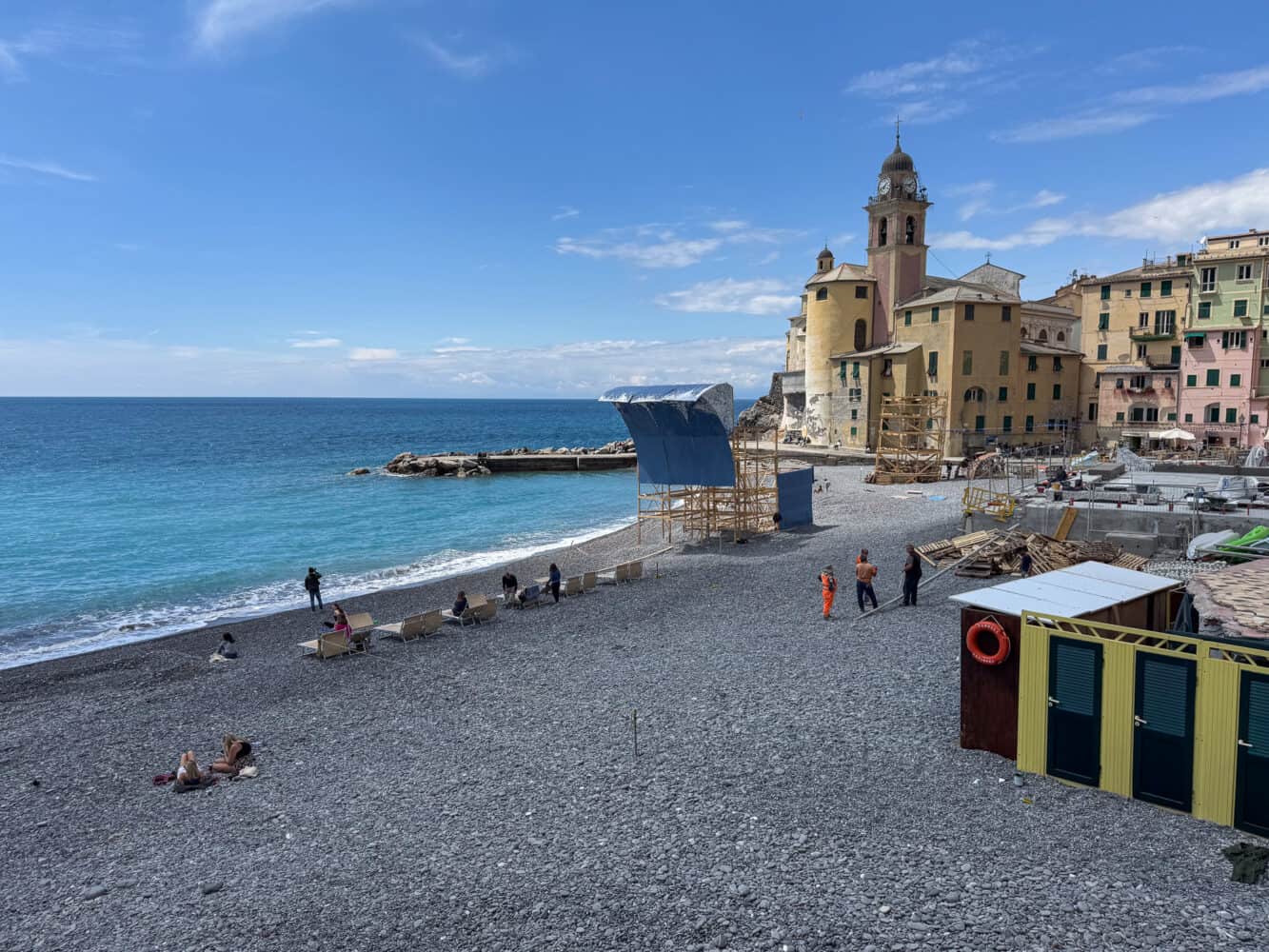
The wood and paper constructions were much larger than we expected, and it was fun to see them take shape over the next few days.
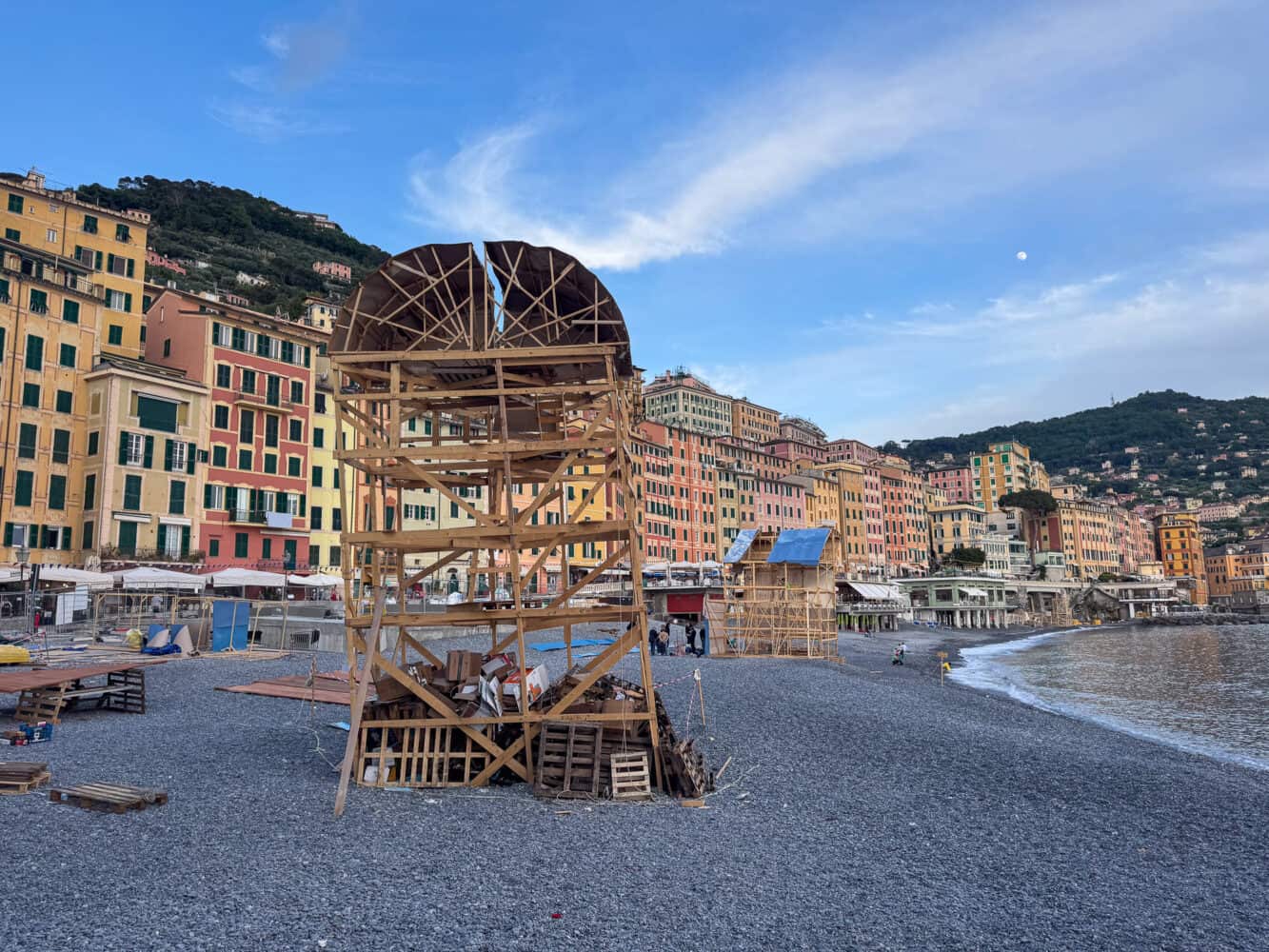
We also saw the giant frying pan (padella) overlooking the harbour, ready for Sunday’s feast.
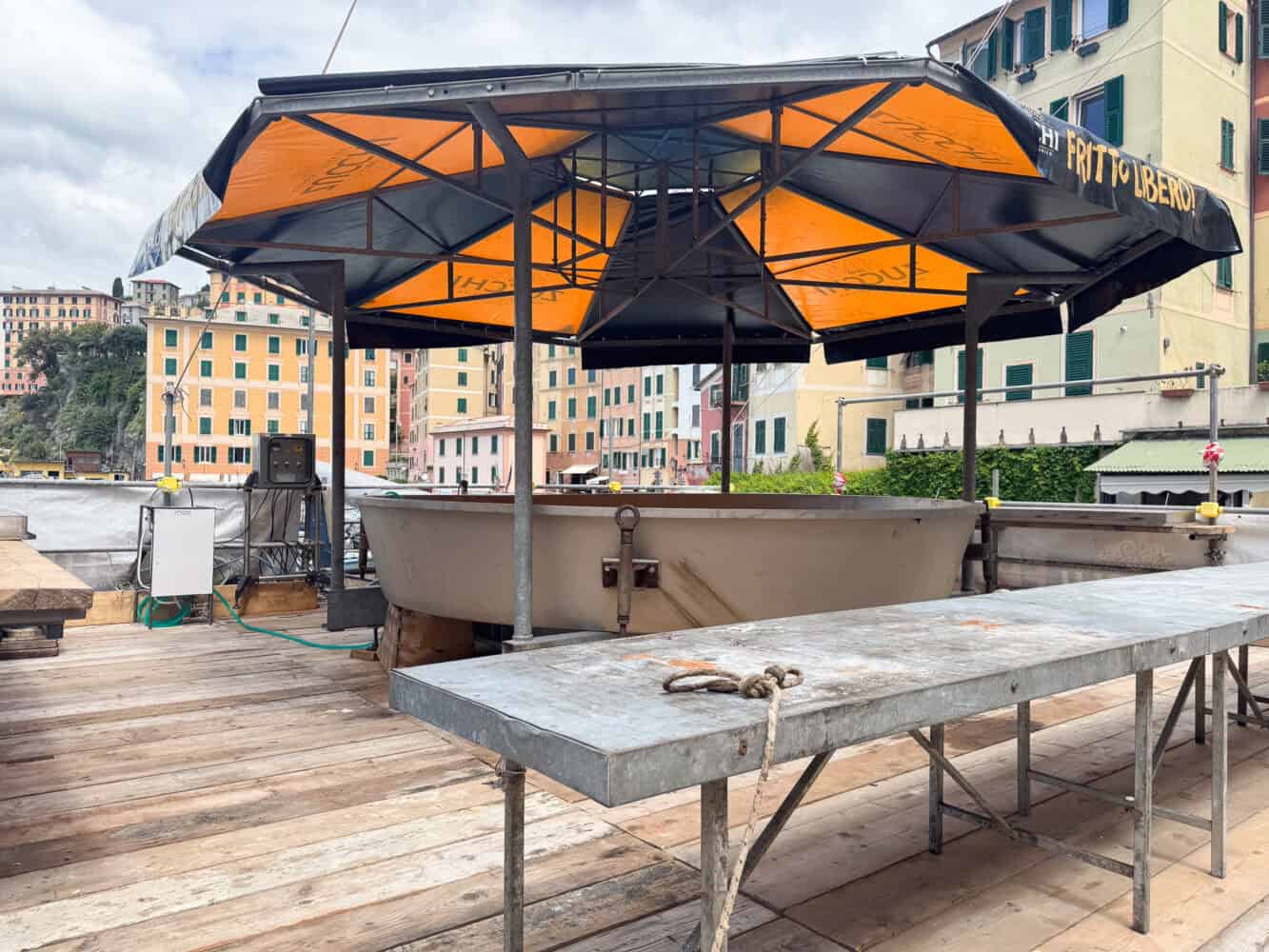
An older version of the frying pan is displayed permanently on Via Giuseppe Garibaldi with information about the festival. It’s marked as La Padella della Sagra del Pesce on Google Maps.

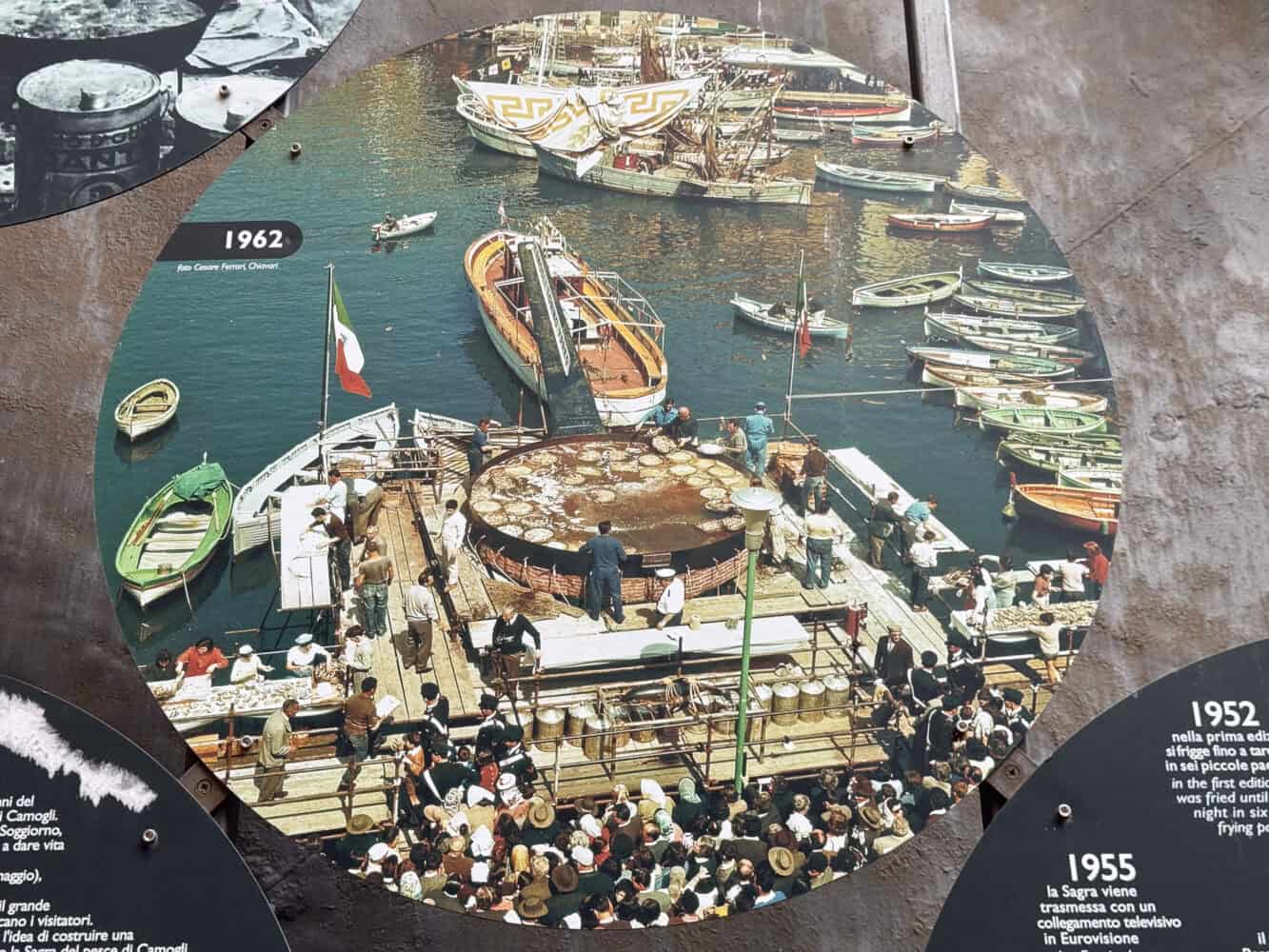
Next to it, the colourful Dragun boat was also out on display (after the festival, it was covered up).
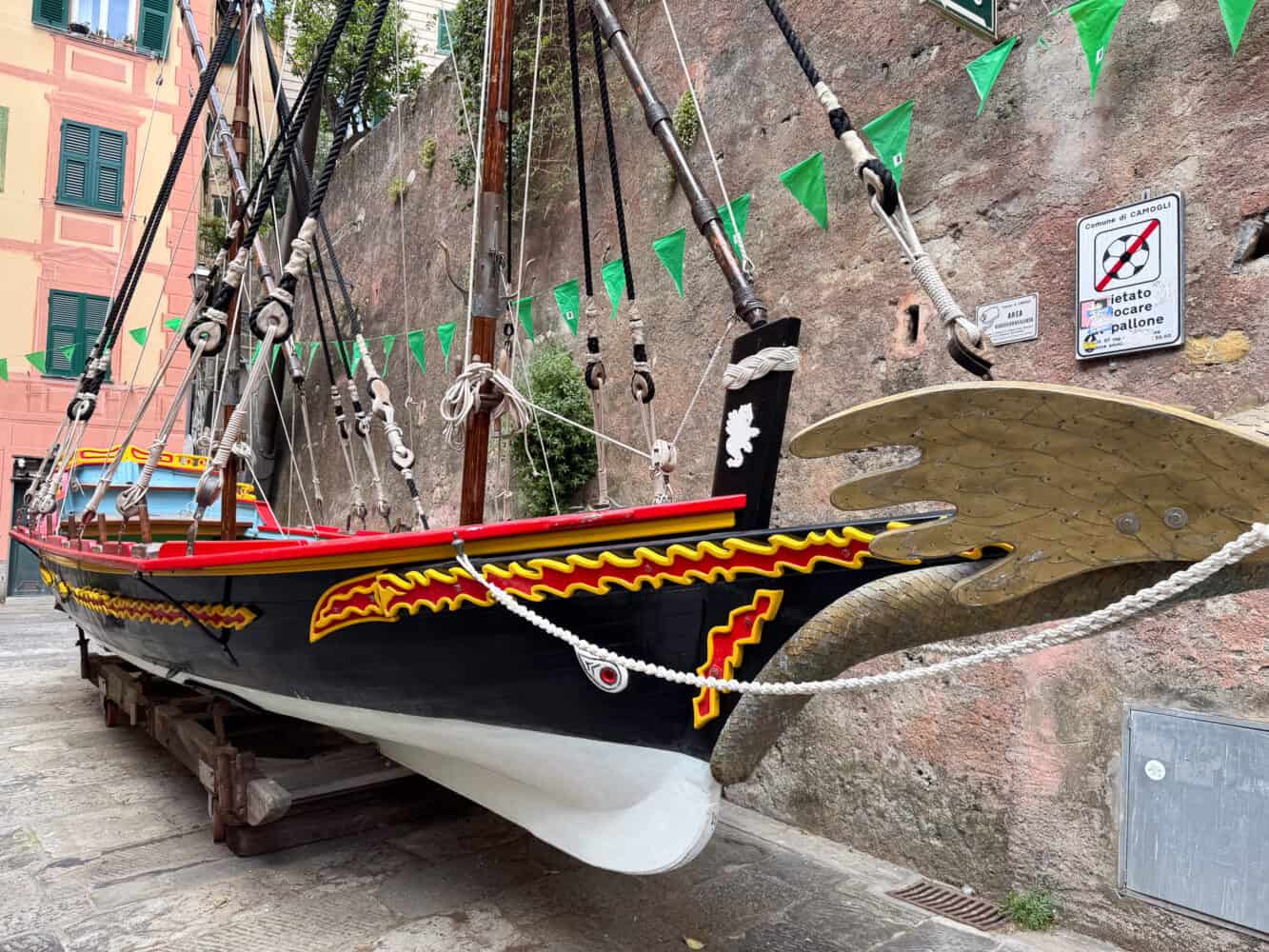
In the evening, the food stall at Largo Ida Battistone (a little piazza just back from the seafront) was set up and remained there through the weekend.
The Ligurian specialities (like pesto pasta and, of course, fish) were very affordable (as were the €1.50 glasses of wine), but there were always long queues, so we never ate there.

We saw the live music set up on the seafront, but it wasn’t a huge performance, and we didn’t stay for it.
Saturday: Bonfires and Fireworks
Saturday afternoon is when the Camogli Fish Festival really gets going, peaking in the evening with the fireworks and lighting of the bonfires.
Daytime Activities
On Saturday and Sunday, a market is set up on the main street, Via della Repubblica, selling art, clothes, and foodie items.
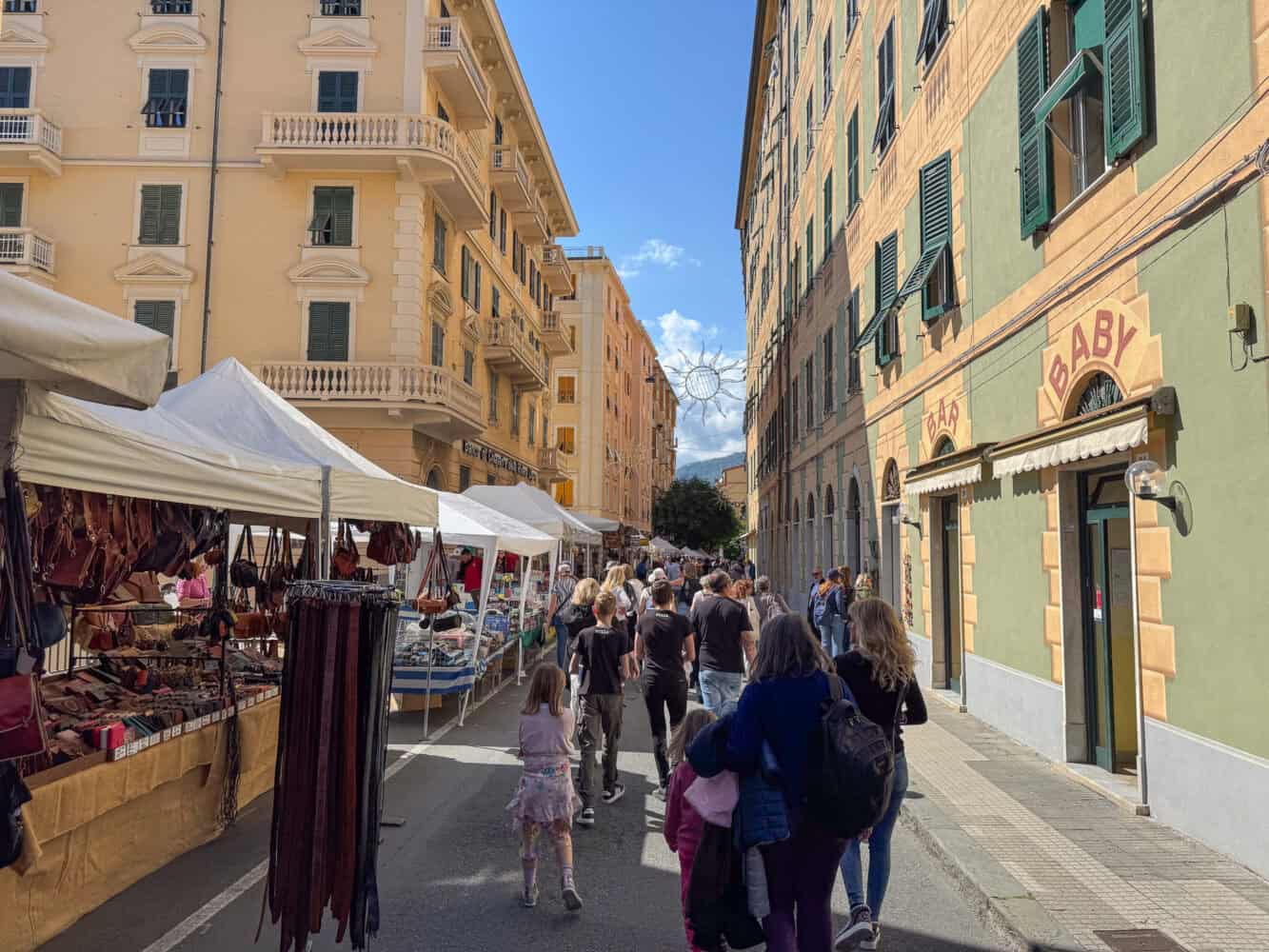
The food tent also returned, with long lines again.
The town started feeling busier in the afternoon, but we didn’t find the crowds unbearable until about 9pm. The vibe was lively, with bars setting up stalls to sell takeout drinks.
We went to the beach in the afternoon, but it closed at 5pm to prepare for the bonfires.
Procession
The first event of the evening is a religious procession, scheduled to begin around 8.30pm. It starts from the Basilica di Santa Maria Assunta, a church just above the piazza where the frying pan is, and goes through town.
Locals carry a statue of San Fortunato and a crucifix of Christ, accompanied by priests and a brass band.
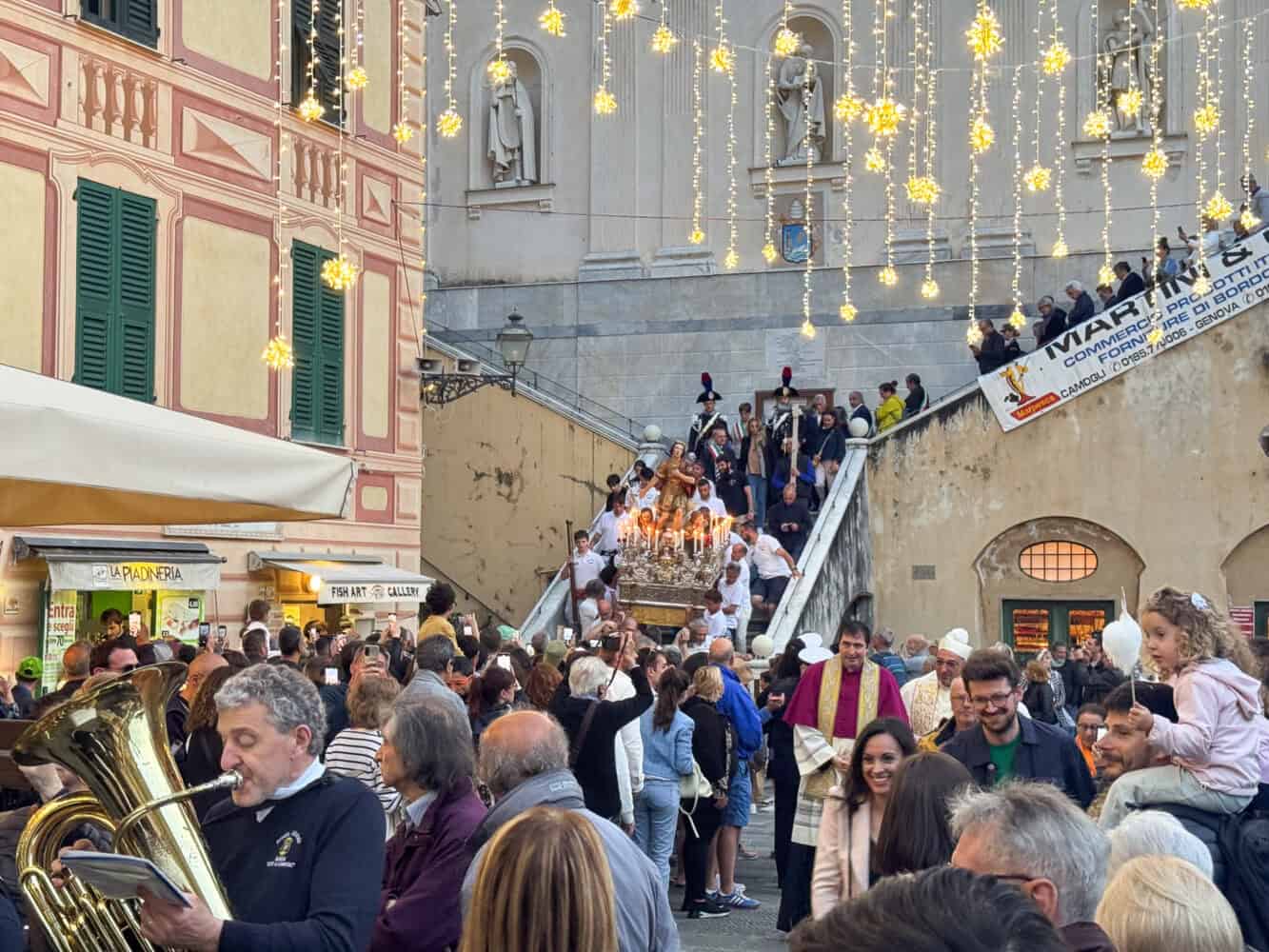
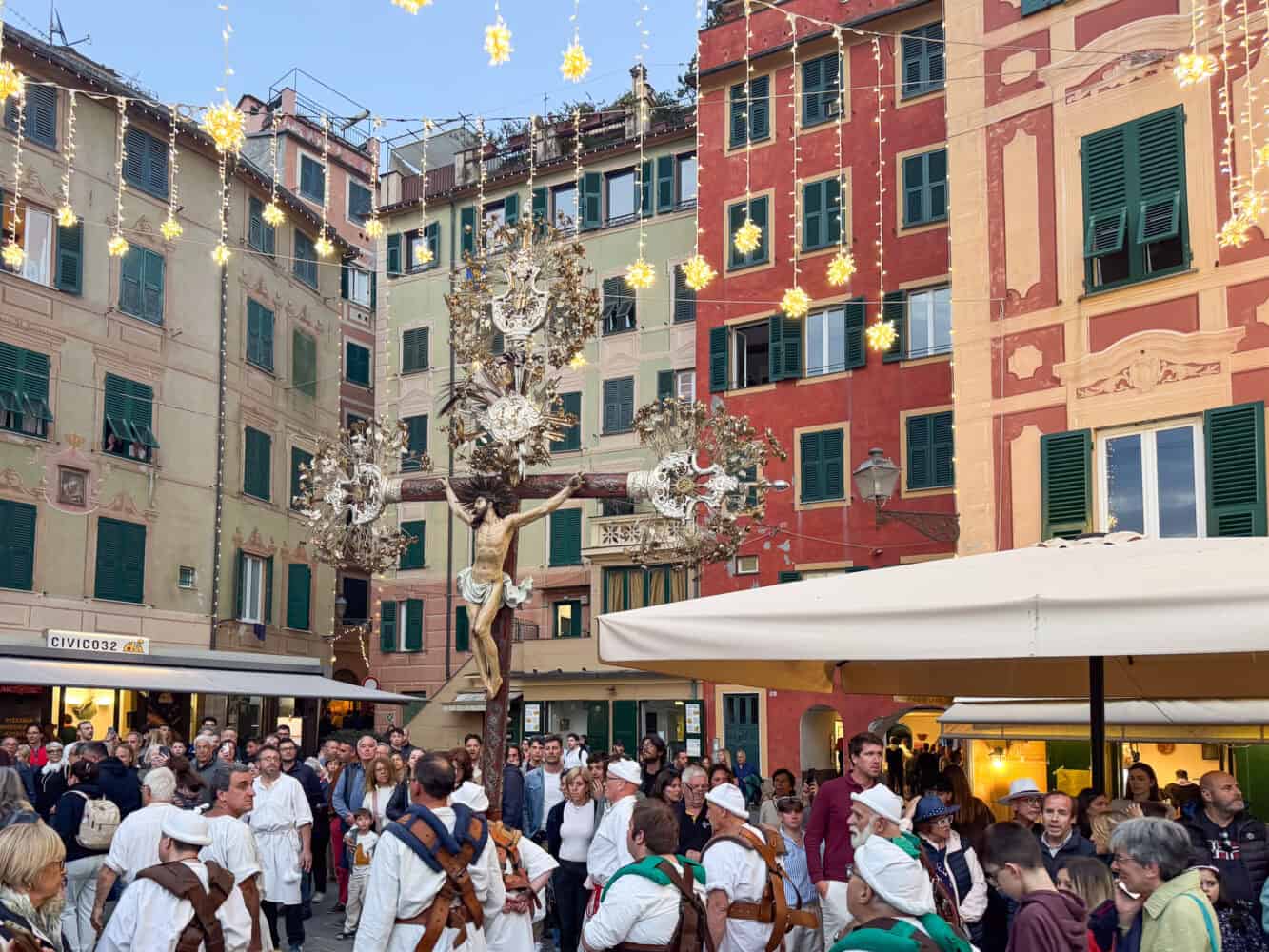
Fireworks
Things really get going late on the Saturday with a fireworks display from the right side of the beach (facing the water), near the church.
It started a little earlier than scheduled at 11.05pm and lasted about 10 minutes. It was surprisingly impressive!
We had the perfect view from the balcony of our apartment rental, A due passi dal cielo e dal mare. (I review the apartment in my Camogli travel guide).

Bonfires
The falò (bonfires) were the highlight of the Sagra del Pesce for us.
We loved watching the local communities hard at work on their astonishing creations over the weekend.
By Saturday afternoon, we could see what they all were—a robot, a wave, and a jukebox (with impressive attention to detail).
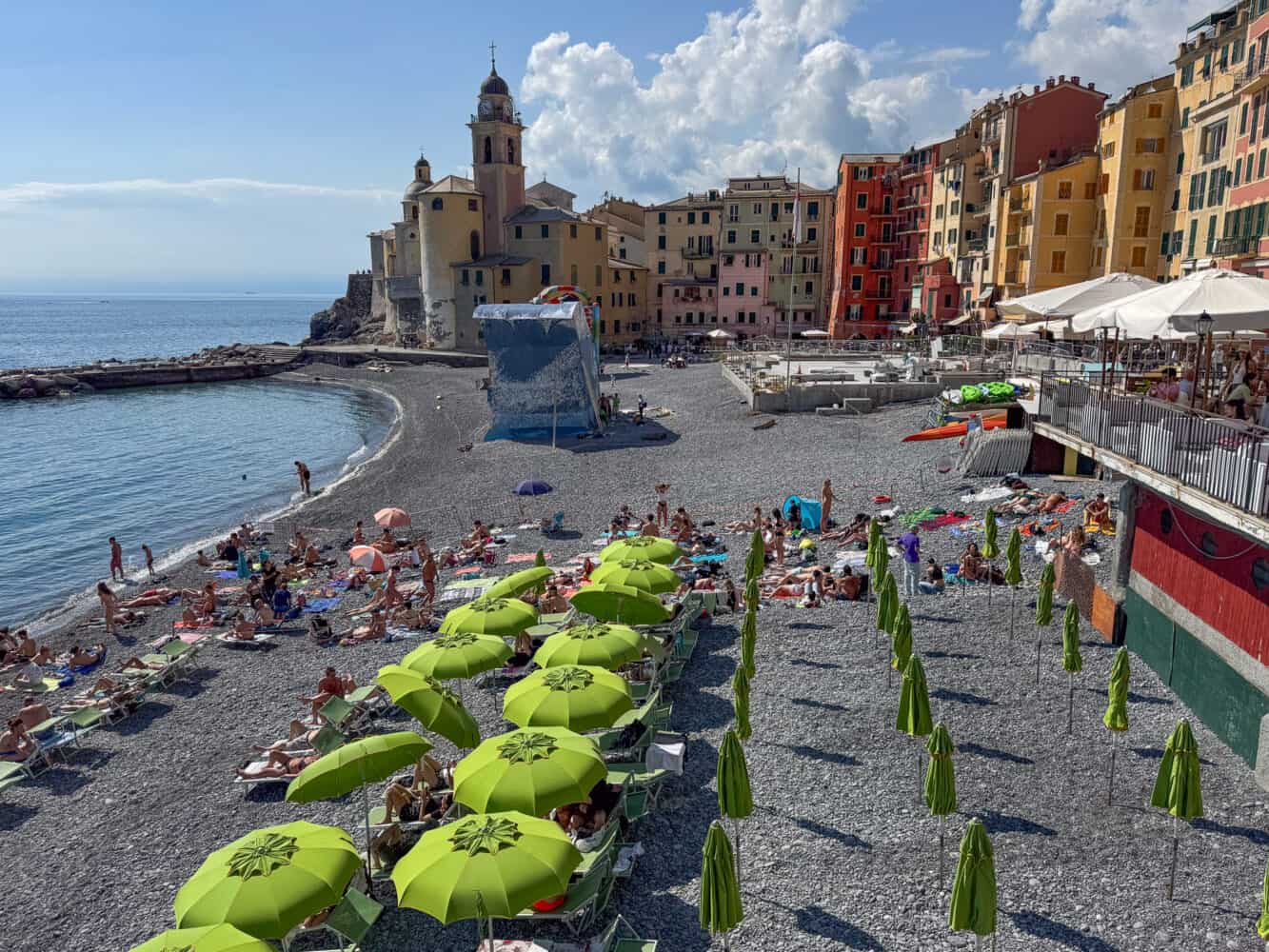
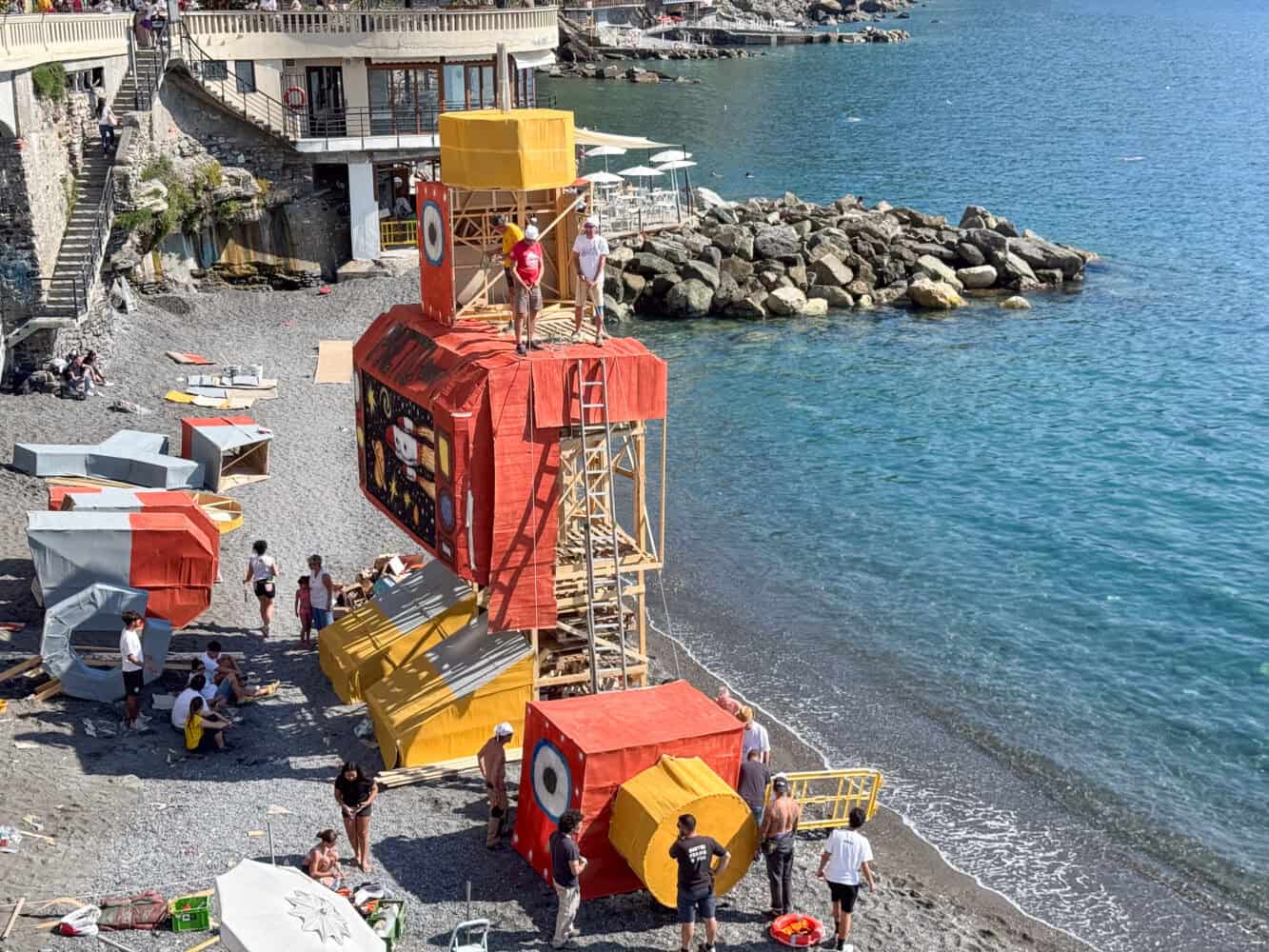
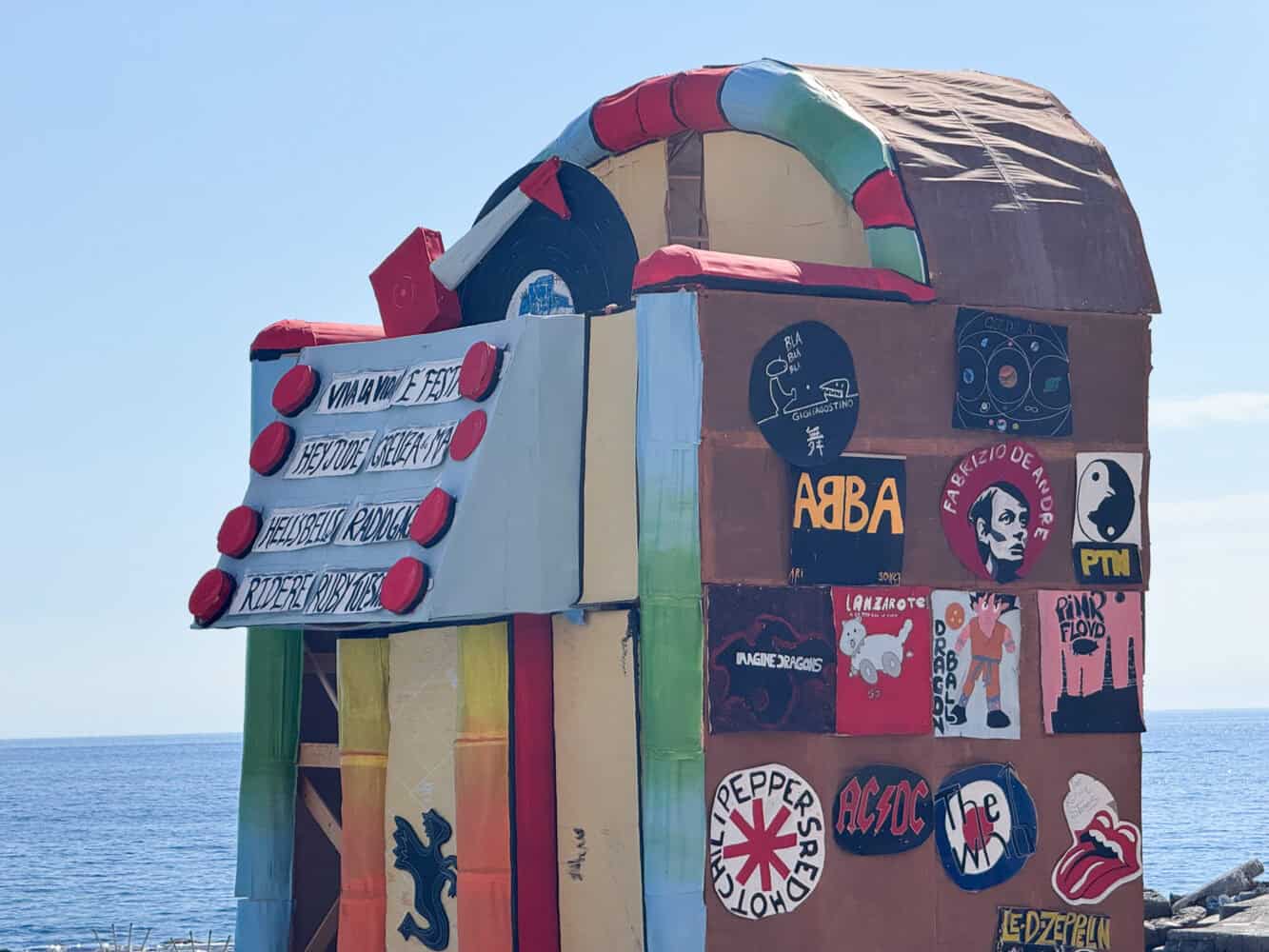
We were in awe of the immense effort that went into creating these massive constructions, only to light them on fire.
Every year, the bonfires are different and so creative. Later in the week, we visited a temporary exhibition at the castle, which showcased the bonfires over the years.
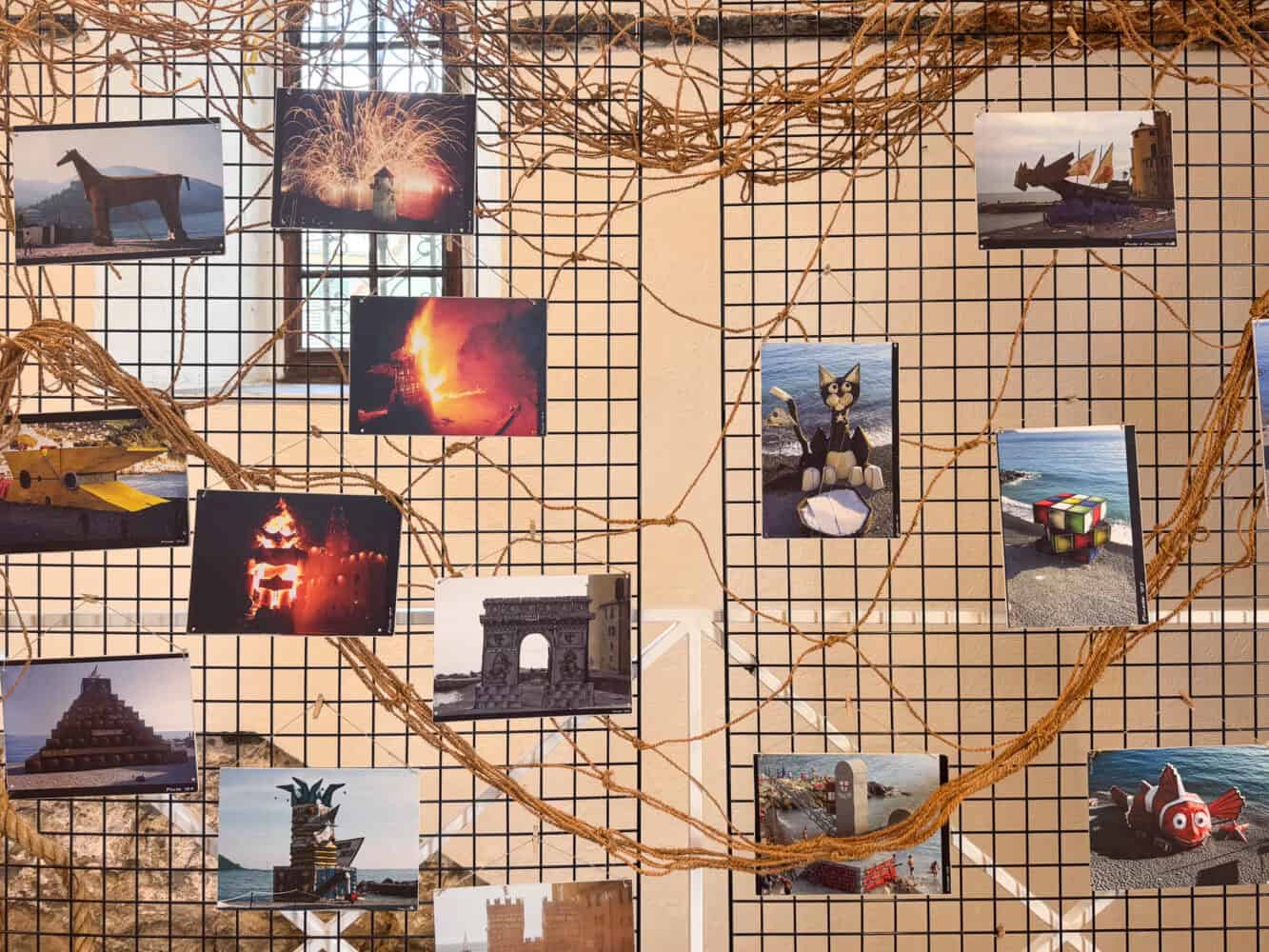
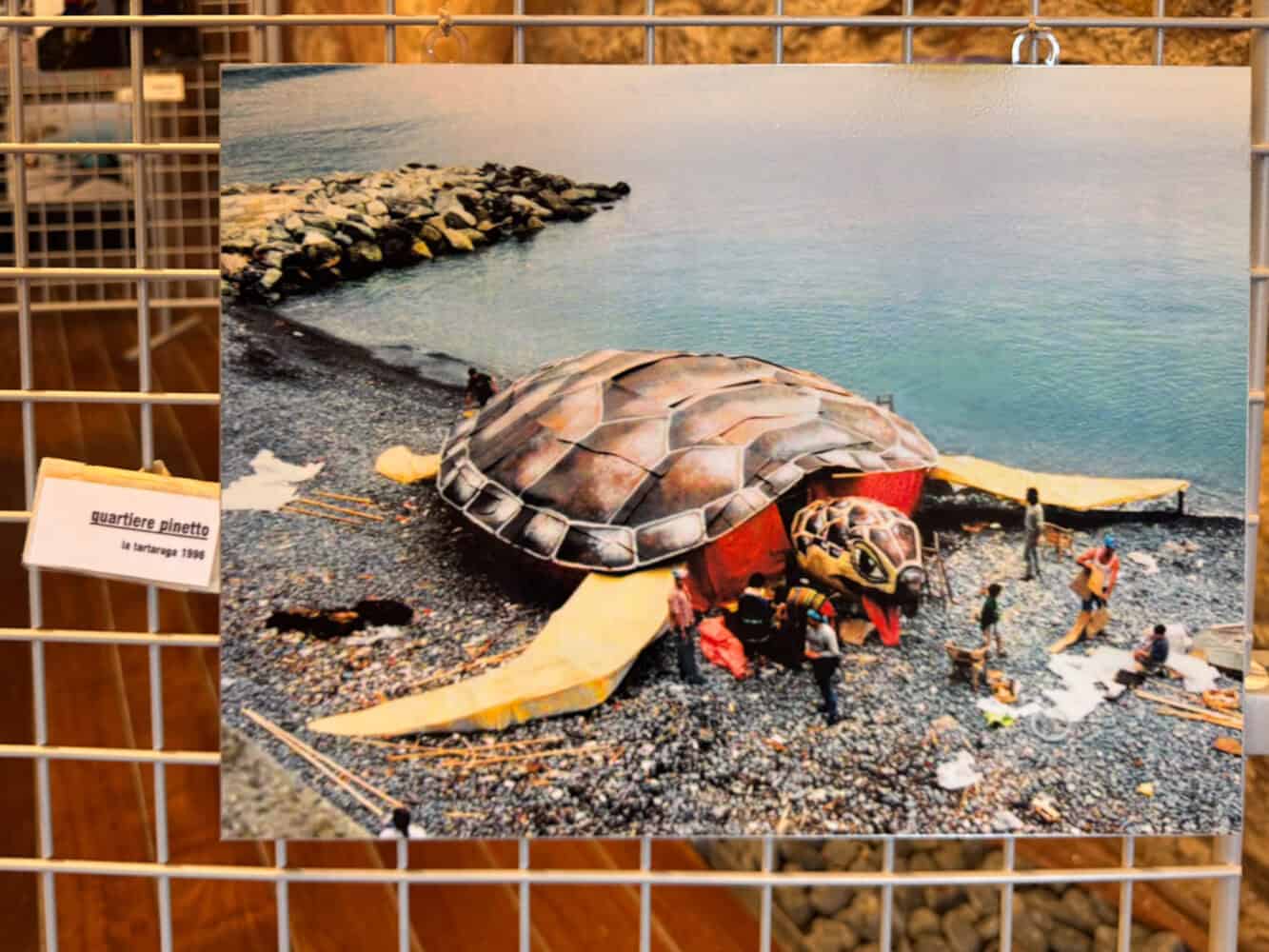
The bonfire tradition dates back to a time when fires were believed to bring good luck to the fishermen of Camogli. Villagers lit them on the beach as they departed on long voyages.
Following World War II, when the Camogli Fish Festival began, the fires became much more extravagant, and now the quartieri compete to make the most impressive one.
The Lighting of the Falò
The downside of watching the fireworks comfortably from our apartment is that we were late getting back to the seafront for the lighting of the bonfires at 11.30pm.
The promenade was rammed with people and had a party vibe with lots of young people out drinking (although it in no way felt aggressive).
It was difficult to find somewhere to see the bonfires—you really need to stake out a spot on Via Giuseppe Garibaldi, the promenade above the beach, at least an hour in advance. You can’t watch from the beach for safety reasons.
We managed to stand a few rows back near Bar Auriga (if you got an outdoor table here, you’d have the perfect view) and watch through the crowd.
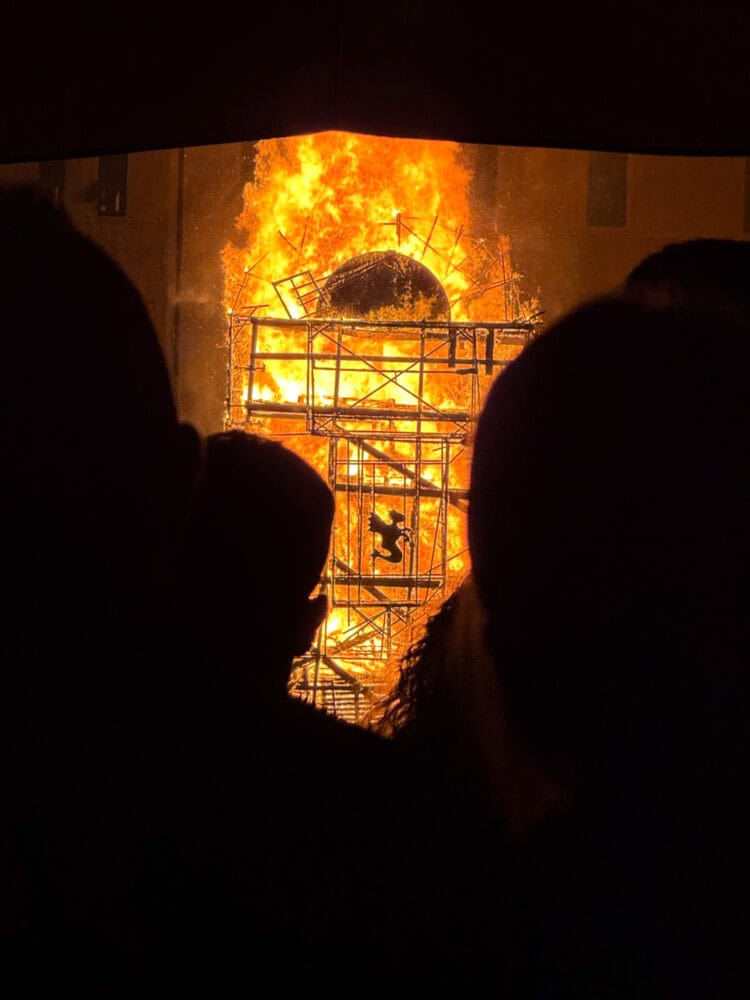
The fires were impressively huge, with debris shooting into the sky above all the surrounding buildings. We’ve never seen anything like it.
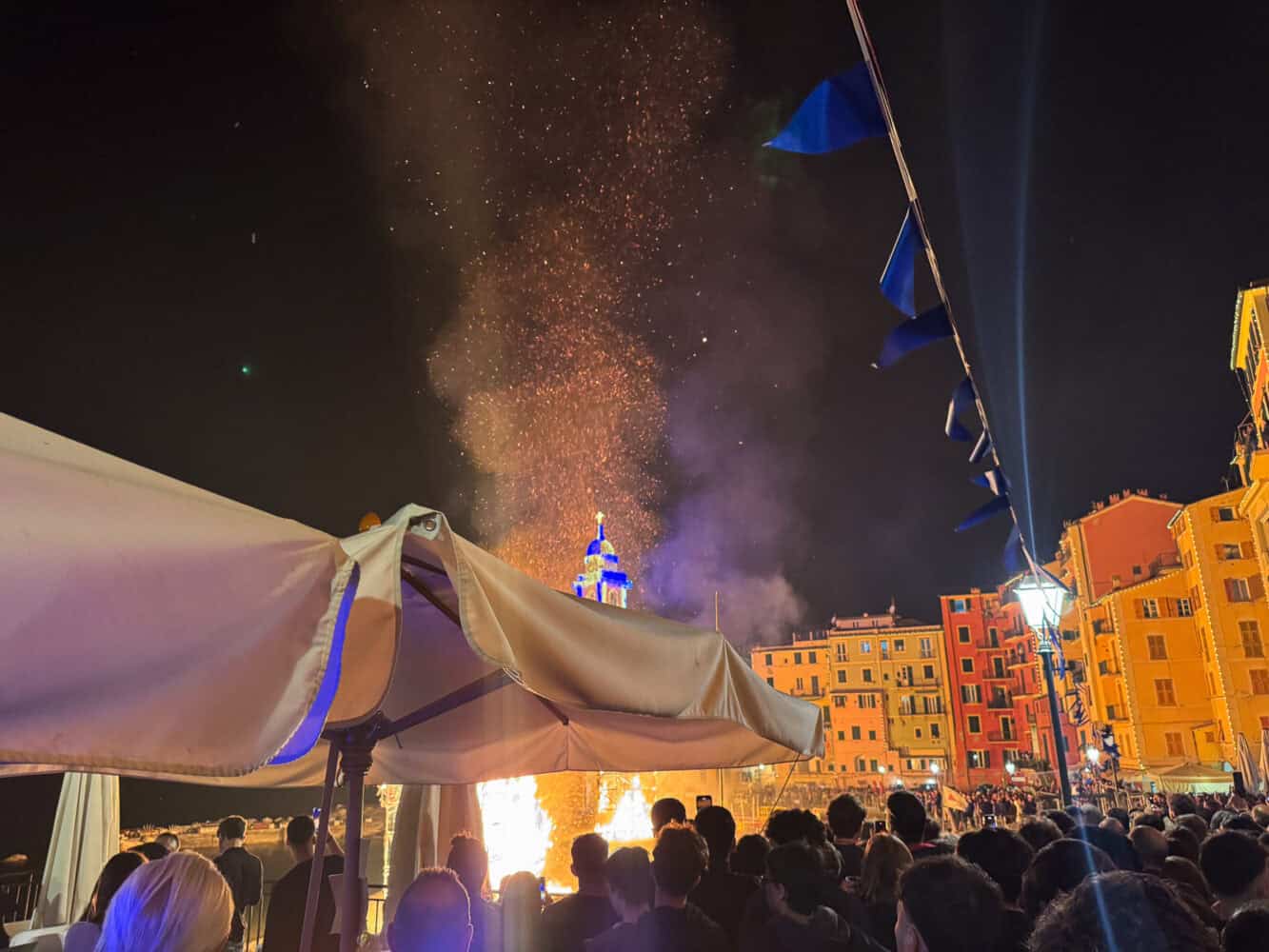
Sprinklers surround the bonfires to stop them getting out of control, and firefighters are on standby.
As the fires burned down, we managed to get a closer look.
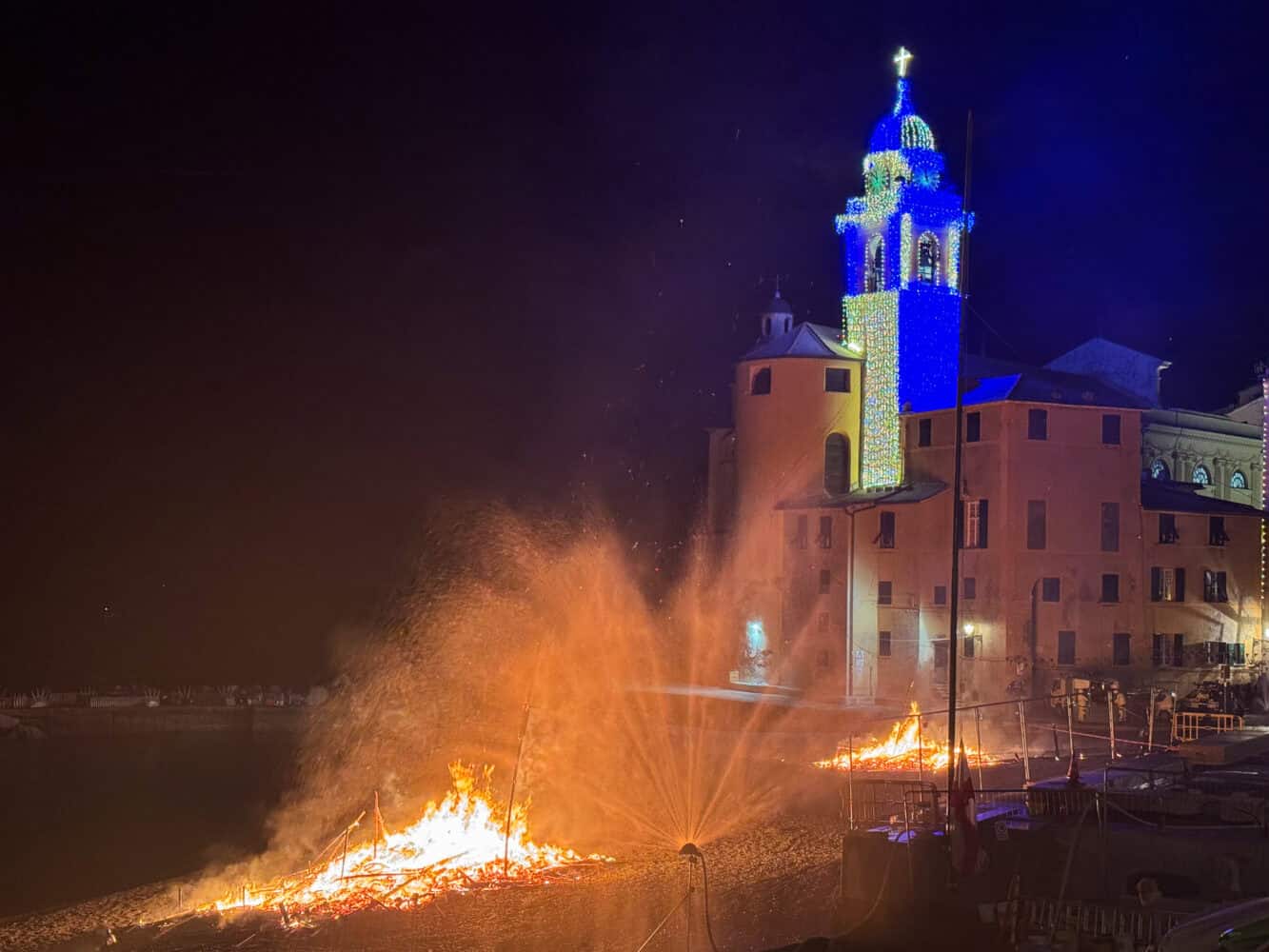
After the festival, we moved to the beautiful Hotel Cenobio dei Dogi at the other end of the beach. Staying there, you’d have a fantastic (if more distant) view of the fireworks and bonfires.
Top tip: If you need to cross town on Saturday evening, it’s easier to walk on the upper main street than on the crowded seafront. So take the stairs up and then walk over.
Sunday Fish Fry
While the bonfires were the main event for us, the Sunday fish fry is what the Sagra del Pesce is all about. The crowds streamed into town on Sunday morning.
The massive 3.8-metre frying pan (padella) contains 2000 litres of oil and can fry three tons of fish. It’s set up on Piazza Colombo on the harbour (see Molo Piccolo Camogli on Google Maps).
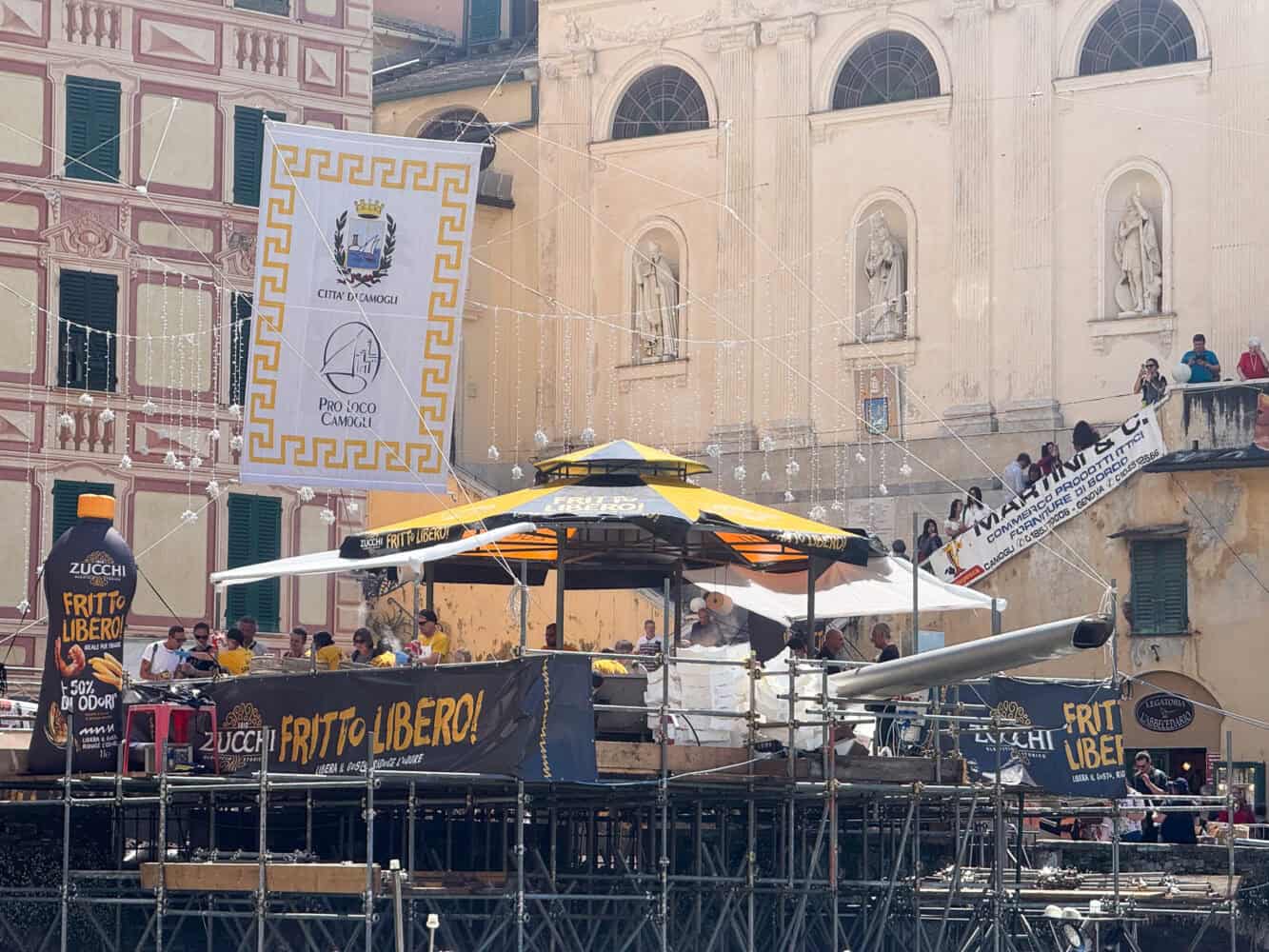
You can get a good view from above by walking up the stairs towards the Basilica di Santa Maria Assunta.
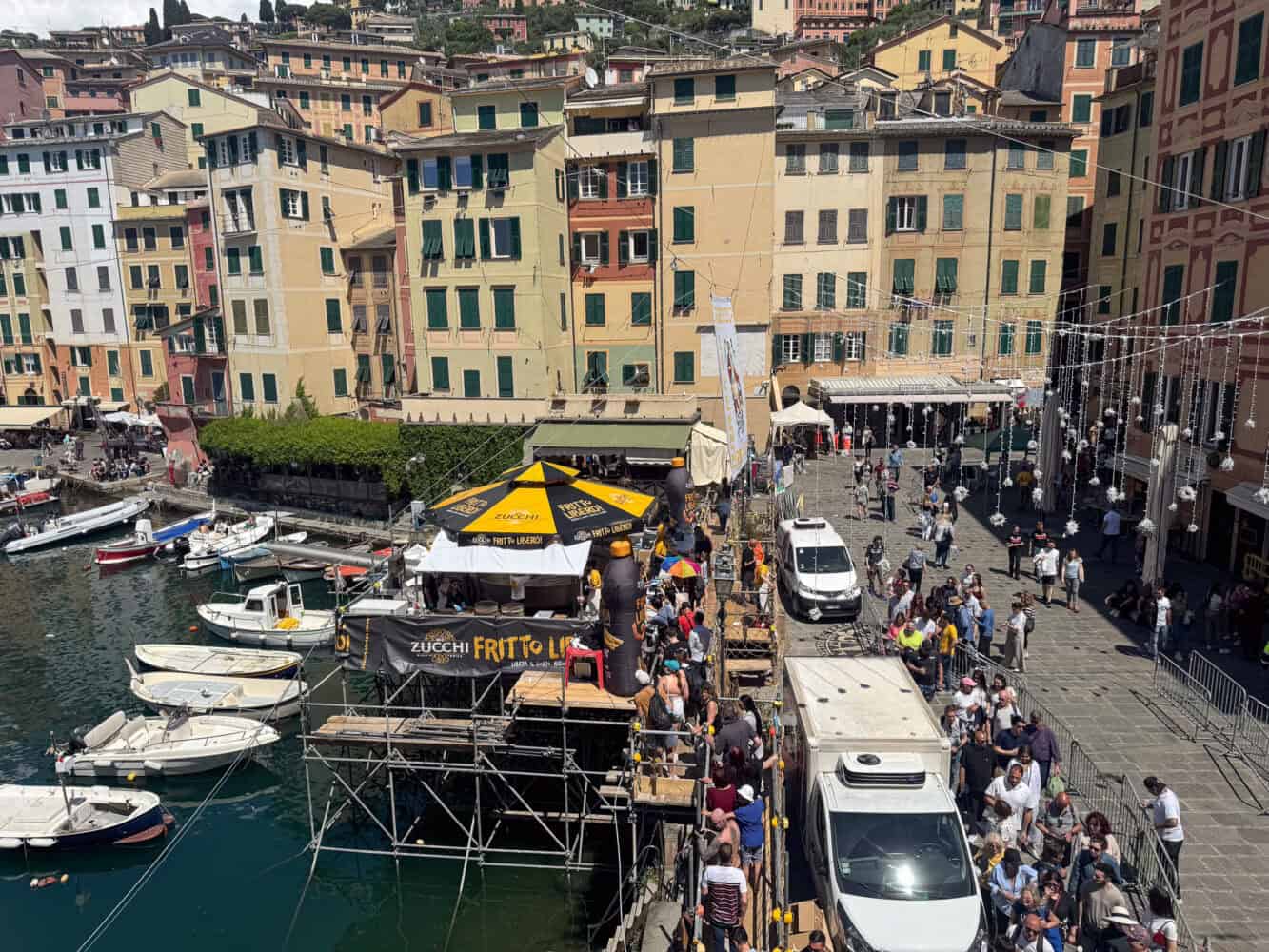
At around 10am, the blessing began. Honestly, you could probably skip this bit. The speeches (in Italian, of course) went on for ages.
I don’t think the frying started until about 11am. There were initially long queues, but they had become more manageable by 2pm when we walked past.
Everyone is welcome to join the queue up to the padella and receive a plate of mixed fried fish. There is no charge, but cash donations are welcome (there was a donation box on the way up to the pan).
I’m not sure what time they stopped serving, but they were well packed away at 7pm, so it’s best to go by 3pm so you don’t miss out.
On Sunday, the food tent and market were also back.
While most of the day was busy, Sunday night was much quieter as the day trippers left and Camogli got back to its usual tranquil self.
Is the Camogli Fish Festival Worth Visiting?
The Sagra del Pesce is definitely worth visiting. Even though we don’t eat fish, we still enjoyed attending this traditional festival. We especially loved watching the bonfires being constructed, then burned on Saturday night, as well as the fireworks.
If you like fish, you’ll enjoy it even more.
Camogli is a beautiful place, so I highly recommend spending a few extra days there before or after the festival so you can enjoy it without the festival crowds.
More Liguria Posts
Explore the rest of this beautiful region with our other travel guides:
Camogli
- Camogli, Italy Travel Guide: Our Favourite Town on the Italian Riviera
- Hiking Camogli to San Fruttuoso: The Perfect Day on the Italian Riviera
- Hotel Cenobio dei Dogi Review (Camogli, Italy)
Elsewhere on the Italian Riviera
- Hiking Corniglia to Manarola in Cinque Terre
- 11 Stunning Things to Do in the Italian Riviera
- Rapallo Travel Guide: The Best Italian Riviera Base
- Finale Ligure, Italy: The Quiet Side of the Italian Riviera
If you enjoyed this post, pin it!

Hiking Corniglia to Manarola (via Volastra) in Cinque Terre 14 Jul 7:39 AM (3 months ago)
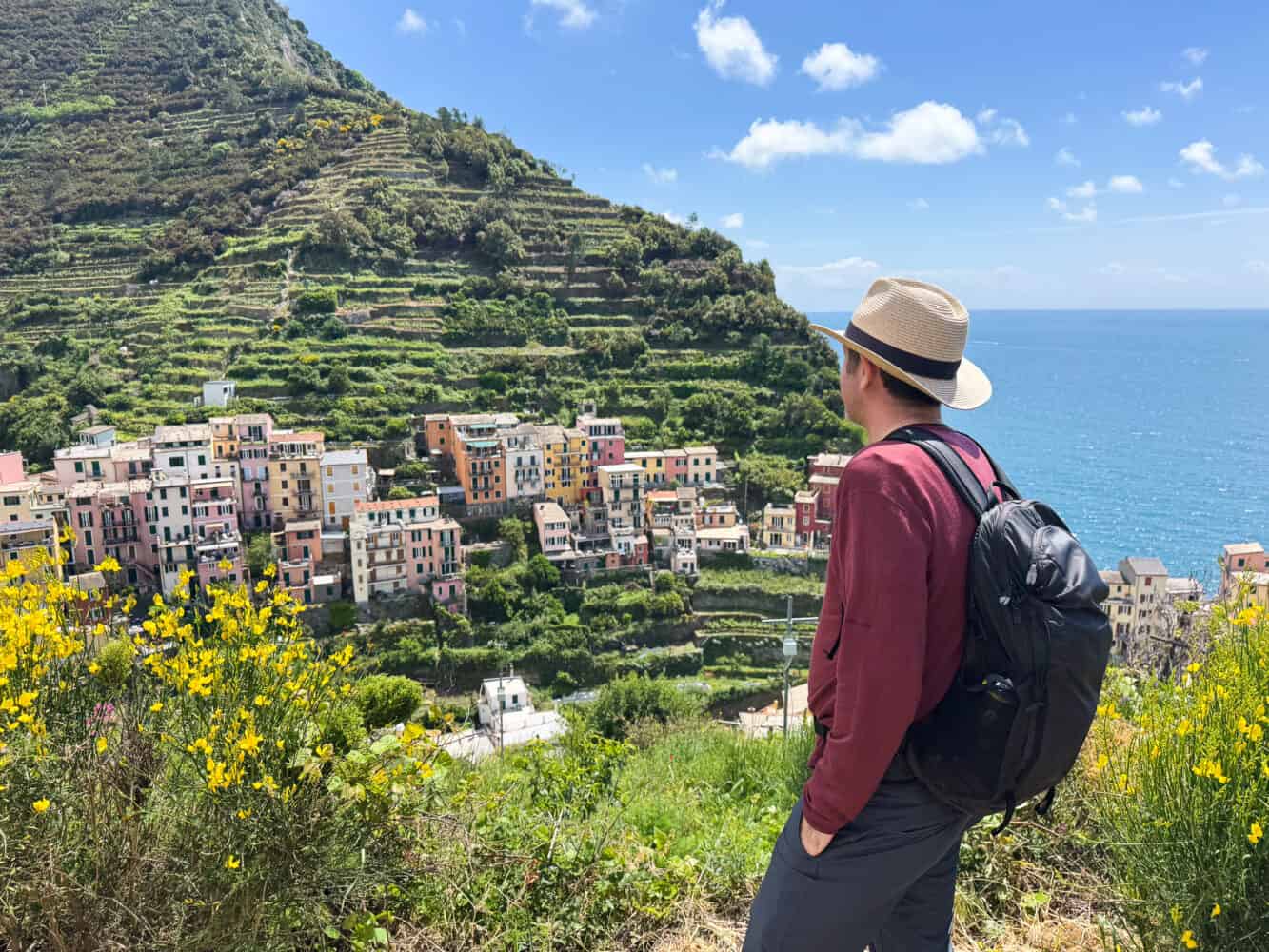
Cinque Terre on the Ligurian coast is one of the most beautiful places in Italy, with five colourful villages perched on a dramatic coastline.
I’ve been visiting since I was a teenager on an Italian exchange trip, but in recent years, this stunning place has become incredibly crowded. Even in early May, on our most recent visit, the crowds made it hard to enjoy.
For us, Cinque Terre is still worth visiting, but we prefer to hike the trails that connect the villages and enjoy the views from above.
We loved the Corniglia to Manarola hike via Volastra that we did on our last trip.
We walked up through forest and along terraced vineyards with magnificent sea views before descending to picturesque Manarola. It’s also free, unlike some other trails in the area.
In this guide, I share all the details of the hike, including how long it takes, how to get there, and other tips for hiking in Cinque Terre.
Contents
- Where is Lake Molveno?
- Best Things to Do in Molveno
- Where We Stayed: Grand Hotel Molveno Review
- Where to Eat in Molveno
- How to Get to Lake Molveno, Italy
- Lake Molveno Map
- Is Lake Molveno Worth Visiting?
- More North Italy Posts
- Where is Camogli, Italy?
- Best Things To Do in Camogli Village
- Best Hikes and Day Trips from Camogli
- Our Favourite Places to Eat in Camogli
- Where to Stay in Camogli
- How to Get to Camogli
- Camogli, Italy Map
- Is Camogli Worth Visiting?
- More Italian Riviera Tips
- Location of Hotel Cenobio dei Dogi, Camogli
- History of the Hotel
- Our Room at Hotel Cenobio dei Dogi
- Swimming Pool
- Private Beach
- Restaurants
- Other Facilities
- Hotel Cenobio dei Dogi Pros and Cons
- Cost of Hotel Cenobio dei Dogi
- Final Thoughts
- More Italian Riviera Posts
- Getting to Camogli
- When is the Camogli Fish Festival?
- Sagra del Pesce Camogli Schedule
- Friday Night: The Festival Begins
- Saturday: Bonfires and Fireworks
- Sunday Fish Fry
- Is the Camogli Fish Festival Worth Visiting?
- More Liguria Posts
- Hiking The Blue Trail in Cinque Terre
- Corniglia to Manarola via Volastra Hike Details
- Getting to Corniglia: The Start of the Hike
- Corniglia to Volastra Trail
- Volastra
- Volastra to Manarola Trail
- Corniglia to Manarola Hike Map
- Final Thoughts
- More Liguria Posts
Hiking The Blue Trail in Cinque Terre
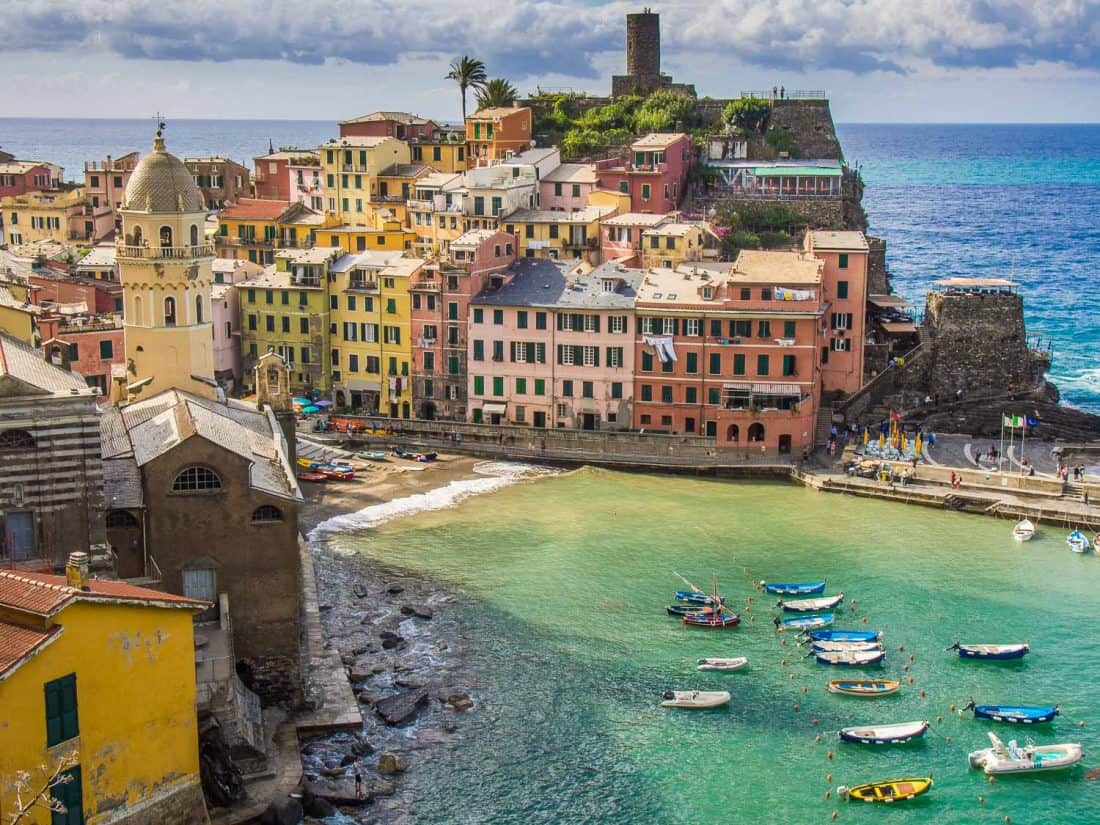
The most famous trail in the Cinque Terre is the Blue Trail (Sentiero Azzurro) that used to connect all five villages from Monterosso to Riomaggiore and took a full day.
You can easily hike just a section of the trail by using the trains (or ferries) that connect the villages.
Landslides caused sections of the trail to be closed for many years, but as of 2025, all sections are open except for the Corniglia to Manarola hike. This was an easy 2.2km (1.4 miles) along the coast, and it seems to be closed indefinitely.
You can still walk between the villages, but it’s a much longer, steeper trail up into the hills via Volastra. It’s the hike I describe below.
See this Cinque Terre hiking trail update for the current conditions of the trails.
Other sections of the Blue Trail are also beautiful. We’ve hiked the 7km (4.3 mile) trail from Corniglia – Vernazza- Monterosso before (I wrote about it in our Italian Riviera guide), but it’s busier than the other direction from Corniglia – Volastra – Manarola.
You also need to purchase a Cinque Terre Trekking Card to walk Corniglia – Vernazza – Monterosso. This costs €7.50-€15, depending on the date (no charge from November to February).
You can buy a more expensive card that includes unlimited train travel on the La Spezia – Cinque Terre – Levanto line. This saves you money if you plan to take three or more train journeys.
In addition, on certain peak dates, you are only allowed to start in Monterosso and walk towards Vernazza (not vice versa) between 9am and 2pm.
Luckily, you don’t need to pay for the Corniglia to Manarola hike described below. Technically, it’s not the Blue Trail (despite what Alltrails says), although it has functionally worked as part of it for anyone wanting to walk between all five villages.
Corniglia to Manarola via Volastra Hike Details
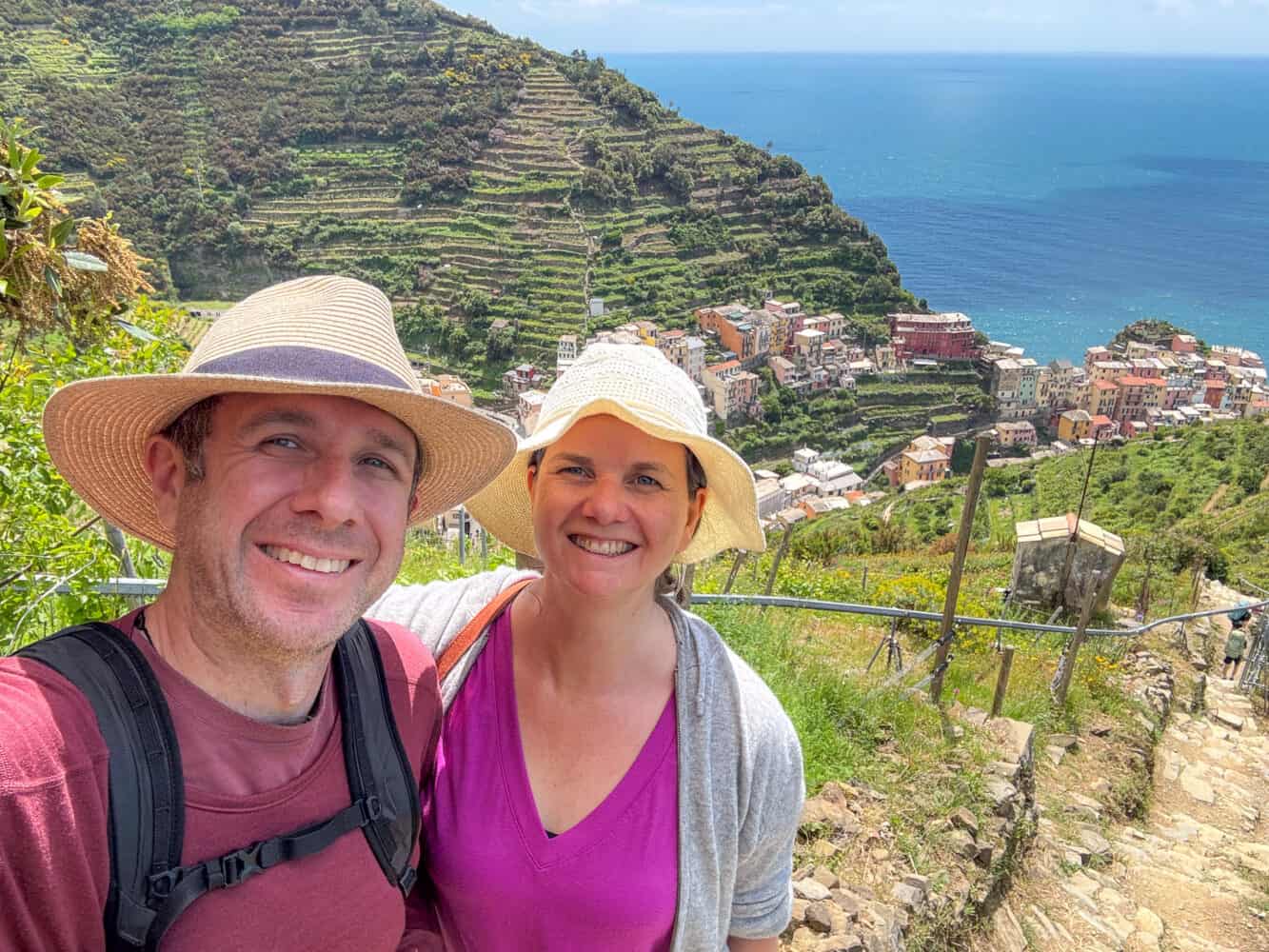
- Location: Cinque Terre in Liguria, Italy – 112km (70 miles) from Pisa Airport
- Length: 6.65km (4.1 miles) one way from Corniglia Station to Manarola
- Time: 2.5 hours (3 hours including breaks)
- Elevation Gain: 376 metres (1234 feet)
- Difficulty Rating: Intermediate
- Terrain: Stone stairs and rocky, narrow dirt paths
- Highlights: Coastal views, terraced vineyards, pretty villages
- AllTrails Page: Corniglia – Manarola via Volastra
The stats above are taken from my Apple Watch, starting at Corniglia Station rather than the trailhead.
You can also hike it in the other direction from Manarola to Corniglia, but the trail out of Manarola was very steep, and I’m glad we did it this way for a slightly easier ascent. The views of Manarola when we descended were also lovely.
Another option if you want to avoid going up big hills entirely is to get the bus from Manarola to Volastra then hike from there to Corniglia (you’ll still have a steep descent). I recommend the full hike if you are able.
Walking in the spring or autumn is best to avoid the summer heat. In early May, it was 17ºC (63ºF) and sunny—perfect hiking weather. We also found September a good time.
Hiking shoes, or at least running shoes with good traction, are recommended for the trail.
If you are looking for a quieter hike on the Italian Riviera, we also love the walk from Camogli to San Fruttuoso.
Getting to Corniglia: The Start of the Hike
The easiest way to get around the Cinque Terre is by train. It takes just five minutes and costs €5 between each village on the regional trains.
We were staying in the nearby city of La Spezia (at this lovely Airbnb). The train to Corniglia took 15 minutes.
The train stations in the area are very busy with long queues to buy tickets from the machines or counters.
We used the Trenitalia app to buy tickets instead. Note that you have to buy more than five minutes before departure. We didn’t have signal at Manarola station so buy in advance.
I highly recommend getting an early start on this hike (ideally 7-8am). We weren’t able to and arrived in Corniglia at 10.30am. The hike was busier than we would have liked. An early start is even more important on hot days.
Corniglia is the middle village of the five. It’s also the smallest and the highest at 100 metres above the sea.
Unfortunately, this means there’s a steep walk up 382 stairs (called Scalinata Lardarina) that zigzag up the hillside from Corniglia station to the village. You can also take a bus, but there are long queues.
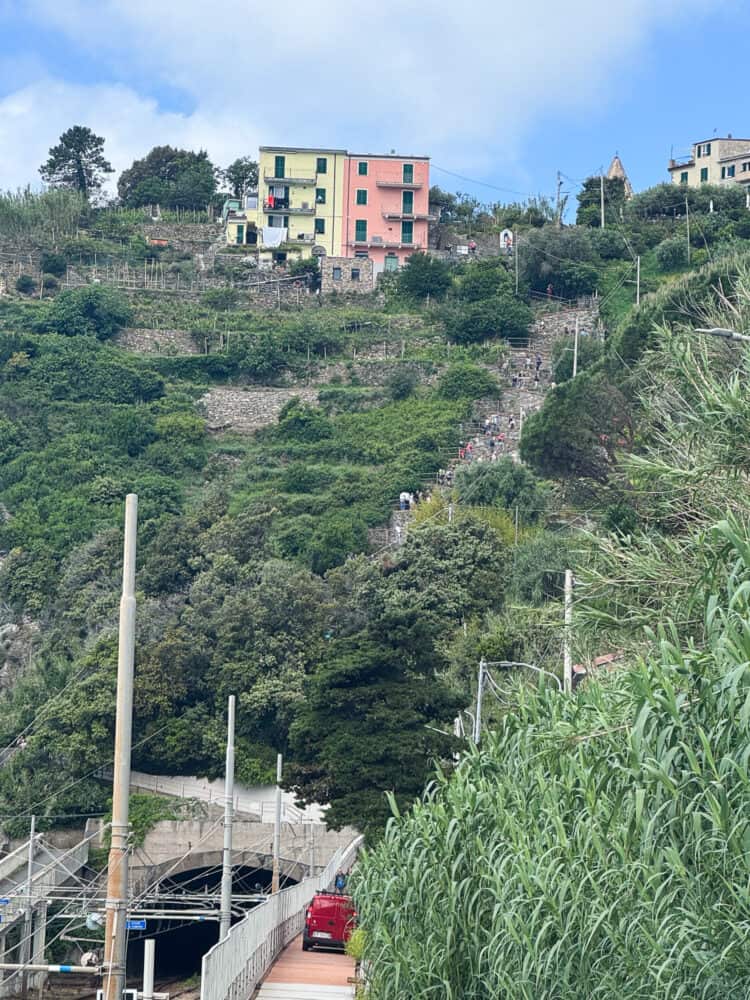
The walk up took us 15 minutes. At the top, we walked a little past the trailhead to A’Caneva Bar for a quick espresso and to use their toilet.
There are also public toilets (bagni pubblici) in the village, but they cost €1 and don’t have great reviews. This is your last chance to use a bathroom until Volastra.
If you haven’t visited Corniglia before, it’s the quietest village and worth having a look around.
We were keen to get going, so we headed two minutes back to the trailhead, which is marked Sentiero 7A Corniglia-Volastra-Manarola on Google Maps.
We used AllTrails for directions (we have a Plus membership, so we can download hiking routes offline), but the trail is fairly well marked with signposts and red and white stripes.
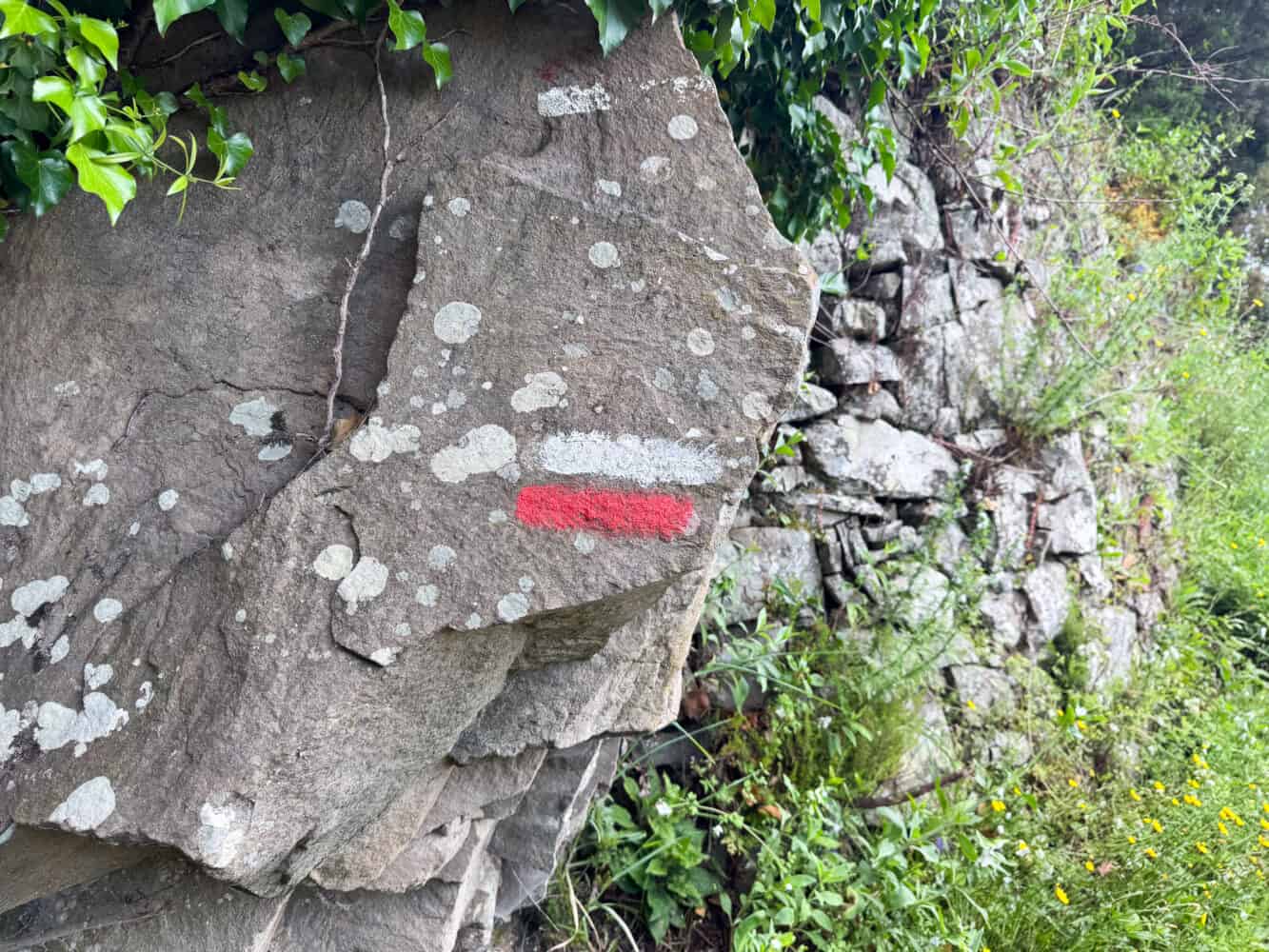
Corniglia to Volastra Trail
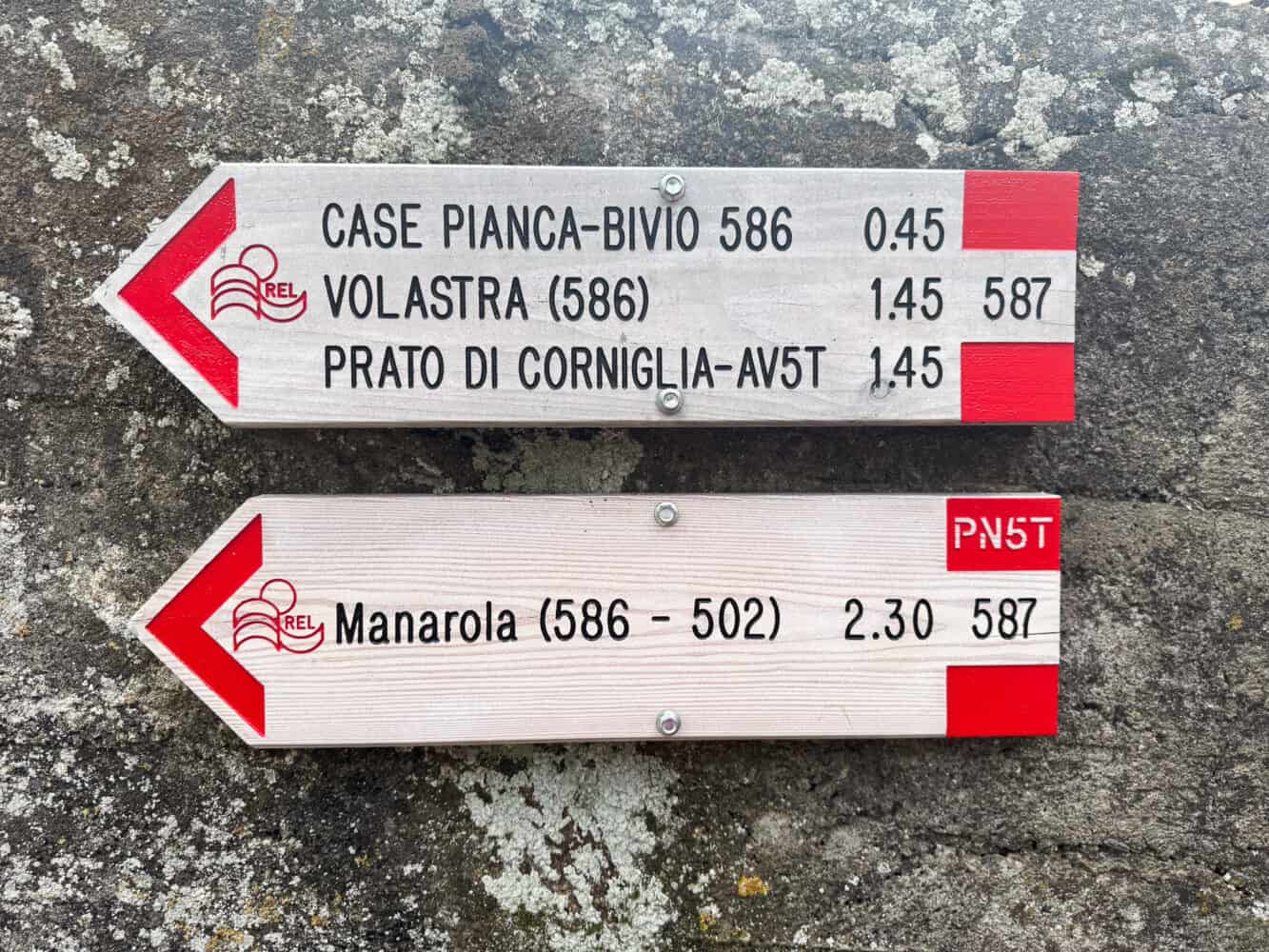
There’s a sign at the trailhead estimating that Volastra is 1 hour and 45 minutes away and Manarola is 2 hours and 30 minutes.
There’s also a water fountain here, but it’s best to come with a filled water bottle.
The beginning of the Corniglia to Manarola hiking trail is the hardest part. You have to climb up stone steps for some time (it was about 40 minutes before it started to level off).
While it’s not as steep as the ascent from Manarola, it will still get your heart rate up. We took a short break every 10 minutes and found it manageable.
This part of the trail is mostly through trees with the occasional view back to Corniglia village and the sea.
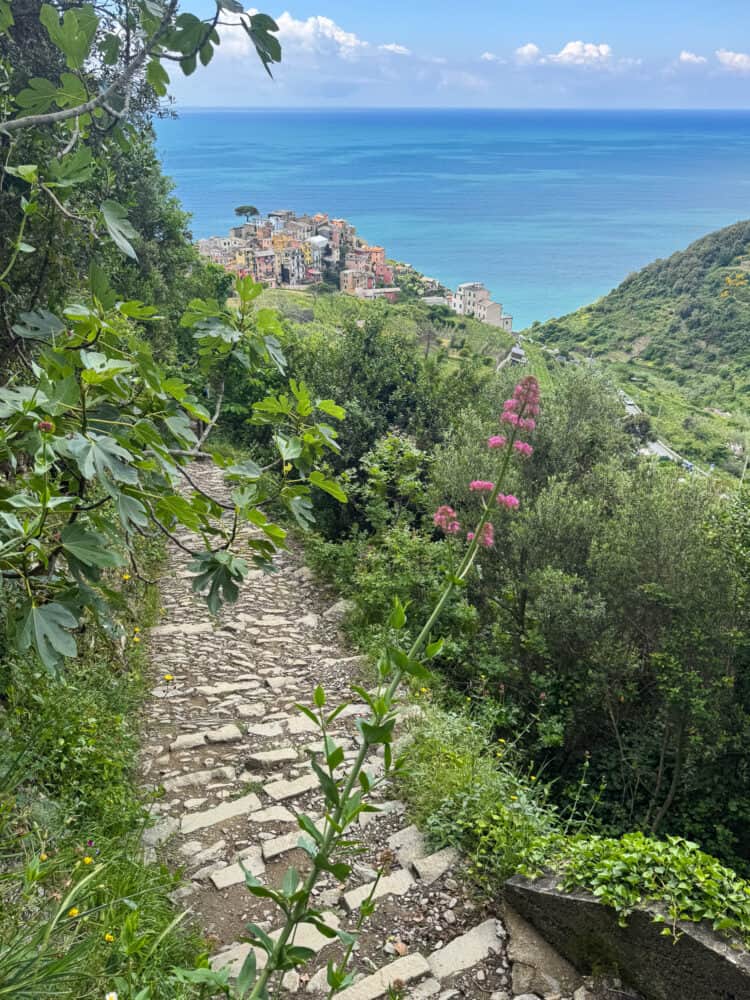
The highest point of the hike is about 400 metres (1312 feet) above sea level. There’s no obvious summit (the mountains go on above you), but the views get better, and you can gaze at Corniglia far down below.
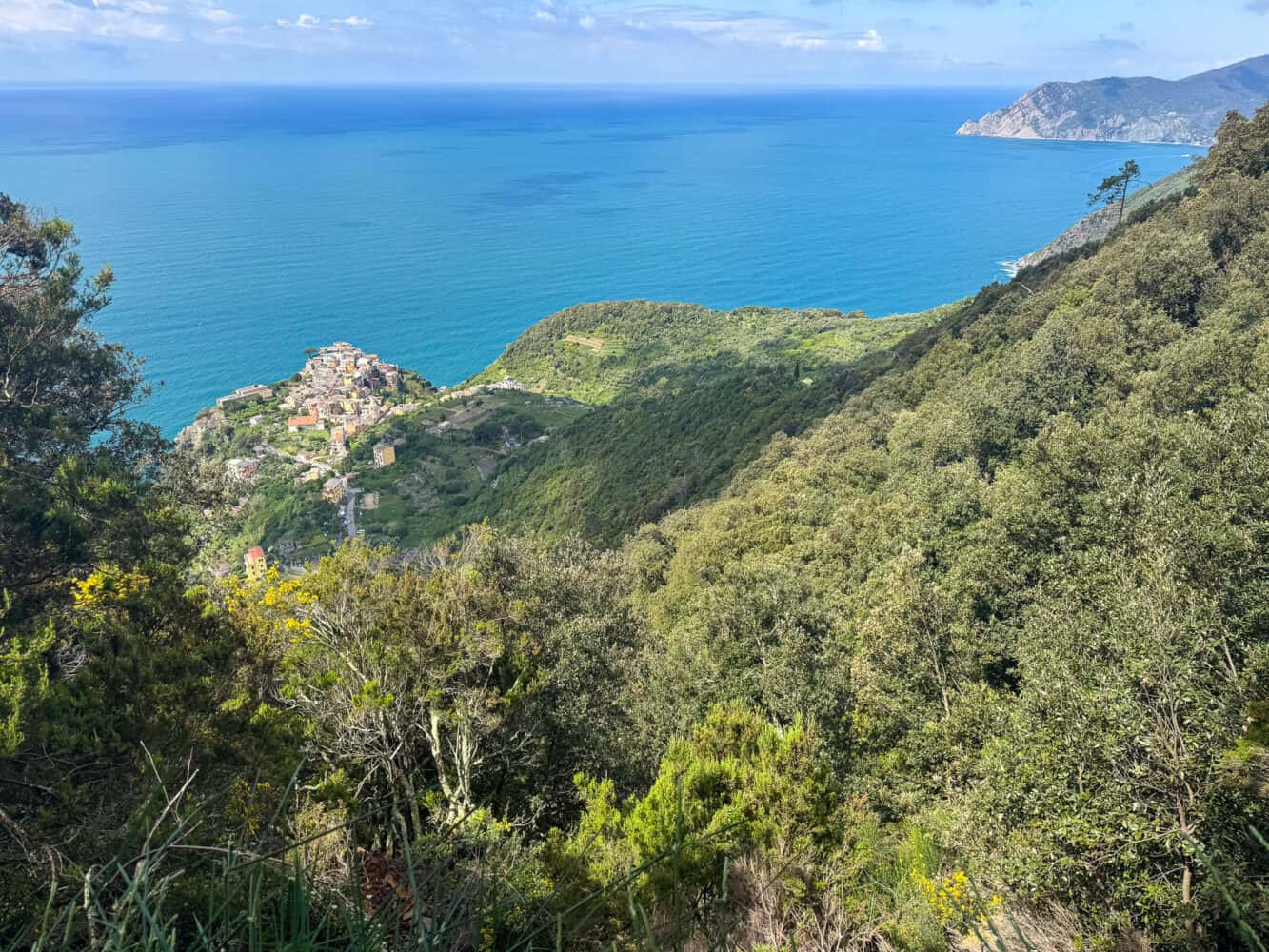
From here, the trail levels out with just gradual ups and downs. It’s much easier, although the path is still narrow and uneven in parts.
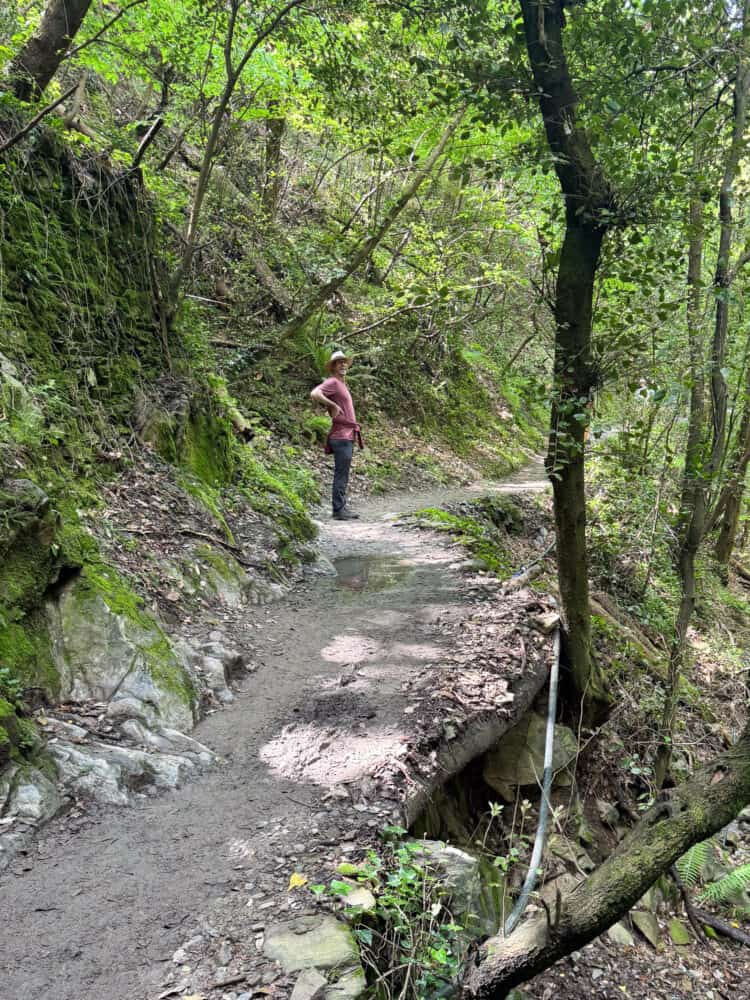
At first, you walk through the forest with just occasional glimpses of the sea, but about an hour into the hike, the trail opens up and the views are stunning!
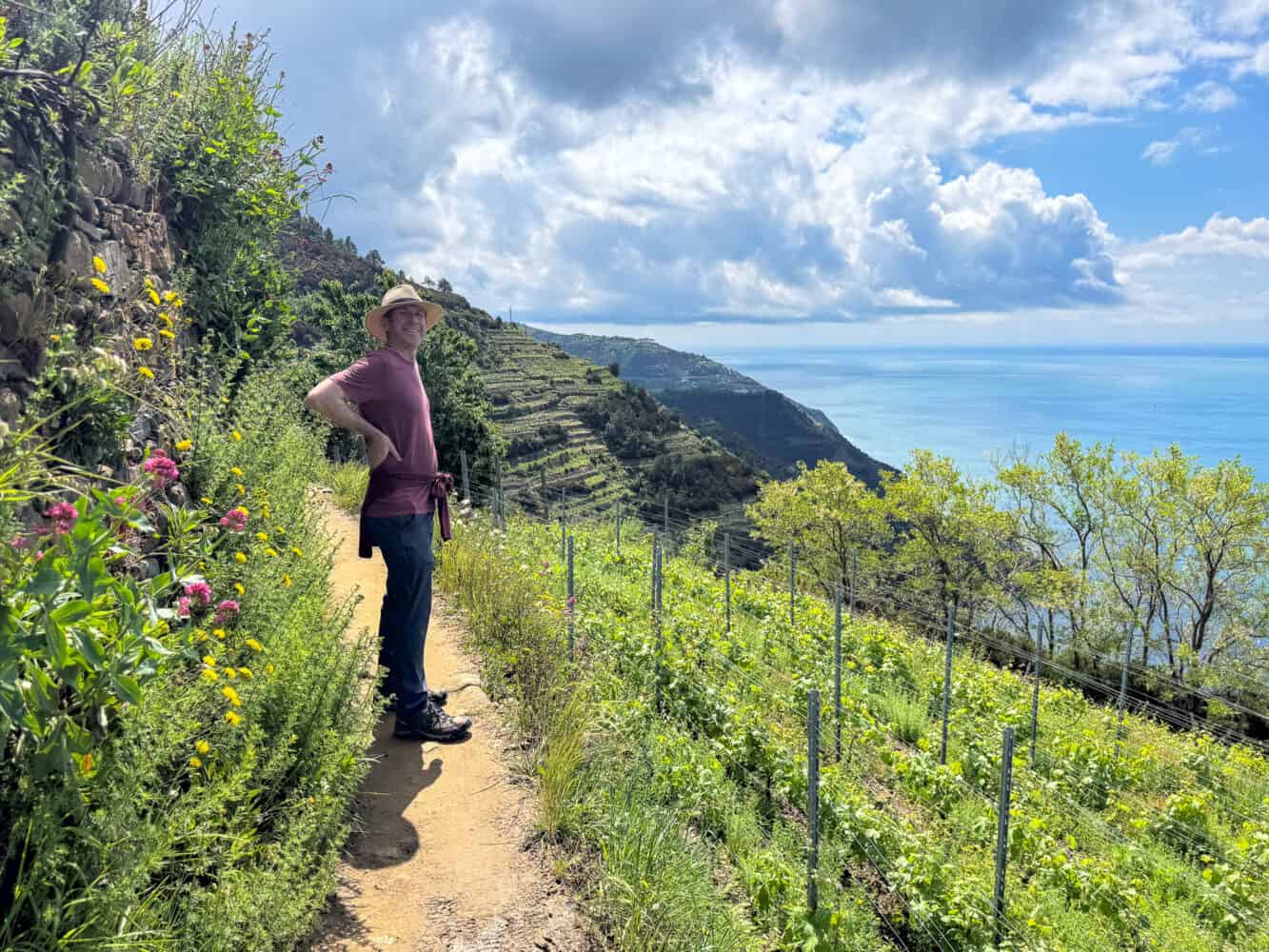
This is the highlight of the hike as you walk along a ridge amongst terraced vineyards with the sea stretching expansively below.
Eventually, Manarola pops into view—still a long way down.
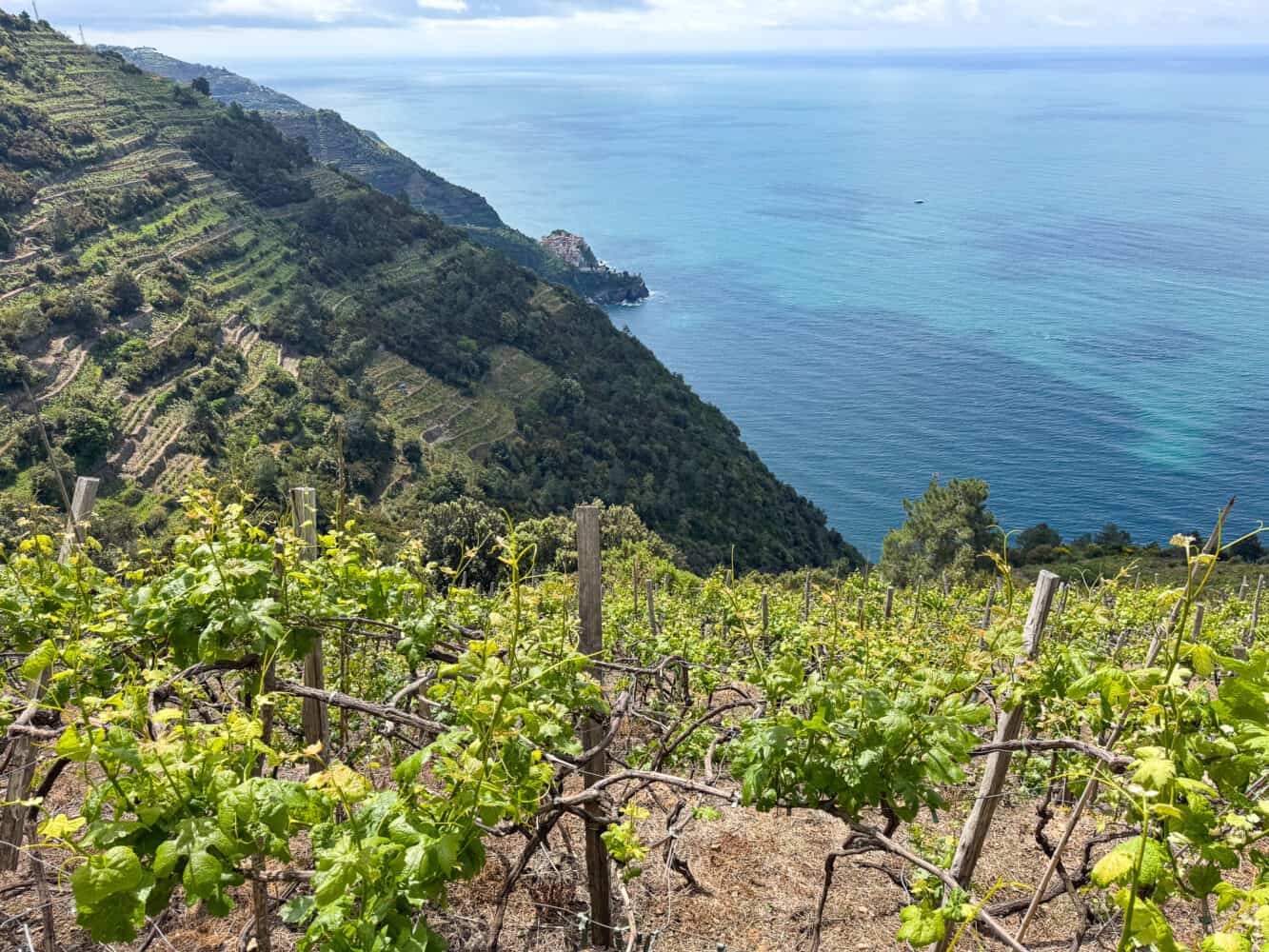
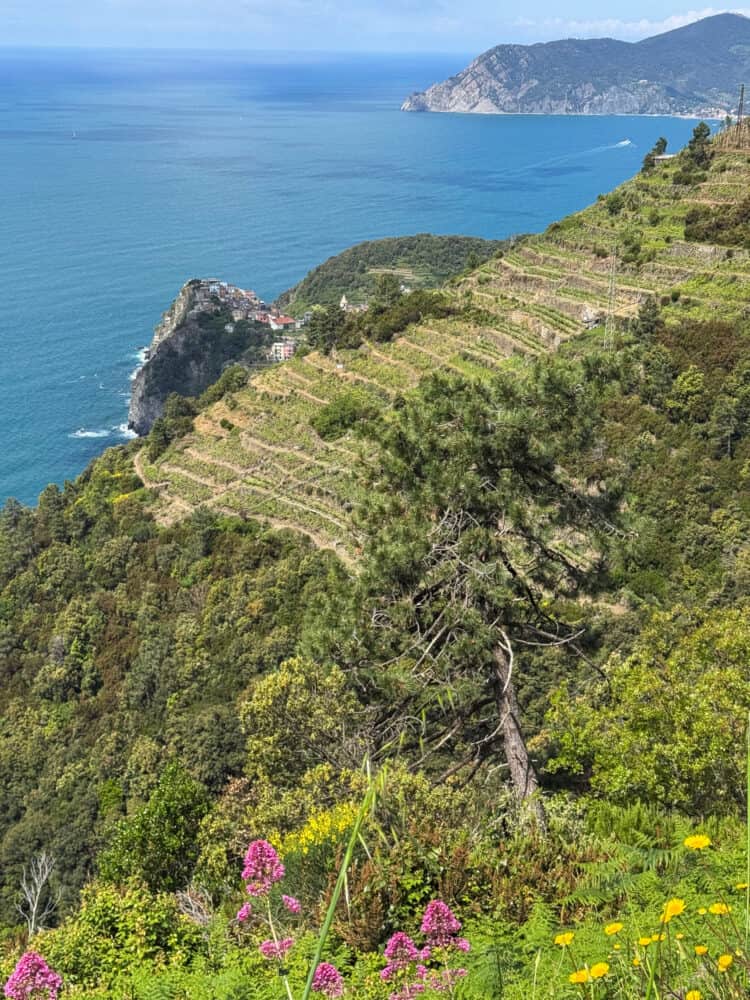
By now, it was around midday, and after walking most of the way up alone, the trail became uncomfortably busy at some points. We had to wait for a few tour groups to pass, as the trail is so narrow, it’s single file only sometimes.
If you are afraid of heights, you might find the narrow trail and steep drop-offs a little disconcerting.
Otherwise, it’s an easy and glorious section of the trail.
Volastra
Even better, just before Volastra, we discovered a little rustic bar amongst the vines—Cantina Capellini – Agrivino.
We couldn’t resist stopping for a glass of delicious Cinque Terre DOP white wine.
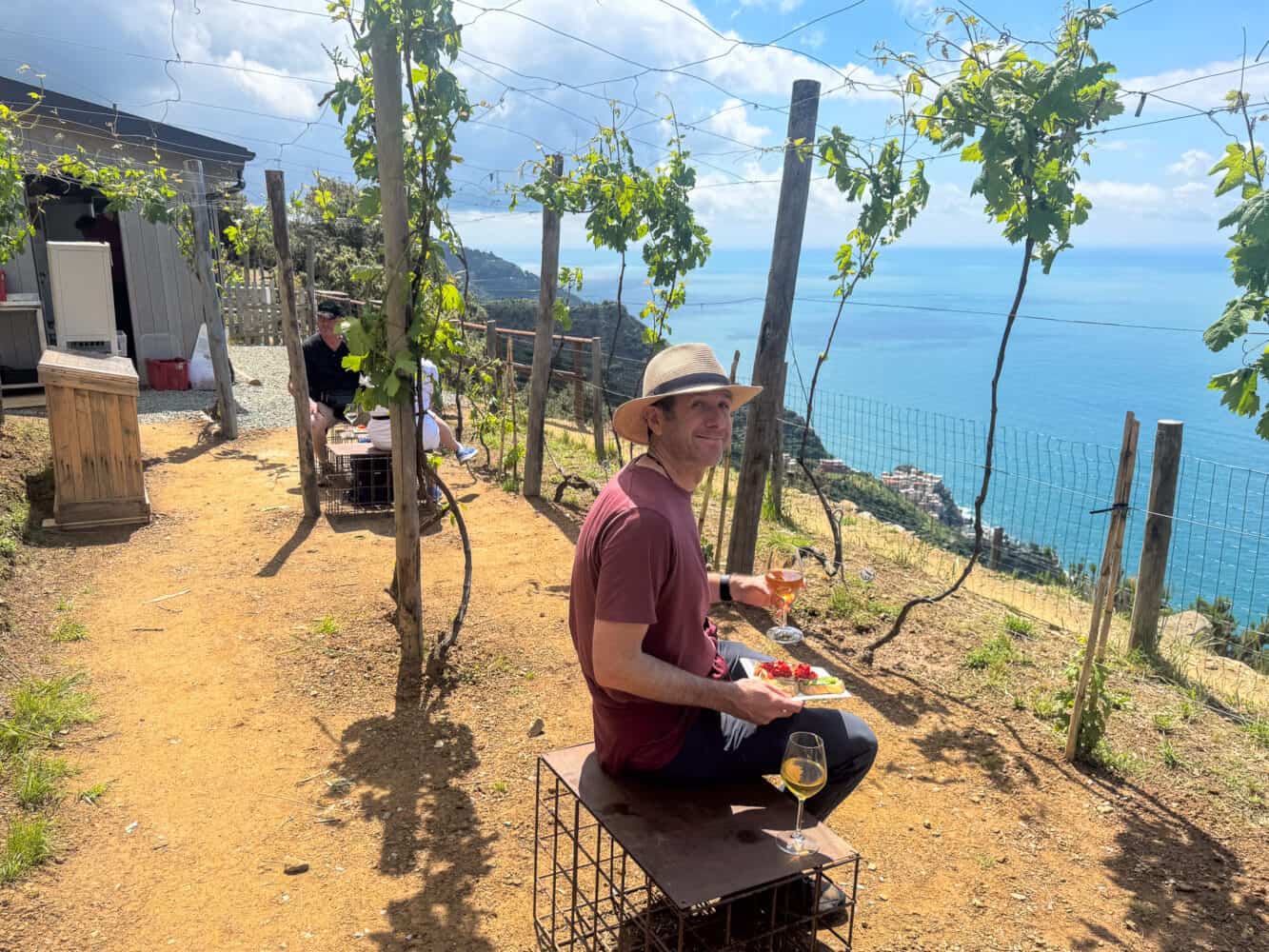
We also got the mixed bruschetta (we asked for a vegetarian version without anchovies). The toppings were nice, but weirdly, the bread wasn’t toasted (presumably, facilities are limited up here).
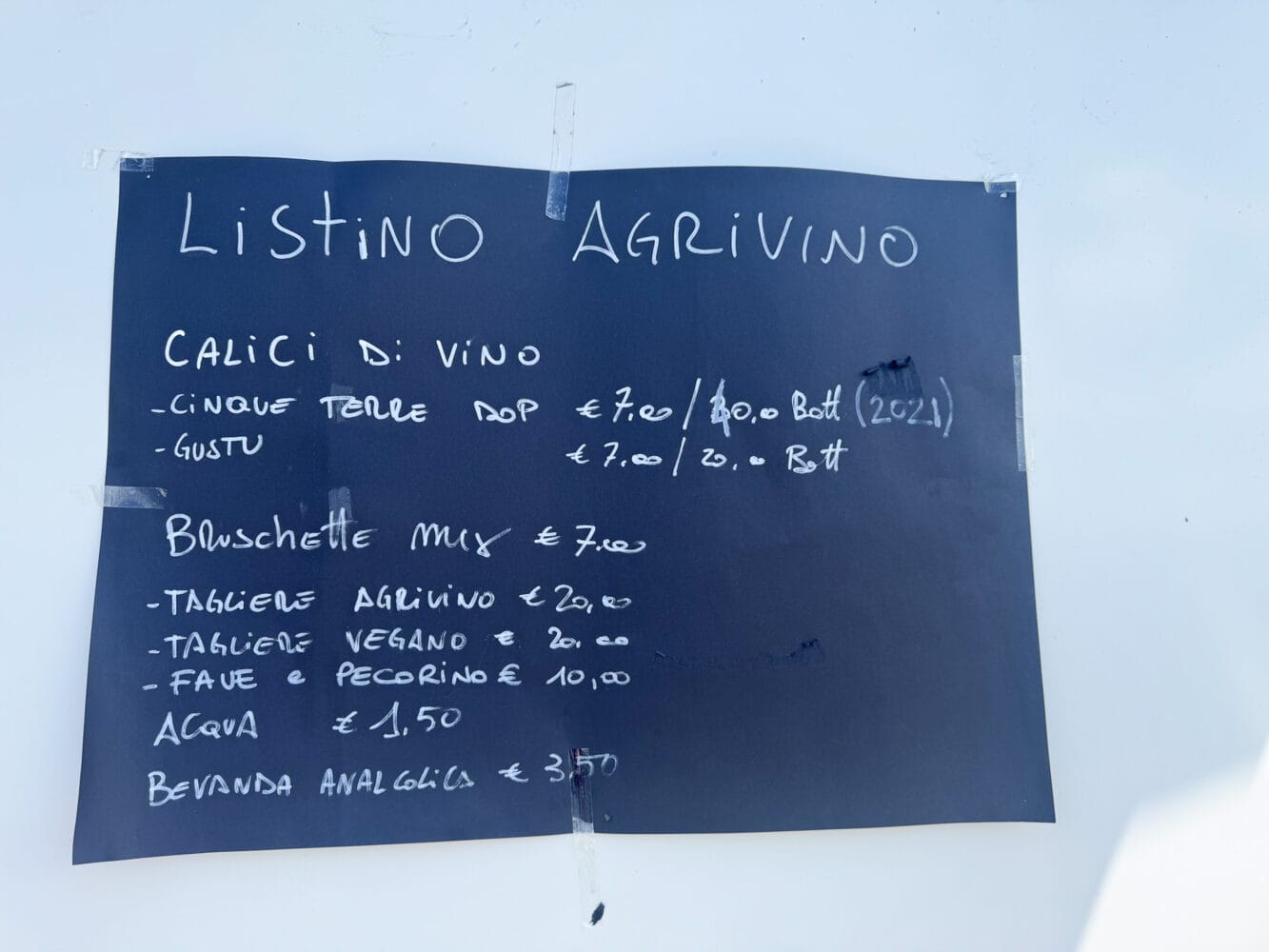
About five minutes further on, we descended to Volastra (at 335 metres) and entered the village by its tiny church.
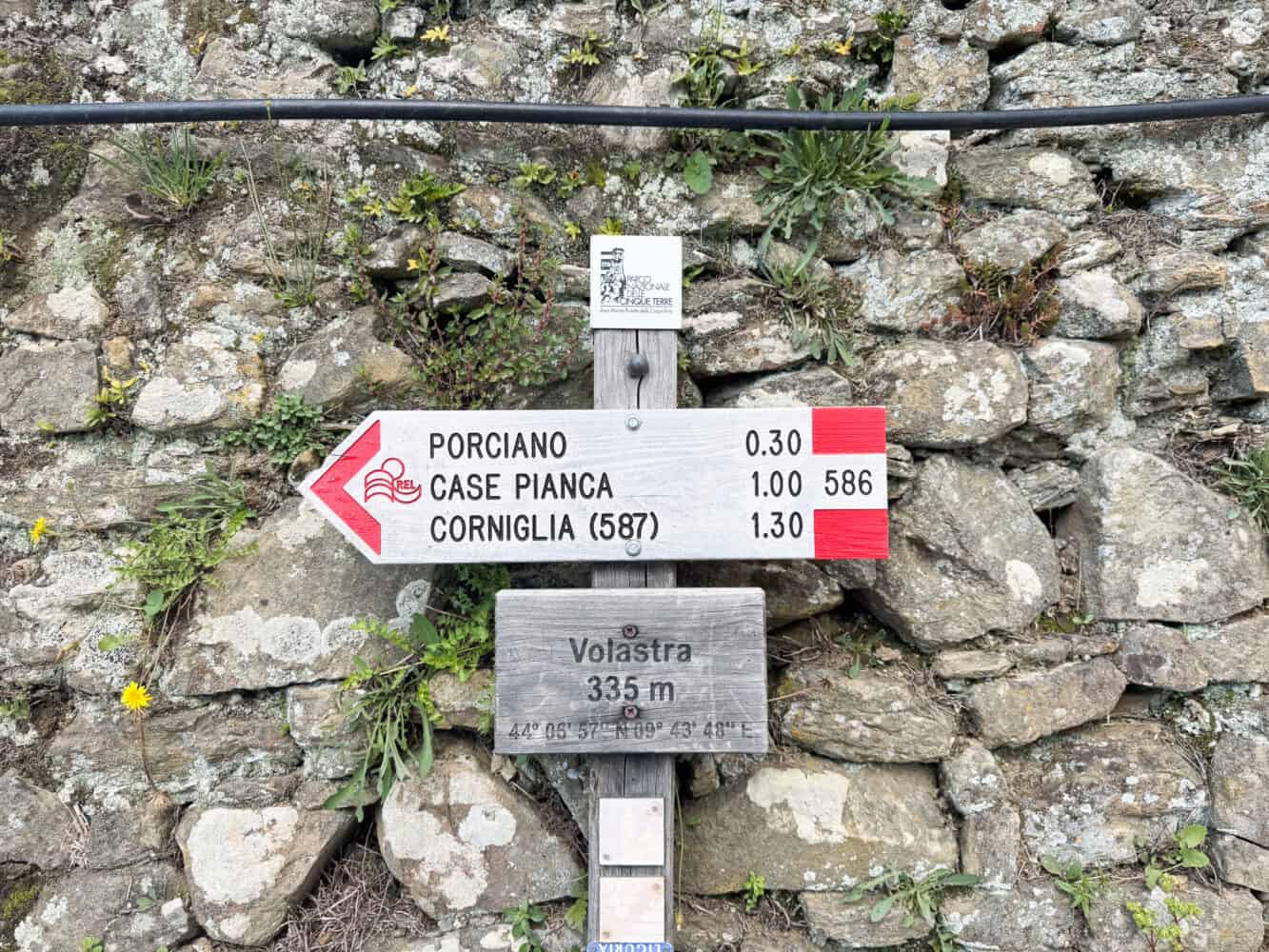
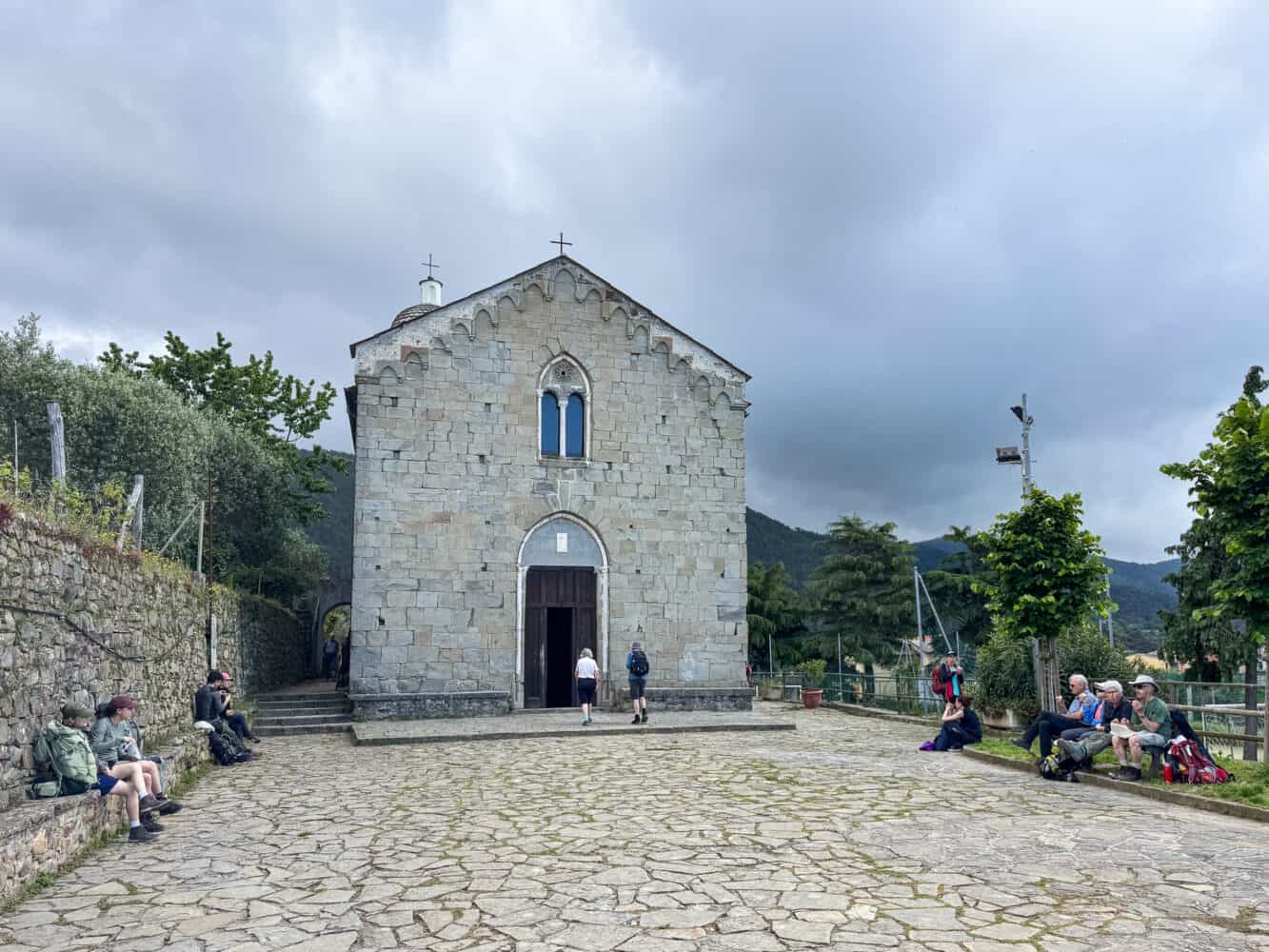
It took us about 1 hour and 40 minutes from the trailhead to Volastra (two hours from Corniglia Station), including our 20-minute wine break.
Volastra is a tiny village, but there are a few places to stop for food and drinks. As we’d had our impromptu wine stop, we just grabbed a coffee at Chiosco del Sole and used their toilet (awkwardly located behind the counter).
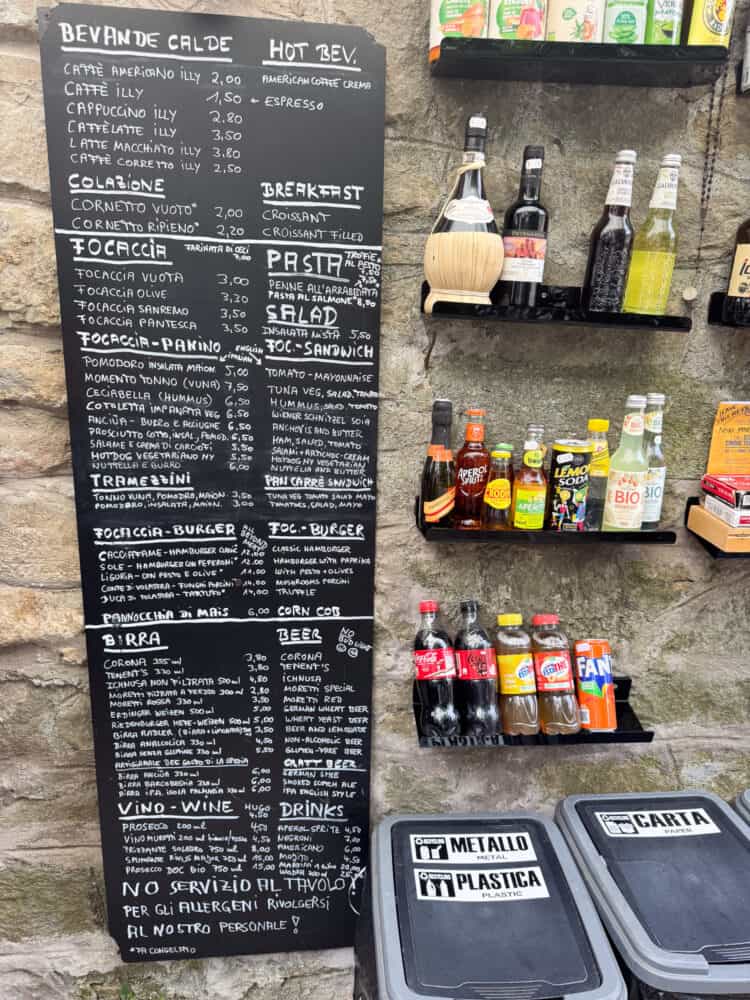
It’s a cute little place with garden seating and a snack menu of sandwiches and burgers (with vegan options). They did seem to have run out of a lot of menu items, though. Order at the counter before taking a seat.
In May, their hours were 11am – 6pm every day (closed in bad weather).
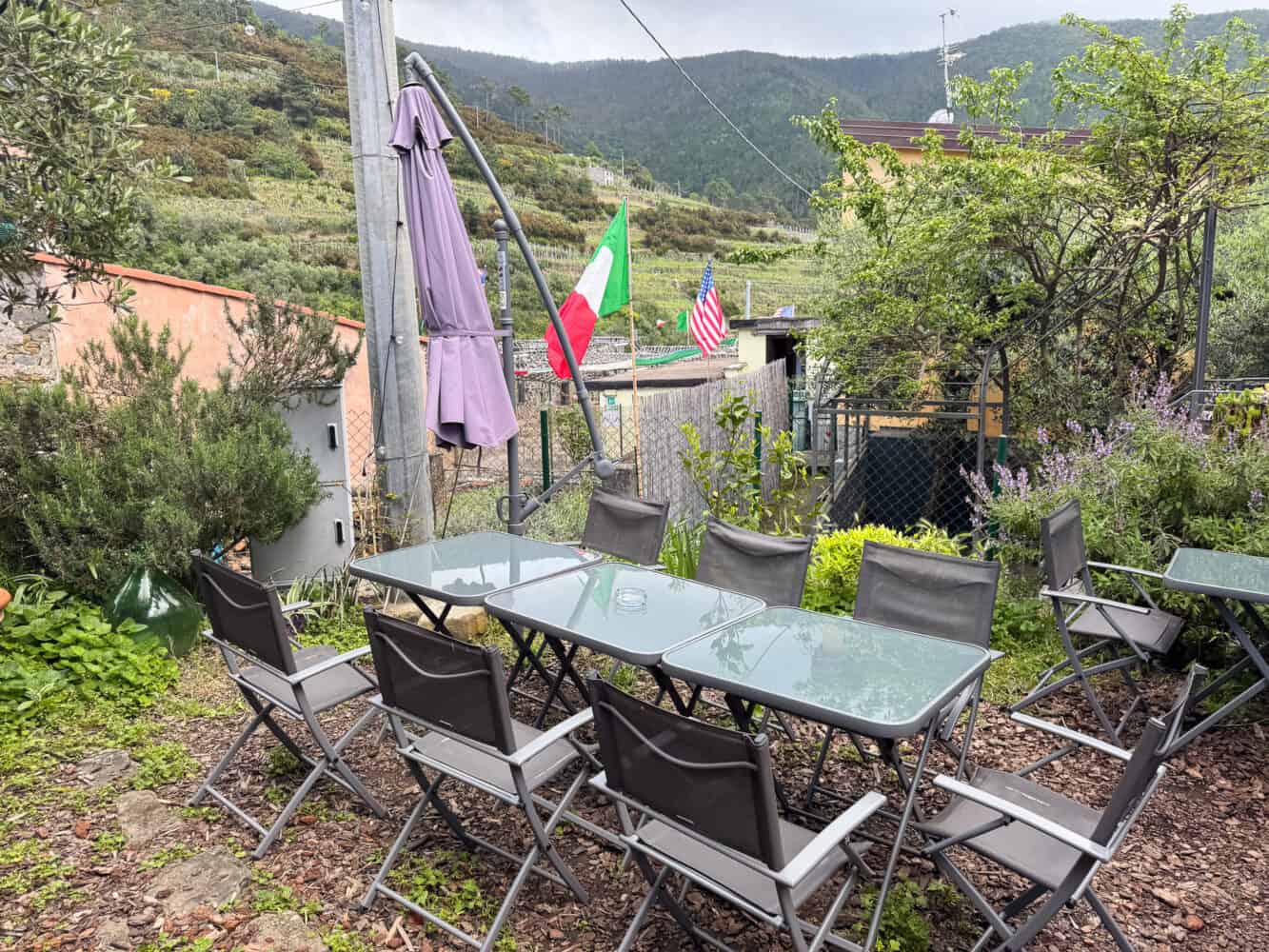
Other options in Volastra are the Minimarket La Bottega (a shop advertising focaccia and sandwiches) and Arcobaleno, a bar-restaurant with sandwiches and gelato or for a more substantial meal, pasta and fish.
There’s no public toilet, so you’ll need to buy something at one of the bars.
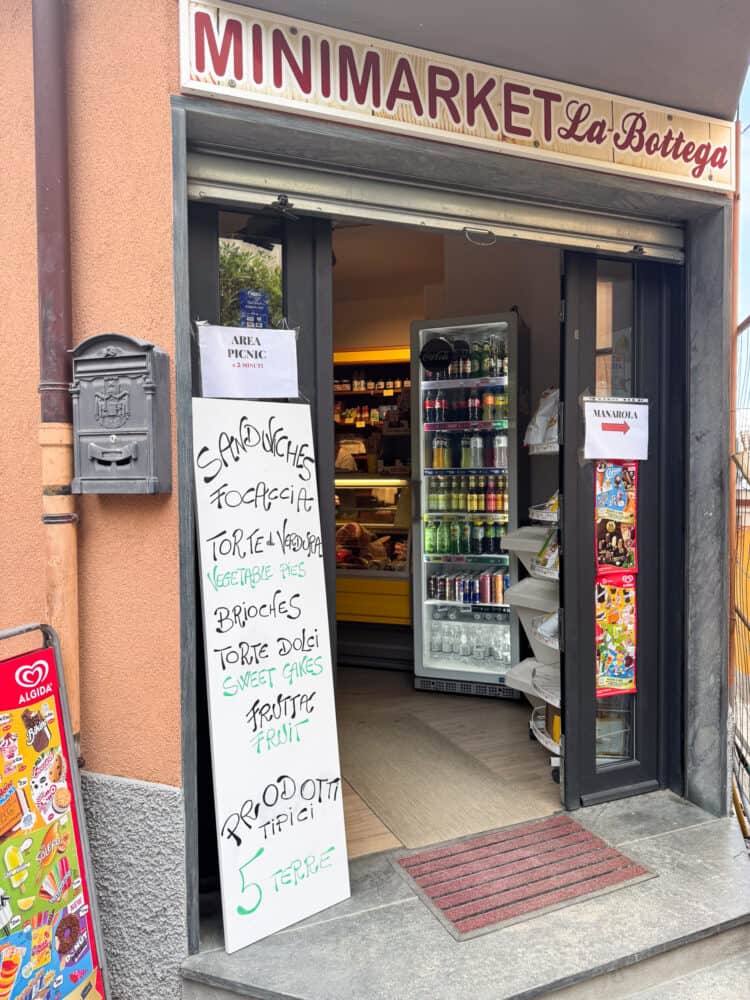
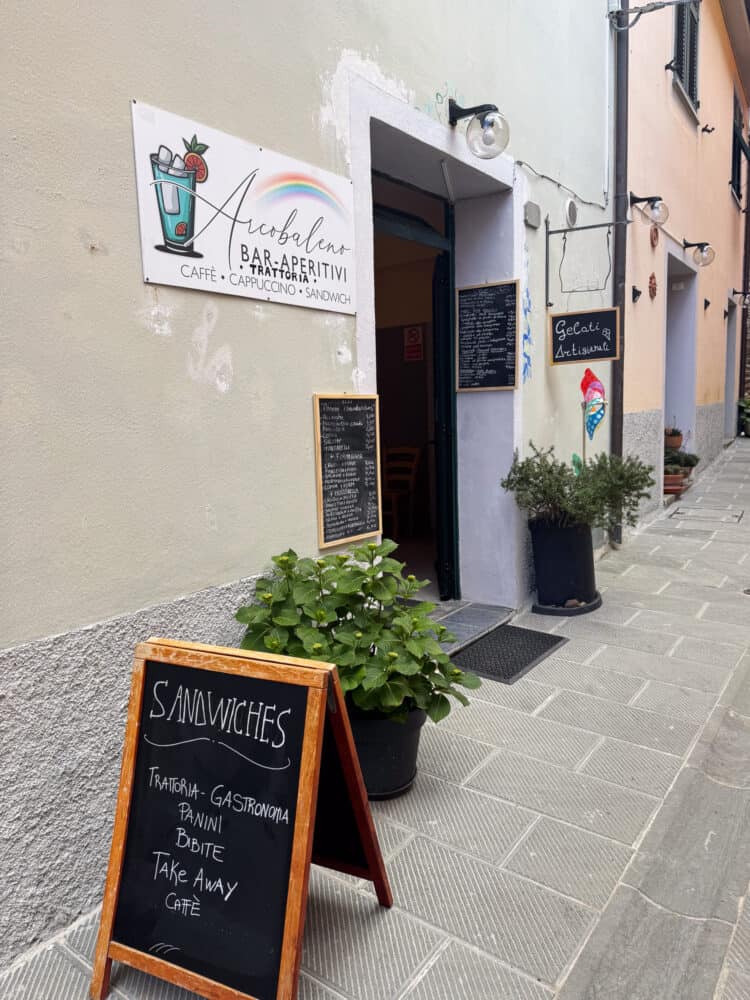
There’s a water fountain in the village to refill your bottle.
Volastra to Manarola Trail
To find the trail from Volastra to Manarola, look for the Manarola sign down an alley off Via Montello between La Bottega and Arcobaleno.
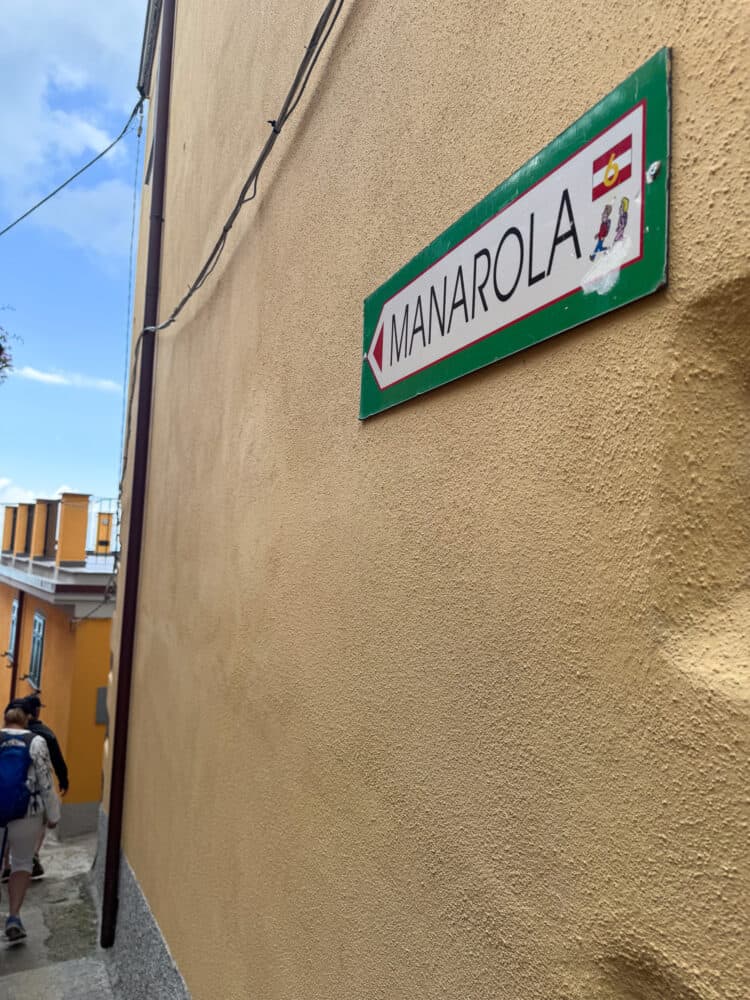
From here, it’s downhill on stone stairs that really work your legs.
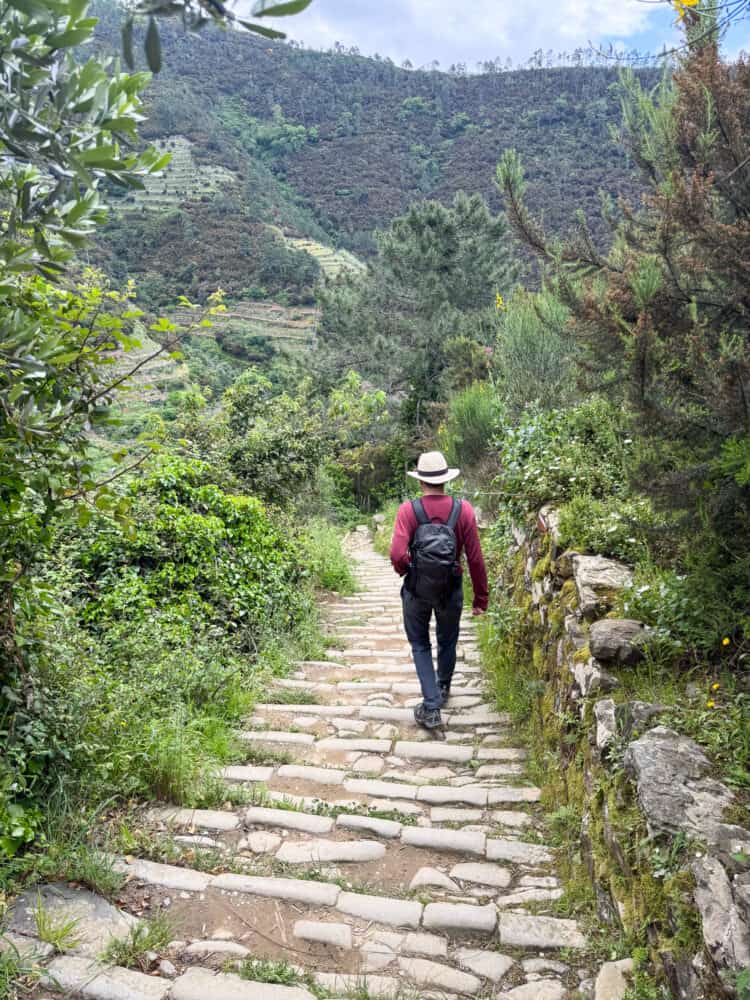
After about 10 minutes, you come across a road—don’t head that far, but go right to continue on the trail, leaving the road behind.
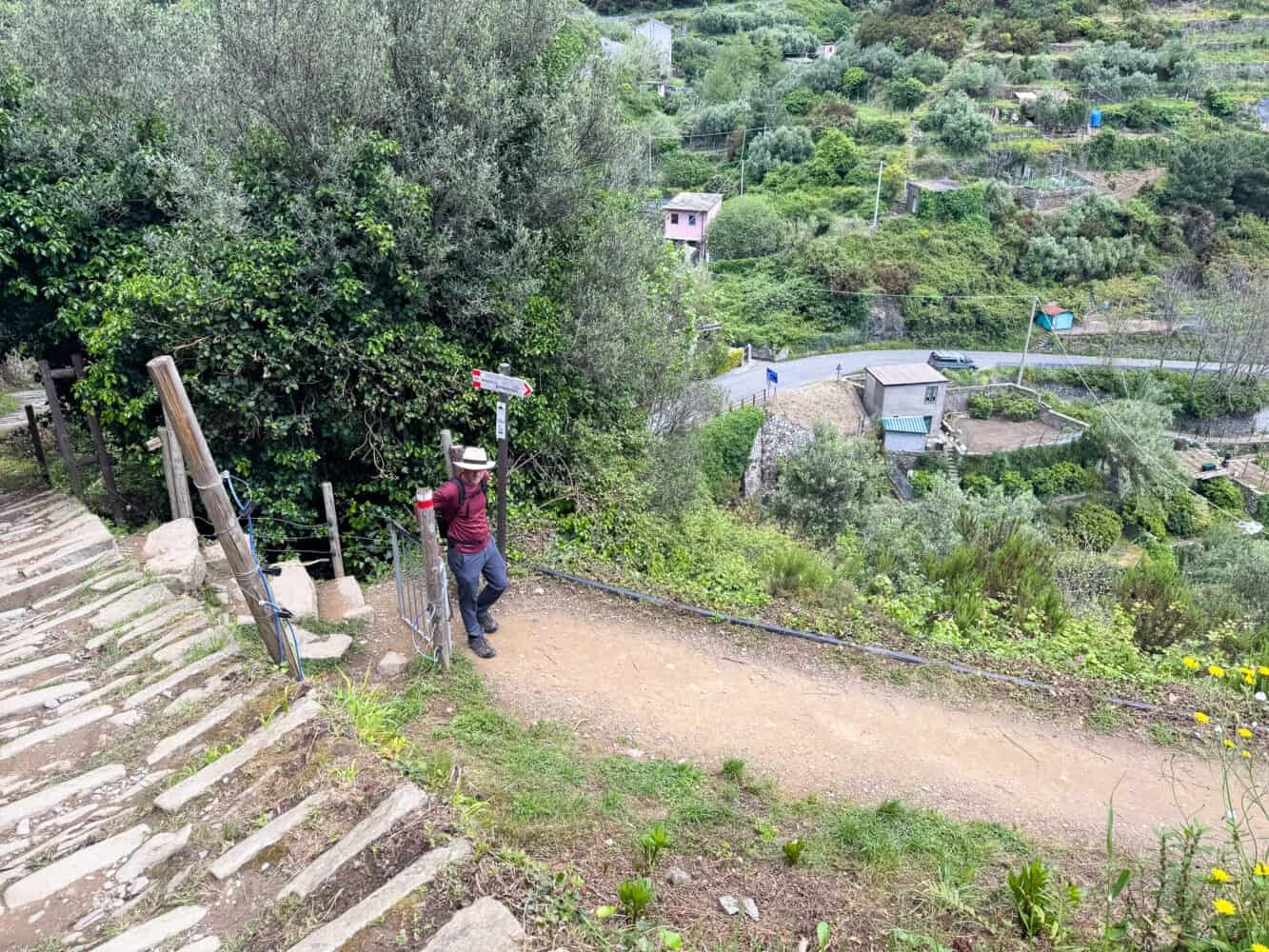
Thankfully, the dirt path from here is a bit flatter.
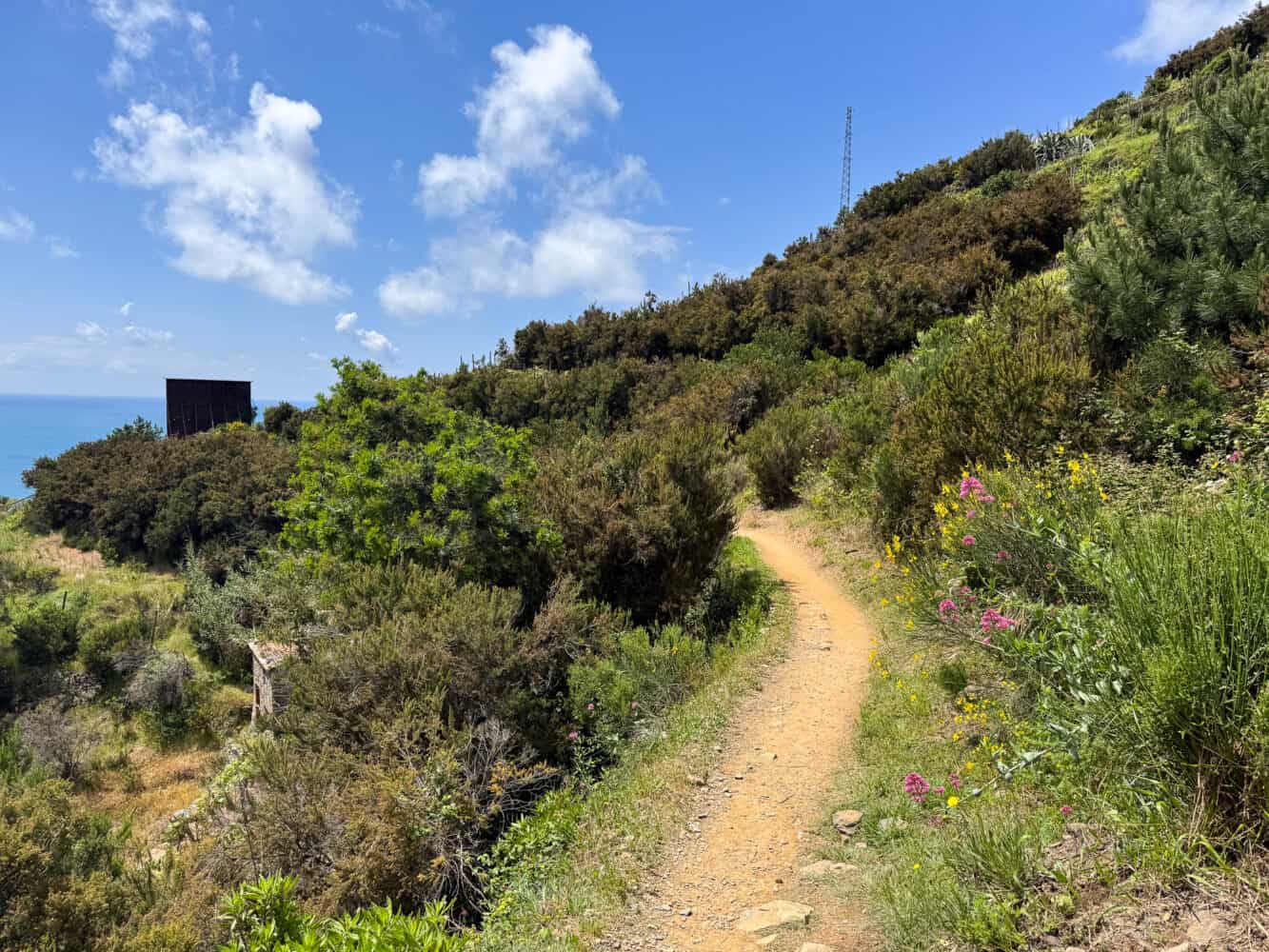
A highlight for us was seeing one of the little vineyard trains come past. They are used by farmers to transport tools and harvested olives and grapes up and down the steep terraces.
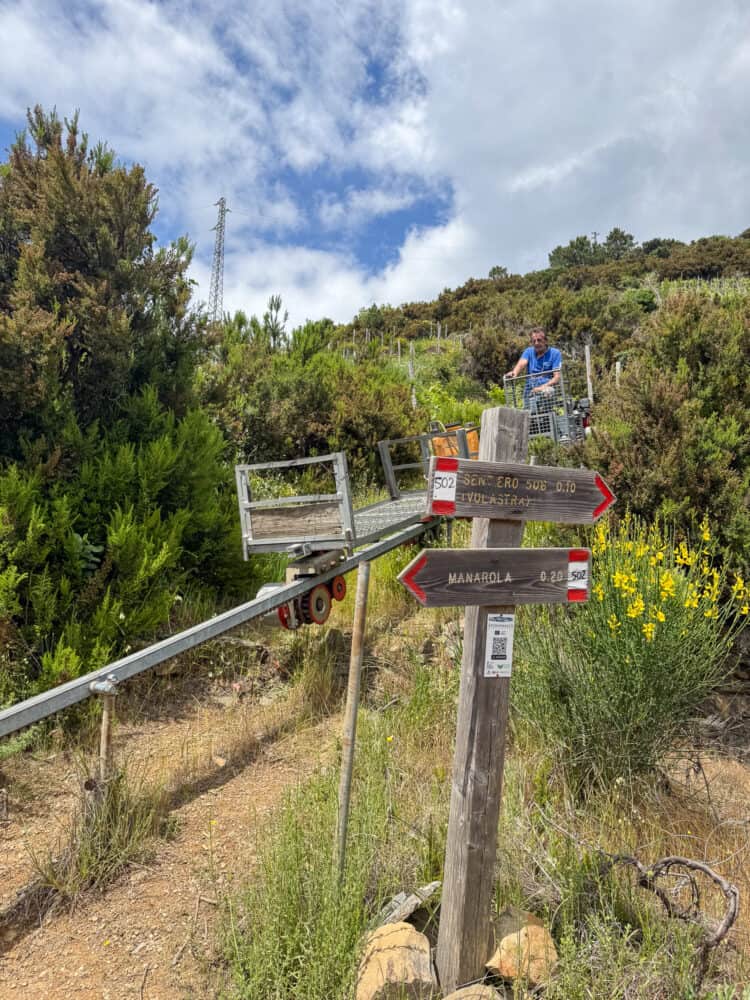
The closer we got to Manarola, the better the views got. Wildflowers, vineyard terraces, that vibrant blue sea, and the pastel-coloured village from above—wow!
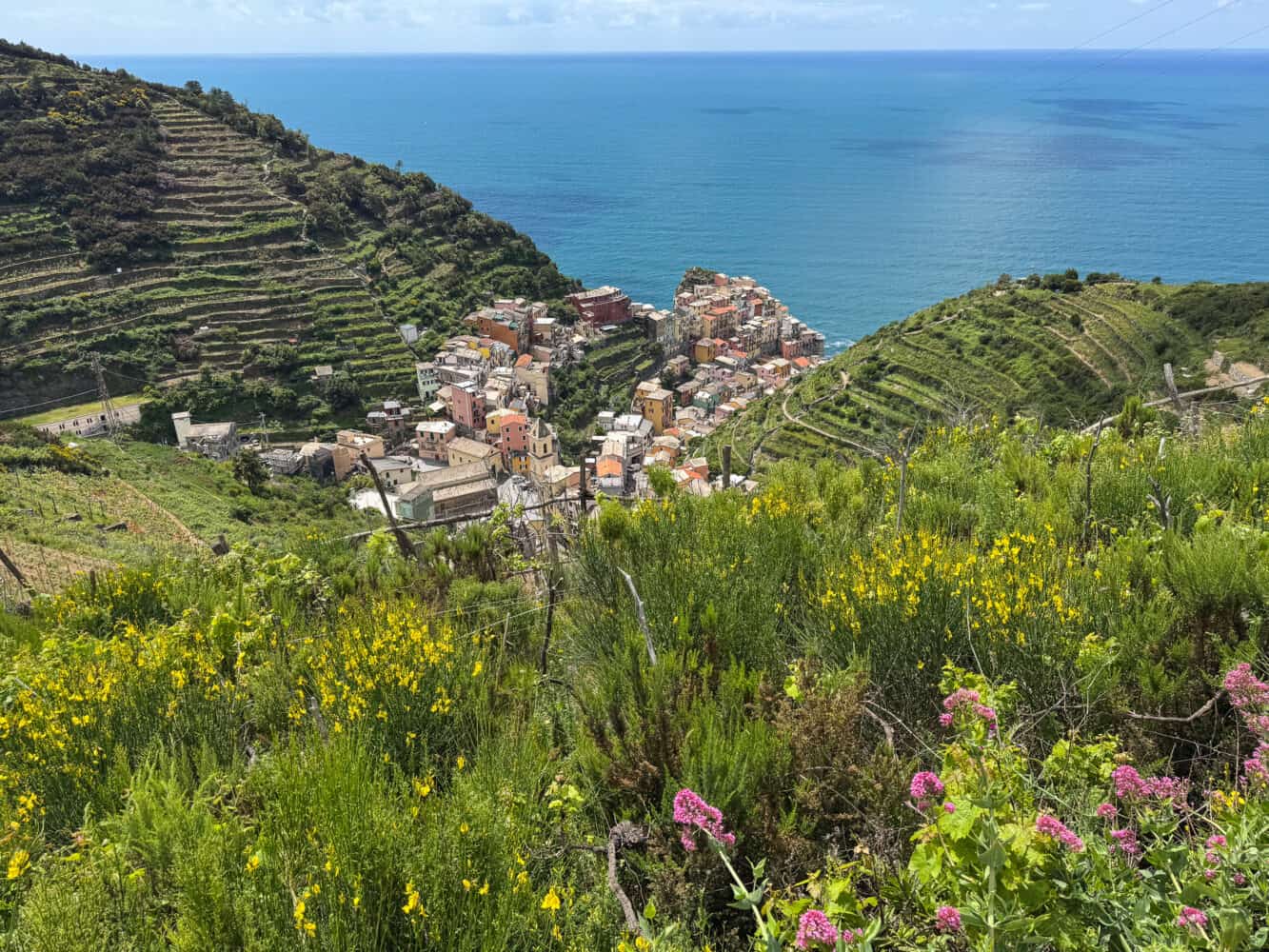
We did have to walk down steep steps again, but the views were worth it.
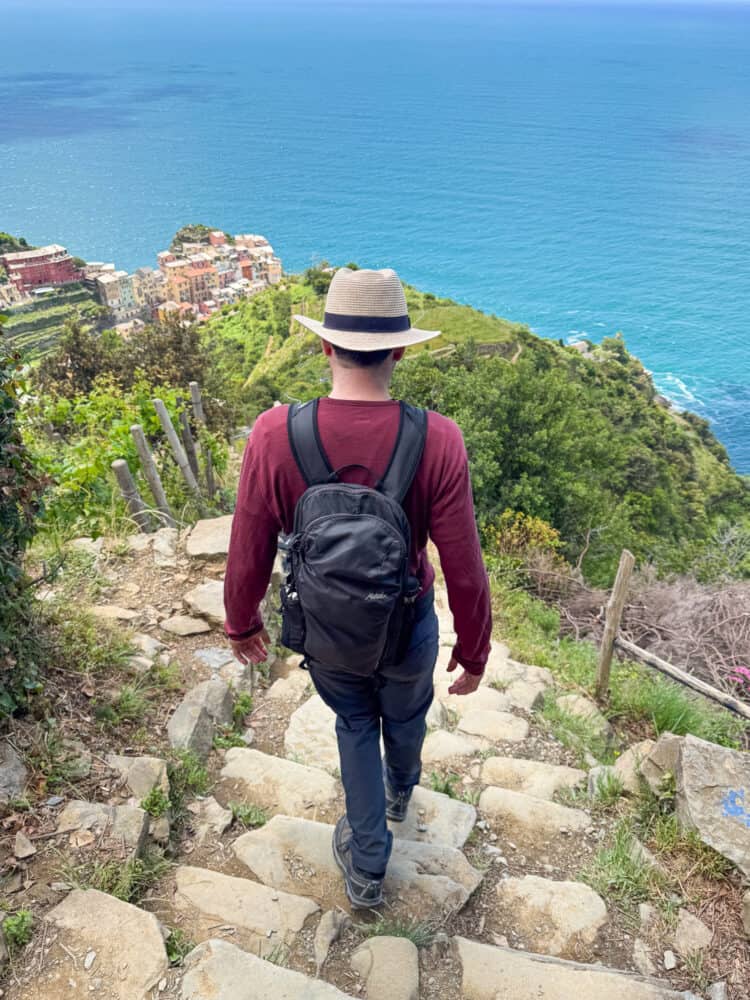
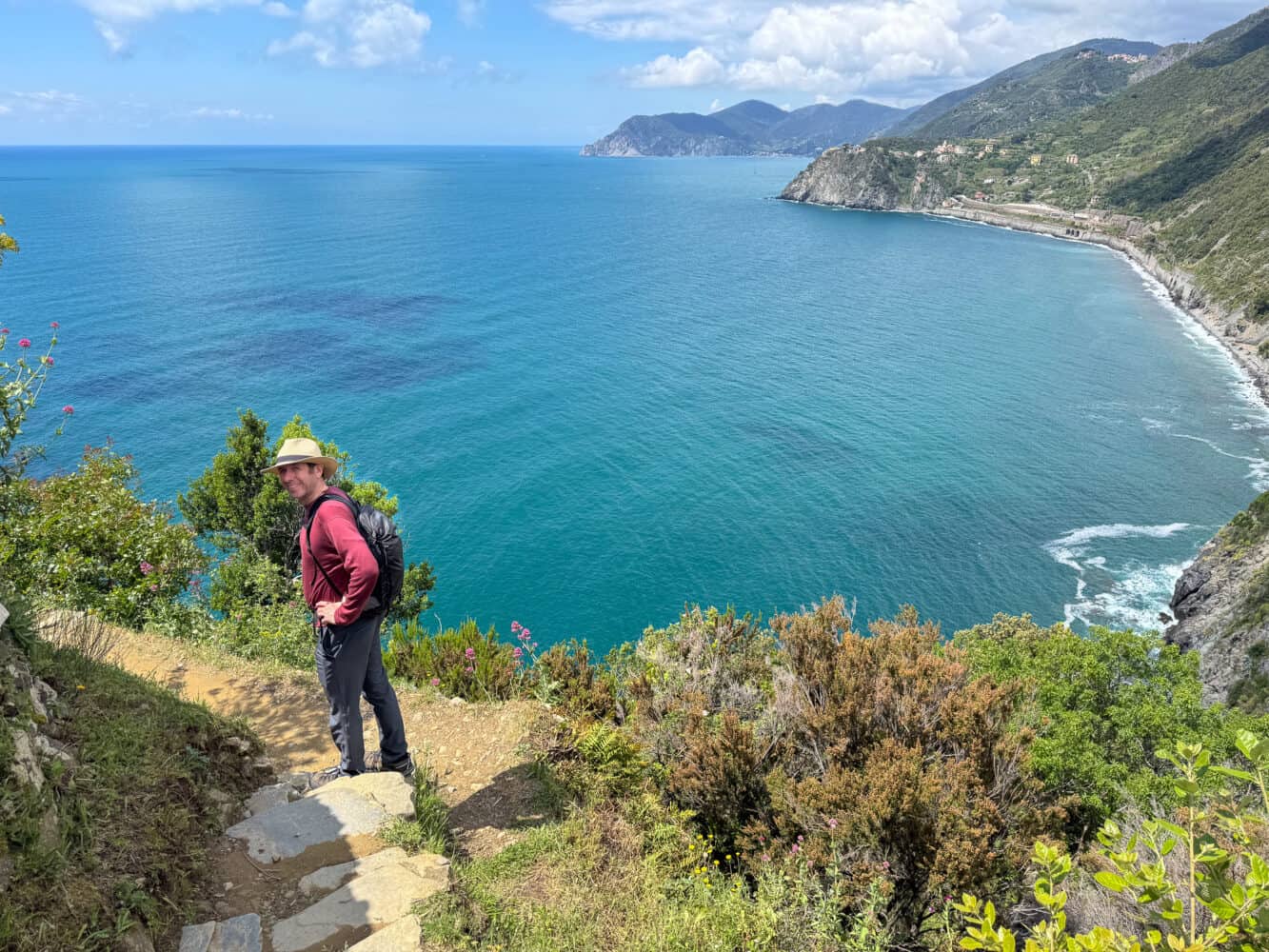

Finally, we reached Manarola at 1.30pm (three hours after we started at Corniglia Station). The village was rammed, and we couldn’t find anywhere to sit down and eat without a long wait (I recommend eating in Volastra).
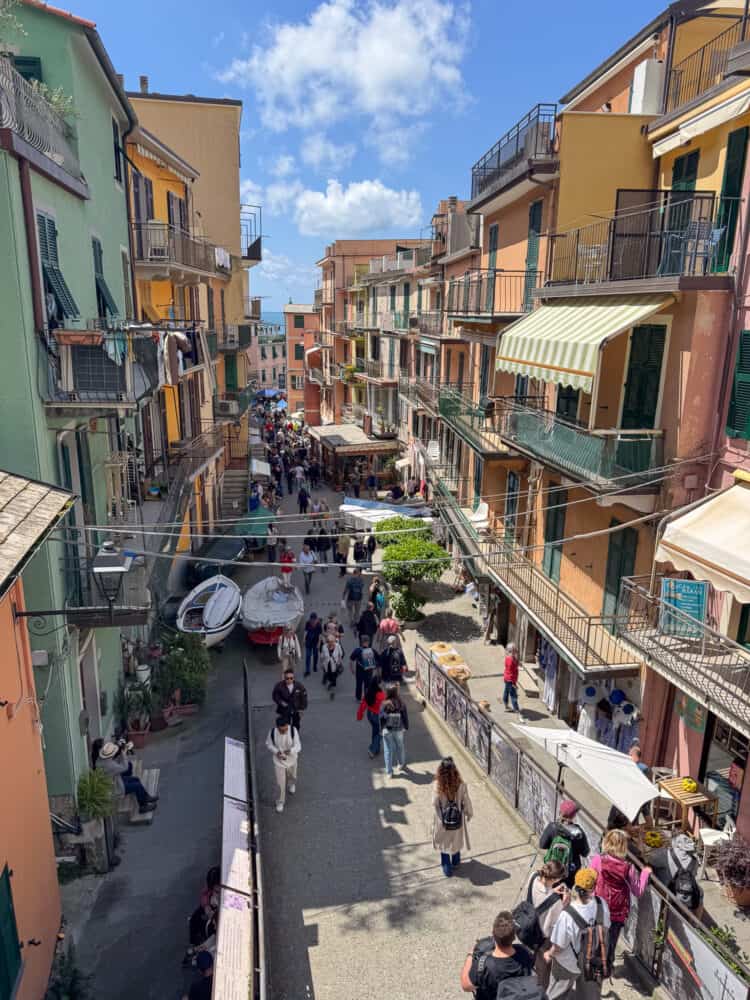
It was rather overwhelming, so we headed to the train station (reached through a tunnel) to take the train back to La Spezia.
Corniglia to Manarola Hike Map
I’ve marked the key points mentioned on the hike on this Google Map.
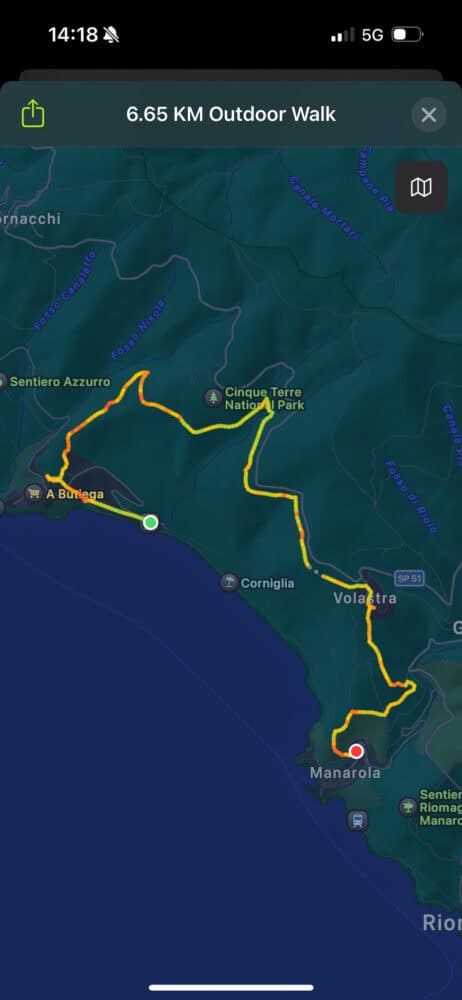
Final Thoughts
We absolutely loved the Corniglia – Volastra – Manarola hike. This varied trail has stunning views of the sea and villages, and it’s fun to get up close to the vineyards, impressively grown on the steep hillsides.
While the beginning of the hike is a workout, and you’ll struggle if you aren’t fairly fit, overall, we didn’t find the walk too hard. It was nice to have the option of a break in Volastra, too.
Hiking is still our favourite way to enjoy Cinque Terre, and I definitely recommend this route for a taste of the beautiful area. Just start early if you can!
More Liguria Posts
There is a lot more to the Liguria region than Cinque Terre. Here are more of our tips on the area:
- Camogli, Italy Travel Guide: Our Favourite Town on the Italian Riviera
- 11 Stunning Things to Do in the Italian Riviera
- Rapallo Travel Guide: The Best Italian Riviera Base
- Hiking to San Fruttuoso: The Perfect Day on the Italian Riviera
- Camogli Fish Festival (Sagra del Pesce): What to Expect
- Finale Ligure, Italy: The Quiet Side of the Italian Riviera
If you enjoyed this post, pin it!

Our Travel Tips for Skiathos, Greece 5 Jul 4:10 AM (3 months ago)
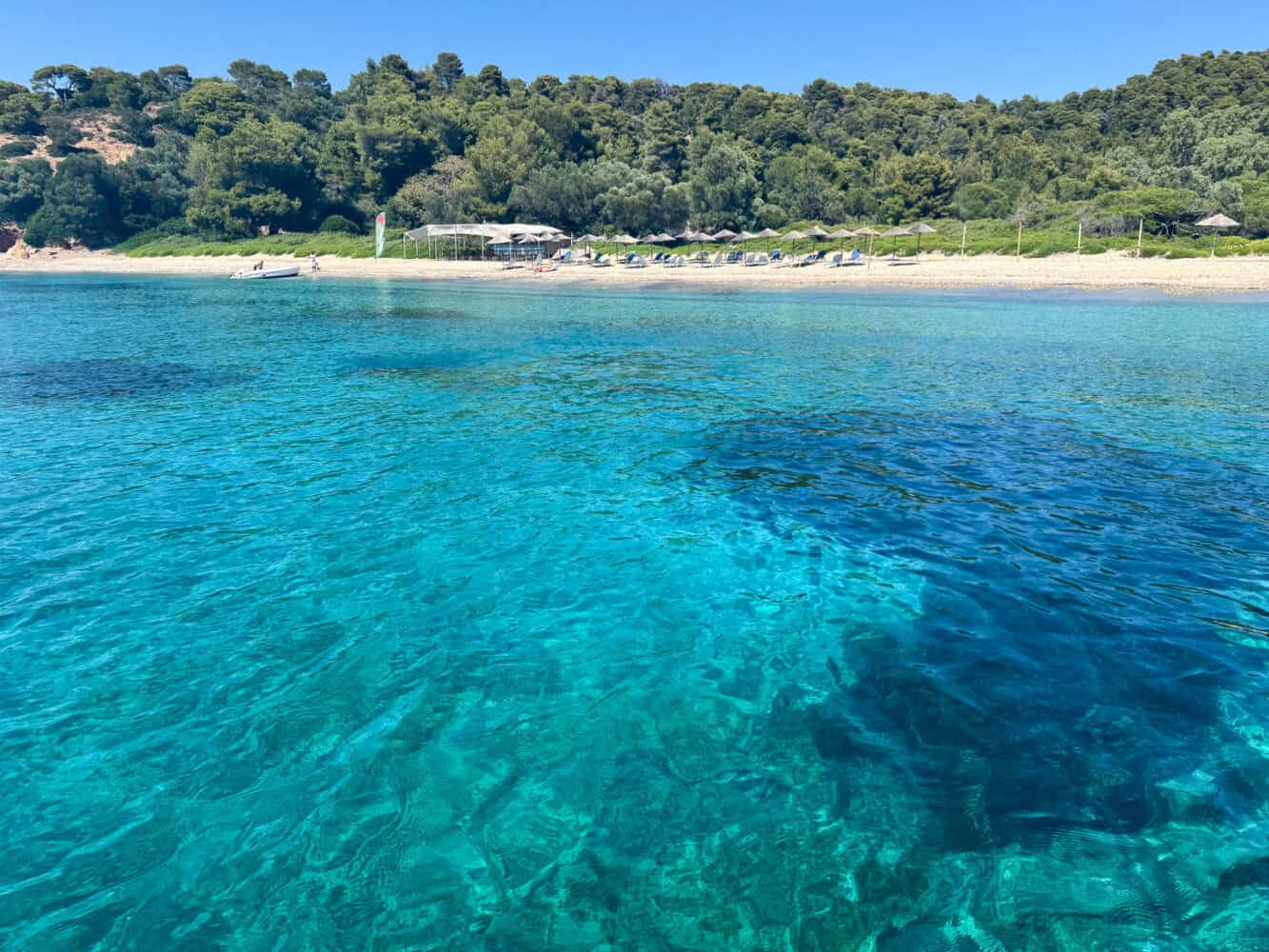
We’d never heard of the Greek island of Skiathos until my parents visited last year, but it sounded like exactly what we were looking for in a relaxing holiday.
Easy access with an international airport, beautiful beaches, a green mountainous interior, a charming town for evening strolls, good food, and that gorgeous, crystal-clear water that we love so much about Greece.
Skiathos is a compact island in the Sporades archipelago in the Aegean Sea, just east of the Greek mainland and north of Athens.
While it’s popular with holidaymakers in the summer, it’s not as overrun as more famous islands like Santorini and Mykonos. At the end of June, we found the crowds to be reasonable.
We spent a week beach-hopping by motorbike and boat and had a wonderful trip.
In this Skiathos travel guide, I share our favourite beaches (both remote and lively), restaurants we loved, where we stayed, and other tips for the island.
At the end, you’ll find a Skiathos map with everywhere mentioned.
Contents
- Where is Lake Molveno?
- Best Things to Do in Molveno
- Where We Stayed: Grand Hotel Molveno Review
- Where to Eat in Molveno
- How to Get to Lake Molveno, Italy
- Lake Molveno Map
- Is Lake Molveno Worth Visiting?
- More North Italy Posts
- Where is Camogli, Italy?
- Best Things To Do in Camogli Village
- Best Hikes and Day Trips from Camogli
- Our Favourite Places to Eat in Camogli
- Where to Stay in Camogli
- How to Get to Camogli
- Camogli, Italy Map
- Is Camogli Worth Visiting?
- More Italian Riviera Tips
- Location of Hotel Cenobio dei Dogi, Camogli
- History of the Hotel
- Our Room at Hotel Cenobio dei Dogi
- Swimming Pool
- Private Beach
- Restaurants
- Other Facilities
- Hotel Cenobio dei Dogi Pros and Cons
- Cost of Hotel Cenobio dei Dogi
- Final Thoughts
- More Italian Riviera Posts
- Getting to Camogli
- When is the Camogli Fish Festival?
- Sagra del Pesce Camogli Schedule
- Friday Night: The Festival Begins
- Saturday: Bonfires and Fireworks
- Sunday Fish Fry
- Is the Camogli Fish Festival Worth Visiting?
- More Liguria Posts
- Hiking The Blue Trail in Cinque Terre
- Corniglia to Manarola via Volastra Hike Details
- Getting to Corniglia: The Start of the Hike
- Corniglia to Volastra Trail
- Volastra
- Volastra to Manarola Trail
- Corniglia to Manarola Hike Map
- Final Thoughts
- More Liguria Posts
- Skiathos Tips
- Beaches in Skiathos
- Renting a Boat
- Skiathos Town
- Our Favourite Restaurants in Skiathos
- Where We Stayed on Skiathos
- Getting to Skiathos, Greece
- Skiathos Map
- Is Skiathos Worth Visiting?
- More Greece Posts
Skiathos Tips
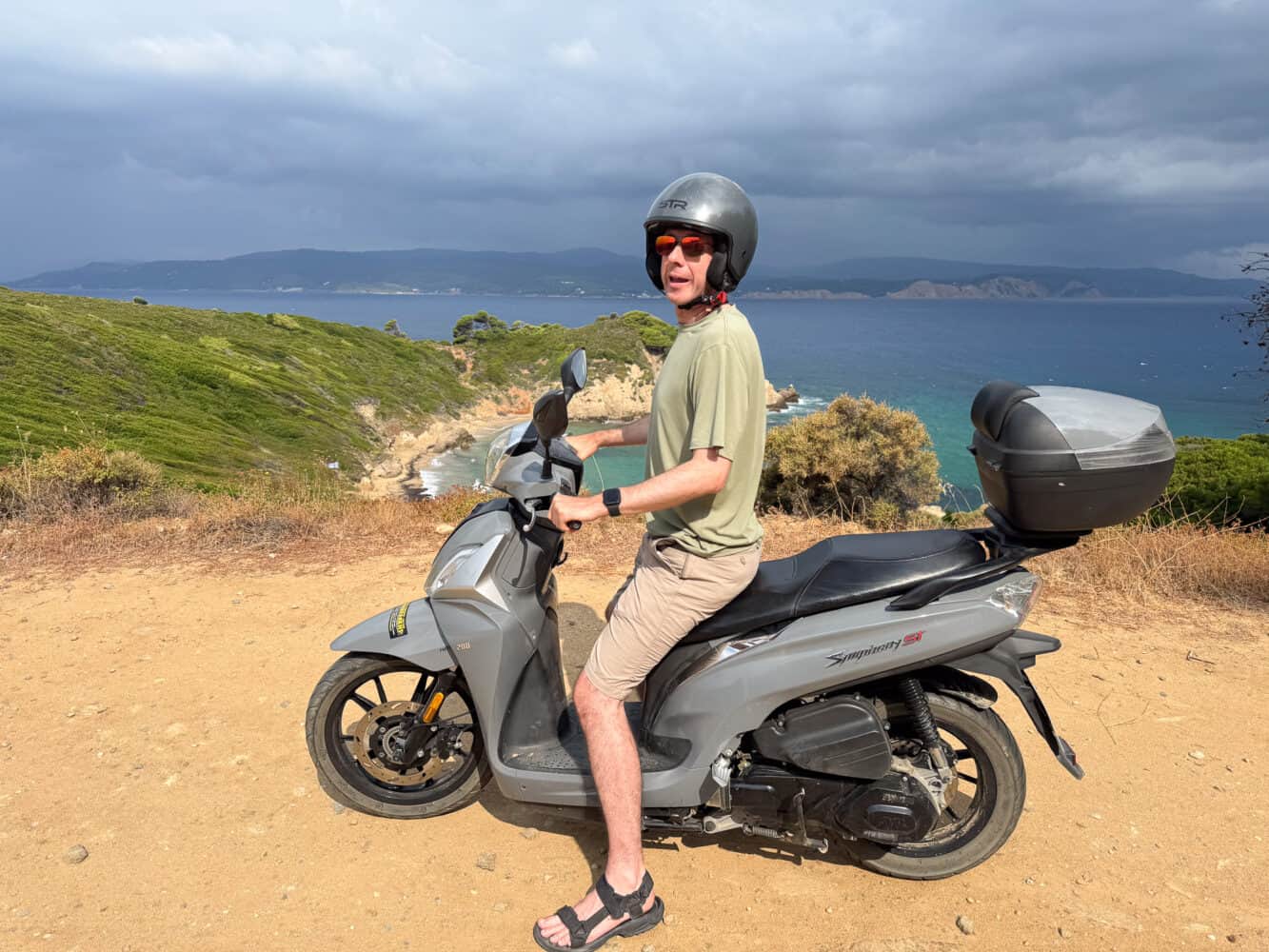
- Skiathos is doable by public transport – In summer, there are buses every 10 minutes along the south coast, so many people beach hop that way.
- Rent a vehicle for more freedom – We loved the flexibility of renting a 200cc scooter (€20 per day, arranged via our hotel), especially since the northern beaches aren’t on the bus route. If you don’t have a motorbike licence, consider an ATV (best for the dirt roads) or car.
- Parking is free everywhere – But it can be challenging to find in Skiathos Town (a motorbike is much easier).
- Pick up a free paper map – While Google Maps worked fine for directions, a paper map will show you all the beaches and which roads are unpaved.
- Carry some cash – Most places accept cards, but some of the sunbed rentals (usually the most expensive ones!) are cash only.
- Tap water is high in minerals – On the advice of our hotel, we reluctantly drank bottled water (ugh, the plastic!) to avoid upset stomachs. There are mixed opinions on this, but we didn’t want to risk it.
- Don’t put toilet paper in the toilet – It can clog them. There are always bins provided.
Beaches in Skiathos
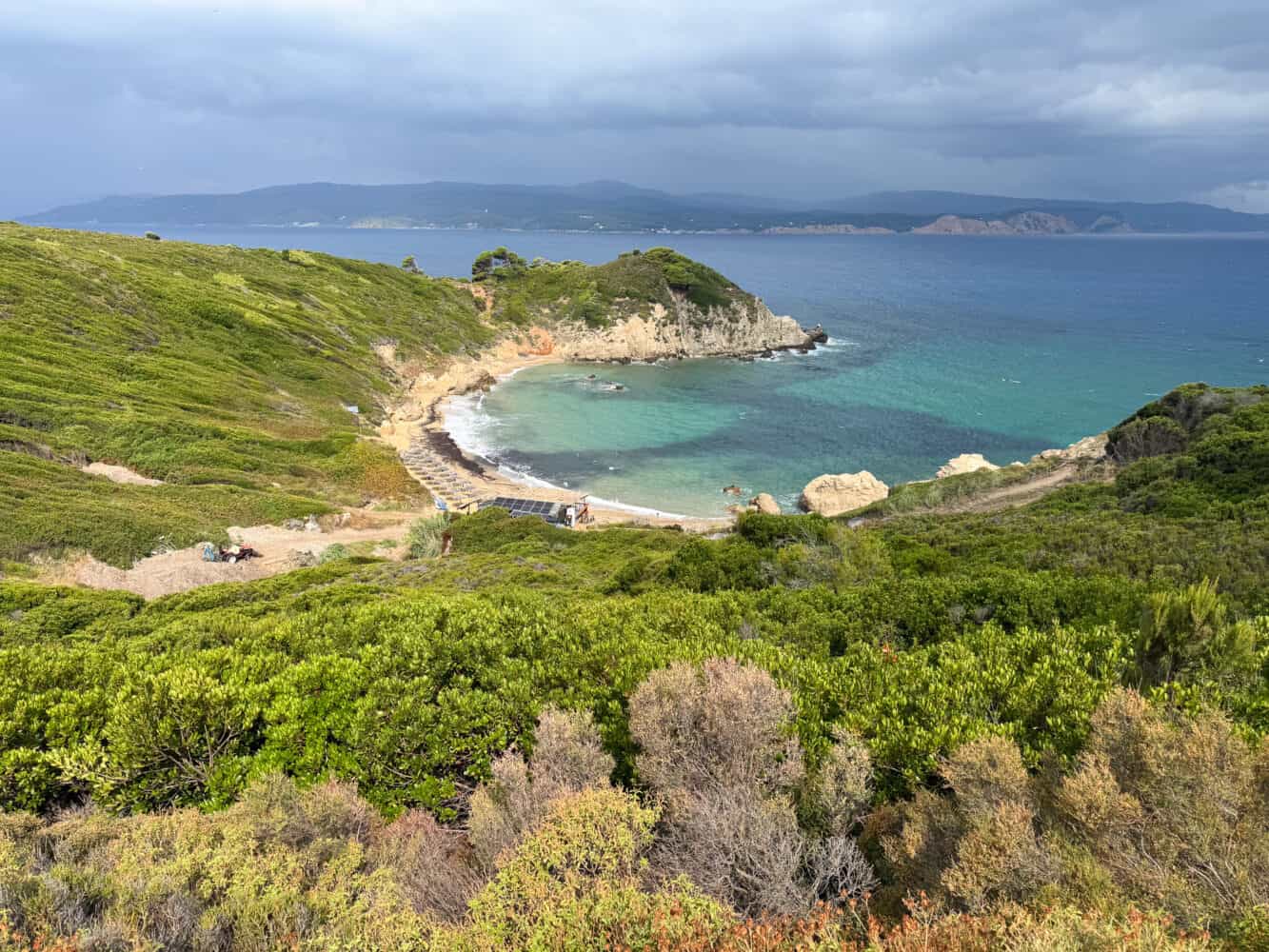
The beaches are why you visit Skiathos. There are over 60 of them and they are stunning—from golden sandy stretches backed by pine trees to pebbly coves under dramatic cliffs.
Sunbed Rentals
Most beaches offer sunbed rentals, which we appreciated for their comfort and shade.
On our visit, sunbeds in Skiathos cost between €12 and €30 a day for two beds and an umbrella. This was the last week in June (high season but not peak), and prices vary depending on the month.
When you arrive at a beach, take a seat where you like (unless there’s a reserved sign) and someone will eventually come to collect payment. There are often signs with the price, but if not, you might want to check with the attendant or at the nearest taverna (which often run them).
If you want to get a front row spot in high season, I recommend arriving before 10am (most open at 9am).
There are always free sections of beaches, though, so you could buy an umbrella (from €12) and save money. There are shops all along the south coast selling beach gear.
South vs North Coast Skiathos
The most accessible beaches are located on the south coast, where a tarmac road connects Skiathos Town (near the airport and port) in the east to Koukounaries Beach in the west.
It’s a 20-minute drive between them with many beaches on the way. The southern beaches are more developed, often with beach clubs and water sports rentals. They are generally sandier and sheltered from the northerly winds.
The north coast is far less developed, and for most, you’ll need to visit with your own transport or take a boat trip. The roads north are dirt and quite rough.
The beaches in the northeast are pebbly, while the northwest has some sandy beaches. It can be windier and wavier, so I’d avoid the north when there are strong northerly winds.
Although the northern beaches are quieter and have more natural settings, you can still find sunbed rentals and tavernas on many of them.
Every beach we visited was lovely; it just depends on what you are looking for.
Here are our favourite Skiathos beaches:
Krifi Ammos (North)
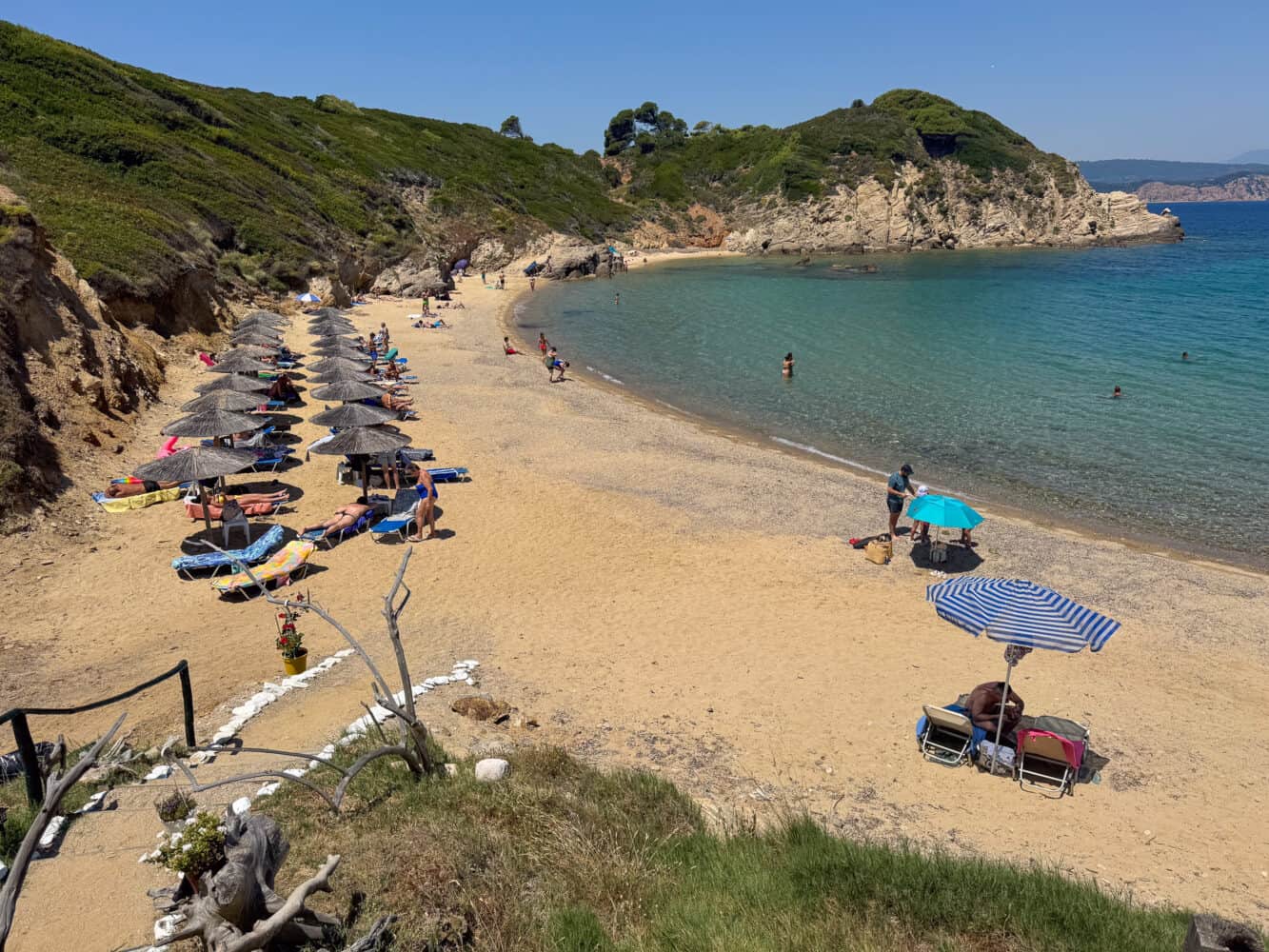
My favourite Skiathos beach is Krifi Ammos, which translates to ‘Hidden Sands’ and is often referred to as Hidden Beach.
It’s in the northwest corner of the island, not far past Agia Eleni, and although the last section is on a dirt road, it’s a pretty easy drive compared to the road to Ligaries. You do need to walk at the end, though.
We parked on the side of the road by the first sign for the beach and walked down the steep path to the beach—only about three minutes, but it’s harder on the way up, of course.
This small, picturesque bay feels far away from it all with a scenic setting beneath rugged, green cliffs.
The beach is a mix of sand and pebbles with clear water that was calm in the morning, but a little choppier in the afternoon when the wind picked up.
I saw a few fish while snorkelling (but I didn’t find any amazing snorkelling on Skiathos).
Sunbeds cost €20 and they do fill up, so I recommend arriving before 10.30am to get a spot (there were only a few others when we arrived at 9.30am, but it filled up fast).
Maria’s Taverna (called Kryfi Ammos Restaurant on Google Maps) is just above the beach and is a fantastic place for lunch. We really enjoyed our Greek salad and mezze with a lovely view down to the beach. We could pay by card.
Ligaries Beach (North)
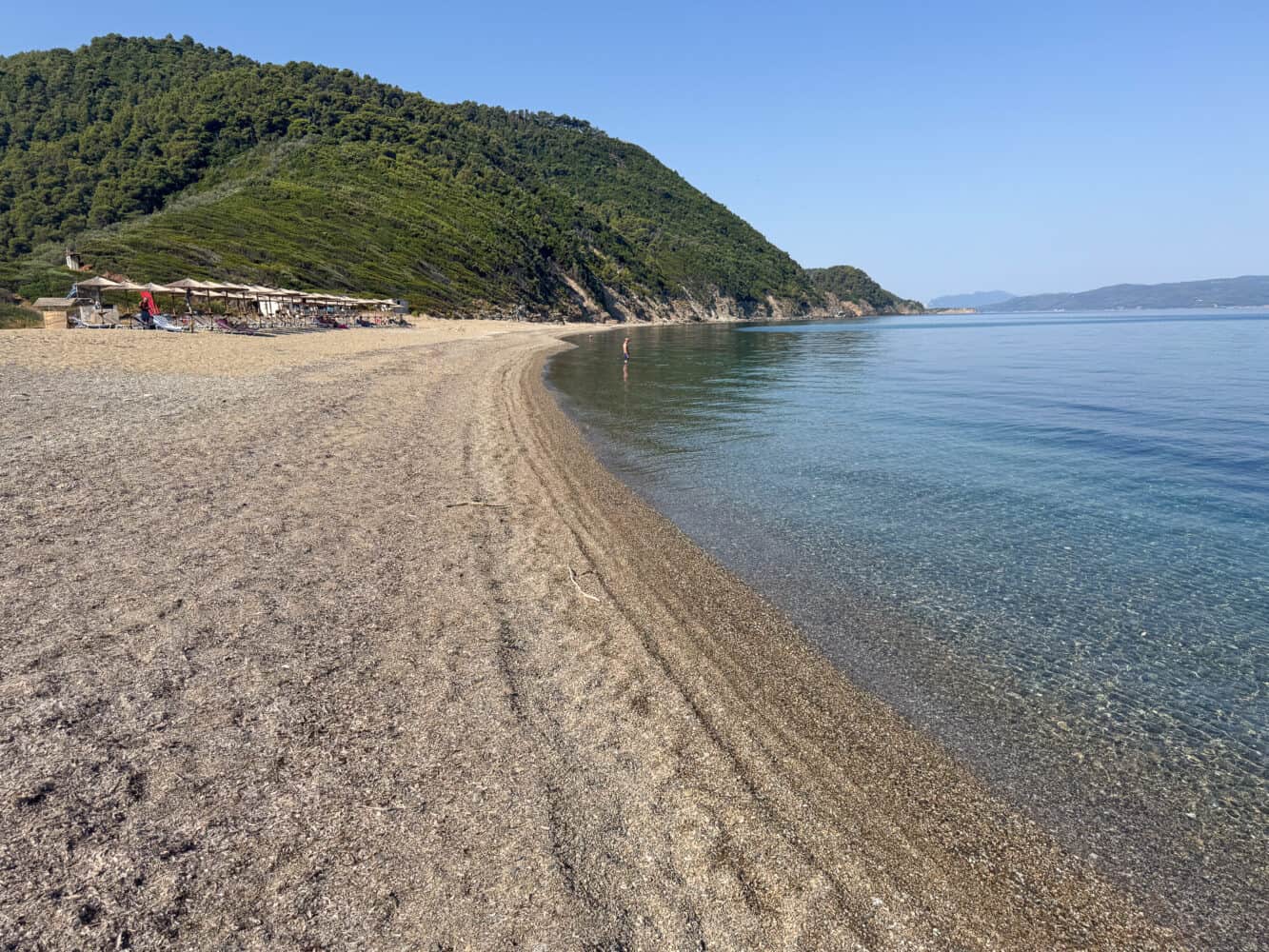
Ligaries Beach is another quiet spot on the north coast.
This one is much harder to reach with a rough, winding dirt road up and down steep hills in the forest and even through a shallow river. We managed ok on a scooter, but I wouldn’t recommend it for novice or nervous drivers.
Ligaries is quite large, so there’s plenty of space to spread out, and the sunbeds didn’t fill up all day (you could even have got a front row spot in the afternoon).
At €12, they were the cheapest option we found, and we could even pay by card (although it’s best to bring cash just in case).
The beach is a mix of coarse sand and pebbles, so it’s not ideal for water games (unless you have water shoes). The sea is wonderfully clear as always, and was calm in the morning (again, things get a bit windier in the afternoon).
The area behind the beach isn’t that attractive, but you aren’t looking that way anyway.
Taverna Ligaries is a 3-minute walk behind the beach and is a wonderful place for lunch—again, we had a delicious selection of salad and mezze. It’s a popular spot and was full by 1pm, so go at 12.30pm when the kitchen opens (drinks are available earlier) or expect a wait.
The beach attendant can also take orders for drinks and deliver them to your sunbed.
Koukounaries Beach (South)
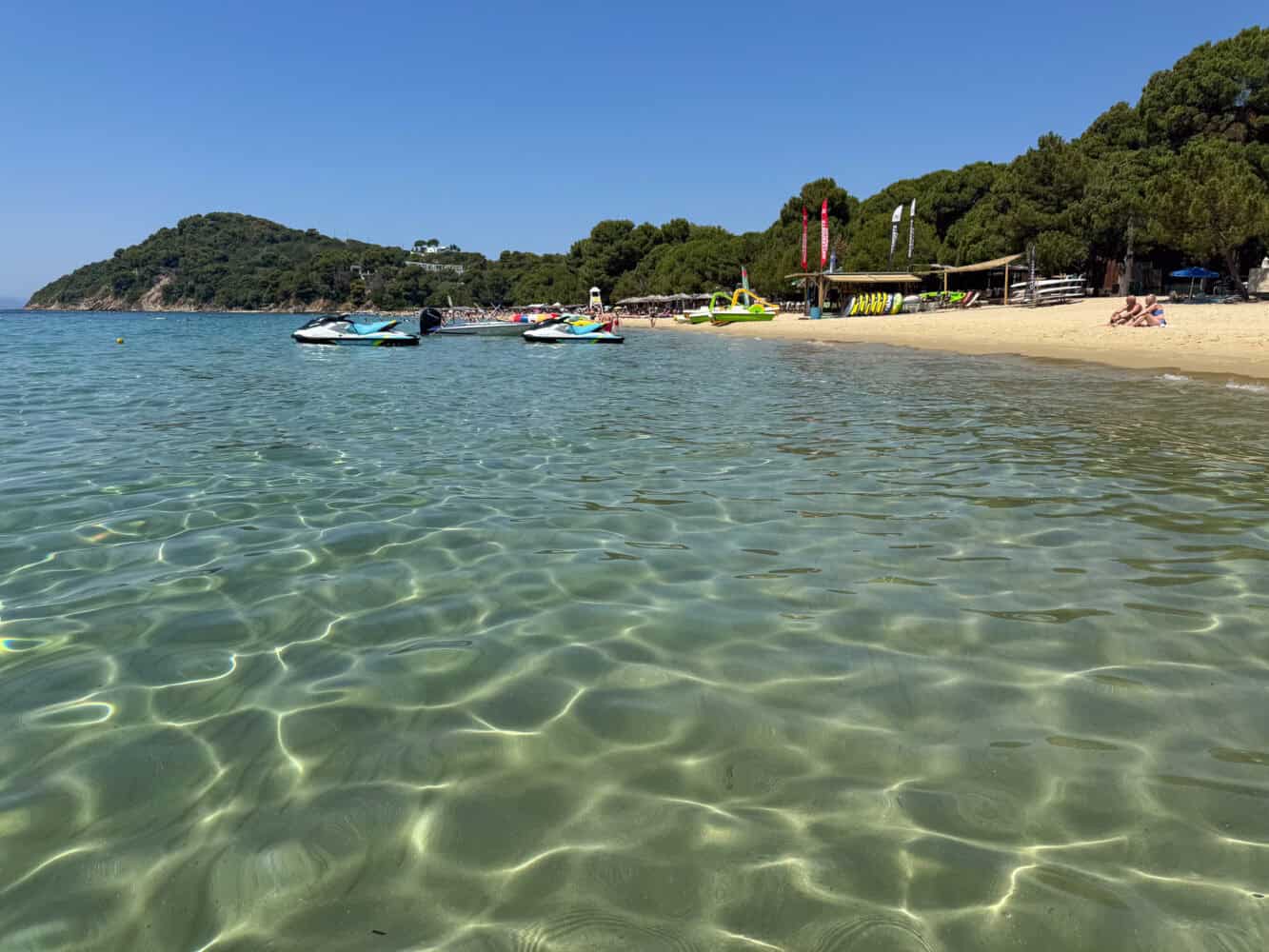
Koukounaries is the most popular beach on Skiathos. If you want a lively beach scene with water sports and beach bars, this is the place to go.
We prefer quieter beaches, but we still visited Koukounaries twice because it’s popular for a reason.
The golden, shimmery sand is the softest on the island, and the shallow, crystal clear water is perfect for playing games in the water.
It’s backed by pine trees, so it has a good amount of natural shade, but the shady free sections fill up fast.
Koukounaries is situated in a large, protected bay, making it a good choice when there are strong northerly winds.
We parked at the large free car park at the east end (the first entrance coming from Skiathos Town, near bus stop 23).
We walked across the bridge onto the beach and rented sunbeds from the second lot of beds (just past Da Luz Beach Bar), which felt a little quieter with no loud music.
At €30, they were the most expensive beds we rented, but they are padded and comfortable, and we found availability to be good into the afternoon (although it’s best to arrive early for the front row). Annoyingly, we had to pay cash.
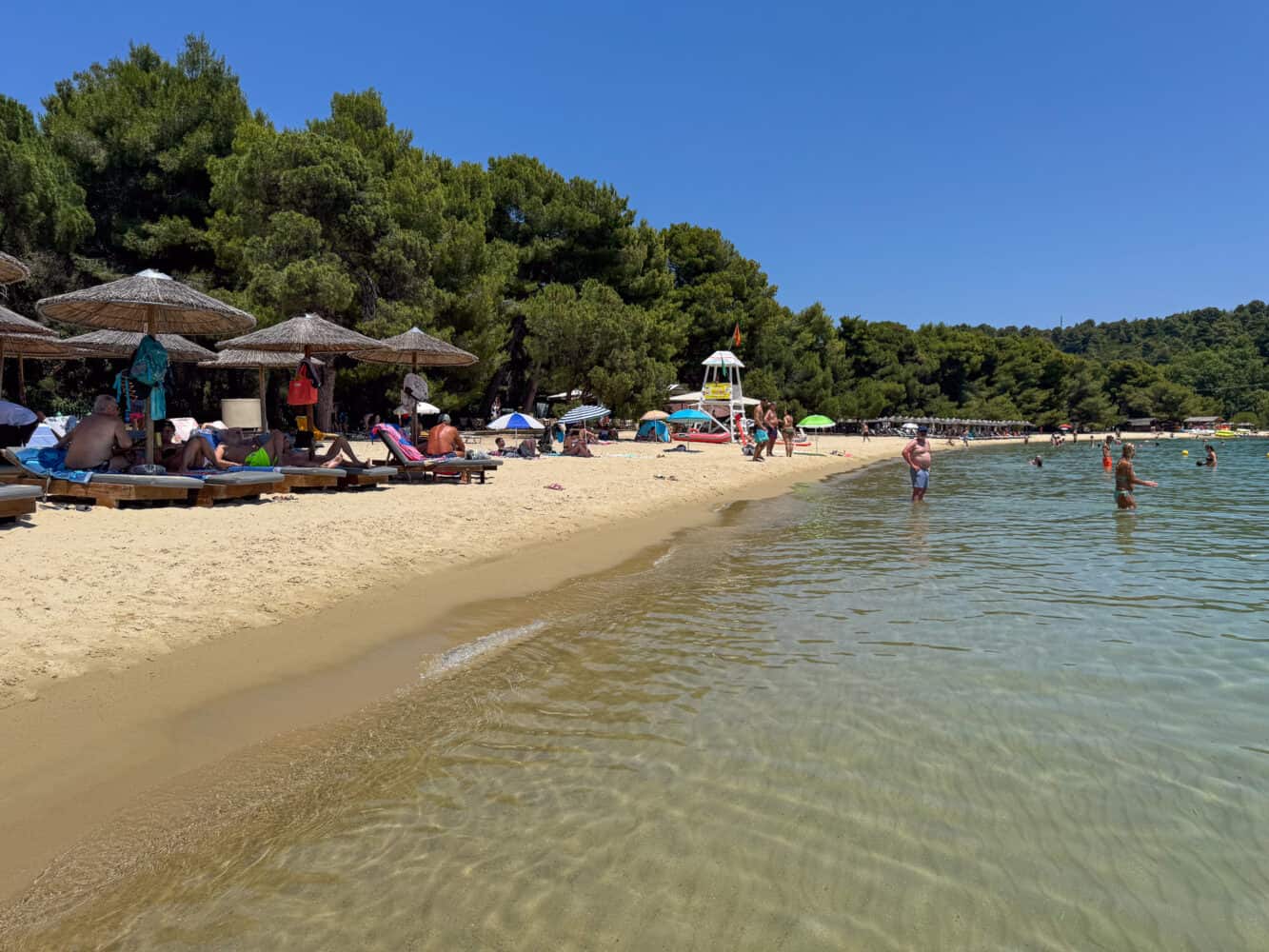
We found the food at the beach bars to be mediocre, so I recommend picking up something from a bakery on your way.
There are various water sports places. We rented a jetski (€50 for 15 minutes) from SaltO—fun but short.
There are public toilets, showers, and changing pods at the beach.
Agia Eleni (South)
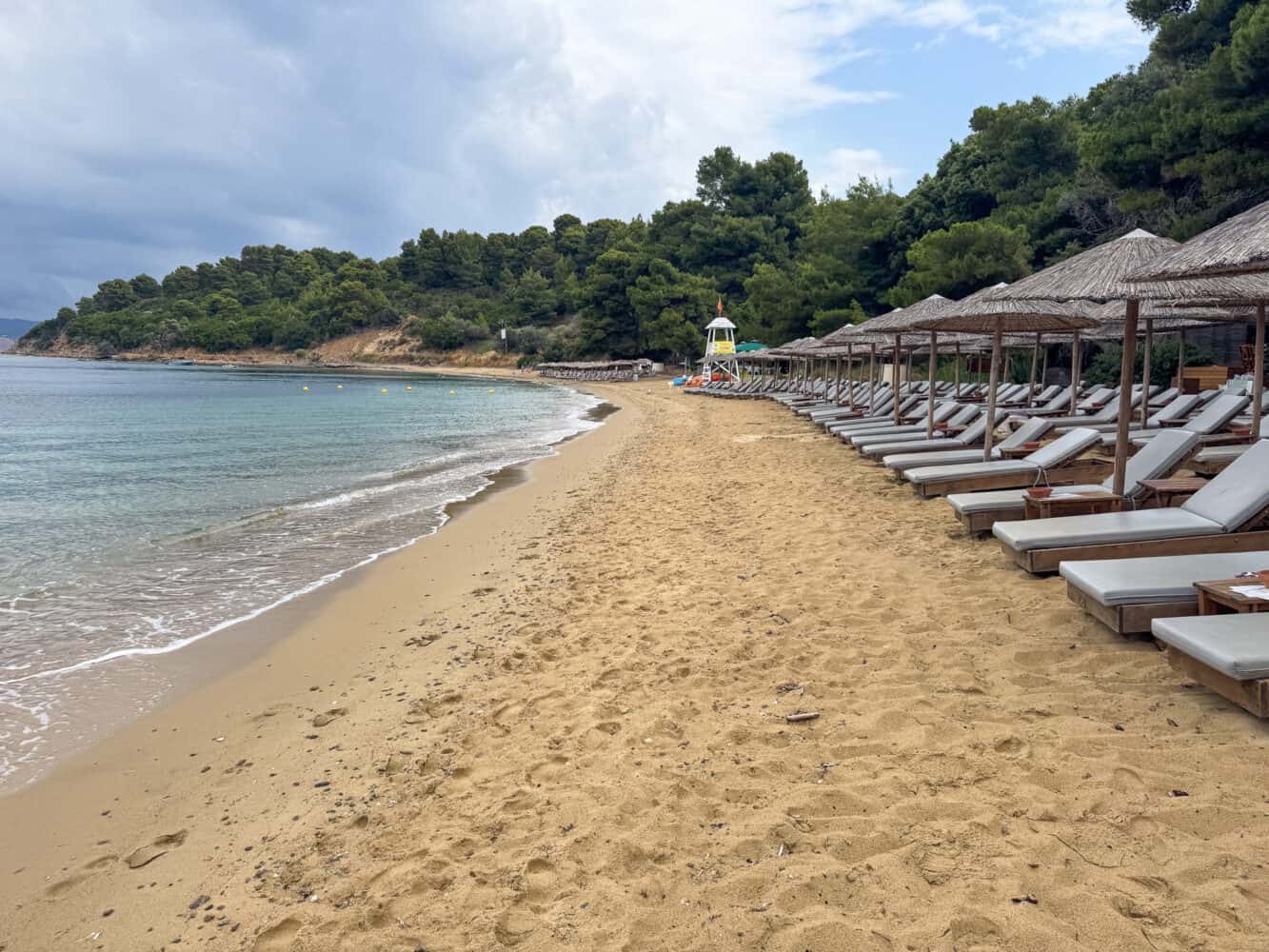
Agia Eleni is the last of the southern beaches, on the western end of the island just past Koukounaries. The road is paved, and you can drive right up.
It’s a pretty bay with a sandy beach backed by pine trees and is quite well protected from the wind. The sand is a little coarser than Koukounaries with a few pebbles around.
There are two beach bars with sunbed rentals for €20 (cash only). We chose the second one, Summer Beach, but later regretted it because it had a DJ, and the music got too loud in the afternoon.
The food was just ok (you can order to your bed, though), and the other place has even worse reviews, so maybe bring your own.
Agia Eleni is more chilled than Koukounaries, but it still has good facilities with water sports rentals and wheelchair access into the water.
My favourite time to visit Agia Eleni is at sunset. It has one of the best sunset views on the island and swimming in the shimmering sea was lovely. The beach bars stay open if you want a drink.
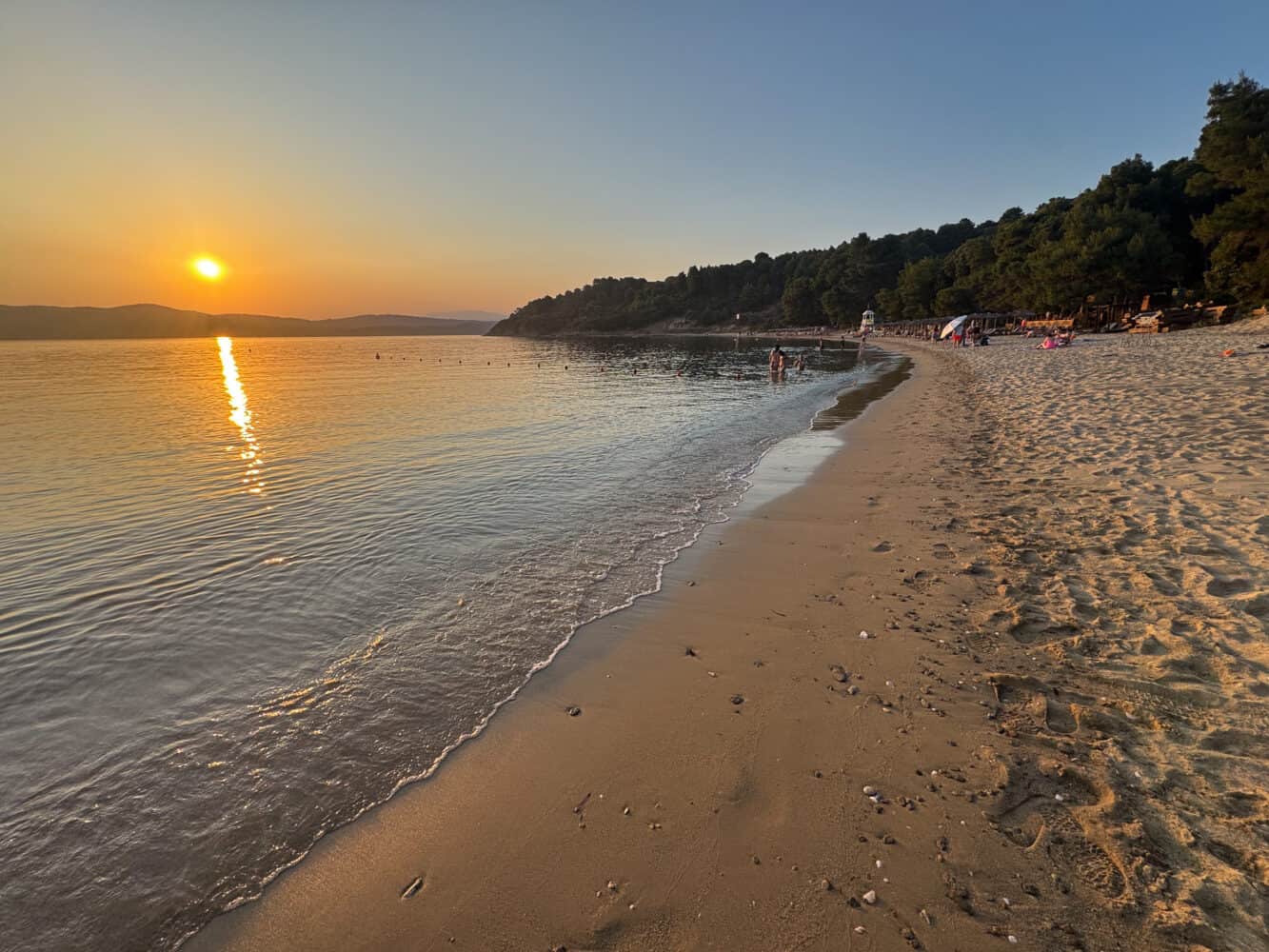
Elias Beach (North)
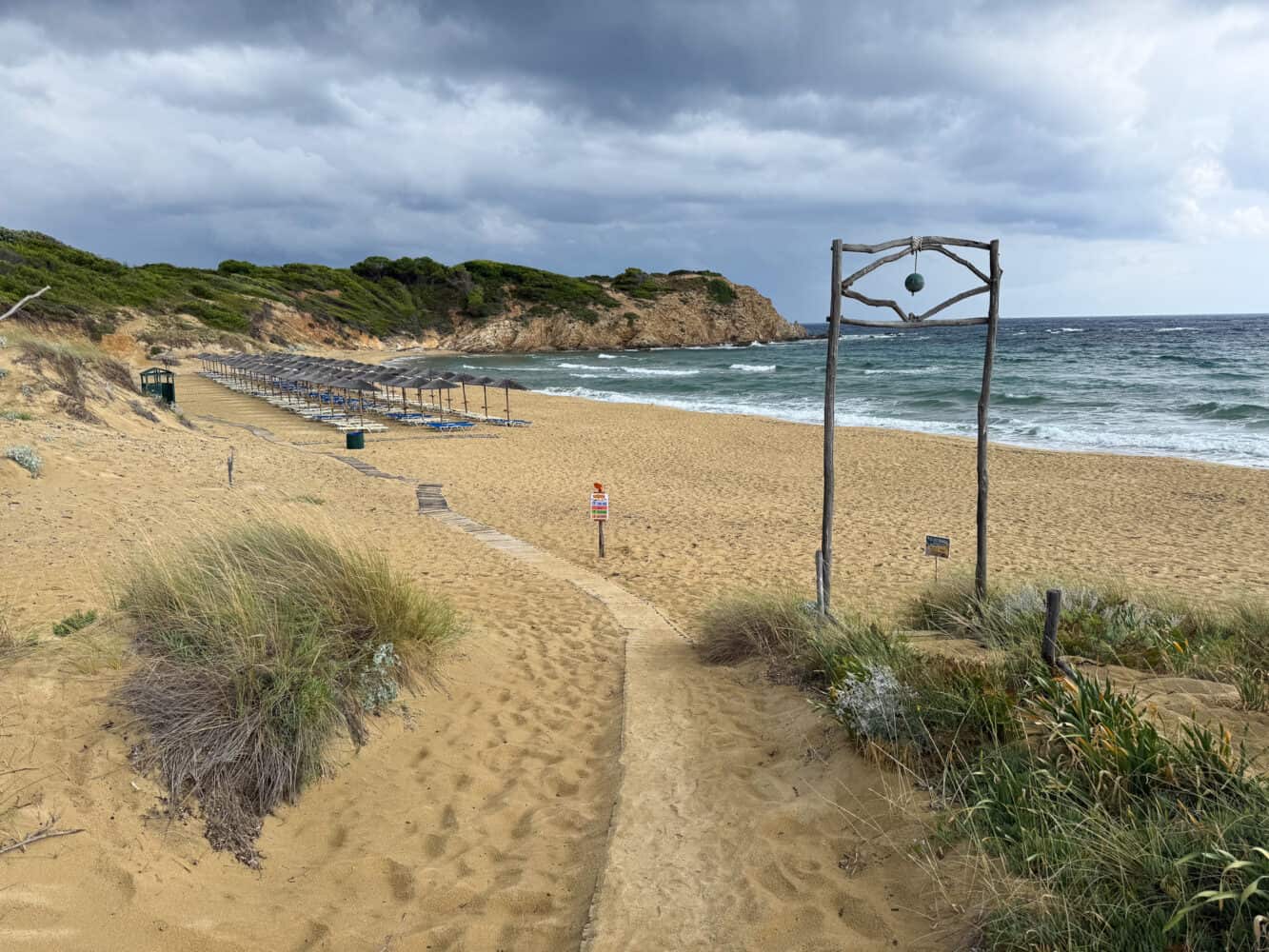
We didn’t spend long at Elias Beach (also known as Elia Beach) because we visited on a day with strong northerly winds, when the sea was too rough to swim.
The sandy beach looked beautiful, though, and I would have loved to spend a calmer day there.
There are plenty of sunbeds (maybe €15) as well as free space, plus a beach bar (cash only) that gets good reviews.
Elias Beach is past Krifi Ammos, and you have to drive down a dirt road to get there. Some people walk through the forest—about 30 minutes from Bus Stop 23 in Koukounaries.
Renting a Boat
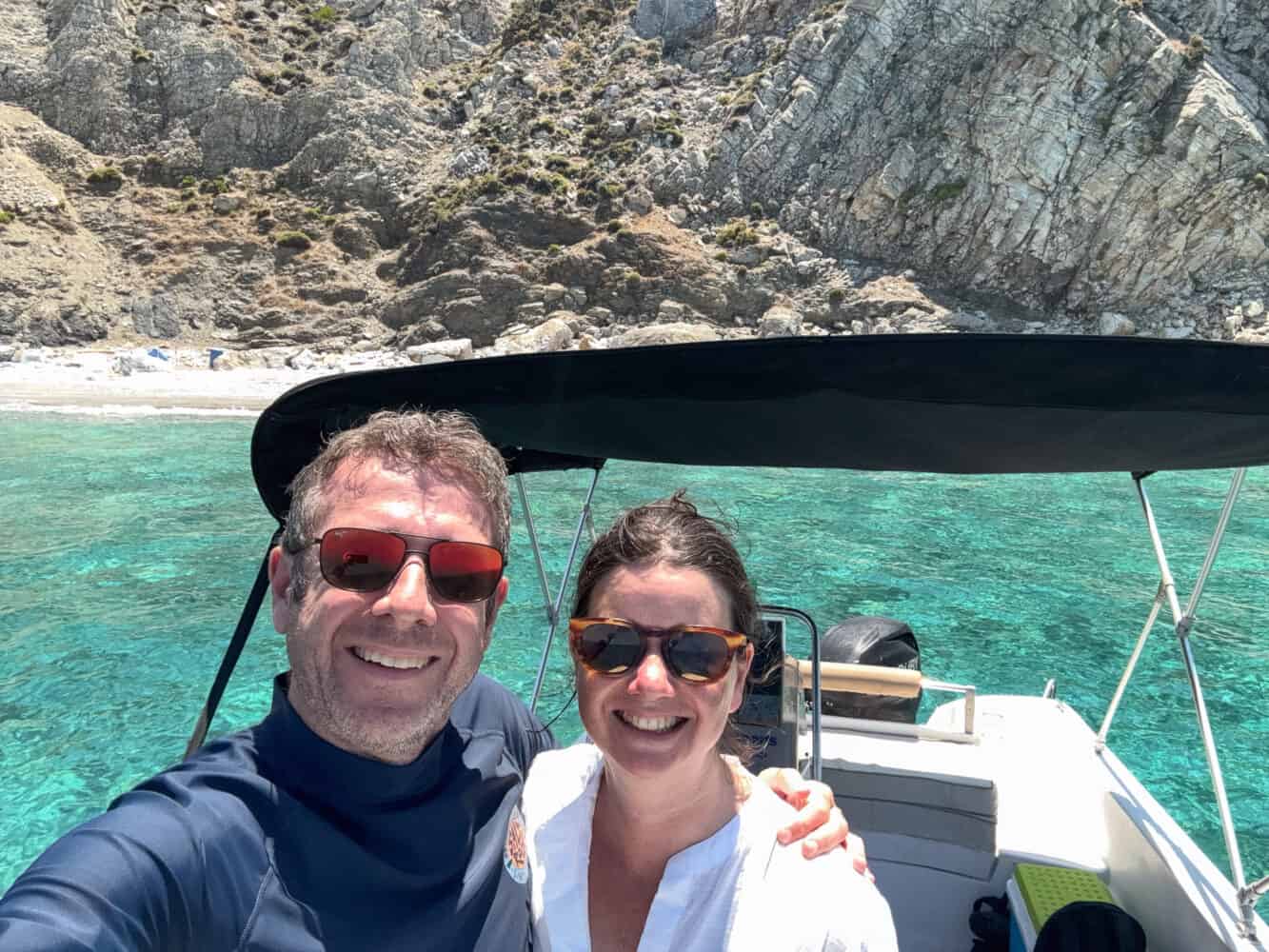
One of the best things to do in Skiathos is to take a boat trip. This allows you to reach some gorgeous beaches that aren’t accessible by road.
Head down to the old port to find an array of boat tours on offer from all-day Mamma Mia trips to the neighbouring island Skopelos (where the famous movies were filmed) to simple water taxis to Lalaria or Tsougria.
If you prefer to book in advance, consider this Mamma Mia Island Cruise or this Cruise to Lalaria, Kastro, and Tsougris.
We prefer renting our own boat in Greece, and Skiathos is a great place to do so.
You can rent certain boats without a licence—they are easy to drive and you can loop around the whole island in a day (as long as the wind isn’t too strong), stopping wherever you feel like it.
We rented a boat with Skiathos Boat Hire at Paralia Vasilias (we booked a few weeks in advance via WhatsApp).
Their cheapest boat is €130 a day, but we paid €160 for Katerina, which is newer and more spacious, so we could both lie down on the padded seats when anchored.
Fuel is extra and cost us €45. All boats include a cool box (bring ice and plenty of water), shade canopy, a dry bag (to swim to shore), and ladder for easy access after swims.
Rentals are from 10am – 6pm, but the comprehensive safety and orientation briefing lasted 45 minutes. It was still plenty of time to sail around the whole island with four swim stops.
Next time I’d bring my AirPods as the boat engines are noisy.
Our first stop was Lalaria, considered the most beautiful beach on Skiathos. It’s only accessible by boat, but all the tours go here, so it was crowded by the time we arrived, and we didn’t stay long.
The pebble beach is lovely under dramatic cliffs with a stone arch you can swim through.
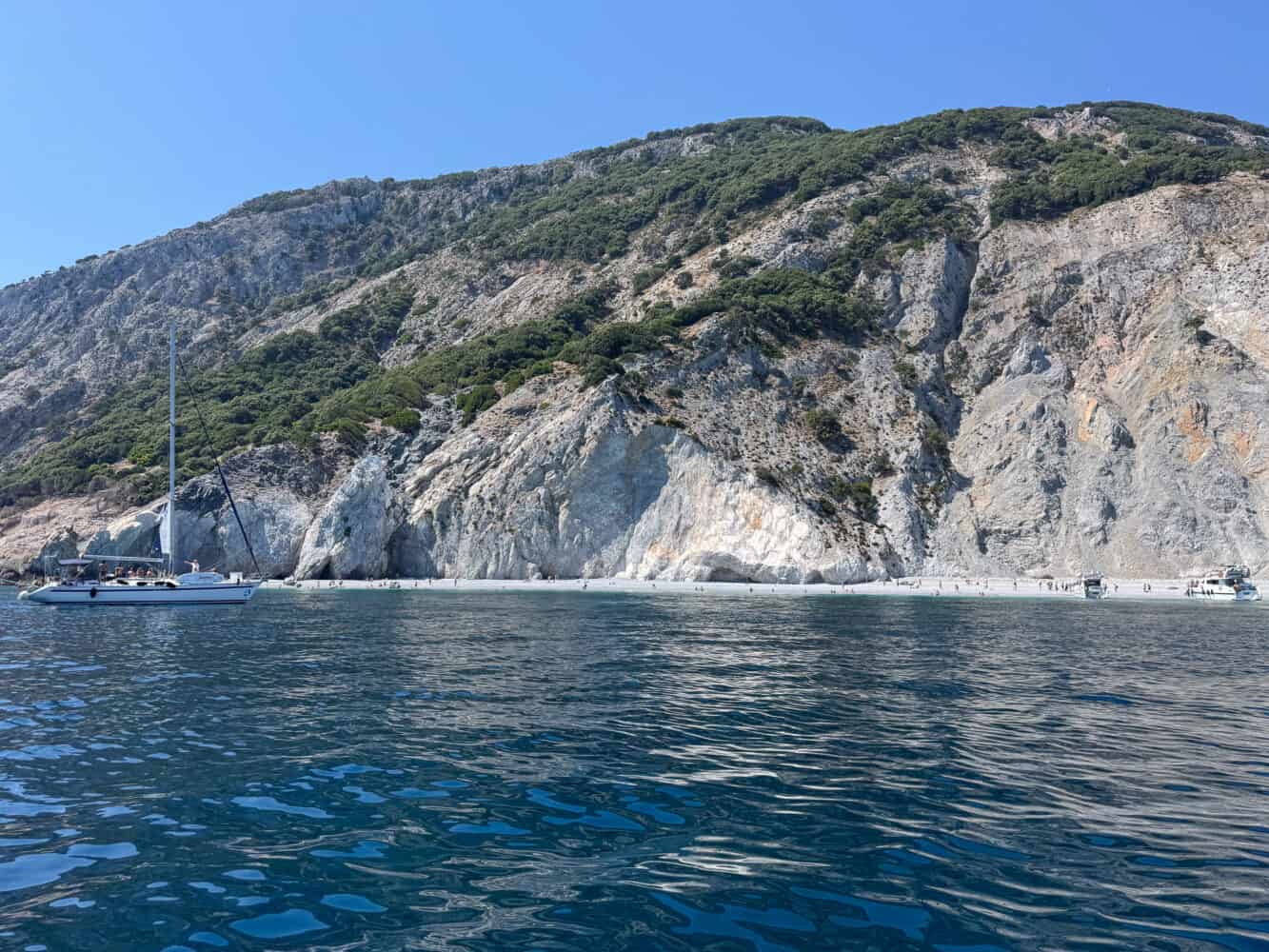
Next was Kastro (Skiathos Castle), where you can see the ruins of the ancient capital high on the hill.
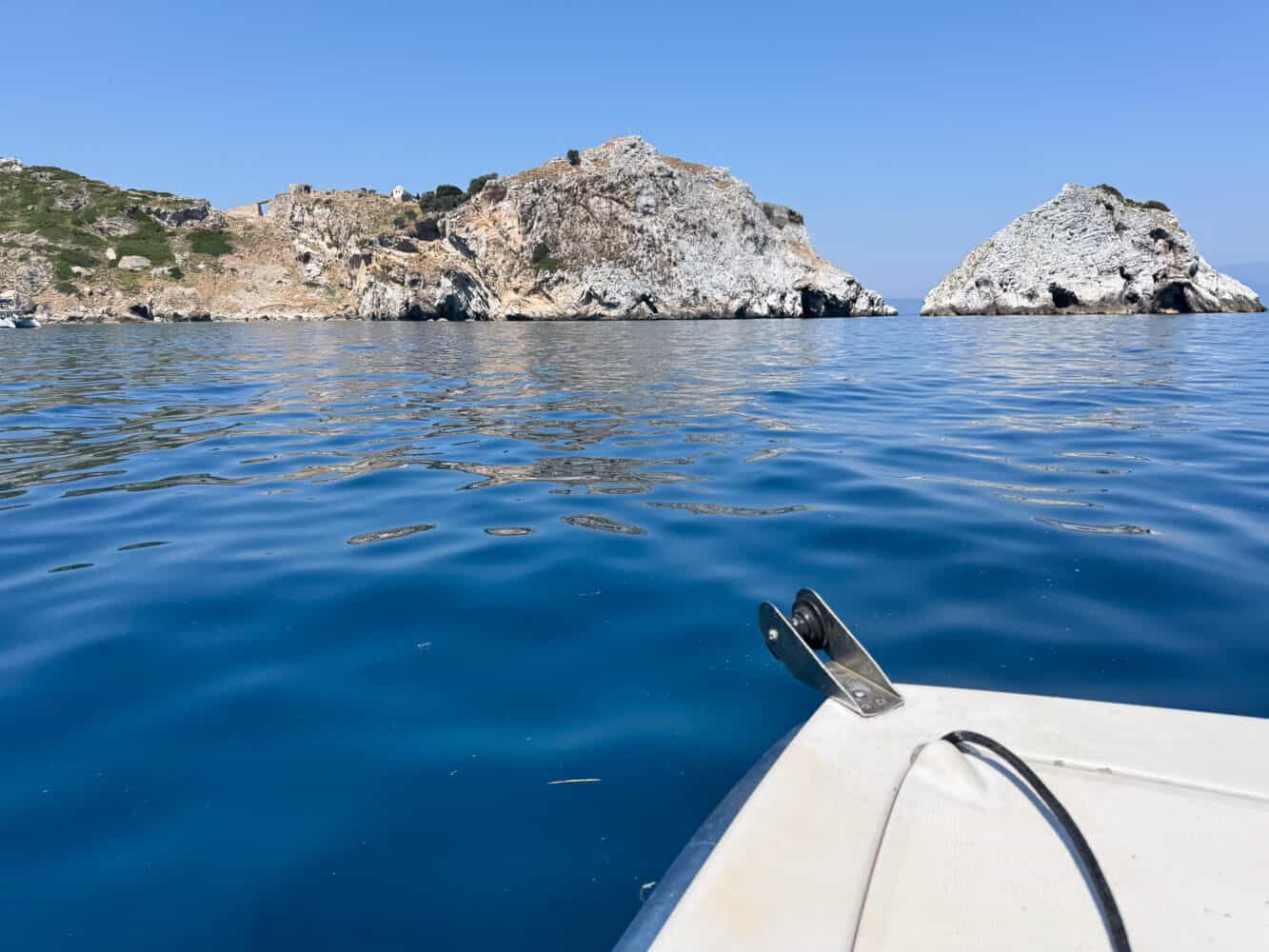
We found an empty bay just past here and enjoyed the serenity of our private beach and a swim in the astonishingly clear turquoise water.
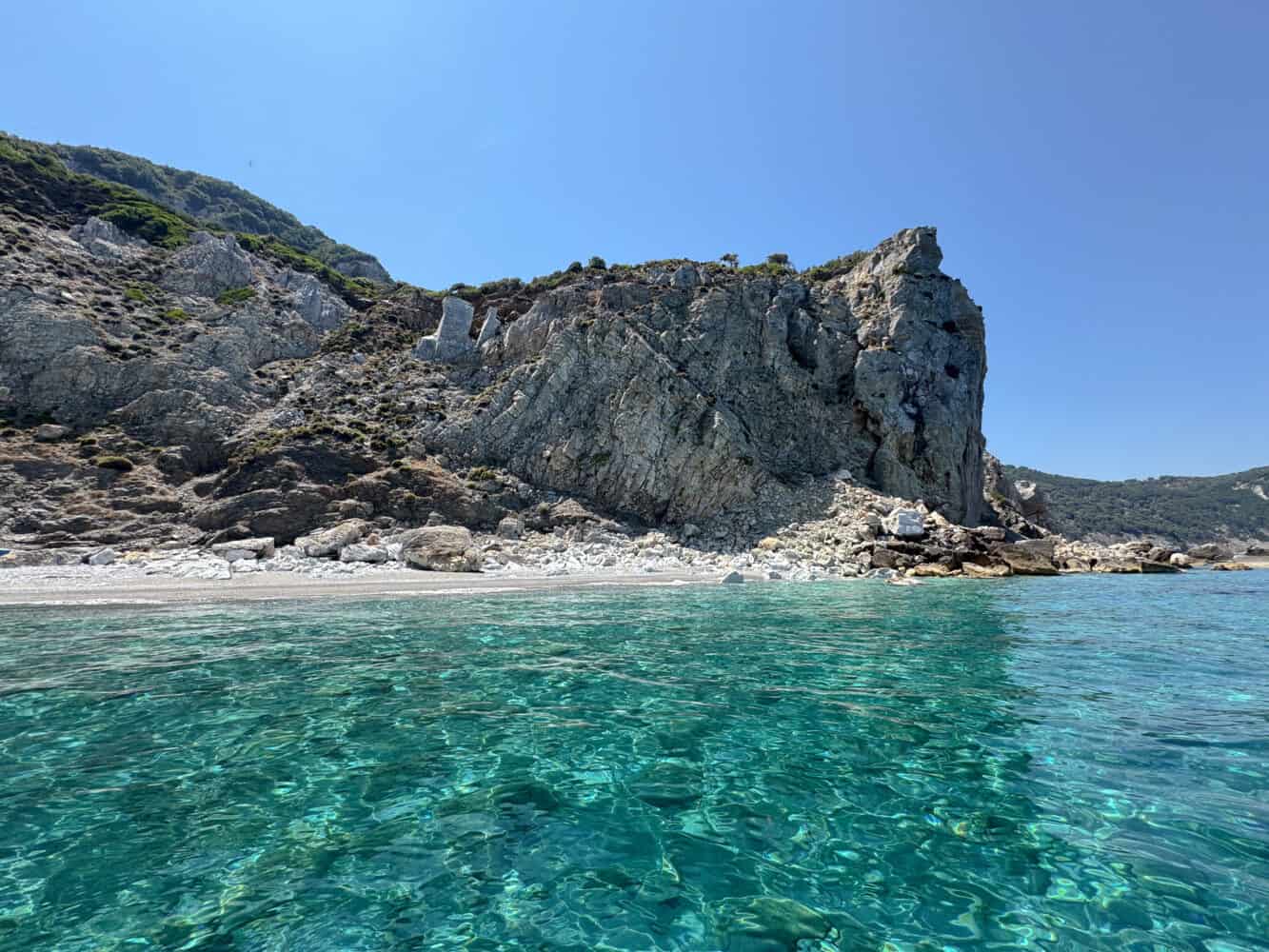
We continued on past the northern beaches, choosing the ones we wanted to return to by road. We had a packed lunch with us, but Taverna Ligaries was recommended by the boat owners if you don’t mind swimming to shore (we returned another day and highly recommend it).
We stopped for more swims at an empty beach past Megalos Aselinos Beach and again just past Troulos on the south coast. There are so many options, but it makes sense to focus on the less developed north.
Our final stop was Tsougria Island, which has a couple of lovely beaches and incredible water. There are tavernas on both beaches.
It was our favourite day in Skiathos and we highly recommend renting a boat if you have the budget. The freedom to stop at any beach you want is wonderful.
Skiathos Town
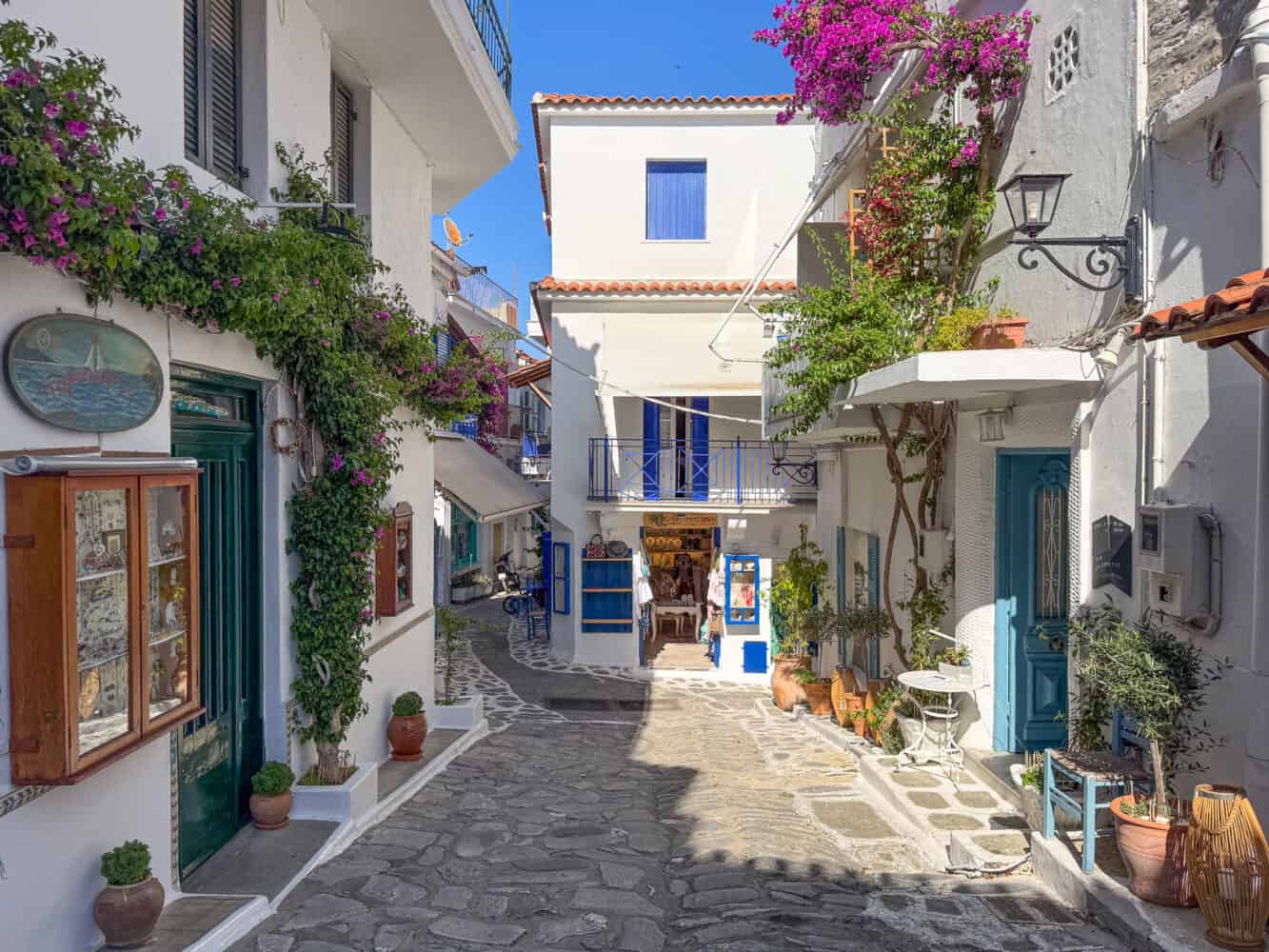
While our days were spent on the beaches, our nights were filled with wandering and dining in Skiathos Town. The capital is the only significantly sized town on the island (although there are clusters of accommodation and restaurants along the south coast).
It’s a picturesque place that feels quintessentially Greek—cobbled lanes, whitewashed buildings with blue shutters, and vibrant pink bougainvillaea. Tavernas spill into the streets, and you can dine under vines.
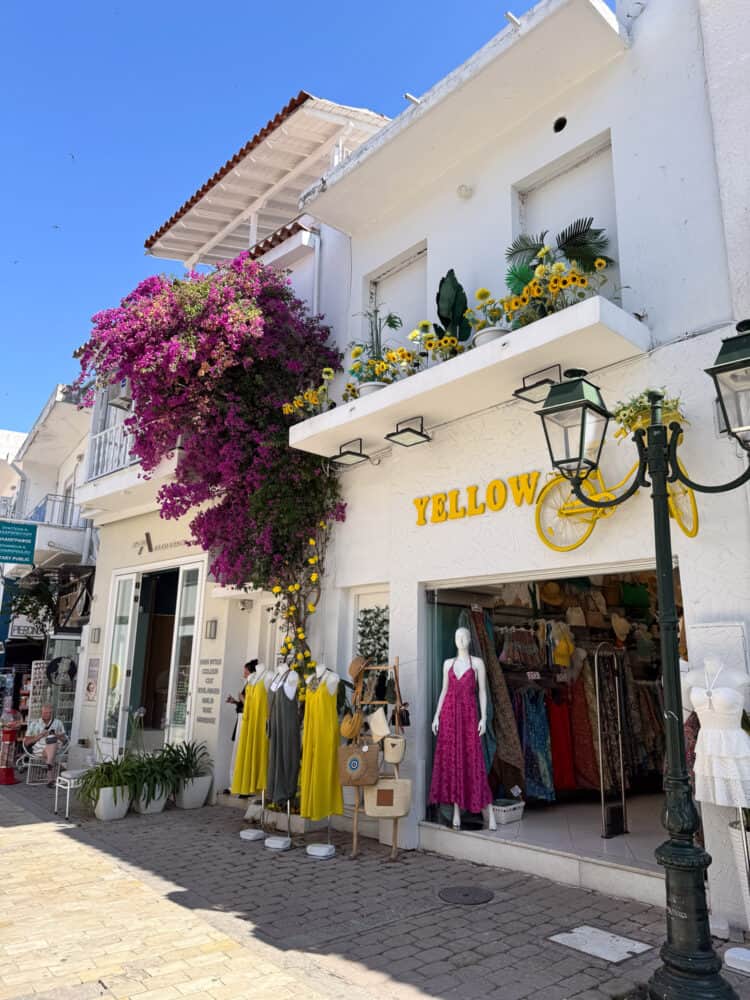
The Old Port is a great place to stroll, enjoy a drink, and take a boat tour. There’s plenty of nightlife in this area, but earlier in the evening, the scene is chilled.
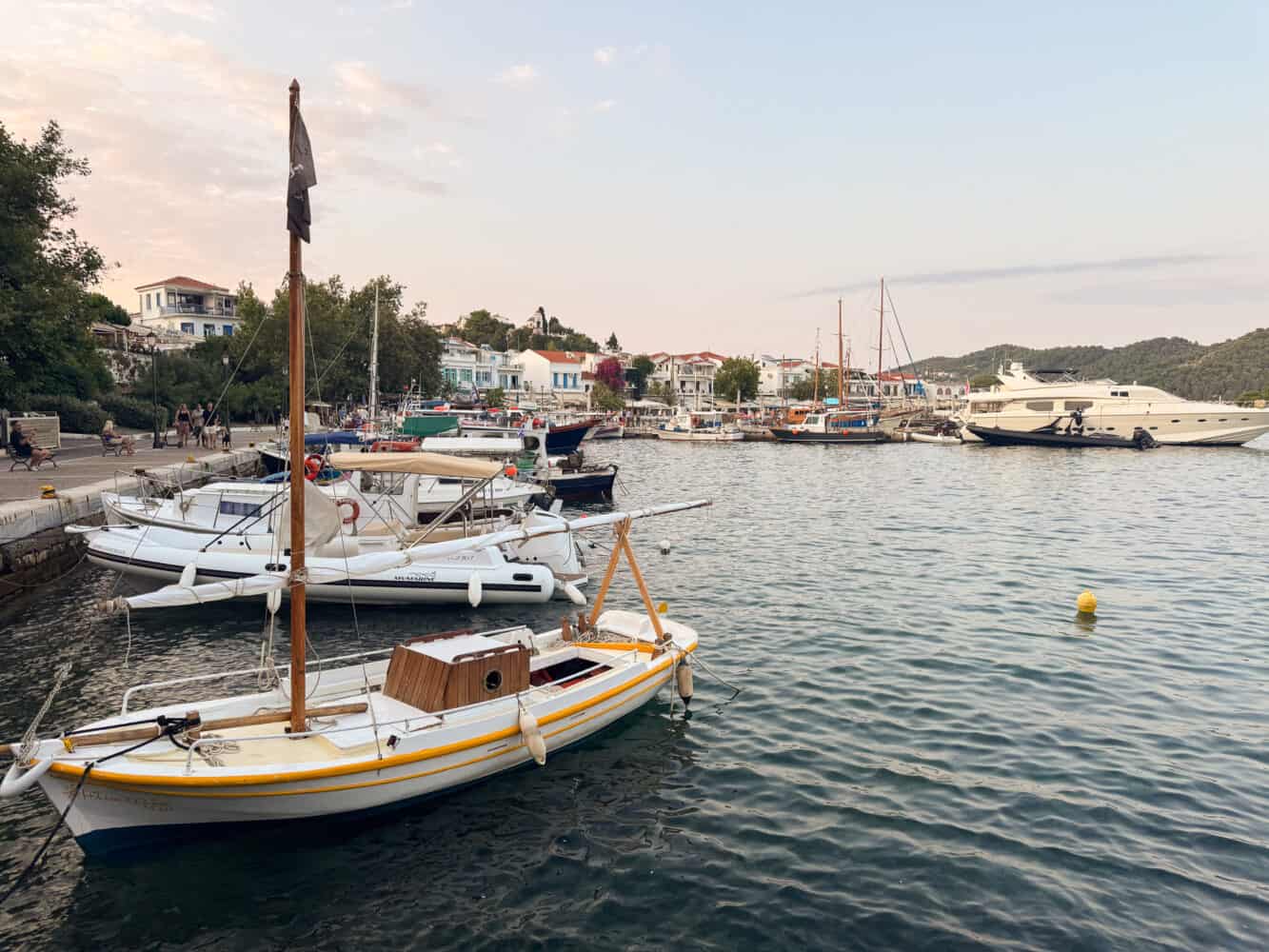
Mostly what we did in Skiathos Town was eat—see our favourite spots below.
Our Favourite Restaurants in Skiathos
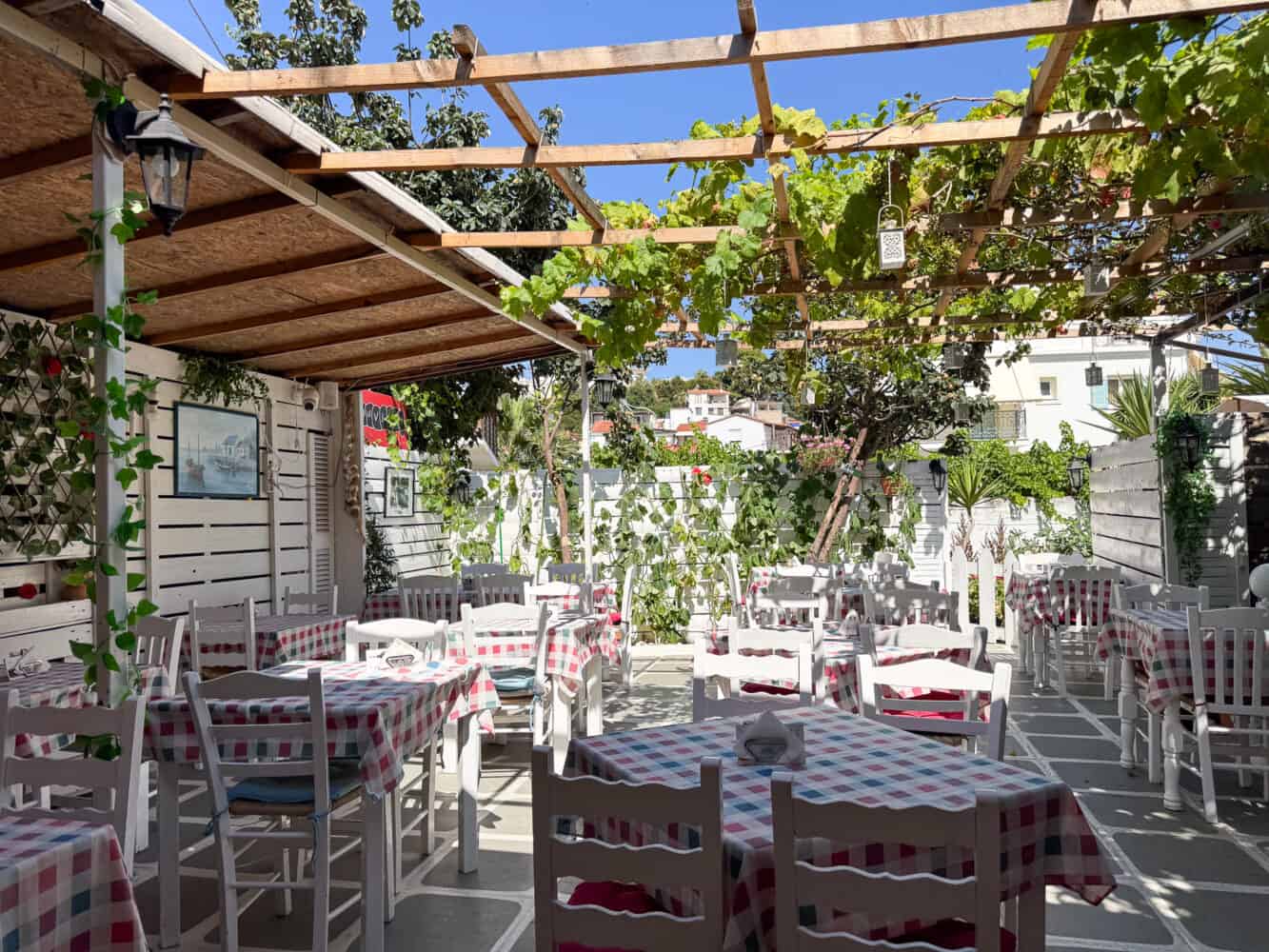
We found the food quality generally high on Skiathos, except for a few beach bars on the south coast (pick up a pastry or sandwich from a bakery on the way instead).
We’re vegetarians and found good options for us everywhere, especially on the starters menu—we preferred a selection of shared mezze instead of mains.
Use our Skiathos map below to check the Google Maps listings and see the latest opening hours. Many restaurants close in the off-season.
Skiathos Town
- I Love Souvlaki – We kept going back for the delicious halloumi pitta. It’s quick and affordable (under €5) and they have a lovely vine-filled garden (or you can opt for a takeaway).
- Alaska – We ate gelato here almost every night. All the flavours were so good, but the After Eight Mint Stracciatella was my favourite. Simon loved the Banoffee. The tables outside are perfect for people-watching on the main street.
- Marmita – A very popular restaurant (book days ahead) with elegant versions of local dishes. The grilled Mastelo cheese was our favourite dish of the trip. Vegetarian and vegan options are marked on the menu. The vegan moussaka is popular, but I found it a bit heavy in the heat and wished I’d ordered more starters and salads. The cacio e pepe wasn’t that great (Simon’s fault for ordering a Roman dish in Greece).
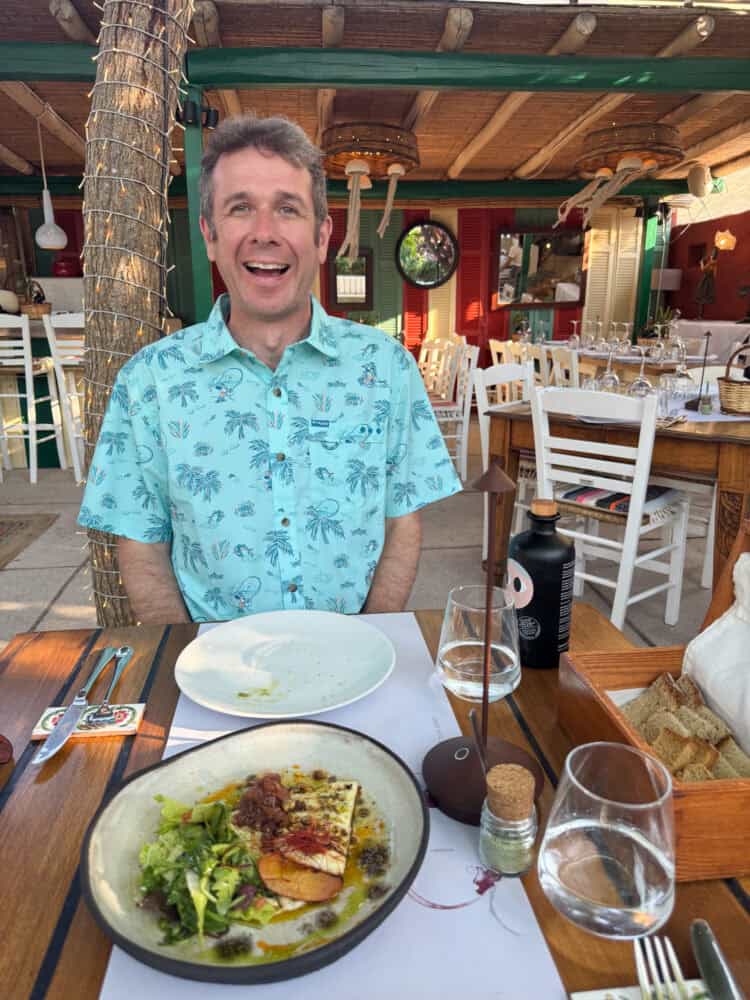
- Nikos Restaurant – Affordable mezze with a variety of vegetarian and vegan options marked on the menu. The outside seating was a bit cramped, and the meat cooking outside might deter some vegetarians. For pittas, I prefer I Love Souvlaki, but there is a good range of dishes here.
- Avlios Yard Restaurant – A pretty courtyard setting and tasty mezze. Our bread was straight from their wood-fired oven (they also do pizzas).
- To Palouki – Classic taverna with charming seating on a side street. It’s more affordable than many places and our mezze were good, if nothing special. They have a vegan moussaka we didn’t try. There are lots of cute restaurants nearby.
- Las Ramblas – Simon’s favourite place for coffee. They have single-origin beans. Stick to the espresso, as the V60 was not well brewed.
North Skiathos
We were surprised to have two of our favourite meals at somewhat remote beaches on the north coast.
These are classic Greek tavernas with simple but delicious food, perfect for a break on a beach day. We enjoyed a selection of mezze and Greek salad at both.
- Taverna Ligaries (open for food from 12.30pm – 6pm) on Ligaries Beach.
- Maria’s Taverna (also called Kryfi Ammos Restaurant) on Krifi Ammos.
Where We Stayed on Skiathos
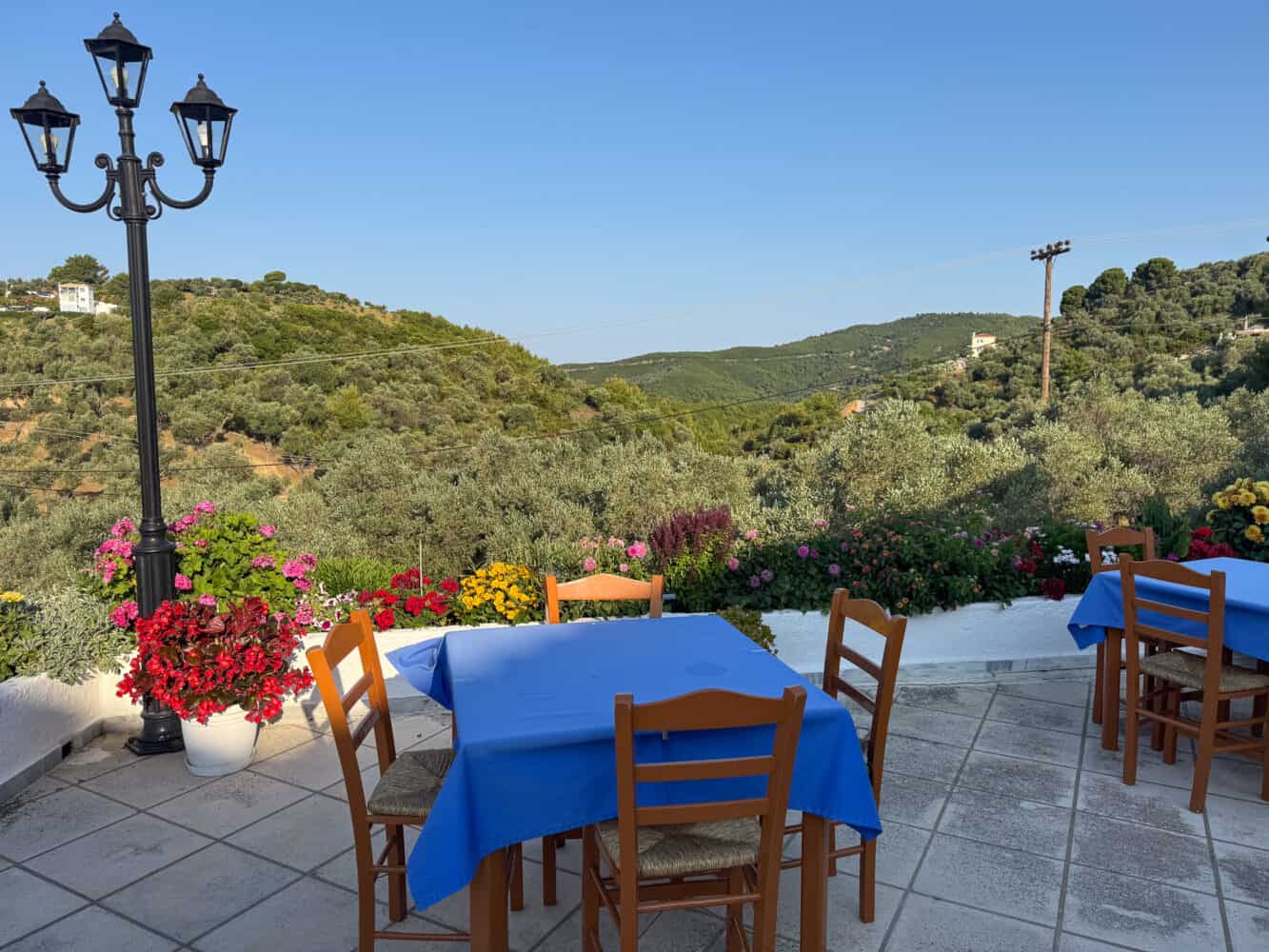
There’s a wide range of accommodation on Skiathos, almost all of it on the south coast.
Skiathos Town has some affordable options and is convenient for bus travel, but we preferred being in a more natural setting.
We stayed at Hotel Paradise up a hill, a 10-minute drive outside Skiathos Town. They have a free shuttle bus into town, but it’s fairly limited, so we preferred renting a motorbike.
We liked the peaceful location and the views of the sea and hilly interior.
There’s a pool, but it was only open from 10am – 6.30pm, and we didn’t use it. Pool/beach towels aren’t provided so bring your own or buy them on the island (around €10).
This is an old-school, family-run hotel. Our room was basic, with rather dated decor, but it had a balcony with a sea view. The bed was quite comfortable, and we had plenty of storage space.
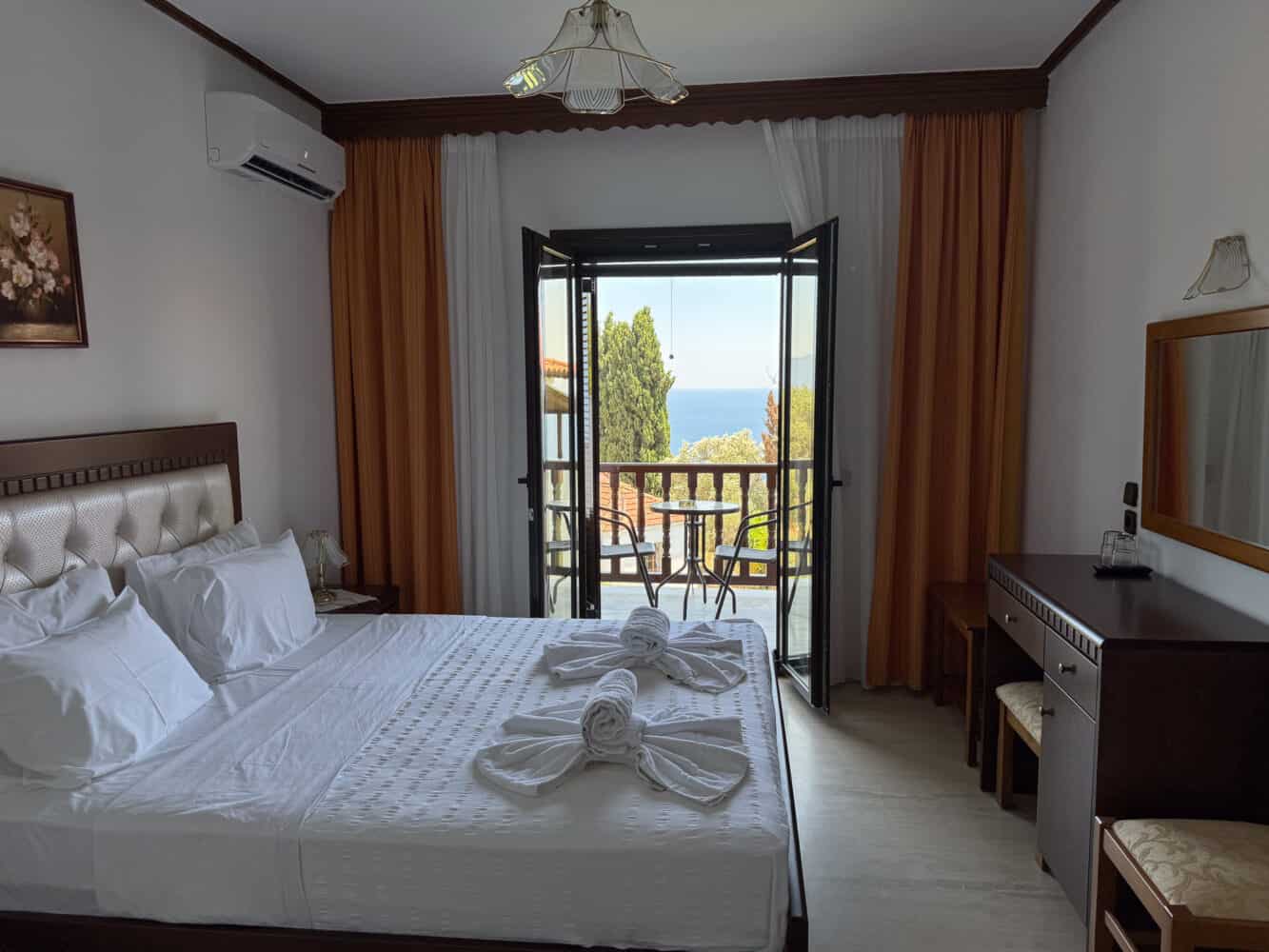
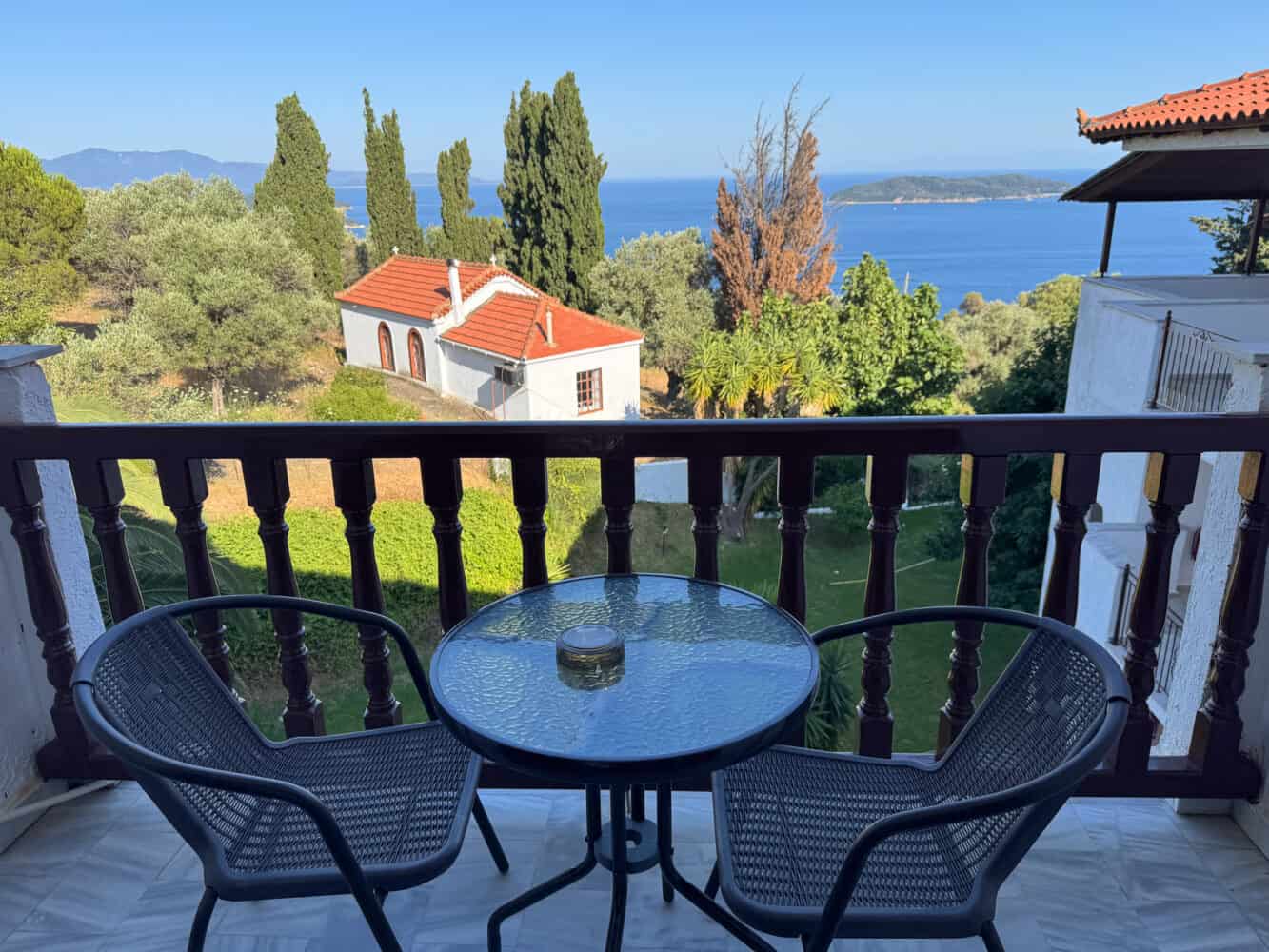
Rooms have fridges and air conditioning but no kettles. I recommend stocking your fridge as drinks in the hotel are expensive.
It’s a sprawling hotel without a lift. We were furthest from reception on the 2nd floor, and it was a bit of a maze to get there with lots of stairs. If you have mobility issues, ask for a ground-floor room near reception.
Breakfast was a basic buffet, but I enjoyed my Greek yoghurt and fruit. Simon thought the coffee was terrible, so he went into town to Las Ramblas.
Overall, Hotel Paradise was a solid budget-friendly hotel that attracts an older crowd. We liked the location, but it might be a bit isolated for some.
Check prices and availability for Hotel Paradise on Booking.com.
Getting to Skiathos, Greece
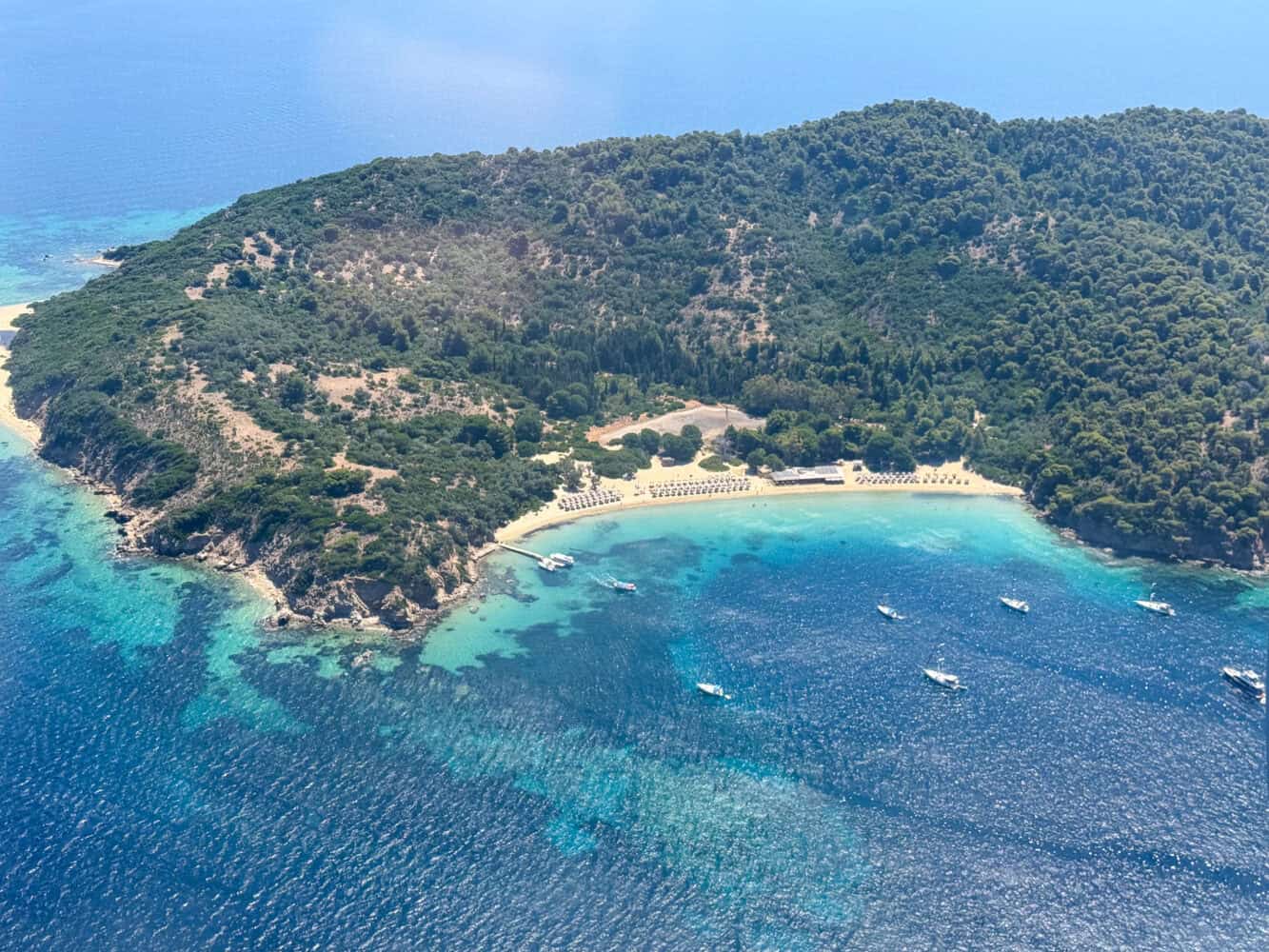
Skiathos is one of the Sporades islands. There’s an international airport (JSI) with direct flights from various European cities.
We flew from London Gatwick with Tui. Flights were expensive, so book far in advance. There are also flights from the UK with Easyjet, British Airways, and Jet2.
You can also arrive by ferry from Volos and Mantoudi on the Greek mainland.
Skopelos Island is only 30 minutes away on the quickest ferry, so you could combine the islands (I’d like to do this next time).
You can use a site like Ferry Hopper to find routes and book.
Skiathos Map
Is Skiathos Worth Visiting?
Skiathos is definitely worth visiting if you’re looking for a relaxed island with lots of beautiful beaches.
It’s easy to get there and get around (even the furthest beach was only 30 minutes from our hotel).
Skiathos Town is charming with good shopping, dining, and nightlife, but it’s the only major town on the island.
There’s not much to do on Skiathos beyond the beaches (although in a cooler month, I’d have liked to try the hiking trails), but if you’re looking for sand and sea, Skiathos is an excellent choice.
More Greece Posts
If you enjoyed this post, pin it!
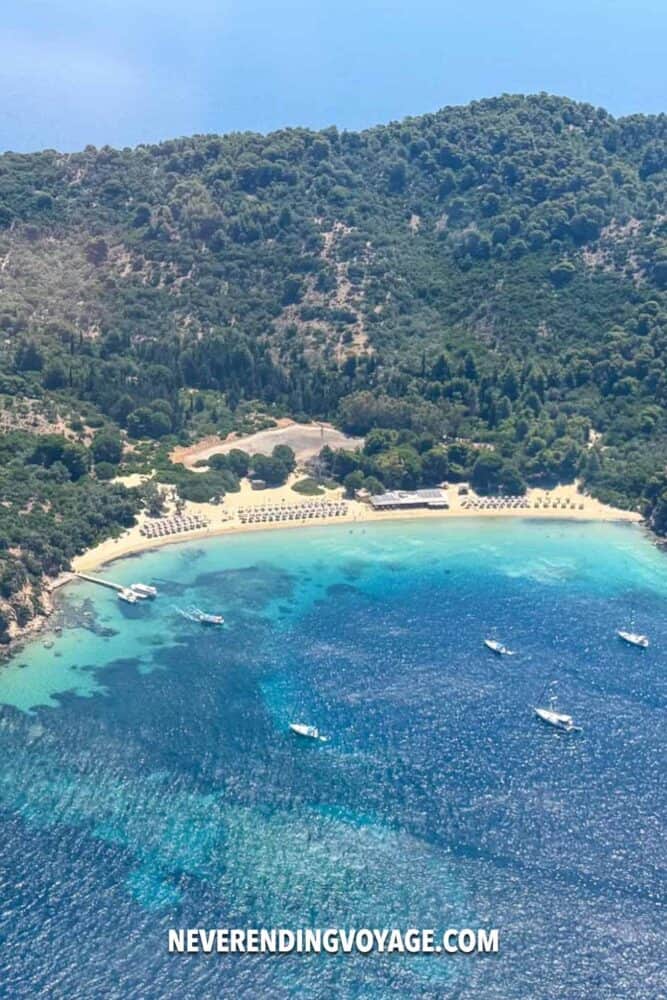
18 Best Things to Do in Syracuse, Sicily 20 Jun 3:36 AM (4 months ago)
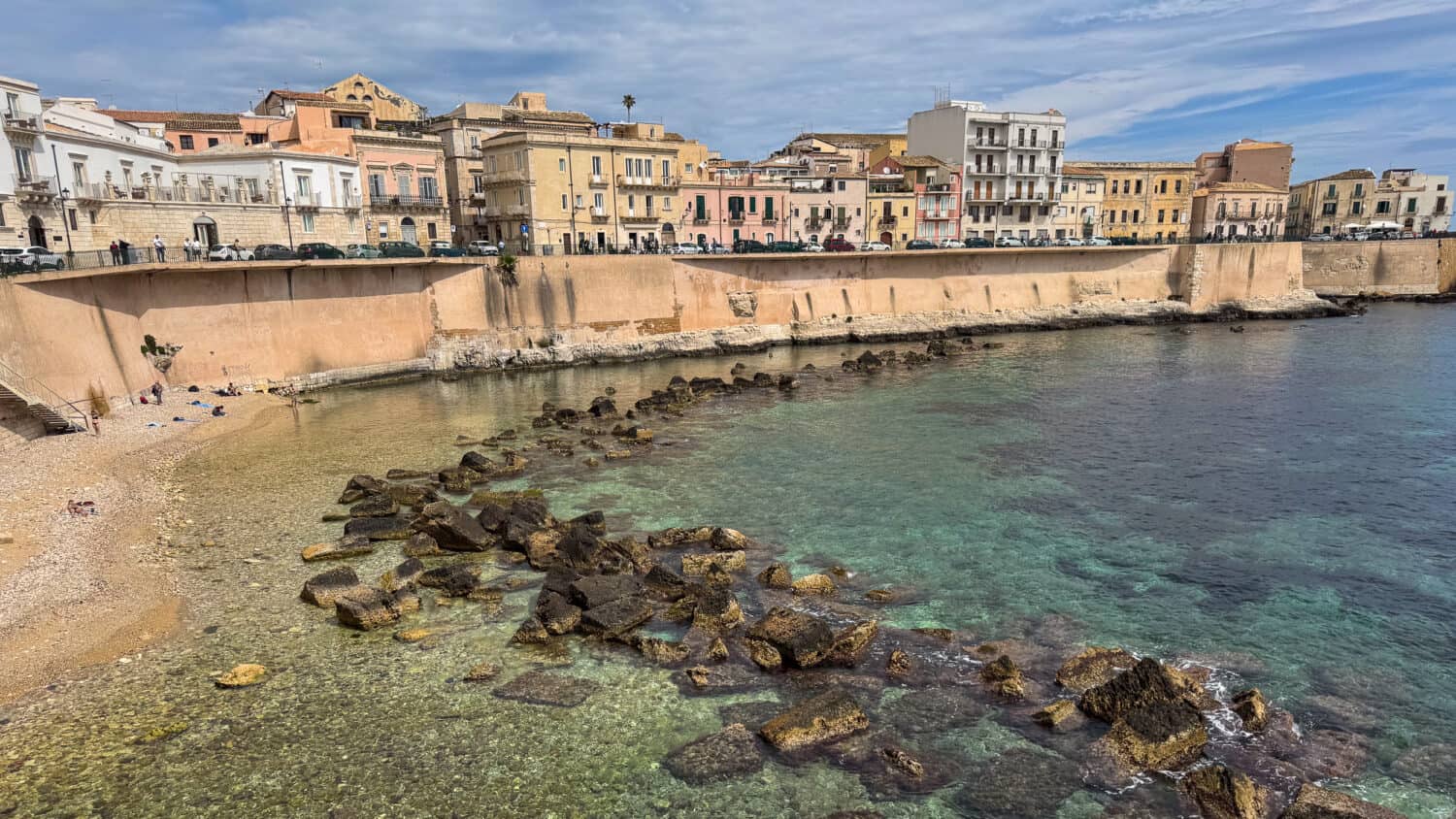
Syracuse, Sicily (not the one in New York), or Siracusa in Italian, is known for its rich Greek and Roman history with ancient ruins dating back to the 6th century BC.
The highlight is Ortigia, an island connected to the mainland by a bridge. This is Syracuse’s old town, where it was founded by ancient Greeks.
It’s the most beautiful part of the city with a maze of medieval lanes, Baroque palaces, and a cathedral that shows Sicily’s many layers of history.
Simon and I spent a week getting lost in alleyways, strolling the seaside promenade, and eating delicious street food. We also used it as a base to explore the Val di Noto with its many Baroque towns.
In this Syracuse travel guide, I share the best things to do in Syracuse and Ortigia, as well as how to get there and where to stay. At the end, you’ll find a map with everywhere mentioned.
Contents
- Where is Lake Molveno?
- Best Things to Do in Molveno
- Where We Stayed: Grand Hotel Molveno Review
- Where to Eat in Molveno
- How to Get to Lake Molveno, Italy
- Lake Molveno Map
- Is Lake Molveno Worth Visiting?
- More North Italy Posts
- Where is Camogli, Italy?
- Best Things To Do in Camogli Village
- Best Hikes and Day Trips from Camogli
- Our Favourite Places to Eat in Camogli
- Where to Stay in Camogli
- How to Get to Camogli
- Camogli, Italy Map
- Is Camogli Worth Visiting?
- More Italian Riviera Tips
- Location of Hotel Cenobio dei Dogi, Camogli
- History of the Hotel
- Our Room at Hotel Cenobio dei Dogi
- Swimming Pool
- Private Beach
- Restaurants
- Other Facilities
- Hotel Cenobio dei Dogi Pros and Cons
- Cost of Hotel Cenobio dei Dogi
- Final Thoughts
- More Italian Riviera Posts
- Getting to Camogli
- When is the Camogli Fish Festival?
- Sagra del Pesce Camogli Schedule
- Friday Night: The Festival Begins
- Saturday: Bonfires and Fireworks
- Sunday Fish Fry
- Is the Camogli Fish Festival Worth Visiting?
- More Liguria Posts
- Hiking The Blue Trail in Cinque Terre
- Corniglia to Manarola via Volastra Hike Details
- Getting to Corniglia: The Start of the Hike
- Corniglia to Volastra Trail
- Volastra
- Volastra to Manarola Trail
- Corniglia to Manarola Hike Map
- Final Thoughts
- More Liguria Posts
- Skiathos Tips
- Beaches in Skiathos
- Renting a Boat
- Skiathos Town
- Our Favourite Restaurants in Skiathos
- Where We Stayed on Skiathos
- Getting to Skiathos, Greece
- Skiathos Map
- Is Skiathos Worth Visiting?
- More Greece Posts
- Our Top Picks in Syracuse, Sicily
- Best Things to Do in Syracuse (Ortigia)
- Things to Do in Syracuse (Mainland)
- Day Trips from Syracuse
- Where to Stay in Syracuse
- How to Get to Syracuse, Italy
- Syracuse Map
- Is Syracuse Worth Visiting?
- More Sicily Tips
Our Top Picks in Syracuse, Sicily
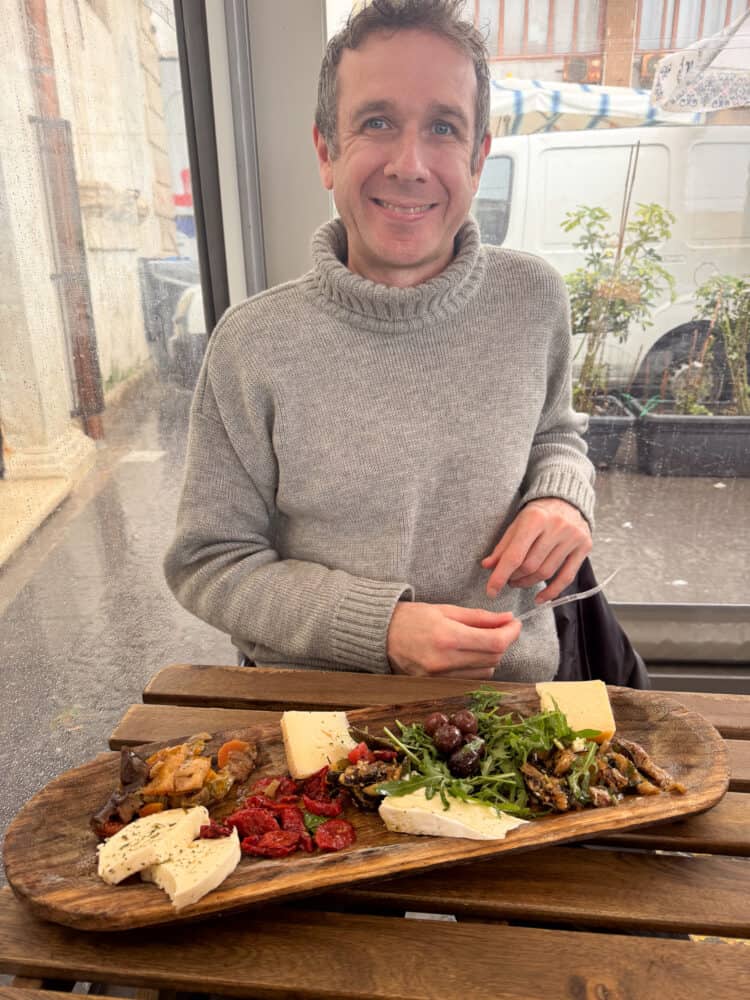
Best Activity: Street Food Walking Tour
Best Lunch: Tagliere (tasting platter) at Caseficio Borderi
Best Gelato: Pistachio at Levante Gelato Artigianale
Best Pizza: Piano B
Best Day Trip: Ragusa Ibla
Best Things to Do in Syracuse (Ortigia)
You’ll spend most of your time in Syracuse in Ortigia, the island old town. It’s by far the most beautiful part of the city with most of the attractions and lots of great places to eat and drink. Here are our picks:
1) Take a Street Food Walking Tour
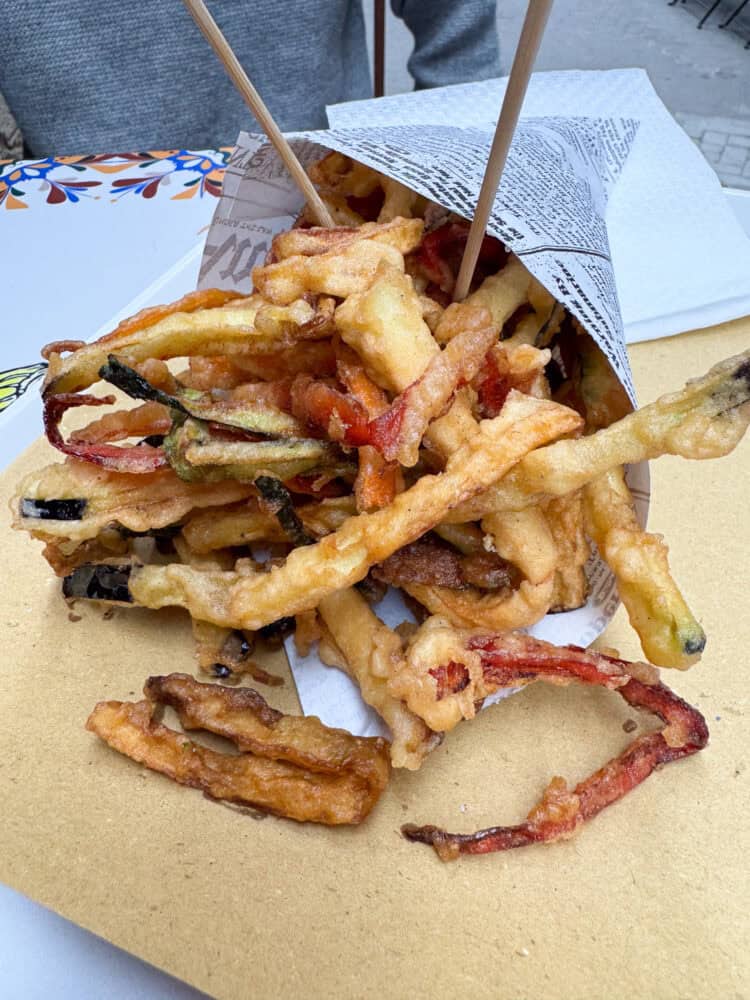
Although we’re generally not tour people, we love to take a food tour in Italy. As well as tasting lots of delicious food (every region has different specialities), we get an overview of the city and learn some history.
We did this three-hour Street Food Walking Tour in Ortigia, and it was excellent. At the beginning of April, we were the only people on the tour, and Giuseppe taught us lots about the city and Sicily’s history.
You definitely want to go hungry to this tour. We started with a giant platter in the market and continued on trying fried vegetables, melanzana parmigiana (eggplant parmesan), impanata (a type of pie), granita, and cannoli. Wine at one stop was also included.

I’d done a lot of food research for our trip, and we still went to places I hadn’t heard of, many of which have been run by the same family for generations.
Our guide easily catered for us as vegetarians, and I think they’d be flexible if there’s anything you do or don’t want to eat.
It wasn’t just about the food, though—I fell in love with Ortigia on this tour, especially the backstreets of the Jewish Quarter.
We visited most of the places on the first half of this list on the tour, so it’s a good overview of the city. I recommend doing it on your first day.
Check prices and availability for the Street Food Walking Tour we did on Get Your Guide.
If you are vegan, check out this Syracuse Vegan Food Tour instead.
2) Eat Lunch at Ortigia Market
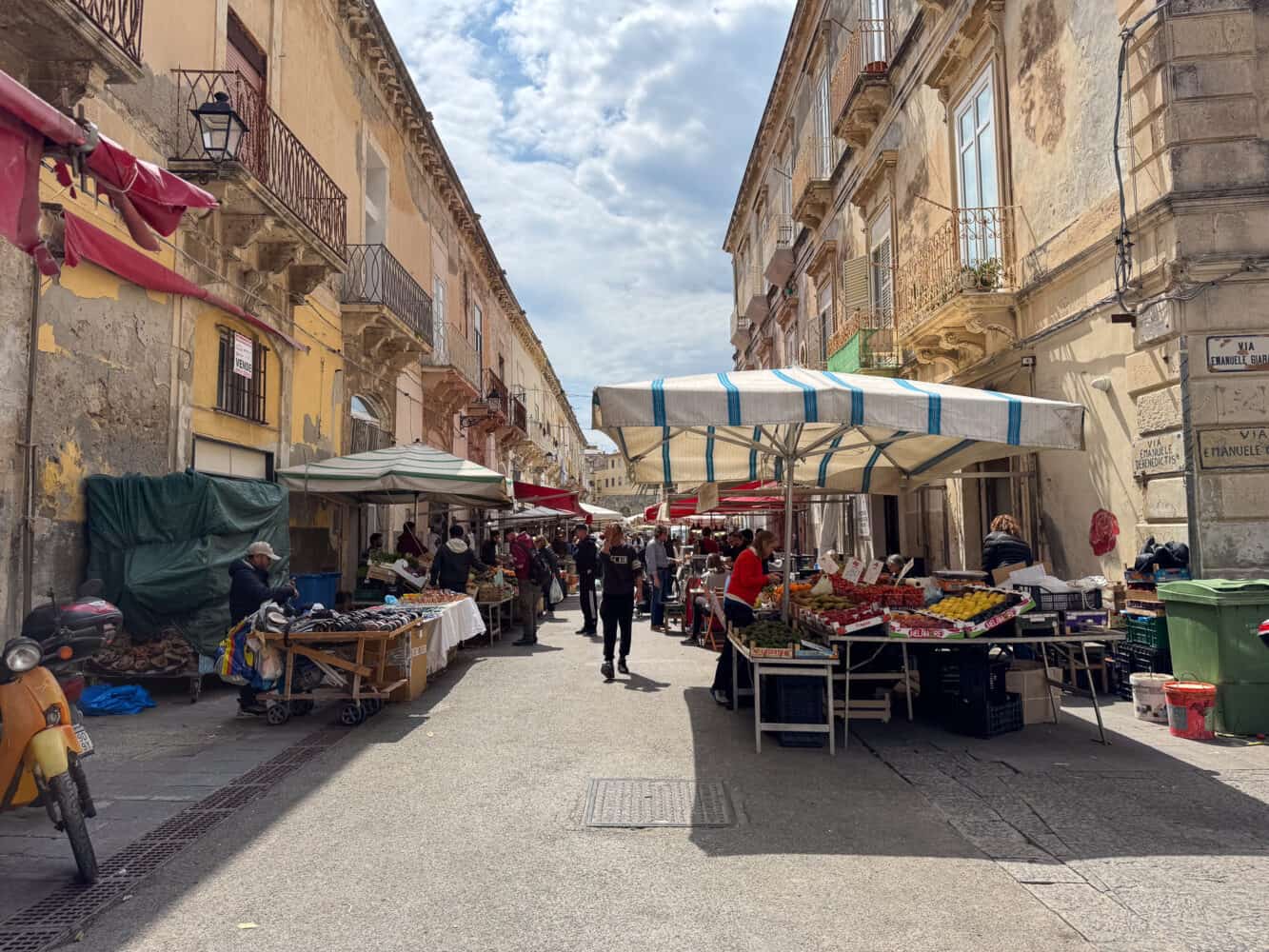
The Ortigia Market is small but mighty and an essential stop in Syracuse.
It’s open air with changing street stalls plus a few permanent shops/delis. You can buy fresh fruit, vegetables, nuts, olives, herbs, cheese, and fish.
It’s open on Monday to Saturday mornings from around 7am – 1pm (the shops open until 4pm). We found there were fewer stalls on a rainy day.
What we love most about the market is having lunch at one of the delis—one of the best things to do in Ortigia, for sure.
Our favourite is Caseficio Borderi, famous for its huge sandwiches. You can get a takeaway or sit at one of the outside tables opposite. It can be busy, so it’s best for an early lunch.
They have a selection of sandwiches, but most people recommend the Chef’s Choice (available vegetarian or meat), which is stuffed full of cheeses, marinated vegetables, sundried tomatoes, and more.
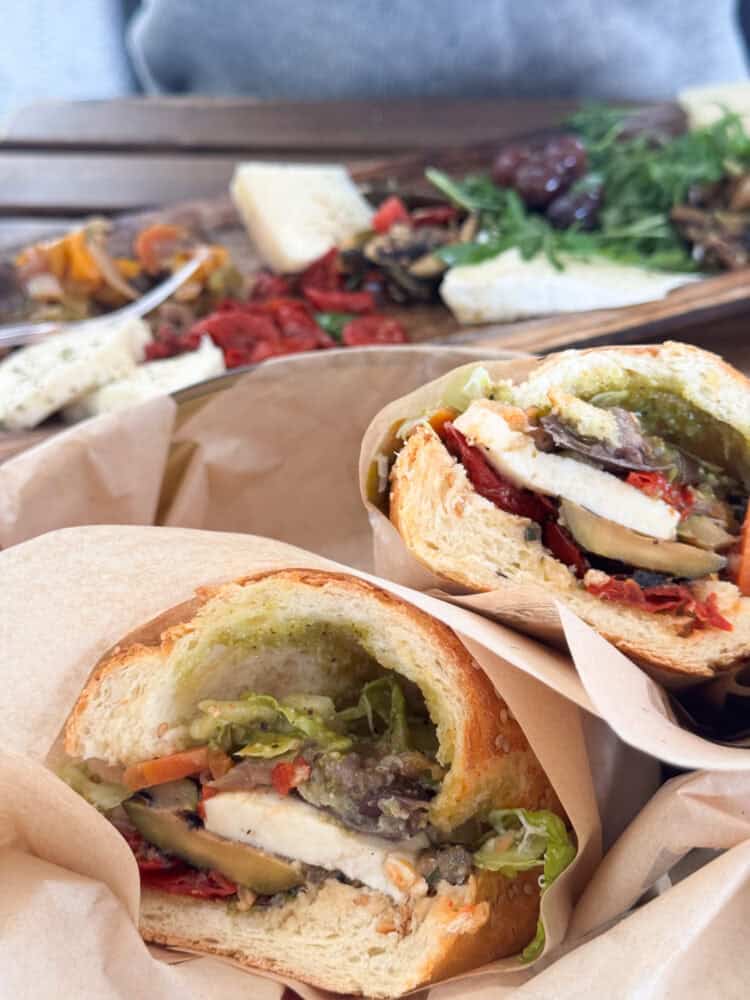
The sandwiches are very good, but we preferred the tagliere (platters). Our vegetarian version included some of their homemade cheeses (the freshly made mozzarella is especially delicious), plus lots of vegetables and Sicilian caponata.
Another option next door is Fratelli Burgio, which also offers excellent platters (they are known for their meat). The vegetarian version was less cheese-focused than at Borderi, so we didn’t enjoy it quite as much, but the selection of vegetables was still delicious.
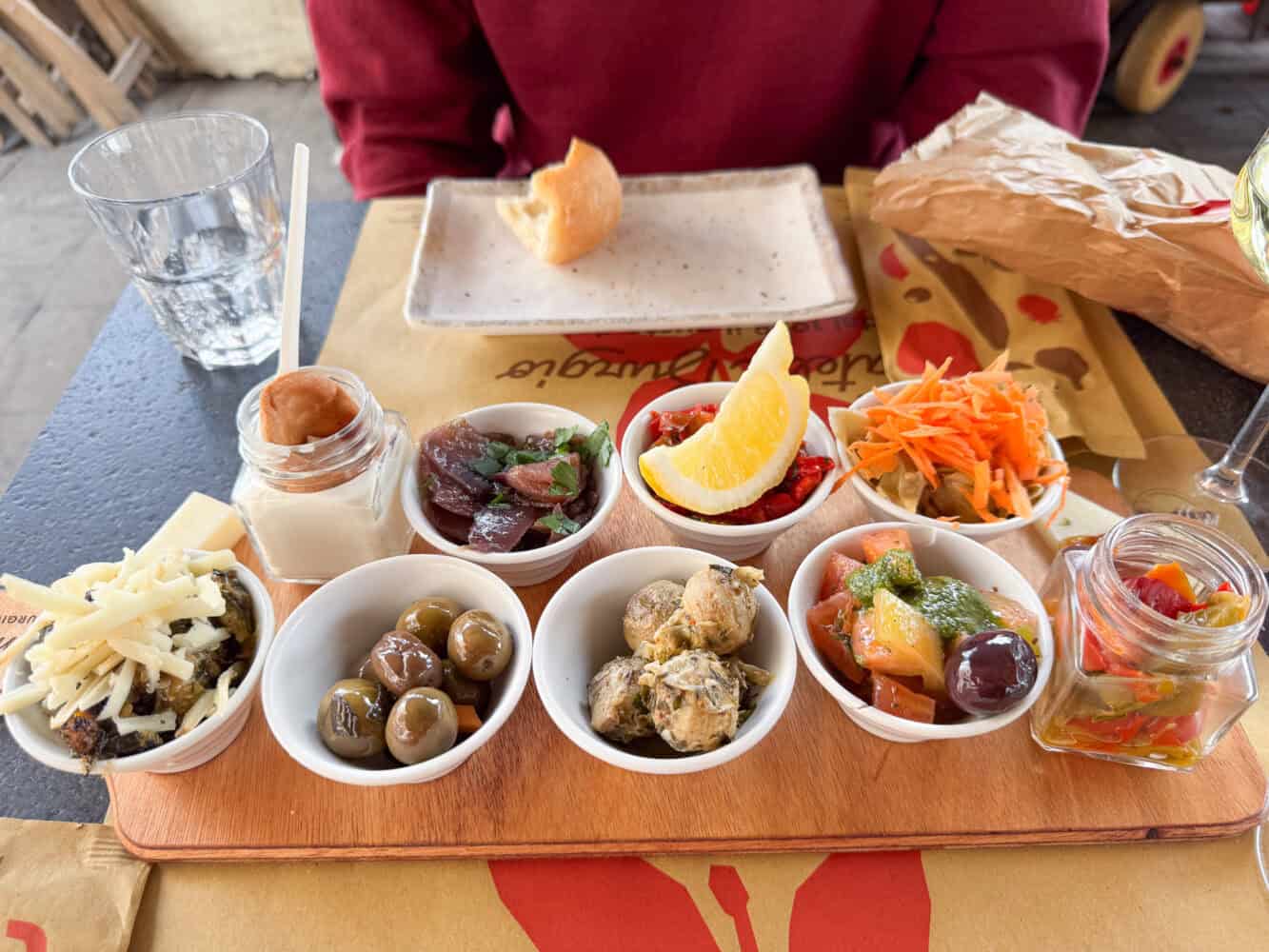
3) See the Temple of Apollo
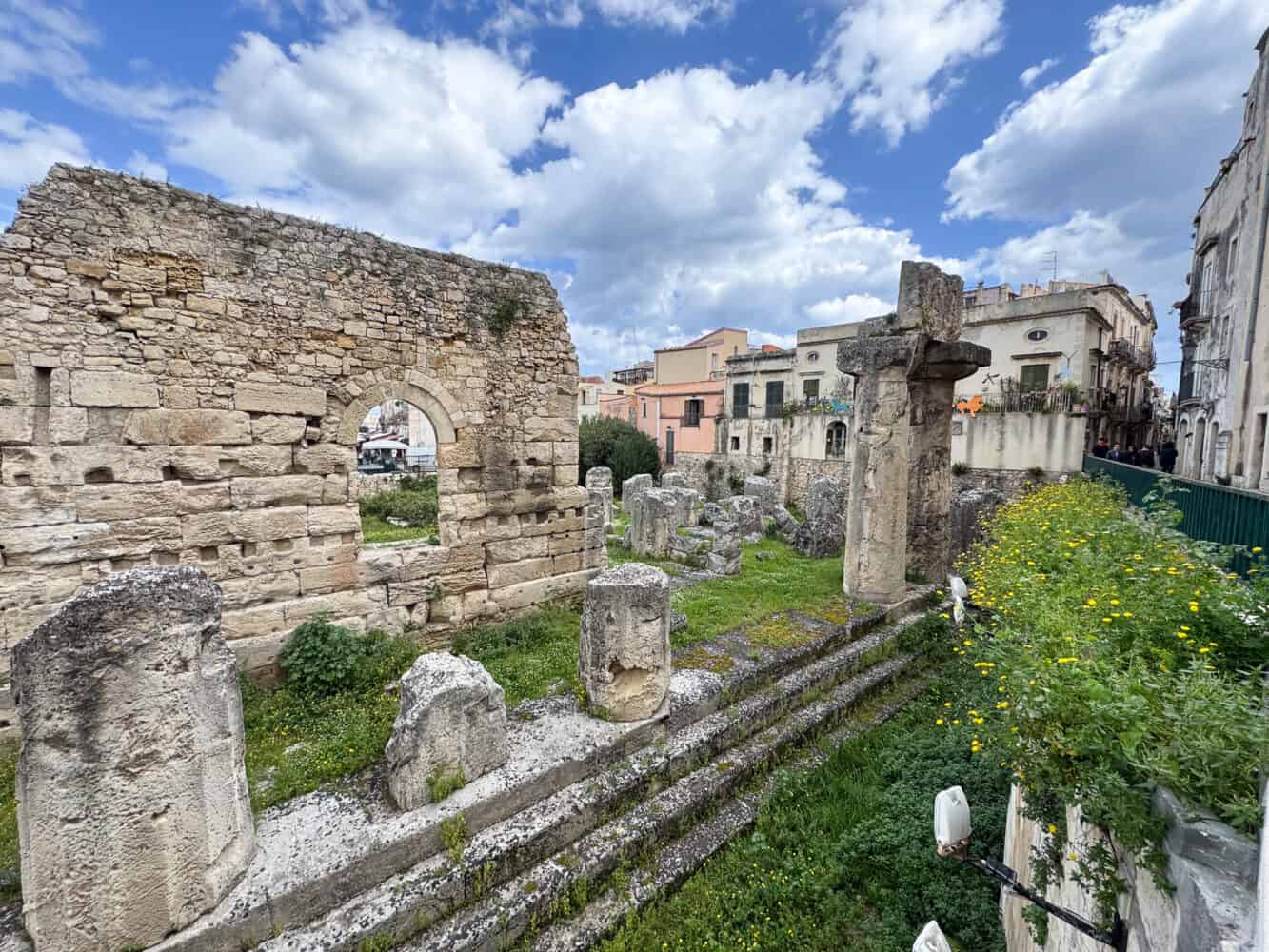
When you cross the bridge from Syracuse’s mainland onto Ortigia island, the Tempio di Apollo (Temple of Apollo) is the first sight you come across.
It’s one of the oldest Doric temples in the world, dating back to the 6th century BC.
You can’t enter the site but can easily see it outside. It has an overgrown garden vibe (often with cats sunbathing on the grass) and not much remains, but you can still see some columns and part of a wall.
Ortigia’s market is to the left of the ruins.
The following few items on this list are in geographical order for a self-guided walking tour.
Ortigia isn’t large, and it’s just a 17-minute walk from Tempio di Apollo to Castello Maniace at the southern tip of the island. But it’ll take longer with diversions, and there’s a lot to see along the way.
4) Admire the Diana Fountain
From Tempio di Apollo, walk down the modern shopping street Corso Giacomo Matteotti or the narrower, more charming lane Via Dione.
Both lead to Piazza Archimede, which has the beautiful Fontana di Diana (Diana Fountain) at its centre, built in 1907.
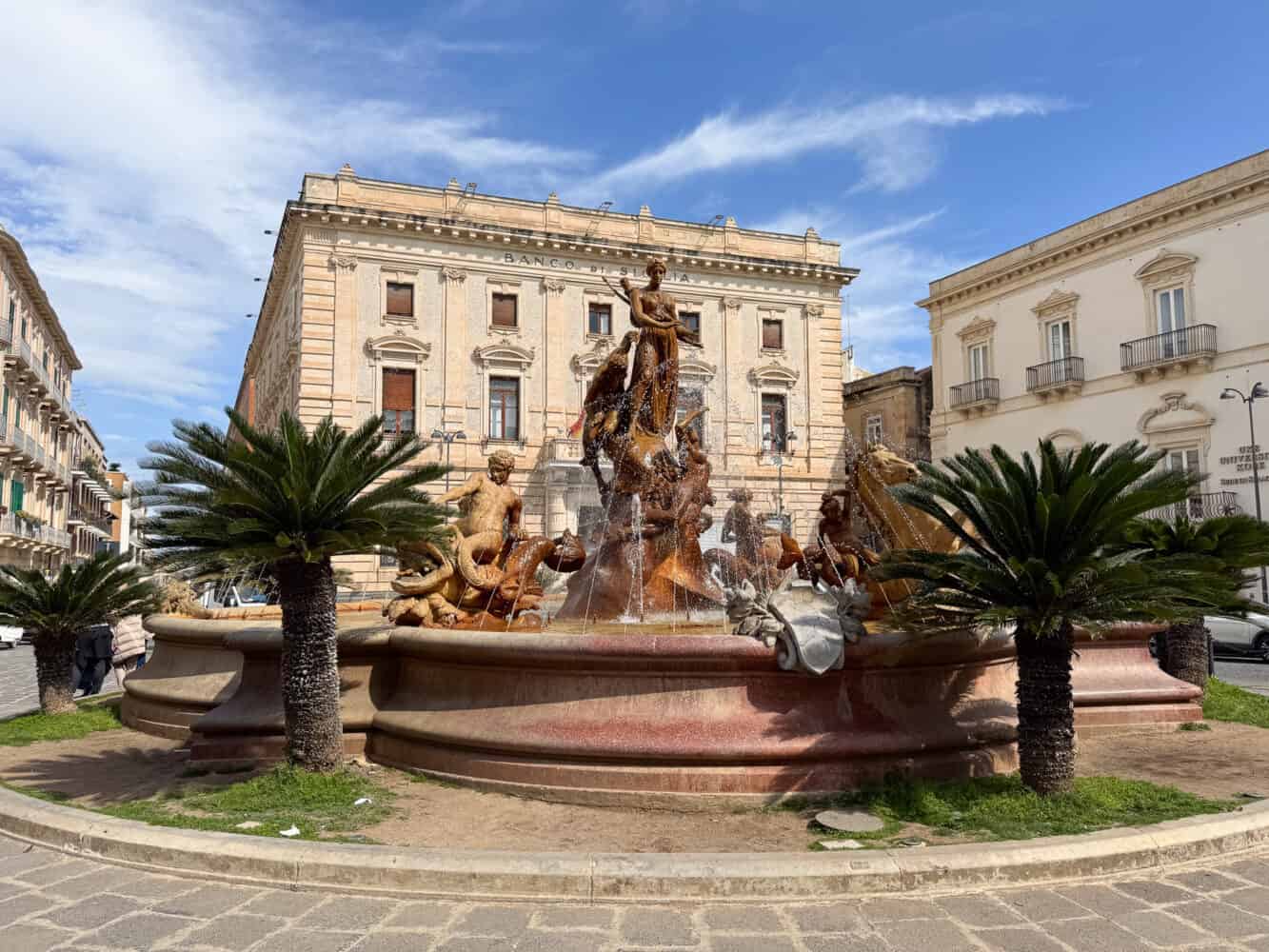
The Greek goddess Diana (or Artemis in Greek) protects Ortigia and stands with her hunting bow above other Greek characters, including Arethusa.
The cafes here are popular spots for an evening drink with locals (and us). Diana looks especially dramatic lit up at night.
5) See the Layers of History in the Duomo
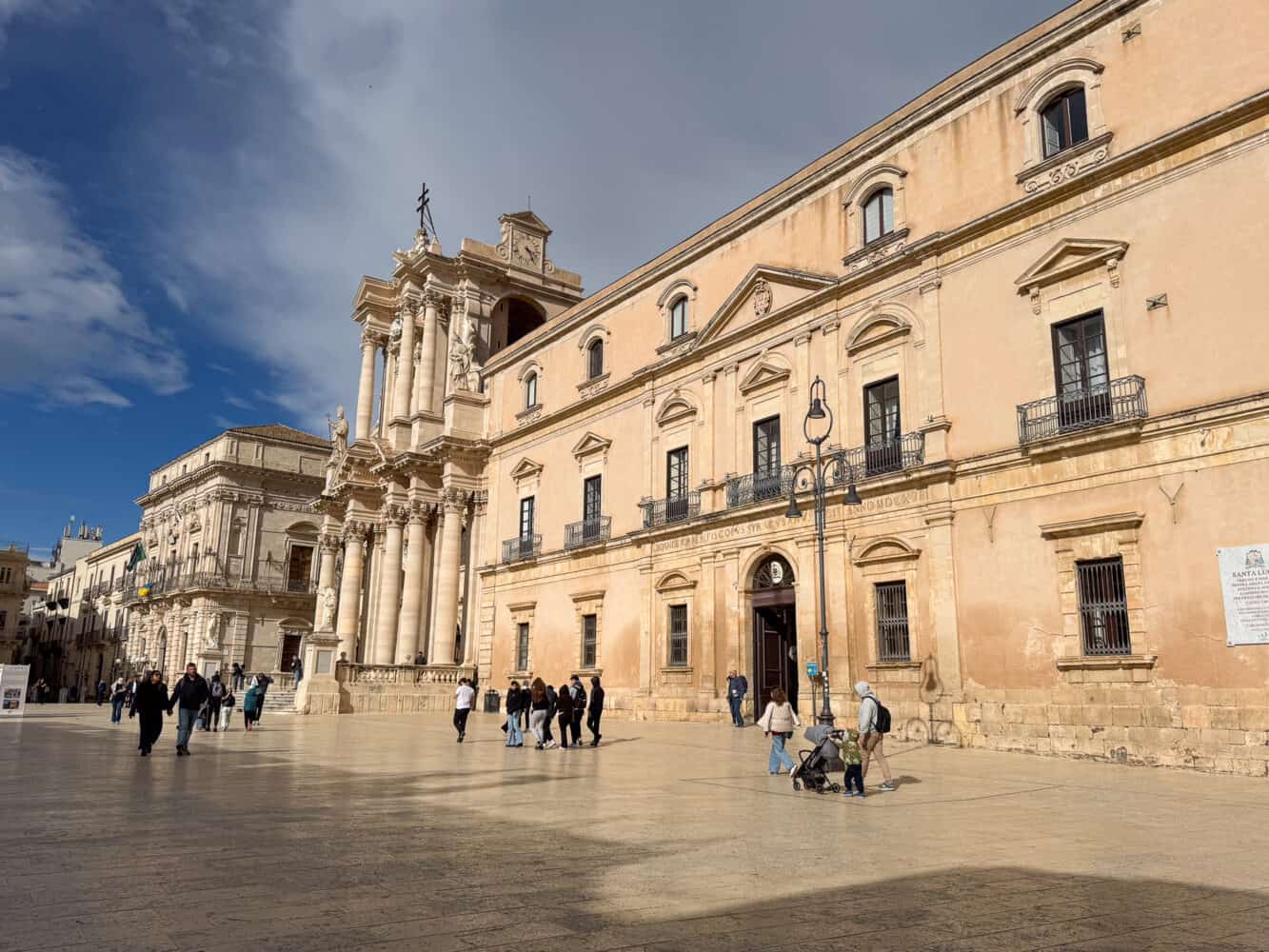
It’s not far south to Ortigia’s main square, the Piazza del Duomo, home of the stunning Duomo (Syracuse Cathedral).
The honey-coloured buildings here are typical of Ortigia, as much of it was built using limestone (in contrast to Catania, known as the Black and White City due to its use of volcanic stone).
On our food tour, we learnt to see the layers of history in the Duomo. On the left side of the building, you can see Greek columns from the original Doric temple (5th century BC) before the Catholics transformed it into a church in the 7th century.
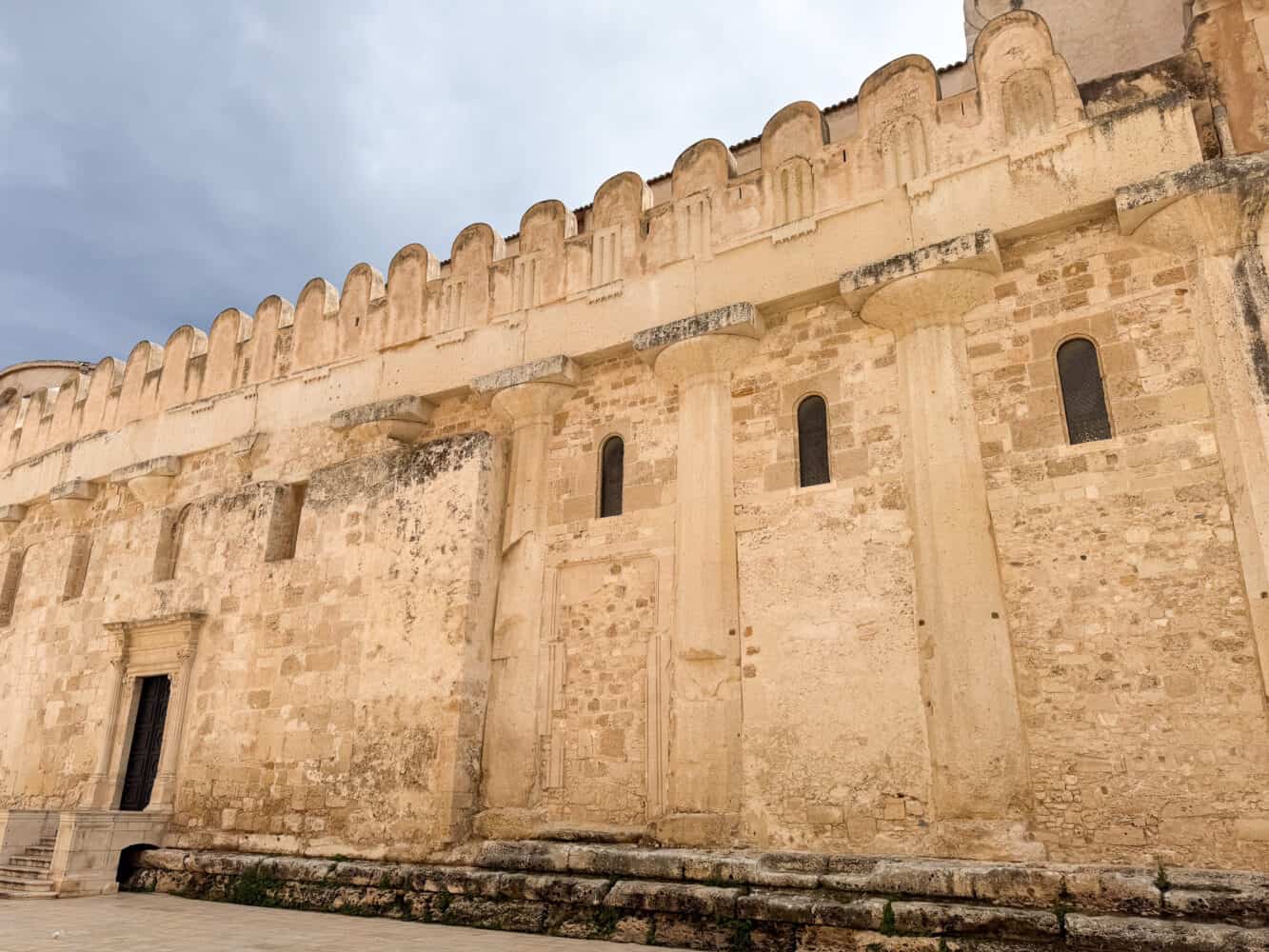
The architecture also shows Arab and Norman influences, but the highlight is the 18th-century Baroque facade with ornate sculptures.
Entrance to the Syracuse Cathedral costs €2, and it’s open Monday to Saturday from 9am-5.30pm (until 6.30pm in summer). Note that Google Maps has the wrong hours.
Inside the Duomo is much plainer, and we didn’t find it terribly exciting (I’m sure religion/history buffs would disagree).
A rather odd sight you can see nearby, down a side street, Via Santa Lucia alla Badia, is a small statue of Mary that sticks out from a wall and faces the sky. It’s marked on Google Maps as Madonnina Orizzontale.
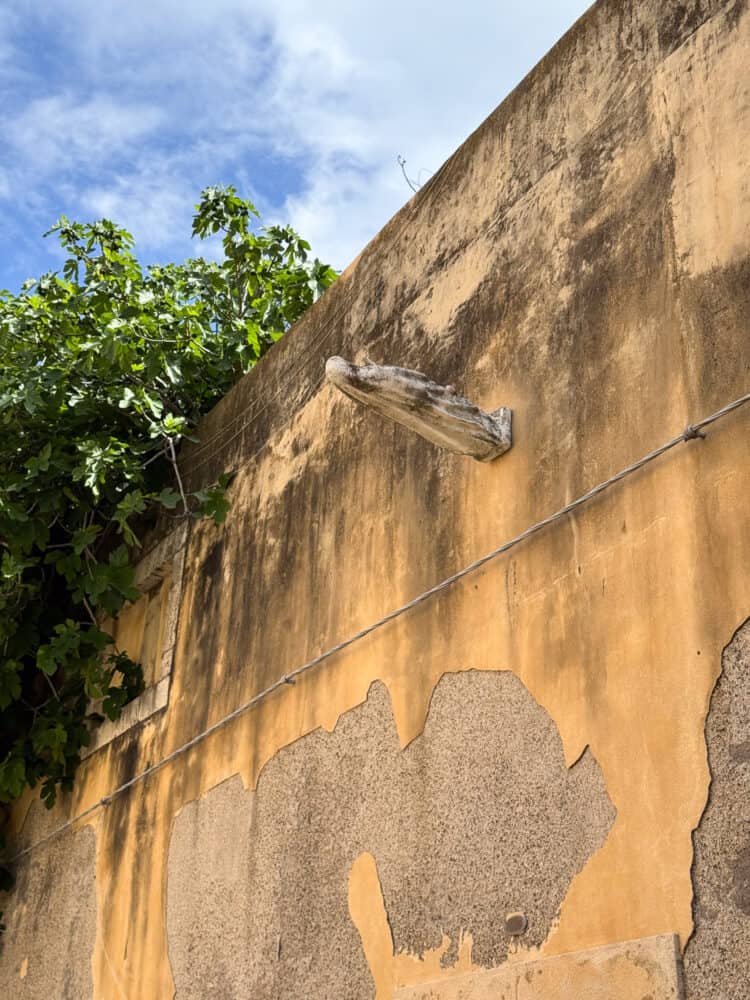
6) Spot Papyrus at Fonte Aretusa
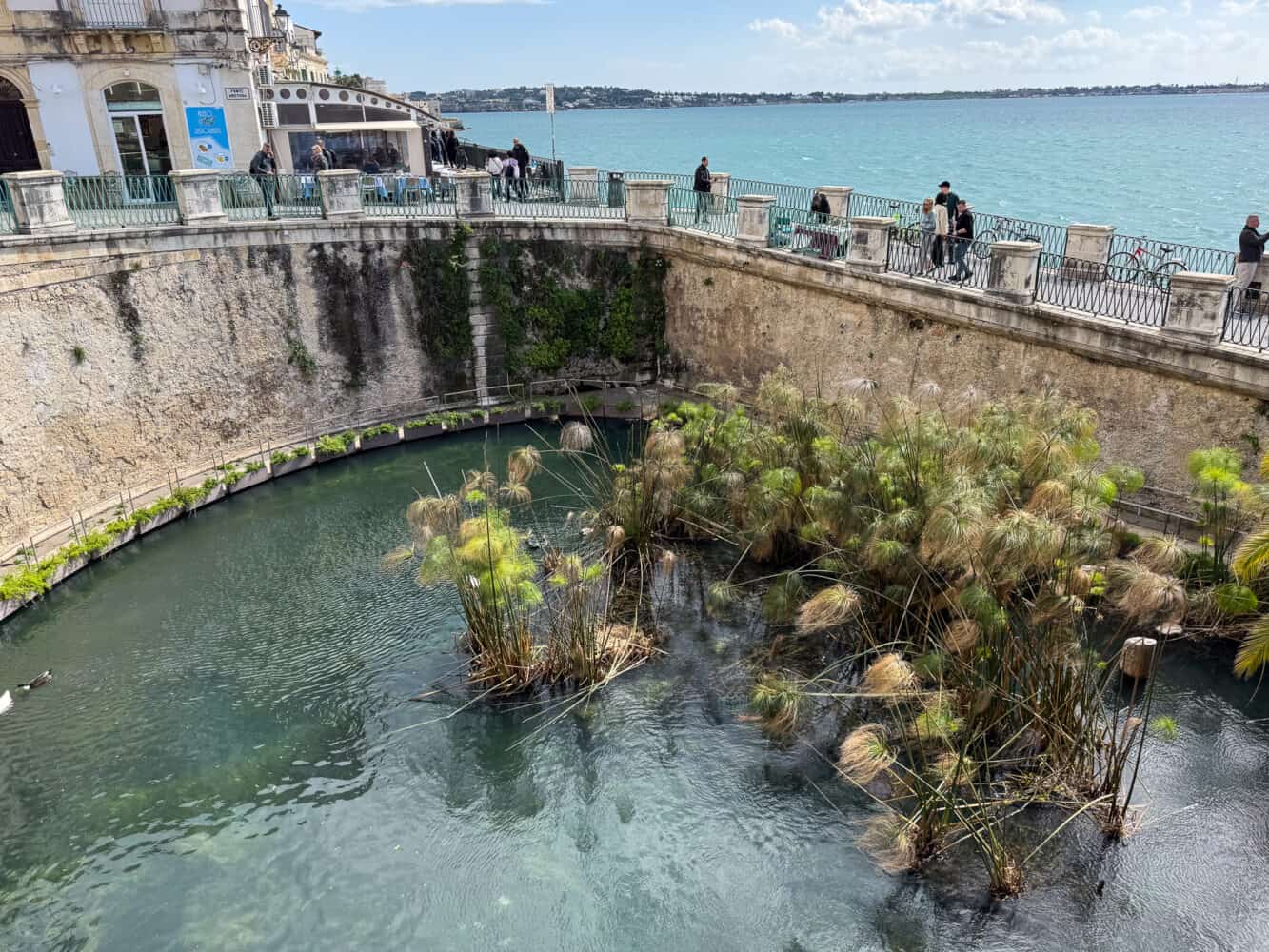
Continuing south, you’ll hit the seafront and another top attraction in Syracuse—the Fonte Aretusa.
This ancient, freshwater spring is right next to the sea and is the only place in Europe where you can see papyrus growing.
It’s a surprising and scenic sight in the heart of the city, with ducks paddling around.
From here, you can delve inland again to the Jewish Quarter or walk along the seafront promenade (covered in #8 below). Ideally, you should do both at some point.
7) Explore the Jewish Quarter
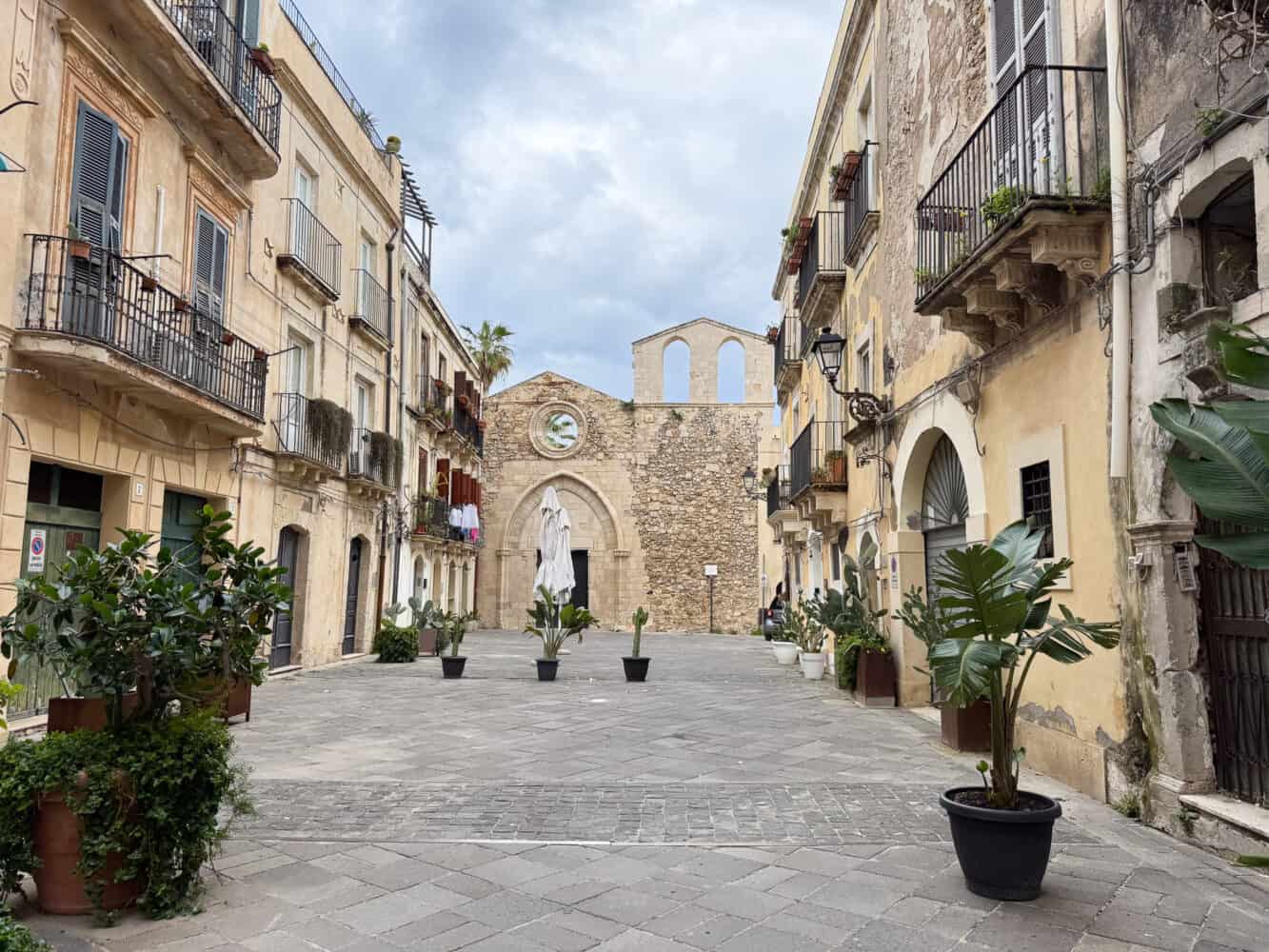
The Giudecca (Jewish quarter) is Syracuse’s oldest neighbourhood. It was home to a thriving Jewish community since at least 70 AD, until Jews were expelled from Sicily in 1492.
Although little remains of the original quarter, this southeast corner is one of the most picturesque parts of Ortigia and a good place to wander.
Start on Via della Giudecca and then delve down lanes between here and the sea.
On this street, you’ll find the Puppet Theatre (see below), good takeout places to eat (Antica Giudecca and U Siciliano Ortigia), and bars with a few tables on the street (we never made it to Taverna Giudecca, but it looked appealing).
One of the prettiest streets in Ortigia is Via del Crocefisso, a narrow residential lane where all the owners have potted plants outside their homes, creating an oasis-like feel.
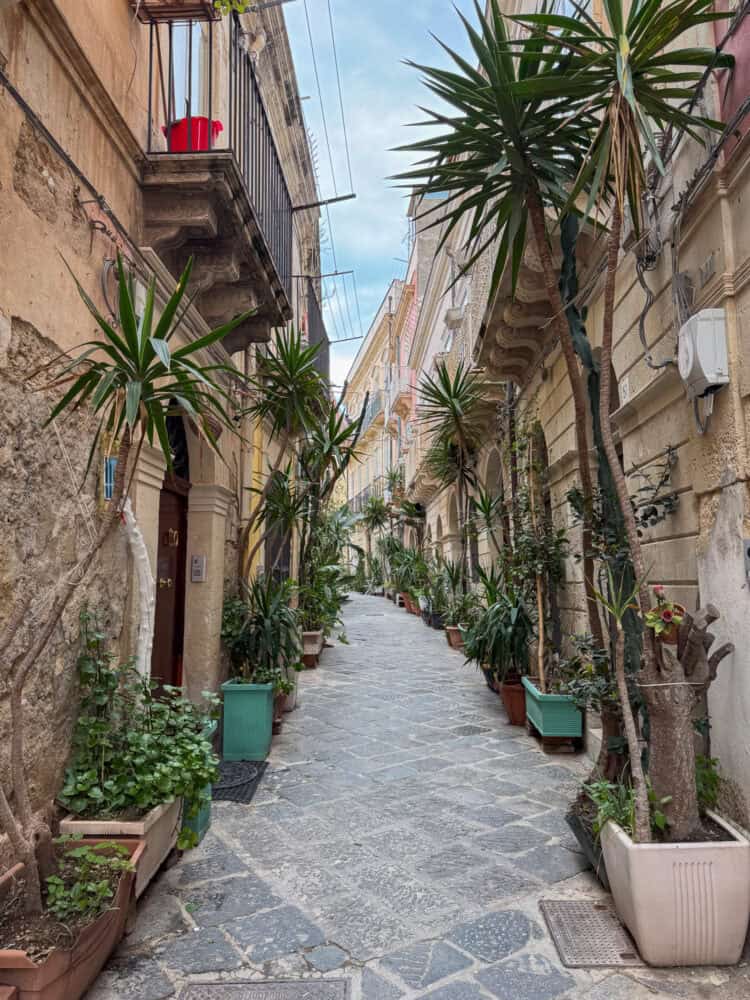
Chiesa di San Filippo Apostolo is a church in this area that was once a synagogue. You can take short underground tours for €5 (April to October) to see the original Jewish baths and crypt. The tunnels down here were also used as bomb shelters during WW2.
The Bagno Ebraico – Mikveh is another Jewish bath that offers tours.
Chiesa di San Giovanni Battista is a scenic church with no roof. You can’t enter it, though (unless you attend a wedding there).
8) Walk Around Ortigia’s Seafront
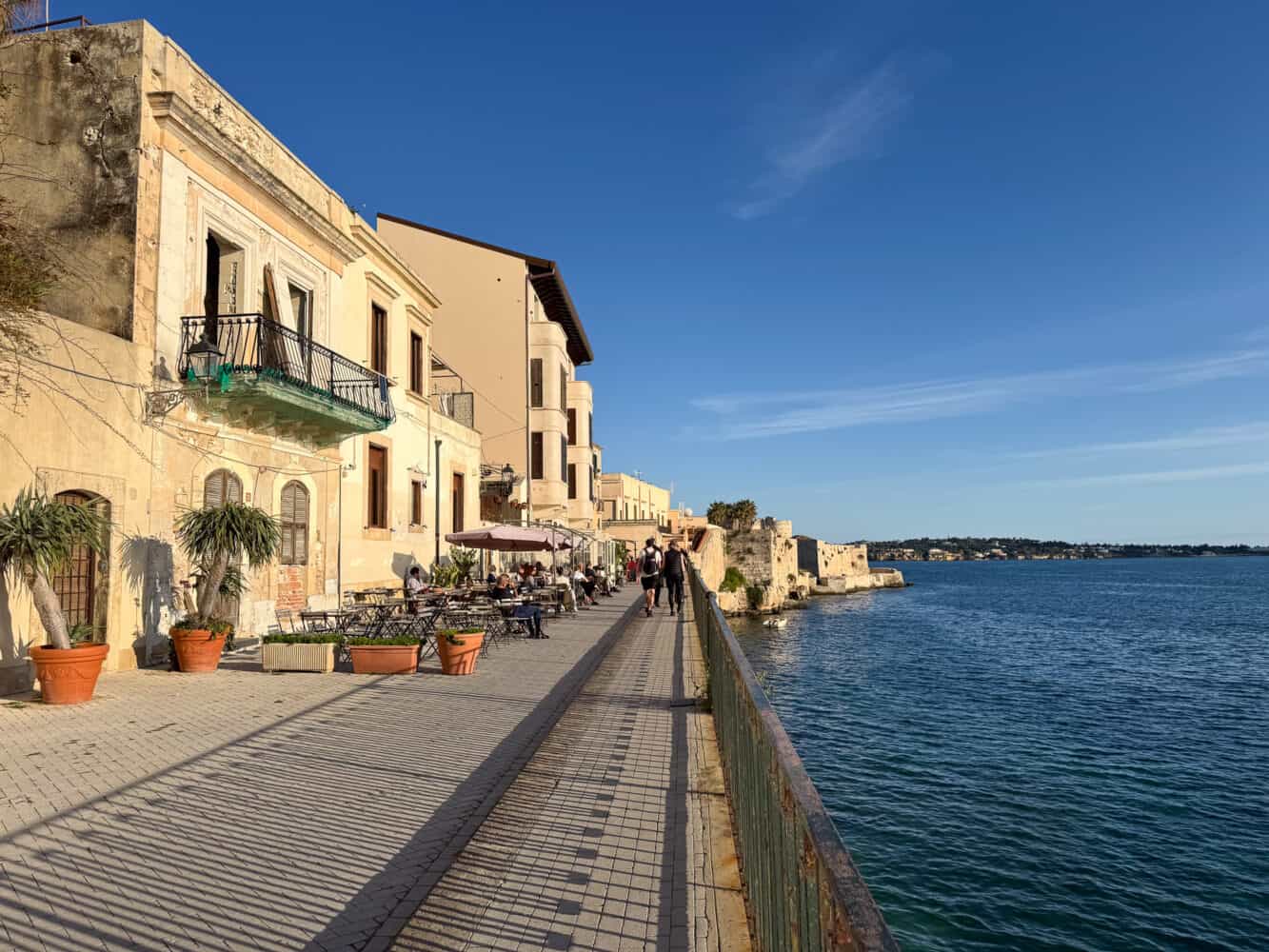
While Ortigia’s interior is atmospheric and beautiful, I also recommend walking along its seafront for lovely views.
The most attractive stretch is on the west coast, from the marina full of superyachts in the north down the main tree-lined promenade, Foro Vittorio Emanuele II.
After you reach the Fonte Aretusa, the Lungomare Alfeo is even prettier as you continue south. This is the best spot to watch the sunset, perhaps from one of the bars (we liked Mikatú).
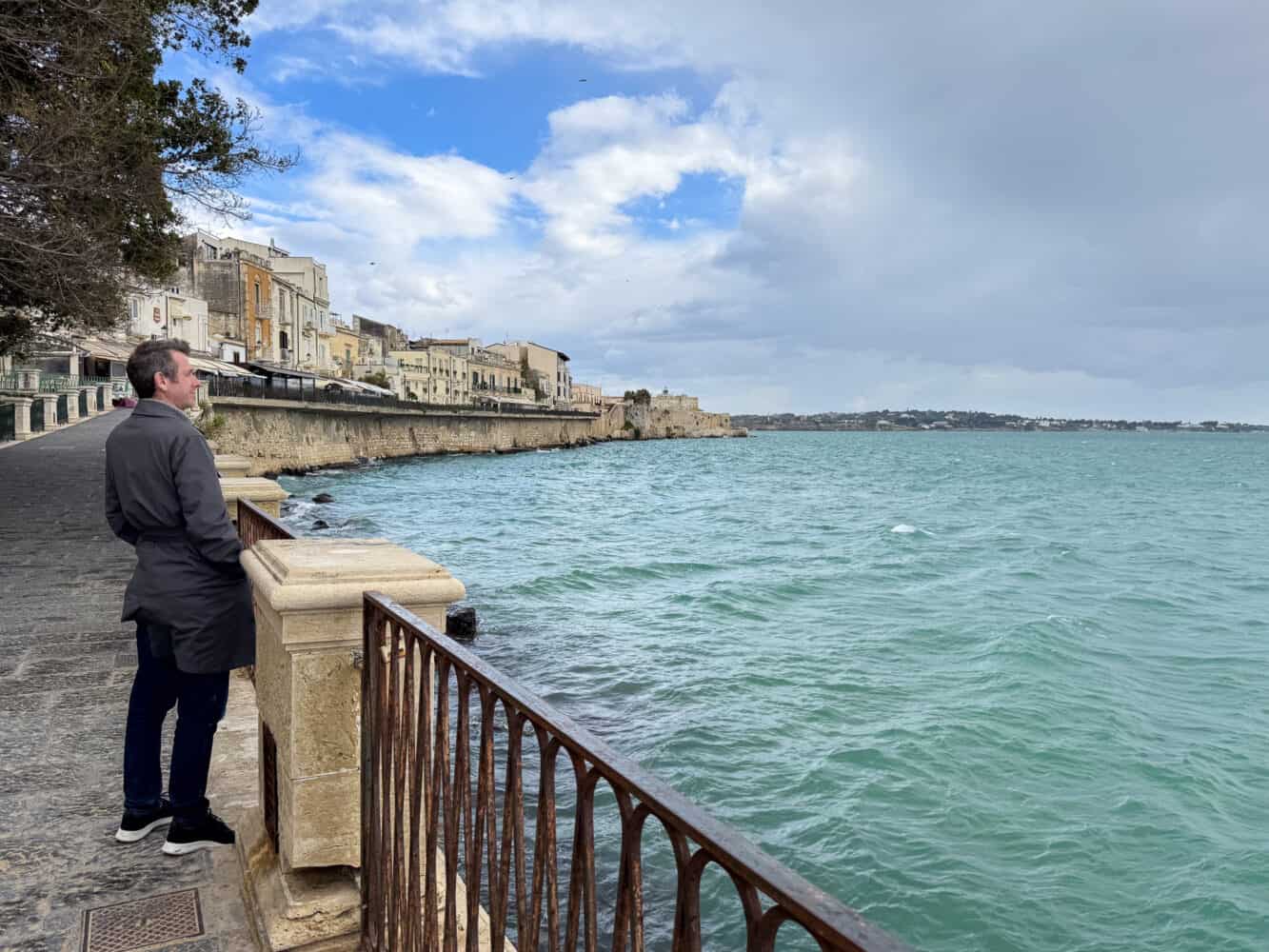
Eventually, you’ll reach Castello Maniace, a 13th-century military fort that overlooks the sea at the southern tip of Ortigia.
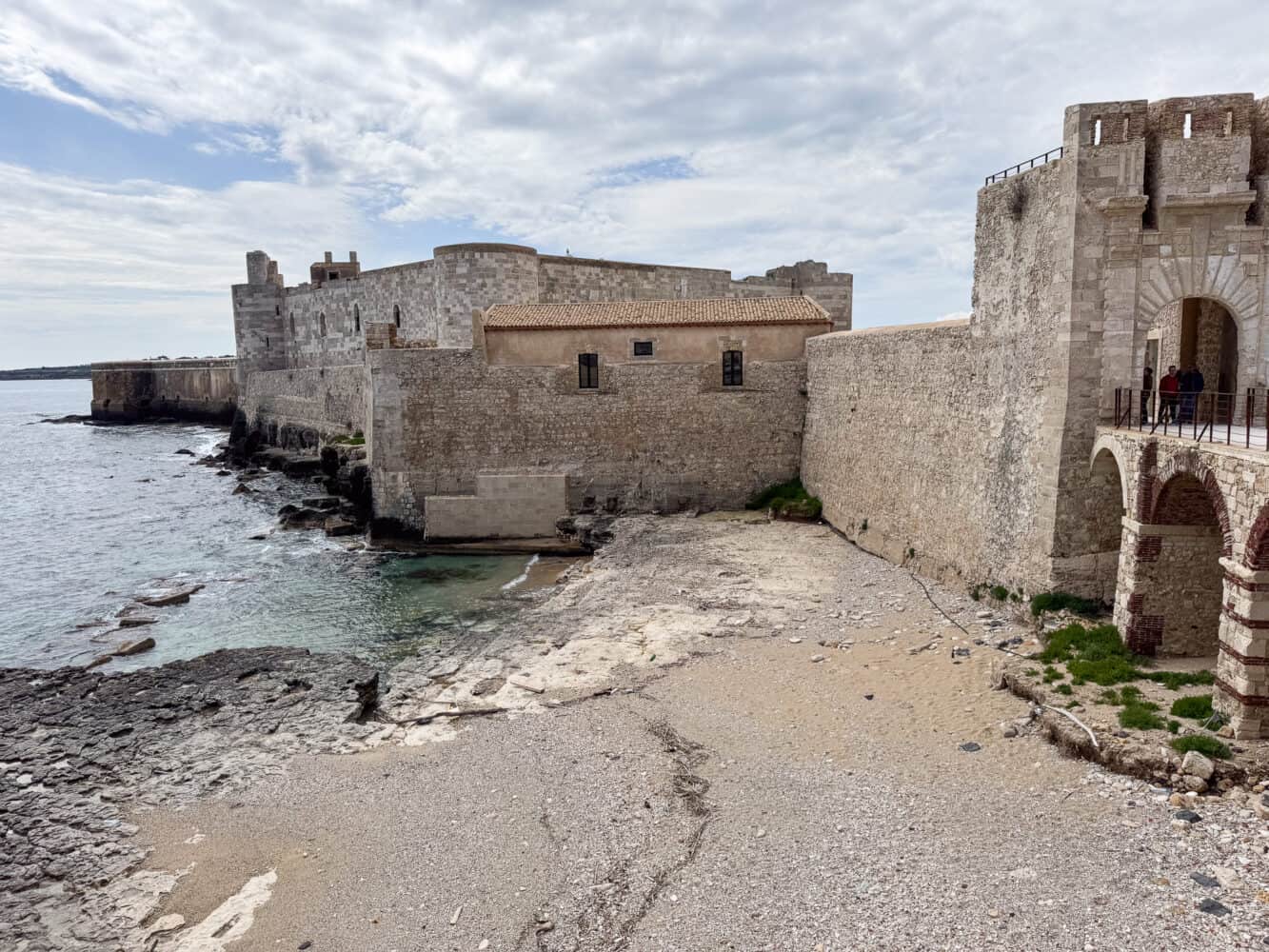
You can enjoy the views from the outside or pay €6 to go inside. There’s not much to see inside (and no information), but we enjoyed wandering the expansive halls and gazing out to sea from the defences. It wasn’t busy on our visit.
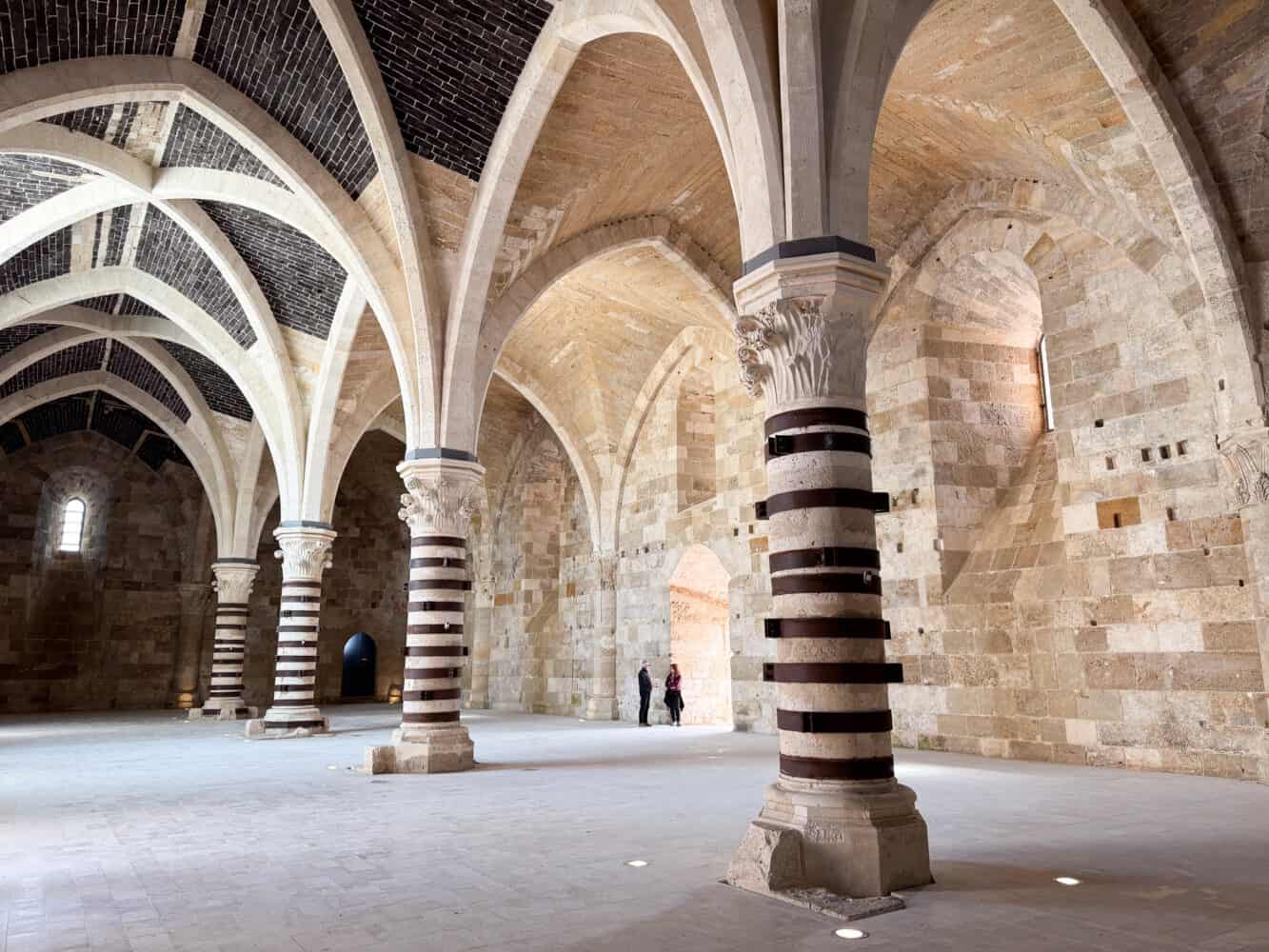
From here you can walk up the east coast of Ortigia. The southern section is the most scenic as you pass the popular swimming spots, Cala Rossa (a small pebble beach) and Forte Vigliena (where you can swim off the rocks). The water is wonderfully clear.
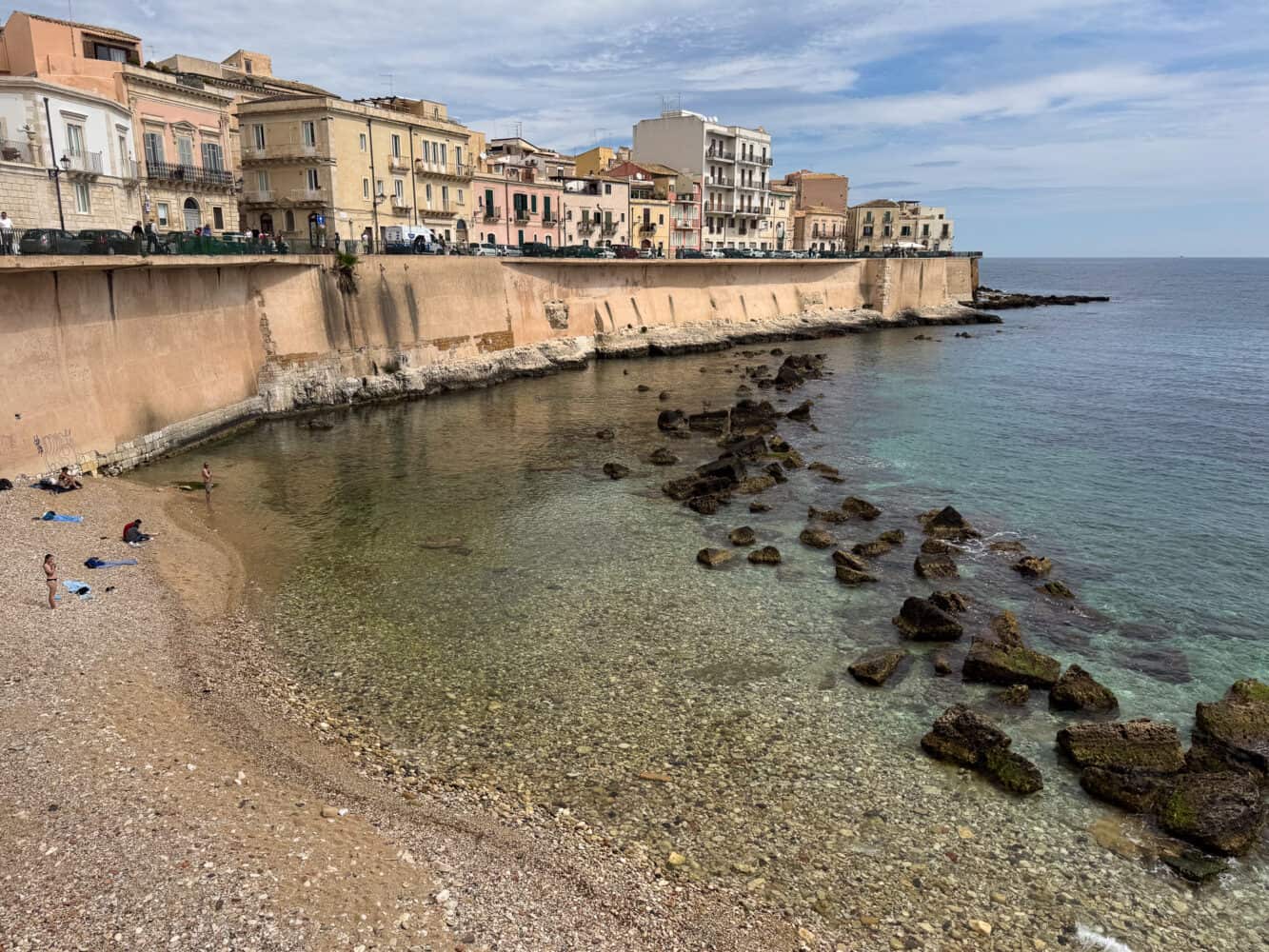
The next part is next to the road and not quite as attractive, but you might like to do what we did and continue up to Ortigia Market for lunch.
If you want to see the coastline from a different perspective, you can take a short boat tour around the island and to nearby sea caves.
There are lots of boat trips on offer near Umbertino Bridge as you enter Ortigia, or you can book a tour like this one-hour Ortigia Island and Sea Caves Boat Tour.
9) Enjoy Aperitivo
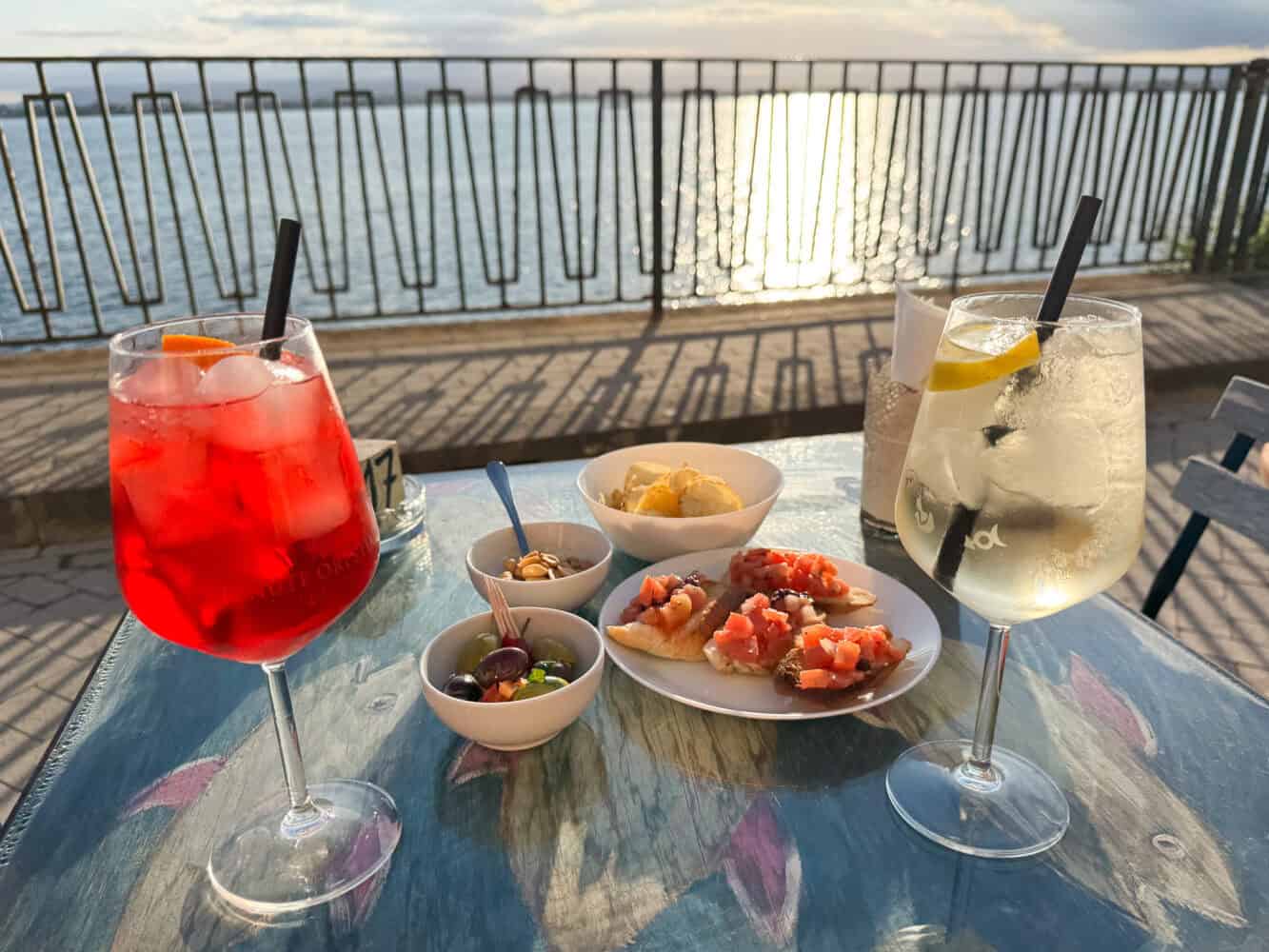
Aperitivo, or pre-dinner drinks with snacks, is an Italian tradition we love. Ortigia is a great place to partake as there are lots of excellent bars, from hipster cocktail joints to simpler spots for sunset on the promenade.
Here are the bars we enjoyed in Ortigia:
- BOATS – Superb, mostly tequila-based cocktails in a cool bar near the Temple of Apollo. The menu is an epic storybook. My sweet and sour Ofrenda was delicious and came with a candy skull garnish. No snacks, though.
- Cortile Verga – Another good spot for unusual cocktails in a stylish courtyard. Our drinks came with taralli and olives, and they have a food menu if you want something more substantial.
- Mikatú – For us, this was the best spot on Lungomare Alfeo for sunset cocktails. Our Spritzes came with a generous array of snacks.
- Evoè Wine Bar – A good selection of Sicilian wines by the glass. Snacks aren’t included, so we ordered the tasty mixed bruschetta.
- Moon – This vegan restaurant has creative cocktails (which come with vegan snacks) and some comfy seating inside (plus tables outside).
- Piazza Archimede Caffe – This was our go-to when we wanted a simple Aperol or Campari Spritz. There’s outdoor seating overlooking the Diana Fountain (with heat lamps in winter). At aperitivo time, we were brought a selection of pastries, crisps and olives, but were charged €2.50 for them.
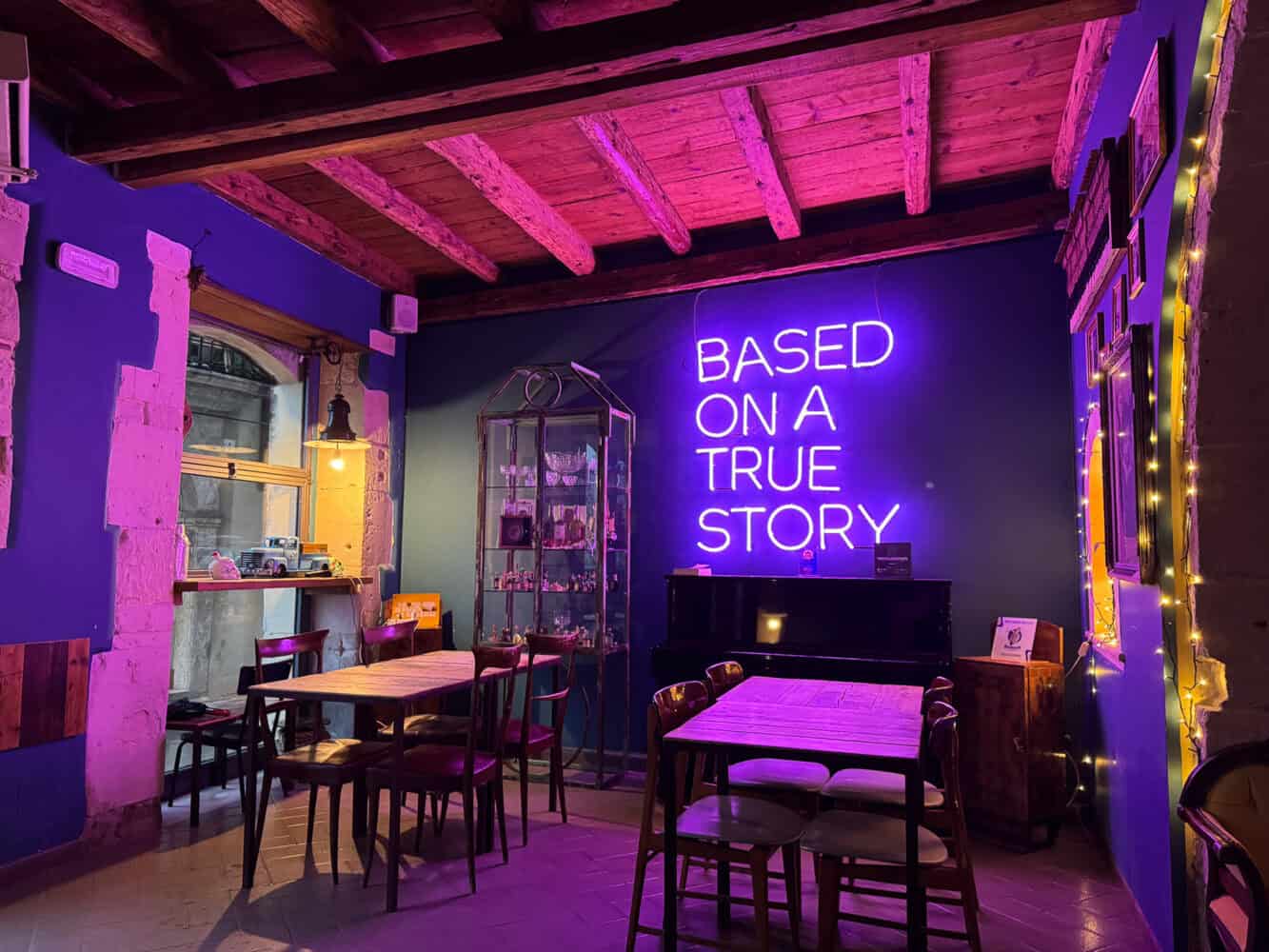
10) Eat Delicious Food
Considering Ortigia’s small size, I was amazed by how many restaurants I discovered in my research.
We didn’t have time to eat in them all, but here were our favourites:
For a Multi-Course Dinner: Trattoria La Foglia
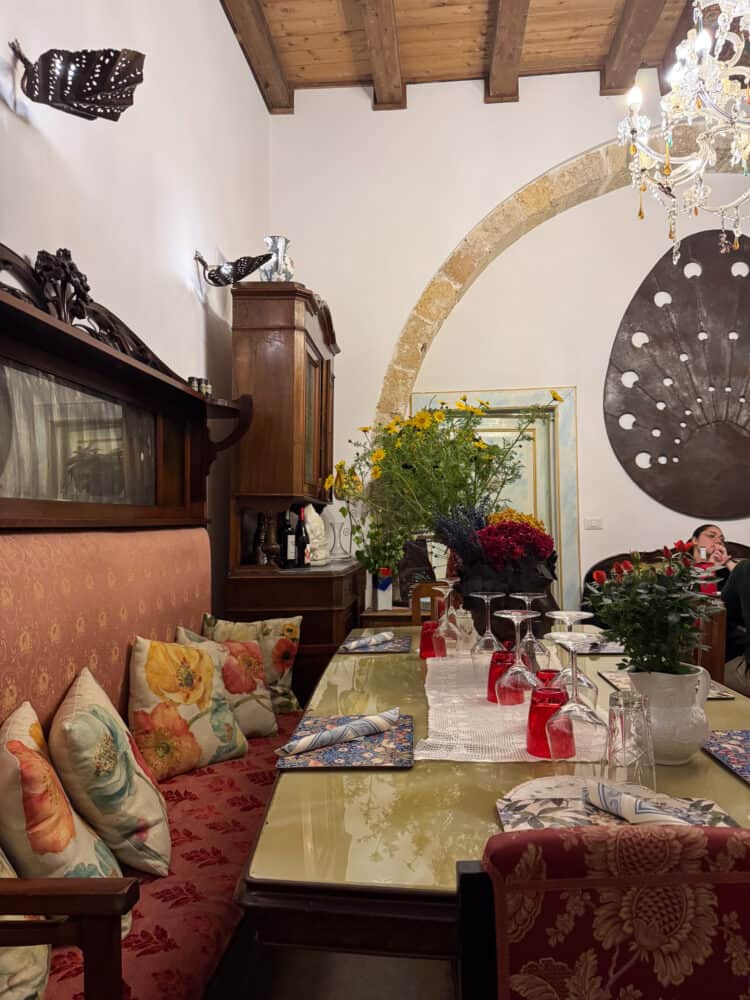
We loved Trattoria La Foglia’s quirky mismatched decor (think Grandma’s house chic), friendly staff, and delicious food.
We enjoyed the gran piatto di verdure (a big plate of vegetables, rice, omelette, and other bits), ricotta ravioli with tomato sauce, and tagliolini alla Norma.
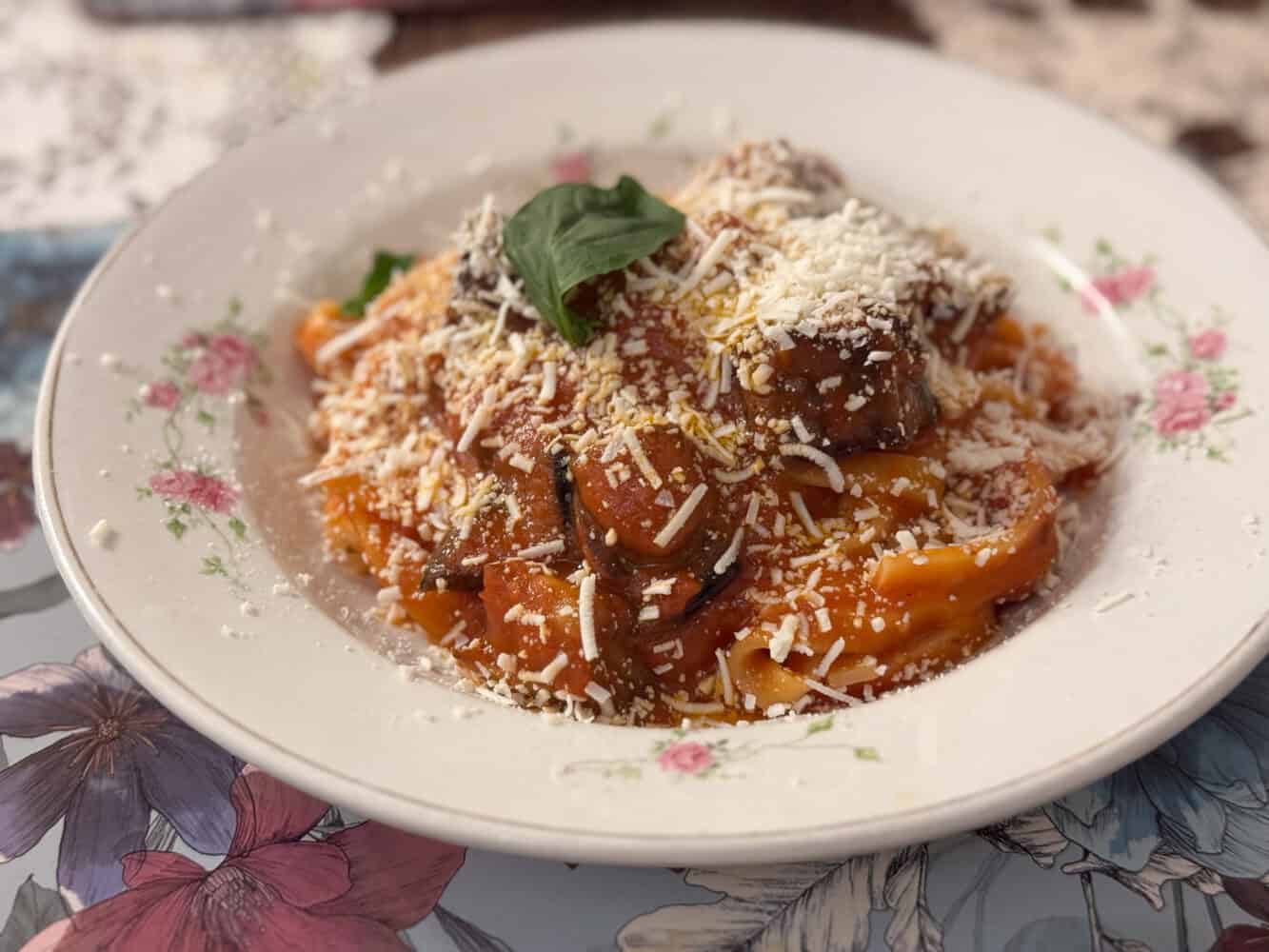
It was pretty pricey (but everywhere is in Ortigia), and they asked us to pay our €80 bill in cash, but we’d still go again. Bookings recommended.
For Pizza: Pizzeria Schiticchio

At Pizzeria Schiticchio, our Margherita and Norma pizzas were excellent with wonderful puffy crusts.
The panelle starter was a tasty surprise, as these chickpea fritters are usually only found in Palermo.
We managed to get in at 7.30pm, but you might want to book.
For Takeout: Antica Giudecca
If you want an inexpensive, casual meal, head to Antica Giudecca for arancini (rice balls), pizza slices, and impanata.
You can choose what you want from the counter or ask for arancini, which are made to order. They do have more arancini flavours than listed on the menu—we got our vegetarian favourite, Norma (aubergine).
While it’s more of a takeout spot, there are a few tables inside and out.
On a Saturday night, it was buzzing with locals and had a very Italian, chaotic energy.
For Gelato: Levante Gelato Artigianale
Levante Gelato Artigianale wasn’t the friendliest gelateria we visited, but it’s still my top pick because the pistachio gelato (a must in Sicily) was so good.
You pay for your gelato upfront at the cashier and then order your flavours from the counter. If you want pistachio, you have to pay a 50c premium so be sure to tell them when you pay.
It’s also supposed to be a good spot to try the classic Sicilian summer breakfast—granita and brioche.
11) See a Traditional Puppet Show
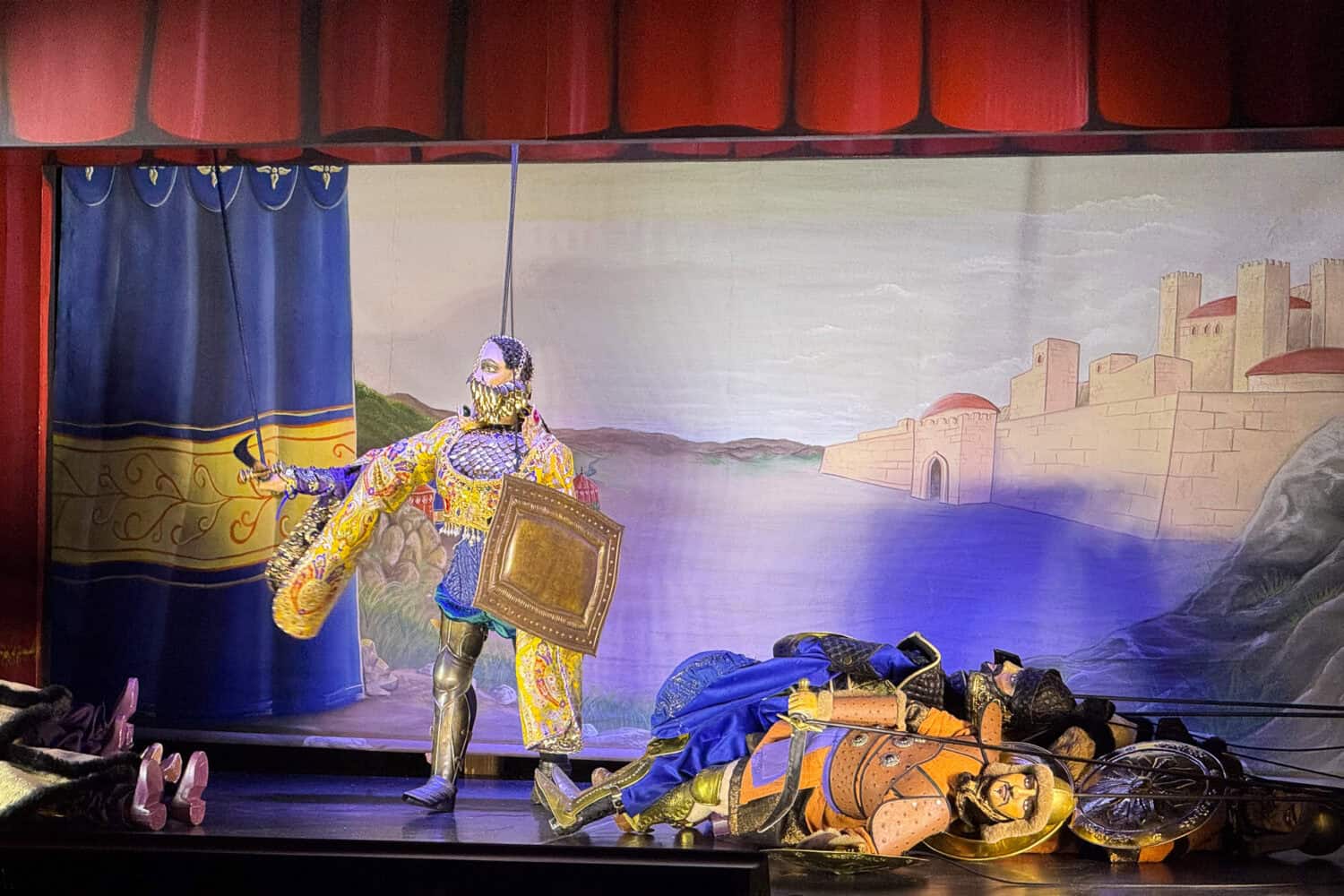
For a unique activity in Ortigia, see a traditional Sicilian puppet show at the Teatro dei Pupi.
It’s best to check their website for upcoming performances and book online. We only just managed to get in turning up 20 minutes before a show.
Shows tend to start between 4.30pm and 6pm and run every day during high season (twice a day in August). They are always closed on Sundays.
The 45-minute performances are of classic stories and are all in Italian. They do give an introduction in English so you have a sense of the story, but we still found it a little hard to follow (and I admit my attention drifted at points).
The puppets are impressive, though, and it’s nice to be part of preserving a tradition that dates back to the early 18th century.
Tickets cost €11 or €12 including access to the nearby Puppet Museum.
Things to Do in Syracuse (Mainland)
While you could happily spend all your time in Ortigia, there are a few sights on the less picturesque mainland of Syracuse.
12) Wander the Neapolis Archaeological Park
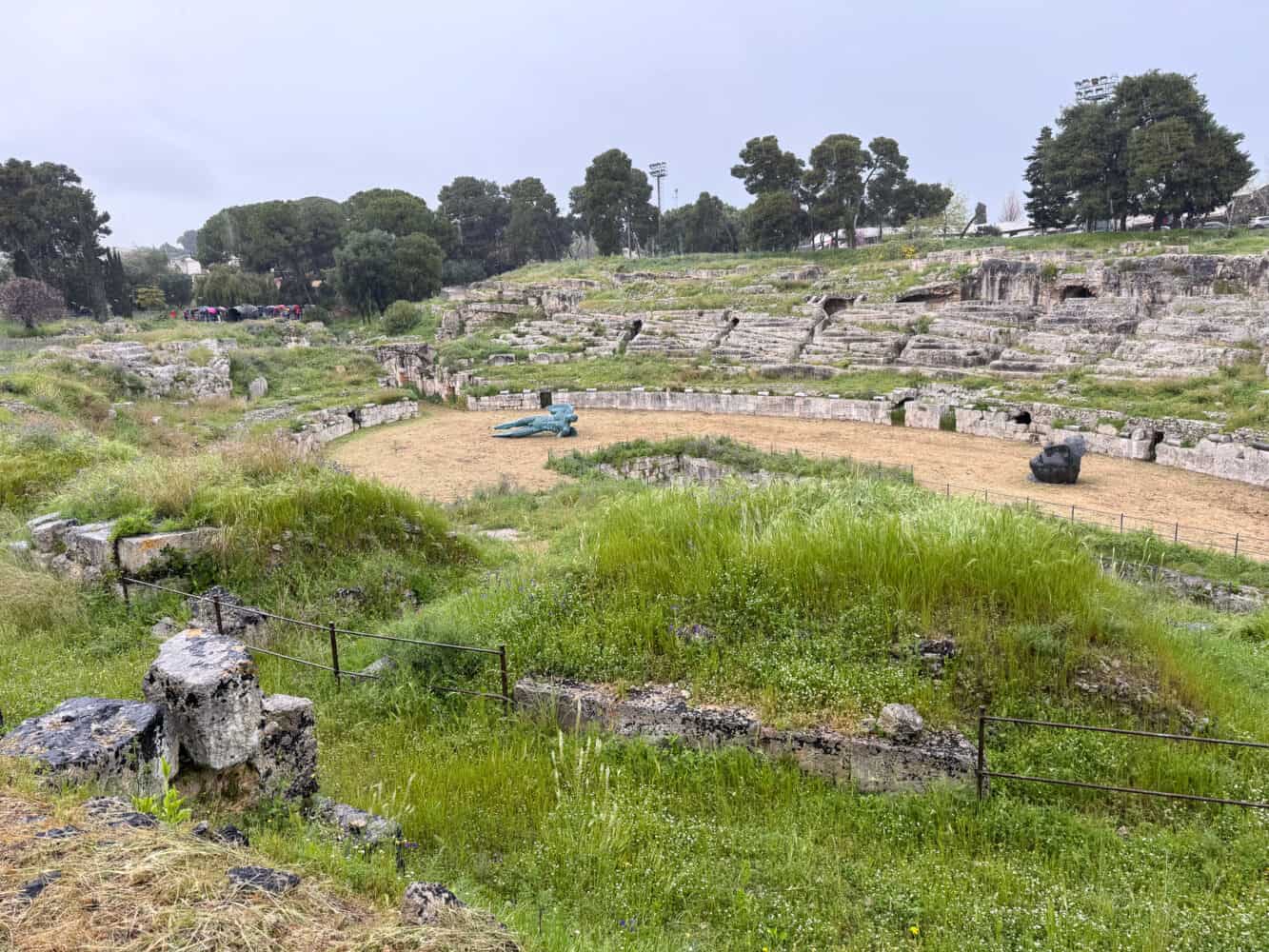
One of the top things to do in Syracuse is visit the Neapolis Archaeological Park, a 30-minute walk from Ortigia.
The extensive park features a Greek theatre from the 5th century BC, a Roman amphitheatre, caves, and an ancient quarry.
Aside from the history, it could be a pleasant place to wander with lemon and orange trees now growing in the quarry and modern sculptures scattered (somewhat incongruously) around the ruins.
It’s a place with a lot of potential that’s let down by the complete lack of information. The Greek Theatre is also covered with wooden benches for performances much of the year. It looked awful and had no feeling of history like the Teatro Antico in Taormina.
Our visit was also challenging due to heavy rain, and it was heaving with tour groups, which made it hard to enjoy.
We made the mistake of going at 10.30am. I recommend going early or late—I’m sure we would have enjoyed it more on a sunnier, quieter day.
That said, manage your expectations, and you might want to skip it if you are on a budget (entrance is €17) and not a history nerd.
13) See a Caravaggio
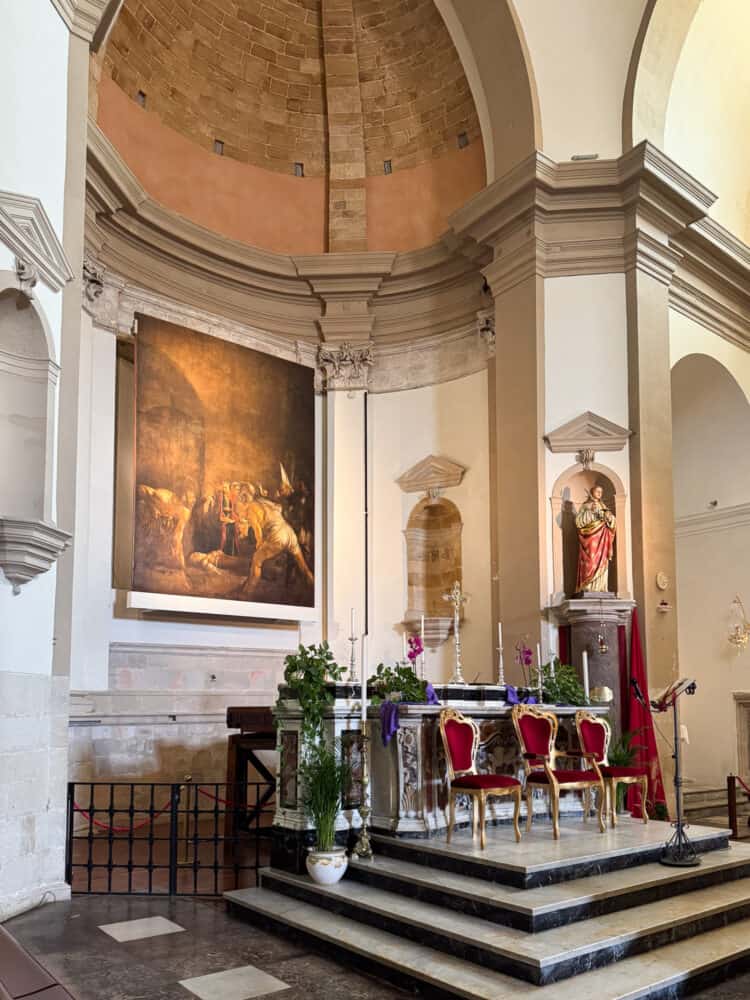
You can see the Caravaggio painting, The Burial of Santa Lucia, at Santuario di Santa Lucia al Sepolcro in Piazza Santa Lucia.
Caravaggio was commissioned to paint Syracuse’s patron saint for this church in 1608 while on the run from the Knights of Malta. Some scholars suggest that the top two-thirds of the painting are bare due to his lack of time to complete it.
While it didn’t impress us as much as the Caravaggios we saw in Rome, it’s worth seeing for art fans.
Entrance to the church is free, but you’ll need a €1 coin (or two for longer) to light up the painting behind the altar.
The church is a 20-minute walk from the top of Ortigia. We combined it with the coastal walk below. This is an untouristy area and feels a bit gritty compared to Ortigia.
The church is open from 9am – 7pm but closes for a break between 12.45pm and 3pm every day.
You can also visit the catacombs below the church.
Note that the Caravaggio painting was displayed for years (until 2020) in Santa Lucia alla Badia on Piazza Duomo in Ortigia. They still have a copy on display.
14) Walk or Cycle the Coast
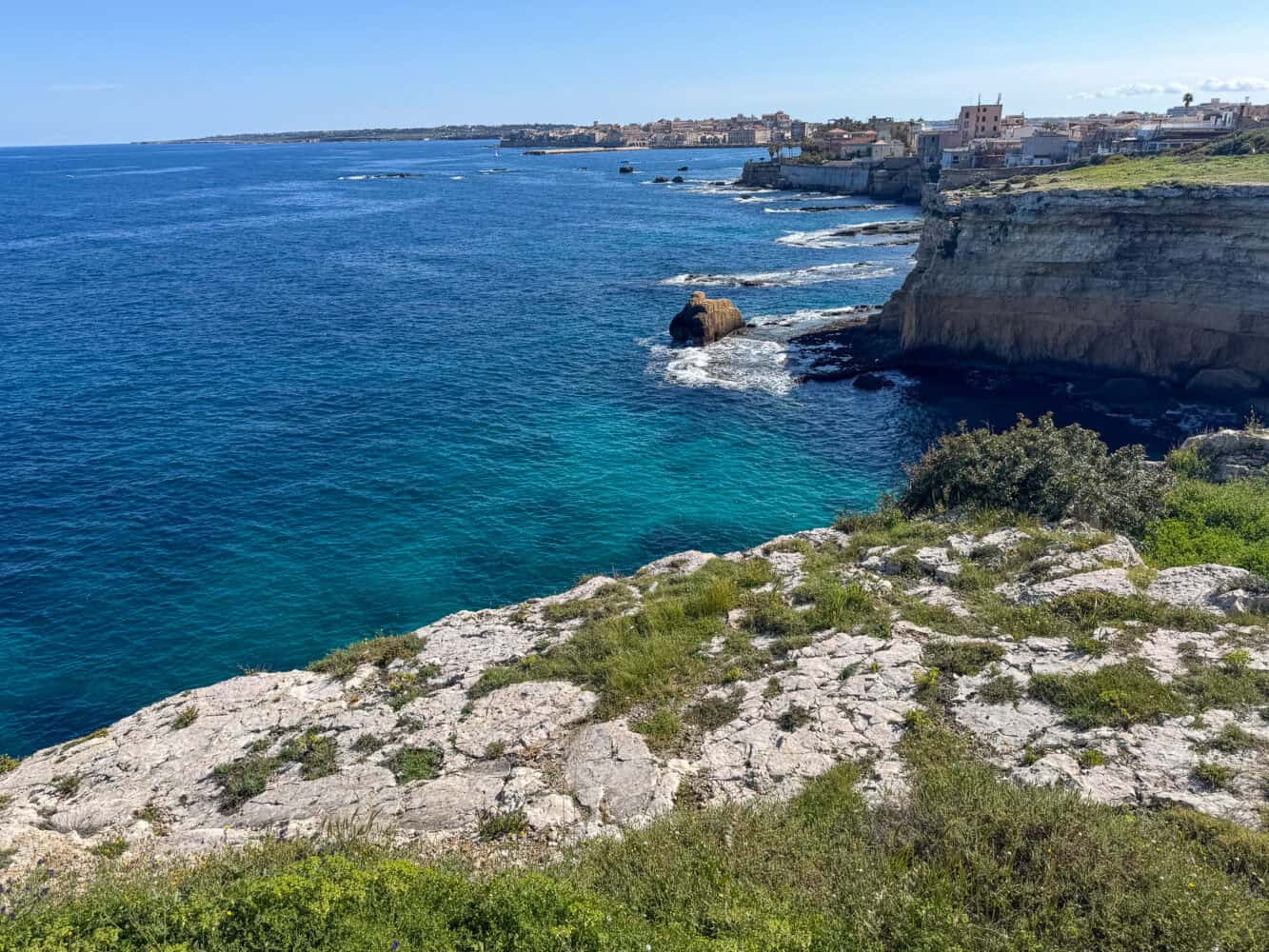
A 10-minute walk from Santa Lucia church is the start of a 6km bike path, Pista Ciclabile Rossana Maiorca.
It runs along the coast, with views of sea cliffs on one side and less attractive modern housing on the other. We walked a short distance, but it’s probably best to take a bike.
You can rent bikes at Siracusa Tour Bike Rentals and e-bikes at Green Rent in the Syracuse mainland area just over from Ortigia.
15) Eat in Some Untouristy Spots
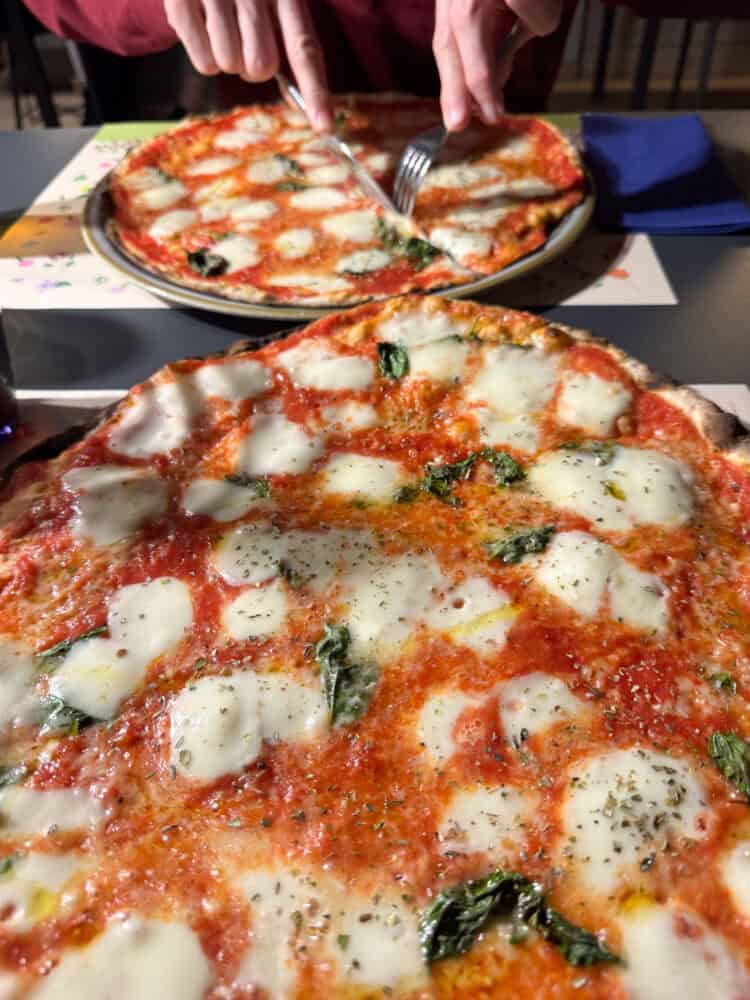
The Syracuse mainland has the least touristy places to eat.
We loved the thin and crispy pizzas at Piano B. It was so busy with locals on a Friday night that we had to get a takeaway, but we returned during the week and could eat in.
Fari is a pasta shop where you can also eat in to enjoy their freshly made pasta with a variety of sauces. Good for a casual meal.
There are also quite a few gelato places just north of Ortigia. Mangiafico Voglia Matta was good, but Gelateria Belfiore was even better (especially the Diana pistachio and very intense dark chocolate).
Day Trips from Syracuse
Syracuse is a good base for exploring the nearby Val di Noto with its many beautiful Baroque towns rebuilt after a devastating earthquake in 1693.
See our Eastern Sicily itinerary for more details about these towns.
16) Noto
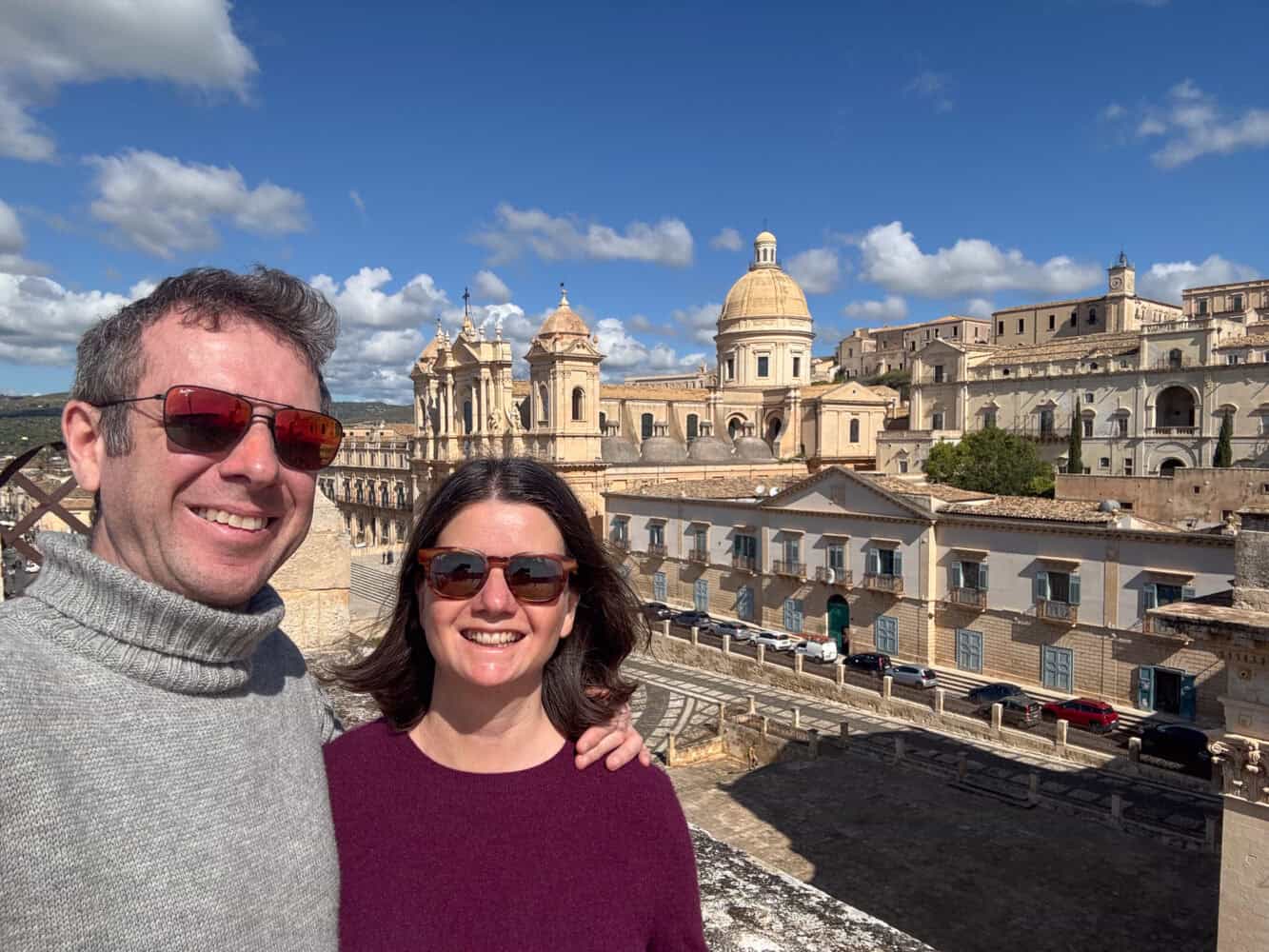
Noto is the most famous Val di Noto Baroque town and just 30 minutes from Syracuse.
The beautiful historic centre is compact and easy to explore in half a day. The highlight is the main street, Corso Vittorio Emanuele, where you’ll find the impressive Duomo and many honey-gold palazzi and churches.
There are several church bell towers you can climb to see the city from above—we liked the view of the Duomo from Chiesa di Santa Chiara.
It’s also worth veering off the main street to discover painted staircases on Via Fratelli Bandiera and Scalinata Mariannina Coffa.
For a delicious, affordable meal, follow slices of sfincione (like pizza) from Panifico Maidda with a granita from Caffe Sicilia.
17) Ragusa
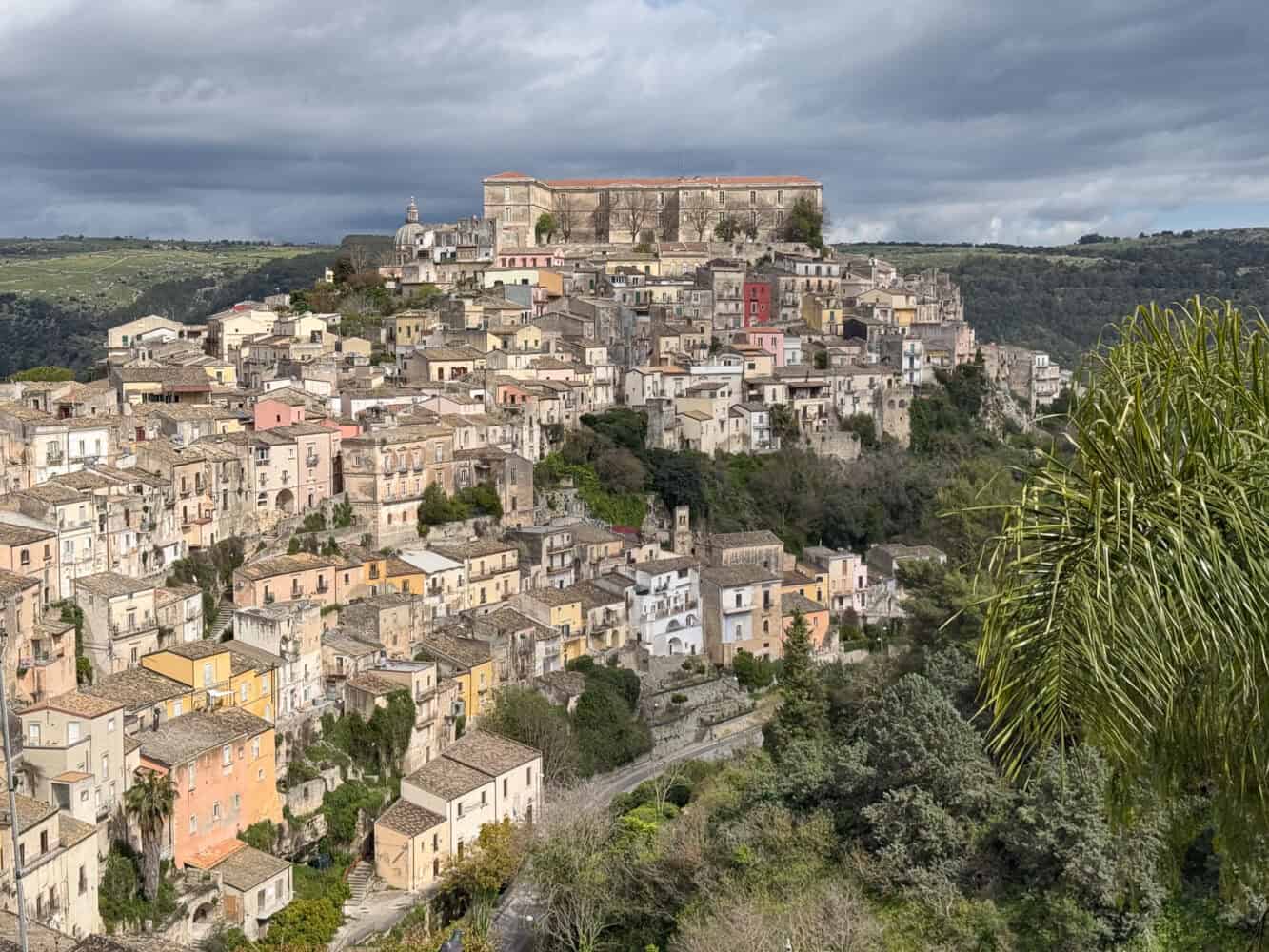
Ragusa Ibla, the old town of Ragusa, was our favourite of the Baroque towns we visited.
It has a dramatic location on the edge of a gorge—best appreciated by climbing the stairs up to Chiesa di Santa Maria delle Scale for stunning views.
The maze of traffic-free streets is a joy to wander.
We tried local products for lunch at the wine bar, Enoteca Il Barocco.
18) Modica
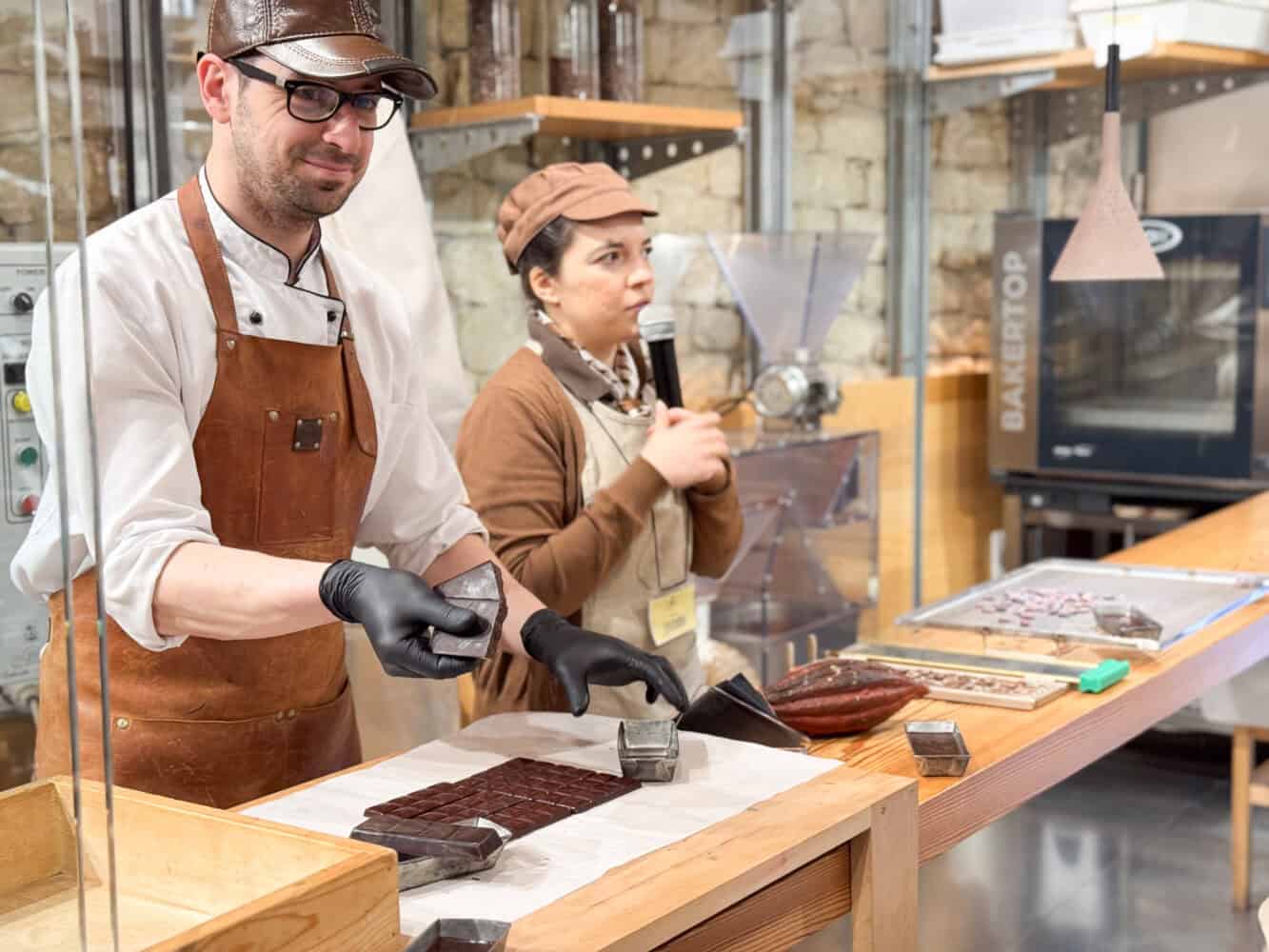
Modica is famous for its dark, grainy chocolate, which is still made from a recipe brought by the Spanish from Latin America to Sicily in the 16th century.
We learnt about the bean-to-bar process (and tasted many samples) on a tour at Modica’s oldest chocolate shop, Antica Dolceria Bonajuto.
Modica is another Baroque town with many beautiful churches and narrow lanes to explore. Expect to walk up lots of stairs in this hillside town.
Where to Stay in Syracuse
Ortigia is by far the most charming and atmospheric place to stay in Syracuse. There are many B&Bs and apartment rentals in the old town, plus a few larger hotels (like Grand Hotel Ortigia).
If you only have a few days in Syracuse and don’t have a car, I definitely recommend staying in Ortigia.
Some tempting options include:
- Hotel Henry’s House – A historic B&B with some sea view rooms.
- Re Federico Boutique Hotel – Affordable rooms close to a swimming spot.
- Maniace Boutique Hotel Ortigia – Stylish rooms next to Cala Rossa beach, some with sea views.
Where We Stayed
If, like us, you have a rental car and want to take day trips, staying in Ortigia is more difficult.
Non-locals can’t drive in much of the island, and parking is expensive and mostly limited to public car parks (such as Parcheggio Talete). It is possible, but check the parking situation with your hotel before you book.
We decided to stay on the Syracuse mainland but only a 10-minute walk from Ortigia.
We rented a one-bedroom apartment called A Casa di Clara in a residential building. It has free parking in the courtyard, a big plus for us, and the location worked well.
For our longer stay, we appreciated having more space than a B&B, a kitchen, and a washing machine. The self-check-in was easy.
The downsides were that in rainy early spring, we found it a bit cold and damp (despite the heating). It was also noisy on weekend nights, and the water tasted salty, so we had to buy bottled water.
Although we didn’t love every aspect, it was good value and worked well as our base.
How to Get to Syracuse, Italy
Syracuse (Siracusa) is located in southeast Sicily. The nearest airport is Catania International Airport (CTA).
We drove to Syracuse as part of our East Sicily road trip. It’s a one-hour drive south of Catania (where we went afterwards) and two hours south of Taormina (where we started our trip).
If you travel by public transport, you can take the train from Catania to Syracuse (around 1 hour 15 minutes) or the Interbus.
The Siracusa train station is a 20-minute walk or 10-minute taxi ride from the top of Ortigia.
Syracuse Map
Is Syracuse Worth Visiting?
Syracuse is one of the most popular destinations in Sicily and is well worth visiting.
While the main part of the city isn’t particularly attractive, the historic island of Ortigia is beautiful.
You can easily spend a week or more, as we did, wandering the narrow streets, admiring the golden Baroque buildings, strolling the seafront promenade, taking dips in the sea, and enjoying the many bars and restaurants.
Syracuse is also a good base for exploring the Val di Noto towns, and in summer, venturing to sandy beaches (which Syracuse lacks) down the coast.
More Sicily Tips
- The Perfect Eastern Sicily Itinerary: Food, Views and Baroque
- 11 Wonderful Things to Do in Taormina, Sicily
- 12 Best Places to Visit in Western Sicily
- Exploring Peaceful Salina in Sicily’s Aeolian Islands
- A Guide to Hiking Stromboli Volcano
- The Best Food in Sicily: 18 Dishes to Try
- Dos and Don’ts of Eating in Italy
If you enjoyed this post, pin for later!
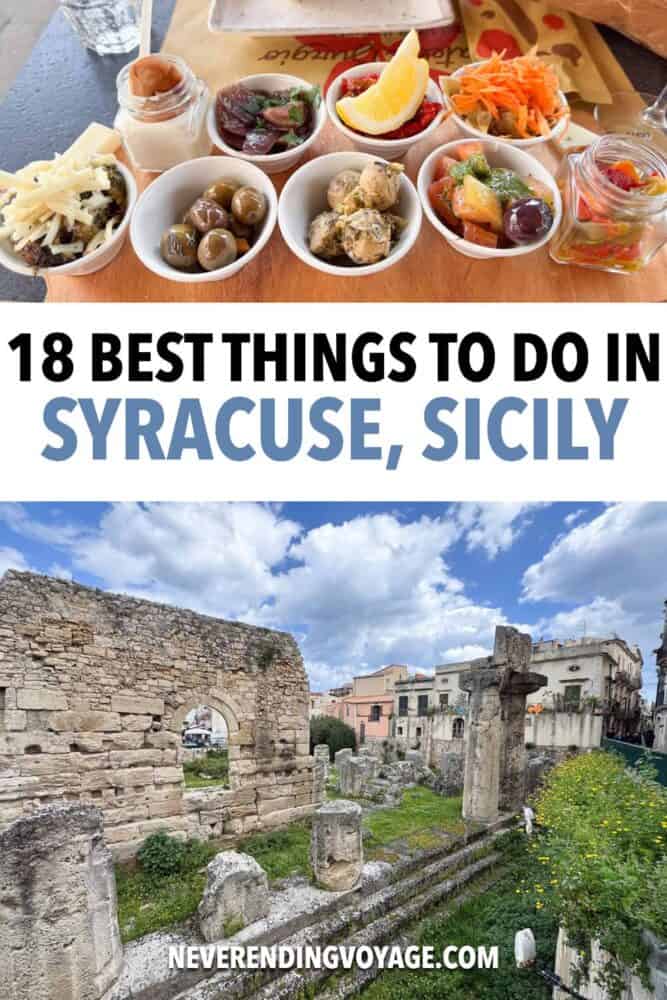
11 Wonderful Things to Do in Taormina, Sicily 12 Jun 7:12 AM (4 months ago)
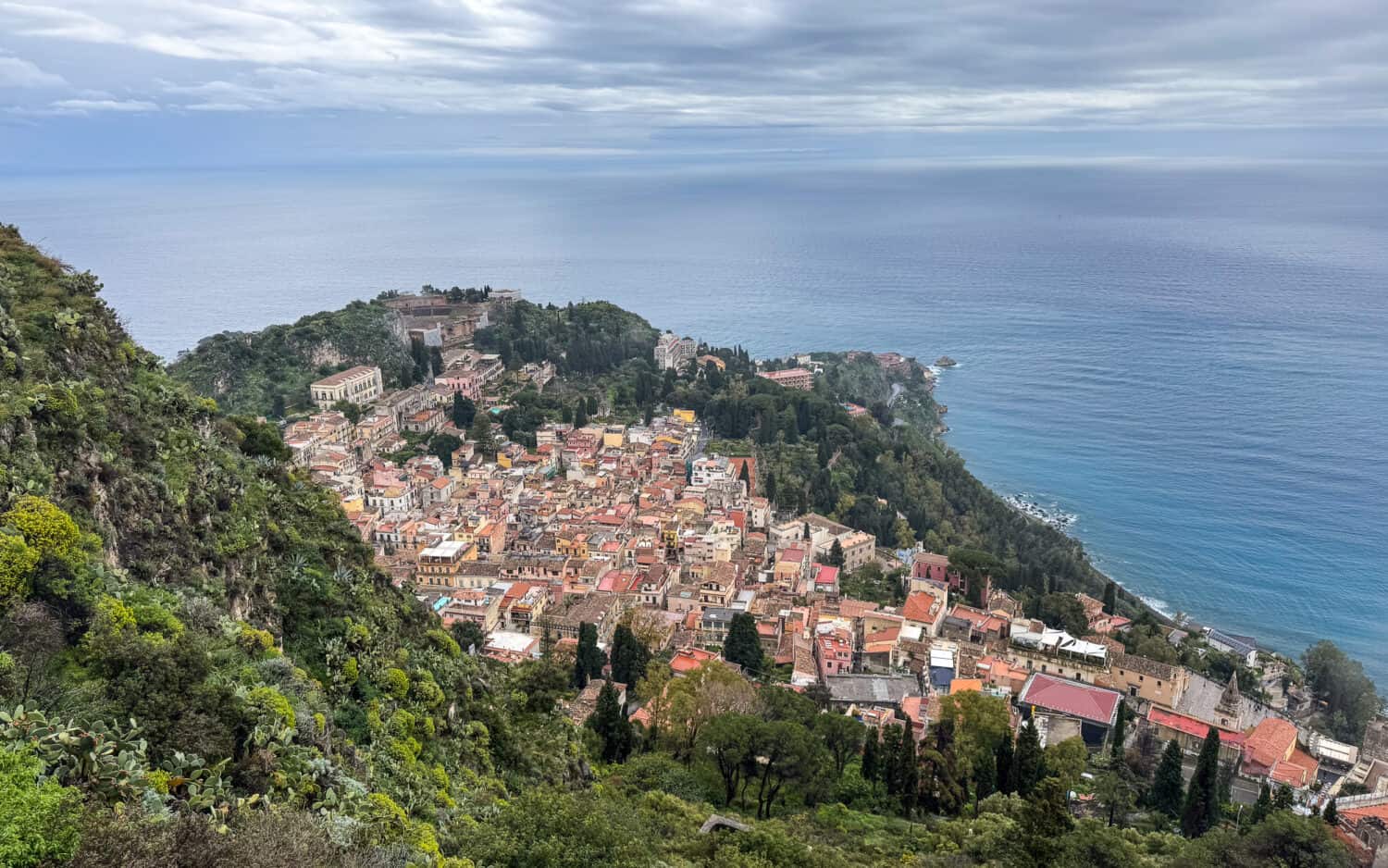
Set on a hillside, Taormina is all about the views—down to the Ionian Sea and up to snow-capped Mt Etna, with lush green hills and terracotta-roofed villages in between.
This chic Sicilian hill town has been a popular holiday destination for hundreds of years (it was a stop on the 18th century Grand Tour), and even more so since season two of The White Lotus TV show was filmed here.
Taormina has mixed reports from visitors. Some say it’s the most beautiful town in Sicily, while others think it’s overcrowded, overpriced, and touristy.
Your enjoyment will likely depend on when you visit. In summer, the narrow streets of this small town will be packed and hard to enjoy.
When we visited in late March, it wasn’t too busy, and we thought it was stunning (despite plentiful rain!).
In this Taormina travel guide, I share the best things to do in Taormina, how to get there, and where to stay. At the end, you’ll find a map with every place mentioned.
Contents
- Where is Lake Molveno?
- Best Things to Do in Molveno
- Where We Stayed: Grand Hotel Molveno Review
- Where to Eat in Molveno
- How to Get to Lake Molveno, Italy
- Lake Molveno Map
- Is Lake Molveno Worth Visiting?
- More North Italy Posts
- Where is Camogli, Italy?
- Best Things To Do in Camogli Village
- Best Hikes and Day Trips from Camogli
- Our Favourite Places to Eat in Camogli
- Where to Stay in Camogli
- How to Get to Camogli
- Camogli, Italy Map
- Is Camogli Worth Visiting?
- More Italian Riviera Tips
- Location of Hotel Cenobio dei Dogi, Camogli
- History of the Hotel
- Our Room at Hotel Cenobio dei Dogi
- Swimming Pool
- Private Beach
- Restaurants
- Other Facilities
- Hotel Cenobio dei Dogi Pros and Cons
- Cost of Hotel Cenobio dei Dogi
- Final Thoughts
- More Italian Riviera Posts
- Getting to Camogli
- When is the Camogli Fish Festival?
- Sagra del Pesce Camogli Schedule
- Friday Night: The Festival Begins
- Saturday: Bonfires and Fireworks
- Sunday Fish Fry
- Is the Camogli Fish Festival Worth Visiting?
- More Liguria Posts
- Hiking The Blue Trail in Cinque Terre
- Corniglia to Manarola via Volastra Hike Details
- Getting to Corniglia: The Start of the Hike
- Corniglia to Volastra Trail
- Volastra
- Volastra to Manarola Trail
- Corniglia to Manarola Hike Map
- Final Thoughts
- More Liguria Posts
- Skiathos Tips
- Beaches in Skiathos
- Renting a Boat
- Skiathos Town
- Our Favourite Restaurants in Skiathos
- Where We Stayed on Skiathos
- Getting to Skiathos, Greece
- Skiathos Map
- Is Skiathos Worth Visiting?
- More Greece Posts
- Our Top Picks in Syracuse, Sicily
- Best Things to Do in Syracuse (Ortigia)
- Things to Do in Syracuse (Mainland)
- Day Trips from Syracuse
- Where to Stay in Syracuse
- How to Get to Syracuse, Italy
- Syracuse Map
- Is Syracuse Worth Visiting?
- More Sicily Tips
- Our Top Picks in Taormina
- Best Things to Do in Taormina
- How to Get to Taormina
- Taormina Map
- Is Taormina Worth Visiting?
- More Sicily Tips
Our Top Picks in Taormina
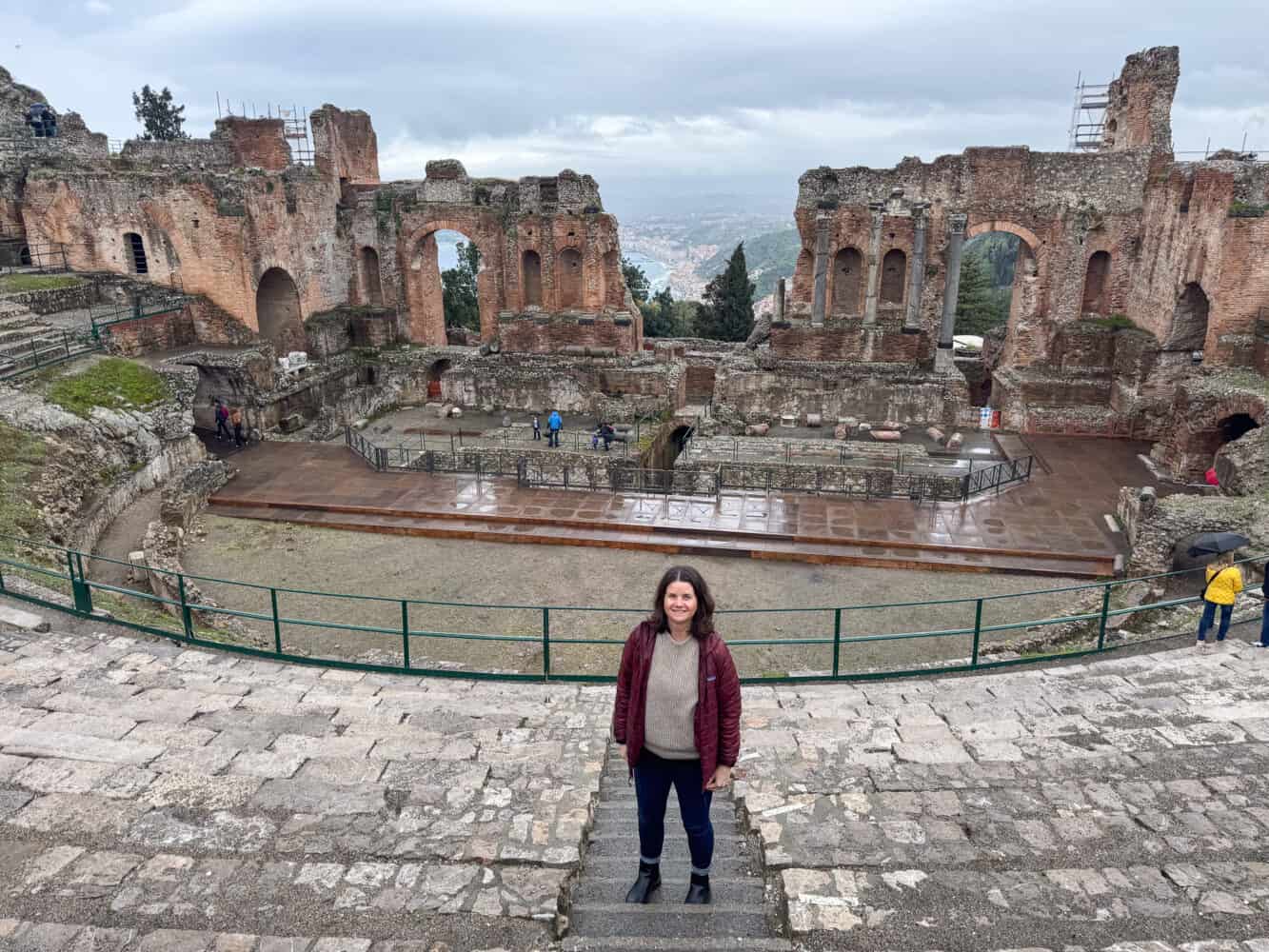
Best Sight: Teatro Antico (Greek Theatre).
Best Meal: La Bottega del Formaggio.
Best Granita: Bam Bar.
Best Hike: To Chiesa Madonna della Rocca (and onwards to Castelmola).
Best Day Trip: Mt Etna (we did this Etna south side summit hiking tour).
Best Things to Do in Taormina
1) Stay in a Room with a View
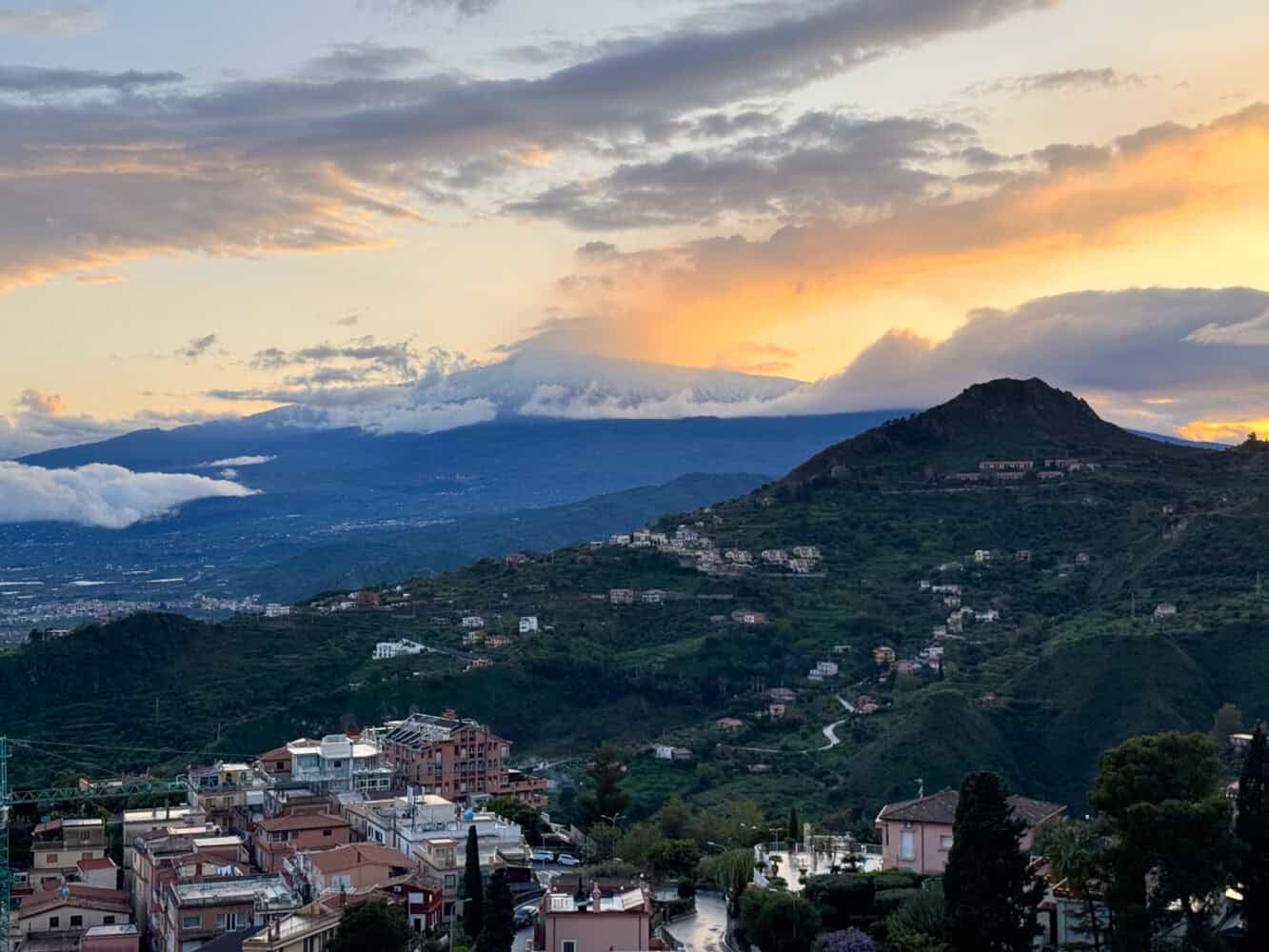
As I’ve said, Taormina is all about the views, so why not enjoy them from your room or balcony?
There are some very fancy hotels in Taormina (€1000 a night or more is not uncommon).
If you have the cash, look at hotels like Hotel Metropole or Hotel Villa Belvedere, or if you really want to splurge, the Four Seasons San Domenico Palace (where The White Lotus was filmed).
All these have excellent locations in the centre, swimming pools, and amazing views.
If you are on a budget, there are some good deals at B&Bs for under €100, especially in the low/shoulder seasons (the best time to visit anyway).
We stayed at Villa Sara B&B in a simple but comfortable and spacious double room.
The highlight was the stunning view of the sea and Mt Etna from our room and the large balcony (in better weather, it would have been a fantastic place to relax with a drink).
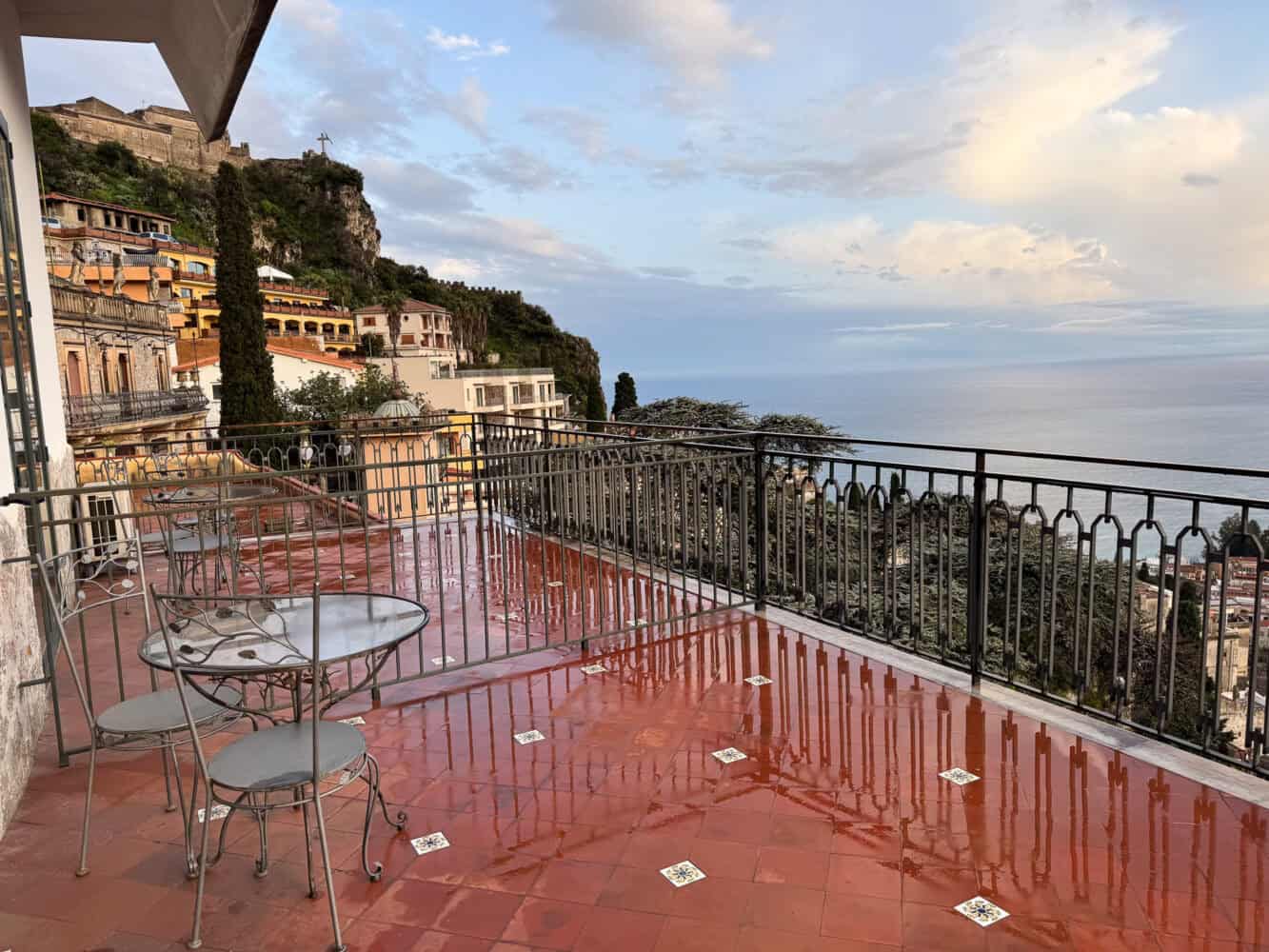
Host Domenico is very friendly. He gave us tips on the area, helped us park in his small garage, and provided a tasty breakfast.
The only downside is the location up steep steps from the centre of town. It’s a solid 10-minute climb up and does feel like a workout.
For us, it was worth it for the views and onsite parking (which is rare and at €10 a day, a good deal for Taormina).
Make sure to book far in advance, though, as there are only a few rooms. Check availability for Villa Sara on Booking.
Note that as Taormina is on a hillside, you’ll spend a lot of time climbing stairs unless you choose a hotel near Corso Umberto (the main street and pretty much the only flat part).
2) Step Back in Time at the Greek Theatre
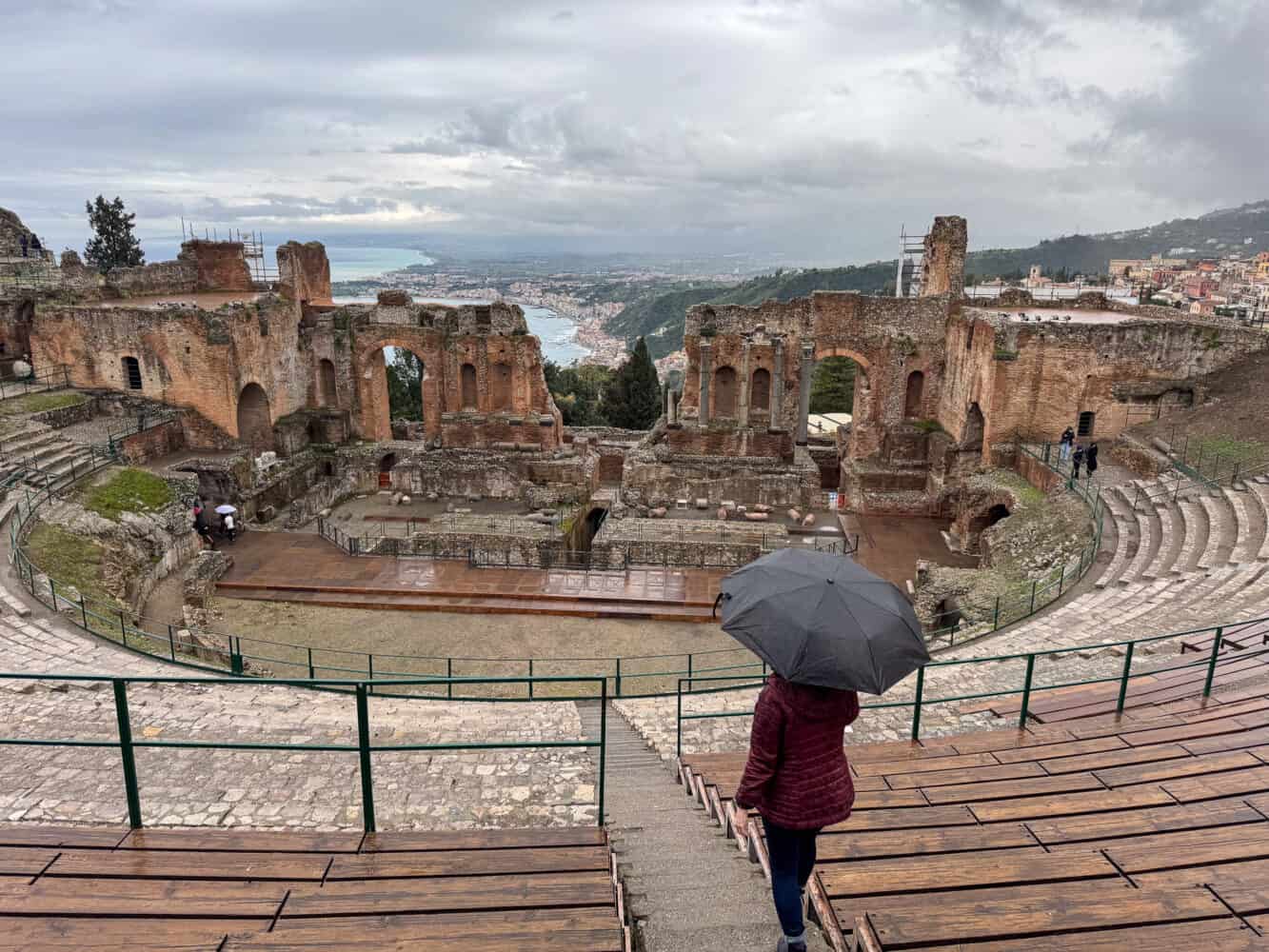
Teatro Antico di Taormina is an ancient Greek Theatre and the town’s most famous sight.
Originally built in the 3rd century BC, it could accommodate 10,000 spectators for classical plays. It was rebuilt under Roman rule and used for gladiatorial battles.
The amphitheatre still occasionally hosts performances, but if you don’t catch one, you can still sit on the stone seating and imagine watching a play 2300 years ago.
Even if you aren’t a history buff, the Greek Theatre is a must see for the spectacular views of the town and sea. If you are lucky, you can see Mt Etna (we didn’t in the rain).
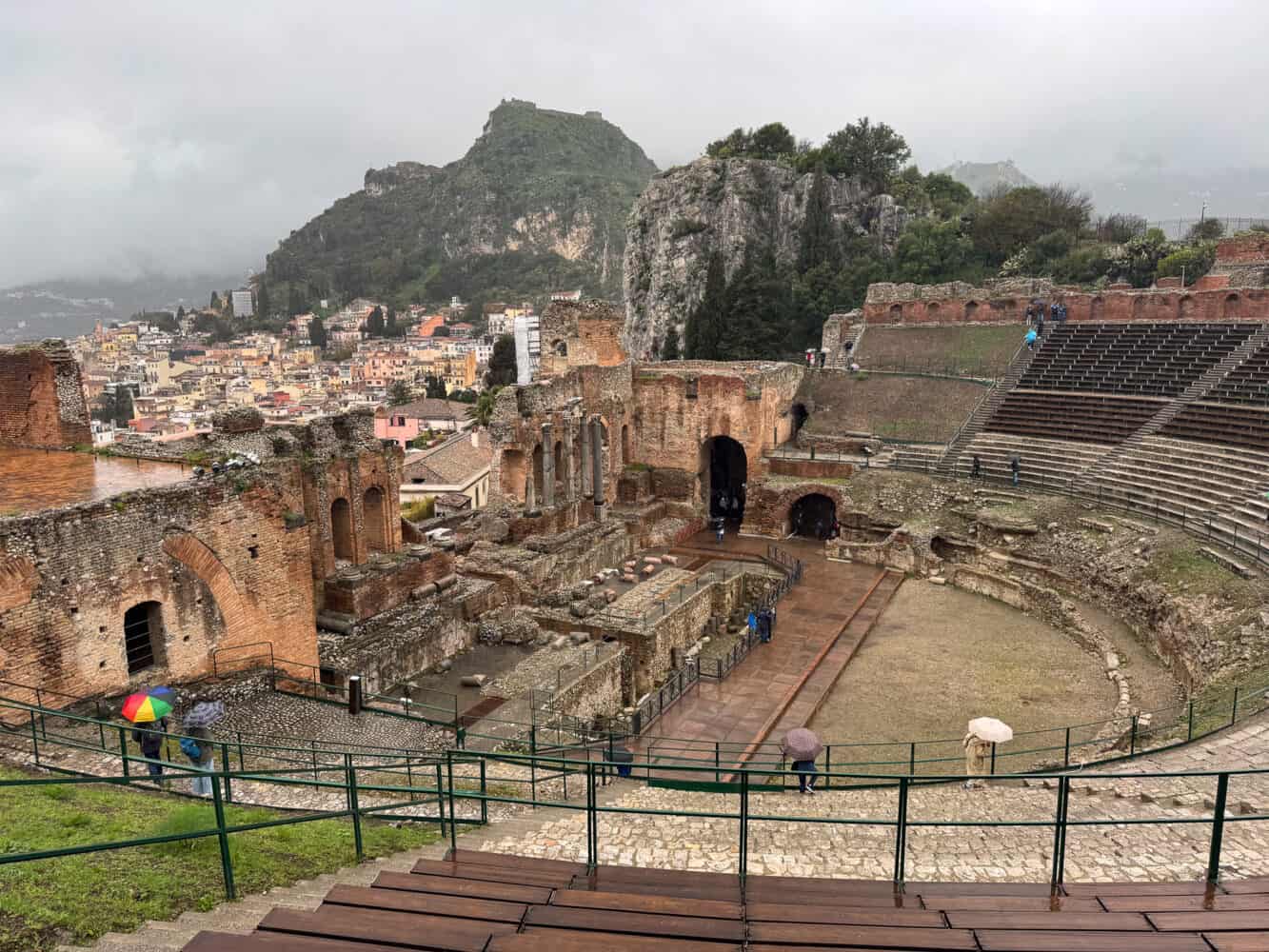
Entrance costs €14 for adults (under 18s are free). Opening times vary, so check the website.
To avoid the crowds, it’s best to visit first or last thing. In early spring, it wasn’t too busy in the middle of the day, though.
3) Stroll Corso Umberto
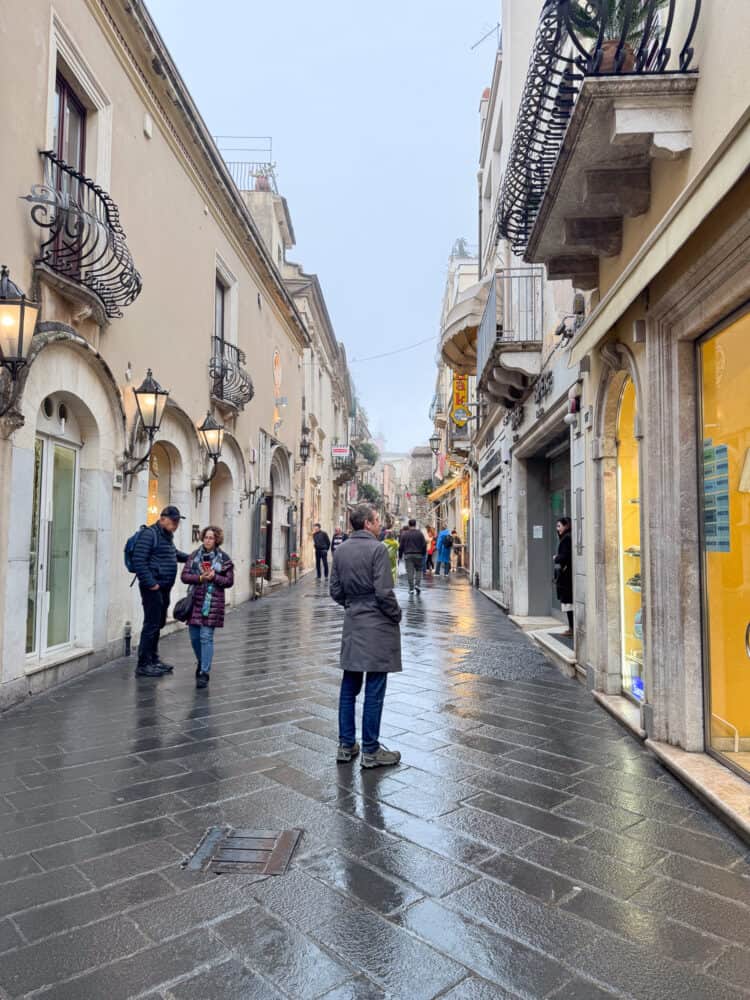
Corso Umberto is Taormina’s pedestrianised main street, running for almost 1km between the historic gates Porta Catania and Porta Messina.
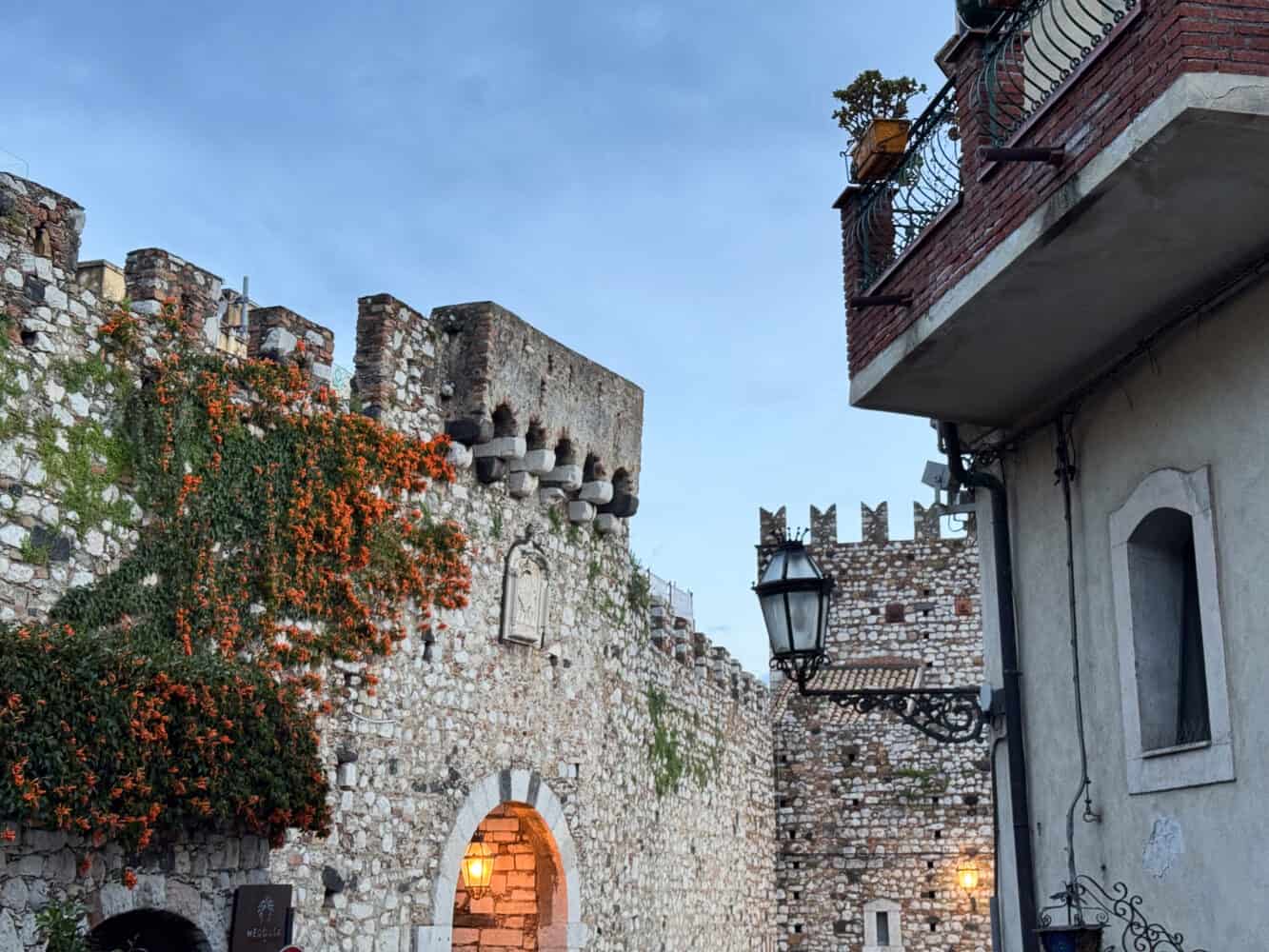
Here, you’ll find shops (a mix of cheap souvenirs, foodie treats, and high-end fashion) and some of Taormina’s main sights.
From the Porta Catania end, you’ll first come across Taormina’s tiny medieval Duomo (cathedral), which has a pretty fountain outside.
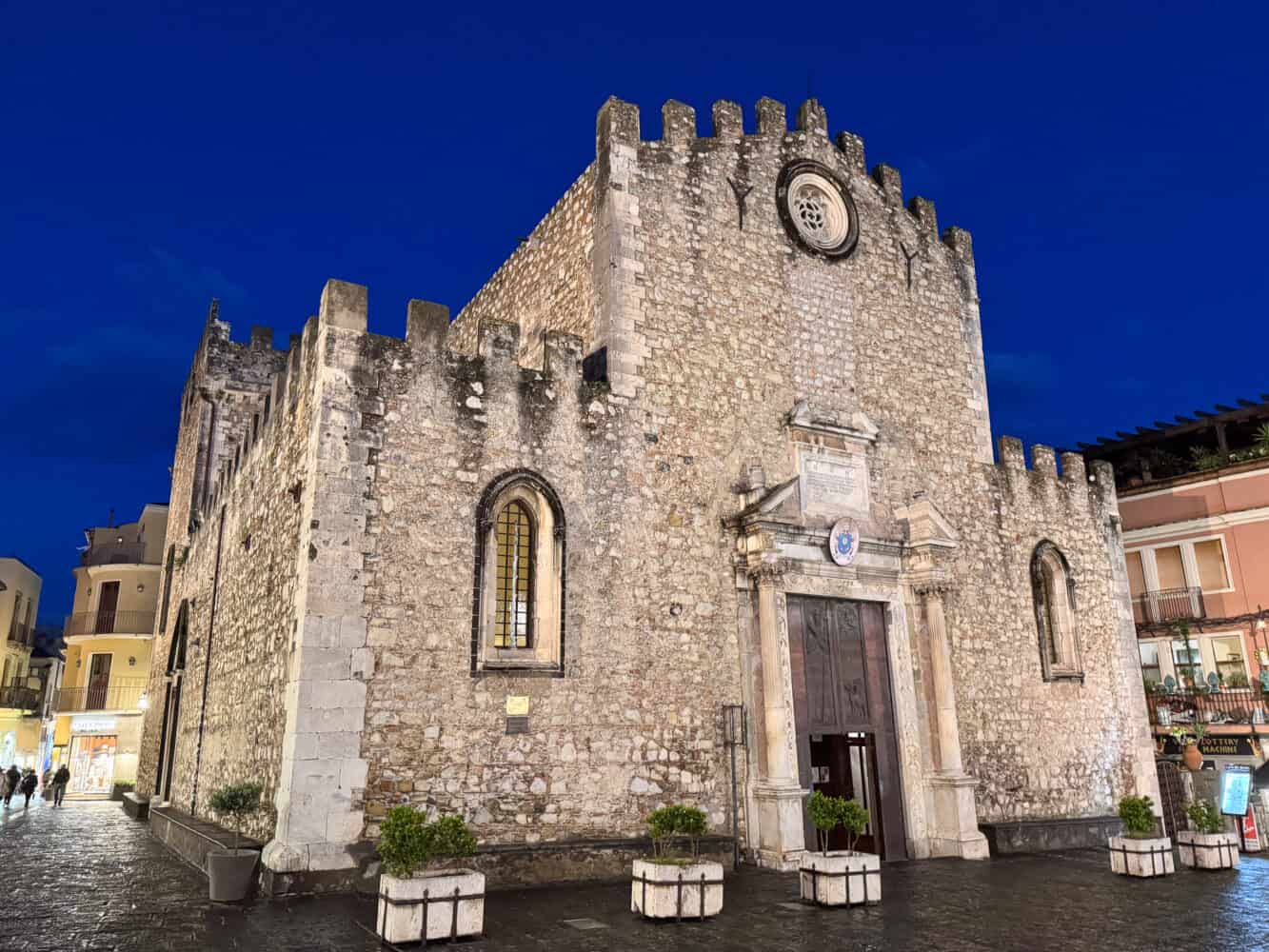
About halfway along Corso Umberto is the main piazza, Piazza IX Aprile, with its black and white checkered floor.
There are a couple of pricey cafes, the baroque Chiesa di San Giuseppe, and panoramic views of the sea and Mt Etna (maybe).
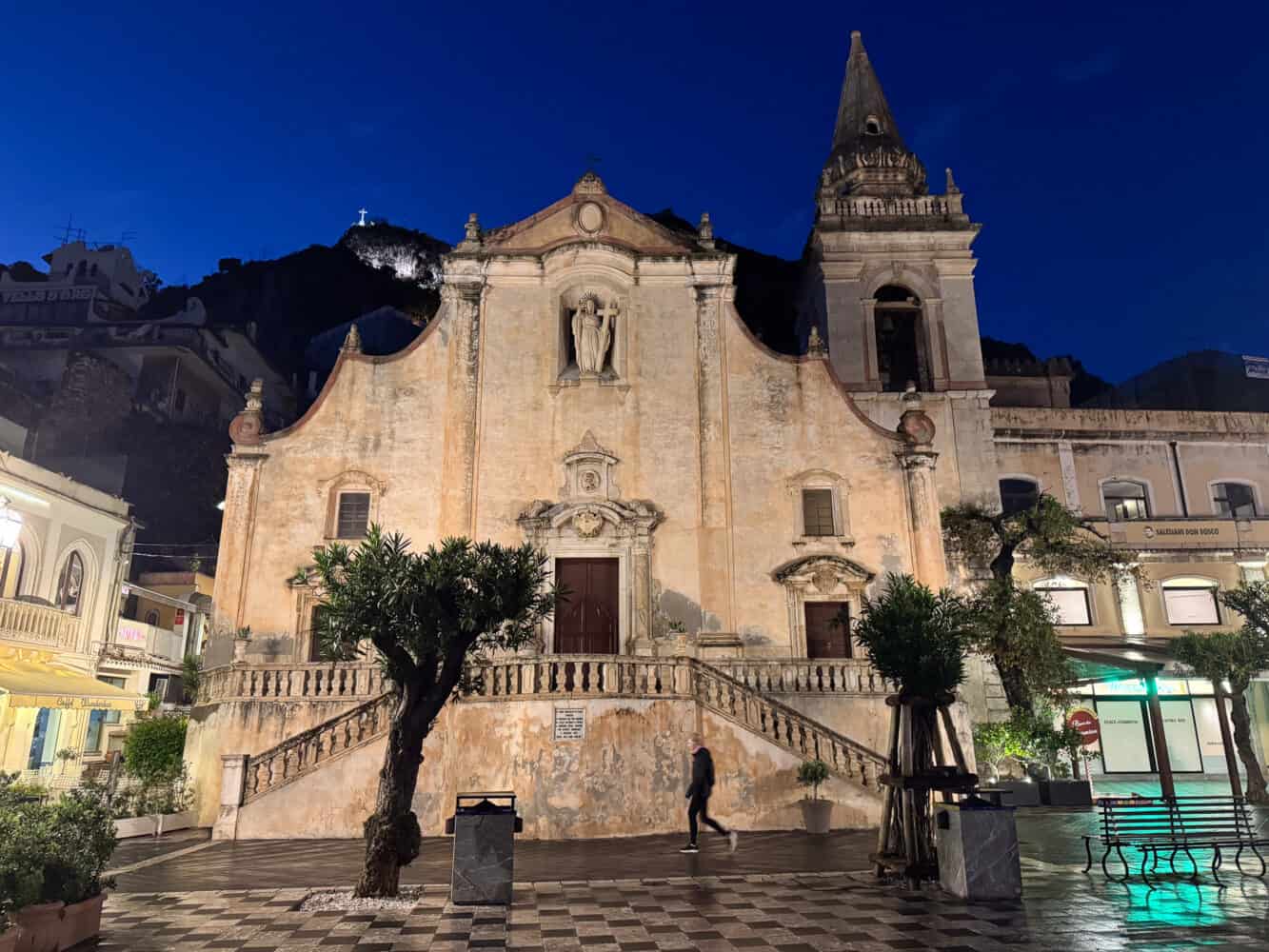
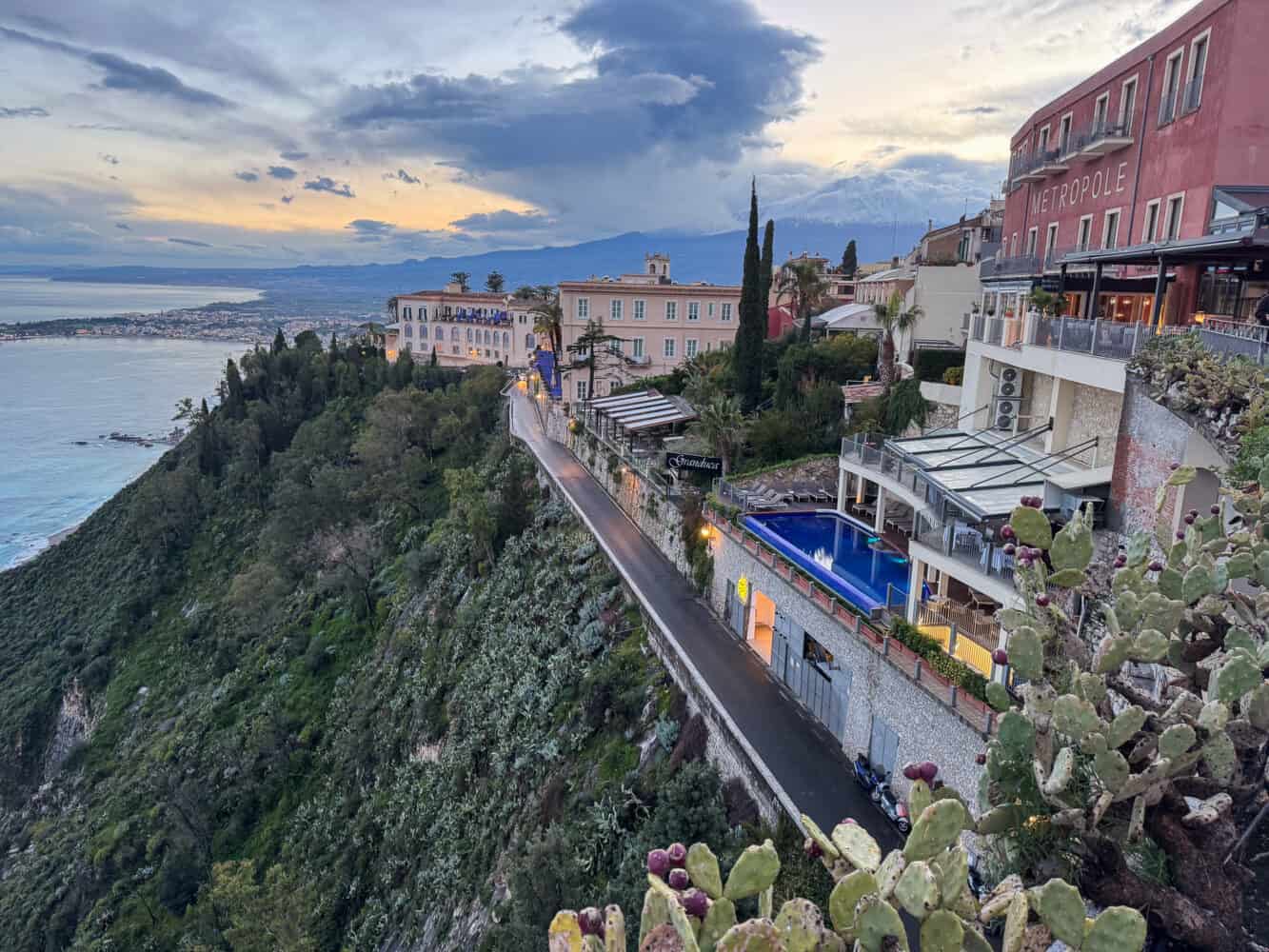
On a rainy evening, the outdoor seating here wasn’t appealing, so we had aperitivo in the Re di Bastoni Pub, a little further on from the piazza. It was the only lively bar, and I had my favourite negroni of the trip here. They also have craft beer.
Just before Porta Messina is Palazzo Corvaja, with its mix of architectural styles, from the Arabic tower battlements to the Norman hall (where the Sicilian parliament met in the 15th century) to Gothic mullioned windows. Entrance to the palace is currently closed.
4) Discover the Backstreets
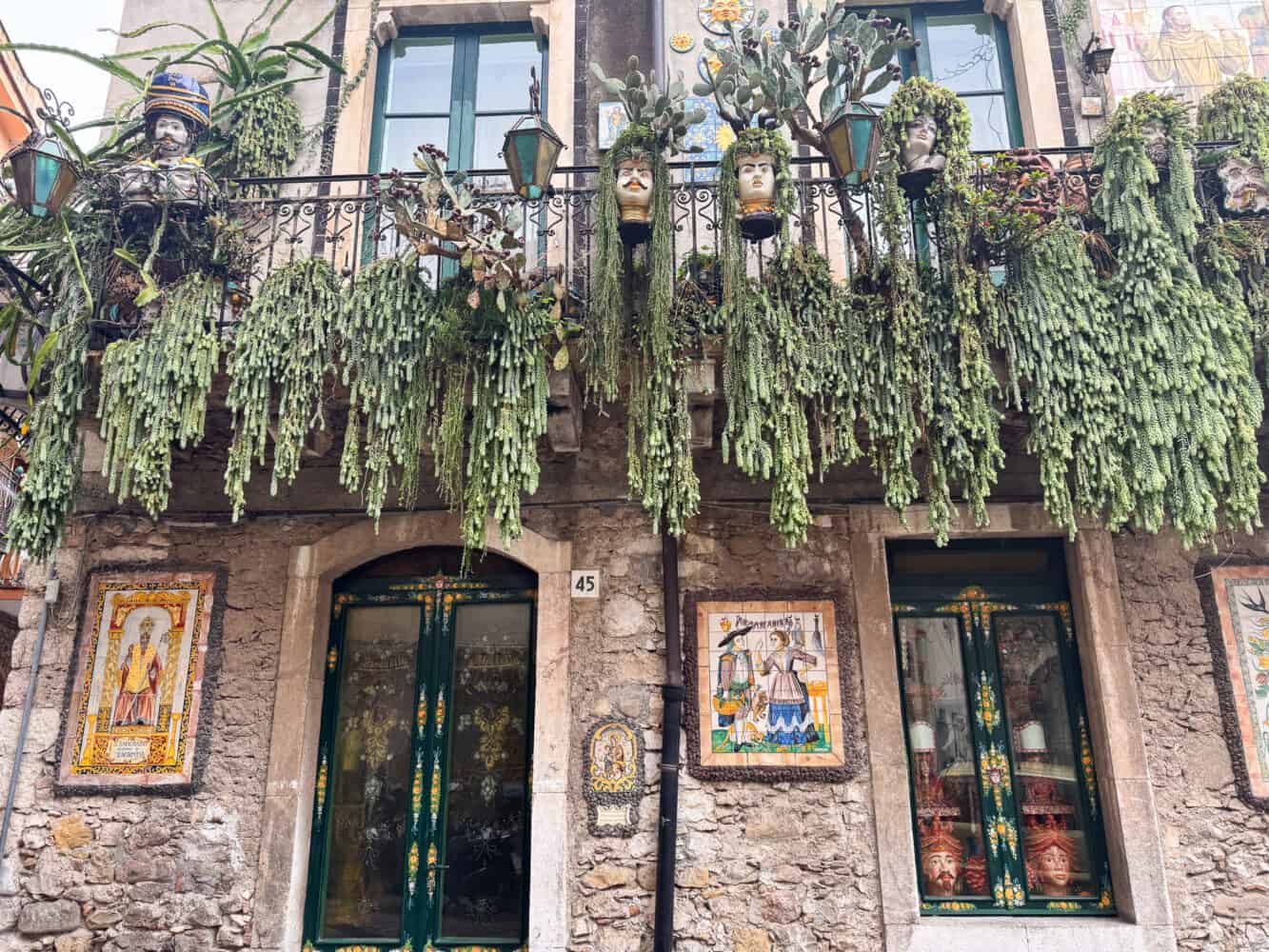
The crowds on Corso Umberto can get overwhelming at busy times, so be sure to head off it to explore the pretty backstreets.
One of our favourite discoveries was Giammonarte, an art shop on Via Giardinazzo (which runs parallel to the main street). The burro’s tail succulents dangling from the balcony are impressive.
The unique Teste di Moro (Moor’s Heads) ceramic plant pots are found all over Sicily and symbolise a tragic love story.
Another charming street is Via Timoleone, where, after visiting the Greek Theatre, we walked down stairs lined with orange trees and gorgeous-smelling Angel’s Trumpet flowers.
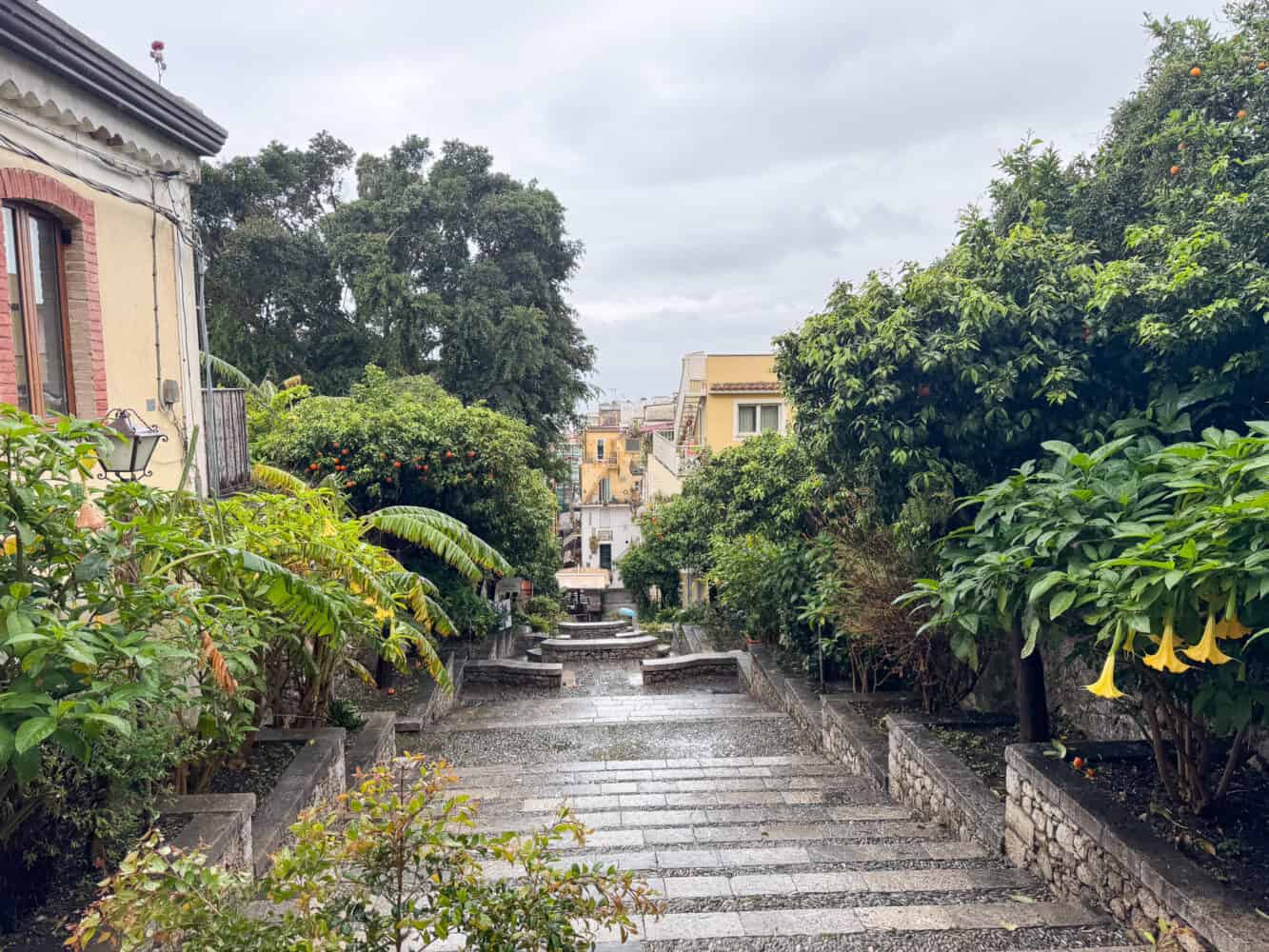
I Giardini di Babilonia restaurant here looked like a lovely place for a meal on a warm day in the garden under lemon and orange trees.
5) Admire the View from Chiesa Madonna della Rocca
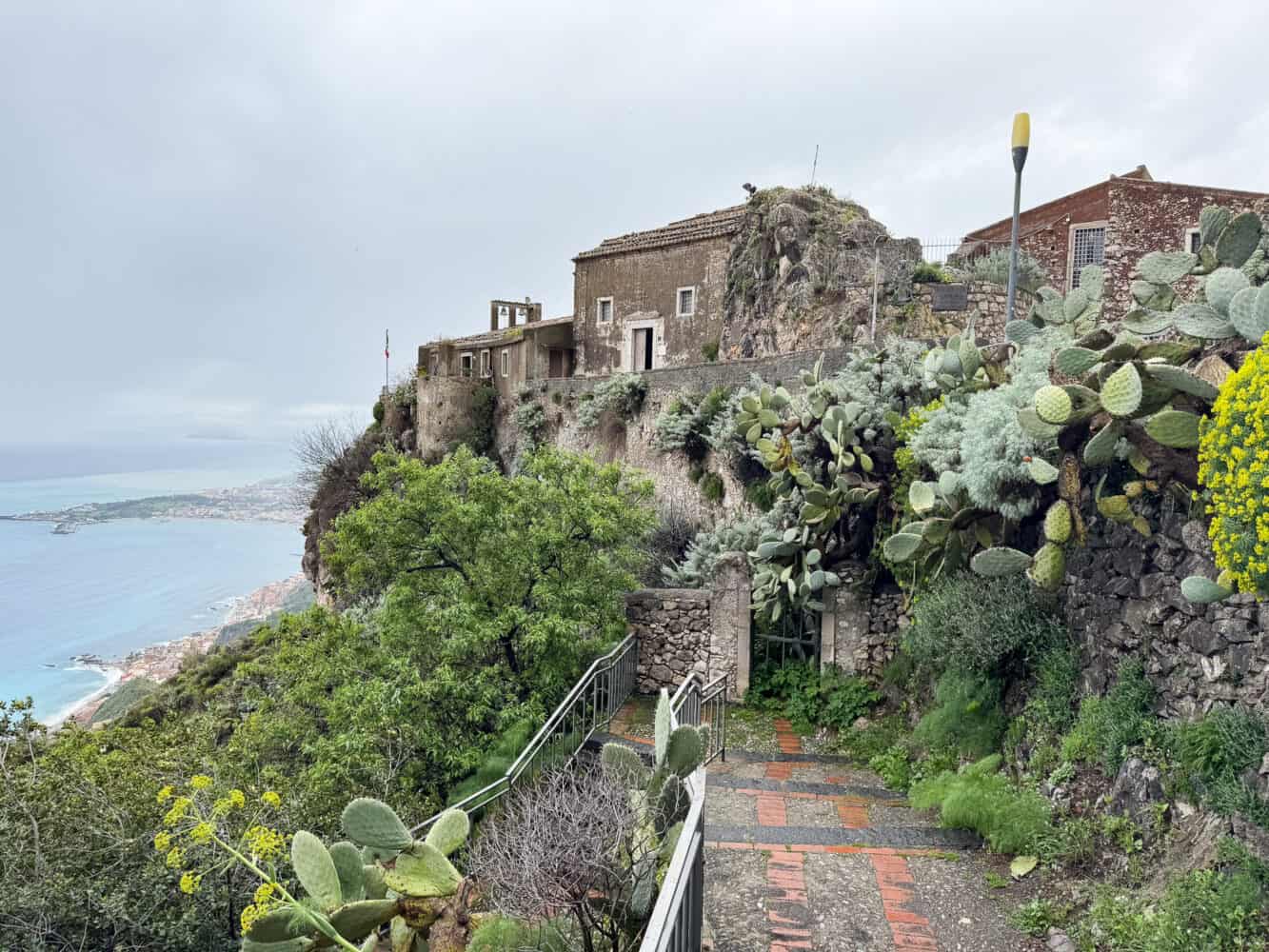
Chiesa Madonna della Rocca is worth the climb up from town. Look for the “Scalinata Salita al Castello” to find the staircase up (about 20 minutes).
Or it’s a much shorter walk if you stay at Villa Sara B&B like us.
The small church is carved into the rock, and you can go inside for free.
The highlight was the view of the sea, the whole town, including the Greek Theatre, and the cacti-lined path.
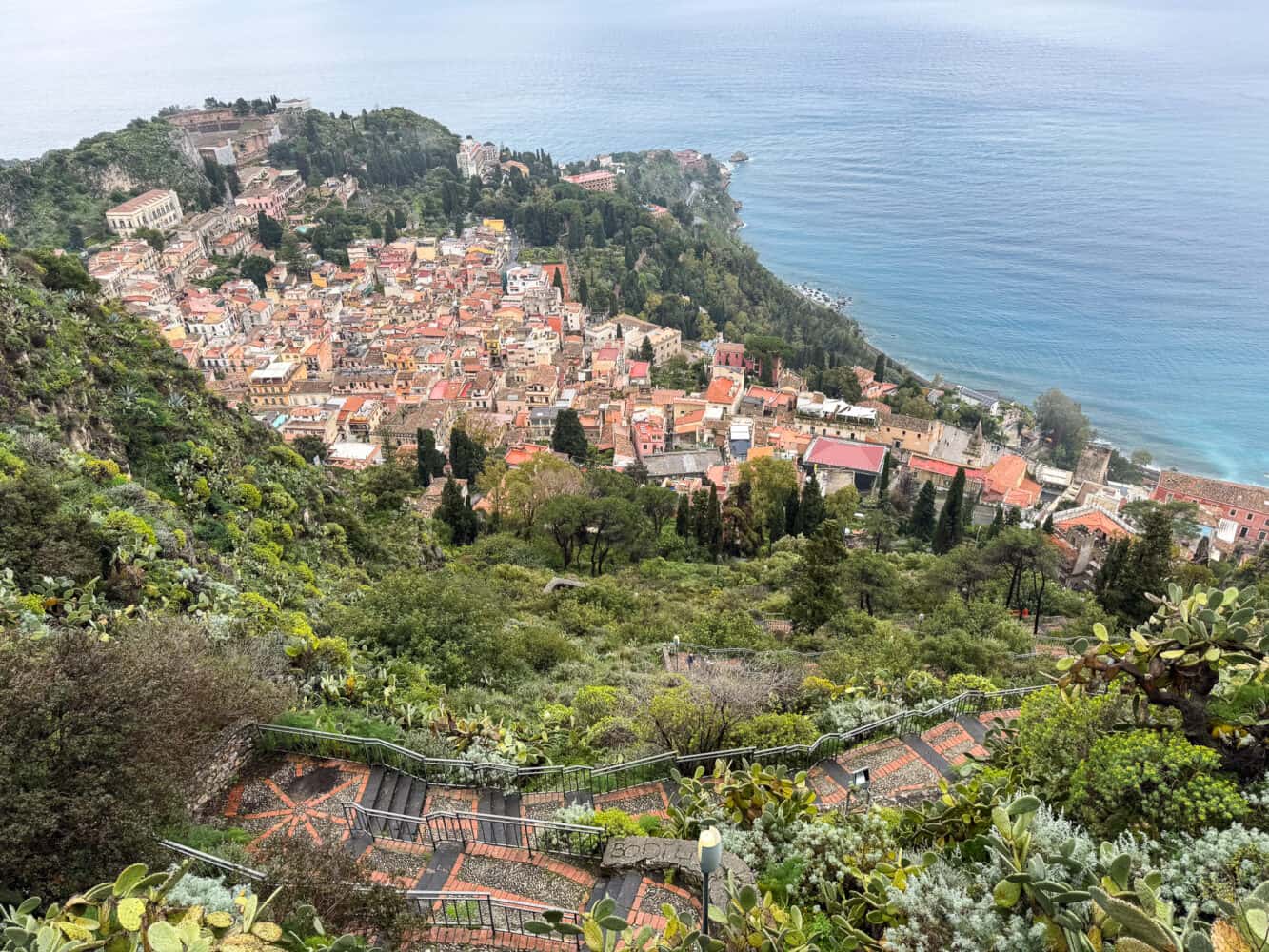
You can also walk further up to the castle, but our B&B host said it wasn’t worth it.
If you are a keen hiker, you can also continue up to the pretty village, Castelmola (see below).
6) Try Granita at Bam Bar
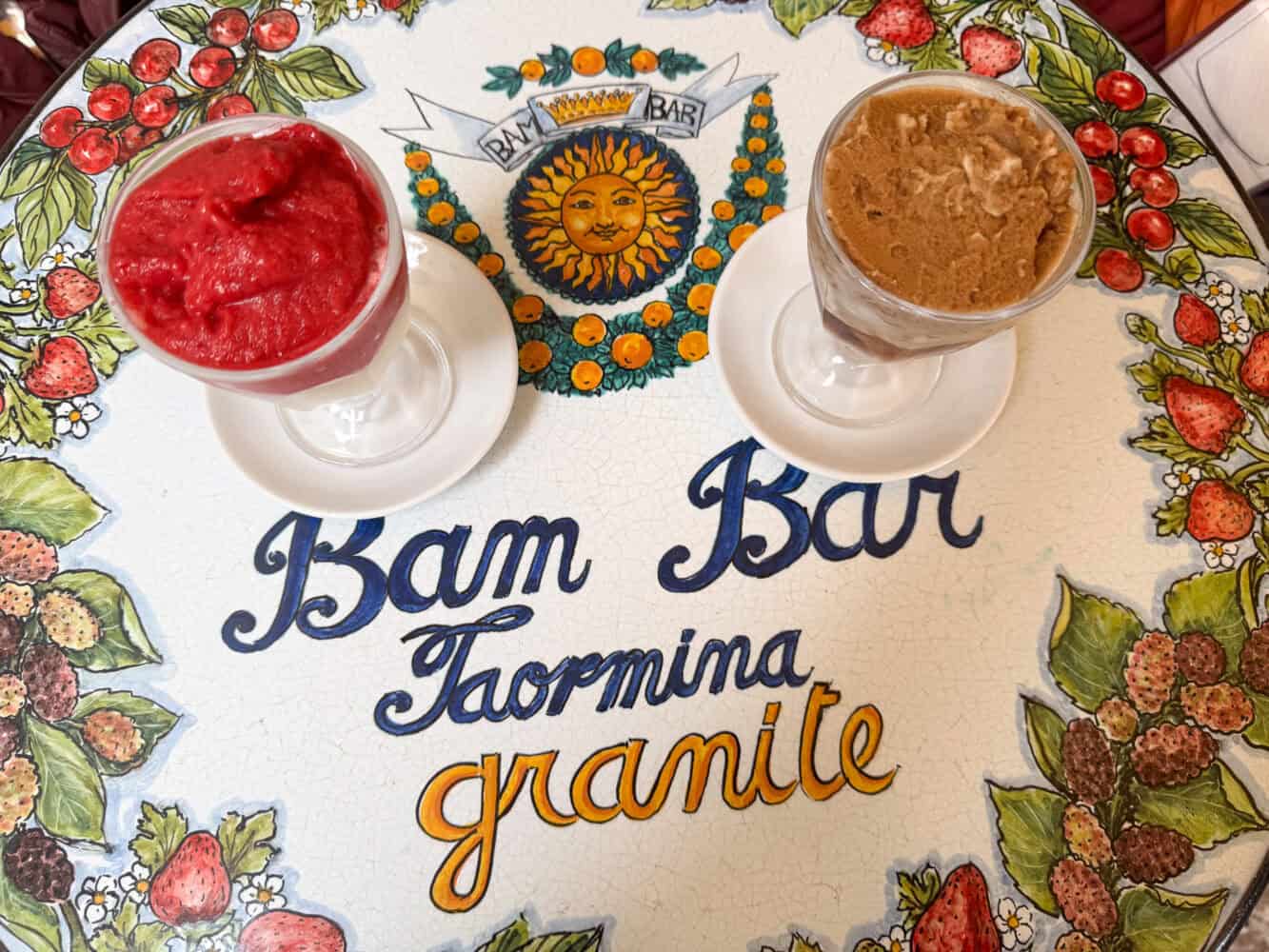
After climbing Taormina’s many staircases, you’ll appreciate a refreshing granita at Bam Bar.
Bam Bar is on every list of what to do in Taormina (and appears in The White Lotus), and happily, its frozen Sicilian treat (a cross between a sorbet and slushy) lives up to the hype.
The advantage of visiting in the off-season is that we got a table outside at this popular spot.
You can choose up to two flavours per bowl and opt for cream (panna) on top or a brioche on the side (the classic Sicilian summer breakfast combo).
Check the board outside for the flavours that are currently available.
My lemon and raspberry granita was absolutely delicious.
7) Wander the Gardens at Villa Comunale
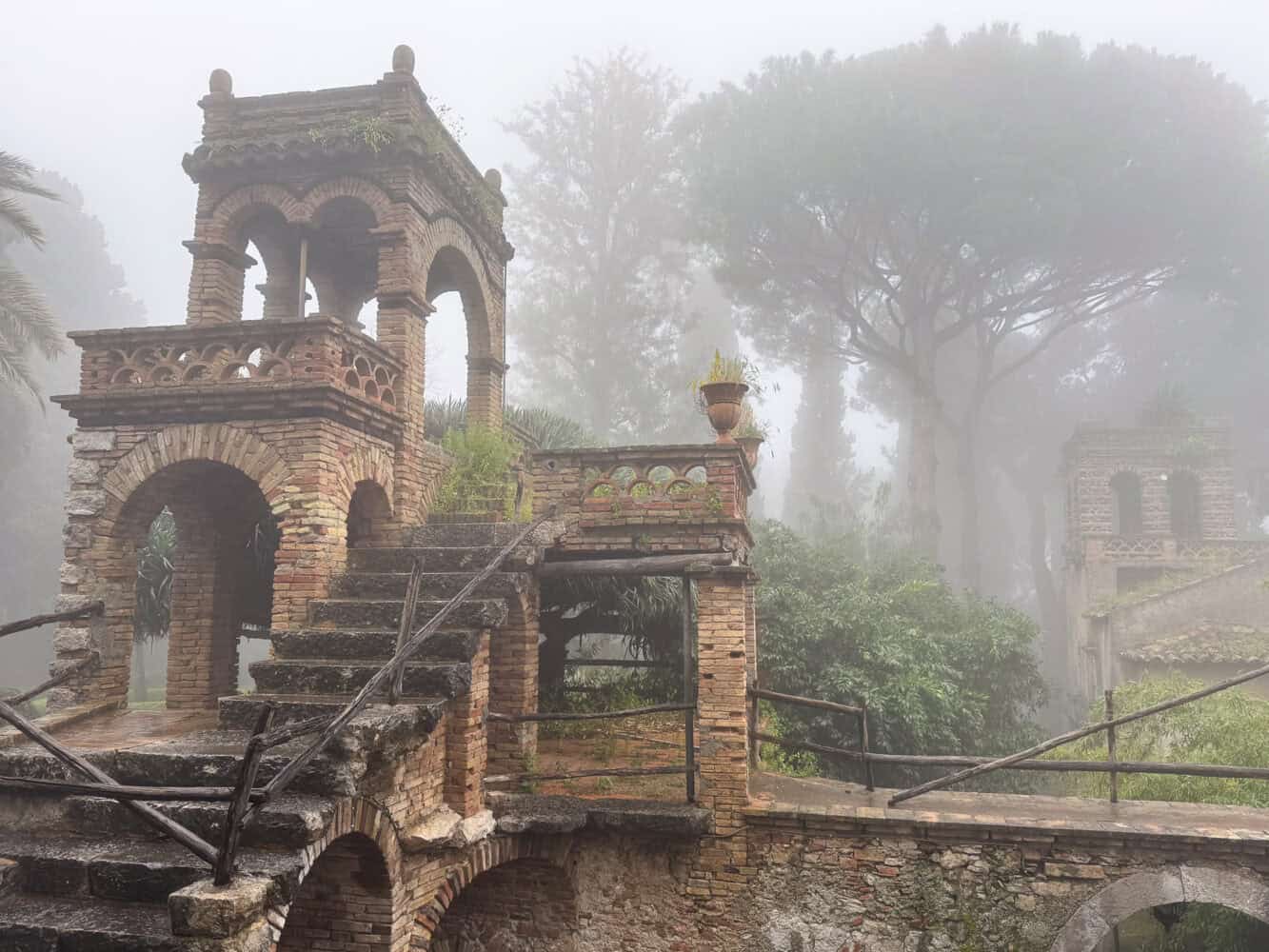
Villa Comunale is Taormina’s free public gardens. While only 5-10 minutes from the main street, it’s a much quieter spot to wander.
The garden was originally created in 1890 by Florence Trevelyan, a British woman who is rumoured to have been expelled from England by Queen Victoria after an affair with Prince Edward, the queen’s eldest son and heir to the throne.
She created a magical spot full of Victorian follies, trees, cacti, and flowers. Again, the sea views are wonderful.
Even shrouded in mist, it was a dramatic place to stroll.
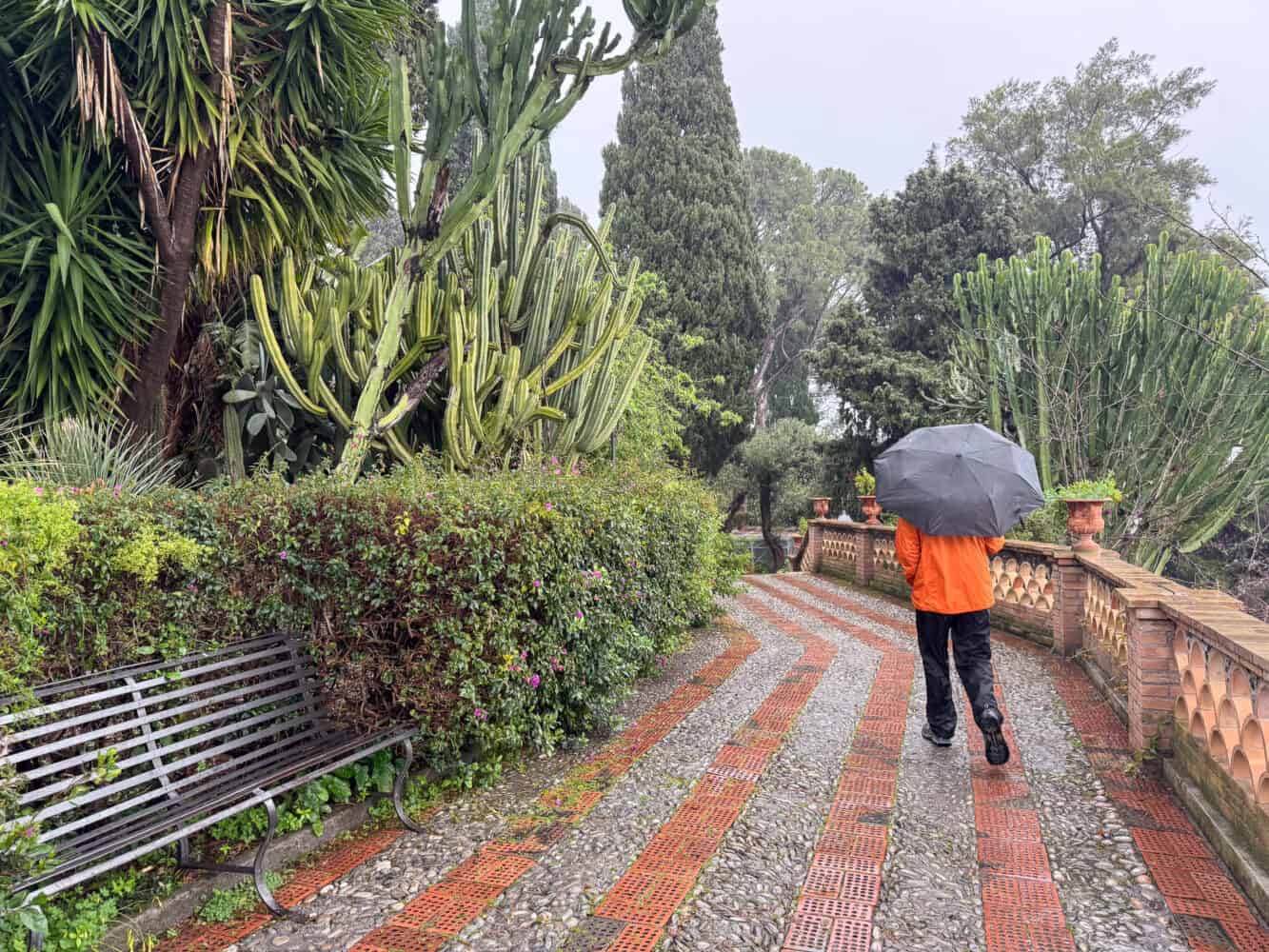
For a treat to accompany your walk, pick up a gelato from Crema e Cioccolato next to the gardens (the pistachio was excellent).
8) See Isola Bella from Above
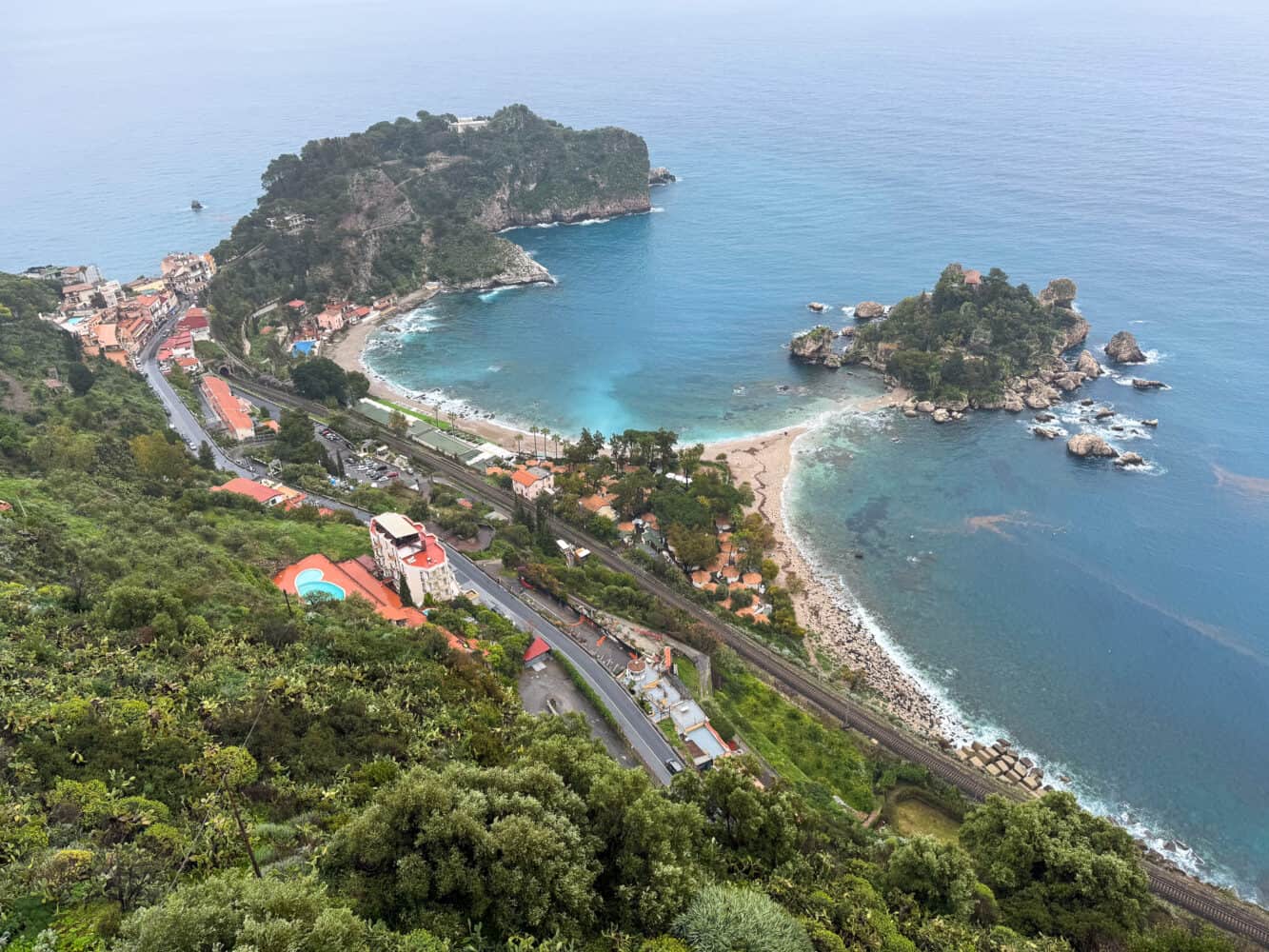
To see another of Lady Trevelyan’s creations, continue from the end of Villa Comunale down Via Bagnoli Croci to Belvedere di Via Pirandello.
It’s not a particularly pleasant walk next to the road, but it only takes five minutes to reach the viewpoint that overlooks Isola Bella.
Isola Bella is a tiny, rocky island off Mazzarò Beach with a villa and garden created by Lady Trevelyan.
At low tide, you can walk over there (wear water shoes) and the pebble beach opposite is an extremely popular spot in summer.
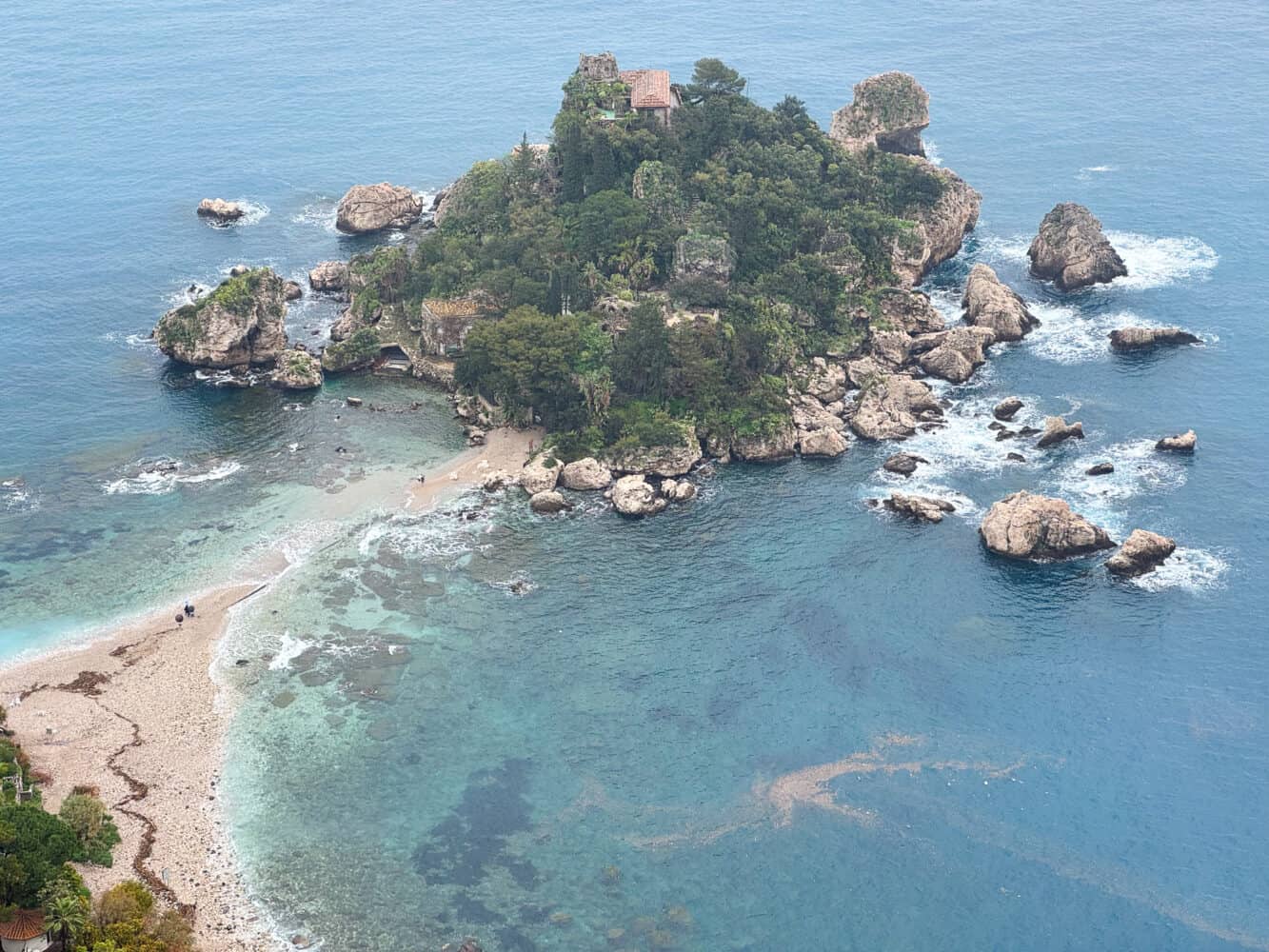
It’s now a nature reserve and you can visit daily in summer and on weekends and holidays in winter. Check the Isola Bella website for hours. It can close in bad weather. Entrance is €6.
In March, we contented ourselves with the view from above. Even on a rainy day, we could see how clear the sea would be in the sun.
There’s a bar, L’Oblò Cafè, next to the viewpoint with outdoor seating to enjoy the view, but it was closed on our visit.
To reach Mazzarò and Isola Bella you can walk down the steep stairs next to Belvedere di Via Pirandello (20 minutes or so) or take the Funivia (cable car) from near the centre of Taormina.
If the weather had been warmer, I’d have loved to take this White Lotus boat tour to Isola Bella and several caves.
9) Enjoy a Delicious Meal
We found the casual eateries in Taormina more appealing than the formal (and pricey) restaurants. While it is a touristy town, you can still find some excellent food.
Here were our favourite places to eat:
La Bottega del Formaggio
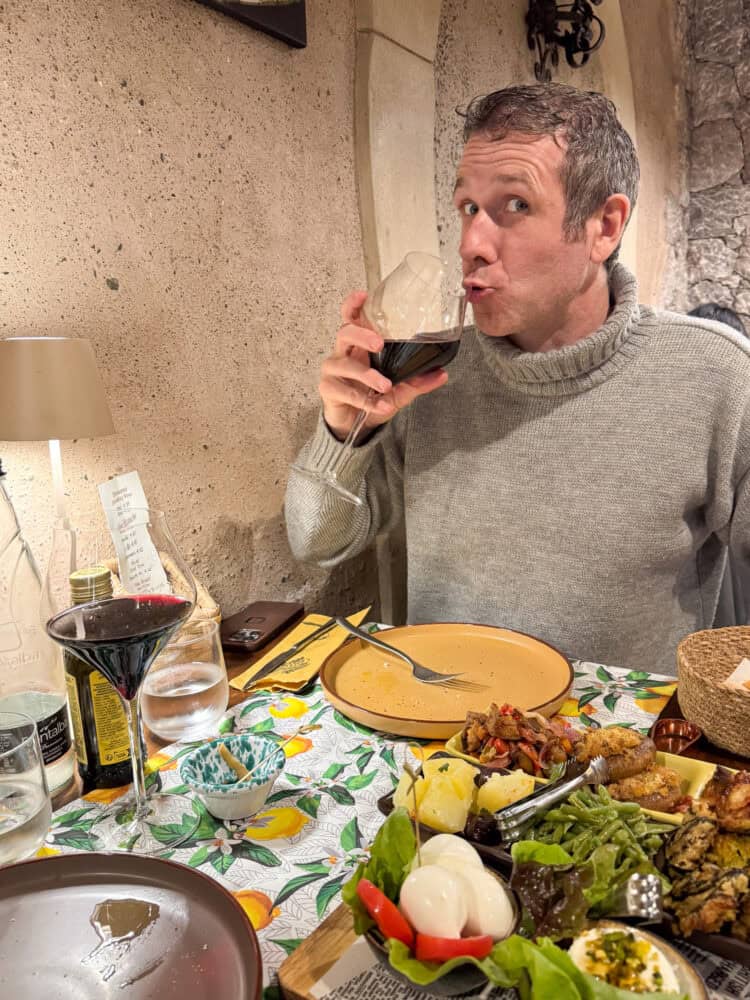
La Bottega del Formaggio is a cheese shop and deli with a dining room in the back where you can sample their products and local wine.
A tagliere (platter of small bites) is our favourite thing to eat in Sicily, and this was the best we had. Our vegetarian version was full of delicious cheeses, vegetables, and hot dishes like the Sicilian classics, caponata and melanzana parmigiana.
We got the medium size, which seemed expensive at €42, but it was plenty of food for two people and well worth it.
Meat and vegan tagliere are also available.
It’s also a good place to try local wines—we loved our Spadafora Syrah.
We had no problems getting in at lunchtime (which they serve until 3.30pm), but in the evenings (or high season), reservations are a good idea.
Rosticceria Da Cristina
Da Cristina is known as having the best arancini (rice balls) in Taormina, and we agree.
This is a great option if you are looking for a quick, casual meal. You can get a takeaway or eat at the limited bar seating inside. The branch near the Duomo (Via Strabone 2) also has a casual restaurant next door, where we ate.
As well as arancini (we chose the melanzana), we enjoyed their melanzana parmigiana. All the melanzana (aubergine/eggplant) in Sicily is great for vegetarians!
They also have pizza slices and other snacks. We got some takeaway slices for our Etna day trip.
The other branch is Da Cristina 2 at Via Giovanni di Giovanni 28 (near Bam Bar).
Pizzeria Villa Zuccaro
Pizzeria Villa Zuccaro is a busy pizzeria where we enjoyed excellent Margherita and Norma (aubergine) pizzas.
In better weather, you can dine under lemon trees in the courtyard.
Taverna Don Nino
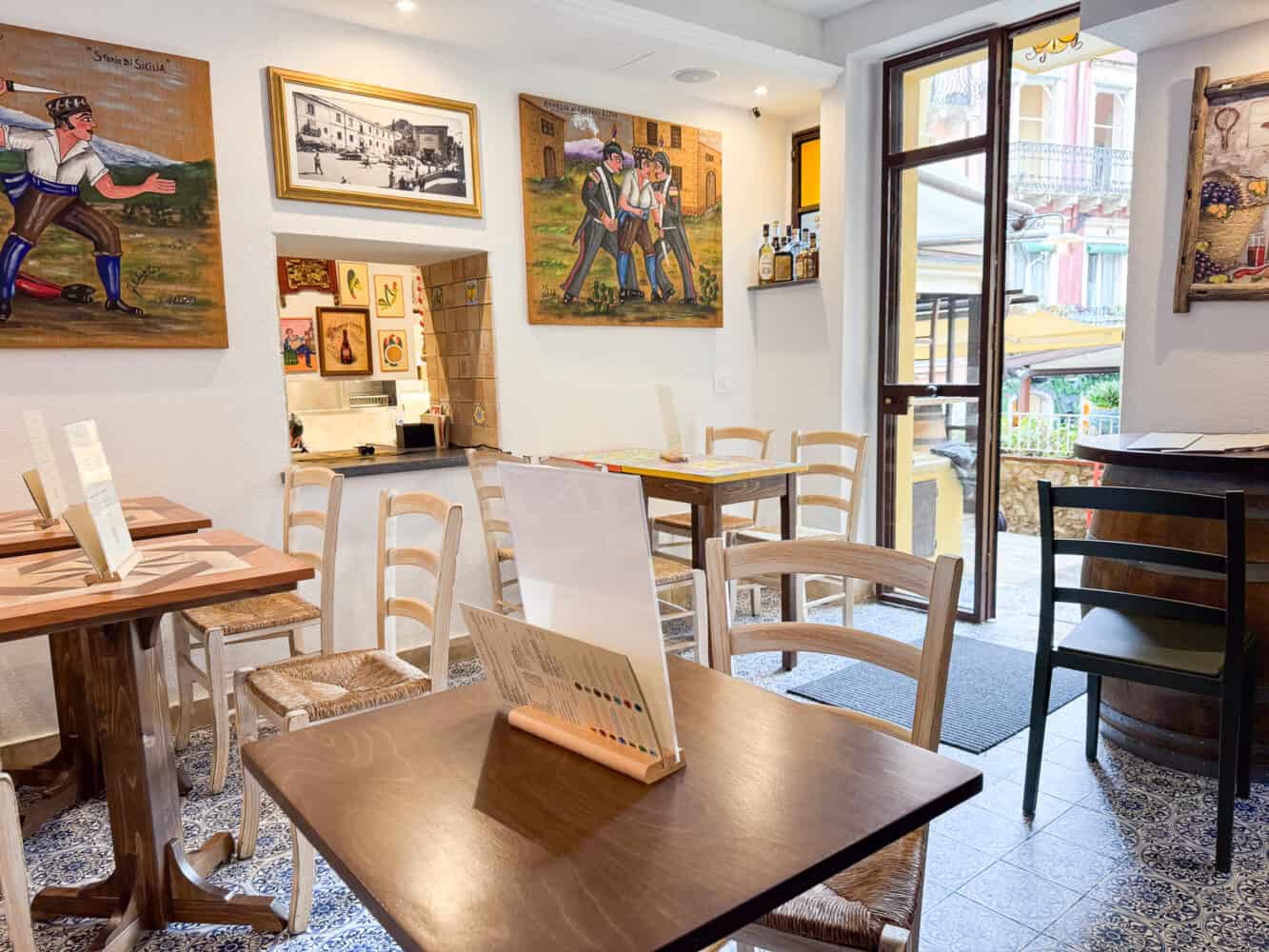
Taverna Don Nino is a simple restaurant with indoor and outdoor seating. The small food menu includes antipasti, bruschetta, and a few pasta dishes.
It’s ideal for lunch, aperitivo, or a casual dinner without the pressure to have multiple courses.
For lunch, we shared a tomato bruschetta and vegetarian antipasto rustico, which included potato fritatta, greens, and caramelised onion and provola crostone.
It wasn’t as delicious or diverse as the platters at La Bottega del Formaggio, but it was much cheaper at €12 and a good option if you’re on a budget or just want a simpler meal.
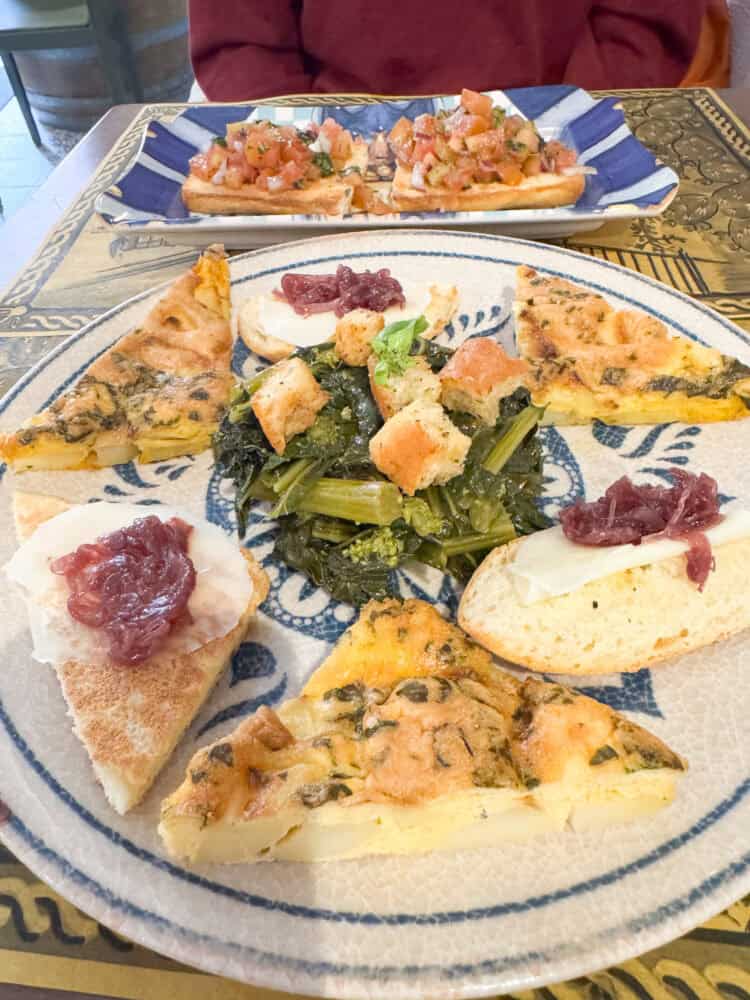
Taverna Don Nino also has one of the cheapest Spritzs in town (€4.50).
10) Take a Day Trip to Mt Etna
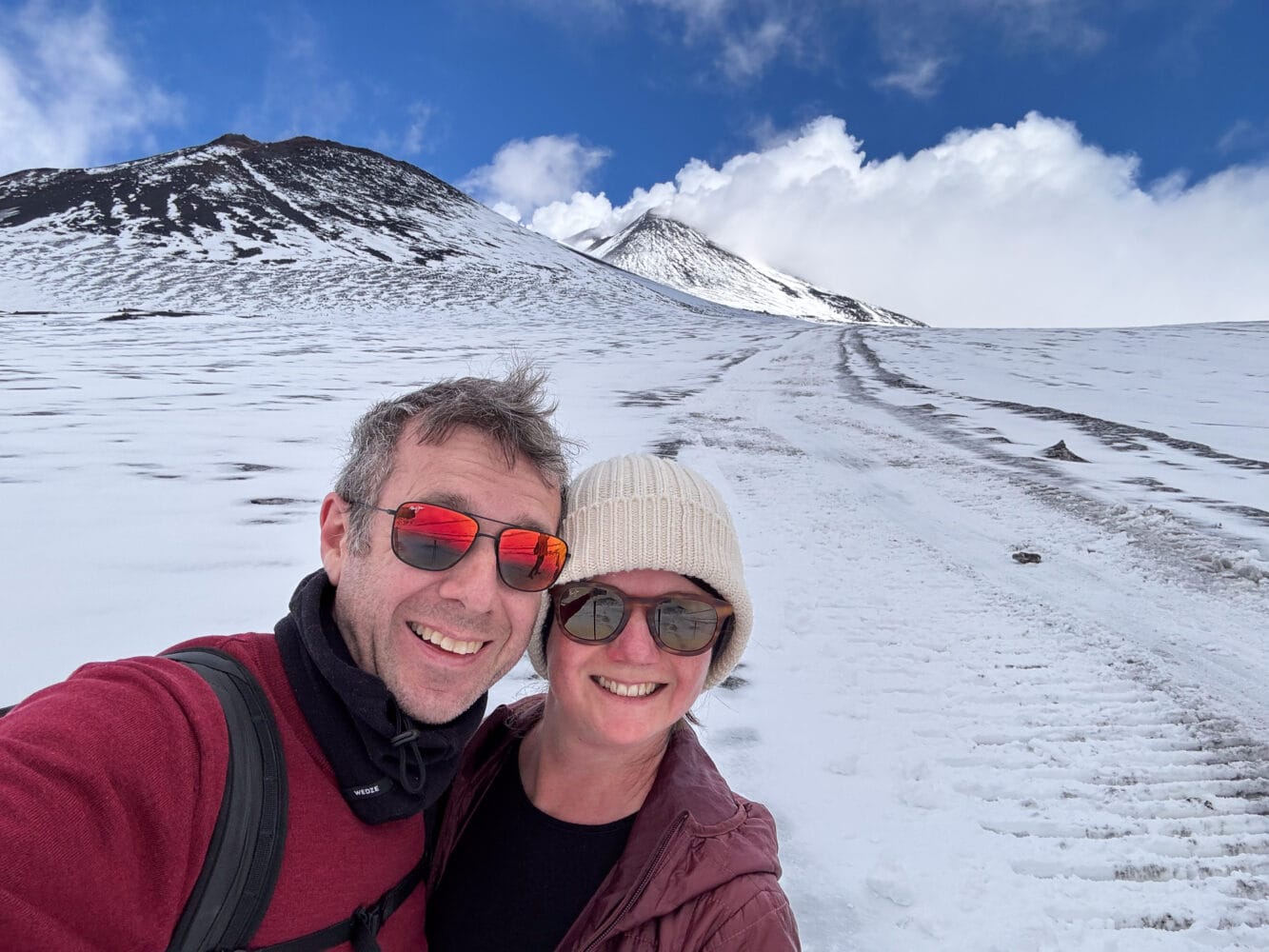
One of the best day trips from Taormina (and a highlight of our East Sicily itinerary) is to visit Mt Etna, Europe’s tallest and most active volcano.
There are a variety of experiences available from visiting the wineries on its slopes, doing a DIY hike, or heading close to the summit (where you must have a guide).
Rifugio Sapienza is the most common access point to the higher elevations of Etna as you can take a cable car up to 2500 metres (8200 feet) and hike from there.
It’s a 1 hour 15 minutes drive from Taormina. We drove ourselves and met our tour there—we did this Etna Volcano: South Side Guided Summit Hike with Ashara.
There are also tours from Taormina that include transport such as this Etna summit and Alcantara tour with Etna People.
Our tour cost €65 per person, plus on the day you pay €52 each for the cable car (you may need cash for this, but we paid by card).
After taking the cable car, we hiked up to a crater at 2900 metres (9500 feet). Due to eruptions, it hasn’t been possible to get to the summit for years, but it’s still well worth doing.
It was a fairly strenuous climb up (especially in the snow in March!), so I only recommend it if you are fit and an experienced hiker.
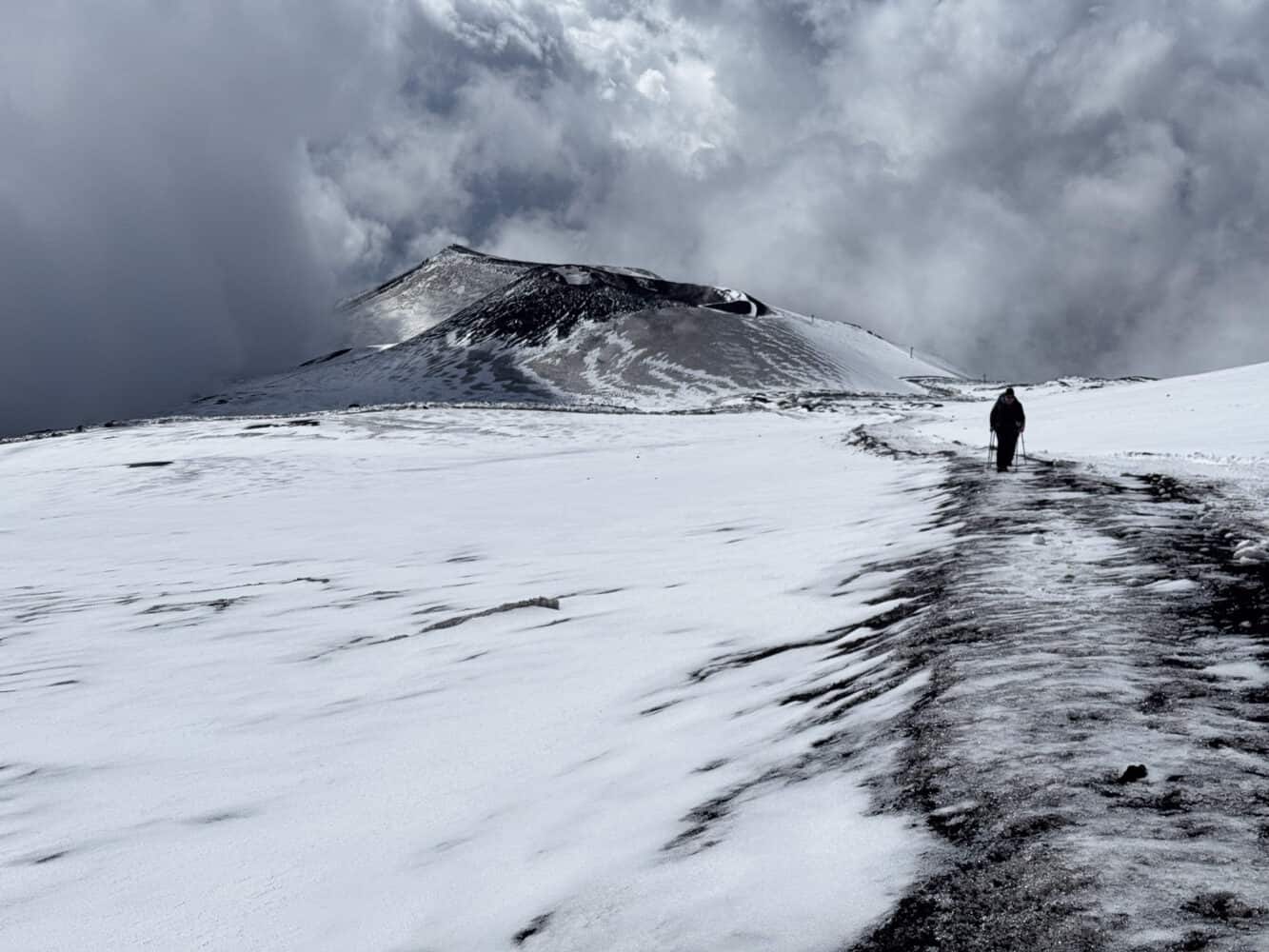
The scenery was stunning and our geologist guide gave us lots of interesting information about the volcano. He was also very safety conscious, and we turned back after the weather came in, and we had to hike down in a snowstorm.
It was quite intense, but we enjoyed the adventure!
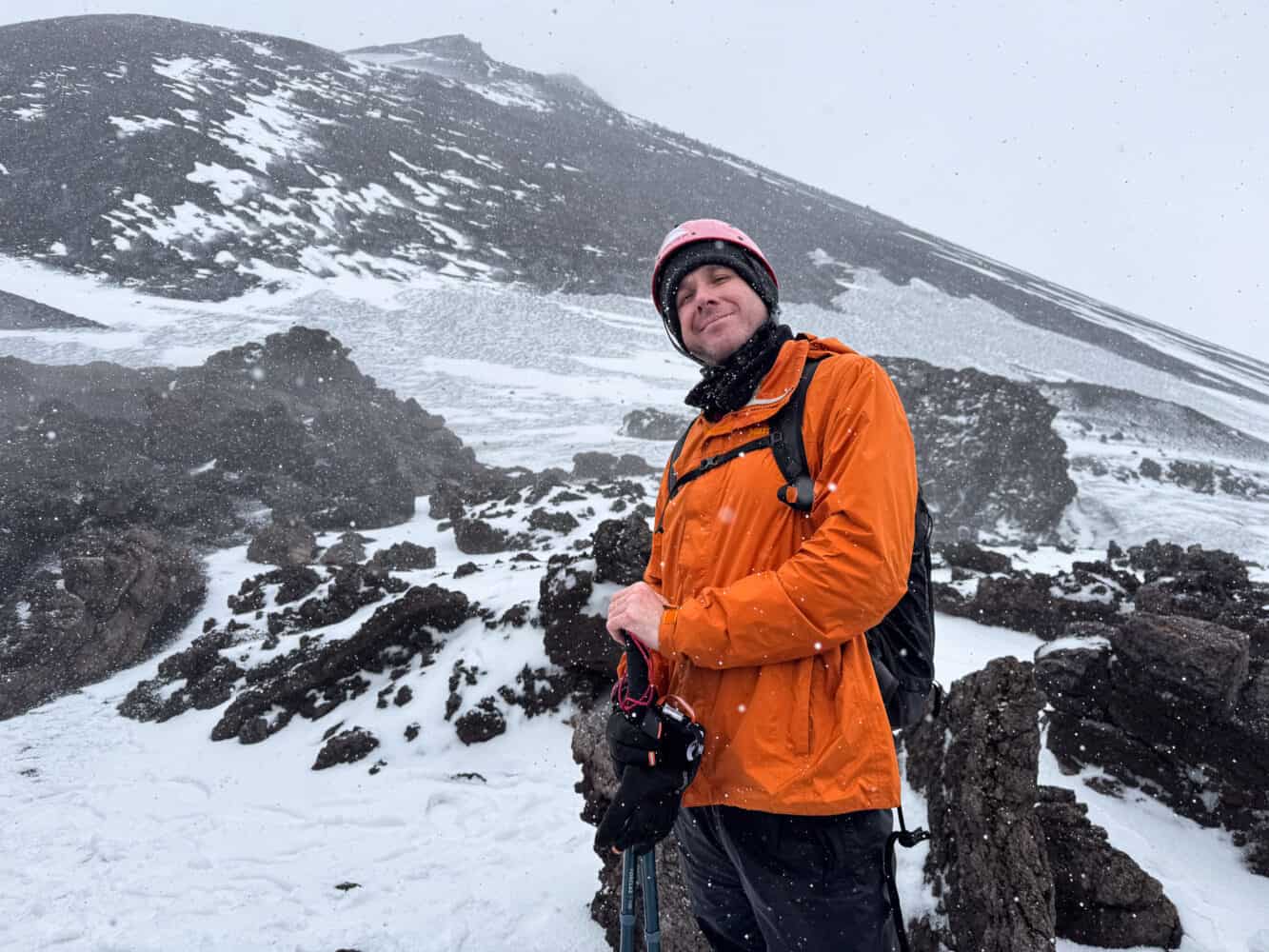
Overall, our hike was 6.7km (4 miles) with a 496m (1627 feet) elevation gain. It took just over three hours, including plenty of breaks.
The advantage of an off-season visit was a smaller group (nine people) and no long waits for the cable car. In summer, Etna can be very busy.
If you don’t want to hike, you can also book a cable car and 4WD bus combo at Rifugio Sapienza.
I recommend booking an Etna tour for your first full day in Taormina, as they can be cancelled due to weather (ours was). You could also visit Etna from Catania.
11) Head Up to Castelmola
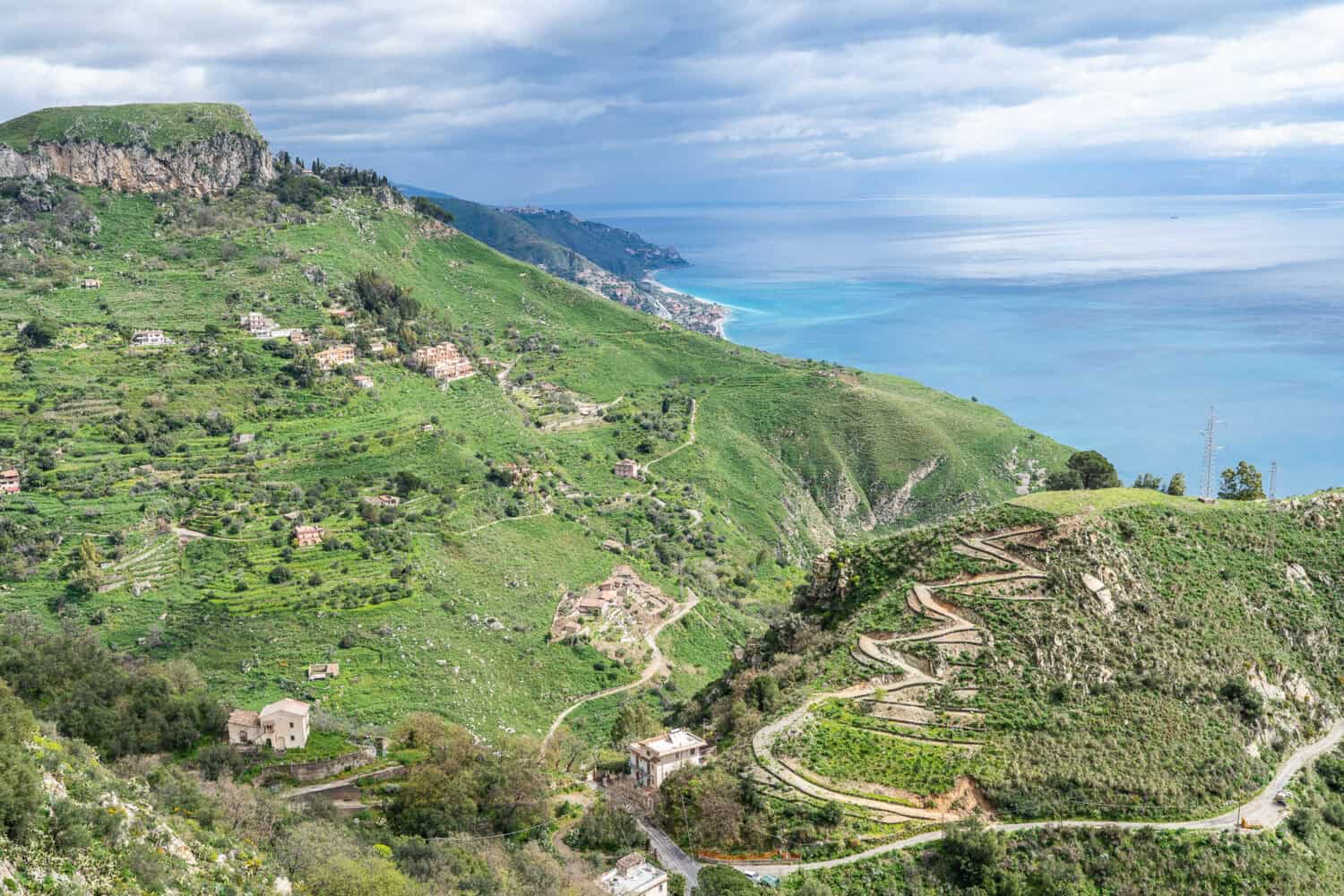
Castelmola is a medieval village even higher up the mountain than Taormina.
It’s worth visiting to wander the quiet lanes, admire the incredible views, and sample the sweet vino alla mandorla (almond wine) at Antico Caffè San Giorgio.
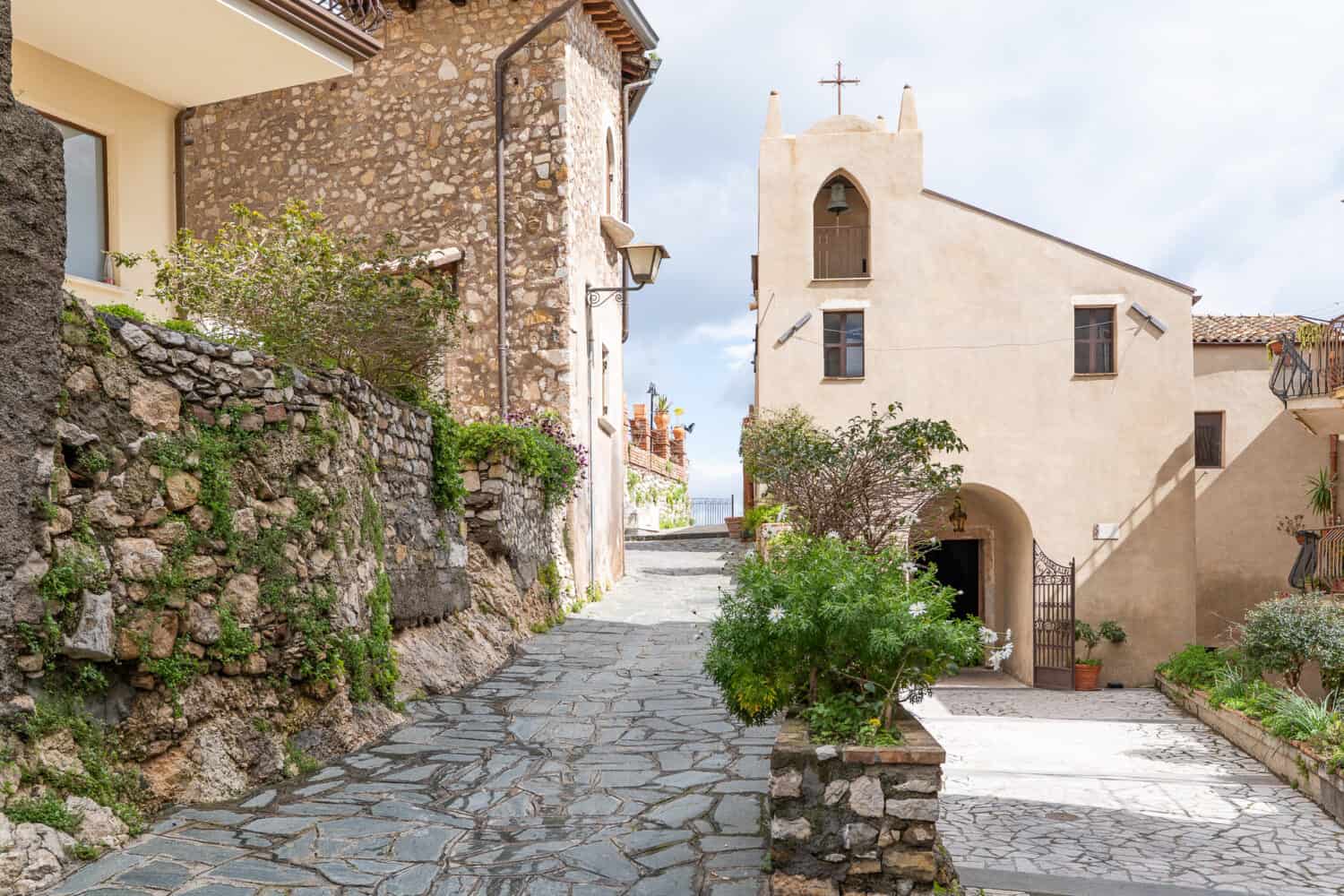
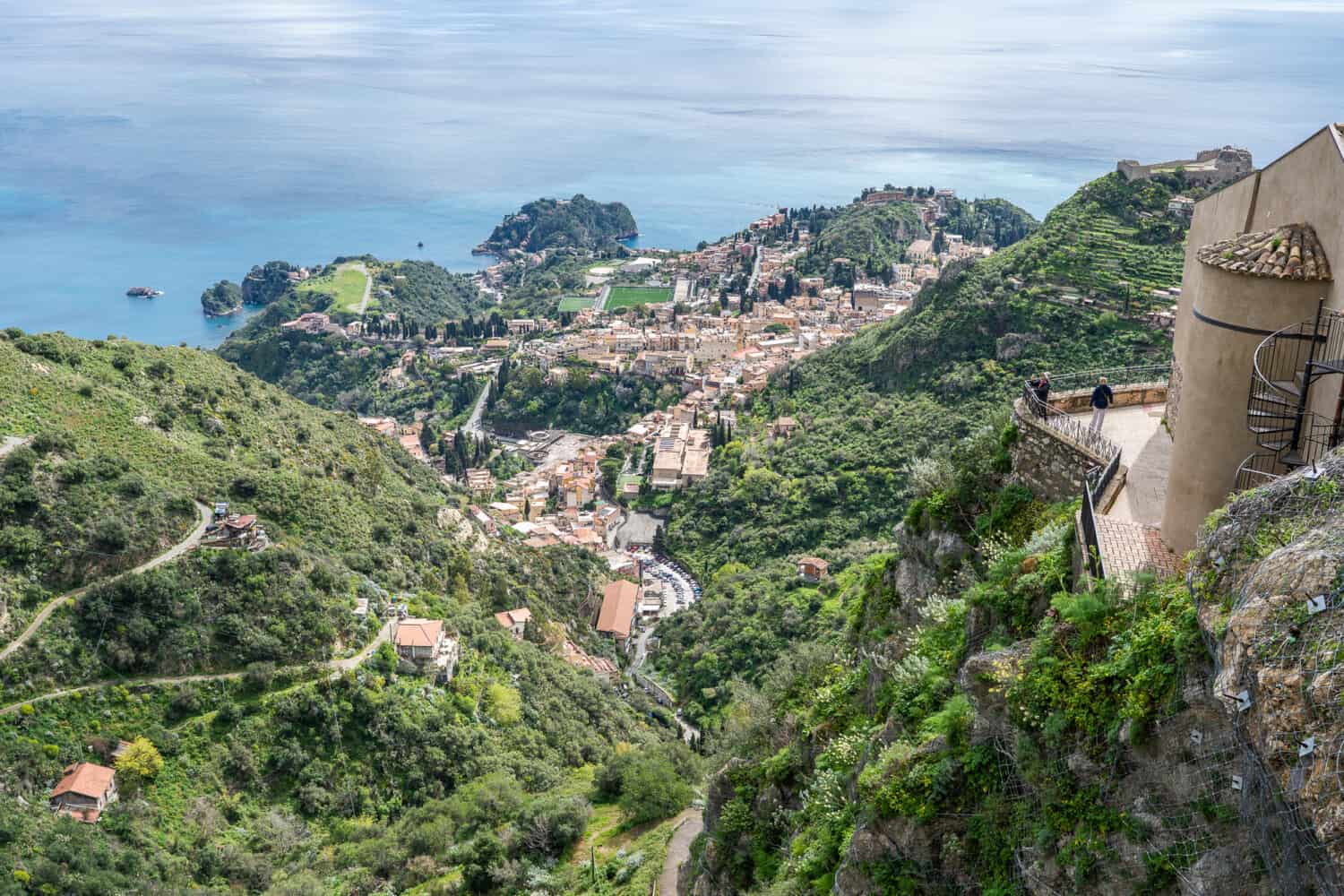
We originally planned to hike to Castelmola (see the 4km return route on Alltrails), but our legs were too sore after Etna. We drove up after checking out of our B&B, but you could also get the bus (although they aren’t very frequent).
We parked in a car park at the edge of the village (€1 an hour cash, but there’s a car park further up that accepts the Easypark app).
How to Get to Taormina
Taormina is in the northeast of Sicily, a large island south of the Italy mainland.
It’s 69km (43 miles) north of Catania International Airport, where we rented a car. The drive took us 1 hour and 15 minutes.
We rented a car because we were on an Eastern Sicily road trip, but you don’t need a car once you are in Taormina.
In fact, parking is expensive. Our B&B Villa Sara had a private garage for €10 a day (a good deal) so our car was easy to access for our Etna day trip.
Some hotels have parking, but otherwise you’ll have to park in one of the parking lots on the edge of town—Porta Catania Parking (closest to town) or Parcheggio Lumbi (a bit further, but it has a shuttle).
If you don’t want to drive, the easiest way to get to Taormina from Catania Airport is the Etna Trasporti bus (1.5 hours).
There’s also a train station down the hill called Taormina-Giardini. From there, you can take a bus or taxi to the centre of Taormina (10-15 minutes). Use Trenitalia to search for train times.
Taormina Map
Is Taormina Worth Visiting?
Taormina is well worth visiting, especially outside the peak summer months when it gets very busy.
We loved the stunning views of Mt Etna and the sea from almost everywhere in town, and the fascinating Greek Theatre exceeded our expectations.
Despite being a touristy town, we found some delicious food at the more casual spots.
Taormina isn’t large, but there’s enough to do to keep you busy for three days or so (especially if you like to hike or want to visit the beach). I think it warrants more than the day that most people give it.
Even in the rain, we loved Taormina!
More Sicily Tips
- 18 Best Things to Do in Syracuse, Sicily
- The Perfect Eastern Sicily Itinerary: Food, Views and Baroque
- 12 Best Places to Visit in Western Sicily
- The Best Food in Sicily: 18 Dishes to Try
- Exploring Peaceful Salina in Sicily’s Aeolian Islands
- A Guide to Hiking Stromboli Volcano
- Dos and Don’ts of Eating in Italy
If you enjoyed this post, pin for later!
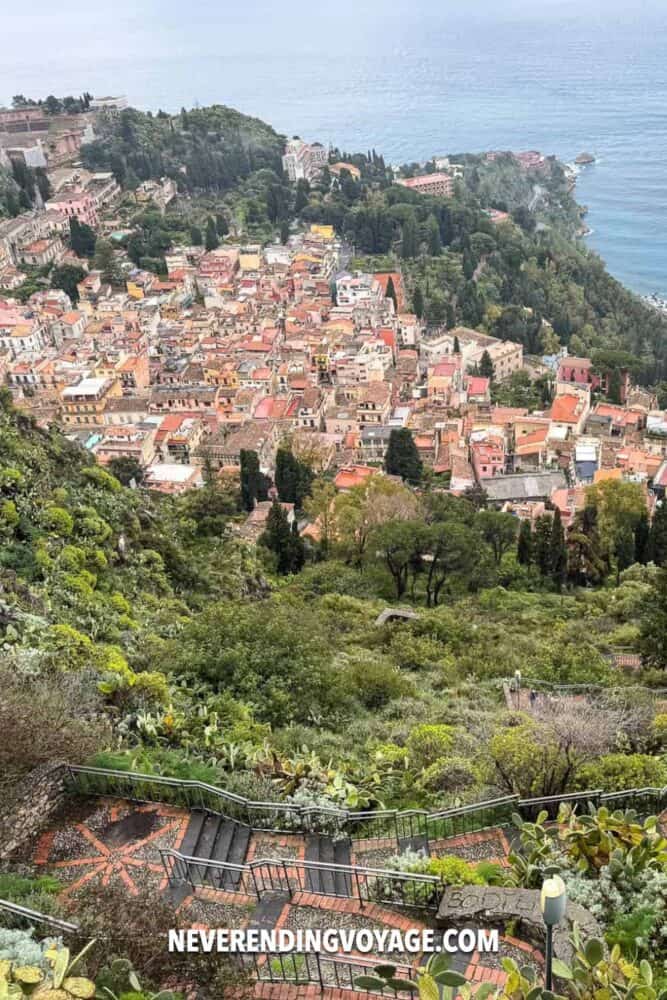
Disneyland Hotel Paris Review: Is It Worth It? 9 Jun 6:12 AM (4 months ago)

Disneyland Hotel at Disneyland Paris is the most magical of the onsite Disney hotels. It has a Royal Castle theme and is in a prime location at the park gates.
The five-star hotel reopened in January 2024 after a major refurbishment, so it feels fresh and new and has plenty of beautiful details to enjoy.
Honestly, I never thought we’d stay here because it’s so much more expensive than the other Disney Paris hotels. But we splurged on a last-minute trip in May, and it was my most relaxed Disney trip ever.
In this Disneyland Hotel Paris review, I share the pros and cons of the hotel, including our thoughts on its rooms, location, facilities, special perks, and more.
Contents
- Where is Lake Molveno?
- Best Things to Do in Molveno
- Where We Stayed: Grand Hotel Molveno Review
- Where to Eat in Molveno
- How to Get to Lake Molveno, Italy
- Lake Molveno Map
- Is Lake Molveno Worth Visiting?
- More North Italy Posts
- Where is Camogli, Italy?
- Best Things To Do in Camogli Village
- Best Hikes and Day Trips from Camogli
- Our Favourite Places to Eat in Camogli
- Where to Stay in Camogli
- How to Get to Camogli
- Camogli, Italy Map
- Is Camogli Worth Visiting?
- More Italian Riviera Tips
- Location of Hotel Cenobio dei Dogi, Camogli
- History of the Hotel
- Our Room at Hotel Cenobio dei Dogi
- Swimming Pool
- Private Beach
- Restaurants
- Other Facilities
- Hotel Cenobio dei Dogi Pros and Cons
- Cost of Hotel Cenobio dei Dogi
- Final Thoughts
- More Italian Riviera Posts
- Getting to Camogli
- When is the Camogli Fish Festival?
- Sagra del Pesce Camogli Schedule
- Friday Night: The Festival Begins
- Saturday: Bonfires and Fireworks
- Sunday Fish Fry
- Is the Camogli Fish Festival Worth Visiting?
- More Liguria Posts
- Hiking The Blue Trail in Cinque Terre
- Corniglia to Manarola via Volastra Hike Details
- Getting to Corniglia: The Start of the Hike
- Corniglia to Volastra Trail
- Volastra
- Volastra to Manarola Trail
- Corniglia to Manarola Hike Map
- Final Thoughts
- More Liguria Posts
- Skiathos Tips
- Beaches in Skiathos
- Renting a Boat
- Skiathos Town
- Our Favourite Restaurants in Skiathos
- Where We Stayed on Skiathos
- Getting to Skiathos, Greece
- Skiathos Map
- Is Skiathos Worth Visiting?
- More Greece Posts
- Our Top Picks in Syracuse, Sicily
- Best Things to Do in Syracuse (Ortigia)
- Things to Do in Syracuse (Mainland)
- Day Trips from Syracuse
- Where to Stay in Syracuse
- How to Get to Syracuse, Italy
- Syracuse Map
- Is Syracuse Worth Visiting?
- More Sicily Tips
- Our Top Picks in Taormina
- Best Things to Do in Taormina
- How to Get to Taormina
- Taormina Map
- Is Taormina Worth Visiting?
- More Sicily Tips
- Disneyland Hotel Paris Location
- Checking In
- The Lobby
- Rooms at Disneyland Hotel
- Facilities and Perks at Disneyland Hotel
- Restaurants at Disneyland Hotel
- Checking Out
- Pros and Cons of Disneyland Hotel
- Disneyland Paris Hotel Prices
- How to Book Disneyland Hotel
- Who Do We Recommend Disneyland Hotel For?
- Is Disneyland Hotel Paris Worth It?
- More Disney Tips
Disneyland Hotel Paris Location
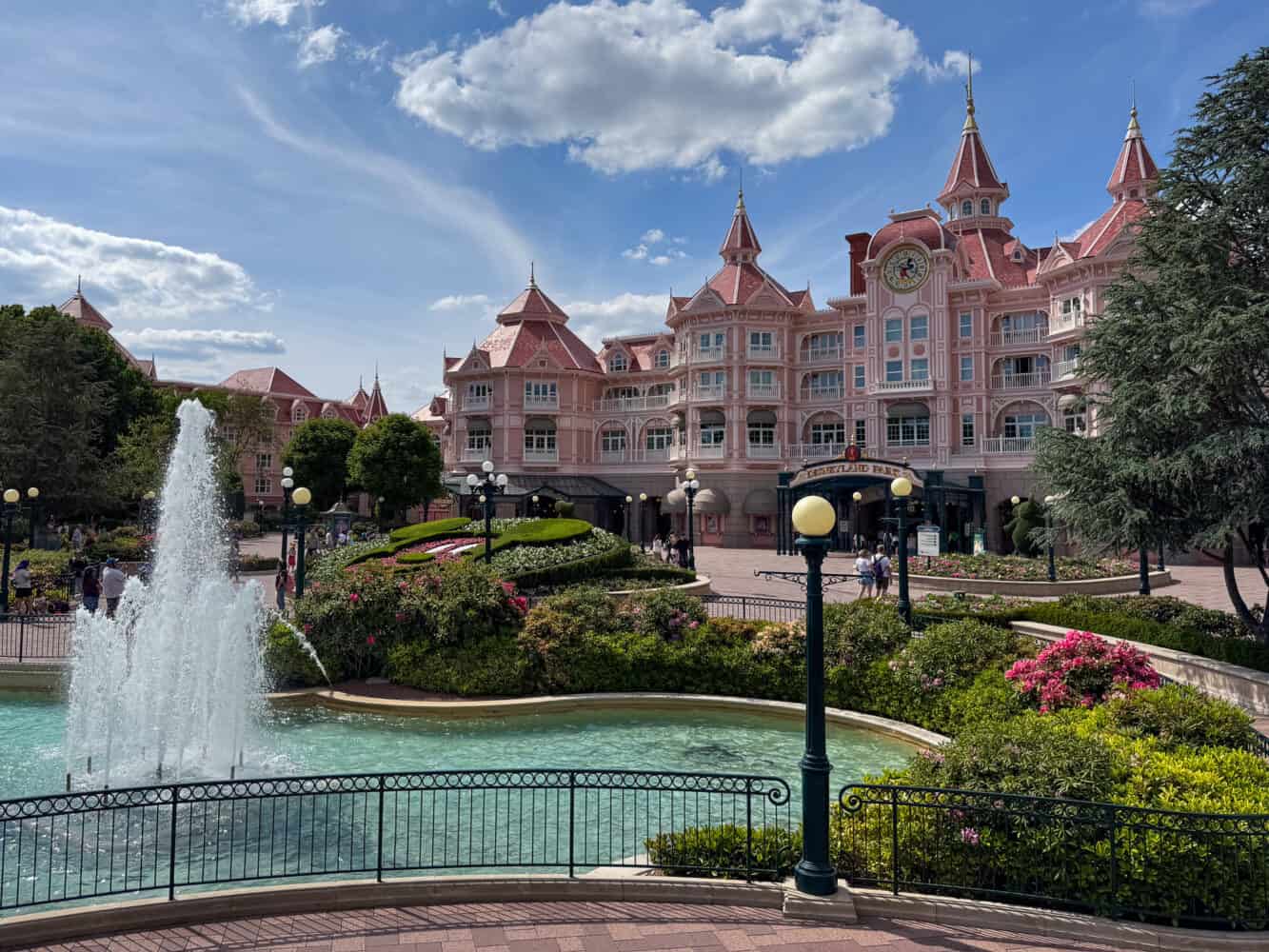
The number one thing that sets Disneyland Hotel apart from the other Disney Paris hotels is its location.
It’s located right at the Disneyland Park entrance. That beautiful pink Victorian-style building you see as you arrive and walk through Fantasia Gardens—that’s the Disneyland Hotel. You can not get closer than this!
Due to the compact design of the Disneyland Paris resort, you are also no more than a few minutes’ walk from the second park (Walt Disney Studios Park), Disney Village (with shops and restaurants) and the Marne-la-Vallée Chessy train station.
If you are arriving by train from Paris (see my Disneyland Paris tips post for details), access is very easy.
Head towards Disneyland Park, go to the right at the Fantasia Gardens pond, and you’ll find the hotel entrance in the pink building on the right. It isn’t actually signposted as the hotel.

You need to go through park security to access the parks and Disney Village, but once you are in, you don’t need to go through again for the rest of your stay (as long as you don’t need anything from the station shops). This is the only hotel with this perk!
If you are coming by car, the main entrance to the hotel is on the other side. Valet parking is available.
Checking In
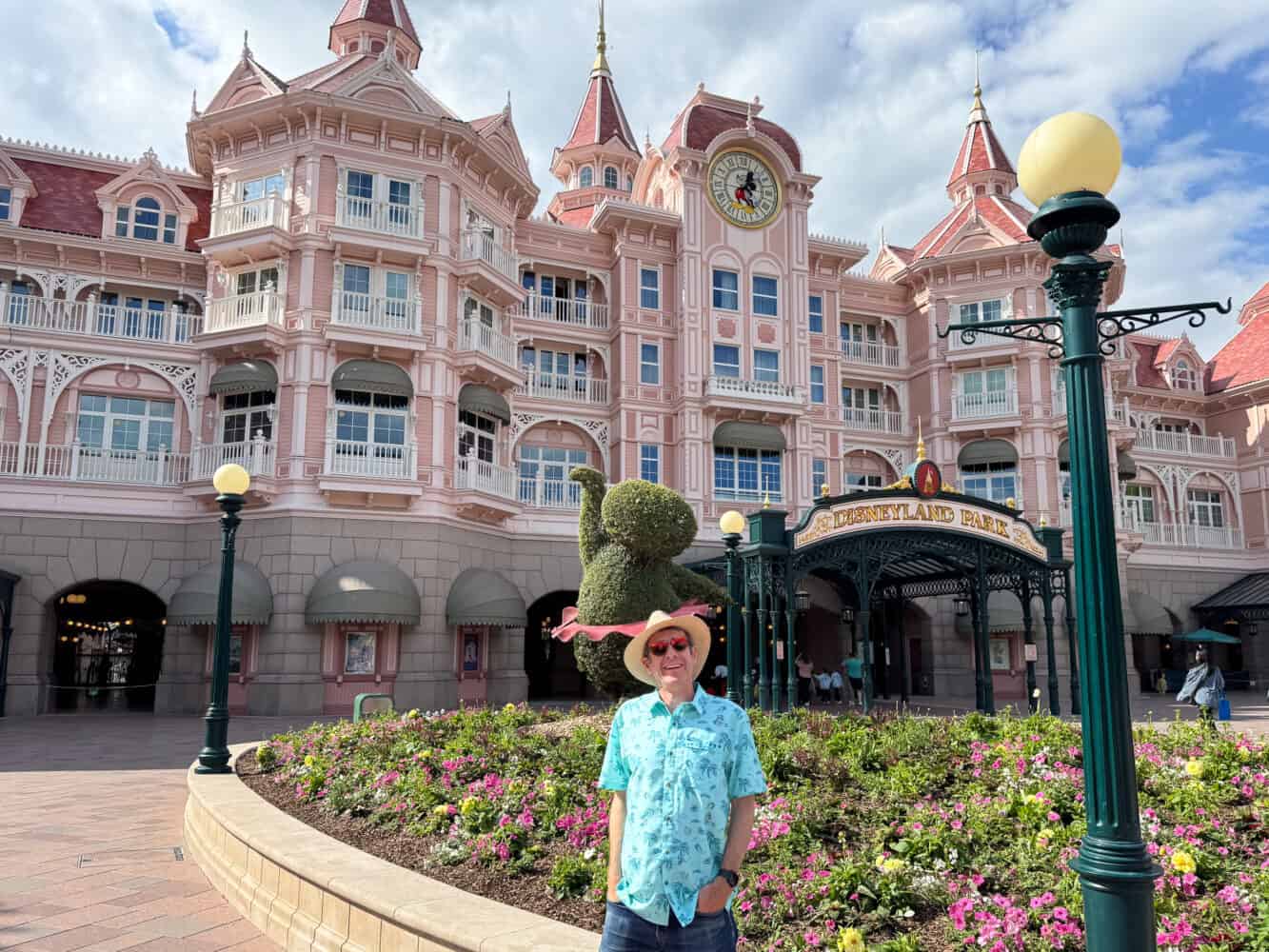
Check-in at the Disneyland Hotel is from 3pm. You are welcome to arrive earlier, leave your luggage at the hotel, and visit the parks.
If you book directly, park tickets are included for one day more than your stay. So for a two-night stay, you’ll get a three-day park ticket (to both parks) allowing visits on arrival and departure days. Taking advantage of this makes your stay better value.
When we stayed at Disney Paris’s Marvel Hotel, we filled in our details before arrival and checked in via the Disneyland Paris app. After announcing our arrival, we were given a room number and the app worked as a room key.
Although we did the pre-check-in for Disneyland Hotel, we could not get our room number via the app.
This turned out for the best. There was no wait at the check-in desk, and they gave us a beautiful Fairytale Guide to the hotel and much-needed directions to our room.
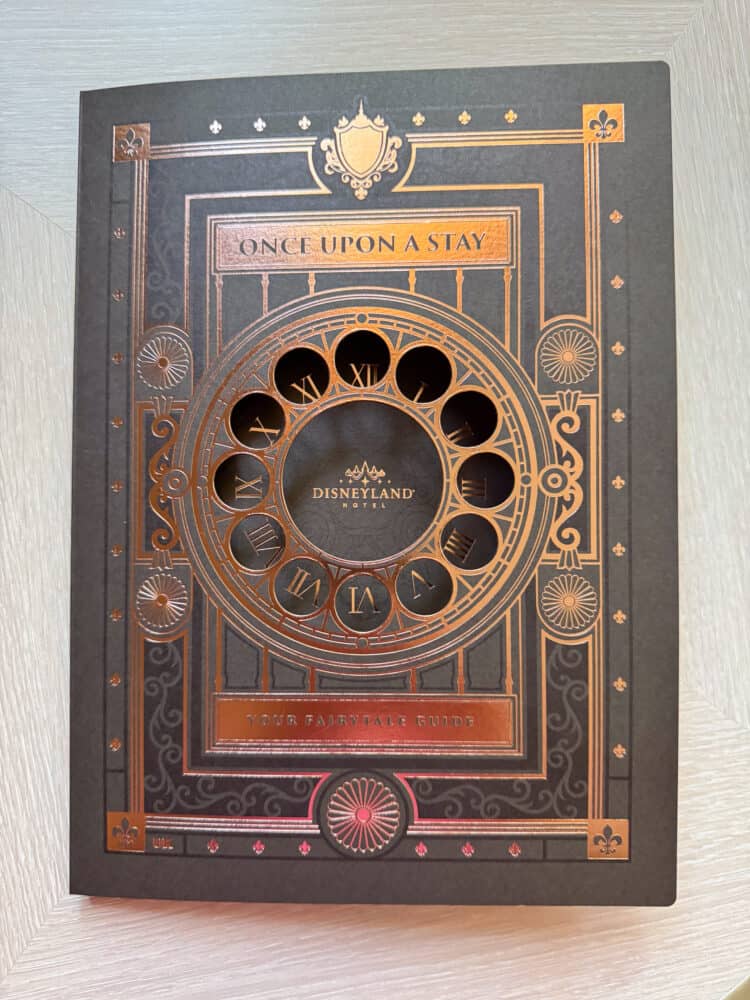
We were given MagicPasses (cards) that worked as room keys, park tickets, and breakfast vouchers (if purchased).
After we checked in, we could use the app to open our room, too.
The Lobby
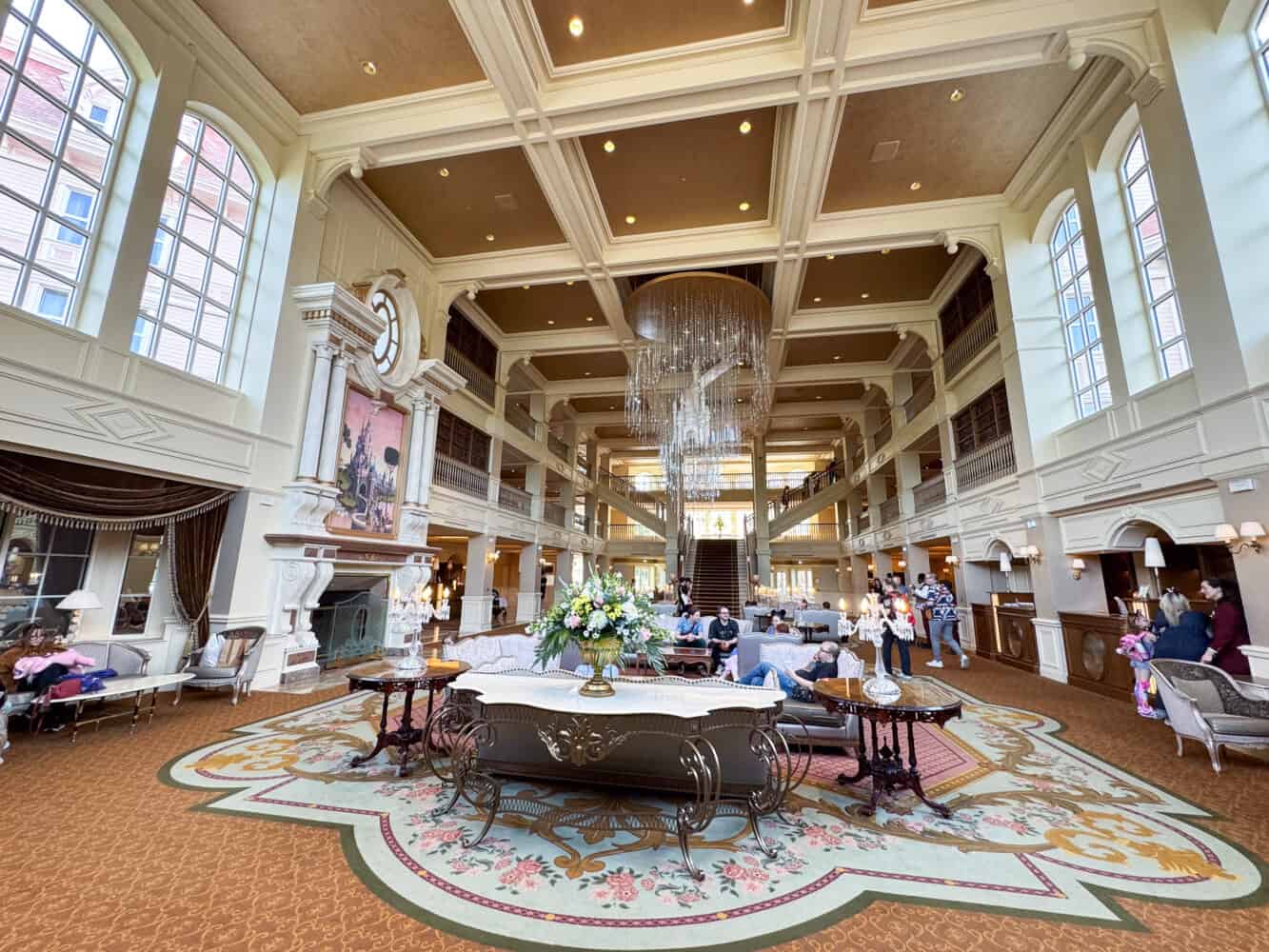
A special mention must be made of the Disneyland Hotel’s extravagant lobby. It is stunning and a joy to walk through every time you return to the hotel.
The expansive space has high ceilings, a magnificent crystal chandelier, a grand staircase, and artwork of the Sleeping Beauty castle above the fireplace.
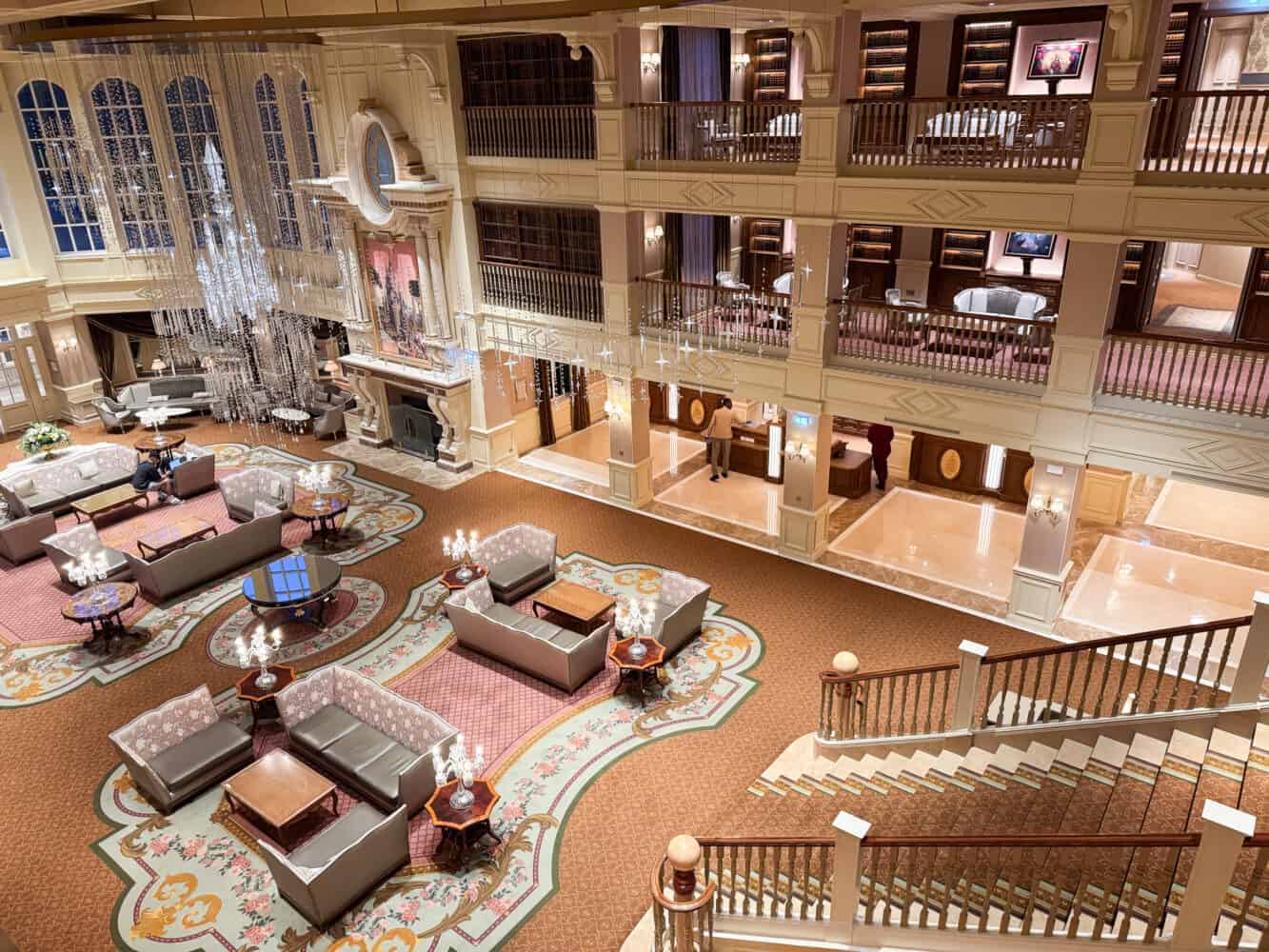
There are plenty of elegant sofas to relax on, tables adorned with vases of flowers, and elegant candle-like lamps.

You’ll often see little princesses living out their Disney dreams.
While you can take the lift up from this floor, we preferred the staircase. The open areas on the upper levels have more sofas, Disney artwork, and books inspired by libraries in French castles.


Rooms at Disneyland Hotel
Best Room Location
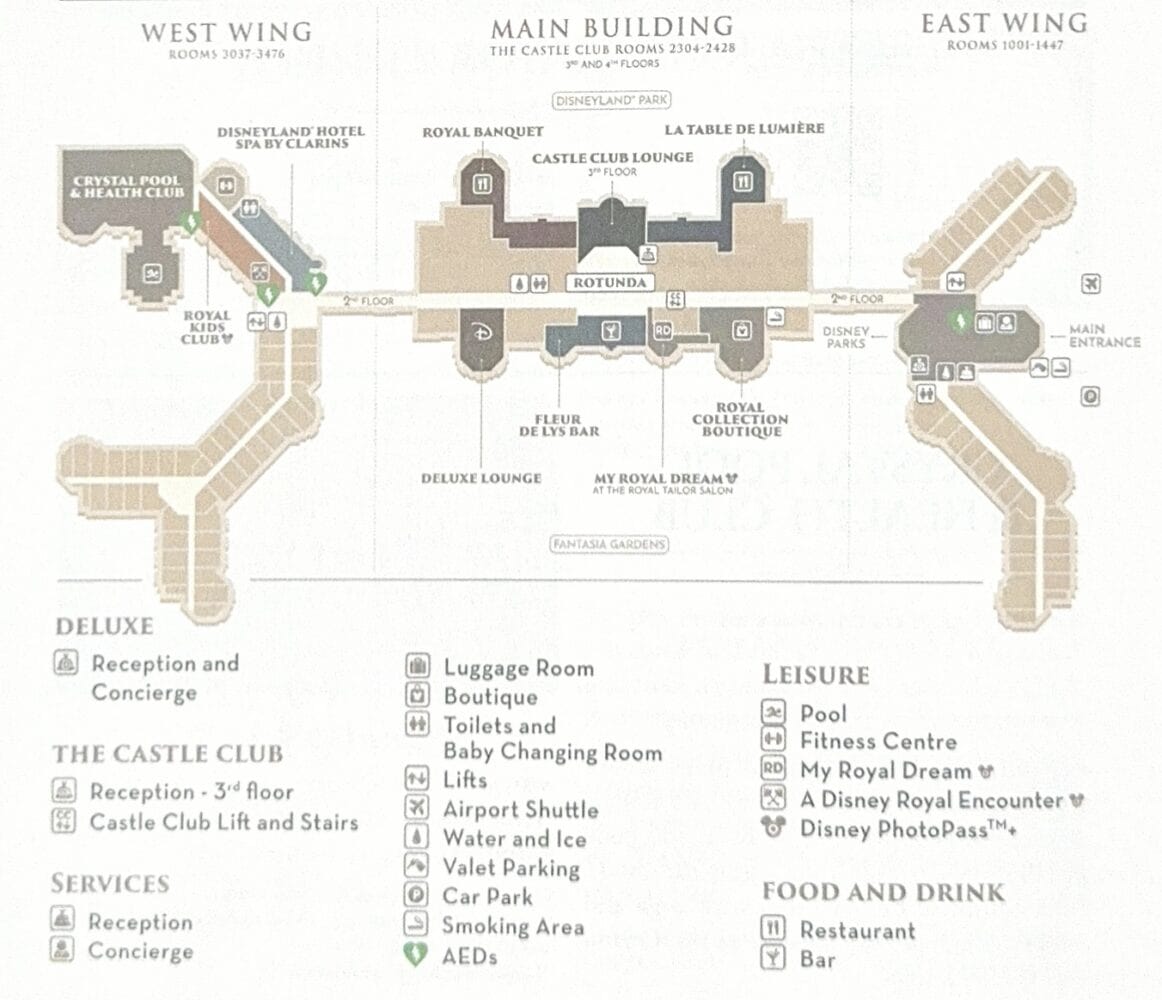
Disneyland Hotel is a large hotel with 487 rooms and suites. Where your room is does make a difference to how quickly you can access the facilities and the park entrance.
The lobby (which is 30 seconds from the special park entrance) is in the East Wing. If you want quicker access to the parks, request a room here.
From the lobby, you take a lift or walk the stairs to the second floor, where a long corridor connects the East and West Wings via the Main Building, which houses the shop, bar, restaurants, and beautiful rotunda lounge area.
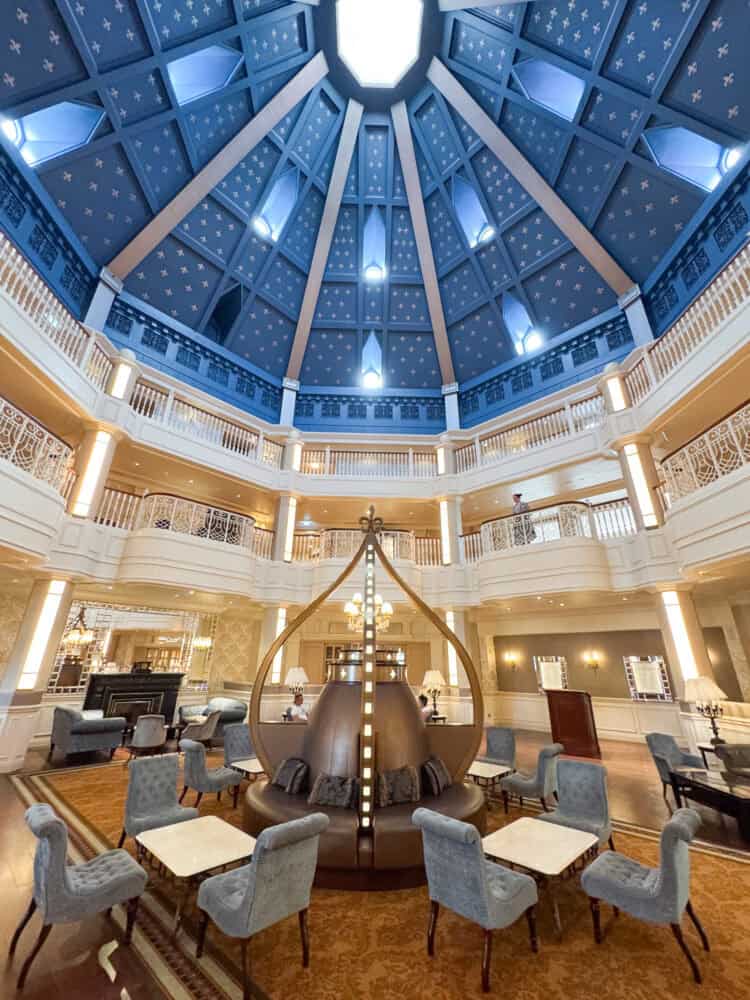
When you reach the West Wing, you may need to take another lift up to your floor.
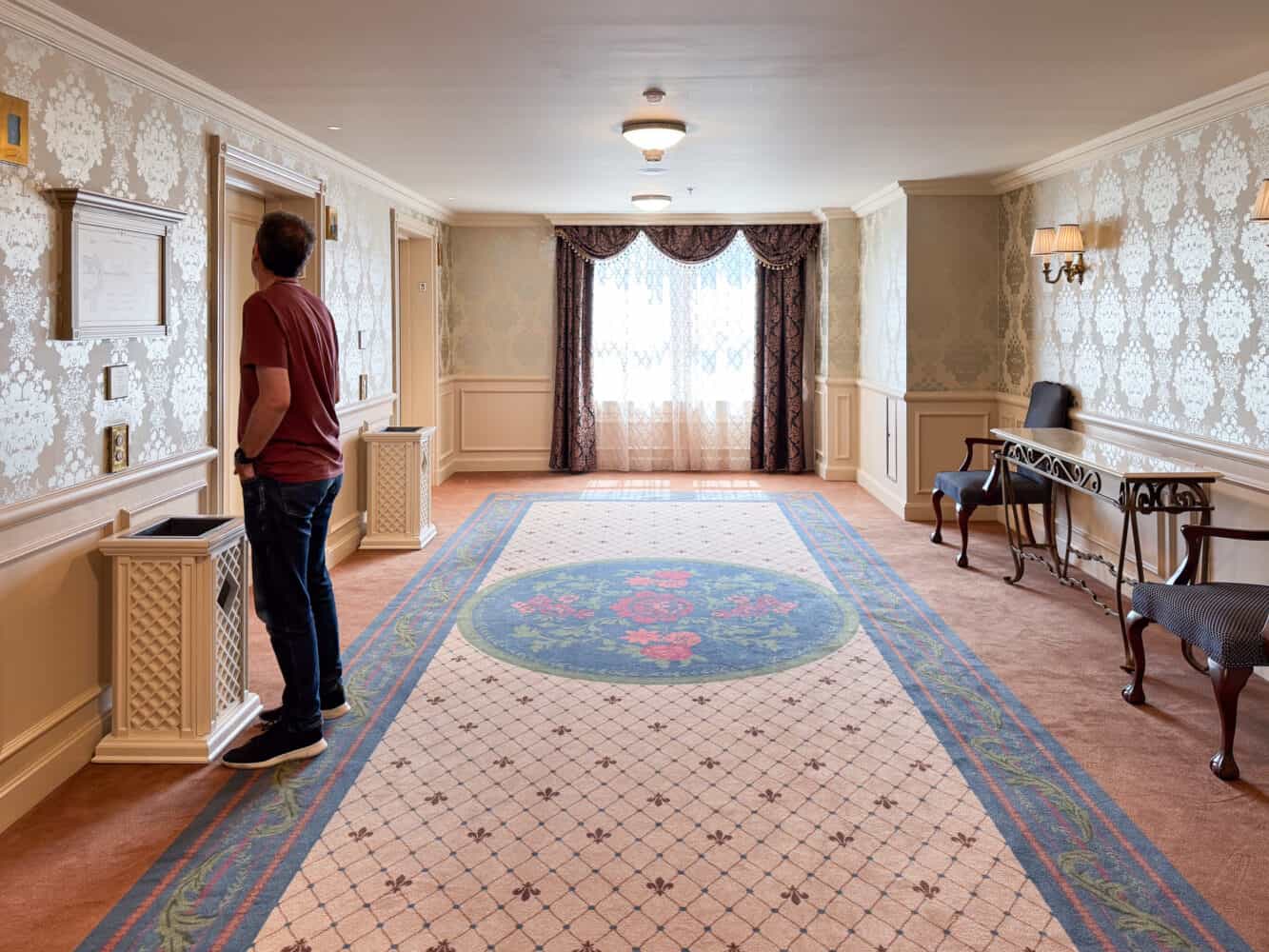
The pool, spa, and kids’ club are on the ground floor of the West Wing. If you want to be close to them, request a West Wing room.
We appreciated that the hotel is low-rise (just four floors), so taking the stairs was easy, unlike at the high-rise Marvel Hotel. This saved us from having to wait for lifts.
If taking the stairs isn’t an option for you, request a room close to the lifts.
Room Types
There are four main room types at Disneyland Hotel, Paris:
- Superior Room – Most rooms are in this lowest category. We stayed in one, and it is far from basic. All rooms are elegant and spacious with Princess artwork. Unless you have plenty of money to spend, the Superior Room is a great choice.
- Deluxe Room—These rooms are similar to Superior but with canopies above the bed. The main benefit is access to the Deluxe lounge, which includes breakfast and afternoon snacks. All deluxe rooms are in the West Wing.
- Castle Club Rooms – Includes access to the Castle Club Lounge (which has a castle view) with a character breakfast and afternoon tea, and a private lift to enter the park. Some rooms have park views. These sell out fast, and you have to book by phone.
- Superior Suites – Gorgeous suites themed after various Disney princesses. Some have park views. All the Castle Club perks, too.
For most visitors, you’ll be choosing between Superior and Deluxe. For us, the price differential wasn’t worth it to upgrade to Deluxe. We added the breakfast buffet to our Superior room for much less.
Our Superior Room at Disneyland Hotel Review
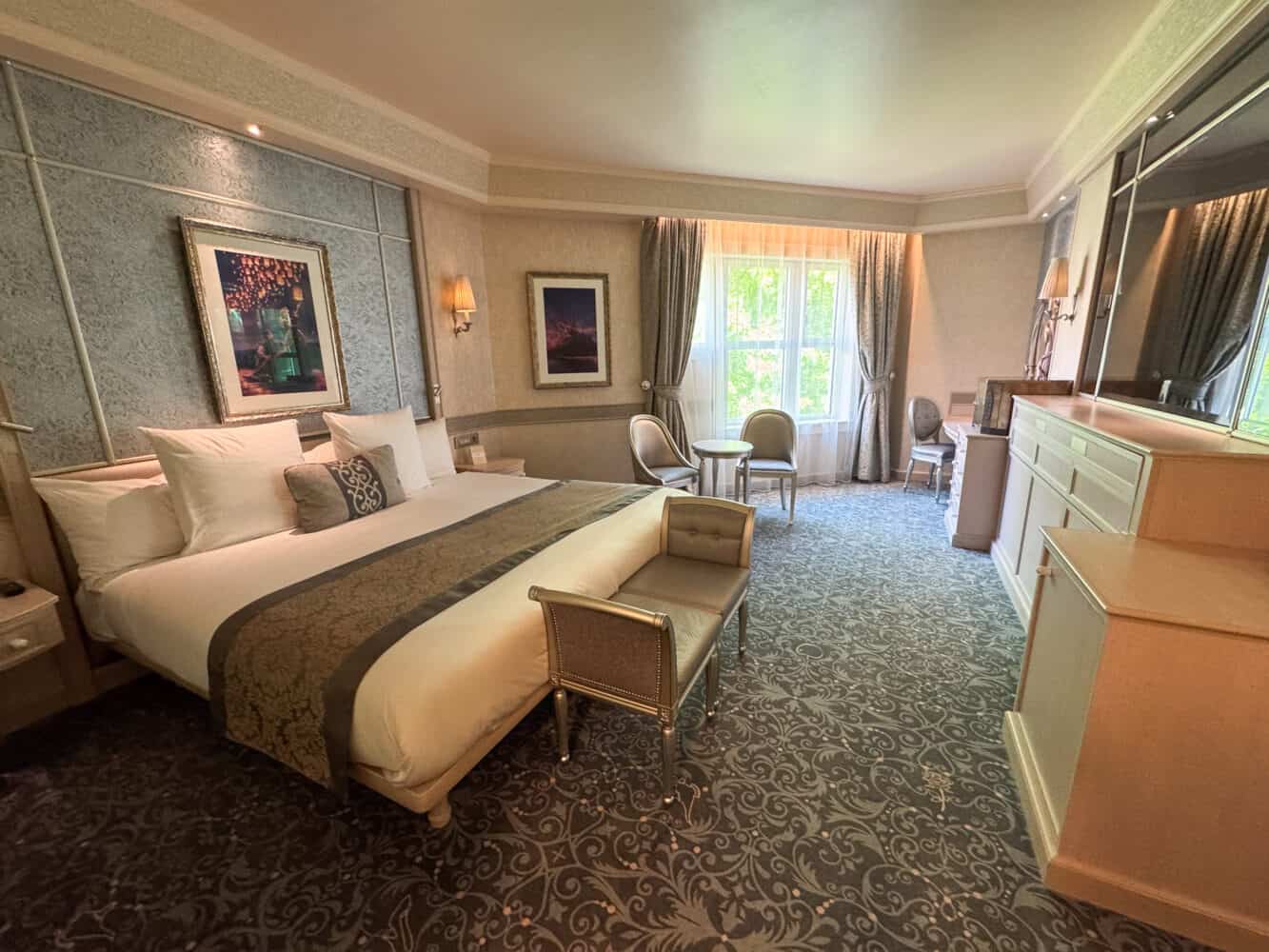
We stayed in a Superior room at Disneyland Hotel. There are a few subcategories within this. We chose a “Superior room – 3 people”, which includes one large double bed (King size) and one fold-out bed.
Other options are rooms with two queen beds (sleeping 4 people) or family rooms with two queen beds and a sofa/fold-out bed (sleeping 5).
You can also pay more for a room with a terrace (we didn’t).
Setting

We were in room 3382 in the West Wing, on the third floor, at the farthest end of the corridor from the lift.
Despite being in one of the furthest rooms from reception, it only took us four minutes to walk to the park entrance, taking the stairs. Waiting for two lifts would likely have taken longer.
The advantage of this location was the quiet. We didn’t hear other guests’ noise, just the park music drifting in (especially if we opened a window), which added to the atmosphere.
Our view was of the Fantasia Gardens side, where you enter the park. Mostly we could see trees and some of the hotel building. We were happy with that as it felt tranquil. Very few rooms in the hotel have views into the park.
Room
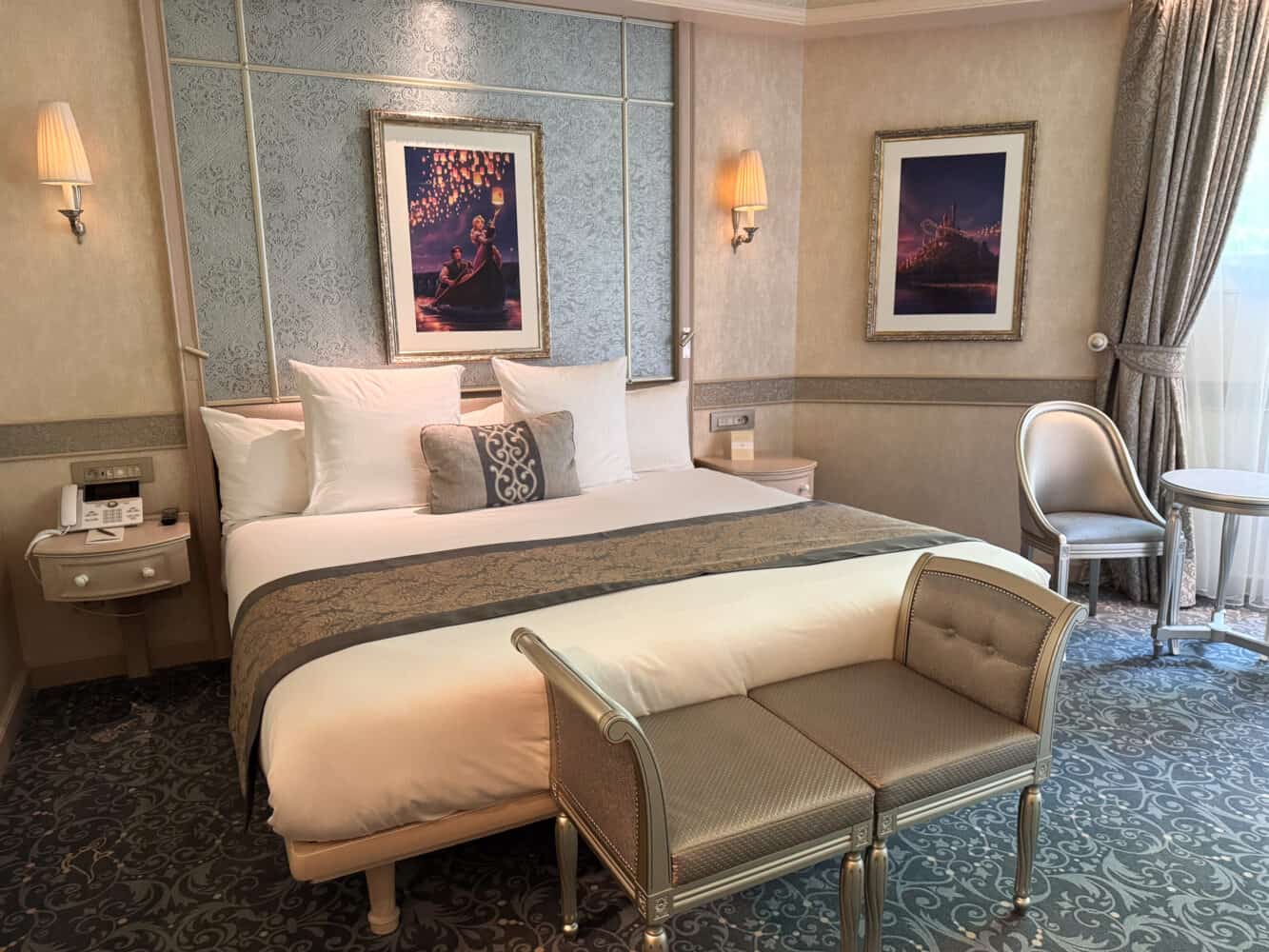
Our room was spacious and elegant with subtle Disney touches like Tangled artwork on the walls (different princesses may be featured).
The King bed was very comfortable with silky soft sheets and plenty of pillows (and you can order from a pillow menu if needed). It was perfect for a good night’s sleep after a park day.
There’s an additional fold-out bed under the TV. We didn’t need it, but the location seemed a bit awkward as it would block access to half of the room.
The cushioned bench at the end of the bed was useful for clothes.
There’s also a table and chairs and a desk with a chair.
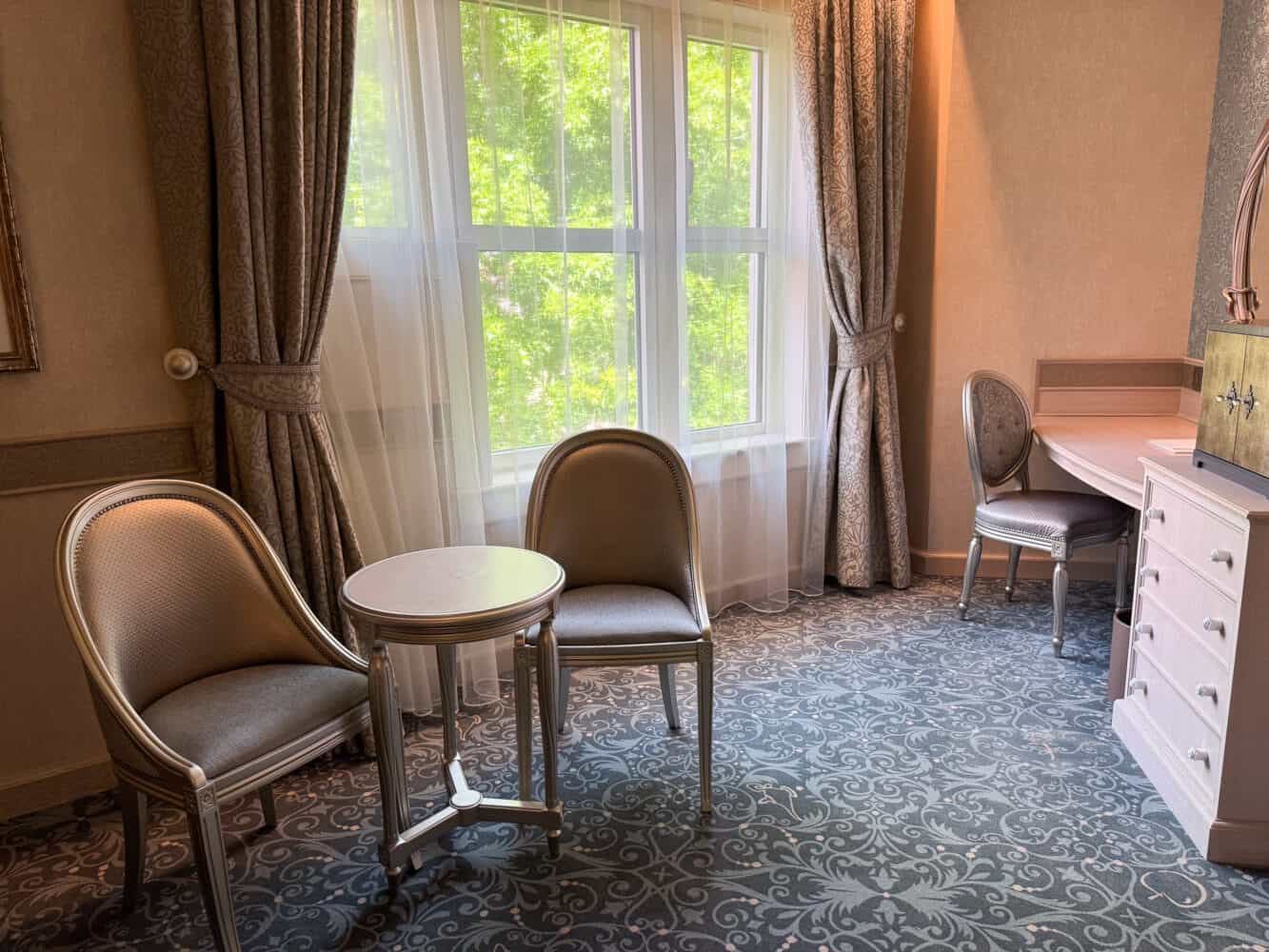
As you enter the room, there’s a wardrobe with inside and outside hanging areas. Under the outside hangers is an area where you can lay out a suitcase.
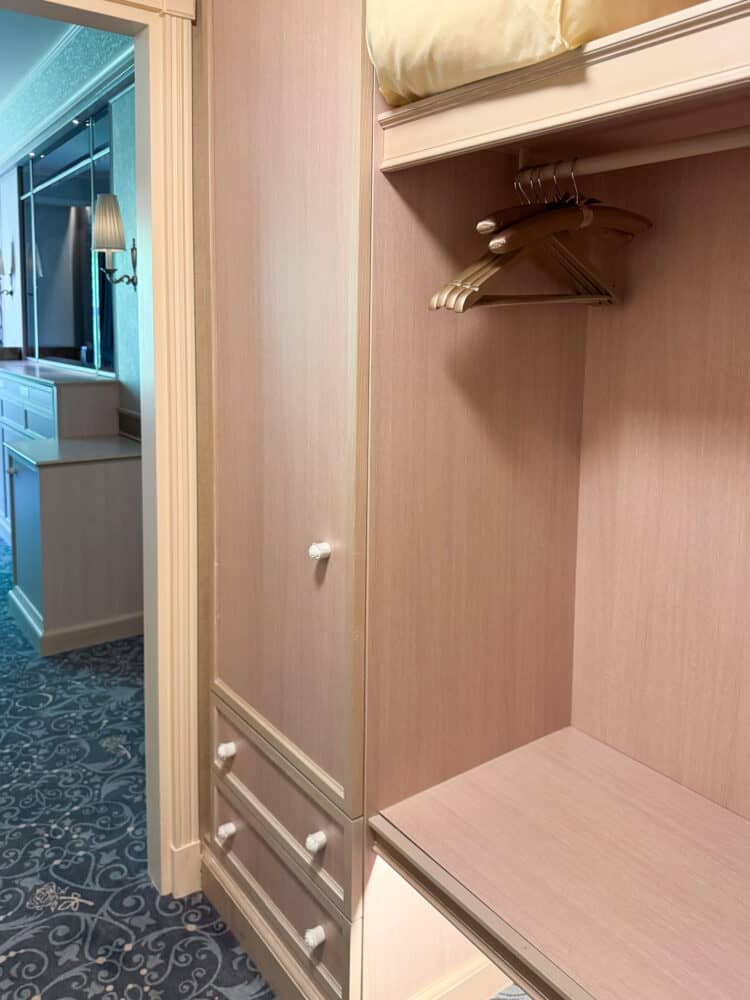
There are drawers in the wardrobe and in another unit under the tea and coffee area, so there’s plenty of storage.
Bathroom
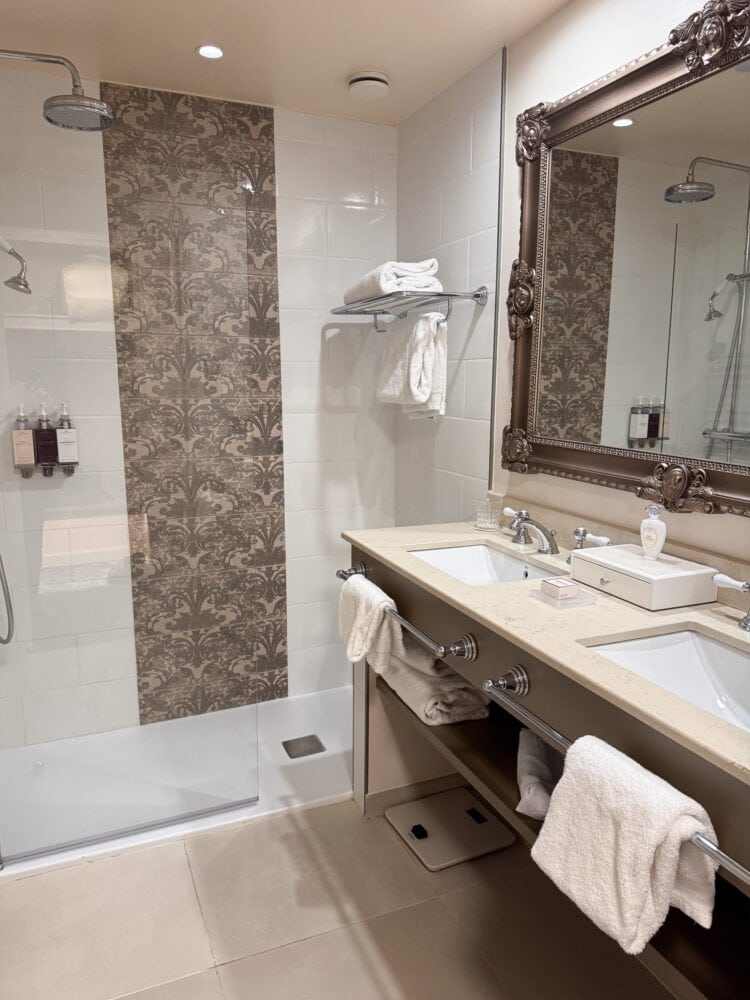
The bathroom is a decent size with double sinks. I loved the Snow White details around the mirror. You are given a bar of soap and a small bottle of body lotion.
The shower is wonderfully powerful and hot, with both rain and handheld heads. It has a full-sized shampoo, conditioner, and shower gel.
The toilet is in a separate cubicle off the bathroom. The light here uses a motion sensor, so it comes on automatically (which was a bit annoying in the middle of the night).
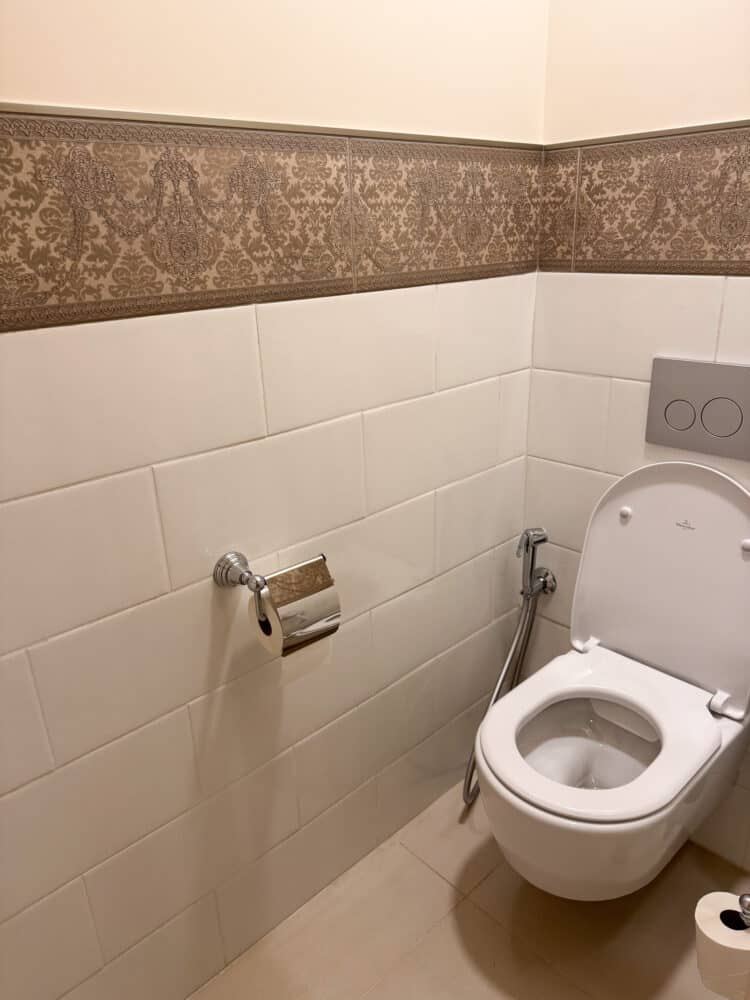
Amenities

The first mini bar is complimentary (the only Disney Paris hotel that offers this) and includes still and sparkling water in glass bottles, pear juice, and three tubs of snacks (caramelised almonds, dried fruit, and assorted rice crackers).
We appreciated these as there is no shop for snacks or drinks in the hotel, and room service prices are astronomical (€11 for mineral water or a coke and €35 for pasta!). You have to scan a QR code to access the room service menu.
In an enclosed cupboard next to the desk, there’s a Lavazza pod coffee machine and a kettle. Open the drawer beneath for cups, glasses, coffee pods, tea bags (fancy ones from Betjeman & Barton), and hot chocolate. Even the sugar cubes are pretty.

The large TV is semi-hidden behind a mirror. It includes information about the hotel and regular channels.
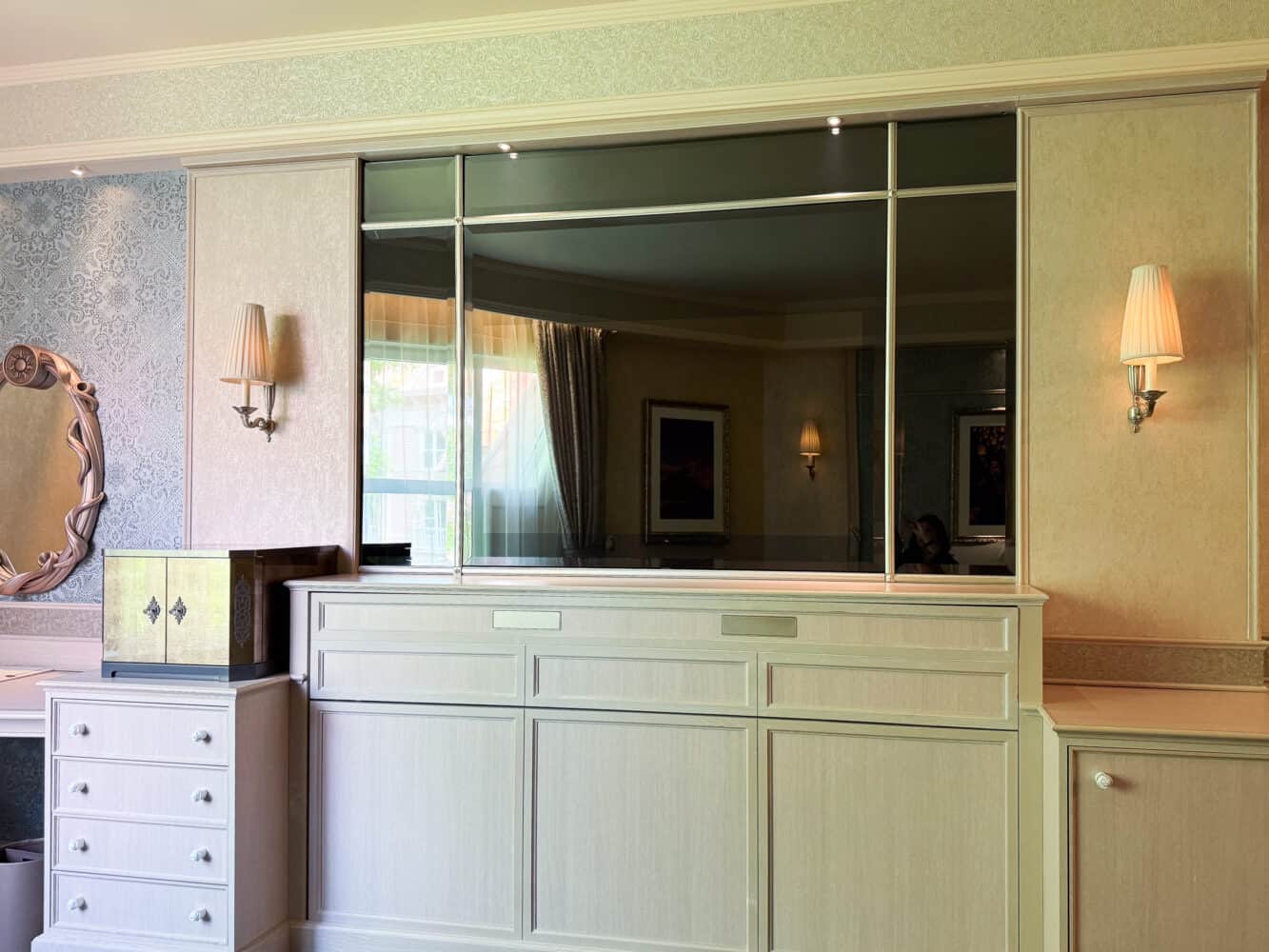
There are a few lovely freebies, including a Disneyland Hotel notepad and pen next to the bed and a castle postcard.
We appreciated the USB chargers and plug sockets on both bedside tables and on the desk.
The safe is in a drawer in the wardrobe and is big enough for a laptop (there’s even a charger inside).
Robes and slippers are in the wardrobe. You can take the slippers with you, but not the robes. They are useful if you want to use the pool.
Overall, we really enjoyed our room. It was a peaceful, comfortable retreat from the parks.
Facilities and Perks at Disneyland Hotel
Special Entrance to Disneyland Park
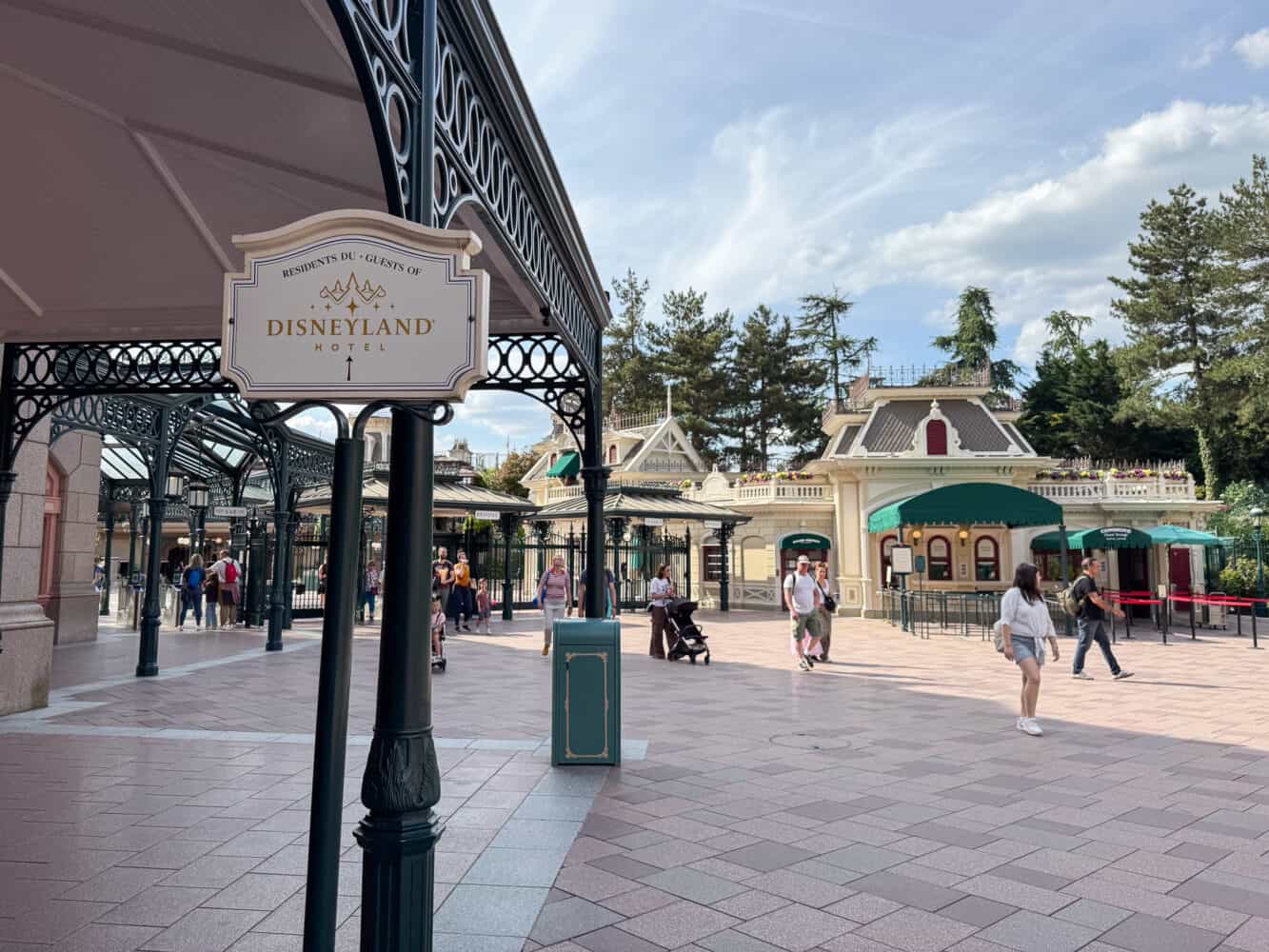
Disneyland Hotel guests have a special entrance to Disneyland Park, so we never had to queue. Go right out of the hotel and it’s a 30-second walk away.
We loved avoiding the crowds at the main gates.
Extra Magic Time
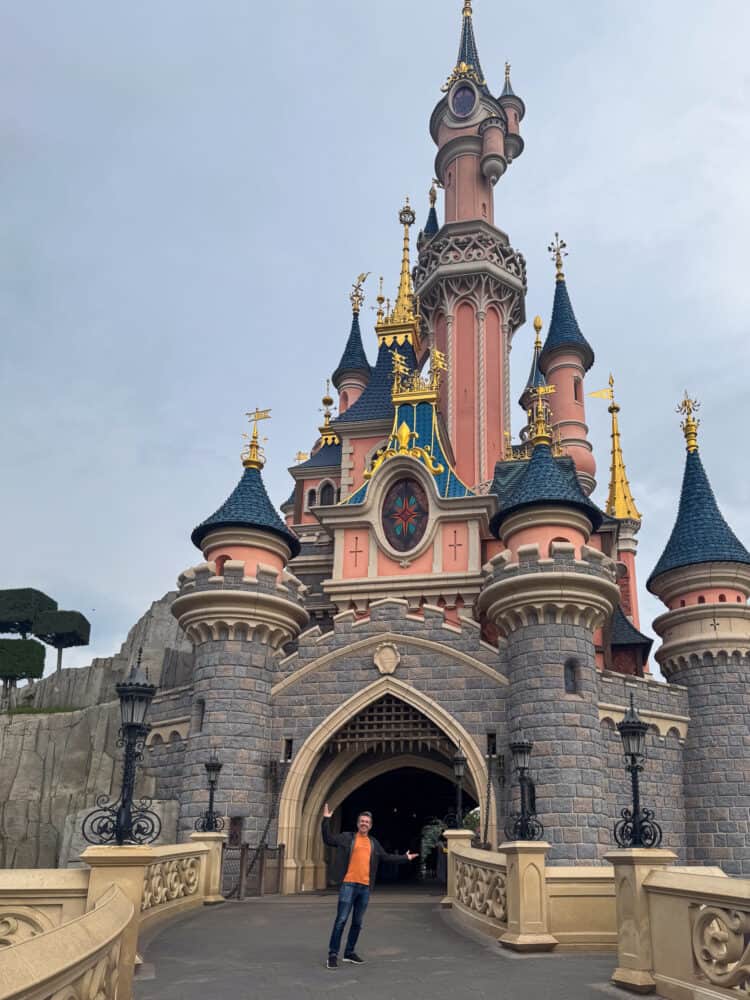
All Disney Paris hotels include Extra Magic Time—one hour early entry to both parks. On our stay we could enter at 8.30am before the park officially opened at 9.30am.
This is a huge benefit as you can usually ride at least four rides without queues. Or in Disneyland Park, we love to wander Main Street when it’s quiet and take uncrowded photos in front of the castle.
See my Disneyland Paris tips and tricks post for the rides we recommend in Extra Magic Time.
Disneyland Hotel is so close that you can go into the park for early entry and pop back to the hotel for a late breakfast.
Our short commute meant more time in bed in the morning, which really helps if you’ve stayed up late to see the fireworks (at 10.40pm in May).
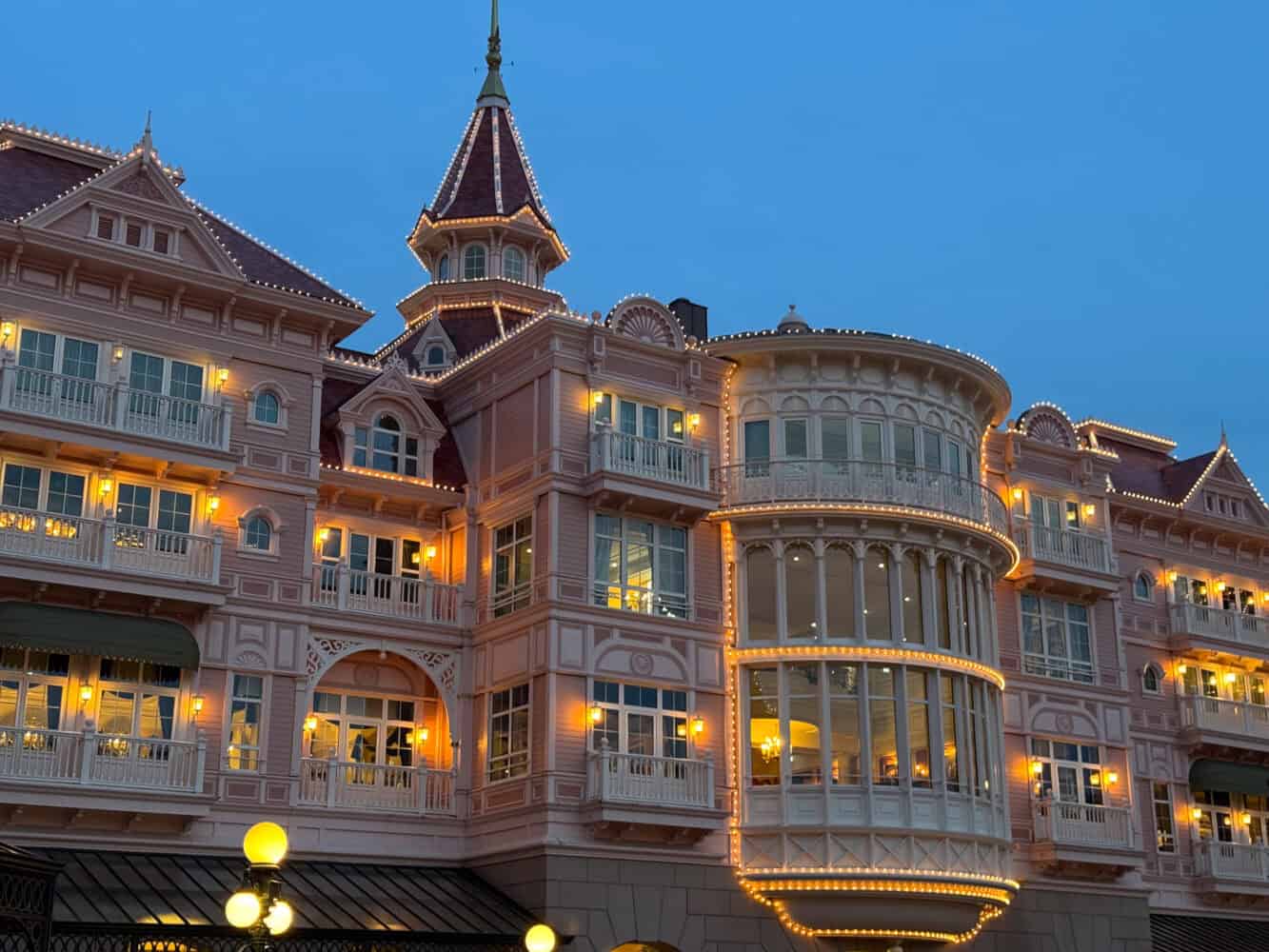
Royal Collection Boutique
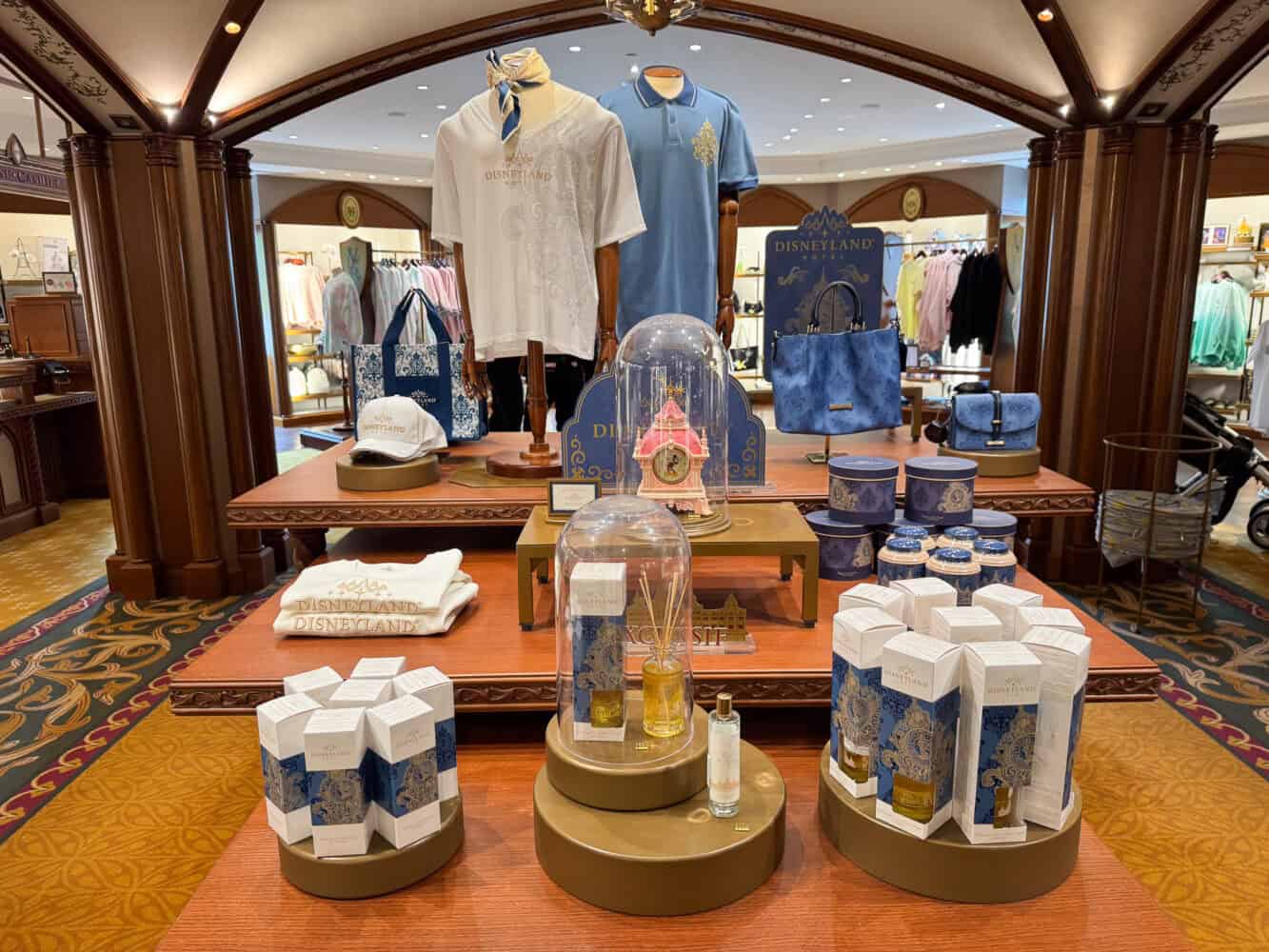
There’s one shop in Disneyland Hotel—the Royal Collection Boutique. It does feel a bit fancier than other hotel gift shops, with clothes and products themed to the hotel that you won’t find anywhere else. Plus, little princess outfits, of course.
There’s not a huge selection, though.
Honestly, we’d have preferred a more practical shop where you could buy drinks and snacks. That said, we were so close to the park that you can easily pop in there.
The shops at the train station are the cheapest place for snacks. We liked never leaving the Disney bubble (and avoiding security), though.
Pool and Sauna
The Crystal Pool & Health Club at Disneyland Hotel includes an indoor pool, jacuzzi, sauna, gym, and yoga space.
I never managed to use it, though. When I went for a look at 5pm, the pool was very busy with kids—swimming would have been impossible.
It’s not a large pool, so it fills up quickly. However, it’s a lovely bright space with a glass ceiling and big windows.
Mornings are likely quieter (it’s open from 7am- 10pm), but when I went at 8am it was closed due to a technical issue (it opened at 9am).
The pool is on the ground floor of the West Wing. Towels and lockers are provided.
Spa
Near the pool is a spa where you can book massages and other treatments.
Princess Appearances
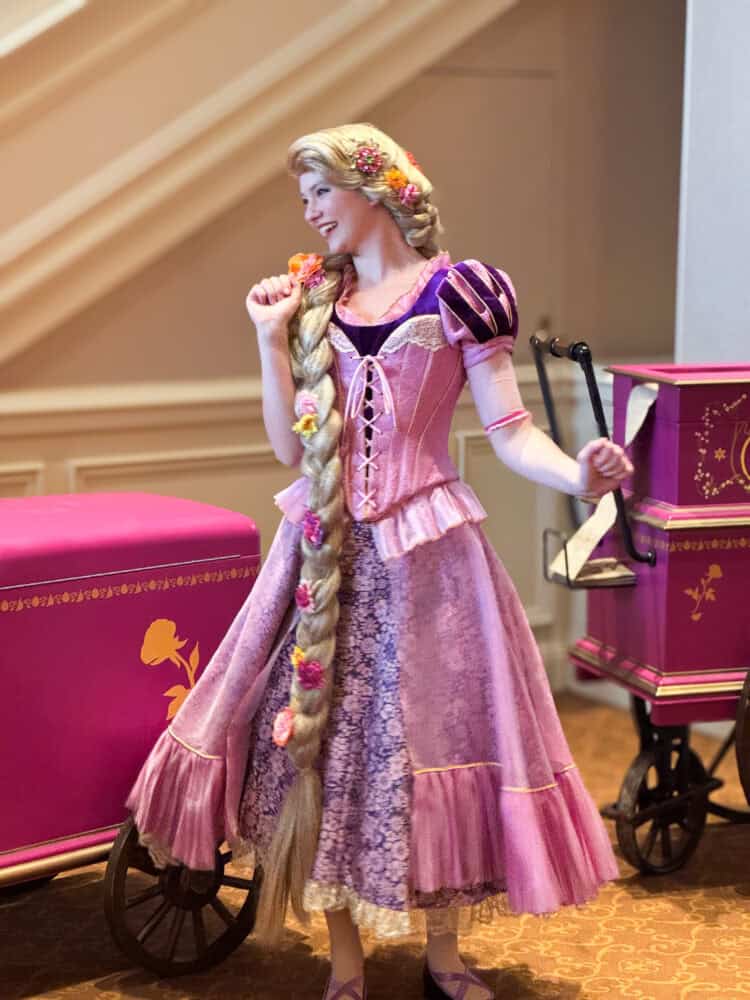
If you get lucky, you may see princesses.
There are occasional performances of La Troupe Royale Disney in the lobby where actors involve kids in a theatrical performance. Sometimes princesses appear with them—we saw Rapunzel at 5pm one day.
Apparently between 1-7pm is when you are most likely to see them, but ask a cast member if you want the latest information.
A Disney Royal Encounter Photo Opportunity
All Disneyland Hotel guests (adults and kids) can book to meet and have their photo taken with a Disney princess.
This is free and takes place in the Kids Club.
Royal Kids Club
The Kids Club is in the West Wing near the pool and spa. It offers free daycare (up to two hours a day) with magical activities for children aged 4 to 11.
My Royal Dream: A Fairytale Makeover
Booking is essential for My Royal Dream, a paid experience where children can receive a royal makeover, including hair, makeup, costume, and a photoshoot (depending on the package booked).
There’s no better place to be a princess or prince than the Disneyland Hotel!
It takes place in the Royal Tailor Salon next to the Boutique.
Restaurants at Disneyland Hotel
These are the restaurants and bars at the Disneyland Hotel. All have fairly high prices. If you are looking for a quick bite, you are better off heading to Disney Village (Earl of Sandwich is our fave) or into the park.
Bookings are essential for all except the bar and breakfast. You can book as soon as you book your room.
- Fleur de Lys Bar – Overlooking Fantasia Gardens, this is a comfortable place to relax with a coffee, cocktail, or light snack.
- Royal Banquet – The main restaurant where you’ll find the breakfast buffet. At lunch and dinner it’s also a buffet with character appearances.
- La Table de Lumière – A Beauty and the Beast-themed restaurant with princess appearances. Dinner only.
- La Forêt Secrète – This new fine dining experience was created by chef Jean Imbert and features dishes inspired by Disney stories. The forest theme looks beautiful and there are castle views. Dinner only.
Breakfast
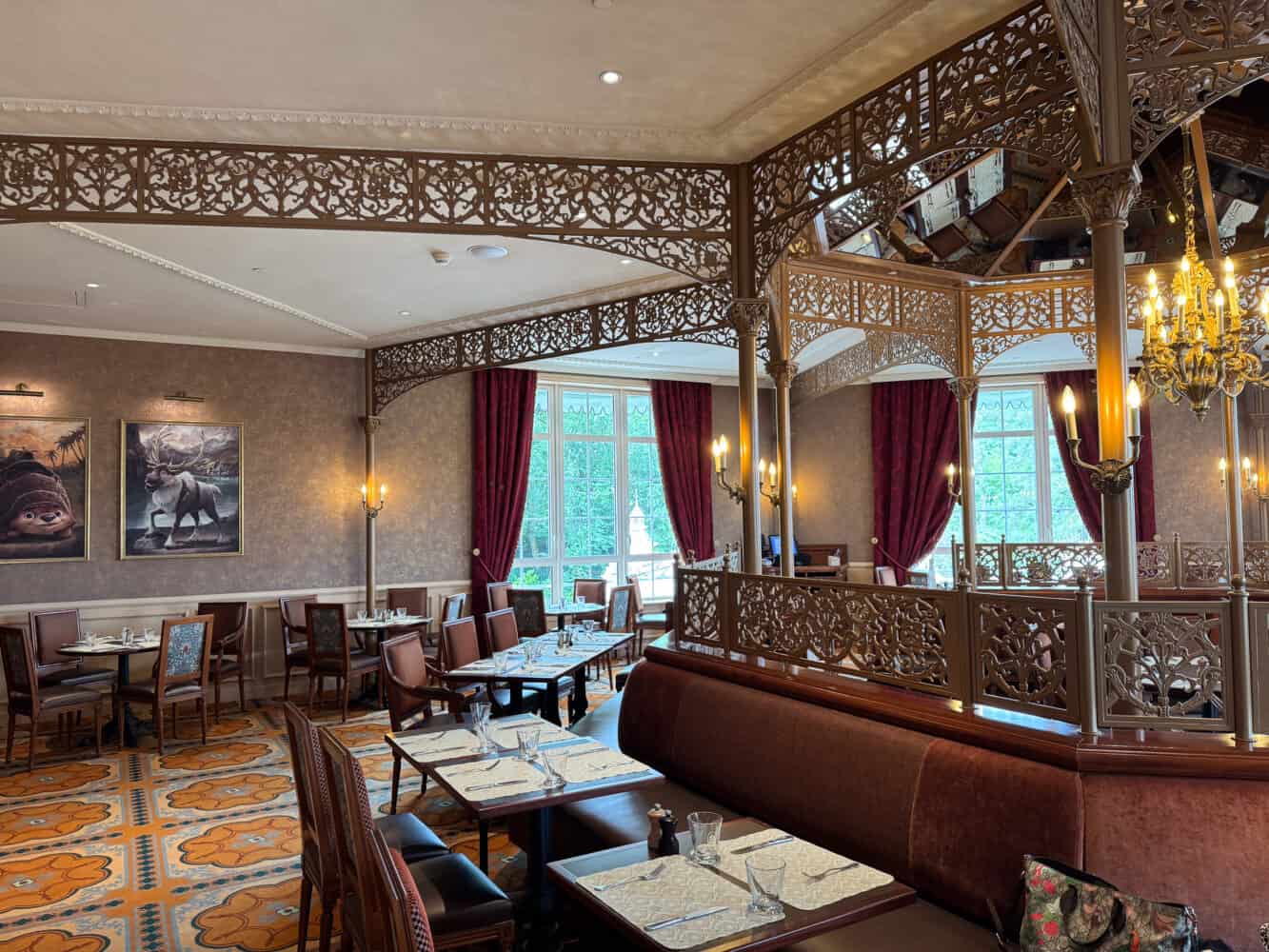
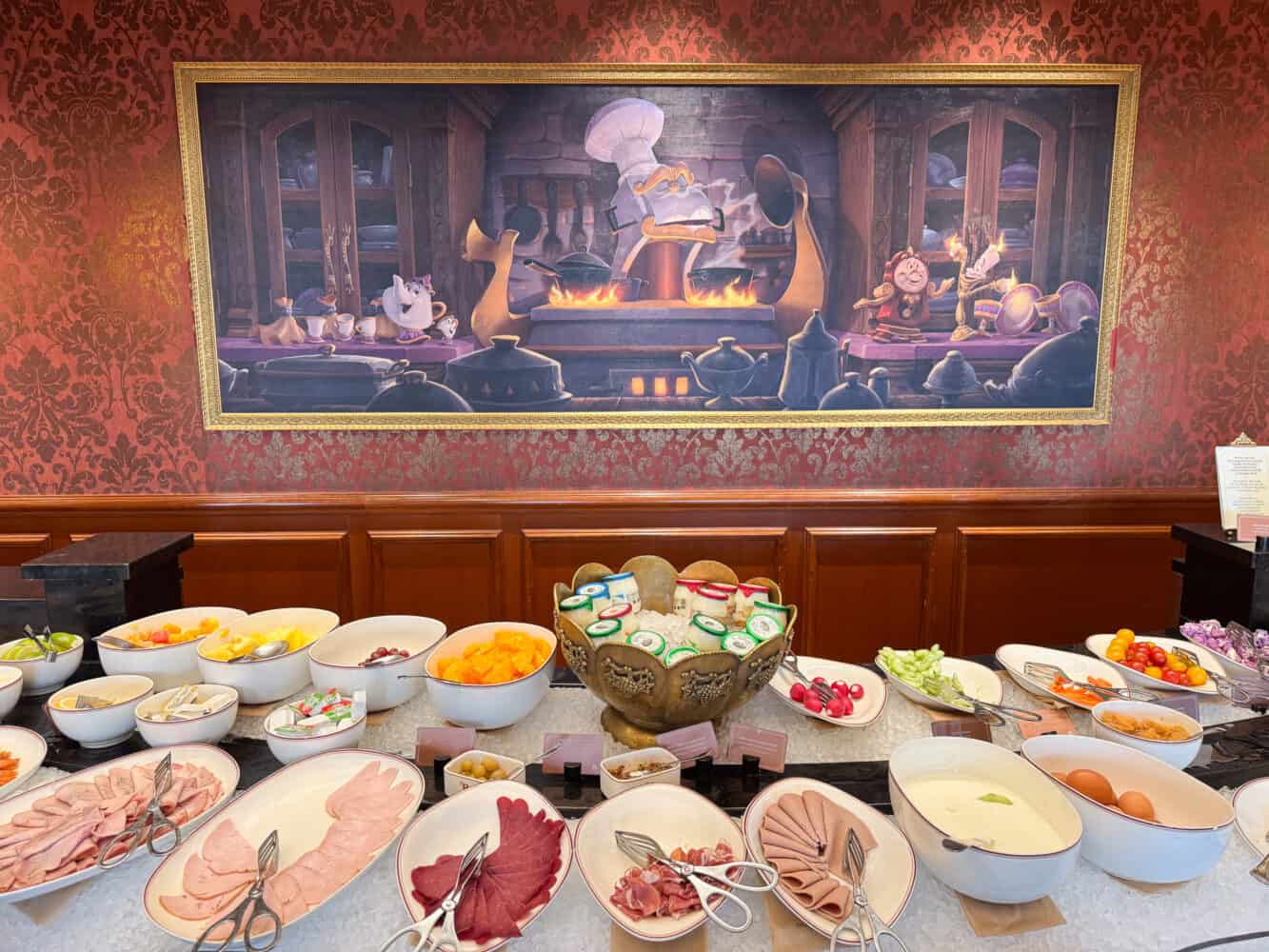

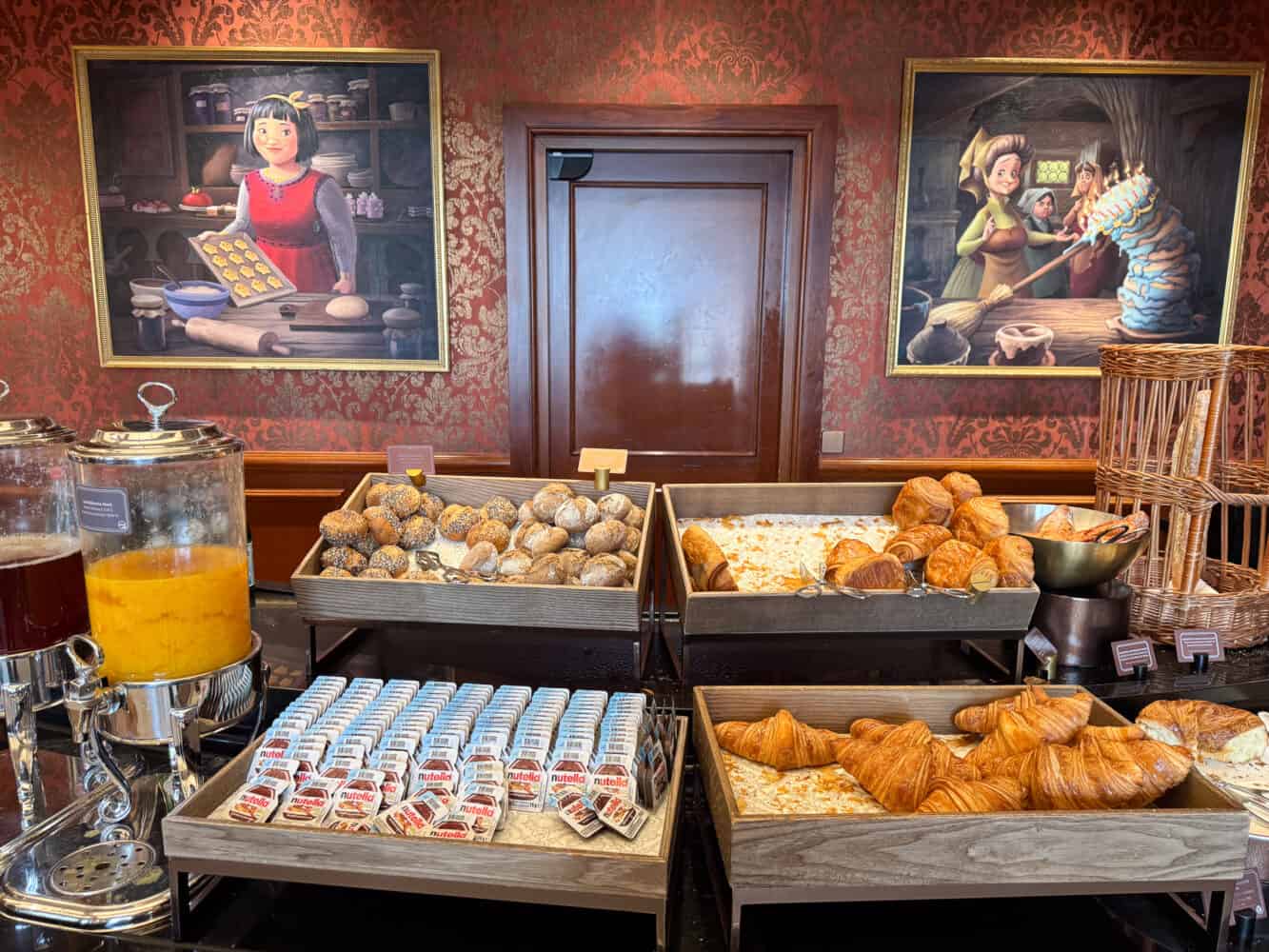
The only meal we ate at the hotel was breakfast. We’re usually “grab a granola bar and run” park people, but as we were splurging on the hotel, we paid the extra €45 per adult for the breakfast buffet.
There’s no need to book a table—just scan your MagicPass on arrival. There may be a short wait for a table (at 10am we didn’t wait long).
Breakfast runs from 7am to 11am, which worked really well for us. We could go into the parks for early entry and come back for a late breakfast.
For Superior Room guests (Deluxe and Castle Club guests have breakfast in their lounges), breakfast takes place in the Royal Banquet. It is not a character meal at breakfast.
It’s a large, loud, and chaotic space, although thankfully, they seated us in a quieter side room.
There wasn’t as large a choice of food as I was expecting, but you should find something you like. There were pastries, fruit, cereal, cold meat and cheeses, bread, and hot dishes like sausages, potatoes, beans, scrambled eggs, and pancakes.
Surprisingly, nothing was Disney-themed—no Mickey waffles here.
We enjoyed everything we ate, though. The croissants were as good as you’d expect in Paris. They had plant-based sausages, so we made our own breakfast roll. The mango chia pudding was also lovely.
Our biggest complaint (other than the busyness) was the service. It was slow to get hot drinks (which you order at the table) and other things we needed (ketchup, extra cutlery, etc.).
After I ordered tea, I was brought a mug of hot water and, far too long later, a selection of teabags, which I had to brew in lukewarm water. The next day, I made tea in my room instead.
Although I think it’s overpriced, we did enjoy the food and the convenience.
Checking Out
Check out is at 11am, and your room key stops working then.
There’s no need to go to reception to check out. Your card is automatically charged for extras if needed.
Your room key has your name on it, so you can keep that.
If you want to go into the park, leave your luggage in your room and call baggage services to come and collect it (no need to wait). I couldn’t get through just before 11am so called the concierge instead.
Pros and Cons of Disneyland Hotel
Pros
- Amazing location at Disneyland Park entrance.
- Special entrance for Disneyland Hotel guests.
- Extra Magic Time one-hour early entry (for all Disney Paris hotel guests, though).
- Being in the Disney bubble (no need to go through security every day).
- Elegant, spacious rooms with comfortable beds.
- Stunning lobby.
- Princess appearances.
- Good facilities for kids.
- Three table service restaurants and a bar onsite.
- Free minibar and little extras like the beautiful hotel guide.
Cons
- The high price.
- West Wing rooms are quite far from the reception.
- Small pool that can be crowded.
- High room service cost.
- No shop in the hotel for drinks and snacks.
- No quick service food.
Disneyland Paris Hotel Prices
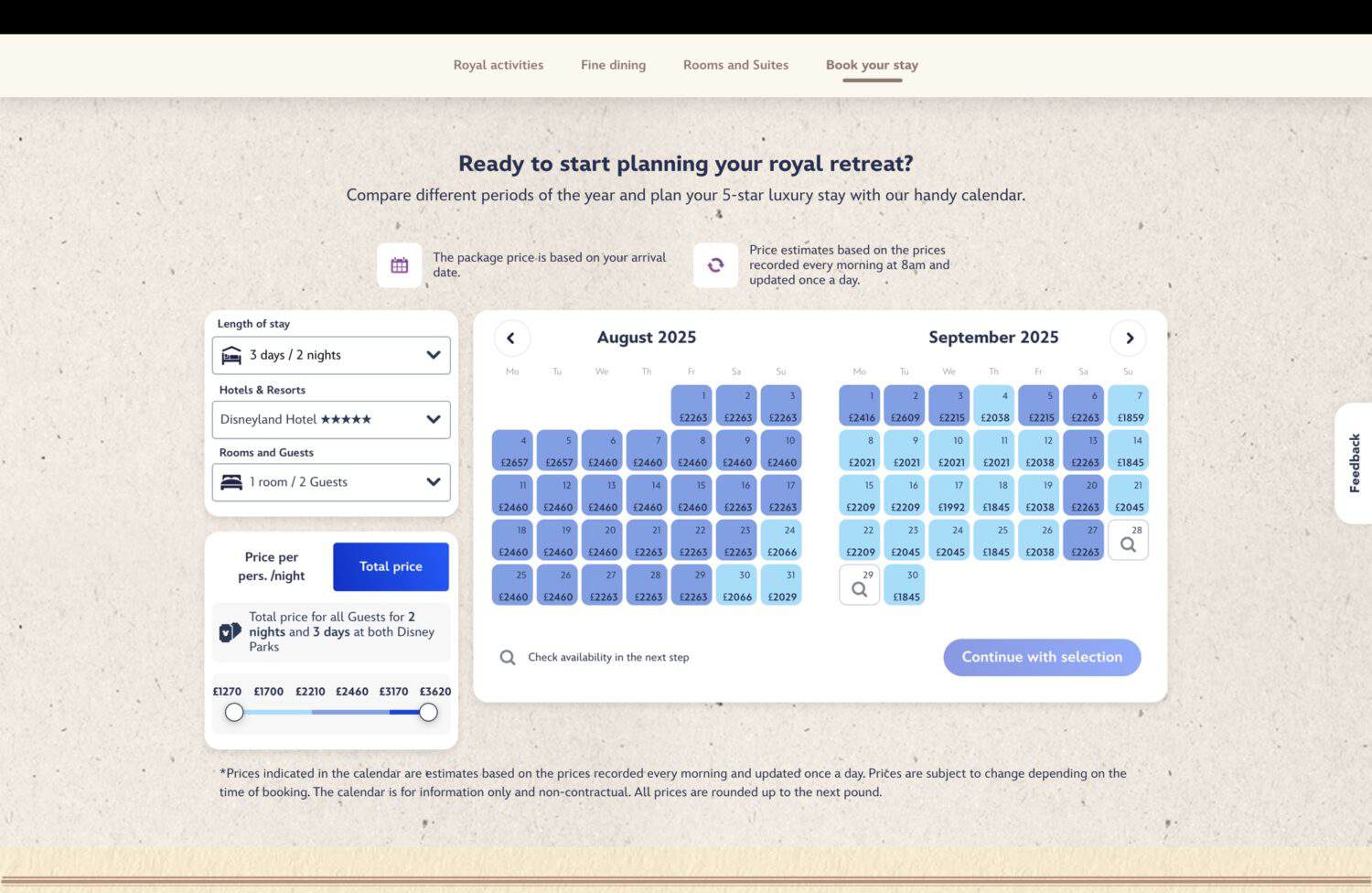
All Disneyland Paris hotel prices vary widely depending on the time of year, arrival day, and how far in advance you book (it’s usually cheaper further in advance).
Disneyland Hotel is by far the most expensive of the onsite hotels.
Here are some example prices for a Superior Room for two nights (the minimum I’d suggest to take advantage of the location), including three days of park tickets for two adults:
- £1275 in January (booking 7 months ahead)
- £1697 in November (booking 5 months ahead)
- £2021 in September (booking 3 months ahead)
- £3403 in June or July (booking last minute)
- £3609 on Christmas Eve (booking 6 months ahead)
The best way to compare prices is to use the price calendar on the Disneyland Paris website (go to the end of the page). Choose your number of guests and nights and scroll through the colour-coded calendar to see the cheapest dates.
If you want to book room-only, the cheapest rates I found on Booking.com (discussed below) were in January at £553 a night and went up to £1500 a night in July and at New Year.
If Disneyland Hotel is out of your price range, see my guide to Planning a Trip to Disneyland Paris for a comparison of the other onsite hotels.
How to Book Disneyland Hotel
Direct with Disneyland Paris
If you take advantage of the included park tickets (one day extra than your stay), booking directly with Disneyland Paris usually works out the best deal. This is what we’ve done on our last two trips.
When you book on the Disney site, you only have to pay a 15% deposit and the balance is due two months before.
You can change or cancel your booking by phone up to seven days before arrival without charge.
Room Only with Booking
If you don’t need so many days in the park, you can book a room only on Booking.com and buy your park tickets separately.
To see the cheapest dates on Booking, go to the calendar above Room Type and click on it to scroll through the months.
Package with Disney Holidays UK
Another option if you are travelling from the UK is to use the Disney Holidays website, which is the official Disney site for Brits.
We used it to book our latest Disney World Florida trip and it was cheaper than booking on the US website.
On the Disney Holidays website, you can search for packages that include transport (flight, Eurostar train, or self-drive ferry) with the hotel and tickets.
Who Do We Recommend Disneyland Hotel For?
We absolutely loved our stay and recommend Disneyland Hotel for anyone who can afford it.
In particular, the hotel is a good choice if:
- You want a more relaxing holiday with lots of breaks in a lovely room (or the pool/spa).
- You have small children who need naps.
- You have mobility problems, low energy, or sensory issues and would benefit from breaks.
- You want the full-on magical, princess experience.
- You are splurging for a special occasion.
Is Disneyland Hotel Paris Worth It?
Whether Disneyland Hotel is worth it for you depends on the type of Disney Paris trip you are looking for.
If you are high energy and will be spending 12 hours a day in the park trying to do everything (us 10 years ago!), a budget-friendly onsite hotel like Hotel Cheyenne or Sequoia Lodge would probably make more sense. You’d still get early entry to the parks and be within walking distance.
If you are looking for a relaxed trip that’s more about the whole experience, not just the rides, I highly recommend Disneyland Hotel. For us, it was worth the splurge.
Our stay here was the most chilled Disney trip I’ve ever had. I loved being in the parks in minutes and coming back frequently for breakfast or breaks. We didn’t need to carry a backpack as we popped back if we needed anything or to drop off shopping.
Being in the hotel just feels special. The beautiful lobby, comfortable room, and park music drifting through the window. You are fully immersed in the Disney bubble throughout your stay and feel far away from the real world.
And for us, that’s what a Disney trip is all about.
More Disney Tips
Read more about Disneyland Paris and Disney parks around the world.
Paris
- Disneyland Paris Tips and Tricks for First Timers
- Disneyland Paris Itinerary: 2 Parks in 1 Day
- Paris in a Day: The Perfect Itinerary
Disney Worldwide
- 27 Best Things to Do at Disney World: Must Do Rides in Each Park
- A Magical 7 Day Disney World Itinerary
- Disneyland & California Adventure in One Day: An Itinerary for Adults
- 13 Best Tokyo Disneyland Rides For Adults
- 14 Best Tokyo DisneySea Rides for Adults
If you enjoyed this post, pin it!

The Perfect Eastern Sicily Itinerary: Food, Views and Baroque 26 May 5:59 AM (5 months ago)

This 10-day Eastern Sicily itinerary is the exact one we followed on our latest trip to the beautiful island in Southern Italy.
We visited many of the highlights, from hiking Mt Etna to admiring Taormina’s Greek Theatre and getting lost in Ortigia’s backstreets. We enjoyed excellent food and wine with plenty of breaks for Aperol Spritzes in sunny piazzas.
Sicily is a large island, so unless you have two weeks or longer, it makes sense to focus on either the east or west side of the island.
Eastern Sicily is the best choice if you are flying into Catania Airport or if you want to see Mt Etna, learn about the ancient Greek history of the island, or admire the best Baroque architecture.
In this guide, I share the best things to do in East Sicily, along with recommendations on where to stay and eat, and a map of all the places we visited.
Although we rented a car for this East Sicily road trip, you can visit most places by public transport (tips below).
Contents
- Where is Lake Molveno?
- Best Things to Do in Molveno
- Where We Stayed: Grand Hotel Molveno Review
- Where to Eat in Molveno
- How to Get to Lake Molveno, Italy
- Lake Molveno Map
- Is Lake Molveno Worth Visiting?
- More North Italy Posts
- Where is Camogli, Italy?
- Best Things To Do in Camogli Village
- Best Hikes and Day Trips from Camogli
- Our Favourite Places to Eat in Camogli
- Where to Stay in Camogli
- How to Get to Camogli
- Camogli, Italy Map
- Is Camogli Worth Visiting?
- More Italian Riviera Tips
- Location of Hotel Cenobio dei Dogi, Camogli
- History of the Hotel
- Our Room at Hotel Cenobio dei Dogi
- Swimming Pool
- Private Beach
- Restaurants
- Other Facilities
- Hotel Cenobio dei Dogi Pros and Cons
- Cost of Hotel Cenobio dei Dogi
- Final Thoughts
- More Italian Riviera Posts
- Getting to Camogli
- When is the Camogli Fish Festival?
- Sagra del Pesce Camogli Schedule
- Friday Night: The Festival Begins
- Saturday: Bonfires and Fireworks
- Sunday Fish Fry
- Is the Camogli Fish Festival Worth Visiting?
- More Liguria Posts
- Hiking The Blue Trail in Cinque Terre
- Corniglia to Manarola via Volastra Hike Details
- Getting to Corniglia: The Start of the Hike
- Corniglia to Volastra Trail
- Volastra
- Volastra to Manarola Trail
- Corniglia to Manarola Hike Map
- Final Thoughts
- More Liguria Posts
- Skiathos Tips
- Beaches in Skiathos
- Renting a Boat
- Skiathos Town
- Our Favourite Restaurants in Skiathos
- Where We Stayed on Skiathos
- Getting to Skiathos, Greece
- Skiathos Map
- Is Skiathos Worth Visiting?
- More Greece Posts
- Our Top Picks in Syracuse, Sicily
- Best Things to Do in Syracuse (Ortigia)
- Things to Do in Syracuse (Mainland)
- Day Trips from Syracuse
- Where to Stay in Syracuse
- How to Get to Syracuse, Italy
- Syracuse Map
- Is Syracuse Worth Visiting?
- More Sicily Tips
- Our Top Picks in Taormina
- Best Things to Do in Taormina
- How to Get to Taormina
- Taormina Map
- Is Taormina Worth Visiting?
- More Sicily Tips
- Disneyland Hotel Paris Location
- Checking In
- The Lobby
- Rooms at Disneyland Hotel
- Facilities and Perks at Disneyland Hotel
- Restaurants at Disneyland Hotel
- Checking Out
- Pros and Cons of Disneyland Hotel
- Disneyland Paris Hotel Prices
- How to Book Disneyland Hotel
- Who Do We Recommend Disneyland Hotel For?
- Is Disneyland Hotel Paris Worth It?
- More Disney Tips
- Our 10-Day Eastern Sicily Itinerary at a Glance
- Alternative Sicily Itinerary Ideas
- How to Get Around East Sicily
- Eastern Sicily Map
- Our Eastern Sicily Itinerary in Detail
- More Sicily Posts
Our 10-Day Eastern Sicily Itinerary at a Glance

- Fly into Catania Airport.
- Taormina (including Mt Etna) – 3 nights staying at Villa Sara B&B.
- Syracuse (with day trips to Noto, Ragusa, Modica) – 6 nights at A Casa di Clara apartment.
- Catania – 1 night at Suite Inn Catania.
Alternative Sicily Itinerary Ideas
7-Day Eastern Sicily Itinerary
If you only have a week in Eastern Sicily, you can easily follow our route, but reduce the time in each place. We explored at a fairly relaxed pace so you could fit more in with limited time.
Here’s what I would suggest:
- Taormina – 2 nights (or 3 if you want to visit Mt Etna).
- Syracuse – 4 nights
- Catania – 1 night (or skip it if you don’t love big cities).
If You Have More Time
If you have more than 10 days in Sicily, I would consider exploring other parts of the island.
Agrigento is a must if you are into Greek history, and there’s lots to do in Palermo and the west coast—see my Western Sicily highlights from a previous trip.
While it takes more time and effort to get there by ferry, I also love the Aeolian Islands—hiking an active volcano on Stromboli and relaxing on peaceful Salina.
If you are visiting in summer, you might prefer to stay on east coast Sicily and have some leisurely time at the many beaches.
How to Get Around East Sicily
We rented a car to explore these Eastern Sicily towns and are happy with our decision. It saved us time and gave us more flexibility.
We used Booking.com car rentals to search for the best deal and ended up with Locauto, who have a branch in the terminal at Catania Airport. It was excellent value at the end of March, and we had no problems with them.
That said, driving in Sicily is not for nervous drivers. Local drivers can be aggressive, and the narrow streets of the towns are confusing. Simon didn’t find it difficult, but he has lots of experience driving in Italy.
I recommend renting the smallest car (we had a Fiat Panda) to make parking and narrow roads easier.
Parking is difficult and expensive in Taormina and Ortigia (the old town of Syracuse), so we chose accommodation with onsite parking just outside the town centres.
Make sure you don’t drive in ZTL (Zona Traffico Limitato) restricted areas in the old towns. It’s always easier to find car parks in the newer parts of town and walk in. I have suggestions below.
It is possible to use buses and trains to explore Eastern Sicily, but you’ll need more patience and always check schedules in advance (Sunday services are especially limited).
Eastern Sicily Map
This map shows all the places we visited on our Eastern Sicily road trip.
Our Eastern Sicily Itinerary in Detail
Day 1: Taormina (3 Nights)
- Catania Airport to Taormina Drive: 1 hour 15 minutes / 69km (43 miles).
- Without a Car: Take the Etna Trasporti bus from the airport in 1.5 hours.
Our first destination was Taormina, a chic hill town overlooking the coast that has been a beloved holiday destination for centuries.
It has become even more popular recently since the second season of The White Lotus TV show was filmed here at the stunning San Domenico Palace, Four Seasons Hotel.
Toll Warning on the Drive to Taormina
Our flight arrived at Catania Airport (CTA) at 11.15am (we flew with Easyjet from London Gatwick) and we were on our way by noon after picking up our luggage and rental car.
It’s a relatively easy drive to Taormina, but we couldn’t see a thing in the pouring rain and fog. We knew visiting Sicily at the end of March was a risk, but this was worse than we expected!
We also had a mishap on the toll road. The only toll road on the island is between Catania and Taormina. We knew that you pick up a ticket as you enter the road (look for the lanes marked ‘Biglietto’) and then hand it in as you leave the highway to pay.
However, when we pulled up, a woman was standing next to the ticket dispenser, who handed us a ticket and said we had to pay €5 because the machine wasn’t working.
This didn’t feel right to us, but we were tired and didn’t know how to argue against it. We just handed over a €20 note and were given change (!). As soon as we drove away, we knew we’d been scammed.
As expected, when we left the toll road at Taormina, we had to pay €1.80 when we handed over our ticket (cash only in some lanes).
While it wasn’t the most expensive scam, it is something to be aware of. We drove on the toll road three more times after this and never had the same issue.
The drive off the highway into Taormina is winding with stunning views (on a non-foggy day).
If you don’t have accommodation with parking, there are large paid car parks at Parcheggio Lumbi (with a free shuttle bus to the centre) and Parcheggio Porta Catania (the closest to the centre).
Villa Sara B&B

Taormina is pricier than other parts of Sicily, with some exclusive hotels that cost over €1000 a night. Thankfully, there are some good deals to be had at B&Bs for under €100.
We stayed at Villa Sara B&B, where our simple but comfortable double room had a stunning view of the sea and Mt Etna. In better weather, the large balcony would be a fantastic place to relax and enjoy a drink.

Host Domenico is very friendly. He gave us tips on the area, helped us park in his small garage, and provided a tasty breakfast.
The only downside is the location, which is up steep steps from the centre of town. It’s a solid 10-minute climb and feels like a workout. For us, it was worth it for the views and onsite parking.
It does book up months in advance, though. Check availability for Villa Sara here.
A Foggy Afternoon in Taormina
Set on a hillside, Taormina is all about the views—down to the Ionian Sea, up to snow-capped Mt Etna (Europe’s tallest and most active volcano), with lush green hills and terracotta-roofed villages in between.
So it was disappointing that in the fog and rain, we couldn’t see any of it!
We set off down the stairs into the centre anyway and had an excellent late lunch at La Bottega del Formaggio, a cheese shop/deli with a dining room where you can sample their products and local wine.

Our vegetarian tagliere (platter of small bites) was the best we had in Sicily, with delicious cheeses and vegetables. We loved our local Spadafora Syrah, too.
After a wander around town, we escaped the rain and spent the night in our room with a bottle of that Syrah and snacks.

Day 2: Taormina
Thankfully, the fog cleared by mid-morning so we could finally see Taormina’s famous views—spectacular even on a rainy day.
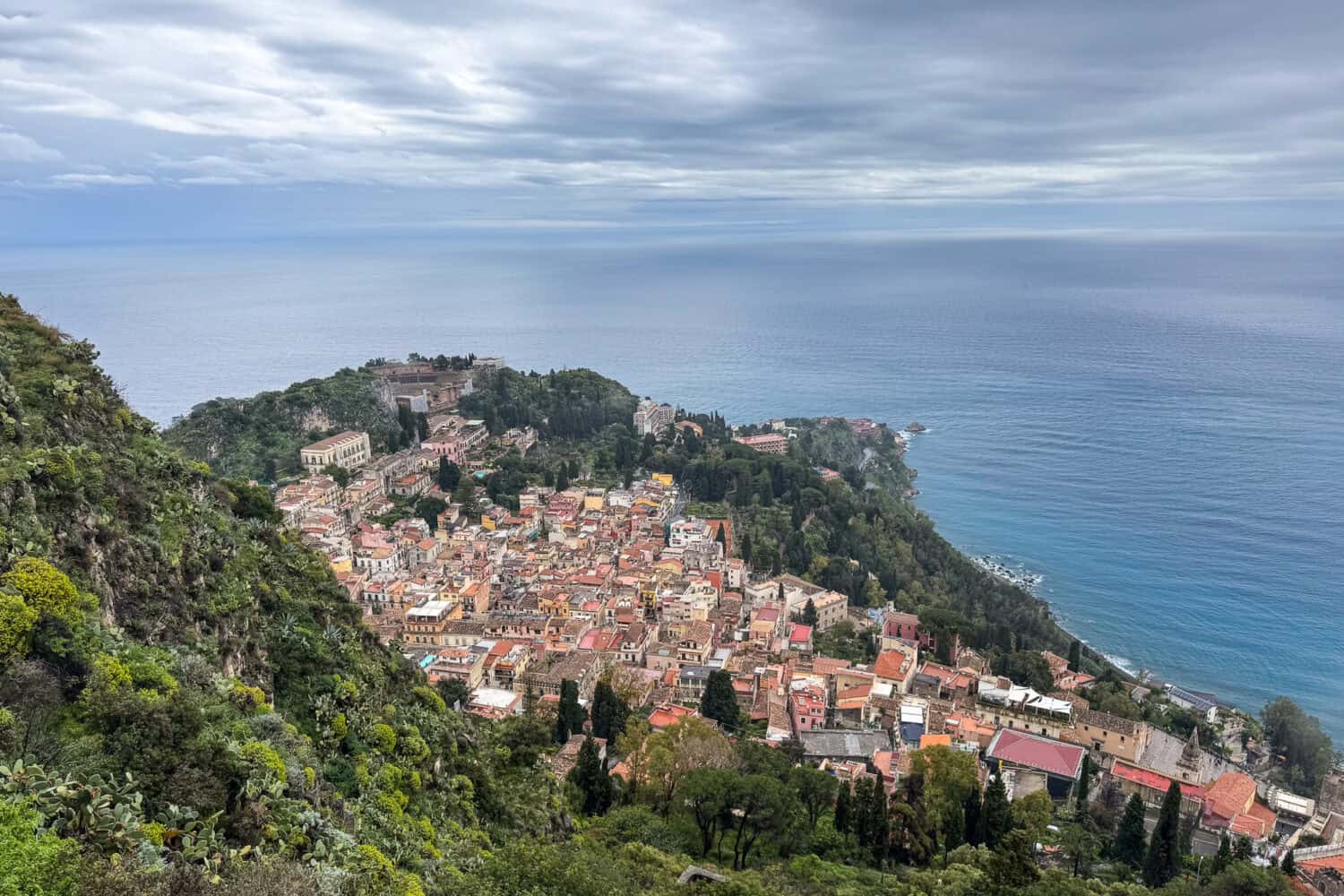
We spent the day exploring Taormina on foot. You can see our guide to the best things to do in Taormina for details, but here were our highlights:
- Chiesa Madonna della Rocca – Worth the walk up to see the views from this chapel built into the rock.
- Bam Bar – The famous granita lives up to the hype.
- Teatro Antico di Taormina – This ancient Greek Theatre has the most stunning views, and you can sit on the stone seating and imagine watching a play back in the 3rd century BC.

- Villa Comunale di Taormina – Beautiful public gardens.
- Belvedere di Via Pirandello – Stunning view down to Isola Bella.
- Wandering the backstreets and admiring the succulents on the balconies.
- Pizzeria Villa Zuccaro – Excellent pizza. In better weather, you can dine under lemon trees in the courtyard.
Day 3: Mt Etna and Taormina
- Taormina to Rifugio Sapienza Drive: 1 hour 15 minutes / 57km (35 miles) each way.
- Without a Car: Take a tour from Taormina, such as this Etna summit and Alcantara tour with Etna People.
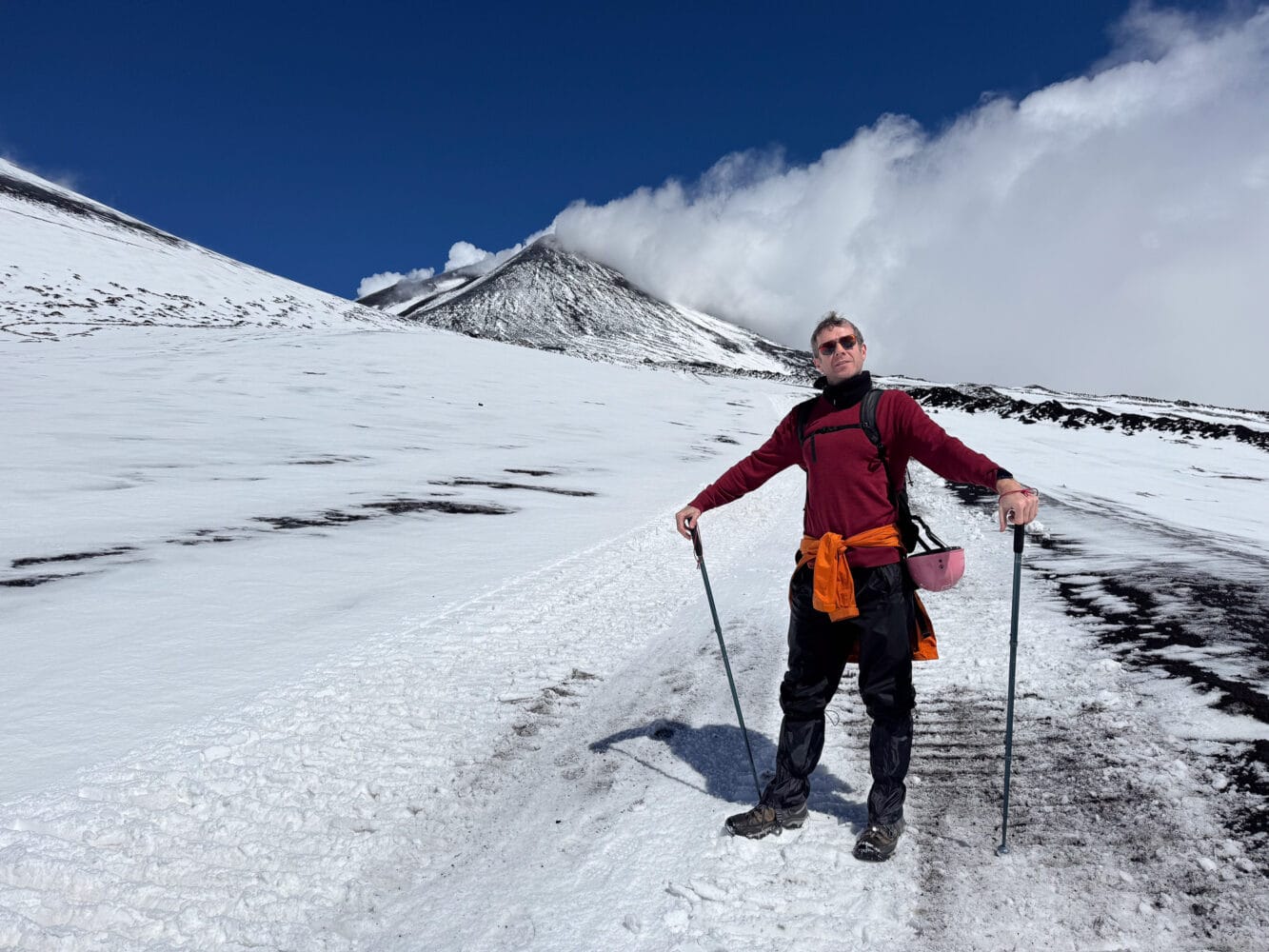
Mt Etna is an East Sicily highlight and you can experience the volcano in many ways—visiting a winery on its slopes, doing a DIY walk at lower elevations, taking a cable car, or doing a guided hike to near the summit.
The north side of Etna is slightly closer to Taormina, but fewer tours were running in early spring, so we visited from Rifugio Sapienza on the south side, the most common access point to the volcano.
We did this Etna Volcano: South Side Guided Summit Hike with Ashara. We drove ourselves to Rifugio Sapienza up the winding mountain road, met up with our tour group, and took the cable car to 2500 metres (you could also do this by yourself).
If you want to hike to the summit, you must be with a guide for safety. However, due to eruptions, it hasn’t been possible to get to the summit for years, but they’ll get you as close as possible.
We hiked to a crater at 2900 metres. It was a fairly strenuous climb (in the snow!), so I only recommend it if you’re fit and used to hiking.
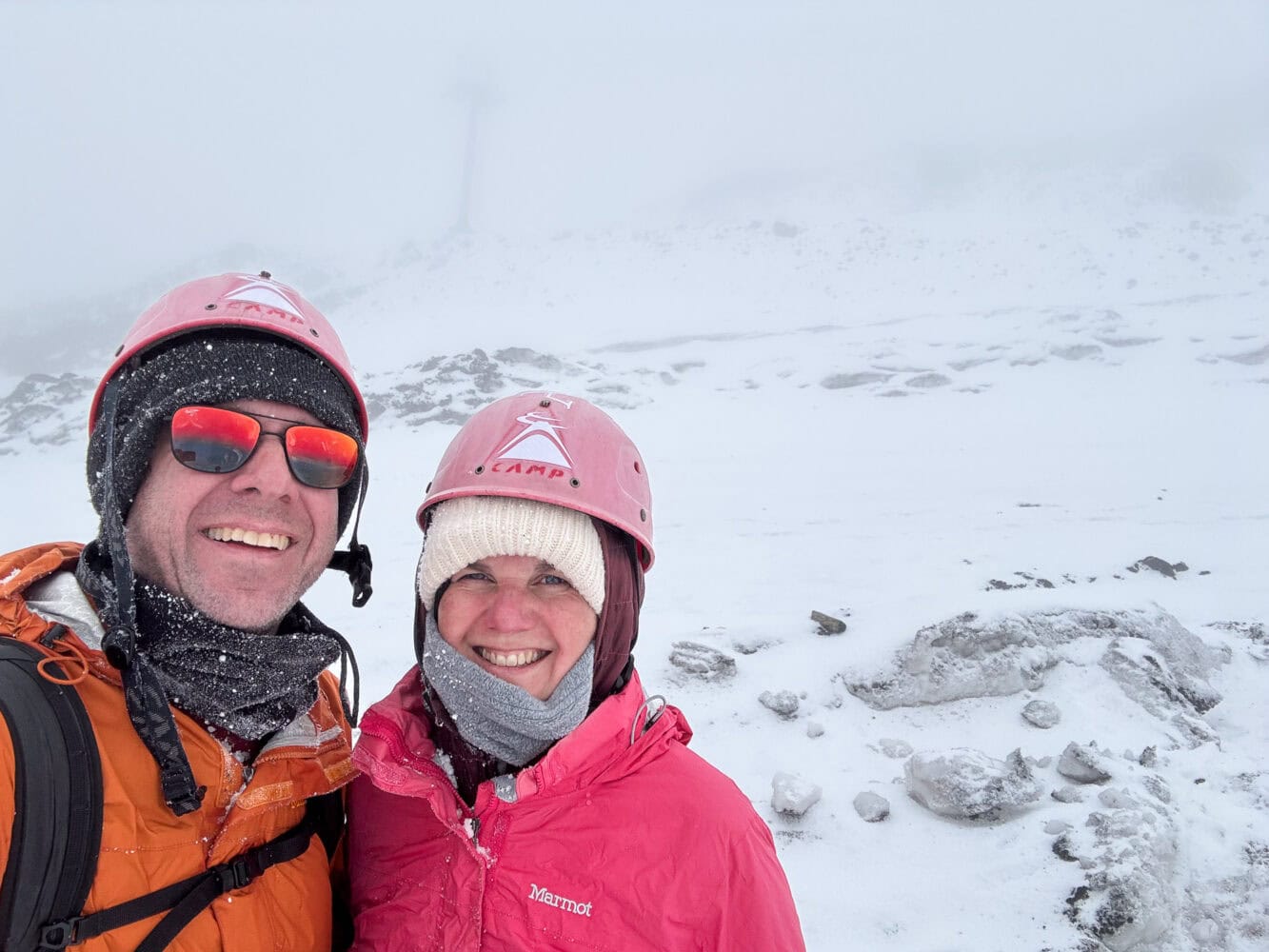
Alternatively, you could also take a 4WD bus from the top of the cable car—these big groups ended up at the same point as us.
The advantage of hiking was enjoying some stunning scenery on the way up and visiting a lava cave (where we could feel the heat radiating from the rock) on the way down.
Our conditions were pretty extreme, and we ended up hiking through a snowstorm. It was an adventure!
Etna is well worth a visit, whichever way you choose to explore.
Back in rainy Taormina, we were cold and exhausted, so after a drink at Re di Bastoni Pub (the best negroni of the trip), we had a casual dinner of arancini and parmigiana at Da Cristina.
Day 4: Castelmola and Syracuse (6 Nights)
- Taormina to Syracuse Drive: 2 hours 45 minutes / 122km (76 miles). (It’s usually 2 hours).
- Without a Car: Train from Taormina Giardini Station (around 2 hours if you get a direct service) or bus.
Castelmola

We finally saw some blue sky on our last morning! We took advantage after checking out by driving up to Castelmola, a village even higher up the mountain than Taormina.
This medieval hamlet is a picturesque place to wander, but with achy legs from Etna, we mostly enjoyed the spectacular view with a glass of local almond wine in Antico Caffè San Giorgio.
Syracuse
Our drive to Syracuse took nearly three hours, much longer than usual as we hit traffic several times.
Syracuse, or Siracusa in Italian, is on the coast of southeast Sicily, south of Catania. Much larger and flatter than Taormina, it’s known for its rich Greek and Roman history and ancient ruins.
Ortigia is an island connected to the mainland by a bridge. This is Siracusa’s old town, where it was founded by ancient Greeks, and is the most beautiful part of the city.
Read my guide to the best things to do in Syracuse and Ortigia for lots more tips.
A Casa di Clara Apartment
Most people recommend staying in Ortigia, but parking is expensive and you can’t drive in most of the island.
As we had a car and wanted to make day trips, we chose an apartment a 10-minute walk from Ortigia that had free parking, and the location worked well for us.
We stayed in a one-bedroom apartment called A Casa di Clara in a residential building. As we were staying for six nights, it was nice to have more space than a B&B. The washing machine was useful, and the parking and location were great. Self-check-in was easy.
In summer, I think we would have enjoyed it more. In rainy early spring, we found it a bit cold and damp (despite the heating). It was also noisy on weekend nights, and the water tasted salty so we had to buy bottled water.
Although we didn’t love every aspect, it was good value and worked well as our base.
Syracuse and Ortigia
On our first afternoon, we had a lovely pasta lunch at the casual pasta shop Fari near our apartment before walking across the bridge into Ortigia.
Syracuse’s old town is a wonderful place to wander, whether along the seafront or in the maze of lanes.
We stopped for excellent gelato at Levante Gelato Artigianale; the Bronte pistachio is worth the 50-cent premium.
In the evening, we headed back to Ortigia (you’ll spend the majority of your time in Syracuse here) for wine at Enoteca Solaria (although we didn’t love our wine, the sandwich we shared was delicious) and cocktails in the stylish courtyard of Cortile Verga.
Back near our apartment, we picked up takeaway pizzas from Piano B; it was packed with locals on a Friday night. We loved their thin and crispy pizzas so much that we returned later in the week.
Day 5: Ortigia Food Tour
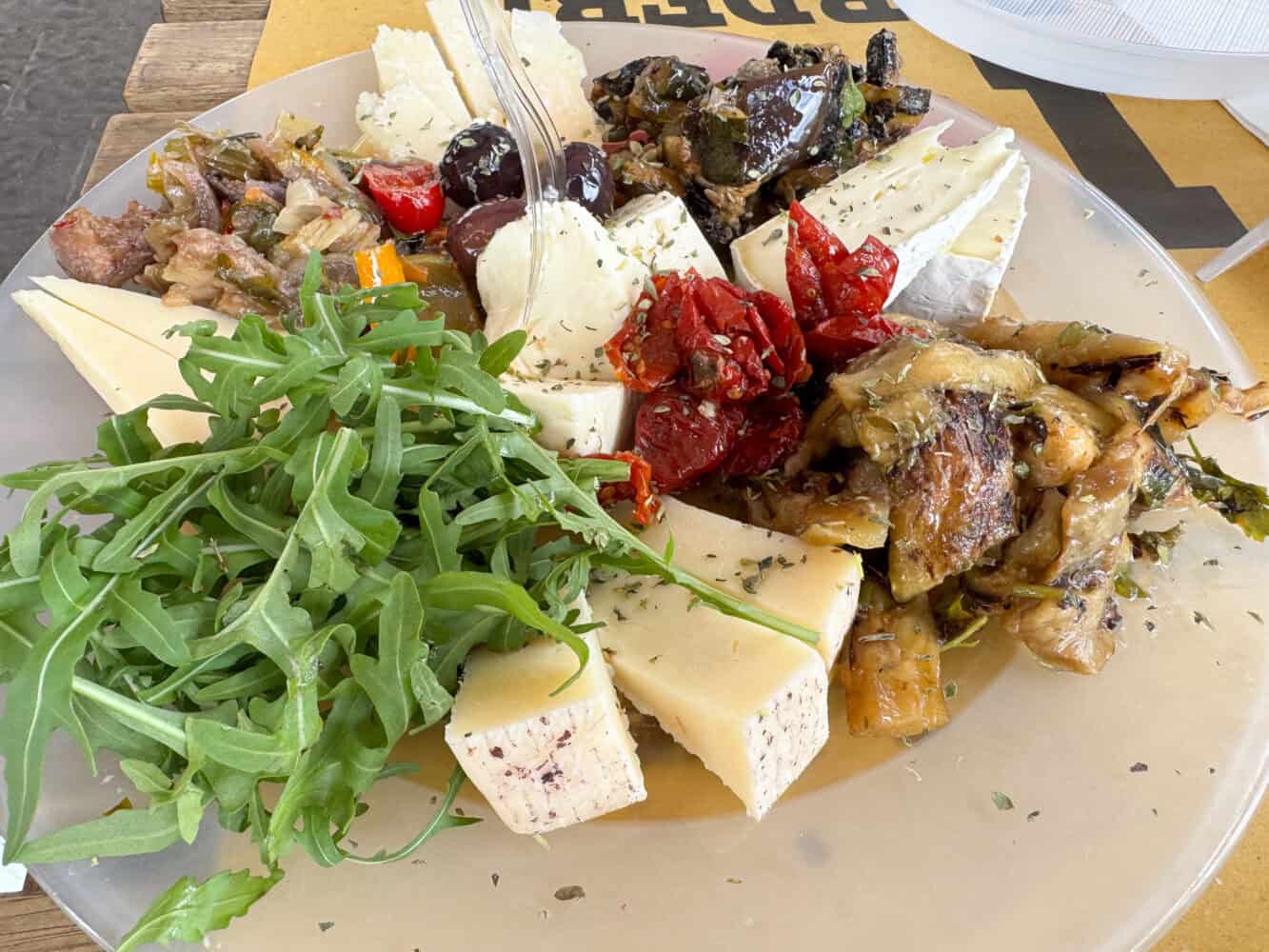
Although we aren’t usually tour people, we do love a food tour in Italy. They are a great way to get an overview of a city, learn some history, and of course, taste lots of delicious food.
We did this three-hour Street Food Walking Tour in Ortigia. At this time of year, it was just us with Giuseppe, who taught us lots about the city and Sicily’s history.
We tried so much delicious food (go hungry!) and visited places that hadn’t come up in my extensive research. They easily catered for us as vegetarians.

I fell in love with Ortigia on this tour, especially strolling the backstreets of the Jewish Quarter and learning to see the layers of history on the Duomo (Cathedral).
We needed a nap afterwards, though!
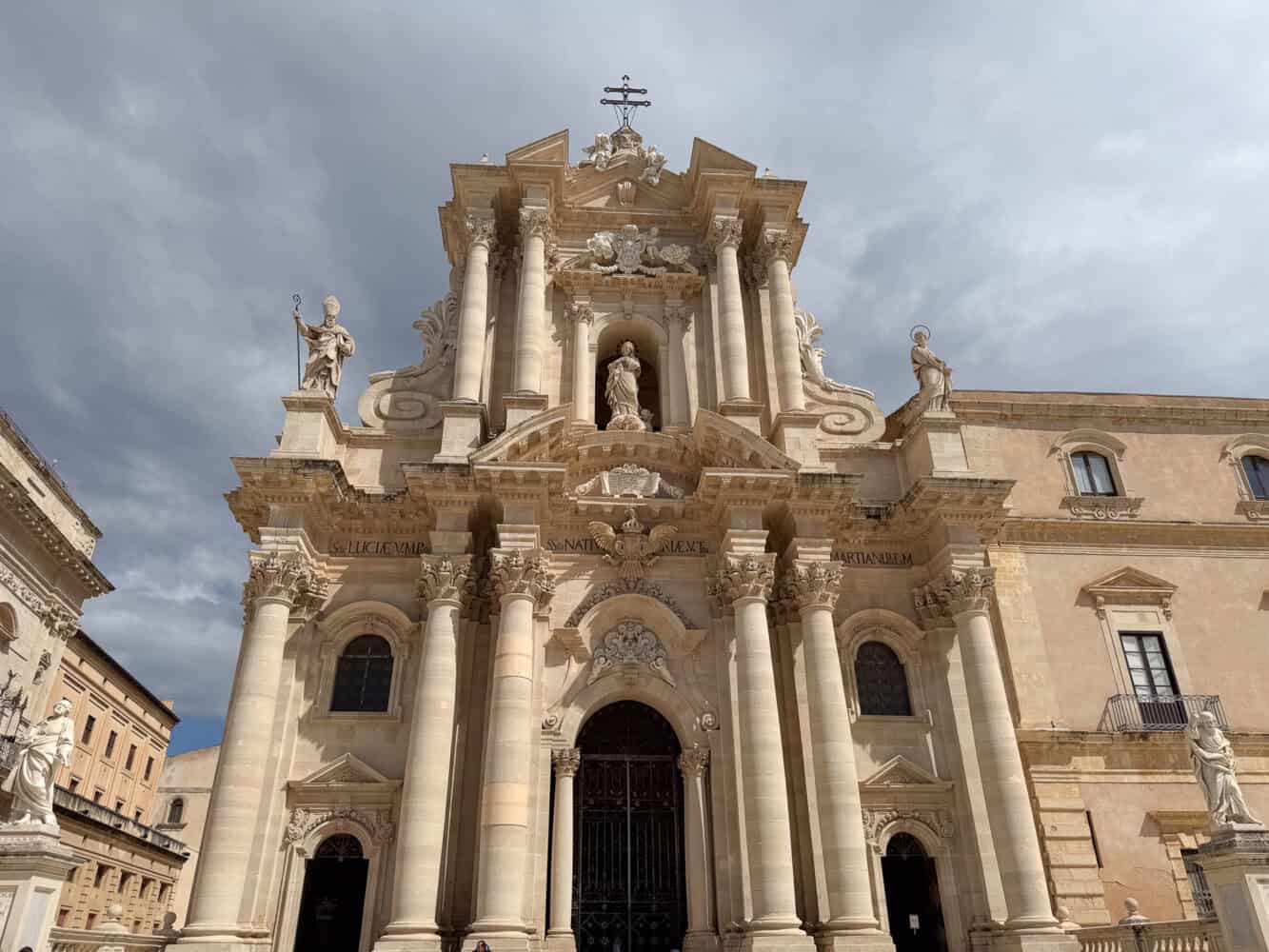
If you are vegan, check out this Syracuse Vegan Food Tour instead.
In the evening, we had aperitivo (pre-dinner drinks with snacks) at Piazza Archimede Caffe, which has a lovely view of the Diana Fountain (and heaters for the outdoor seating).
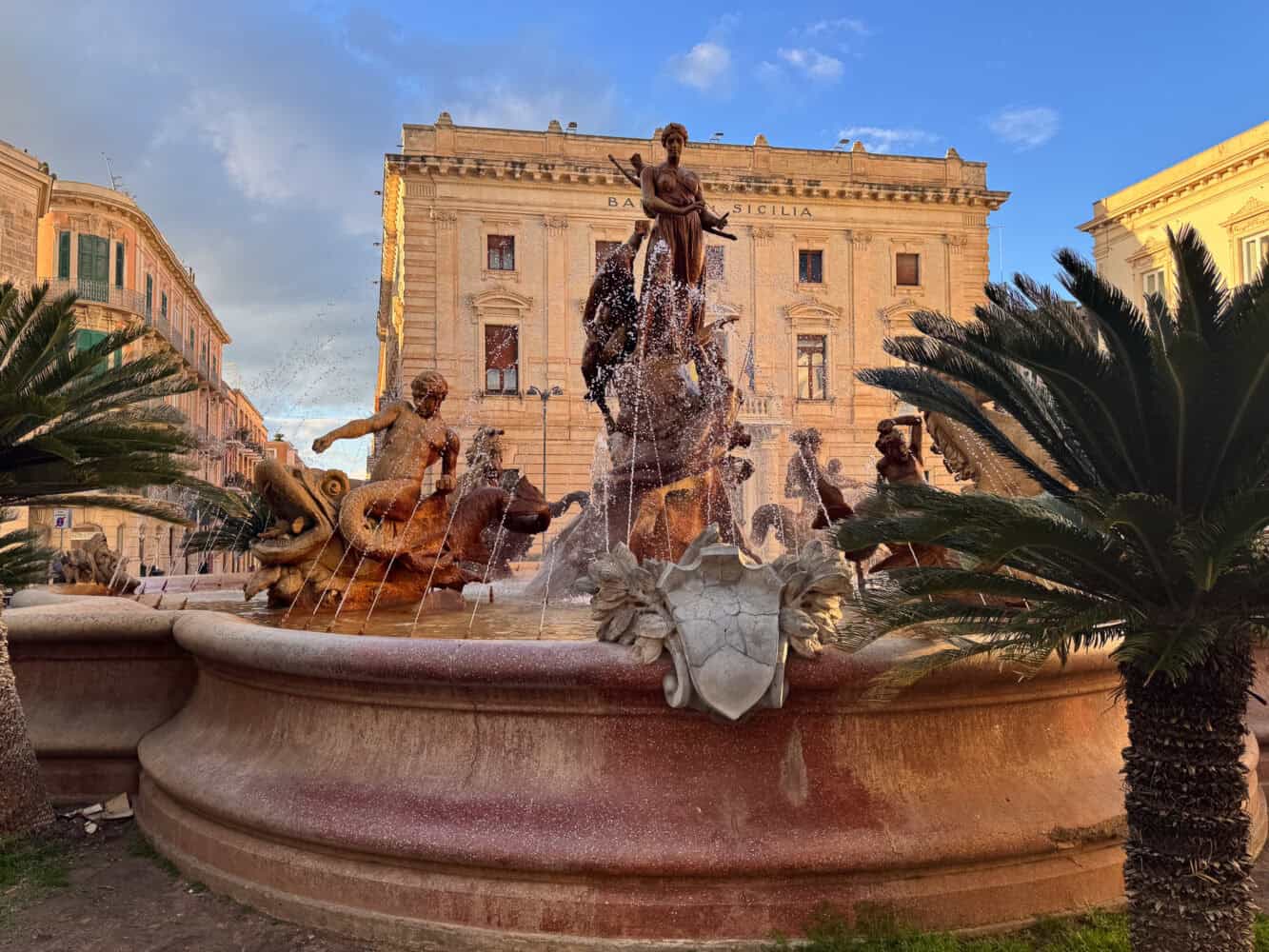
After such a big lunch, we had a simple dinner of arancini (rice balls) at Antica Giudecca, a takeout spot with a few tables that was buzzing with locals on a Saturday night.
Day 6: Ragusa and Modica
- Drive Time Round Trip: 2.5 Hours / 177km (110 miles).
- Without a Car: Train 2 hours 15 minutes to Ragusa and 20-30 minutes between Ragusa and Modica. Or take a transport-only day tour to Ragusa, Modica and Noto.
Ragusa Ibla
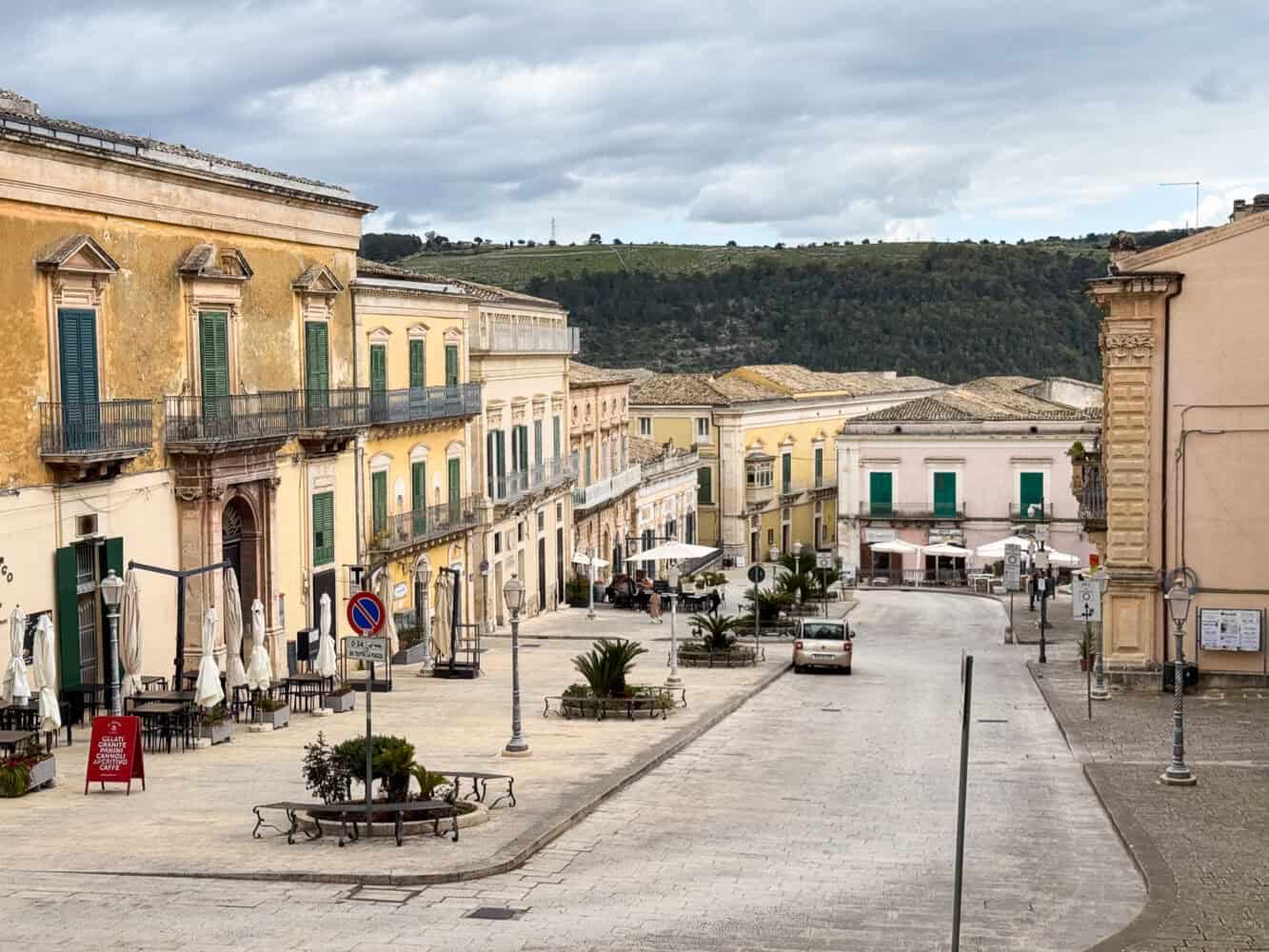
Syracuse is a good base for exploring the UNESCO World Heritage-listed Val di Noto (although you could also choose to stay in one of the towns).
A massive earthquake struck this area of southeastern Italy in 1693, and many of the towns were completely rebuilt in the Baroque style. We visited the three most popular of the eight towns.
We started in Ragusa, an easy 1 hour 15 minute drive from Syracuse. The town has a dramatic location on a gorge, with the “new” 18th-century town on one side and the old Ragusa Ibla on the other, where traditionalists preserved the medieval layout.
We parked at Parcheggio Repubblica, which is between the two. The spaces with white lines are free, the blue ones are €1 an hour (pay with the EasyPark app) or in winter, it’s all free.
We focused on Ragusa Ibla, which is a wonderful place to wander in the maze of narrow, traffic-free streets, and quiet on a Sunday afternoon at the end of March.
The heart of the town is the Baroque Duomo di San Giorgio, which overlooks the main piazza, and we admired it from many vantage points as we explored the streets.
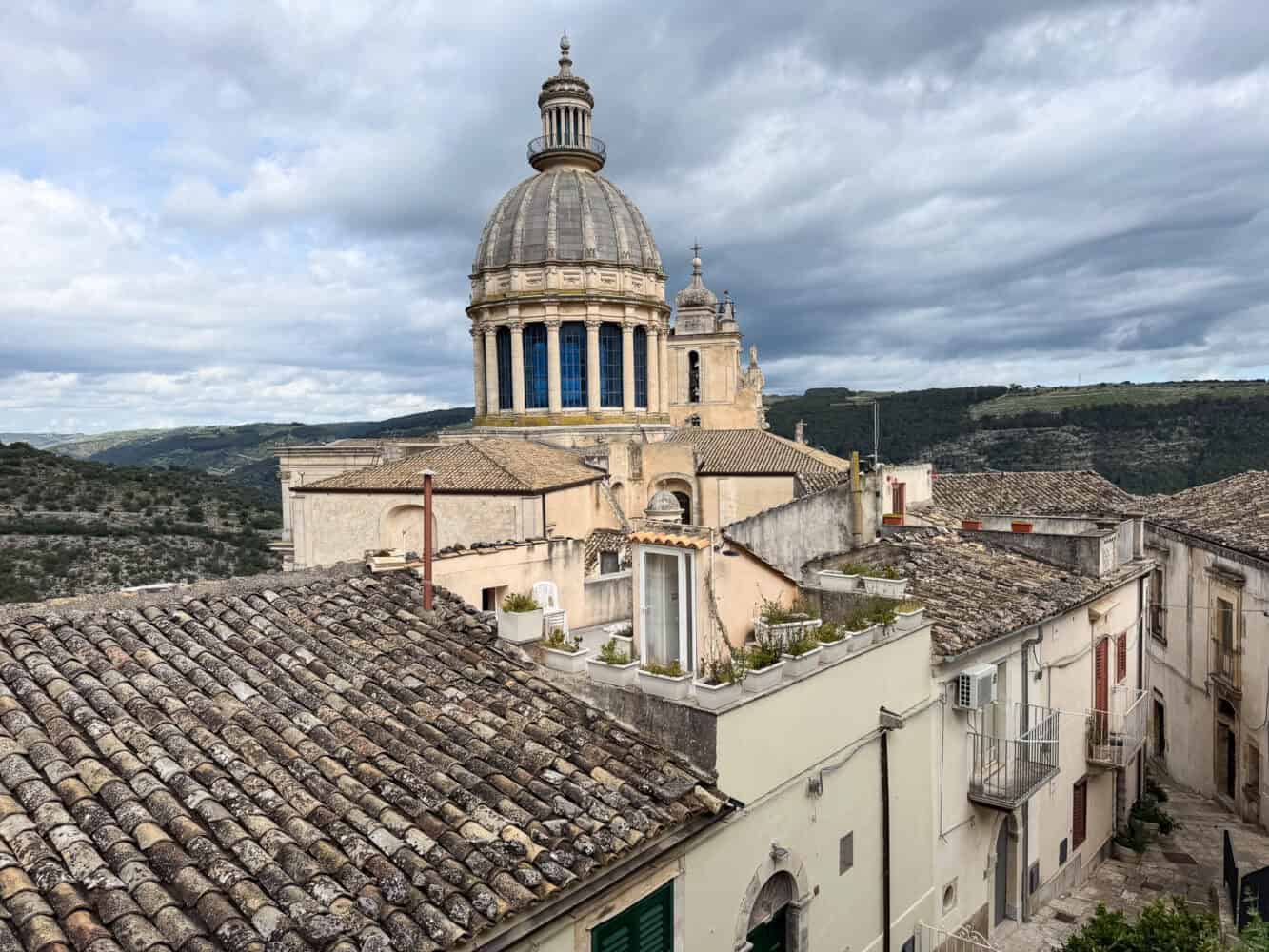
The pretty Giardino Ibleo is worth a stroll with spring blossoms and panoramic views.
Wine bar Enoteca Il Barocco was the perfect spot for lunch. Our vegetarian Ragusa tasting platter was extensive and delicious featuring local cheeses, vegetables, and sandwiches. We liked the sundried tomato and walnut pesto so much we bought a jar from their shop.
We worked off lunch climbing the many staircases to explore the backstreets and walking around the edge of the town for views into the gorge. It reminded us of Matera, with the houses tumbling down the hillside.
We didn’t make it to Ragusa Superiore, but we did walk up the 300+ steps of Via Scale to Chiesa di Santa Maria delle Scale, which lies between the two.

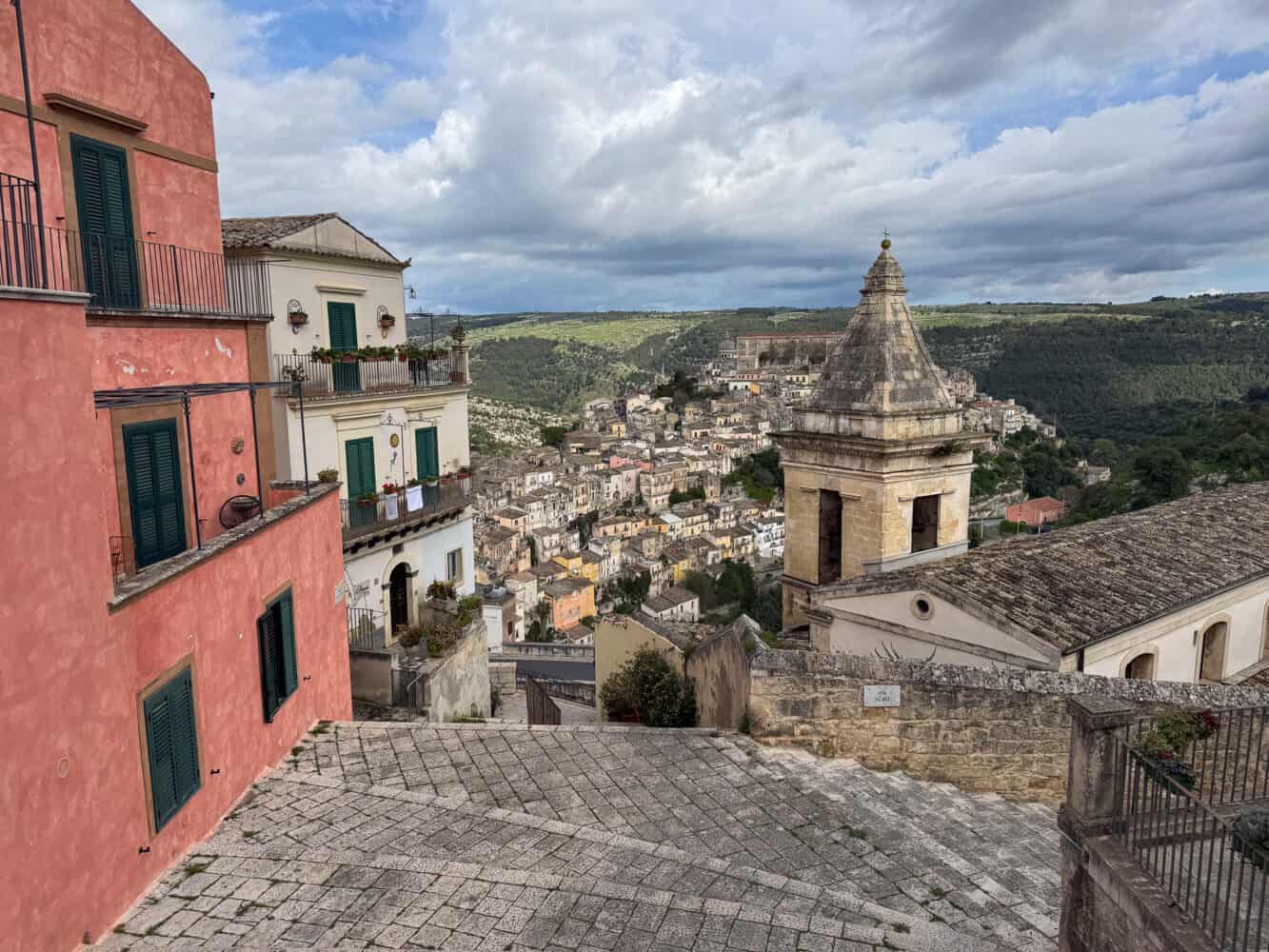
It’s well worth the climb for the stunning view of Ragusa Ibla from above.
We absolutely loved Ragusa!
Modica
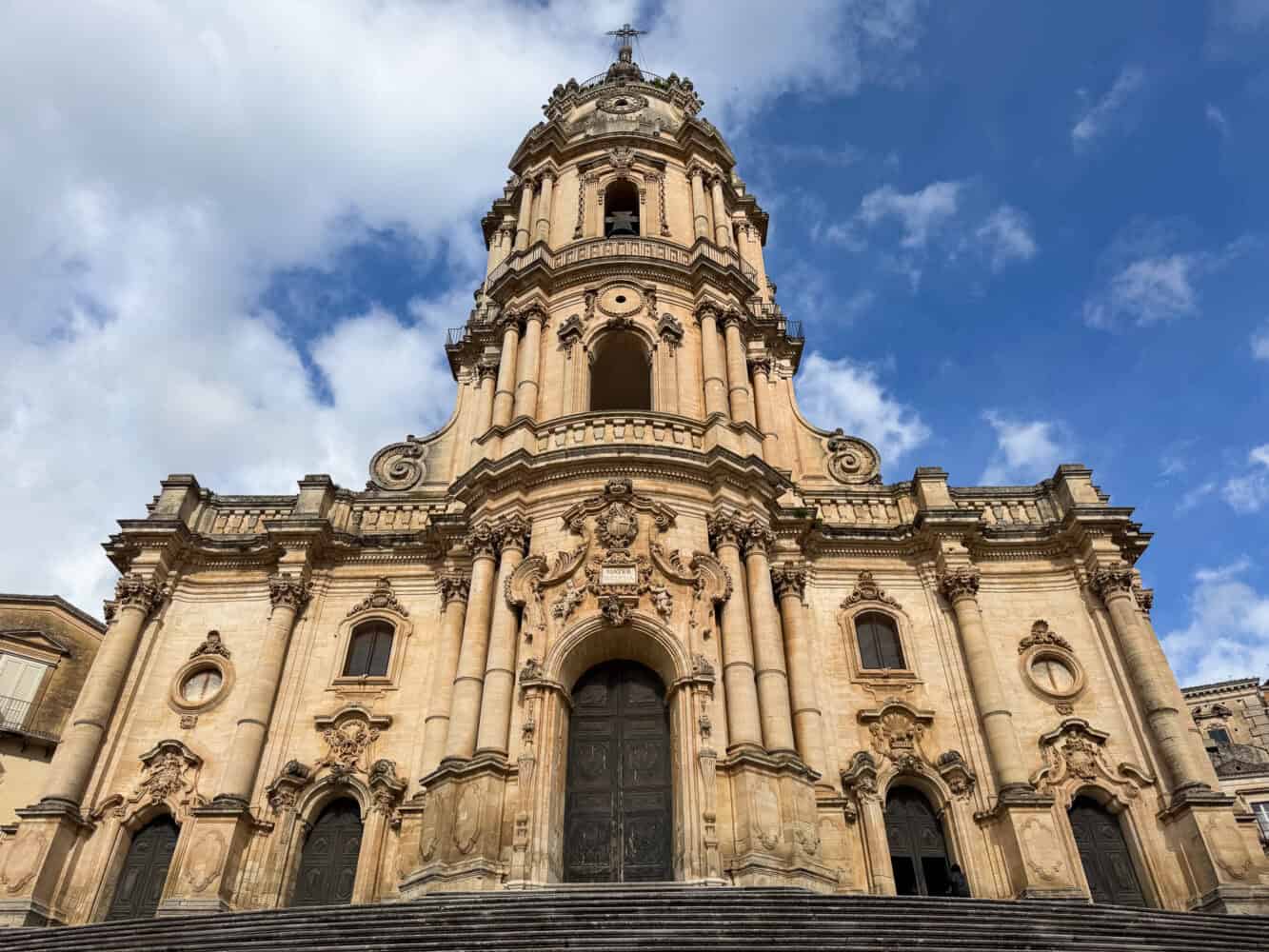
Our next stop was Modica, 20 minutes away. We aimed for this Parcheggio Gratuito (free car park) but ended up getting free street parking nearby. We had to drive through much of the town to get there, though, and it was quite confusing.
We didn’t fall for Modica as easily as we did for Ragusa, but we also didn’t have the time (or energy) to explore much.
The main attraction was its chocolate, which is unique in Europe. The Spanish brought chocolate from Latin America to Sicily in the 16th century, and the chocolate made now still resembles the original Aztec xocolatl.
Modica chocolate is dark and grainy because the sugar crystals don’t dissolve in the low temperatures it’s melted at.
We learnt about the process from bean to bar (and tasted many samples) on a tour at Antica Dolceria Bonajuto, Modica’s oldest chocolate shop.

The 40-minute tour (€10) is well worth it if you’re a chocolate lover. Check their website for times and book in advance.
We also had a quick walk up many stairs to the stunning Duomo di San Giorgio (Baroque, of course) and past Duomo di San Pietro Apostolo on the main street, glowing red in the late afternoon light.
It’s a one-hour drive back to Syracuse, where we had a quiet night.
Day 7: Ortigia
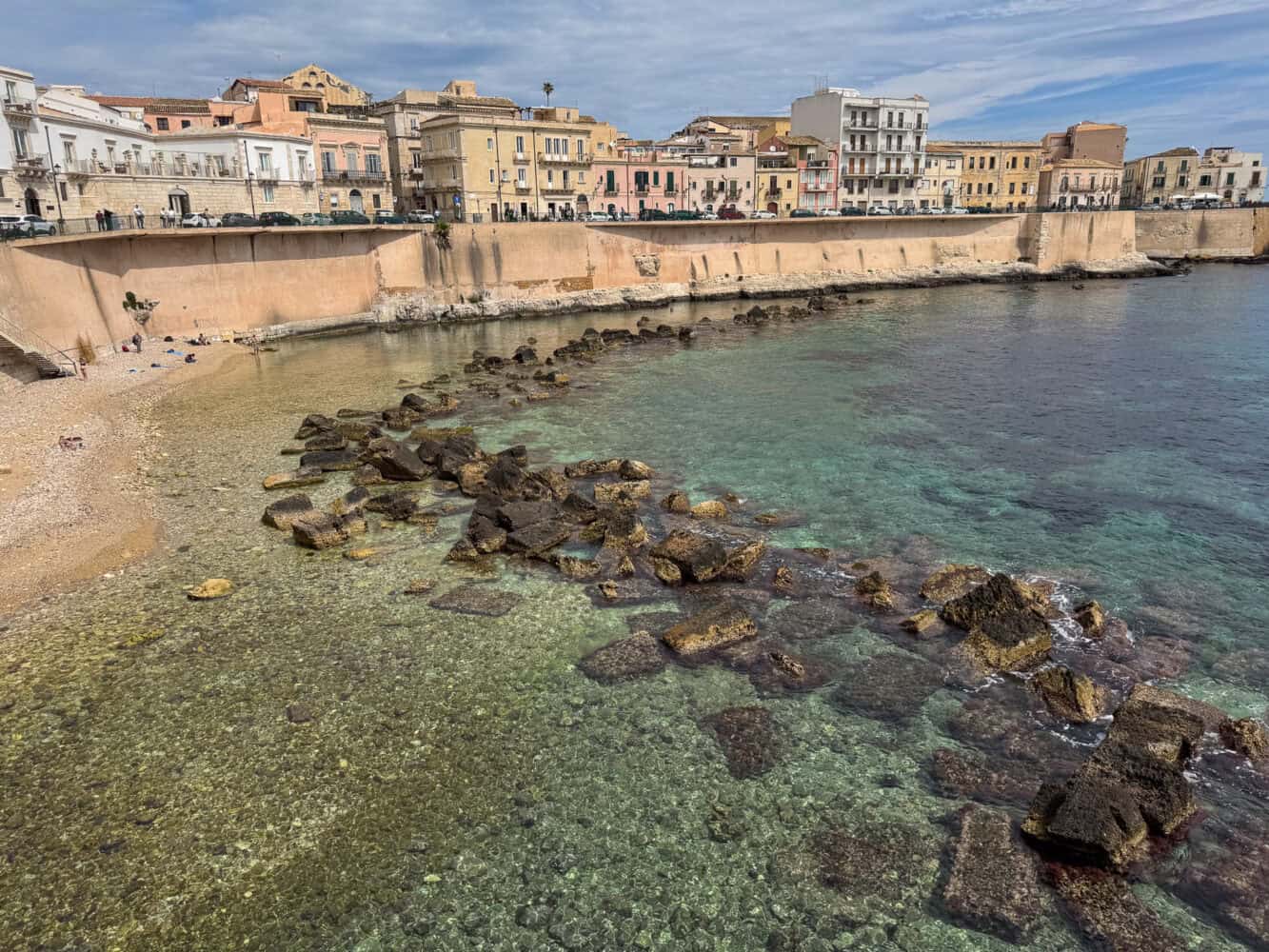
Today, we focused on exploring the lovely island of Ortigia. Here’s what we did:
- Walked down the Lungomare Alfeo on the west for sea views.
- Castello Maniace – We enjoyed the views from inside the castle at the end of the island (€6 entry), but you could just look from outside if you have limited time/budget.
- Continued walking around the coast on the east side past popular swimming spots Cala Rossa Beach and Forte Viligena.
- Lunch at Fratelli Burgio in Ortigia Market.
- Visited inside the Duomo (€2) – I prefer it from the outside, to be honest.
- Afternoon break.
- Cocktails at BOATS, a very cool bar with unique drinks (mostly tequila-based). No snacks though.
- Dinner at Trattoria La Foglia – We loved the quirky, mismatched decor and delicious food.
Don’t miss my Syracuse Sicily travel guide for more information on all these places.
Day 8: Syracuse and Ortigia
Neapolis Archaeological Park

The Neapolis Archaeological Park is Syracuse’s top attraction and the main thing to do outside Ortigia. It’s a 30-minute walk from the top of Ortigia.
The vast park (€17 entry) includes a 5th century BC Greek Theatre, Roman amphitheatre, caves, and an ancient quarry where lemon and orange trees now grow. Modern sculptures are scattered around the ruins.
It gets mixed reviews, with the main complaints being the lack of information and the fact that the Greek Theatre is covered with wooden benches for performances much of the year (it did look terrible).
We didn’t have the best experience either, but we also visited during heavy rain and at 10:30 am, when it was heaving with tour groups. We thought that on a weekday in early April we’d be ok with a late start, but there are lots of school groups at this time.
I think if we’d visited on a sunny day at a quieter time (go early or late), we would have enjoyed wandering around, but it’s best to manage your expectations. It’s pricey for what it is.
Ortigia

Back in Ortigia, we had an excellent lunch at Borderi in the market. They are known for their sandwiches, but we like the platters of cheese and vegetables even more.
At 5pm we managed to get into the Teatro dei Pupi/ Puppet Theatre (I recommend booking in advance, which you can do on their website) for a traditional Sicilian puppet show (in Italian so it felt a little long). You can also visit the small Puppet Museum for an extra €1.
Afterwards, we had wine and bruschetta at Evoe wine bar and dinner at Pizzeria Schiticchio, both of which were excellent.
Day 9: Noto and Ortigia
- Drive Time Syracuse to Noto: 35 minutes / 37km (23 miles) each way.
- Without a Car: 30-minute train ride.
Noto
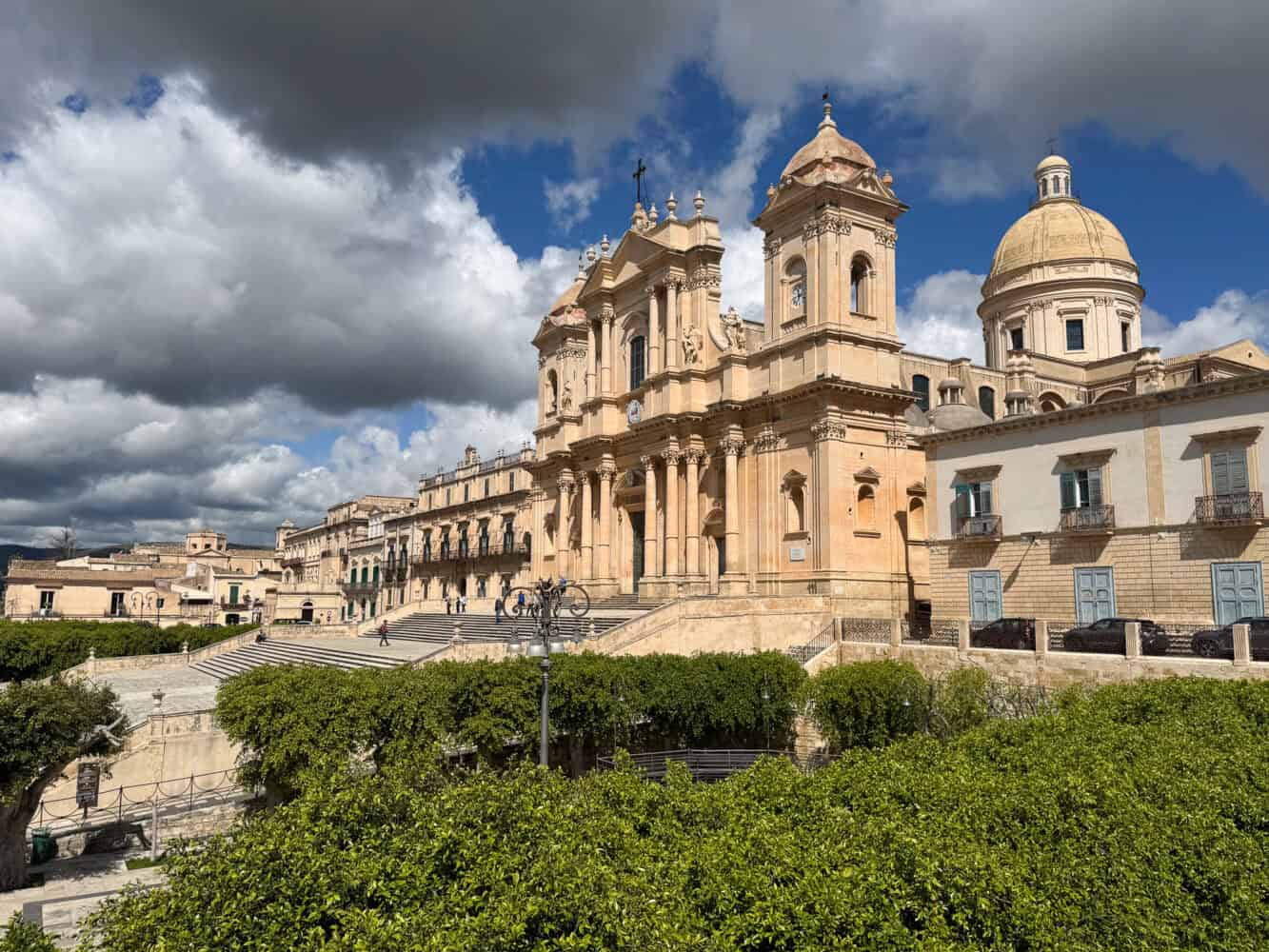
Noto is the most famous of the Val di Noto Baroque towns (and also featured in The White Lotus Season 2) and is an easy day trip from Syracuse.
We arrived just before 10am and parked at Parcheggio Centrale (€2 an hour, collect a ticket on arrival and pay at the machine when you return).
From there it’s just a few minutes walk to Porta Reale, the grand gateway to the city. It leads to Corso Vittorio Emanuele, Noto’s main street, where you’ll find most of its major sights.
It’s a gorgeous place with many Baroque churches and palaces that glow a honey gold.
Here’s what we enjoyed in Noto:
- Chiesa di Santa Chiara – It’s worth paying €2.50 (cash only) to climb the stairs to the terrace for a view of the Duomo from above.
- Duomo – The exterior of Noto’s Cathedral is stunning. Its stairs are a good place to eat a granita, watch the world go by, and admire the Palazzo Ducezio (now the Town Hall) opposite. Part of the Cathedral collapsed in 1996 so the interior is strangely modern. It’s €2.50 (cash only) to go inside and you could skip it unless you are really into churches.
- Caffe Sicilia – Featured in Netflix’s Chef’s Table TV show, this cafe is famous for its granita, and the blood orange flavour was excellent (we didn’t enjoy the gelato as much).
- Palazzo Nicolaci di Villadorata – Head off the main street to Via Nicolaci to see this grand Baroque palace with ornate balconies. You can sometimes go inside, but it was closed on our visit, except for one room that had a free contemporary art exhibition.
- Art Staircases – Find these impressive street art stairs at Via Fratelli Bandiera (currently it’s Inferno by Carlo Coniglio) and Scalinata Mariannina Coffa.
- Panifico Maidda – A wonderful bakery that uses ancient grains. I especially loved the sfincione, a thick pizza slice with toppings like potato, zucchini, or tomato. You pay by weight, so just indicate how much you want. There are a couple of outdoor tables, but it’s more of a takeout place.
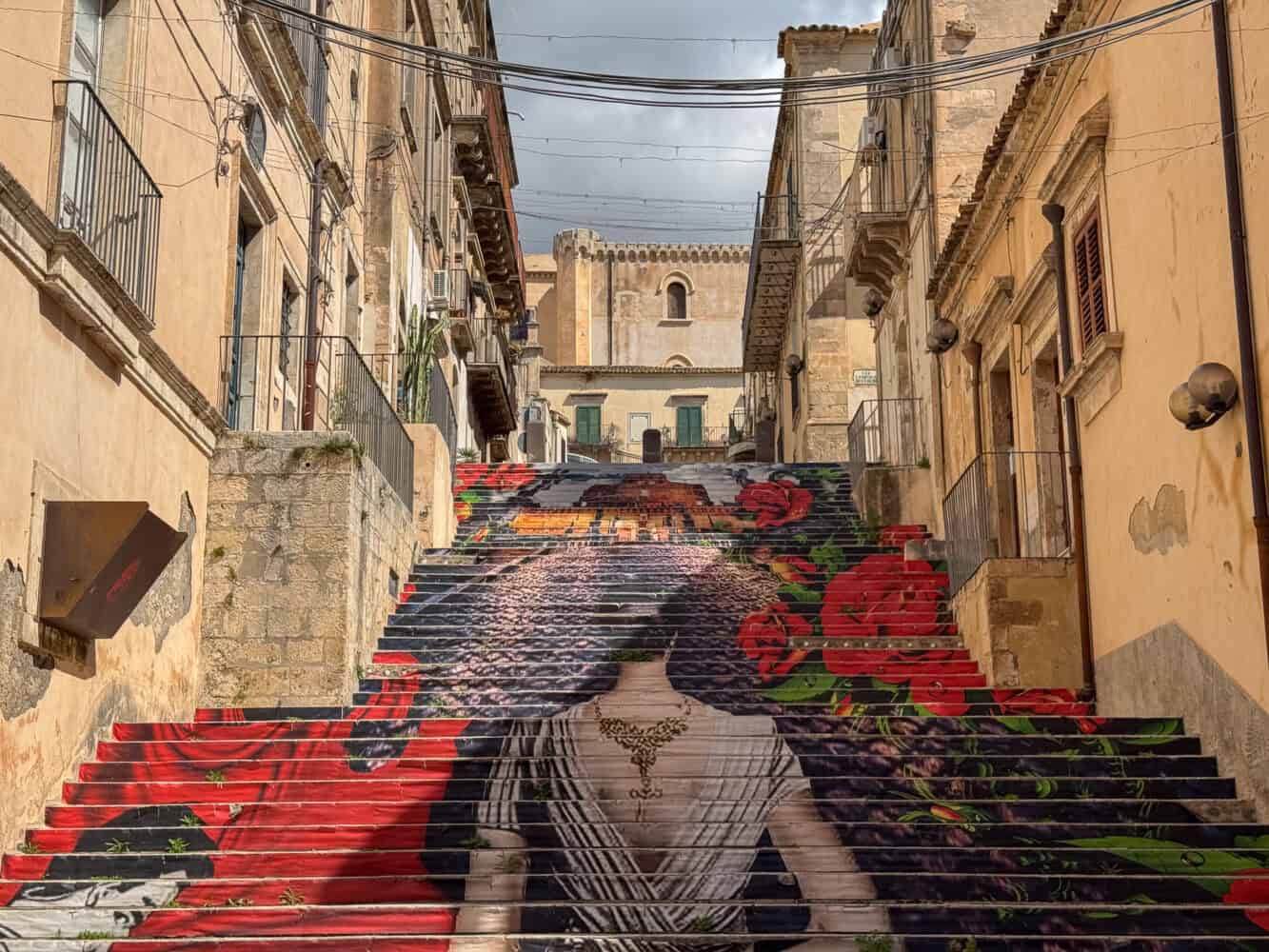
We spent just over two hours in Noto. The historic centre isn’t very big, but you could certainly spend longer if you want to linger over a long lunch (Modica di San Giovanni looked great) or visit every church.
Syracuse and Ortigia
After a break back at our apartment, we headed out in the late afternoon to a couple of sights on the Syracuse mainland. They are skippable if you have limited time.
The Santuario di Santa Lucia al Sepolcro is currently home to a Caravaggio painting (it was previously in Ortigia). Entrance to the church is free, but you’ll need a €1 coin to light up the painting behind the altar.
A 10-minute walk from here is the start of a 6km bike path, Pista Ciclabile Rossana Maiorca, that runs along the coast with views of sea cliffs on one side and less attractive modern housing on the other. We walked a short way, but it’s probably best with a bike.

This is an untouristy area and feels a bit gritty compared to Ortigia.
It was a 30-minute walk back to Ortigia, where we had cocktails at vegan restaurant Moon and a sunset spritz at Mikatu on the Lungomare.

For dinner, we headed back for more excellent pizza at Piano B (much quieter on a weeknight, so we could eat in).
Day 10: Catania (1 Night)
- Drive Time Syracuse to Catania Airport: 50 minutes / 62km (38 miles).
- Without a Car: Train around 1 hour 15 minutes or Interbus.
Catania is Sicily’s second largest city (after Palermo on the west coast) and is known for being a more local, grittier spot than other destinations on the east coast.
There are some beautiful buildings and prices are lower here. We enjoyed our afternoon and evening in the busy city, but one night was enough for us.
We dropped off the car at the airport and took a taxi into the city (€34) as we didn’t want to drive or worry about parking. You can also take the Alibus.
Catania Suite Inn
We stayed at Catania Suite Inn and I recommend it. It has a central location, modern rooms, friendly staff, a good breakfast, and, unusually, even an elevator. We could leave our luggage before check-in.
Catania
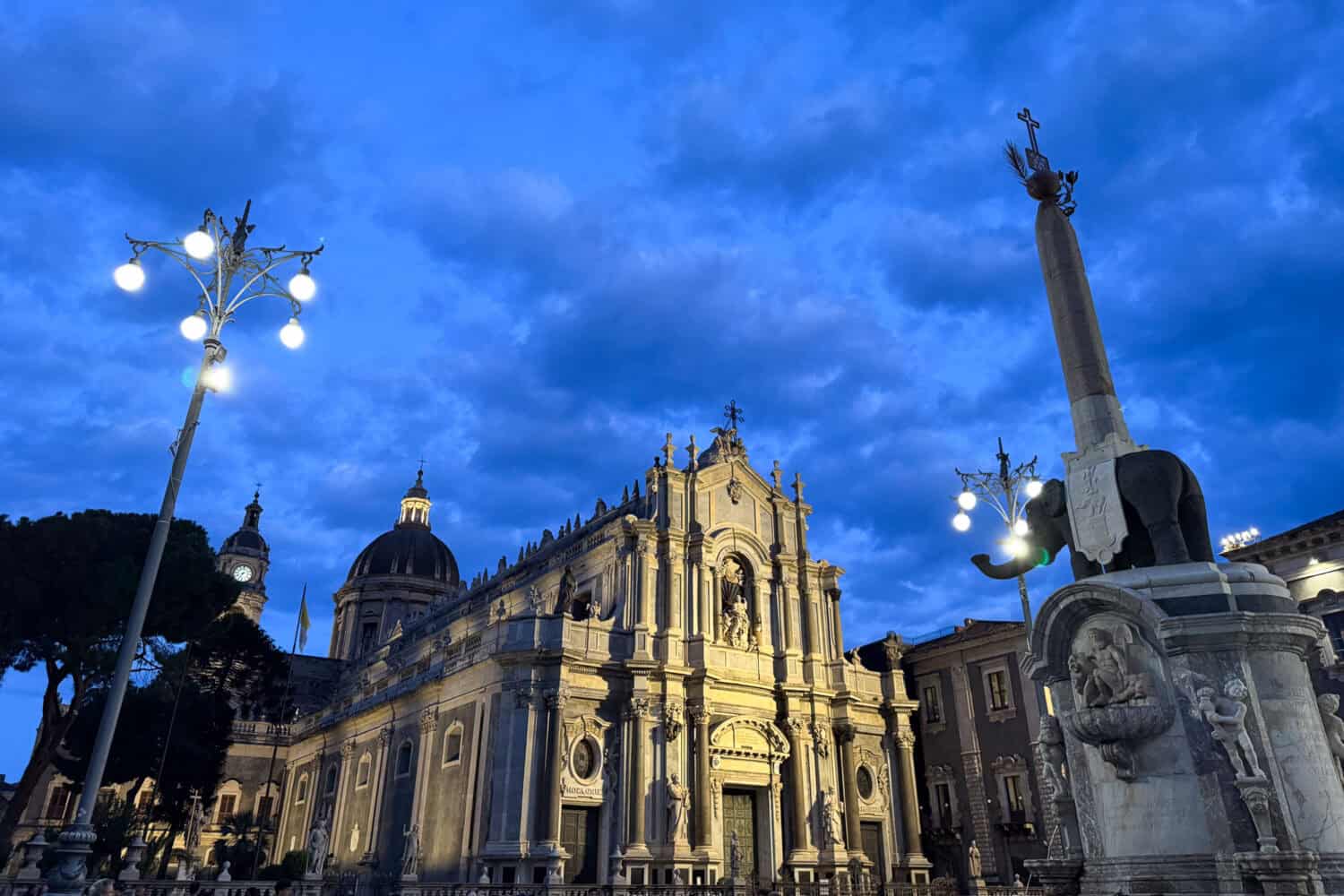
In Catania, we had a reasonably priced spritz at Caffe del Duomo and enjoyed the view of the stunning main piazza and Duomo.
We climbed the spiral stairs at Chiesa della Badia to enjoy the view from the top (€7). You can see Mt Etna if it’s clear.
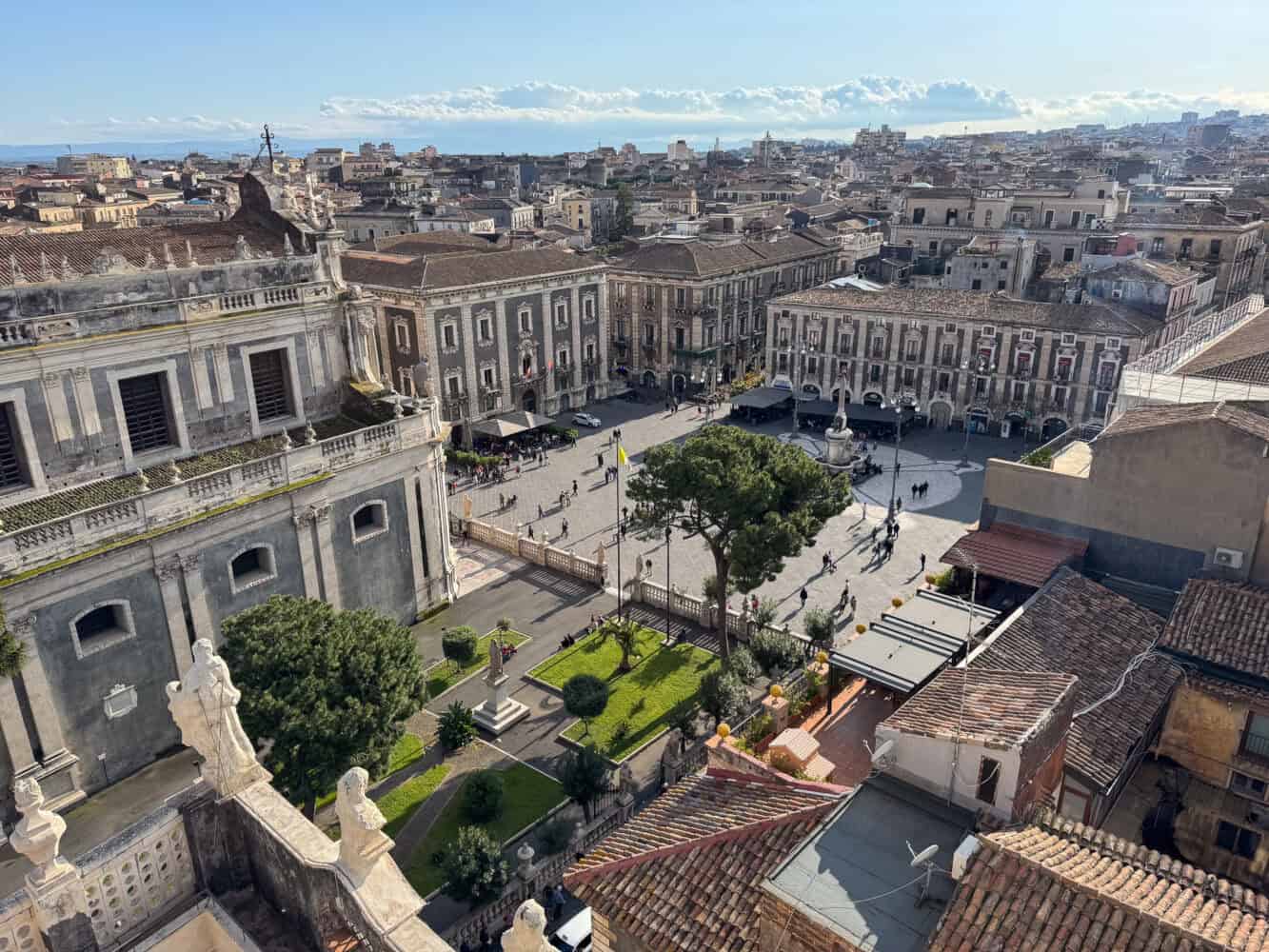
We walked down Via Crociferi for its Baroque buildings and past the ruins of the Roman amphitheatre.
We strolled through Villa Bellini Park and had a drink on bustling Via Gemmellaro.
We snacked on delicious arancini at Centumila (probably my favourite in Sicily) and topped it off with amazing pistachio gelato at Don Peppinu.
Day 11: Departure from Catania Airport
Our B&B arranged a taxi back to the airport (€25) for our flight out of Sicily.
Despite the mixed weather (a risk of going in early spring), we had a wonderful 10 days in Eastern Sicily, and I’m sure we’ll be back.
More Sicily Posts
East Sicily
West Sicily
- 12 Best Places to Visit in Western Sicily
- Exploring Peaceful Salina in Sicily’s Aeolian Islands
- A Guide to Hiking Stromboli Volcano
- Our Month Living in Palermo
Food
If you enjoyed this post, pin it!
